Birds of Ecuador
Loeffelenten am Greifensee bei Silberweide Es gab dutzende davon, dazwischen eine Krickente. 2021-02-08 15.20.36
First observed in 🇨🇭 on 2021-02-08.
This bird appears across the great seas in the following continents:
Europe, North America, South America, Africa.
Wintergast am Greifensee.
PK: white, black, rust-brown, yellow eyes, black spoonbill, red legs.
Vocalization: ![]() Male is characteristic and most often heard: A hoarse nasal knocking sound "took took", often staccato or disyllabic. Female similar to Mallard but flatter and more creaking. [Link]
Male is characteristic and most often heard: A hoarse nasal knocking sound "took took", often staccato or disyllabic. Female similar to Mallard but flatter and more creaking. [Link]
Physical details: length=44-52 cm,
wingspan=70-84 cm,
weight=470-800 g
Habitats:
River and lake
Profile Wikipedia eBird Xeno-Canto
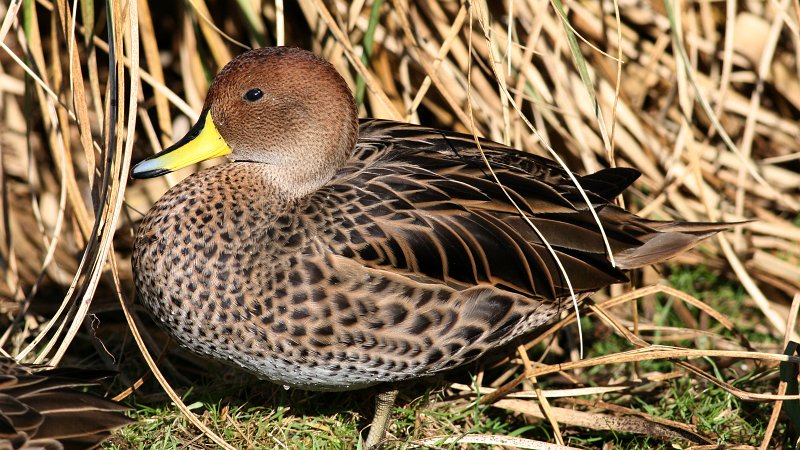
Wikipedia: Yellow-billed pintail Source: OTHER
Brown_pintail_%28Anas_georgica_spinicauda%29_%284%29.jpg
General: ![]() The yellow-billed pintail (Anas georgica) is a South American dabbling duck of the genus Anas with three described subspecies.
[more]
The yellow-billed pintail (Anas georgica) is a South American dabbling duck of the genus Anas with three described subspecies.
[more]
Profile Wikipedia eBird Xeno-Canto

Wikipedia: Andean teal Source: OTHER
1200px-Andean-Teal.jpg
![]() The Andean teal (Anas andium) is a South American species of duck. Like other teals, it belongs to the diverse genus Anas; more precisely it is one of the "true" teals of subgenus Nettion.[2] It is restricted to the Andean highlands of Colombia, Venezuela, and Ecuador. It inhabits freshwater wetlands, preferring palustrine habitat to rivers. It is not considered threatened by the IUCN.[1]
[more]
The Andean teal (Anas andium) is a South American species of duck. Like other teals, it belongs to the diverse genus Anas; more precisely it is one of the "true" teals of subgenus Nettion.[2] It is restricted to the Andean highlands of Colombia, Venezuela, and Ecuador. It inhabits freshwater wetlands, preferring palustrine habitat to rivers. It is not considered threatened by the IUCN.[1]
[more]
Profile Wikipedia eBird Xeno-Canto

Wikipedia: White-cheeked pintail Source: OTHER
1200px-Galapagos_white-cheeked_pintail_duck_-Santa_Cruz_highlands.jpg
![]() The white-cheeked pintail (Anas bahamensis), also known as the Bahama pintail or summer duck,[2] is a species of dabbling duck. It was first described by Carl Linnaeus in his landmark 1758 10th edition of Systema Naturae under its current scientific name.[3]
[more]
The white-cheeked pintail (Anas bahamensis), also known as the Bahama pintail or summer duck,[2] is a species of dabbling duck. It was first described by Carl Linnaeus in his landmark 1758 10th edition of Systema Naturae under its current scientific name.[3]
[more]
Profile Wikipedia eBird Xeno-Canto

Wikipedia: Southern pochard Source: OTHER
1200px-Southern_Pochard_%28Netta_erythrophthalma%29_RWD1.jpg
This bird appears across the great seas in the following continents:
South America, Africa.
![]() The southern pochard (Netta erythrophthalma) is a species of duck, and a member of the genus Netta. There are two subspecies, the South American (southern) pochard N. e. erythrophthalma (Wied-Neuwied, 1833) and the African (southern) pochard N. e. brunnea (Eyton, 1838).
[more]
The southern pochard (Netta erythrophthalma) is a species of duck, and a member of the genus Netta. There are two subspecies, the South American (southern) pochard N. e. erythrophthalma (Wied-Neuwied, 1833) and the African (southern) pochard N. e. brunnea (Eyton, 1838).
[more]

Wikipedia: Lesser scaup Source: OTHER
1200px-Lesser_scaup_-_Aythya_affinis.jpg
![]() The lesser scaup (Aythya affinis) is a small North American diving duck that migrates south as far as Central America in winter. It is colloquially known as the little bluebill or broadbill because of its distinctive blue bill. The origin of the name scaup may stem from the bird's preference for feeding on scalp—the Scottish word for clams, oysters, and mussels; however, some credit it to the female's discordant scaup call as the name's source.[2] It is apparently a very close relative of the Holarctic greater scaup or "bluebill" (A. marila), with which it forms a superspecies.[3][4] The scientific name is derived from Ancient Greek aithuia an unidentified seabird mentioned by authors including Hesychius and Aristotle, and Latin, affinis "related to", from its resemblance to the greater scaup.[5]
[more]
The lesser scaup (Aythya affinis) is a small North American diving duck that migrates south as far as Central America in winter. It is colloquially known as the little bluebill or broadbill because of its distinctive blue bill. The origin of the name scaup may stem from the bird's preference for feeding on scalp—the Scottish word for clams, oysters, and mussels; however, some credit it to the female's discordant scaup call as the name's source.[2] It is apparently a very close relative of the Holarctic greater scaup or "bluebill" (A. marila), with which it forms a superspecies.[3][4] The scientific name is derived from Ancient Greek aithuia an unidentified seabird mentioned by authors including Hesychius and Aristotle, and Latin, affinis "related to", from its resemblance to the greater scaup.[5]
[more]

Wikipedia: Orinoco goose Source: OTHER
Orinoco_Goose.jpg
![]() The Orinoco goose (Neochen jubata) is a member of the duck, goose and swan family Anatidae. It is in the shelduck subfamily Tadorninae, and placed in the genus Neochen. Three fossil relatives have been described from Pleistocene sites: Neochen pugil from Brazil, Neochen debilis from Argentina and Neochen barbadiana from Barbados.
[more]
The Orinoco goose (Neochen jubata) is a member of the duck, goose and swan family Anatidae. It is in the shelduck subfamily Tadorninae, and placed in the genus Neochen. Three fossil relatives have been described from Pleistocene sites: Neochen pugil from Brazil, Neochen debilis from Argentina and Neochen barbadiana from Barbados.
[more]
Profile Wikipedia eBird Xeno-Canto

Wikipedia: Torrent duck Source: OTHER
1200px-Merganetta_armata_%28Pato_de_torrente%29_%2824726521941%29.jpg
![]() The torrent duck (Merganetta armata) is a member of the duck, goose and swan family Anatidae. It is the only member of the genus Merganetta. It is placed in the shelduck subfamily Tadorninae after the "perching duck" assemblage where it was formerly assigned to was dissolved because it turned out to be paraphyletic.[2]
[more]
The torrent duck (Merganetta armata) is a member of the duck, goose and swan family Anatidae. It is the only member of the genus Merganetta. It is placed in the shelduck subfamily Tadorninae after the "perching duck" assemblage where it was formerly assigned to was dissolved because it turned out to be paraphyletic.[2]
[more]

Wikipedia: Muscovy duck Source: OTHER
MuscovyDuck.jpg
![]() The Muscovy duck (Cairina moschata) is a large duck native to Mexico and Central and South America. Small wild and feral breeding populations have established themselves in the United States, particularly in Florida, Louisiana, Massachusetts, and the lower Rio Grande Valley of Texas, the Big Island of Hawaii, as well as in many other parts of North America, including southern Canada. Feral Muscovy ducks are found in New Zealand, Australia, and in parts of Europe.
[more]
The Muscovy duck (Cairina moschata) is a large duck native to Mexico and Central and South America. Small wild and feral breeding populations have established themselves in the United States, particularly in Florida, Louisiana, Massachusetts, and the lower Rio Grande Valley of Texas, the Big Island of Hawaii, as well as in many other parts of North America, including southern Canada. Feral Muscovy ducks are found in New Zealand, Australia, and in parts of Europe.
[more]
Profile Wikipedia eBird Audubon AllAboutBirds Xeno-Canto NABU

Wikipedia: Ruddy duck Source: OTHER
Oxyura_jamaicensis_FWS.jpg
This bird appears across the great seas in the following continents:
Europe, North America, South America.
Deutschland: eingebürgertes Neozoon, ausnahmsweise Brutvogel

Wikipedia: Masked duck Source: OTHER
1200px-Masked_duck_%28Nomonyx_dominicus%29.jpg
General: ![]() The masked duck (Nomonyx dominicus) is a tiny stiff-tailed duck ranging through the tropical Americas. They are found from Mexico to South America and also in the Caribbean. Primarily not migratory, masked ducks are reported as very uncommon vagrants in the southernmost United States, along the Mexican border and in Florida. As of 2000, the conservation status for masked ducks in Texas is 3,800 birds.[2] On April 1, 1962, it was recorded from Lowndes County, Georgia, where it was photographed by Alexander Wetmore.[3]
[more]
The masked duck (Nomonyx dominicus) is a tiny stiff-tailed duck ranging through the tropical Americas. They are found from Mexico to South America and also in the Caribbean. Primarily not migratory, masked ducks are reported as very uncommon vagrants in the southernmost United States, along the Mexican border and in Florida. As of 2000, the conservation status for masked ducks in Texas is 3,800 birds.[2] On April 1, 1962, it was recorded from Lowndes County, Georgia, where it was photographed by Alexander Wetmore.[3]
[more]
Blue-winged teal (Spatula discors)
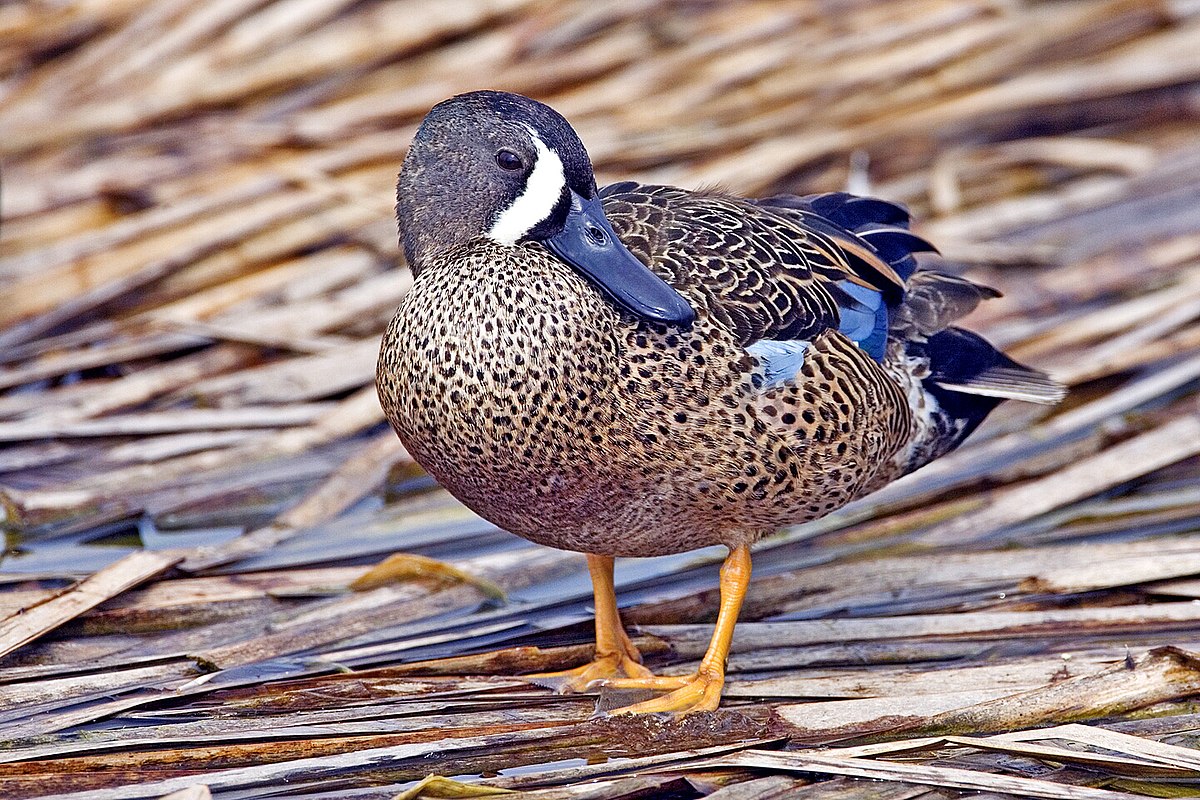
Wikipedia: Blue-winged teal Source: OTHER
1200px-Blue-Winged_Teal.jpg
![]() The blue-winged teal (Spatula discors) is a species of bird in the duck, goose, and swan family Anatidae. One of the smaller members of the dabbling duck group, it occurs in North America, where it breeds from southern Alaska to Nova Scotia, and south to northern Texas. It winters along the Pacific and Atlantic coasts and south into the Caribbean islands and Central America.
[more]
The blue-winged teal (Spatula discors) is a species of bird in the duck, goose, and swan family Anatidae. One of the smaller members of the dabbling duck group, it occurs in North America, where it breeds from southern Alaska to Nova Scotia, and south to northern Texas. It winters along the Pacific and Atlantic coasts and south into the Caribbean islands and Central America.
[more]
Cinnamon teal (alternate) / Zimtente (Spatula cyanoptera)
![]() Die Zimtente (Spatula cyanoptera, Syn.: Anas cyanoptera), selten auch Kupferente genannt, zählt mit ihren fünf Unterarten zur Familie der Entenvögel (Anatidae) und gehört dort zur Gattung Spatula. Die Zimtente ist eine Entenart der Neuen Welt und in Nord- und Südamerika weit verbreitet. Sie gleicht in vielem der nordamerikanischen Blauflügelente, mit der sie eng verwandt ist. Die Weibchen der beiden Arten sind anhand ihres Gefieders kaum voneinander zu unterscheiden. Der Schnabel der Zimtente ist allerdings lang und breit ausgezogen und gleicht dem der Löffelente. Zimtenten suchen ihre Nahrung entsprechend ähnlich der Löffelente.[1]
[more]
Die Zimtente (Spatula cyanoptera, Syn.: Anas cyanoptera), selten auch Kupferente genannt, zählt mit ihren fünf Unterarten zur Familie der Entenvögel (Anatidae) und gehört dort zur Gattung Spatula. Die Zimtente ist eine Entenart der Neuen Welt und in Nord- und Südamerika weit verbreitet. Sie gleicht in vielem der nordamerikanischen Blauflügelente, mit der sie eng verwandt ist. Die Weibchen der beiden Arten sind anhand ihres Gefieders kaum voneinander zu unterscheiden. Der Schnabel der Zimtente ist allerdings lang und breit ausgezogen und gleicht dem der Löffelente. Zimtenten suchen ihre Nahrung entsprechend ähnlich der Löffelente.[1]
[more]

Wikipedia: Fulvous whistling-duck Source: OTHER
1200px-Dendrocygna_bicolor_wilhelma.jpg
This bird appears across the great seas in the following continents:
North America, South America, Africa.
![]() The fulvous whistling duck or fulvous tree duck (Dendrocygna bicolor) is a species of whistling duck that breeds across the world's tropical regions in much of Mexico and South America, the West Indies, the southern United States, sub-Saharan Africa and the Indian subcontinent. It has plumage that is mainly reddish brown, long legs and a long grey bill, and shows a distinctive white band across its black tail in flight. Like other members of its ancient lineage, it has a whistling call which is given in flight or on the ground. Its preferred habitat consists of wetlands with plentiful vegetation, including shallow lakes and paddy fields.
The nest, built from plant material and unlined, is placed among dense vegetation or in a tree hole. The typical clutch is around ten whitish eggs. The breeding adults, which pair for life, take turns to incubate, and the eggs hatch in 24–29 days. The downy grey ducklings leave the nest within a day or so of hatching, but the parents continue to protect them until they fledge around nine weeks later.
[more]
The fulvous whistling duck or fulvous tree duck (Dendrocygna bicolor) is a species of whistling duck that breeds across the world's tropical regions in much of Mexico and South America, the West Indies, the southern United States, sub-Saharan Africa and the Indian subcontinent. It has plumage that is mainly reddish brown, long legs and a long grey bill, and shows a distinctive white band across its black tail in flight. Like other members of its ancient lineage, it has a whistling call which is given in flight or on the ground. Its preferred habitat consists of wetlands with plentiful vegetation, including shallow lakes and paddy fields.
The nest, built from plant material and unlined, is placed among dense vegetation or in a tree hole. The typical clutch is around ten whitish eggs. The breeding adults, which pair for life, take turns to incubate, and the eggs hatch in 24–29 days. The downy grey ducklings leave the nest within a day or so of hatching, but the parents continue to protect them until they fledge around nine weeks later.
[more]

Wikipedia: Black-bellied whistling-duck Source: OTHER
1200px-Whistling_duck_flight02_-_natures_pics-edit1.jpg
![]() The black-bellied whistling duck (Dendrocygna autumnalis), formerly called the black-bellied tree duck, is a whistling duck that breeds from the southernmost United States, Mexico, and tropical Central to south-central South America. In the US, it can be found year-round in peninsular Florida, parts of southeast Texas, coastal Alabama and seasonally in southeast Arizona, and Louisiana's Gulf Coast. It is a rare breeder in such disparate locations as Arkansas, Georgia, Tennessee, and South Carolina, though it is now a common breeder in parts of central Florida. There is a large population of several hundred that winter each year in Audubon Park in uptown New Orleans, Louisiana. Since it is one of only two whistling duck species native to North America, it is occasionally just known as the "whistling duck" or "Mexican squealer" in the southern USA.
[more]
The black-bellied whistling duck (Dendrocygna autumnalis), formerly called the black-bellied tree duck, is a whistling duck that breeds from the southernmost United States, Mexico, and tropical Central to south-central South America. In the US, it can be found year-round in peninsular Florida, parts of southeast Texas, coastal Alabama and seasonally in southeast Arizona, and Louisiana's Gulf Coast. It is a rare breeder in such disparate locations as Arkansas, Georgia, Tennessee, and South Carolina, though it is now a common breeder in parts of central Florida. There is a large population of several hundred that winter each year in Audubon Park in uptown New Orleans, Louisiana. Since it is one of only two whistling duck species native to North America, it is occasionally just known as the "whistling duck" or "Mexican squealer" in the southern USA.
[more]
Horned screamer (Anhima cornuta)
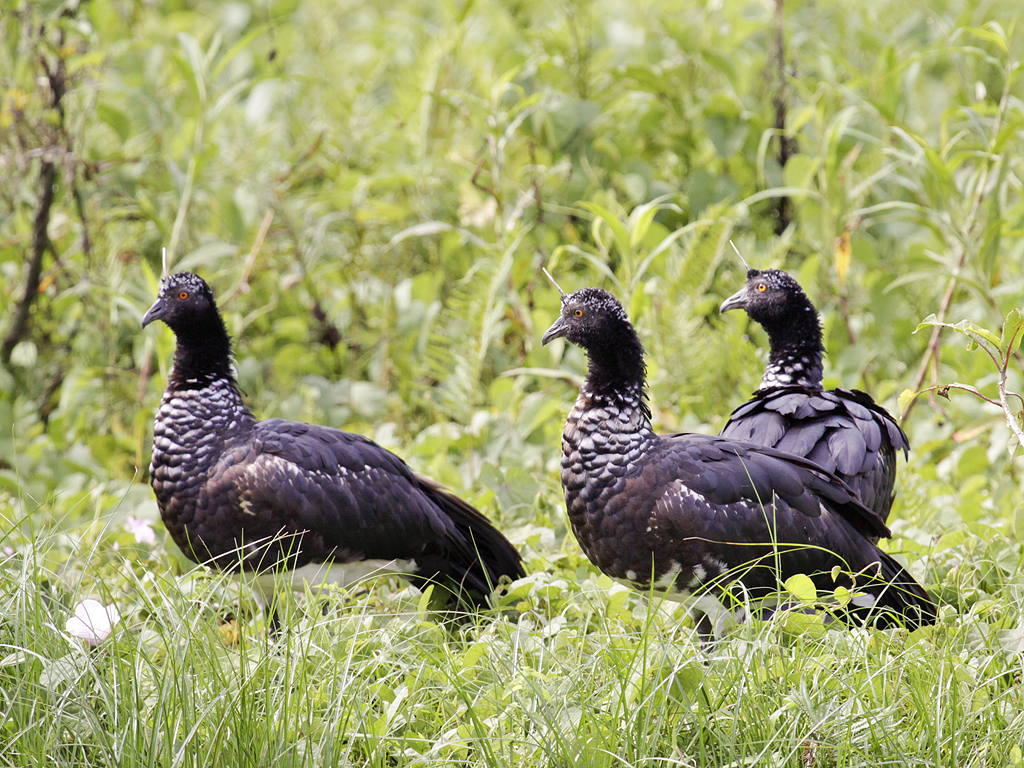
Wikipedia: Horned screamer Source: OTHER
Anhima_cornuta_-near_Manu_Wildlife_Center%2C_Manu_National_Park%2C_Peru_-three-8.jpg
![]() The horned screamer (Anhima cornuta) is a member of a small family of birds, the Anhimidae, which occurs in wetlands of tropical South America. There are three screamer species, the other two being the southern screamer and the northern screamer in the genus Chauna. They are related to the ducks, geese and swans, which are in the family Anatidae, but have bills looking more like those of game birds.
[more]
The horned screamer (Anhima cornuta) is a member of a small family of birds, the Anhimidae, which occurs in wetlands of tropical South America. There are three screamer species, the other two being the southern screamer and the northern screamer in the genus Chauna. They are related to the ducks, geese and swans, which are in the family Anatidae, but have bills looking more like those of game birds.
[more]
Neotropic cormorant / Olivenscharbe (Phalacrocorax brasilianus)
Profile Wikipedia eBird Audubon AllAboutBirds Xeno-Canto

Wikipedia: Neotropic cormorant Source: OTHER
1200px-Phalacrocorax_brasilianus_%28Costa_Rica%29.jpg
![]() The neotropic cormorant or olivaceous cormorant (Phalacrocorax brasilianus) is a medium-sized cormorant found throughout the American tropics and subtropics, from the middle Rio Grande and the Gulf and Californian coasts of the United States south through Mexico and Central America to southern South America, where it is called by the Indian name of biguá. It also breeds on the Bahamas, Cuba and Trinidad. It can be found both at coasts (including some mangrove areas) and on inland waters. There are at least two subspecies: P. b. mexicanus from Nicaragua northwards and P. b. brasilianus further south. In Peru the neotropic cormorant is used by the Uru people for fishing.
[more]
The neotropic cormorant or olivaceous cormorant (Phalacrocorax brasilianus) is a medium-sized cormorant found throughout the American tropics and subtropics, from the middle Rio Grande and the Gulf and Californian coasts of the United States south through Mexico and Central America to southern South America, where it is called by the Indian name of biguá. It also breeds on the Bahamas, Cuba and Trinidad. It can be found both at coasts (including some mangrove areas) and on inland waters. There are at least two subspecies: P. b. mexicanus from Nicaragua northwards and P. b. brasilianus further south. In Peru the neotropic cormorant is used by the Uru people for fishing.
[more]
Guanay shag / Guanokormoran (Leucocarbo bougainvillii)
![]() Der Guanokormoran oder Guanoscharbe[1] (Phalacrocorax bougainvilliorum, Syn.: Phalacrocorax bougainvillii, Leucocarbo bougainvillii, Protonym Carbo Bougainvillii[1]) ist ein sehr großer Vogel aus der Familie der Kormorane. In Südamerika ist er einer der wichtigsten Guano-Produzenten.[2]
[more]
Der Guanokormoran oder Guanoscharbe[1] (Phalacrocorax bougainvilliorum, Syn.: Phalacrocorax bougainvillii, Leucocarbo bougainvillii, Protonym Carbo Bougainvillii[1]) ist ein sehr großer Vogel aus der Familie der Kormorane. In Südamerika ist er einer der wichtigsten Guano-Produzenten.[2]
[more]
Great egret / Silberreiher (Ardea alba)

Silberreiher in Deutschland, von WikiCommons Von Andreas Eichler, CC BY-SA 4.0, https://commons.wikimedia.org/w/index.php?curid=59954907 Source: OTHER
Wikicommons 2016.10.30--Silberreiher.jpg
First observed in 🇨🇭 on 2021-02-24.
This bird appears across the great seas in the following continents:
Europe, North America, South America, Africa, Asia.
Auf dem Heimweg von Schwanden haben wir bei Benken ganz weisse Reiher gesehen.
Laut ornitho.ch waren sie Silberreiher.
Bei den meisten Quellen heisst es, sie sind in der Schweiz nur Durchzüger oder Wintergäste.
Aber laut Balzari und Gygax, brüten auch einige Vögel am Lac Neuchatel seit 2013.
Vocalization: ![]() Silent outside breeding ground. [Link]
Silent outside breeding ground. [Link]
Calls: ![]() In colonies various harsh calls like a dry, and mechanical "kerrrrrrr", and a very nasal "geet" or "ga-geet ga-geet" are heard. [Link]
In colonies various harsh calls like a dry, and mechanical "kerrrrrrr", and a very nasal "geet" or "ga-geet ga-geet" are heard. [Link]
Physical details: length=85-102 cm,
wingspan=140-170 cm,
weight=960-1030 g
Habitats:
Wetland
Call:
Partly an awkward quack: uck uck. Rattles. Deep-toned urrr. Higher-toned trill.
Call attributes:
Call melody: non-musical, slow, Frequency: low (1-3 KHz),
Great blue heron / Kanadareiher (Ardea herodias)
Profile Wikipedia eBird A-Z Animals Audubon AllAboutBirds Xeno-Canto
Great blue heron. 2022-04-28 18.15.08 Maryland
First observed in Maryland on 2021-06-17.
General: ![]() The great blue heron (Ardea herodias) is a large wading bird in the heron family Ardeidae, common near the shores of open water and in wetlands over most of North America and Central America, as well as the Caribbean and the Galápagos Islands. It is a rare vagrant to coastal Spain, the Azores, and areas of far southern Europe. An all-white population found in south Florida and the Florida Keys is known as the great white heron. Debate exists about whether this represents a white color morph of the great blue heron, a subspecies of it, or an entirely separate species.[2][3] The status of white individuals known to occur elsewhere in the Caribbean, and very rarely elsewhere in eastern North America, is unclear.[3]
[more]
The great blue heron (Ardea herodias) is a large wading bird in the heron family Ardeidae, common near the shores of open water and in wetlands over most of North America and Central America, as well as the Caribbean and the Galápagos Islands. It is a rare vagrant to coastal Spain, the Azores, and areas of far southern Europe. An all-white population found in south Florida and the Florida Keys is known as the great white heron. Debate exists about whether this represents a white color morph of the great blue heron, a subspecies of it, or an entirely separate species.[2][3] The status of white individuals known to occur elsewhere in the Caribbean, and very rarely elsewhere in eastern North America, is unclear.[3]
[more]
Cocoi heron / Cocoireiher (Ardea cocoi)
Profile Wikipedia eBird Xeno-Canto

Wikipedia: Cocoi heron Source: OTHER
1200px-Cocoi_heron_%28Ardea_cocoi%29_Pantanal.JPG
![]() The cocoi heron (Ardea cocoi) is a species of long-legged wading bird in the heron family Ardeidae found across South America. It has predominantly pale grey plumage with a darker grey crest. A carnivore, it hunts fish and crustaceans in shallow water.
[more]
The cocoi heron (Ardea cocoi) is a species of long-legged wading bird in the heron family Ardeidae found across South America. It has predominantly pale grey plumage with a darker grey crest. A carnivore, it hunts fish and crustaceans in shallow water.
[more]
Black-crowned night-heron / Nachtreiher (Nycticorax nycticorax)

Wikipedia: Black-crowned night-heron Source: OTHER
1200px-BCNH_CMCNJ_for_Wiki.png
This bird appears across the great seas in the following continents:
Europe, North America, South America, Africa, Asia.
![]() The black-crowned night heron (Nycticorax nycticorax), or black-capped night heron, commonly shortened to just night heron in Eurasia, is a medium-sized heron found throughout a large part of the world, except in the coldest regions and Australasia (where it is replaced by the closely related nankeen night heron, with which it has hybridized in the area of contact).
[more]
The black-crowned night heron (Nycticorax nycticorax), or black-capped night heron, commonly shortened to just night heron in Eurasia, is a medium-sized heron found throughout a large part of the world, except in the coldest regions and Australasia (where it is replaced by the closely related nankeen night heron, with which it has hybridized in the area of contact).
[more]
Calls: ![]() Most commonly hear call is a nasal, soft croaking "roack", like cross between Raven and frog. [Link]
Most commonly hear call is a nasal, soft croaking "roack", like cross between Raven and frog. [Link]
Physical details: length=58-65 cm,
wingspan=105-112 cm,
weight=500-800 g
Habitats:
Wetland
Snowy egret / Schmuckreiher (Egretta thula)
Profile Wikipedia eBird Audubon AllAboutBirds Xeno-Canto
Snowy egret at John's Pass, Madeira Beach, Florida. 2023-09-27 11.51.14 Florida
First observed in Yucatan on 2023-04-15.
This bird appears across the great seas in the following continents:
North America, South America, Africa.
General: ![]() The snowy egret (Egretta thula) is a small white heron. The genus name comes from Provençal French for the little egret, aigrette, which is a diminutive of aigron, 'heron'. The species name thula is the Araucano term for the black-necked swan, applied to this species in error by Chilean naturalist Juan Ignacio Molina in 1782.[3]
[more]
The snowy egret (Egretta thula) is a small white heron. The genus name comes from Provençal French for the little egret, aigrette, which is a diminutive of aigron, 'heron'. The species name thula is the Araucano term for the black-necked swan, applied to this species in error by Chilean naturalist Juan Ignacio Molina in 1782.[3]
[more]
Little blue heron / Blaureiher (Egretta caerulea)
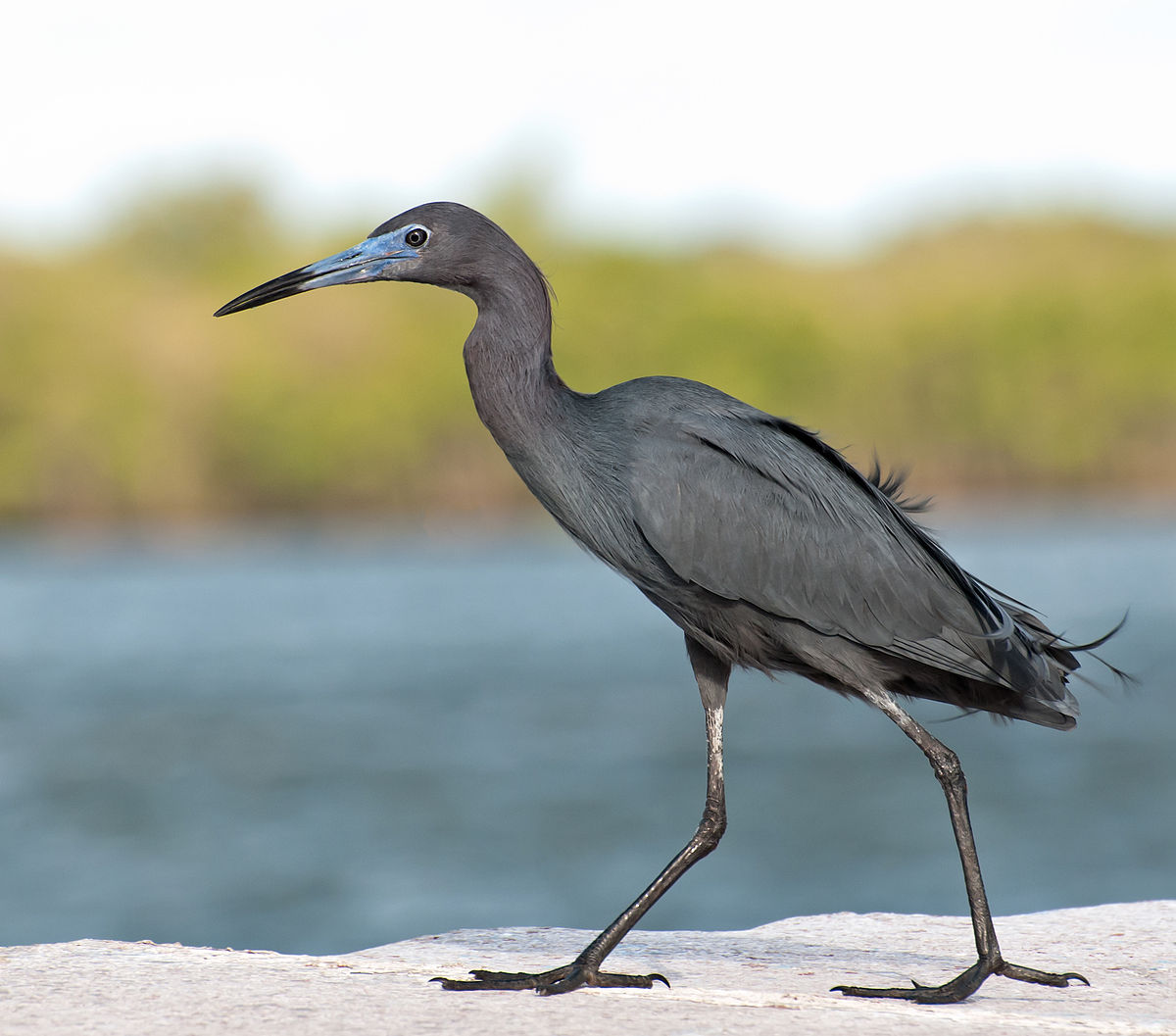
Wikipedia: Little blue heron Source: OTHER
1200px-Egretta_caerulea_-Cananeia%2C_Sao_Paulo%2C_Brasil-8.jpg
This bird appears across the great seas in the following continents:
North America, South America, Africa.
![]() The little blue heron (Egretta caerulea) is a small heron belonging to the family Ardeidae.
[more]
The little blue heron (Egretta caerulea) is a small heron belonging to the family Ardeidae.
[more]
Tricolored heron / Dreifarbenreiher (Egretta tricolor)
Profile Wikipedia eBird Audubon AllAboutBirds Xeno-Canto
Beautiful tricolored heron near Las Coloradas. 2023-04-15 10.04.30 Yucatan
First observed in Yucatan on 2023-04-15.
![]() The tricolored heron (Egretta tricolor), formerly known as the Louisiana heron, is a small species of heron native to coastal parts of the Americas; in the Atlantic region, it ranges from the northeastern United States, south along the coast, through the Gulf of Mexico and the Caribbean, to northern South America as far south as Brazil. In the Pacific region, it ranges from Peru to California, but it is only a nonbreeding visitor to the far north.
[more]
The tricolored heron (Egretta tricolor), formerly known as the Louisiana heron, is a small species of heron native to coastal parts of the Americas; in the Atlantic region, it ranges from the northeastern United States, south along the coast, through the Gulf of Mexico and the Caribbean, to northern South America as far south as Brazil. In the Pacific region, it ranges from Peru to California, but it is only a nonbreeding visitor to the far north.
[more]
Yellow-crowned night heron / Krabbenreiher (Nyctanassa violacea)
Yellow-crowned night heron in Manzanillo, Costa Rica. 2020-03-13 09.00.32 Costa Rica
First observed in Costa Rica on 2020-03-13.
![]() The yellow-crowned night heron (Nyctanassa violacea), is one of two species of night herons found in the Americas, the other one being the black-crowned night heron. It is known as the "bihoreau violacé" in French and the "pedrete corona clara" in Spanish.
[more]
The yellow-crowned night heron (Nyctanassa violacea), is one of two species of night herons found in the Americas, the other one being the black-crowned night heron. It is known as the "bihoreau violacé" in French and the "pedrete corona clara" in Spanish.
[more]
Pinnated bittern / Südamerikanische Rohrdommel (Botaurus pinnatus)

Wikipedia: Pinnated bittern Source: OTHER
1200px-Botaurus_pinnatus.jpg
![]() The pinnated bittern (Botaurus pinnatus), also known as the South American bittern, is a large member of the heron family (Ardeidae) found in the New World tropics. Like the other Botaurus bitterns, its plumage is mostly buffy-brown and cryptically patterned. Though it is a widespread species, it is rarely seen – presumably due to its skulking habits – and much about its life history remains little known.
[more]
The pinnated bittern (Botaurus pinnatus), also known as the South American bittern, is a large member of the heron family (Ardeidae) found in the New World tropics. Like the other Botaurus bitterns, its plumage is mostly buffy-brown and cryptically patterned. Though it is a widespread species, it is rarely seen – presumably due to its skulking habits – and much about its life history remains little known.
[more]
Cattle egret / Kuhreiher (Bubulcus ibis)
Cow-plus-cattle egret. 2020-03-07 15.17.34 Panama
First observed in Costa Rica on 2018-02-27.
This bird appears across the great seas in the following continents:
Europe, North America, South America, Africa, Asia.
![]() The cattle egret (Bubulcus ibis) is a cosmopolitan species of heron (family Ardeidae) found in the tropics, subtropics, and warm-temperate zones. It is the only member of the monotypic genus Bubulcus, although some authorities regard two of its subspecies as full species, the western cattle egret and the eastern cattle egret. Despite the similarities in plumage to the egrets of the genus Egretta, it is more closely related to the herons of Ardea. Originally native to parts of Asia, Africa, and Europe, it has undergone a rapid expansion in its distribution and successfully colonised much of the rest of the world in the last century.
[more]
The cattle egret (Bubulcus ibis) is a cosmopolitan species of heron (family Ardeidae) found in the tropics, subtropics, and warm-temperate zones. It is the only member of the monotypic genus Bubulcus, although some authorities regard two of its subspecies as full species, the western cattle egret and the eastern cattle egret. Despite the similarities in plumage to the egrets of the genus Egretta, it is more closely related to the herons of Ardea. Originally native to parts of Asia, Africa, and Europe, it has undergone a rapid expansion in its distribution and successfully colonised much of the rest of the world in the last century.
[more]
Vocalization: ![]() Usually silent away from breeding ground. In the colonies a chorus of various coarse sounds can be heard. Most distinct is a disyllabic "rick-rack". Other sounds includes short, guttural utterings, or drawn, harsh shrieks. [Link]
Usually silent away from breeding ground. In the colonies a chorus of various coarse sounds can be heard. Most distinct is a disyllabic "rick-rack". Other sounds includes short, guttural utterings, or drawn, harsh shrieks. [Link]
Physical details: length=48-53 cm,
wingspan=90-96 cm,
weight=300-400 g
Call:
Automatically generated from Xeno-Canto recording
♫ XC353848 - Western Cattle Egret - Bubulcus ibis - flight call - sevilla, andalucía, Spain. Source: XENOCANTO
XC353848 - Western Cattle Egret - Bubulcus ibis - flight call - sevilla, andalucía, Spain.mp3
Spain (flight call)
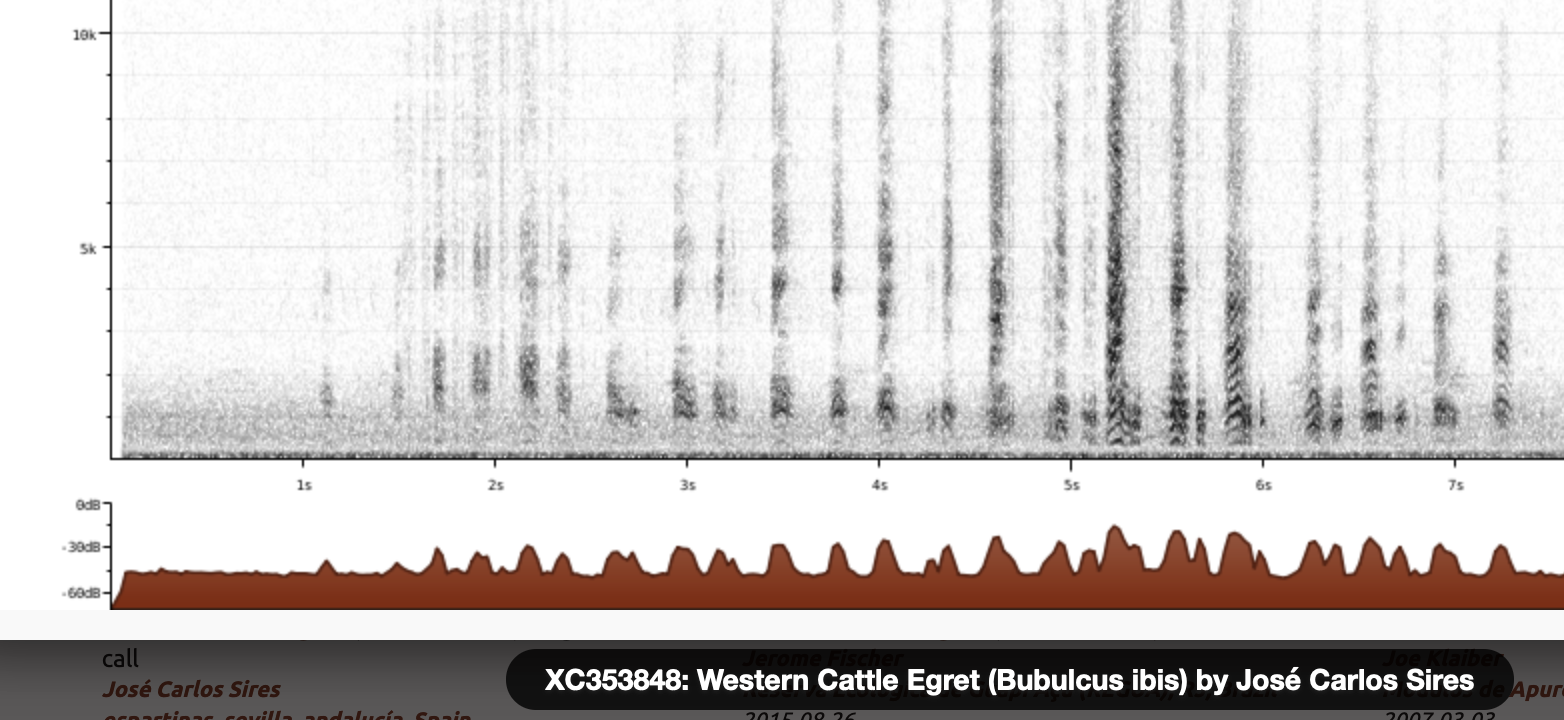
Call attributes:
flight call Frequency: ,
Green-backed heron (Butorides striata)
Striated heron. 2024-02-22 11.31.30 Laos
First observed in Laos on 2024-02-22.
This bird appears across the great seas in the following continents:
Europe, South America, Africa, Asia.
Song:
Automatically generated from Xeno-Canto recording
Song attributes:
Frequency:
♫ XC791519 - Striated Heron - Butorides striata - song, sounds like Ow plus pi-rol lhl, Copperbelt Province, Zambia. Source: XENOCANTO
XC791519 - Striated Heron - Butorides striata - song, sounds like Ow plus pi-rol lhl, Copperbelt Province, Zambia.mp3
(song)

Green heron / Grünreiher (Butorides virescens)
Green heron. 2023-04-16 08.37.04 Yucatan
First observed in Yucatan on 2023-04-16.
General: ![]() The green heron (Butorides virescens) is a small heron of North and Central America. Butorides is from Middle English butor "bittern" and Ancient Greek -oides, "resembling", and virescens is Latin for "greenish".[2]
[more]
The green heron (Butorides virescens) is a small heron of North and Central America. Butorides is from Middle English butor "bittern" and Ancient Greek -oides, "resembling", and virescens is Latin for "greenish".[2]
[more]
Boat-billed heron / Kahnschnabel (Cochlearius cochlearius)

Boat billed heron in Cahuita, Costa Rica. 2020-03-17 16.57.49 Costa Rica
First observed in Costa Rica on 2020-03-17.
![]() The boat-billed heron (Cochlearius cochlearius), colloquially known as the boatbill, is an atypical member of the heron family, and was formerly placed in a monotypic family, the Cochlearidae. It lives in mangrove swamps from Mexico south to Peru and Brazil. It is a nocturnal bird, and breeds semicolonially in mangrove trees, laying two to four bluish-white eggs in a twig nest.
[more]
The boat-billed heron (Cochlearius cochlearius), colloquially known as the boatbill, is an atypical member of the heron family, and was formerly placed in a monotypic family, the Cochlearidae. It lives in mangrove swamps from Mexico south to Peru and Brazil. It is a nocturnal bird, and breeds semicolonially in mangrove trees, laying two to four bluish-white eggs in a twig nest.
[more]
Least bittern / Amerikanische Zwergdommel (Ixobrychus exilis)
Profile Wikipedia eBird Audubon AllAboutBirds Xeno-Canto
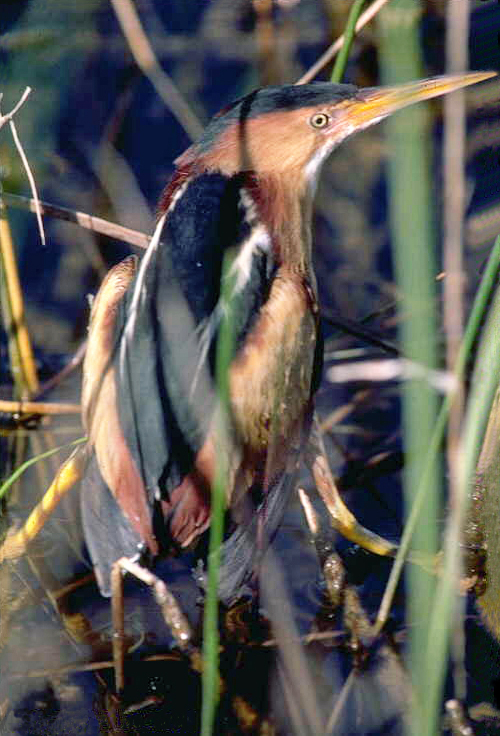
Wikipedia: Least bittern Source: OTHER
Ixobrychus_exilis.jpg
![]() The least bittern (Ixobrychus exilis) is a small heron, the smallest member of the family Ardeidae found in the Americas.
[more]
The least bittern (Ixobrychus exilis) is a small heron, the smallest member of the family Ardeidae found in the Americas.
[more]
Fasciated tiger heron / Streifenreiher (Tigrisoma fasciatum)
Fasciated tiger heron. 2020-02-19 06.59.06 Panama
First observed in Panama on 2020-02-19.
We saw this on a guided tour of the Pipeline Road near Gamboa, Panama, which is named after an oil pipeline built to ensure supply during World War II, but never actually put into service, and now providing access to Soberania National Park.
General: ![]() The fasciated tiger heron (Tigrisoma fasciatum) is a species of heron in the family Ardeidae. It is present in southern Central America and parts of northern and central South America, where its natural habitat is rivers.
[more]
The fasciated tiger heron (Tigrisoma fasciatum) is a species of heron in the family Ardeidae. It is present in southern Central America and parts of northern and central South America, where its natural habitat is rivers.
[more]
Rufescent tiger-heron / Marmorreiher (Tigrisoma lineatum)
Profile Wikipedia eBird Xeno-Canto
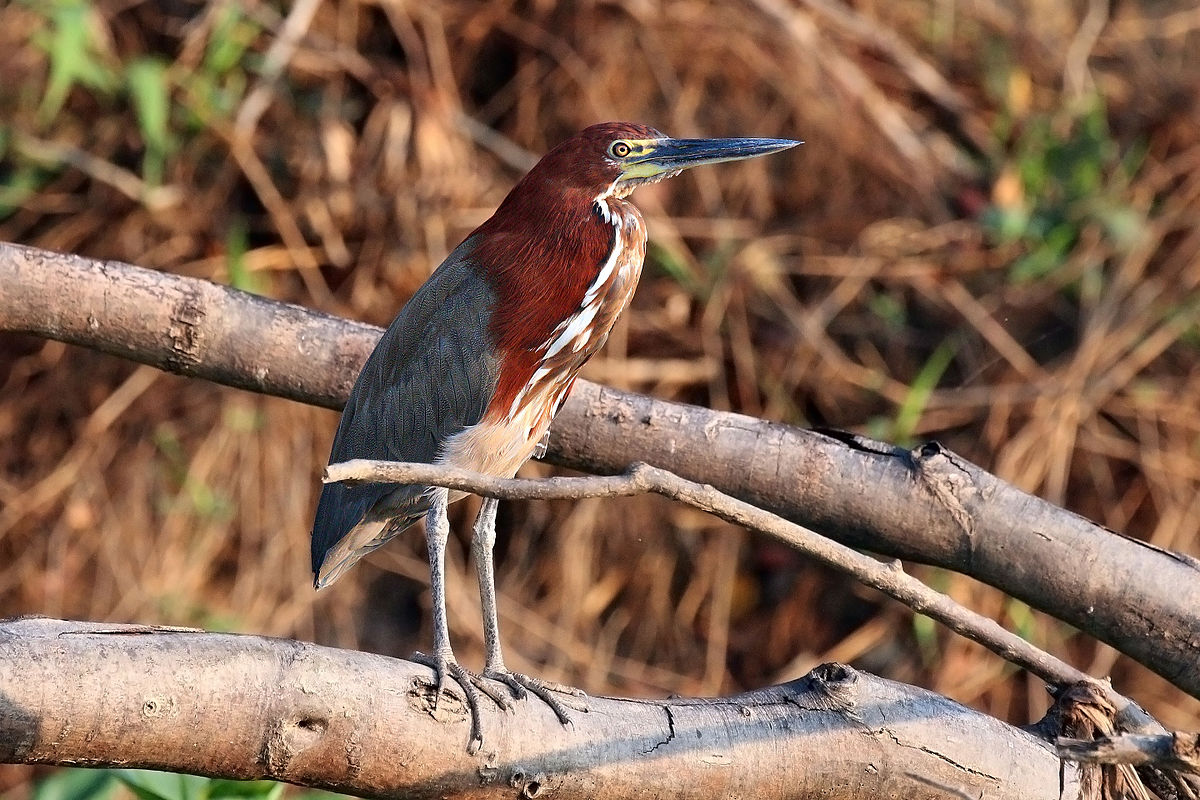
Wikipedia: Rufescent tiger-heron Source: OTHER
1200px-Rufescent_tiger_heron_%28Tigrisoma_lineatum%29.JPG
![]() The rufescent tiger heron (Tigrisoma lineatum) is a species of heron in the family Ardeidae. It is found in wetlands from Central America through much of South America.
[more]
The rufescent tiger heron (Tigrisoma lineatum) is a species of heron in the family Ardeidae. It is found in wetlands from Central America through much of South America.
[more]
Zigzag heron (Zebrilus undulatus)
Profile Wikipedia eBird Xeno-Canto
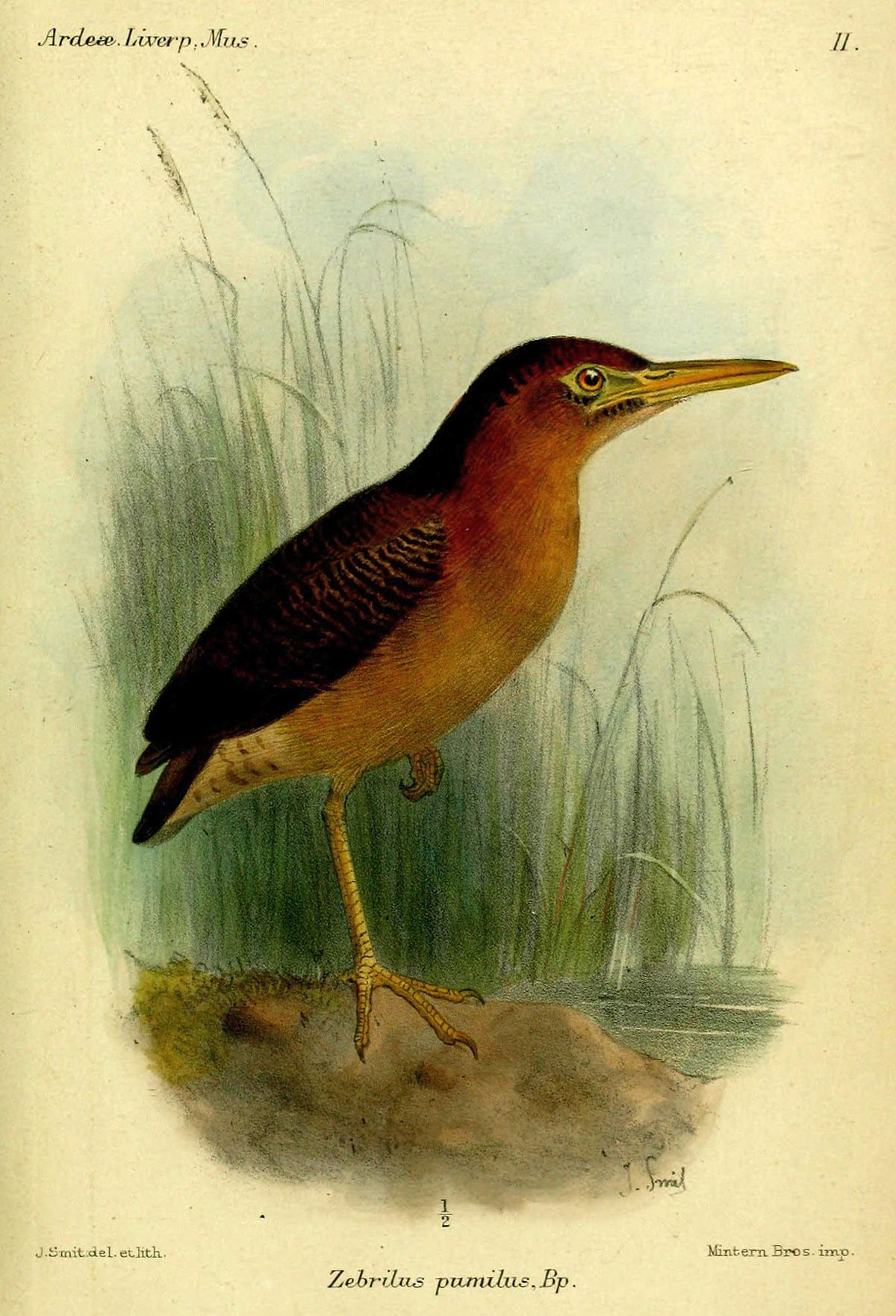
Wikipedia: Zigzag heron Source: OTHER
1200px-ZebrilusPumilus1Smit.jpg
![]() The zigzag heron (Zebrilus undulatus) is a species of heron in the family Ardeidae, also including egrets and bitterns. It is in the monotypic genus Zebrilus.[2] It is found in Bolivia, Brazil, Colombia, Ecuador, French Guiana, Guyana, Peru, Suriname, and Venezuela. Its natural habitat is subtropical or tropical swamps.
[more]
The zigzag heron (Zebrilus undulatus) is a species of heron in the family Ardeidae, also including egrets and bitterns. It is in the monotypic genus Zebrilus.[2] It is found in Bolivia, Brazil, Colombia, Ecuador, French Guiana, Guyana, Peru, Suriname, and Venezuela. Its natural habitat is subtropical or tropical swamps.
[more]
Agami heron (Agamia agami)
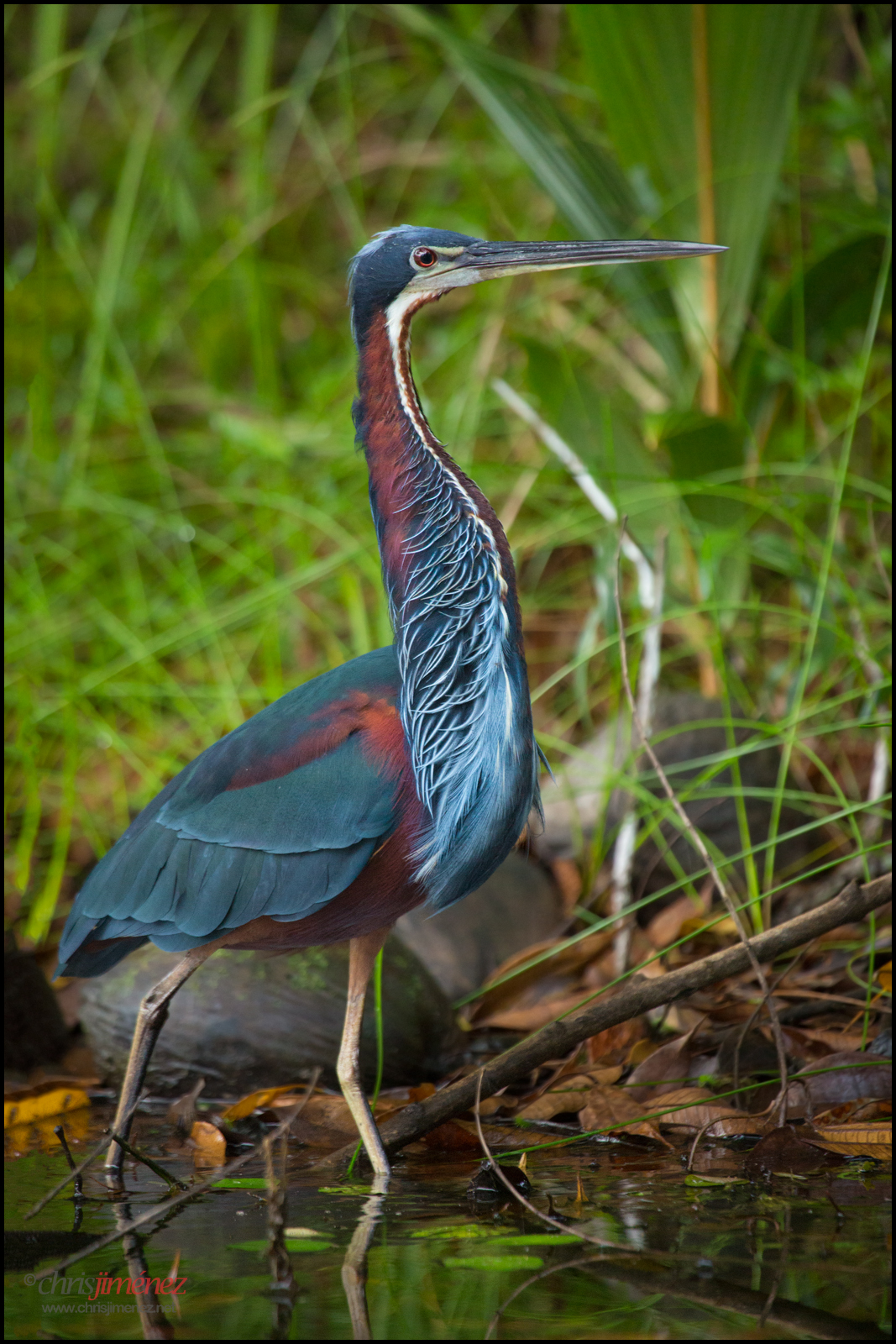
Wikipedia: Agami heron Source: OTHER
Agami_Heron_%28Agamia_agami%29.jpg
![]() The agami heron (Agamia agami) is a medium-sized heron. It is a resident breeding bird from Central America south to Peru and Brazil. It is sometimes known as the chestnut-bellied heron, and is the only member of the genus Agamia (Reichenbach, 1853). In Brazil it is sometimes called Soco beija-flor, meaning 'hummingbird heron', thanks to its unique coloration pattern.[2]
[more]
The agami heron (Agamia agami) is a medium-sized heron. It is a resident breeding bird from Central America south to Peru and Brazil. It is sometimes known as the chestnut-bellied heron, and is the only member of the genus Agamia (Reichenbach, 1853). In Brazil it is sometimes called Soco beija-flor, meaning 'hummingbird heron', thanks to its unique coloration pattern.[2]
[more]
Capped heron / Kappenreiher (Pilherodius pileatus)

Wikipedia: Capped heron Source: OTHER
1200px-Kappenreiher_Pilherodius_pileatus.jpg
![]() The capped heron (Pilherodius pileatus) is a water bird endemic to the neotropics, inhabiting rainforest from the center of Panama to the south of Brazil.[2] It is the only species of the genus Pilherodius, and one of the least known of the heron family, Ardeidae. It is superficially similar to the group of the night herons, but is active during daytime or at twilight.[3]
[more]
The capped heron (Pilherodius pileatus) is a water bird endemic to the neotropics, inhabiting rainforest from the center of Panama to the south of Brazil.[2] It is the only species of the genus Pilherodius, and one of the least known of the heron family, Ardeidae. It is superficially similar to the group of the night herons, but is active during daytime or at twilight.[3]
[more]
American anhinga (Anhinga anhinga)
Wonderful patterns of an anhinga near RIo Lagartos. 2023-04-15 08.57.48 Yucatan
First observed in Yucatan on 2023-04-15.
Great frigatebird / Bindenfregattvogel (Fregata minor)
Profile Wikipedia eBird Audubon AllAboutBirds Xeno-Canto
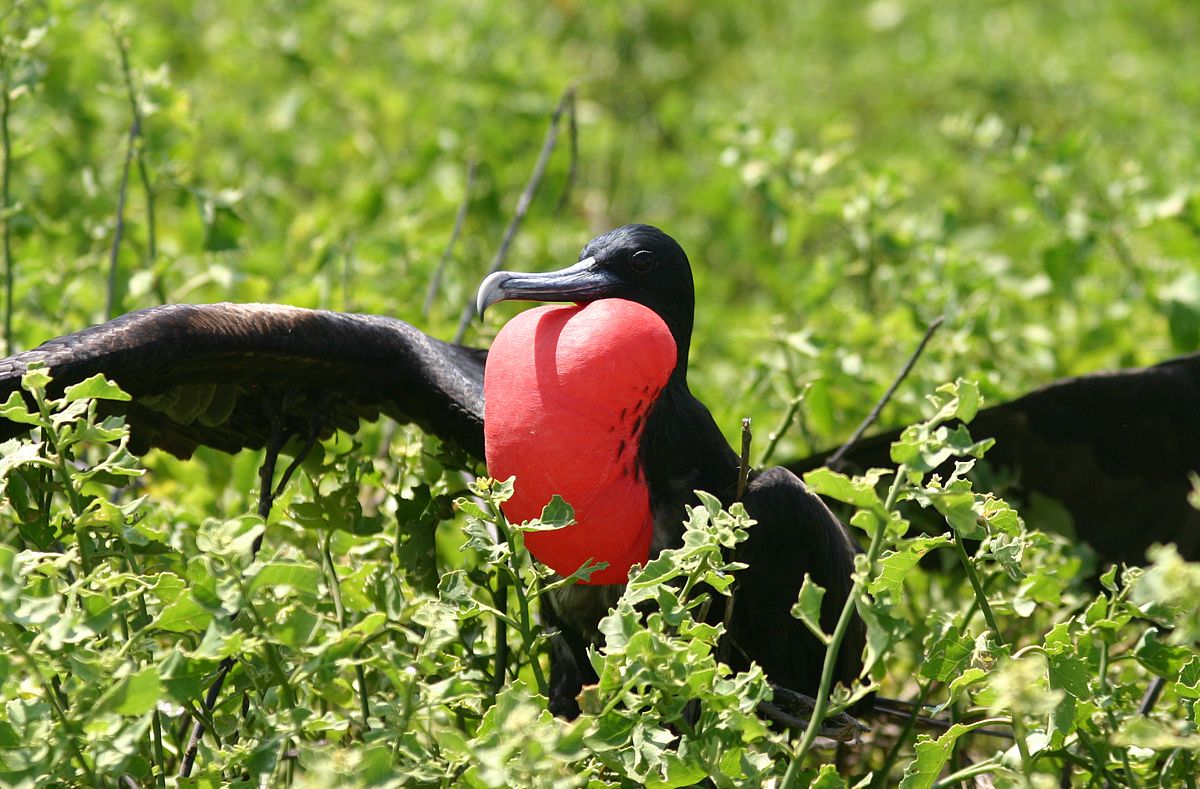
Wikipedia: Great frigatebird Source: OTHER
1200px-Male_greater_frigate_bird_displaying.jpg
This bird appears across the great seas in the following continents:
North America, South America, Africa, Asia.
![]() The great frigatebird (Fregata minor) is a large seabird in the frigatebird family. There are major nesting populations in the tropical Pacific (including the Galapagos Islands) and Indian Oceans, as well as a tiny population in the South Atlantic.
[more]
The great frigatebird (Fregata minor) is a large seabird in the frigatebird family. There are major nesting populations in the tropical Pacific (including the Galapagos Islands) and Indian Oceans, as well as a tiny population in the South Atlantic.
[more]
Magnificent frigatebird / Prachtfregattvogel (Fregata magnificens)
Profile Wikipedia eBird Audubon AllAboutBirds Xeno-Canto
Magnificent frigatebirds in Puerto Morelos. 2023-03-26 13.47.02 Yucatan
First observed in Yucatan on 2023-03-26.
This bird appears across the great seas in the following continents:
North America, South America, Africa.
![]() The magnificent frigatebird (Fregata magnificens) or man o' war is a seabird of the frigatebird family Fregatidae. With a length of 89–114 centimetres (35–45 in) and wingspan of 2.17–2.44 m (7.1–8.0 ft) it is the largest species of frigatebird. It occurs over tropical and subtropical waters off America, between northern Mexico and Perú on the Pacific coast and between Florida and southern Brazil along the Atlantic coast.[1] There are also populations on the Galápagos Islands in the Pacific and the Cape Verde islands in the Atlantic.
[more]
The magnificent frigatebird (Fregata magnificens) or man o' war is a seabird of the frigatebird family Fregatidae. With a length of 89–114 centimetres (35–45 in) and wingspan of 2.17–2.44 m (7.1–8.0 ft) it is the largest species of frigatebird. It occurs over tropical and subtropical waters off America, between northern Mexico and Perú on the Pacific coast and between Florida and southern Brazil along the Atlantic coast.[1] There are also populations on the Galápagos Islands in the Pacific and the Cape Verde islands in the Atlantic.
[more]
Brown pelican (Pelecanus occidentalis)
Profile Wikipedia eBird Audubon AllAboutBirds Xeno-Canto
Brown pelican, Madeira Beach, Florida. 2023-09-27 11.48.26 Florida
First observed in Panama on 2020-03-08.
![]() The brown pelican (Pelecanus occidentalis) is a bird of the pelican family, Pelecanidae, one of three species found in the Americas and one of two that feed by diving into water. It is found on the Atlantic Coast from New Jersey to the mouth of the Amazon River, and along the Pacific Coast from British Columbia to northern Chile, including the Galapagos Islands. The nominate subspecies in its breeding plumage has a white head with a yellowish wash on the crown. The nape and neck are dark maroon–brown. The upper sides of the neck have white lines along the base of the gular pouch, and the lower fore neck has a pale yellowish patch. The male and female are similar, but the female is slightly smaller. The nonbreeding adult has a white head and neck. The pink skin around the eyes becomes dull and gray in the nonbreeding season. It lacks any red hue, and the pouch is strongly olivaceous ochre-tinged and the legs are olivaceous gray to blackish-gray.
[more]
The brown pelican (Pelecanus occidentalis) is a bird of the pelican family, Pelecanidae, one of three species found in the Americas and one of two that feed by diving into water. It is found on the Atlantic Coast from New Jersey to the mouth of the Amazon River, and along the Pacific Coast from British Columbia to northern Chile, including the Galapagos Islands. The nominate subspecies in its breeding plumage has a white head with a yellowish wash on the crown. The nape and neck are dark maroon–brown. The upper sides of the neck have white lines along the base of the gular pouch, and the lower fore neck has a pale yellowish patch. The male and female are similar, but the female is slightly smaller. The nonbreeding adult has a white head and neck. The pink skin around the eyes becomes dull and gray in the nonbreeding season. It lacks any red hue, and the pouch is strongly olivaceous ochre-tinged and the legs are olivaceous gray to blackish-gray.
[more]
Peruvian pelican / Chilepelikan (Pelecanus thagus)

Wikipedia: Peruvian pelican Source: OTHER
1200px-Pel%C3%ADcano_en_Pucusana.JPG
![]() The Peruvian pelican (Pelecanus thagus) is a member of the pelican family. It lives on the west coast of South America, breeding in loose colonies from about 33.5° in central Chile to Piura in northern Peru, and occurring as a visitor in southern Chile and Ecuador.[2]
[more]
The Peruvian pelican (Pelecanus thagus) is a member of the pelican family. It lives on the west coast of South America, breeding in loose colonies from about 33.5° in central Chile to Piura in northern Peru, and occurring as a visitor in southern Chile and Ecuador.[2]
[more]
Red-billed tropicbird / Rotschnabel-Tropikvogel (Phaethon aethereus)
Profile Wikipedia eBird Audubon AllAboutBirds Xeno-Canto

Wikipedia: Red-billed tropicbird Source: OTHER
1200px-Red-billed_tropicbird.jpg
This bird appears across the great seas in the following continents:
North America, South America, Africa.
![]() The red-billed tropicbird (Phaethon aethereus) is a tropicbird, one of three closely related species of seabird of tropical oceans. Superficially resembling a tern in appearance, it has mostly white plumage with some black markings on the wings and back, a black mask and, as its common name suggests, a red bill. Most adults have tail streamers that are about two times their body length, with those in males being generally longer than those in females. The red-billed tropicbird itself has three subspecies recognized, including the nominate. The subspecies mesonauta is distinguished from the nominate by the rosy tinge of its fresh plumage, and the subspecies indicus can be differentiated by its smaller size, more restricted mask, and more orange bill. This species ranges across the tropical Atlantic, eastern Pacific, and Indian Oceans. The nominate is found in the southern Atlantic Ocean, the subspecies indicus in the waters off of the Middle East and in the Indian Ocean, and the subspecies mesonauta in the eastern portions of both the Atlantic and the Pacific Oceans and in the Caribbean. It was one of the many species described by Carl Linnaeus in his 1758 10th edition of Systema Naturae.
[more]
The red-billed tropicbird (Phaethon aethereus) is a tropicbird, one of three closely related species of seabird of tropical oceans. Superficially resembling a tern in appearance, it has mostly white plumage with some black markings on the wings and back, a black mask and, as its common name suggests, a red bill. Most adults have tail streamers that are about two times their body length, with those in males being generally longer than those in females. The red-billed tropicbird itself has three subspecies recognized, including the nominate. The subspecies mesonauta is distinguished from the nominate by the rosy tinge of its fresh plumage, and the subspecies indicus can be differentiated by its smaller size, more restricted mask, and more orange bill. This species ranges across the tropical Atlantic, eastern Pacific, and Indian Oceans. The nominate is found in the southern Atlantic Ocean, the subspecies indicus in the waters off of the Middle East and in the Indian Ocean, and the subspecies mesonauta in the eastern portions of both the Atlantic and the Pacific Oceans and in the Caribbean. It was one of the many species described by Carl Linnaeus in his 1758 10th edition of Systema Naturae.
[more]
Red-footed booby / Rotfußtölpel (Sula sula)
Profile Wikipedia eBird Audubon AllAboutBirds Xeno-Canto
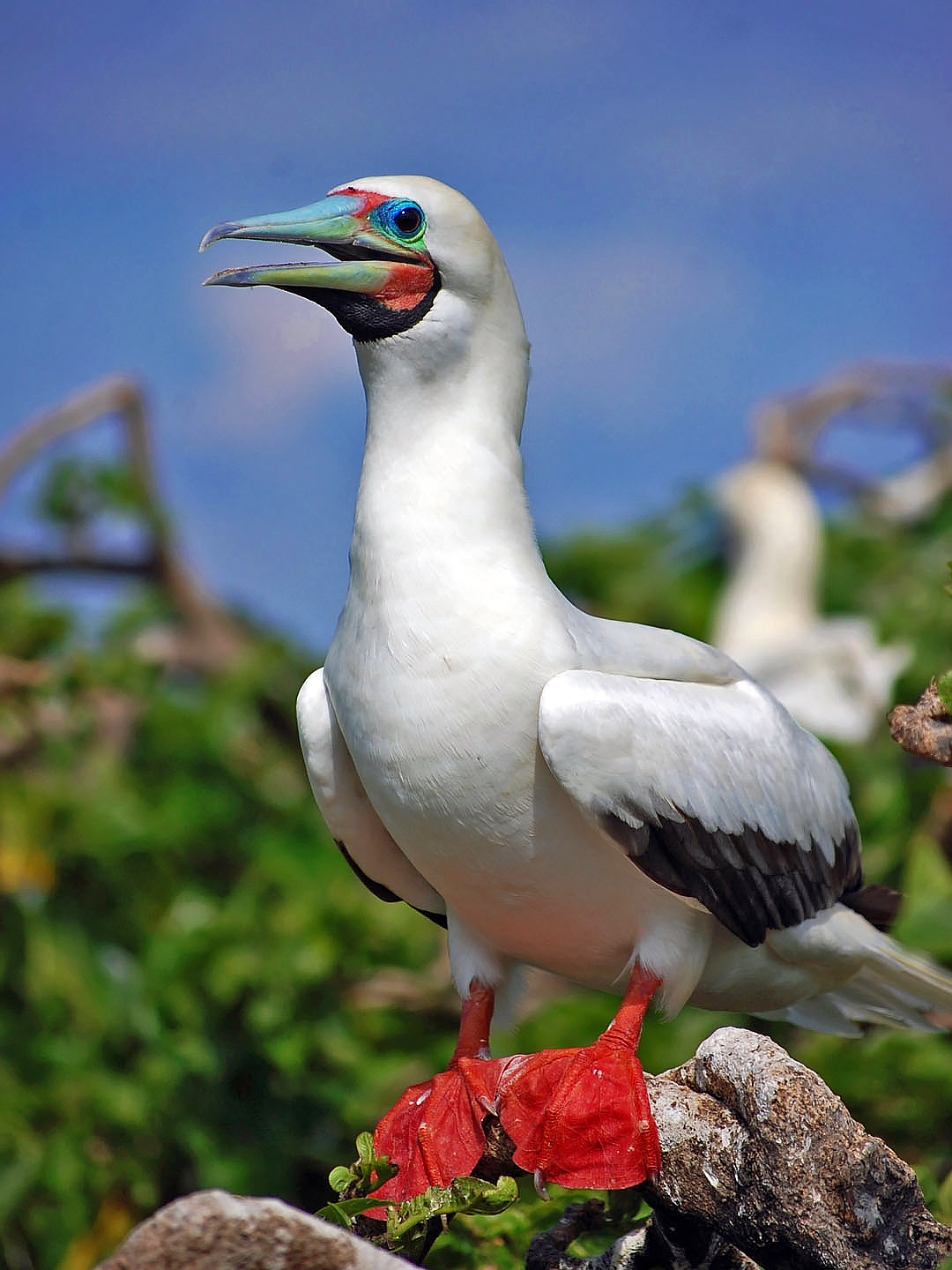
Wikipedia: Red-footed booby Source: OTHER
Sula_sula_by_Gregg_Yan_01.jpg
This bird appears across the great seas in the following continents:
North America, South America, Africa.
![]() The red-footed booby (Sula sula) is a large seabird of the booby family, Sulidae. Adults always have red feet, but the colour of the plumage varies. They are powerful and agile fliers, but they are clumsy in takeoffs and landings. They are found widely in the tropics, and breed colonially in coastal regions, especially islands. The species faces few natural or man-made threats, although its population is declining; it is considered to be a least-concern species by the International Union for Conservation of Nature (IUCN).
[more]
The red-footed booby (Sula sula) is a large seabird of the booby family, Sulidae. Adults always have red feet, but the colour of the plumage varies. They are powerful and agile fliers, but they are clumsy in takeoffs and landings. They are found widely in the tropics, and breed colonially in coastal regions, especially islands. The species faces few natural or man-made threats, although its population is declining; it is considered to be a least-concern species by the International Union for Conservation of Nature (IUCN).
[more]
Nazca booby / Nazcatölpel (Sula granti)
Profile Wikipedia eBird Xeno-Canto

Wikipedia: Nazca booby Source: OTHER
1200px-Nazca-Booby.jpg
![]() The Nazca booby (Sula granti) is a large seabird of the booby family, Sulidae, native to the eastern Pacific. First described by Walter Rothschild in 1902, it was long considered a subspecies of the masked booby until recognised as distinct genetically and behaviorally in 2002. It has a typical sulid body shape, with a long pointed orange-yellow bill, long neck, aerodynamic body, long slender wings and pointed tail. The adult is bright white with black and white wings, a black tail and a dark face mask.
[more]
The Nazca booby (Sula granti) is a large seabird of the booby family, Sulidae, native to the eastern Pacific. First described by Walter Rothschild in 1902, it was long considered a subspecies of the masked booby until recognised as distinct genetically and behaviorally in 2002. It has a typical sulid body shape, with a long pointed orange-yellow bill, long neck, aerodynamic body, long slender wings and pointed tail. The adult is bright white with black and white wings, a black tail and a dark face mask.
[more]
Blue-footed booby / Blaufußtölpel (Sula nebouxii)
Profile Wikipedia eBird Xeno-Canto

Wikipedia: Blue-footed booby Source: OTHER
Blue-footed-booby.jpg
![]() The blue-footed booby (Sula nebouxii) is a marine bird native to subtropical and tropical regions of the eastern Pacific Ocean. It is one of six species of the genus Sula – known as boobies. It is easily recognizable by its distinctive bright blue feet, which is a sexually selected trait. Males display their feet in an elaborate mating ritual by lifting them up and down while strutting before the female. The female is slightly larger than the male and can measure up to 90 cm (35 in) long with a wingspan up to 1.5 m (5 ft).[2]
[more]
The blue-footed booby (Sula nebouxii) is a marine bird native to subtropical and tropical regions of the eastern Pacific Ocean. It is one of six species of the genus Sula – known as boobies. It is easily recognizable by its distinctive bright blue feet, which is a sexually selected trait. Males display their feet in an elaborate mating ritual by lifting them up and down while strutting before the female. The female is slightly larger than the male and can measure up to 90 cm (35 in) long with a wingspan up to 1.5 m (5 ft).[2]
[more]
Peruvian booby / Guanotölpel (Sula variegata)
Profile Wikipedia eBird Xeno-Canto

Wikipedia: Peruvian booby Source: OTHER
Fou.varie1.jpg
![]() The Peruvian booby (Sula variegata) is an endemic bird of the Peruvian current, and an important predator of the marine community to which it belongs.[3] Its distribution is much less widespread than other closely related booby species. It is the most abundant seabird species that inhabits the Peruvian coast[4] and the second most important guano-producing seabird. During the mid-twentieth century, the Peruvian booby population reached 3 million birds.[5]
[more]
The Peruvian booby (Sula variegata) is an endemic bird of the Peruvian current, and an important predator of the marine community to which it belongs.[3] Its distribution is much less widespread than other closely related booby species. It is the most abundant seabird species that inhabits the Peruvian coast[4] and the second most important guano-producing seabird. During the mid-twentieth century, the Peruvian booby population reached 3 million birds.[5]
[more]
Glossy ibis / Brauner Sichler (Plegadis falcinellus)
Sichler nach ornitho, Brauner Sichler nach Wikipedia oder Plegadis falcinellus, Neeracherried. Source: WIKIPEDIA
20220904_071146-DSC_0059 Sichler nach ornitho, Brauner Sichler nach Wikipedia oder Plegadis falcinellus, Neeracherried.JPG
2022-09-04 07.11.46
First observed in 🇨🇭 on 2022-09-04.
This bird appears across the great seas in the following continents:
Europe, North America, South America, Africa, Asia.
![]() The glossy ibis (Plegadis falcinellus) is a water bird in the order Pelecaniformes and the ibis and spoonbill family Threskiornithidae. The scientific name derives from Ancient Greek plegados and Latin, falcis, both meaning "sickle" and referring to the distinctive shape of the bill.[2]
[more]
The glossy ibis (Plegadis falcinellus) is a water bird in the order Pelecaniformes and the ibis and spoonbill family Threskiornithidae. The scientific name derives from Ancient Greek plegados and Latin, falcis, both meaning "sickle" and referring to the distinctive shape of the bill.[2]
[more]
Vocalization: ![]() Generally silent away from breeding ground. Dry, crow-like "garr garr", may be heard occasionally in flight. At breeding ground various guttural grunts, and piping, hissing sounds. [Link]
Generally silent away from breeding ground. Dry, crow-like "garr garr", may be heard occasionally in flight. At breeding ground various guttural grunts, and piping, hissing sounds. [Link]
Physical details: length=55-65 cm,
wingspan=80-95 cm,
weight=530-768 g
Roseate spoonbill / Rosalöffler (Platalea ajaja)
Roseate spoonbills near Rio Lagartos. 2023-04-15 08.56.42 Yucatan
First observed in Yucatan on 2023-04-15.
General: ![]() The roseate spoonbill (Platalea ajaja) is a gregarious wading bird of the ibis and spoonbill family, Threskiornithidae. It is a resident breeder in South America mostly east of the Andes, and in coastal regions of the Caribbean, Central America, Mexico, the Gulf Coast of the United States,[2][3] and from central Florida's Atlantic coast[4] at Merritt Island National Wildlife Refuge, adjoined with NASA Kennedy Space Center at least as far north as South Carolina's Myrtle Beach.[5]
[more]
The roseate spoonbill (Platalea ajaja) is a gregarious wading bird of the ibis and spoonbill family, Threskiornithidae. It is a resident breeder in South America mostly east of the Andes, and in coastal regions of the Caribbean, Central America, Mexico, the Gulf Coast of the United States,[2][3] and from central Florida's Atlantic coast[4] at Merritt Island National Wildlife Refuge, adjoined with NASA Kennedy Space Center at least as far north as South Carolina's Myrtle Beach.[5]
[more]
White ibis (Eudocimus albus)
Profile Wikipedia eBird Audubon AllAboutBirds Xeno-Canto
White ibises in flight, St Petersburg. 2023-09-23 19.16.50 Florida
First observed in Florida on 2023-09-23.
Scarlet ibis (Eudocimus ruber)
Profile Wikipedia eBird Xeno-Canto

Wikipedia: Scarlet ibis Source: OTHER
1200px-Oceanografic_Scarlet_Ibis_02.jpg
![]() The scarlet ibis (Eudocimus ruber) is a species of ibis in the bird family Threskiornithidae. It inhabits tropical South America and part of the Caribbean. In form, it resembles most of the other twenty-seven extant species of ibis, but its remarkably brilliant scarlet coloration makes it unmistakable. It is one of the two national birds of Trinidad and Tobago, and its Tupi–Guarani name, guará, is part of the name of several municipalities along the coast of Brazil.[2]
[more]
The scarlet ibis (Eudocimus ruber) is a species of ibis in the bird family Threskiornithidae. It inhabits tropical South America and part of the Caribbean. In form, it resembles most of the other twenty-seven extant species of ibis, but its remarkably brilliant scarlet coloration makes it unmistakable. It is one of the two national birds of Trinidad and Tobago, and its Tupi–Guarani name, guará, is part of the name of several municipalities along the coast of Brazil.[2]
[more]
Andean ibis (Theristicus branickii)
Profile Wikipedia eBird Xeno-Canto

Wikipedia: Andean ibis Source: OTHER
1200px-Theristicus_branickii_63684956.jpg
![]() The Andean ibis (Theristicus branickii) is a species of bird in the family Threskiornithidae. It is found in grassland and fields in western South America. This species was considered a subspecies of the black-faced ibis, and some taxonomic authorities (including the American Ornithological Society) still consider it so.
[more]
The Andean ibis (Theristicus branickii) is a species of bird in the family Threskiornithidae. It is found in grassland and fields in western South America. This species was considered a subspecies of the black-faced ibis, and some taxonomic authorities (including the American Ornithological Society) still consider it so.
[more]
Bare-faced ibis / Mohrenibis (Phimosus infuscatus)
Profile Wikipedia eBird Xeno-Canto

Wikipedia: Bare-faced ibis Source: OTHER
1200px-Bare-faced_ibis_%28Phimosus_infuscatus%29.JPG
![]() The bare-faced ibis (Phimosus infuscatus), also known as the whispering ibis, is a species of bird in the family Threskiornithidae, in the monotypic genus Phimosus.[2]
[more]
The bare-faced ibis (Phimosus infuscatus), also known as the whispering ibis, is a species of bird in the family Threskiornithidae, in the monotypic genus Phimosus.[2]
[more]
Green ibis / Grünibis (Mesembrinibis cayennensis)
Profile Wikipedia eBird Xeno-Canto

Wikipedia: Green ibis Source: OTHER
1200px-Green_ibis_%28Mesembrinibis_cayennensis%29.JPG
![]() The green ibis (Mesembrinibis cayennensis), also known as the Cayenne ibis, is a wading bird in the ibis family Threskiornithidae. It is the only member of the genus Mesembrinibis.
[more]
The green ibis (Mesembrinibis cayennensis), also known as the Cayenne ibis, is a wading bird in the ibis family Threskiornithidae. It is the only member of the genus Mesembrinibis.
[more]
Profile Wikipedia eBird A-Z Animals Vogelwarte BirdLife ZH ornitho.ch bird-song.ch Audubon AllAboutBirds Xeno-Canto BirdID NABU
Barn swallow. 2022-05-05 09.41.44 Maryland
First observed in 🇨🇭 on 2020-04-16.
This bird appears across the great seas in the following continents:
Europe, North America, South America, Africa, Asia.
Die langen Schwanzfedern vom Rauchschwalbe und anderen geben auch dem Schmetterling Schwalbenschwanz seine deutschen Namen.
Etymology: ![]() In früheren Jahrhunderten flogen sie vielfach durch die Öffnungen im Giebel ein und aus, durch die auch der Rauch des Herdfeuers abzog. So erhielten sie den Namen Rauchschwalben. [Link]
In früheren Jahrhunderten flogen sie vielfach durch die Öffnungen im Giebel ein und aus, durch die auch der Rauch des Herdfeuers abzog. So erhielten sie den Namen Rauchschwalben. [Link]
Appearance and identification: ![]() Rauchschwalbes Bauch ist etwas braun rot, nicht weiss wie der von der Mehlschwalbe - was wahrscheinlich Quelle der zwei Namen ist. [Link]
Rauchschwalbes Bauch ist etwas braun rot, nicht weiss wie der von der Mehlschwalbe - was wahrscheinlich Quelle der zwei Namen ist. [Link]
Song: ![]() Characteristic calls and song. Song a sparkling, squeaky energetic improvisation with interspersed contact calls, often with diagnostic ending; an electric and drawn-out "su-eerrrrrrrrrrrrrrr". [Link]
Characteristic calls and song. Song a sparkling, squeaky energetic improvisation with interspersed contact calls, often with diagnostic ending; an electric and drawn-out "su-eerrrrrrrrrrrrrrr". [Link]
Calls: ![]() Contact call a short and sharp "weet" or "kee-weet". [Link]
Contact call a short and sharp "weet" or "kee-weet". [Link]
Physical details: length=17-19 cm,
wingspan=32-34 cm,
weight=16-22 g
Habitats:
Settlement
Looks similar to:
Common house martin.
Song:
General: Squeaky with occasional buzzes, usually heard in flock.
Song: ![]() Kann melodisch sein wenn einzeln gehört statt viele zusammen. [Link]
Kann melodisch sein wenn einzeln gehört statt viele zusammen. [Link]
Song attributes:
Melody: stereotype melodic, fast, Frequency: 2-6 KHz
Call:
Automatically generated from Xeno-Canto recording
♫ Barn swallows on the hunt, some quite high. 2020-08-18 13.01.00 Luppmen (song?)

Wikipedia: White-banded swallow Source: OTHER
1200px-White-banded_swallow_%28Atticora_fasciata%29.JPG
General: ![]() The white-banded swallow (Atticora fasciata) is a species of bird in the family Hirundinidae. They are black with white thighs, a white breast, and white bars on the edges of its wings. They have a distinct, deeply forked tail.
[more]
The white-banded swallow (Atticora fasciata) is a species of bird in the family Hirundinidae. They are black with white thighs, a white breast, and white bars on the edges of its wings. They have a distinct, deeply forked tail.
[more]
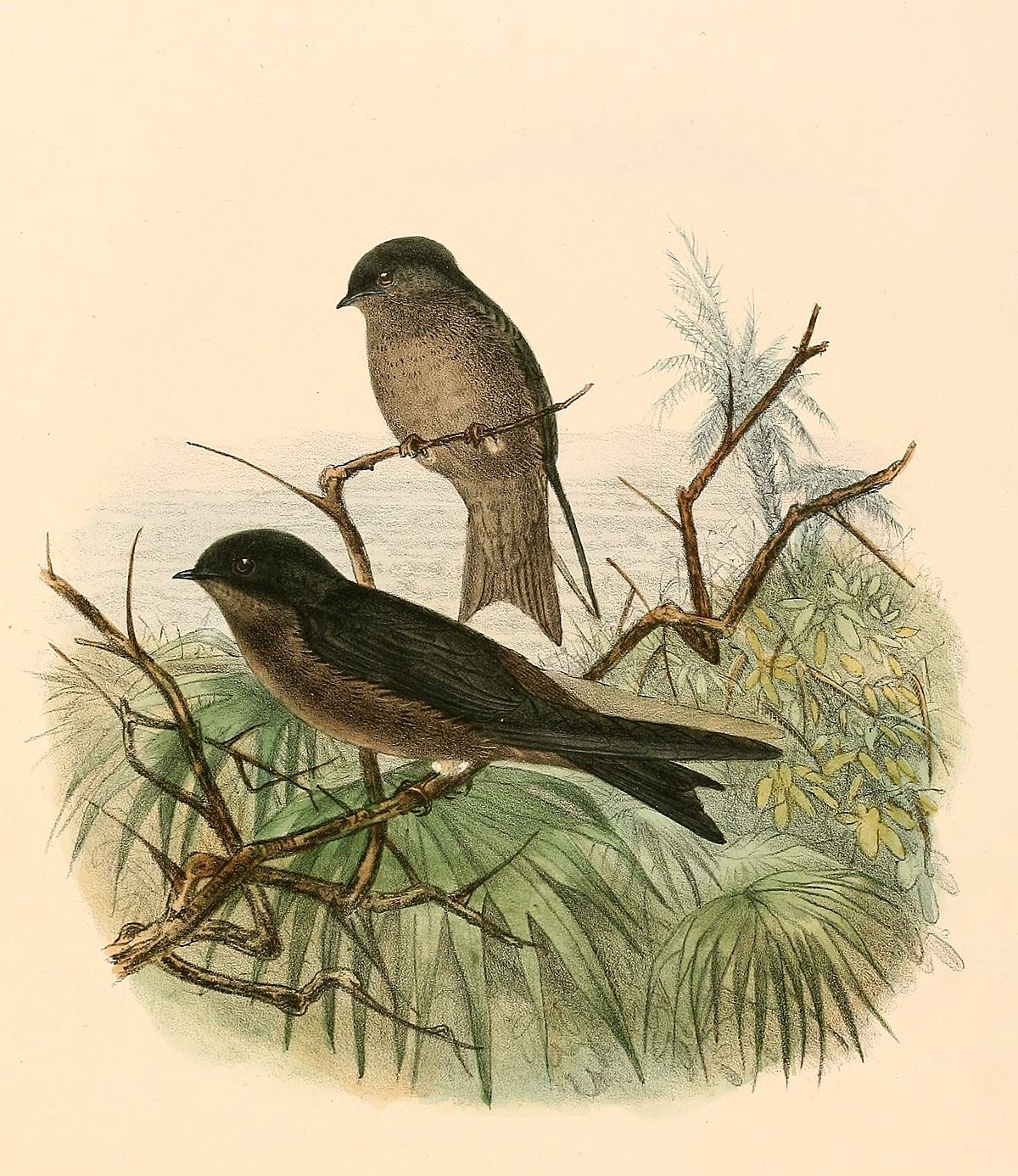
Wikipedia: White-thighed swallow Source: OTHER
1200px-Neochelidon_tibialis_1894.jpg
![]() The white-thighed swallow (Neochelidon tibialis) is a species of bird in the family Hirundinidae. Its genus, Neochelidon, is monotypic.
[more]
The white-thighed swallow (Neochelidon tibialis) is a species of bird in the family Hirundinidae. Its genus, Neochelidon, is monotypic.
[more]
Profile Wikipedia eBird Xeno-Canto

Wikipedia: White-winged swallow Source: OTHER
White-winged_Swallow_1052.jpg
![]() The white-winged swallow (Tachycineta albiventer) is a resident breeding swallow in tropical South America from Colombia, Venezuela, Trinidad, and Argentina. It is not found west of the Andes. This swallow is largely non-migratory.
[more]
The white-winged swallow (Tachycineta albiventer) is a resident breeding swallow in tropical South America from Colombia, Venezuela, Trinidad, and Argentina. It is not found west of the Andes. This swallow is largely non-migratory.
[more]
Profile Wikipedia eBird Xeno-Canto

Wikipedia: Tumbes swallow Source: OTHER
Tachycineta_stolzmanni_distribution_map.png
![]() The Tumbes swallow (Tachycineta stolzmanni) is a species of bird in the family Hirundinidae.
It is found in northwestern Peru and far southwestern Ecuador.
Its natural habitats are dry savanna, coastal saline lagoons, and arable land.
[more]
The Tumbes swallow (Tachycineta stolzmanni) is a species of bird in the family Hirundinidae.
It is found in northwestern Peru and far southwestern Ecuador.
Its natural habitats are dry savanna, coastal saline lagoons, and arable land.
[more]
Profile Wikipedia eBird Audubon AllAboutBirds Xeno-Canto
Could be a wild guess - MerlinBirdID says purple martin - it says identification features are (in part) best left unidentified. 2023-04-01 14.20.30 Yucatan
First observed in Yucatan on 2023-04-01.
![]() The purple martin (Progne subis) is the largest swallow in North America. Despite their name, purple martins are not truly purple. Their dark blackish-blue feathers have an iridescent sheen caused by the refraction of incident light[2] giving them a bright blue to navy blue or deep purple appearance. In some light they may even appear green in color.
[more]
The purple martin (Progne subis) is the largest swallow in North America. Despite their name, purple martins are not truly purple. Their dark blackish-blue feathers have an iridescent sheen caused by the refraction of incident light[2] giving them a bright blue to navy blue or deep purple appearance. In some light they may even appear green in color.
[more]
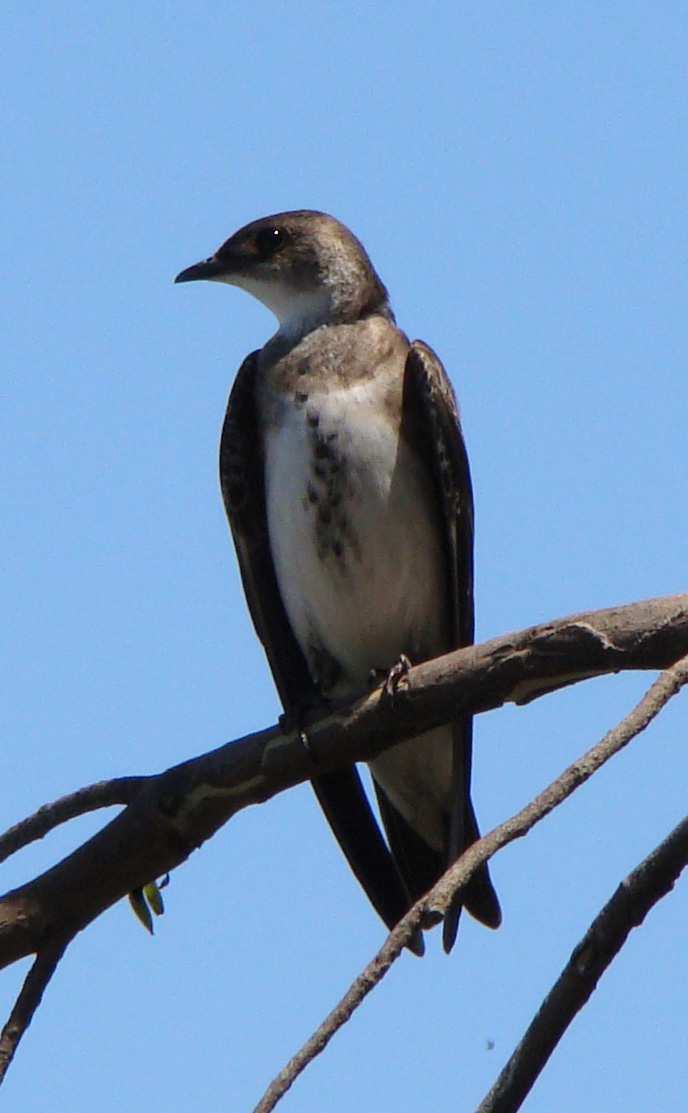
Wikipedia: Brown-chested martin Source: OTHER
Progne_tapera_-Rio_Grande_do_Sul-8a.jpg
![]() The brown-chested martin (Progne tapera) is a species of passerine bird in the swallow family.
[more]
The brown-chested martin (Progne tapera) is a species of passerine bird in the swallow family.
[more]
Profile Wikipedia eBird Xeno-Canto
MerlinBirdID says gray-breasted martin, Ecotucan. 2023-04-01 08.59.26 Yucatan
First observed in Yucatan on 2023-03-31.
![]() The grey-breasted martin (Progne chalybea) is a large swallow from Central and South America.
[more]
The grey-breasted martin (Progne chalybea) is a large swallow from Central and South America.
[more]
Profile Wikipedia eBird Xeno-Canto
Arenal hike southern rough-winged swallow tentative ID by MerlinBirdID. 2018-02-28 10.47.32 Costa Rica
First observed in Costa Rica on 2018-02-28.
![]() The southern rough-winged swallow (Stelgidopteryx ruficollis) is a small swallow. It was first formally described as Hirundo ruficollis by French ornithologist Louis Vieillot in 1817 in his Nouveau Dictionnaire d'Histoire Naturelle.[2]
[more]
The southern rough-winged swallow (Stelgidopteryx ruficollis) is a small swallow. It was first formally described as Hirundo ruficollis by French ornithologist Louis Vieillot in 1817 in his Nouveau Dictionnaire d'Histoire Naturelle.[2]
[more]
Bank swallow. 2024-01-26 15.58.58 Thailand
First observed in Thailand on 2024-01-26.
This bird appears across the great seas in the following continents:
Europe, North America, South America, Africa, Asia.
![]() The sand martin (Riparia riparia) or European sand martin, bank swallow, and collared sand martin in India, is a migratory passerine bird in the swallow family. It has a wide range in summer, embracing practically the whole of Europe and the Mediterranean countries and across the Palearctic to the Pacific Ocean. It is a Holarctic species also found in North America. It winters in eastern and southern Africa, South America, and the Indian Subcontinent.
[more]
The sand martin (Riparia riparia) or European sand martin, bank swallow, and collared sand martin in India, is a migratory passerine bird in the swallow family. It has a wide range in summer, embracing practically the whole of Europe and the Mediterranean countries and across the Palearctic to the Pacific Ocean. It is a Holarctic species also found in North America. It winters in eastern and southern Africa, South America, and the Indian Subcontinent.
[more]
Song: ![]() Song a primitive improvisation on the contact call. [Link]
Song a primitive improvisation on the contact call. [Link]
Calls: ![]() Contact call a mono- or disyllabic "trrrrt". Similar to House Martin but more raucous and less crisp, with less rolling r's, and with stable pitch throughout. Alarm call similar to House Martin; a sharp plaintive "tseep", but somewhat purer and more drawn. [Link]
Contact call a mono- or disyllabic "trrrrt". Similar to House Martin but more raucous and less crisp, with less rolling r's, and with stable pitch throughout. Alarm call similar to House Martin; a sharp plaintive "tseep", but somewhat purer and more drawn. [Link]
Physical details: length=12 cm,
wingspan=26-29 cm,
weight=11-16 g
Habitats:
Wetland
Song:
Fast raspy one-noter.
Song attributes:
Melody: non-musical, fast, Frequency: 1-7 KHz Special sounds: rasp
♫ Source: XENOCANTO
XC344092 - Sand Martin - Riparia riparia - raspy song but note, does not sing often.mp3
(song)


Wikipedia: Cliff swallow Source: OTHER
Petrochelidon_pyrrhonota_-flight_-Palo_Alto_Baylands-8.jpg
This bird appears across the great seas in the following continents:
Europe, North America, South America.
General: ![]() The cliff swallow or American cliff swallow (Petrochelidon pyrrhonota) is a member of the passerine bird family Hirundinidae, the swallows and martins.[2] The scientific name is derived from Ancient Greek; Petrochelidon originates from the petros meaning "rock" and khelidon "swallow", pyrrhonota comes from purrhos meaning "flame-coloured" and -notos "-backed".[3]
[more]
The cliff swallow or American cliff swallow (Petrochelidon pyrrhonota) is a member of the passerine bird family Hirundinidae, the swallows and martins.[2] The scientific name is derived from Ancient Greek; Petrochelidon originates from the petros meaning "rock" and khelidon "swallow", pyrrhonota comes from purrhos meaning "flame-coloured" and -notos "-backed".[3]
[more]

Wikipedia: Chestnut-collared swallow Source: OTHER
PetrochelidonRuficollarisKeulemans.jpg
![]() The chestnut-collared swallow (Petrochelidon rufocollaris) is a species of bird in the family Hirundinidae. It is found in Ecuador and Peru. Its natural habitats are pastureland and heavily degraded former forest.
[more]
The chestnut-collared swallow (Petrochelidon rufocollaris) is a species of bird in the family Hirundinidae. It is found in Ecuador and Peru. Its natural habitats are pastureland and heavily degraded former forest.
[more]
Profile Wikipedia eBird Xeno-Canto

Wikipedia: Blue-and-white swallow Source: OTHER
Pygochelidon_cyanoleuca_-Capao_do_Leao%2C_Rio_Grande_do_Sul%2C_Brazil-8.jpg
![]() The blue-and-white swallow (Notiochelidon cyanoleuca) is a passerine bird that breeds from Nicaragua south throughout South America, except in the deserts and the Amazon Basin. The southern race is migratory, wintering as far north as Trinidad, where it is a regular visitor. The nominate northern race may have bred on that island.[2]
[more]
The blue-and-white swallow (Notiochelidon cyanoleuca) is a passerine bird that breeds from Nicaragua south throughout South America, except in the deserts and the Amazon Basin. The southern race is migratory, wintering as far north as Trinidad, where it is a regular visitor. The nominate northern race may have bred on that island.[2]
[more]
Profile Wikipedia eBird Vogelwarte BirdLife ZH ornitho.ch bird-song.ch Audubon AllAboutBirds Xeno-Canto BirdID NABU
Pair of house sparrows in a tree near Zürichstrasse, Fehraltorf 2020-04-11 07.54.30 Luppmen
First observed in 🇨🇭 on 2019-05-14.
This bird appears across the great seas in the following continents:
Europe, North America (introduced), South America, Africa, Asia.
One of the most common birds anywhere in Europe and North America.
In Fehraltorf there are 5 house sparrows for every one tree sparrow.
Eugene Schieffelin brought house sparrows and starlings to North Ameria.
As a Shakespeare fan, it is often claimed that he wanted to introduce all species to North America that are mentioned in Shakespeare,
but apparently this is not supported by any records
Found practically everywhere. Often on the ground or on your table in a cafe (they're very bold)
or in groups in bushes and hedges
Song: ![]() Song a primitive, monosyllabic, or slightly disyllabic "chilp", hard to distinguish from Tree Sparrow. [Link]
Song a primitive, monosyllabic, or slightly disyllabic "chilp", hard to distinguish from Tree Sparrow. [Link]
Calls: ![]() Most calls very similar to Tree Sparrow, but lacks said species' distinct high pitched call (chew-itt), and alarm call is less dry and raucous. [Link]
Most calls very similar to Tree Sparrow, but lacks said species' distinct high pitched call (chew-itt), and alarm call is less dry and raucous. [Link]
Physical details: length=14-15 cm,
wingspan=21-25 cm,
weight=24-38 g
not sexually dimporphic.
No breeding plumage
Identifying characteristics:
Youth:
beak = yellow (Makes it look like a finch)
Habitats:
Settlement
Song:
An monotone chirping. Mainly 2-5 KHz with higher overtones.
Song attributes:
Melody: simple rhythmic, slow, Frequency: 2-5 KHz Singing season: 01-01 - 08-31 Dawn chorus start, 30 minutes before dawn.
Call:
Automatically generated from Xeno-Canto recording
♫ Source: BirdNet
20200507_071255 birdnet 457 - good one note recording - House sparrow.mp3
2020-05-07 07.12.55 Luppmen (song?)

Wikipedia: Lesser goldfinch Source: OTHER
1200px-%E2%99%82_lesser_goldfinch.jpg
General: ![]() The lesser goldfinch (Spinus psaltria) is a very small songbird of the Americas. Together with its relatives the American goldfinch and Lawrence's goldfinch, it forms the American goldfinches clade in the genus Spinus sensu stricto.
[more]
The lesser goldfinch (Spinus psaltria) is a very small songbird of the Americas. Together with its relatives the American goldfinch and Lawrence's goldfinch, it forms the American goldfinches clade in the genus Spinus sensu stricto.
[more]

Wikipedia: Yellow-bellied siskin Source: OTHER
1200px-Carduelis_xanthogastra_-Manizales%2C_Caldas%2C_Colombia-8.jpg
![]() The yellow-bellied siskin (Spinus xanthogastrus) is a small passerine bird in the finch family Fringillidae. It breeds from Costa Rica south to southern Ecuador, central Bolivia and the highlands of northwestern Venezuela.
[more]
The yellow-bellied siskin (Spinus xanthogastrus) is a small passerine bird in the finch family Fringillidae. It breeds from Costa Rica south to southern Ecuador, central Bolivia and the highlands of northwestern Venezuela.
[more]

Wikipedia: Saffron siskin Source: OTHER
ChrysomitrisSiemiradzkiiKeulemans.jpg
![]() The saffron siskin (Spinus siemiradzkii) is a species of finch in the family Fringillidae. It is found in Ecuador and Peru.
Its natural habitats are subtropical or tropical dry forests, subtropical or tropical dry shrubland, and urban areas. It is threatened by habitat destruction and the IUCN has assessed it as being a "vulnerable species".
[more]
The saffron siskin (Spinus siemiradzkii) is a species of finch in the family Fringillidae. It is found in Ecuador and Peru.
Its natural habitats are subtropical or tropical dry forests, subtropical or tropical dry shrubland, and urban areas. It is threatened by habitat destruction and the IUCN has assessed it as being a "vulnerable species".
[more]

Wikipedia: Hooded siskin Source: OTHER
PINTASSILGO_%28_Carduelis_magellanica_%29.jpg
![]() The hooded siskin (Spinus magellanicus) is a small passerine bird in the finch family (Fringillidae), native to South America. It belongs to the putative clade of neotropical siskins in the genus Spinus sensu lato.
[more]
The hooded siskin (Spinus magellanicus) is a small passerine bird in the finch family (Fringillidae), native to South America. It belongs to the putative clade of neotropical siskins in the genus Spinus sensu lato.
[more]
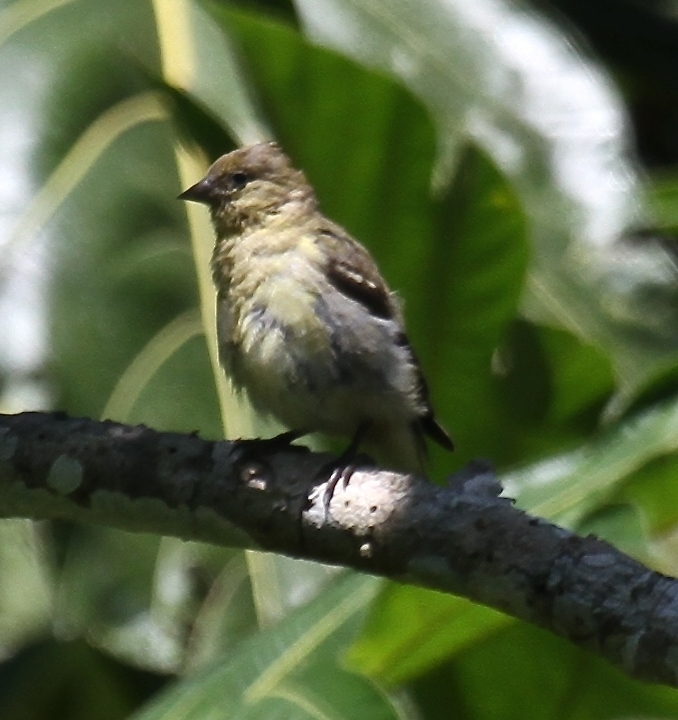
Wikipedia: Olivaceous siskin Source: OTHER
OlivaceousSiskin.jpg
![]() The olivaceous siskin (Spinus olivaceus) is a species of finch in the family Fringillidae.
It is found in Bolivia, Ecuador, and Peru, where its natural habitats are subtropical or tropical moist montane forests and heavily degraded former forest.
[more]
The olivaceous siskin (Spinus olivaceus) is a species of finch in the family Fringillidae.
It is found in Bolivia, Ecuador, and Peru, where its natural habitats are subtropical or tropical moist montane forests and heavily degraded former forest.
[more]

Wikipedia: Andean siskin Source: OTHER
1200px-Carduelis_spinescens.jpg
![]() The Andean siskin (Spinus spinescens) is a species of finch in the family Fringillidae. It is found in Colombia, Ecuador, and Venezuela. Its natural habitats are subtropical or tropical moist montane forests, subtropical or tropical high-altitude shrubland, subtropical or tropical high-altitude grassland, and heavily degraded former forest.[1]
[more]
The Andean siskin (Spinus spinescens) is a species of finch in the family Fringillidae. It is found in Colombia, Ecuador, and Venezuela. Its natural habitats are subtropical or tropical moist montane forests, subtropical or tropical high-altitude shrubland, subtropical or tropical high-altitude grassland, and heavily degraded former forest.[1]
[more]
Profile Wikipedia eBird Xeno-Canto
Red-legged honeycreeper. 2020-02-21 07.42.10 Panama
First observed in Panama on 2020-02-21.
We saw this on the grounds of Gamboa Rainforest Resort, a hotel at the old U.S. administrative center for the Panama Canal. You can spend hours watching birds and wildlife just around the hotel.
General: ![]() The red-legged honeycreeper (Cyanerpes cyaneus) is a small songbird species in the tanager family (Thraupidae). It is found in the tropical New World from southern Mexico south to Peru, Bolivia and central Brazil, Trinidad and Tobago, and on Cuba, where possibly introduced. It is also rarely found in southern Texas.[2]
[more]
The red-legged honeycreeper (Cyanerpes cyaneus) is a small songbird species in the tanager family (Thraupidae). It is found in the tropical New World from southern Mexico south to Peru, Bolivia and central Brazil, Trinidad and Tobago, and on Cuba, where possibly introduced. It is also rarely found in southern Texas.[2]
[more]
Profile Wikipedia eBird Xeno-Canto
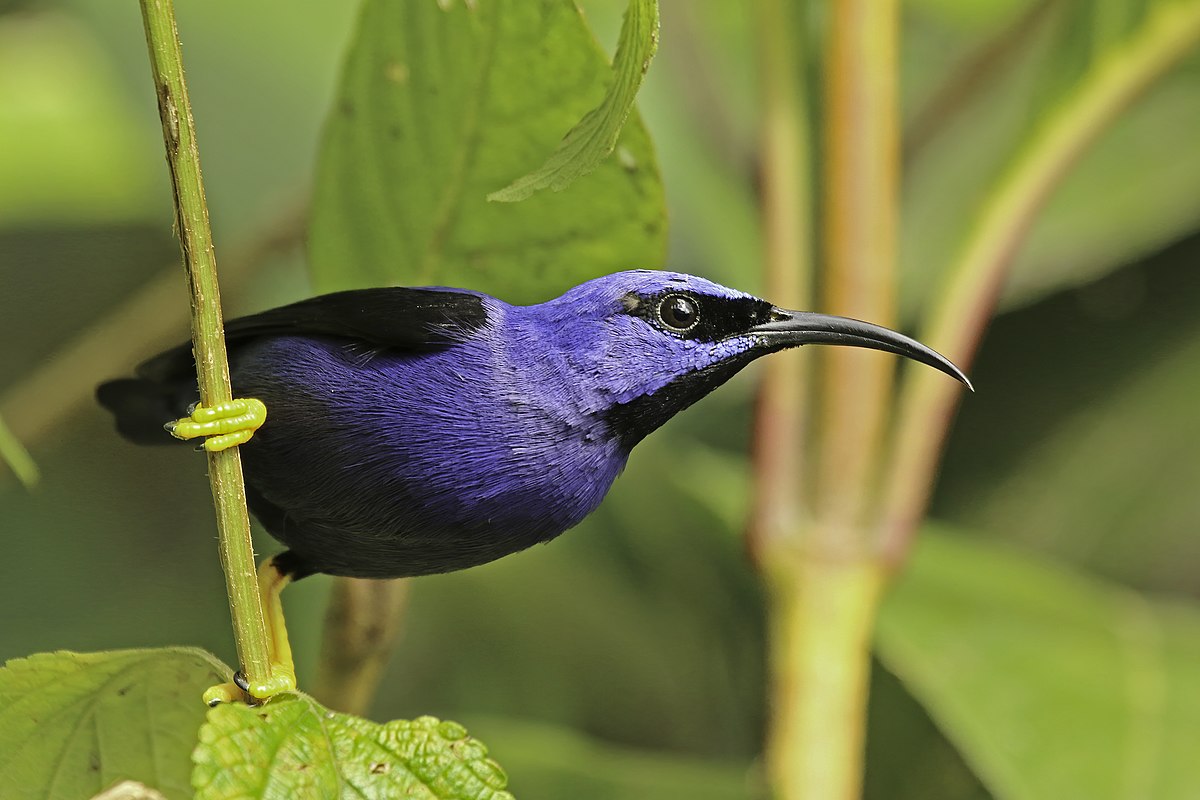
Wikipedia: Purple honeycreeper Source: OTHER
1200px-Purple_honey_creeper_%28Cyanerpes_caeruleus_longirostris%29_male.jpg
![]() The purple honeycreeper (Cyanerpes caeruleus) is a small Neotropical bird in the tanager family Thraupidae. It is found in the tropical New World from Colombia and Venezuela south to Brazil, and on Trinidad. A few, possibly introduced birds have been recorded on Tobago.
[more]
The purple honeycreeper (Cyanerpes caeruleus) is a small Neotropical bird in the tanager family Thraupidae. It is found in the tropical New World from Colombia and Venezuela south to Brazil, and on Trinidad. A few, possibly introduced birds have been recorded on Tobago.
[more]
Profile Wikipedia eBird Xeno-Canto
![]()
Wikipedia: Short-billed honeycreeper Source: OTHER
lossy-page1-1200px-Coereba_nitida_-_1700-1880_-_Print_-_Iconographia_Zoologica_-_Special_Collections_University_of_Amsterdam_-_UBA01_IZ19000365.tif.jpg
![]() The short-billed honeycreeper (Cyanerpes nitidus) is a species of bird in the family Thraupidae.
It is found in Bolivia, Brazil, Colombia, Ecuador, Peru, Suriname, and Venezuela.
Its natural habitat is subtropical or tropical moist lowland forests.
[more]
The short-billed honeycreeper (Cyanerpes nitidus) is a species of bird in the family Thraupidae.
It is found in Bolivia, Brazil, Colombia, Ecuador, Peru, Suriname, and Venezuela.
Its natural habitat is subtropical or tropical moist lowland forests.
[more]
Profile Wikipedia eBird Xeno-Canto
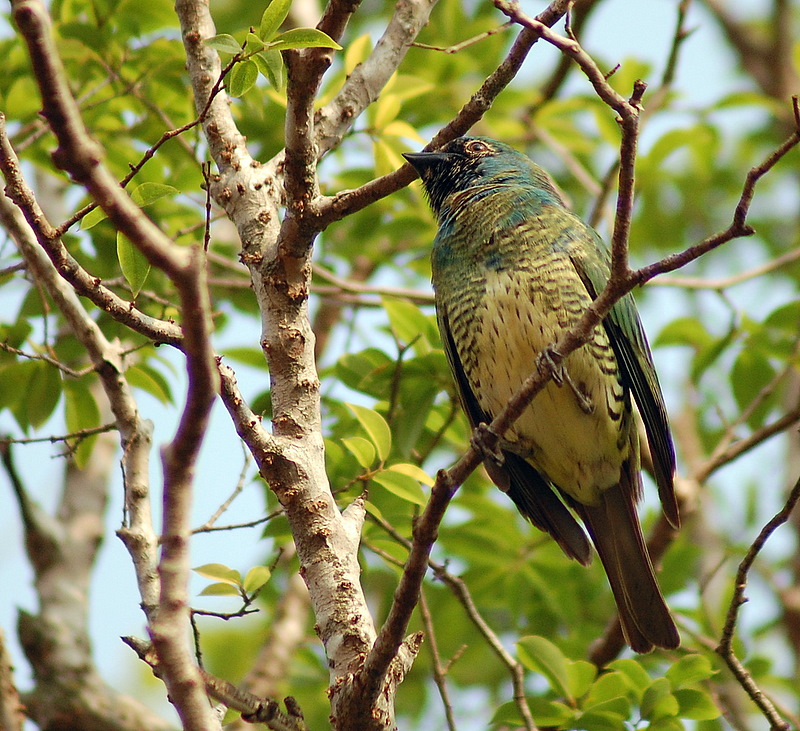
Wikipedia: Swallow tanager Source: OTHER
Swallow_Tanager_%28Tersina_viridis%29..jpg
![]() The swallow tanager (Tersina viridis) is a species of Neotropic bird in the tanager family Thraupidae. It is the only member of the genus Tersina. It is found widely throughout South America, from eastern Panama to far northern Argentina. The species is sexually dimorphic: the female is a yellow-green and the male a turquoise blue with a small deep black face and upper throat patch.
[more]
The swallow tanager (Tersina viridis) is a species of Neotropic bird in the tanager family Thraupidae. It is the only member of the genus Tersina. It is found widely throughout South America, from eastern Panama to far northern Argentina. The species is sexually dimorphic: the female is a yellow-green and the male a turquoise blue with a small deep black face and upper throat patch.
[more]
Profile Wikipedia eBird A-Z Animals Audubon AllAboutBirds Xeno-Canto
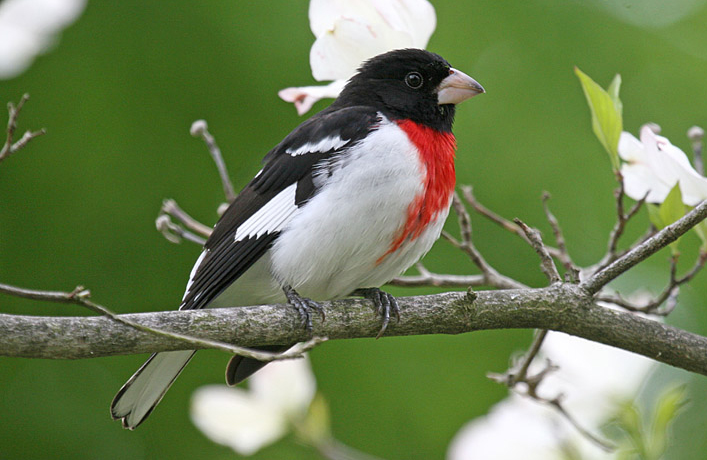
Wikipedia: Rose-breasted grosbeak Source: OTHER
RosebreastedGrosbeak08.jpg
![]() The rose-breasted grosbeak (Pheucticus ludovicianus) is a large, seed-eating grosbeak in the cardinal family (Cardinalidae). It is primarily a foliage gleaner.[2] Males have black heads, wings, backs, and tails, and a bright rose colored patch on their white breast. Males and females exhibit marked sexual dimorphism.
[more]
The rose-breasted grosbeak (Pheucticus ludovicianus) is a large, seed-eating grosbeak in the cardinal family (Cardinalidae). It is primarily a foliage gleaner.[2] Males have black heads, wings, backs, and tails, and a bright rose colored patch on their white breast. Males and females exhibit marked sexual dimorphism.
[more]
Profile Wikipedia eBird Xeno-Canto

Wikipedia: Black-backed grosbeak Source: OTHER
Black-backed_Grosbeak_%28Pheucticus_aureoventris%29_%288077568632%29.jpg
![]() The black-backed grosbeak (Pheucticus aureoventris) is a bird in the family Cardinalidae, the cardinals or cardinal grosbeaks. It is found in Argentina, Brazil, Bolivia, Colombia, Ecuador, Paraguay, Peru, and Venezuela. They are often kept as cagebirds.[2][3]
[more]
The black-backed grosbeak (Pheucticus aureoventris) is a bird in the family Cardinalidae, the cardinals or cardinal grosbeaks. It is found in Argentina, Brazil, Bolivia, Colombia, Ecuador, Paraguay, Peru, and Venezuela. They are often kept as cagebirds.[2][3]
[more]
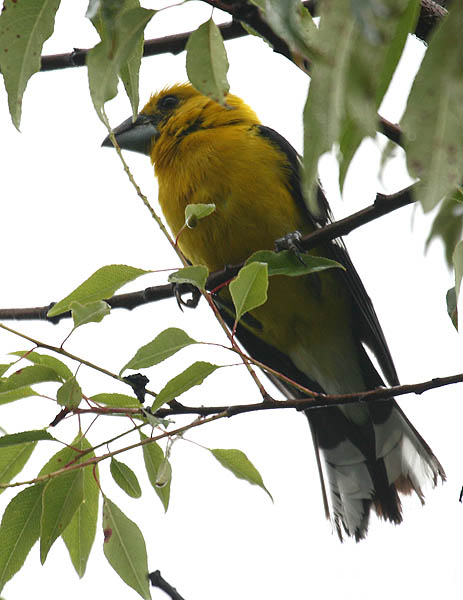
Wikipedia: Golden-bellied grosbeak Source: OTHER
Pheucticus_chrysogaster_%28male%29_-Ecuador-8.jpg
Ecuador
![]() The golden grosbeak (Pheucticus chrysogaster), also known as golden-bellied grosbeak or southern yellow grosbeak, is a species of grosbeak in the family Cardinalidae. It is similar to, and has sometimes been considered conspecific with, the yellow grosbeak.
[more]
The golden grosbeak (Pheucticus chrysogaster), also known as golden-bellied grosbeak or southern yellow grosbeak, is a species of grosbeak in the family Cardinalidae. It is similar to, and has sometimes been considered conspecific with, the yellow grosbeak.
[more]

Wikipedia: Blue-black grosbeak Source: OTHER
1200px-Cyanocompsa_cyanoides.jpg
![]() The blue-black grosbeak (Cyanoloxia cyanoides) is a species of songbird in the family Cardinalidae.
[more]
The blue-black grosbeak (Cyanoloxia cyanoides) is a species of songbird in the family Cardinalidae.
[more]
Profile Wikipedia eBird Xeno-Canto

Wikipedia: Yellow-shouldered grosbeak Source: OTHER
1200px-Yellow-shouldered_Grosbeak.jpg
![]() The yellow-shouldered grosbeak (Parkerthraustes humeralis) is a species of bird in the tanager family Thraupidae. It is the only member of its genus Parkerthraustes.
It is found in Bolivia, Brazil, Colombia, Ecuador, and Peru.
Its natural habitat is subtropical or tropical moist lowland forests.
[more]
The yellow-shouldered grosbeak (Parkerthraustes humeralis) is a species of bird in the tanager family Thraupidae. It is the only member of its genus Parkerthraustes.
It is found in Bolivia, Brazil, Colombia, Ecuador, and Peru.
Its natural habitat is subtropical or tropical moist lowland forests.
[more]
Profile Wikipedia eBird Xeno-Canto

Wikipedia: Blue-naped chlorophonia Source: OTHER
Chlorophonia_cyanea_Blue-naped_Chlorophonia_%28cropped%29.jpg
![]() The blue-naped chlorophonia (Chlorophonia cyanea) is a colourful South American species of bird in the family Fringillidae; it was formerly placed in the Thraupidae. It is generally fairly common.
[more]
The blue-naped chlorophonia (Chlorophonia cyanea) is a colourful South American species of bird in the family Fringillidae; it was formerly placed in the Thraupidae. It is generally fairly common.
[more]
Profile Wikipedia eBird Xeno-Canto

Wikipedia: Yellow-collared chlorophonia Source: OTHER
ChlorophoniaSmit.jpg
![]() The yellow-collared chlorophonia (Chlorophonia flavirostris) is a bird species in the family Fringillidae (it was formerly placed in Thraupidae).
It is found in Colombia, Ecuador, and Panama.
Its natural habitats are subtropical or tropical moist lowland forest and subtropical or tropical moist montane forest.
[more]
The yellow-collared chlorophonia (Chlorophonia flavirostris) is a bird species in the family Fringillidae (it was formerly placed in Thraupidae).
It is found in Colombia, Ecuador, and Panama.
Its natural habitats are subtropical or tropical moist lowland forest and subtropical or tropical moist montane forest.
[more]
Profile Wikipedia eBird Xeno-Canto

Wikipedia: Chestnut-breasted chlorophonia Source: OTHER
Chestnut-breasted_Chlorophonia_%28Chlorophonia_pyrrhophrys%29_Clorofonia_ferruginosa_%28male%29.jpg
![]() The chestnut-breasted chlorophonia (Chlorophonia pyrrhophrys) is a bird species in the family Fringillidae (formerly in Thraupidae).
It is found in Colombia, Ecuador, Peru, and Venezuela.
Its natural habitat is subtropical or tropical moist montane forests.
[more]
The chestnut-breasted chlorophonia (Chlorophonia pyrrhophrys) is a bird species in the family Fringillidae (formerly in Thraupidae).
It is found in Colombia, Ecuador, Peru, and Venezuela.
Its natural habitat is subtropical or tropical moist montane forests.
[more]
Profile Wikipedia eBird Xeno-Canto

Wikipedia: Golden-rumped euphonia Source: OTHER
1200px-Golden-rumped_Euphonia_%282%29.jpg
![]() The golden-rumped euphonia (Chlorophonia cyanocephala) is a species of bird in the family Fringillidae, formerly placed in the Thraupidae. It is found in Argentina, Bolivia, Brazil, Colombia, Ecuador, French Guiana, Guyana, Paraguay, Peru, Suriname, Trinidad and Tobago, and Venezuela.
[more]
The golden-rumped euphonia (Chlorophonia cyanocephala) is a species of bird in the family Fringillidae, formerly placed in the Thraupidae. It is found in Argentina, Bolivia, Brazil, Colombia, Ecuador, French Guiana, Guyana, Paraguay, Peru, Suriname, Trinidad and Tobago, and Venezuela.
[more]
Profile Wikipedia eBird Xeno-Canto

Wikipedia: White-vented euphonia Source: OTHER
Euphonia_minuta_-_White-vented_Euphonia_%28male%29%3B_Manacapuru%2C_Amazonas%2C_Brazil.jpg
![]() The white-vented euphonia (Euphonia minuta) is a species of bird in the family Fringillidae.
[more]
The white-vented euphonia (Euphonia minuta) is a species of bird in the family Fringillidae.
[more]
Profile Wikipedia eBird Xeno-Canto

Wikipedia: Thick-billed euphonia Source: OTHER
1200px-Thick-billed_euphonia_%28Euphonia_laniirostris_crassirostris%29_male.jpg
![]() The thick-billed euphonia (Euphonia laniirostris) is a species of bird in the family Fringillidae, formerly placed in the Thraupidae.
[more]
The thick-billed euphonia (Euphonia laniirostris) is a species of bird in the family Fringillidae, formerly placed in the Thraupidae.
[more]
Profile Wikipedia eBird Xeno-Canto

Wikipedia: Orange-bellied euphonia Source: OTHER
Orange-bellied_Euphonia_-_Ecuador_S4E5535_%2822621854444%29.jpg
![]() The orange-bellied euphonia (Euphonia xanthogaster) is a species of bird in the finch family, Fringillidae. They were formerly considered tanagers (Thraupidae). It is found in Bolivia, Brazil, Colombia, Ecuador, Guyana, Panama, Peru, and Venezuela. Its natural habitats are subtropical or tropical moist lowland forest and subtropical or tropical moist montane forest.
[more]
The orange-bellied euphonia (Euphonia xanthogaster) is a species of bird in the finch family, Fringillidae. They were formerly considered tanagers (Thraupidae). It is found in Bolivia, Brazil, Colombia, Ecuador, Guyana, Panama, Peru, and Venezuela. Its natural habitats are subtropical or tropical moist lowland forest and subtropical or tropical moist montane forest.
[more]
Profile Wikipedia eBird Xeno-Canto

Wikipedia: Fulvous-vented euphonia Source: OTHER
1200px-Euphonia_fulvicrissa_1902.jpg
![]() The fulvous-vented euphonia (Euphonia fulvicrissa) is a species of bird in the family Fringillidae, formerly placed in the Thraupidae
[more]
The fulvous-vented euphonia (Euphonia fulvicrissa) is a species of bird in the family Fringillidae, formerly placed in the Thraupidae
[more]
Profile Wikipedia eBird Xeno-Canto

Wikipedia: Bronze-green euphonia Source: OTHER
Bronze-green_Euphonia_-_South_Ecuador_S4E0810_%2823250387345%29.jpg
![]() The bronze-green euphonia (Euphonia mesochrysa) is a bird species in the family Fringillidae (formerly in Thraupidae).
It is found in Bolivia, Colombia, Ecuador, and Peru.
Its natural habitat is subtropical or tropical moist montane forests.
[more]
The bronze-green euphonia (Euphonia mesochrysa) is a bird species in the family Fringillidae (formerly in Thraupidae).
It is found in Bolivia, Colombia, Ecuador, and Peru.
Its natural habitat is subtropical or tropical moist montane forests.
[more]
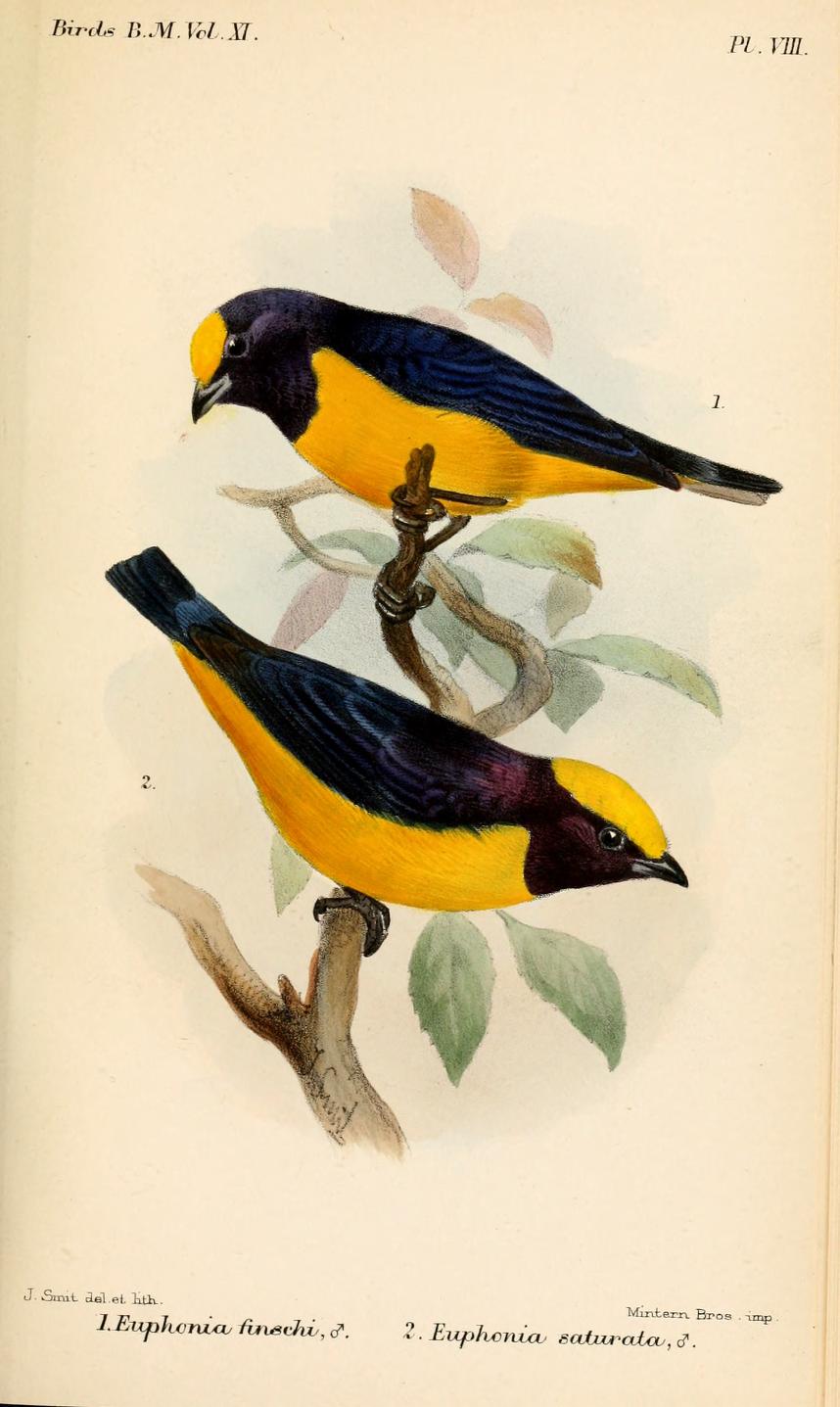
Wikipedia: Orange-crowned euphonia Source: OTHER
EuphoniaSmit.jpg
![]() The orange-crowned euphonia (Euphonia saturata) is a species of bird in the family Fringillidae.
[more]
The orange-crowned euphonia (Euphonia saturata) is a species of bird in the family Fringillidae.
[more]
Profile Wikipedia eBird Xeno-Canto
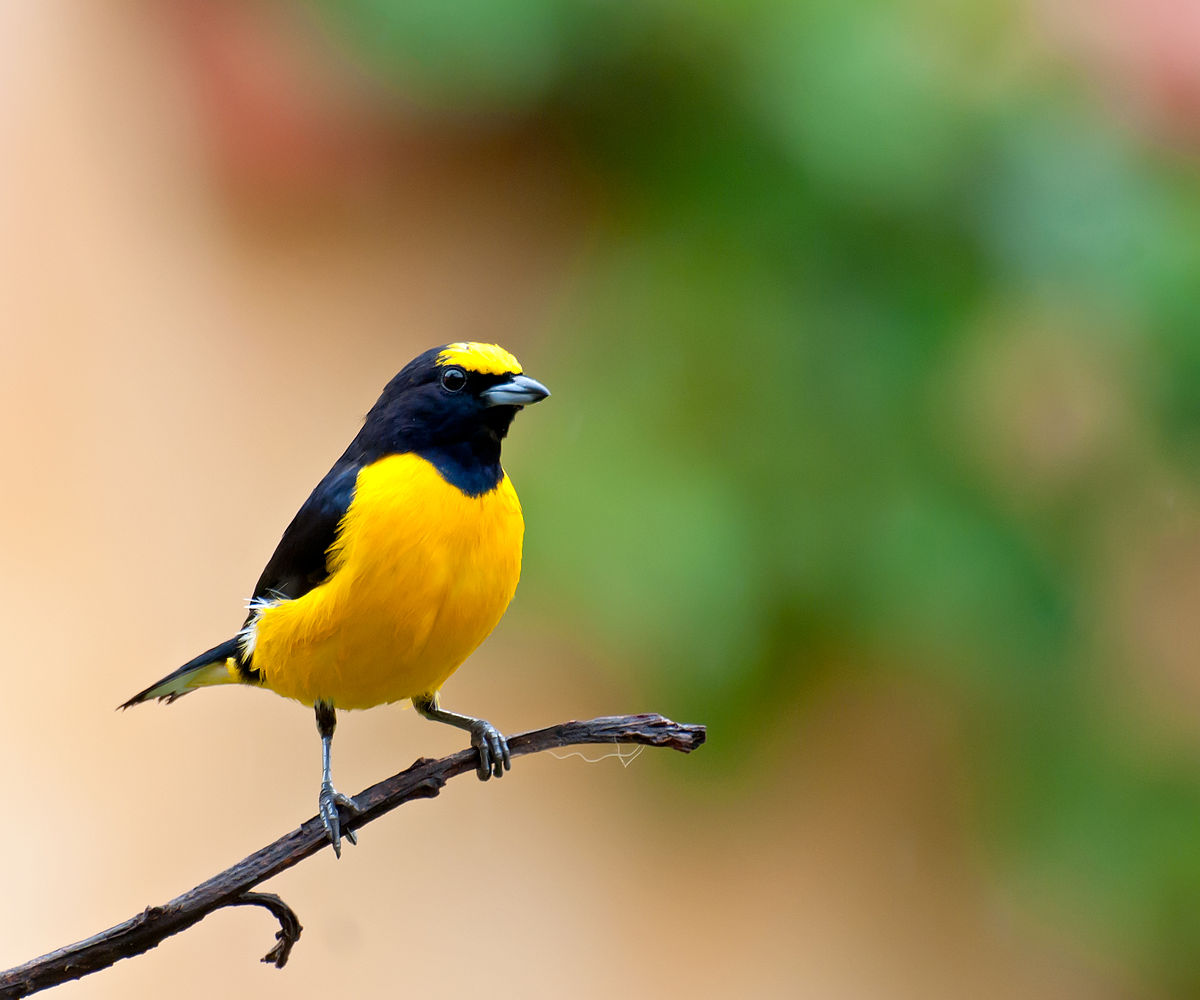
Wikipedia: Purple-throated euphonia Source: OTHER
1200px-Euphonia_chlorotica_-Piraju%2C_Sao_paulo%2C_Brasil_-male-8.jpg
![]() The purple-throated euphonia (Euphonia chlorotica) is a songbird species in the family Fringillidae. It was formerly placed in the Thraupidae.
[more]
The purple-throated euphonia (Euphonia chlorotica) is a songbird species in the family Fringillidae. It was formerly placed in the Thraupidae.
[more]
Profile Wikipedia eBird Xeno-Canto
Wikipedia: Golden-bellied euphonia Source: OTHER
Euphonia_chrysopasta_-_White-lored_Euphonia_%28female%29.JPG
![]() The white-lored euphonia or golden-bellied euphonia (Euphonia chrysopasta) is a songbird species of the family Fringillidae, having recently been moved there from the Thraupidae.
[more]
The white-lored euphonia or golden-bellied euphonia (Euphonia chrysopasta) is a songbird species of the family Fringillidae, having recently been moved there from the Thraupidae.
[more]
Profile Wikipedia eBird Xeno-Canto

Wikipedia: Rufous-bellied euphonia Source: OTHER
1200px-Euphonia_rufiventris_-_Rufous-bellied_euphonia_%28adult_male%29%2C_Manacapuru%2C_Amazonas%2C_Brazil.jpg
![]() The rufous-bellied euphonia (Euphonia rufiventris) is a species of bird in the family Fringillidae.
It is found in Bolivia, Brazil, Colombia, Ecuador, Peru, and Venezuela.
Its natural habitat is subtropical or tropical moist lowland forest.
[more]
The rufous-bellied euphonia (Euphonia rufiventris) is a species of bird in the family Fringillidae.
It is found in Bolivia, Brazil, Colombia, Ecuador, Peru, and Venezuela.
Its natural habitat is subtropical or tropical moist lowland forest.
[more]
Profile Wikipedia eBird Xeno-Canto

Wikipedia: Paramo pipit Source: OTHER
1200px-AnthusBotogensisWolf.jpg
![]() The paramo pipit (Anthus bogotensis) is a species of bird in the family Motacillidae. It is found in Argentina, Bolivia, Colombia, Ecuador, Peru, and Venezuela. Its natural habitats are subtropical or tropical high-altitude grassland and pastureland.
[more]
The paramo pipit (Anthus bogotensis) is a species of bird in the family Motacillidae. It is found in Argentina, Bolivia, Colombia, Ecuador, Peru, and Venezuela. Its natural habitats are subtropical or tropical high-altitude grassland and pastureland.
[more]
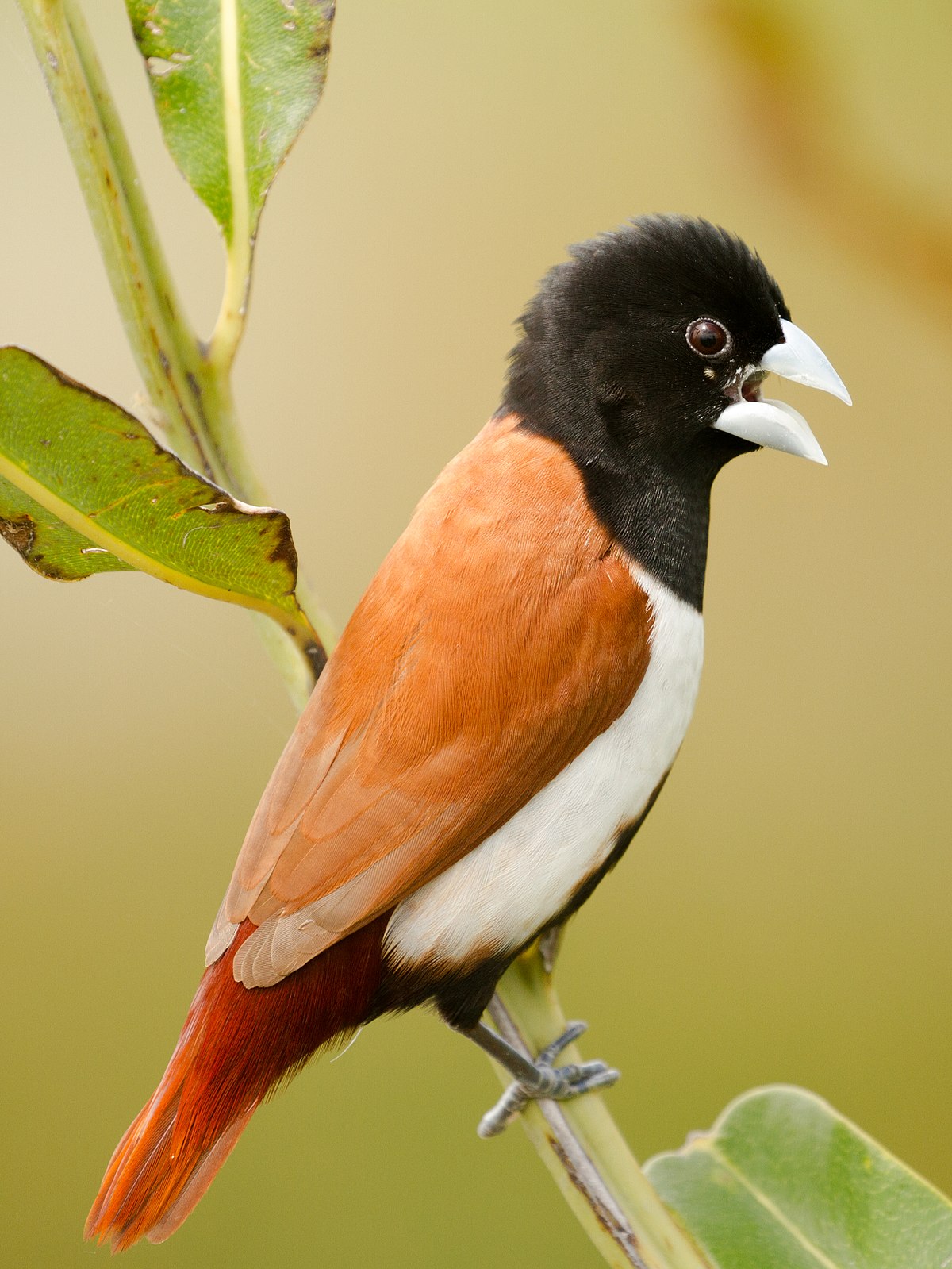
Wikipedia: Tricolored munia Source: OTHER
1200px-Tricoloured_munia_%28cropped%29.jpg
This bird appears across the great seas in the following continents:
Europe, North America, South America, Asia.
![]() The tricoloured munia (Lonchura malacca) is an estrildid finch, native to Bangladesh,[2] India, Sri Lanka, Pakistan, and southern China. The species has also introduced to the Caribbean, in Trinidad, Jamaica, Hispaniola, Puerto Rico, Cuba, and Venezuela. This species, like the chestnut munia has been known as the black-headed munia. Immature birds have pale brown upperparts, lack the dark head found in adults, and have uniform buff underparts that can be confused with immatures of other munias such as the scaly-breasted munia.
[more]
The tricoloured munia (Lonchura malacca) is an estrildid finch, native to Bangladesh,[2] India, Sri Lanka, Pakistan, and southern China. The species has also introduced to the Caribbean, in Trinidad, Jamaica, Hispaniola, Puerto Rico, Cuba, and Venezuela. This species, like the chestnut munia has been known as the black-headed munia. Immature birds have pale brown upperparts, lack the dark head found in adults, and have uniform buff underparts that can be confused with immatures of other munias such as the scaly-breasted munia.
[more]

Wikipedia: Red-breasted meadowlark Source: OTHER
Red-breasted_blackbird.jpg
![]() The red-breasted meadowlark (Leistes militaris) is a passerine bird in the New World family Icteridae. It was formerly named red-breasted blackbird but is not closely related to the red-winged blackbird group.[2]
[more]
The red-breasted meadowlark (Leistes militaris) is a passerine bird in the New World family Icteridae. It was formerly named red-breasted blackbird but is not closely related to the red-winged blackbird group.[2]
[more]
Profile Wikipedia eBird Xeno-Canto
Great-tailed grackle. 2018-02-19 16.00.04 Costa Rica
First observed in Costa Rica on 2018-02-12.
![]() The great-tailed grackle or Mexican grackle (Quiscalus mexicanus) is a medium-sized, highly social passerine bird native to North and South America. A member of the family Icteridae, it is one of 10 extant species of grackle and is closely related to the boat-tailed grackle and the extinct slender-billed grackle.[2] In the southern United States, it is sometimes simply referred to as "blackbird" or (erroneously) "crow"[3] due to its glossy black plumage, and similarly it is often called cuervo ("crow") in some parts of Mexico, although it is not a member of the crow genus Corvus, nor even of the family Corvidae.
[more]
The great-tailed grackle or Mexican grackle (Quiscalus mexicanus) is a medium-sized, highly social passerine bird native to North and South America. A member of the family Icteridae, it is one of 10 extant species of grackle and is closely related to the boat-tailed grackle and the extinct slender-billed grackle.[2] In the southern United States, it is sometimes simply referred to as "blackbird" or (erroneously) "crow"[3] due to its glossy black plumage, and similarly it is often called cuervo ("crow") in some parts of Mexico, although it is not a member of the crow genus Corvus, nor even of the family Corvidae.
[more]
Call:
Automatically generated from Xeno-Canto recording
♫ Source: BirdNet
20210318_165218- birdnet 16 - Great-tailed Grackle - 2020-02-25 18:35:12 - birdnet_mobile_5867288364_recording_22.wav.mp3
2021-03-18 16.52.18 Fehraltorf (song?)
Profile Wikipedia eBird Xeno-Canto
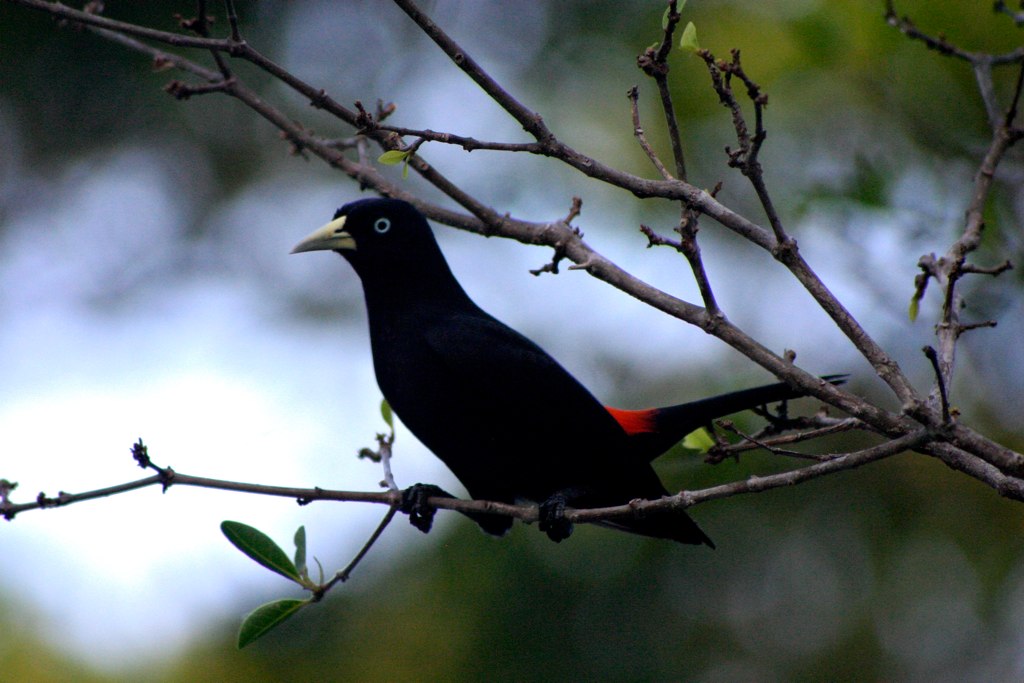
Wikipedia: Scarlet-rumped cacique Source: OTHER
Cacicus_uropygialis_-Panama-8.jpg
Panama
![]() The scarlet-rumped cacique (Cacicus uropygialis) is a passerine bird species in the New World family Icteridae. It breeds from eastern Honduras to Panama and in the Pacific lowlands of South America from western Colombia south to Ecuador, and in the lower reaches of the northern Andes. There are several subspecies, some of which have been proposed for elevation to full species status.
[more]
The scarlet-rumped cacique (Cacicus uropygialis) is a passerine bird species in the New World family Icteridae. It breeds from eastern Honduras to Panama and in the Pacific lowlands of South America from western Colombia south to Ecuador, and in the lower reaches of the northern Andes. There are several subspecies, some of which have been proposed for elevation to full species status.
[more]
Profile Wikipedia eBird Xeno-Canto

Wikipedia: Yellow-rumped cacique Source: OTHER
Yellow-rumped_Cacique_-_Pantanal_-_Brazil_H8O2199_%2823593614830%29.jpg
![]() The yellow-rumped cacique (Cacicus cela) is a passerine bird in the New World family Icteridae. It breeds in much of northern South America from Panama and Trinidad south to Peru, Bolivia and central Brazil. However, they have been sighted as far north as Nayarit state in Mexico.
[more]
The yellow-rumped cacique (Cacicus cela) is a passerine bird in the New World family Icteridae. It breeds in much of northern South America from Panama and Trinidad south to Peru, Bolivia and central Brazil. However, they have been sighted as far north as Nayarit state in Mexico.
[more]
Profile Wikipedia eBird Xeno-Canto

Wikipedia: Red-rumped cacique Source: OTHER
1200px-Red-rumped_Cacique_bird.png
![]() The red-rumped cacique (Cacicus haemorrhous) is a species of bird in the family Icteridae. It is a species of the Amazon Basin and the Guyanas in northern South America, and is only coastal there in the Guyanas and the Amazon River outlet to the Atlantic; a separate large disjunct range exists in all of south-eastern and coastal Brazil, including Paraguay, and parts of north-eastern Argentina. It is also found in Bolivia, Brazil, Colombia, Ecuador, French Guiana, Guyana, Peru, Suriname, and Venezuela.
[more]
The red-rumped cacique (Cacicus haemorrhous) is a species of bird in the family Icteridae. It is a species of the Amazon Basin and the Guyanas in northern South America, and is only coastal there in the Guyanas and the Amazon River outlet to the Atlantic; a separate large disjunct range exists in all of south-eastern and coastal Brazil, including Paraguay, and parts of north-eastern Argentina. It is also found in Bolivia, Brazil, Colombia, Ecuador, French Guiana, Guyana, Peru, Suriname, and Venezuela.
[more]
Profile Wikipedia eBird Xeno-Canto

Wikipedia: Mountain cacique Source: OTHER
1200px-Northern_Mountain_Cacique_%28Cacicus_chrysonotus%29.jpg
![]() The mountain cacique (Cacicus chrysonotus) is a species of bird in the family Icteridae. It is found in Bolivia, Colombia, Ecuador, Peru, and Venezuela.
[more]
The mountain cacique (Cacicus chrysonotus) is a species of bird in the family Icteridae. It is found in Bolivia, Colombia, Ecuador, Peru, and Venezuela.
[more]
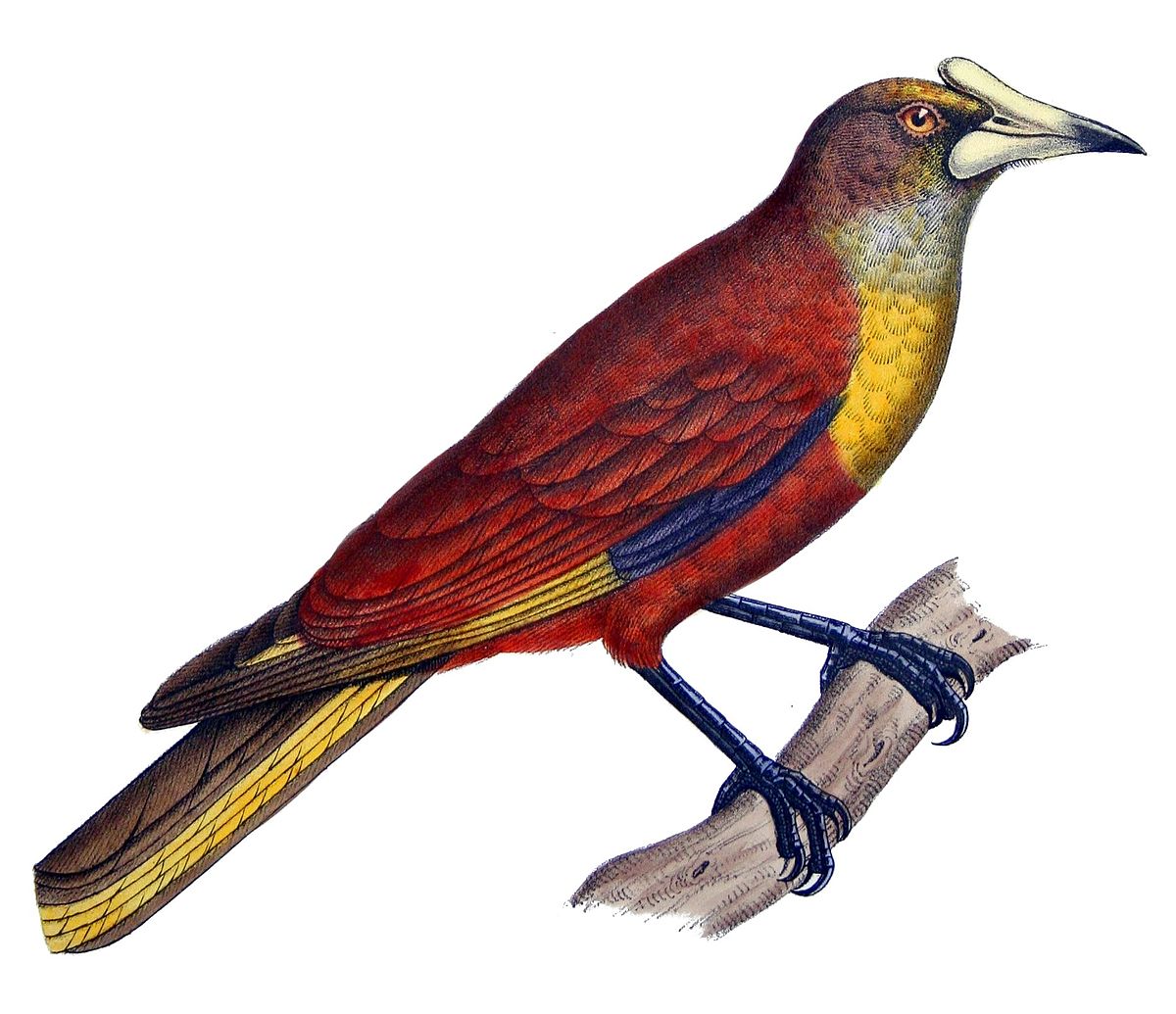
Wikipedia: Casqued cacique Source: OTHER
1200px-Clypicterus_oseryi_Castelnau.jpg
![]() The casqued oropendola (Cacicus oseryi) is a species of bird in the family Icteridae.
[more]
The casqued oropendola (Cacicus oseryi) is a species of bird in the family Icteridae.
[more]

Wikipedia: Solitary cacique Source: OTHER
Solitary_Cacique_-_Pantanal_-_Brazil_H8O0547_%2823889343835%29.jpg
![]() The solitary cacique or solitary black cacique (Cacicus solitarius) is a species of bird in the family Icteridae.
[more]
The solitary cacique or solitary black cacique (Cacicus solitarius) is a species of bird in the family Icteridae.
[more]
Profile Wikipedia eBird Xeno-Canto

Wikipedia: Band-tailed cacique Source: OTHER
1200px-Band-Tailed_Cacique_Range.png
![]() The band-tailed oropendola (Cacicus latirostris) is a species of bird in the family Icteridae.
[more]
The band-tailed oropendola (Cacicus latirostris) is a species of bird in the family Icteridae.
[more]
Profile Wikipedia eBird Xeno-Canto

Wikipedia: Ecuadorian cacique Source: OTHER
1200px-Cacicus_sclateri_1888.jpg
![]() The Ecuadorian cacique (Cacicus sclateri) is a species of bird in the family Icteridae. It is found in Colombia, Ecuador, and Peru, where its natural habitat is subtropical or tropical moist lowland forest. A fairly common bird with a wide range, the IUCN has rated it a "species of least concern".
[more]
The Ecuadorian cacique (Cacicus sclateri) is a species of bird in the family Icteridae. It is found in Colombia, Ecuador, and Peru, where its natural habitat is subtropical or tropical moist lowland forest. A fairly common bird with a wide range, the IUCN has rated it a "species of least concern".
[more]
MerlinBirdID says yellow-billed cacique and notes pale ivory-yellow bill and staring yellow eyes. 2023-04-02 11.17.28 Yucatan
First observed in Yucatan on 2023-04-02.
![]() The yellow-billed cacique (Amblycercus holosericeus) is a species of cacique in the family Icteridae. It is monotypic within the genus Amblycercus.[2] There is some question as to whether or not it is a true cacique.[3][4]
[more]
The yellow-billed cacique (Amblycercus holosericeus) is a species of cacique in the family Icteridae. It is monotypic within the genus Amblycercus.[2] There is some question as to whether or not it is a true cacique.[3][4]
[more]

Wikipedia: Scrub blackbird Source: OTHER
Scrub_Blackbird_-_South_Ecuador_S4E7818_%2823806878191%29.jpg
![]() The scrub blackbird (Dives warczewiczi) is a species of bird in the family Icteridae.
[more]
The scrub blackbird (Dives warczewiczi) is a species of bird in the family Icteridae.
[more]
Baltimore oriole at Cromwell. 2022-04-29 12.40.24 Maryland
First observed in Maryland on 2021-06-18.
![]() The Baltimore oriole (Icterus galbula) is a small icterid blackbird common in eastern North America as a migratory breeding bird. It received its name from the resemblance of the male's colors to those on the coat-of-arms of Lord Baltimore. Observations of interbreeding between the Baltimore oriole and the western Bullock's oriole, Icterus bullockii, led to both being classified as a single species, called the northern oriole, from 1973 to 1995. Research by James Rising, a professor of zoology at the University of Toronto, and others showed that the two birds actually did not interbreed significantly.[2]
[more]
The Baltimore oriole (Icterus galbula) is a small icterid blackbird common in eastern North America as a migratory breeding bird. It received its name from the resemblance of the male's colors to those on the coat-of-arms of Lord Baltimore. Observations of interbreeding between the Baltimore oriole and the western Bullock's oriole, Icterus bullockii, led to both being classified as a single species, called the northern oriole, from 1973 to 1995. Research by James Rising, a professor of zoology at the University of Toronto, and others showed that the two birds actually did not interbreed significantly.[2]
[more]
Profile Wikipedia eBird Xeno-Canto
Yellow-tailed oriole. 2023-04-16 08.22.10 Yucatan
First observed in Yucatan on 2023-04-16.
![]() The yellow-tailed oriole (Icterus mesomelas) is a passerine bird in the New World family Icteridae. It breeds from southern Mexico to western Peru and northwestern Venezuela; in Peru it also lives in a river valley corridor.
[more]
The yellow-tailed oriole (Icterus mesomelas) is a passerine bird in the New World family Icteridae. It breeds from southern Mexico to western Peru and northwestern Venezuela; in Peru it also lives in a river valley corridor.
[more]
Profile Wikipedia eBird Xeno-Canto
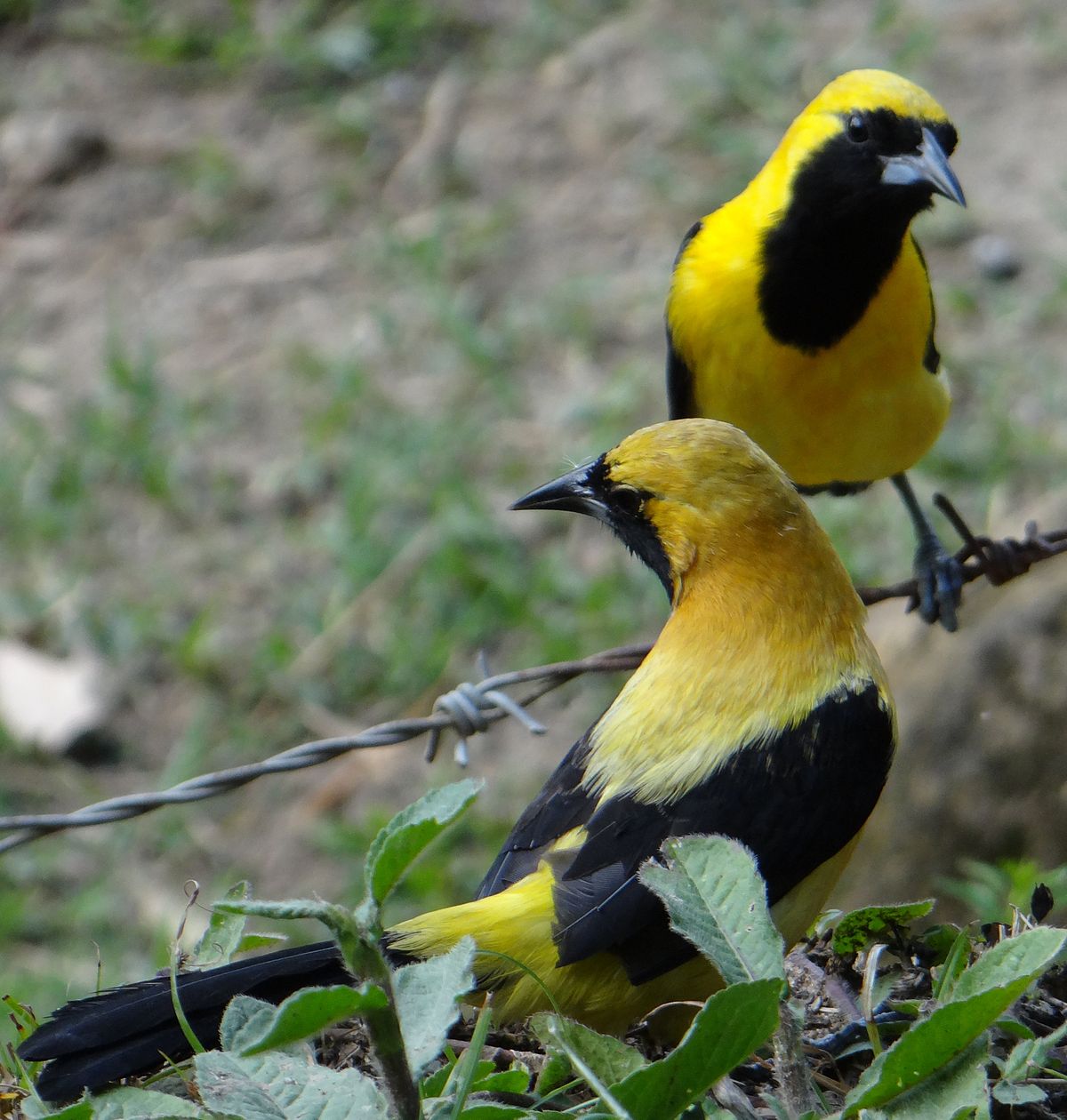
Wikipedia: Yellow-backed oriole Source: OTHER
1200px-Toche_Pareja.jpg
![]() The yellow-backed oriole (Icterus chrysater) is a species of bird in the family Icteridae.
[more]
The yellow-backed oriole (Icterus chrysater) is a species of bird in the family Icteridae.
[more]
Profile Wikipedia eBird Xeno-Canto

Wikipedia: Epaulet oriole Source: OTHER
Epaulet_Oriole_-_Pantanal_-_Brazil_H8O1352_%2823781001732%29.jpg
![]() The epaulet oriole (Icterus cayanensis) is a species of bird in the family Icteridae. The moriche oriole, formerly considered a distinct species (I. chrysocephalus) is now placed herein as a subspecies. The variable oriole, (I. pyrrhopterus), was formerly considered conspecific, but has recently been split by the SACC.
[more]
The epaulet oriole (Icterus cayanensis) is a species of bird in the family Icteridae. The moriche oriole, formerly considered a distinct species (I. chrysocephalus) is now placed herein as a subspecies. The variable oriole, (I. pyrrhopterus), was formerly considered conspecific, but has recently been split by the SACC.
[more]
Profile Wikipedia eBird Xeno-Canto

Wikipedia: White-edged oriole Source: OTHER
Spot-breasted_Oriole_.jpg
![]() The white-edged oriole (Icterus graceannae) is a species of bird in the family Icteridae. It is found in Ecuador and Peru.
[more]
The white-edged oriole (Icterus graceannae) is a species of bird in the family Icteridae. It is found in Ecuador and Peru.
[more]
Profile Wikipedia eBird Xeno-Canto
![]() The velvet-fronted grackle (Lampropsar tanagrinus) is a species of bird in the family Icteridae, monotypic within the genus Lampropsar. It is found in Bolivia, Brazil, Colombia, Ecuador, Guyana, Peru, and Venezuela where its natural habitats are subtropical or tropical swamps and heavily degraded former forest.
[more]
The velvet-fronted grackle (Lampropsar tanagrinus) is a species of bird in the family Icteridae, monotypic within the genus Lampropsar. It is found in Bolivia, Brazil, Colombia, Ecuador, Guyana, Peru, and Venezuela where its natural habitats are subtropical or tropical swamps and heavily degraded former forest.
[more]
Profile Wikipedia eBird Xeno-Canto
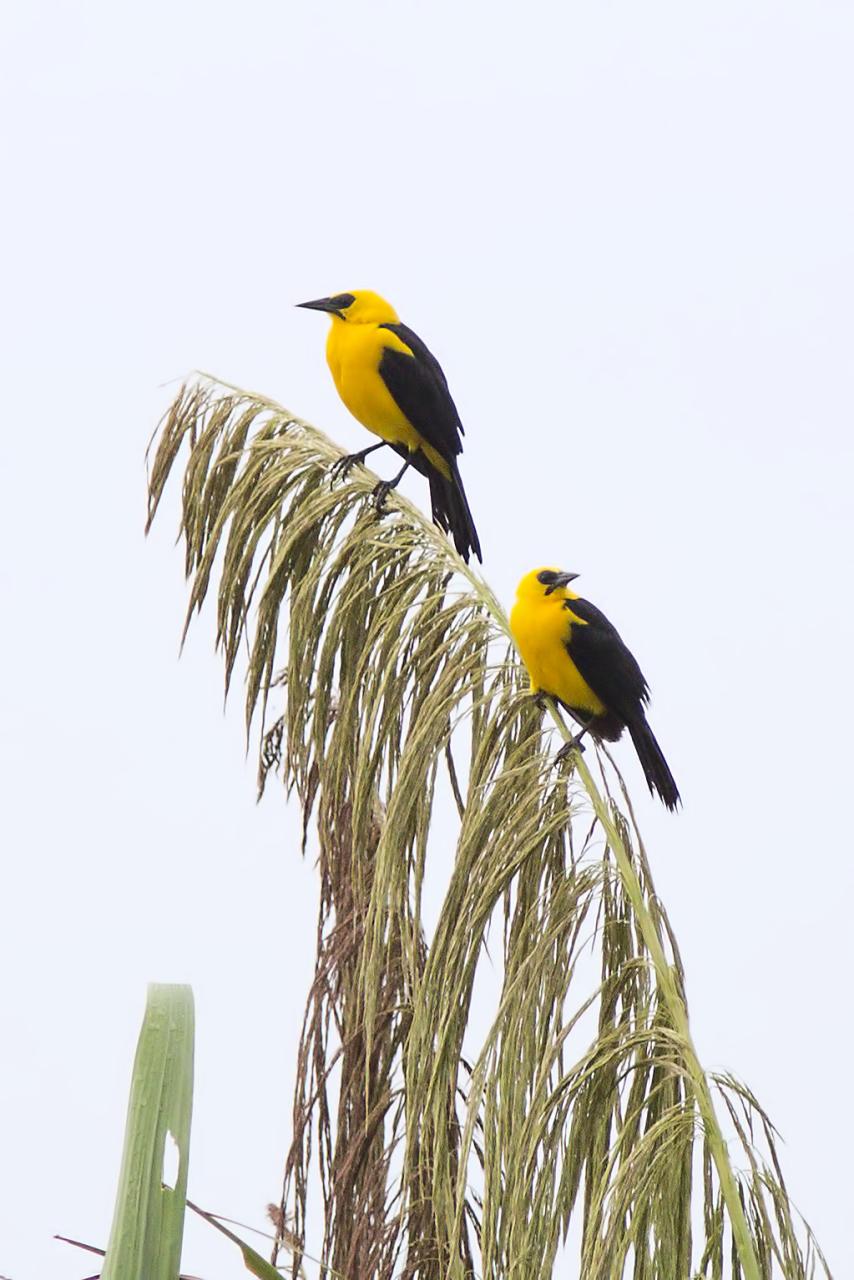
Wikipedia: Oriole blackbird Source: OTHER
Gymnomystax_mexicanus_-Peru_-two-8.jpg
![]() The oriole blackbird (Gymnomystax mexicanus) is a species of bird in the family Icteridae. Its genus, Gymnomystax, is monotypic.[2] It is a medium-sized yellow and black bird found in Brazil, Colombia, Ecuador, French Guiana, Guyana, Peru, Suriname, and Venezuela, where its natural habitats are subtropical or tropical moist lowland forest, subtropical or tropical moist shrubland, subtropical or tropical seasonally wet or flooded lowland grassland, and swamps.[1]
[more]
The oriole blackbird (Gymnomystax mexicanus) is a species of bird in the family Icteridae. Its genus, Gymnomystax, is monotypic.[2] It is a medium-sized yellow and black bird found in Brazil, Colombia, Ecuador, French Guiana, Guyana, Peru, Suriname, and Venezuela, where its natural habitats are subtropical or tropical moist lowland forest, subtropical or tropical moist shrubland, subtropical or tropical seasonally wet or flooded lowland grassland, and swamps.[1]
[more]
Profile Wikipedia eBird Audubon AllAboutBirds Xeno-Canto

Wikipedia: Shiny cowbird Source: OTHER
1200px-Shiny_cowbird_%28Molothrus_bonariensis%29_male.JPG
![]() The shiny cowbird (Molothrus bonariensis) is a passerine bird in the New World family Icteridae. It breeds in most of South America except for dense forests and areas of high altitude such as mountains.[1] Since 1900 the shiny cowbirds' range has shifted northward, and it was recorded in the Caribbean islands as well as the United States, where it is found breeding in southern Florida.[2] It is a bird associated with open habitats, including disturbed land from agriculture and deforestation.[1]
[more]
The shiny cowbird (Molothrus bonariensis) is a passerine bird in the New World family Icteridae. It breeds in most of South America except for dense forests and areas of high altitude such as mountains.[1] Since 1900 the shiny cowbirds' range has shifted northward, and it was recorded in the Caribbean islands as well as the United States, where it is found breeding in southern Florida.[2] It is a bird associated with open habitats, including disturbed land from agriculture and deforestation.[1]
[more]
Profile Wikipedia eBird Xeno-Canto
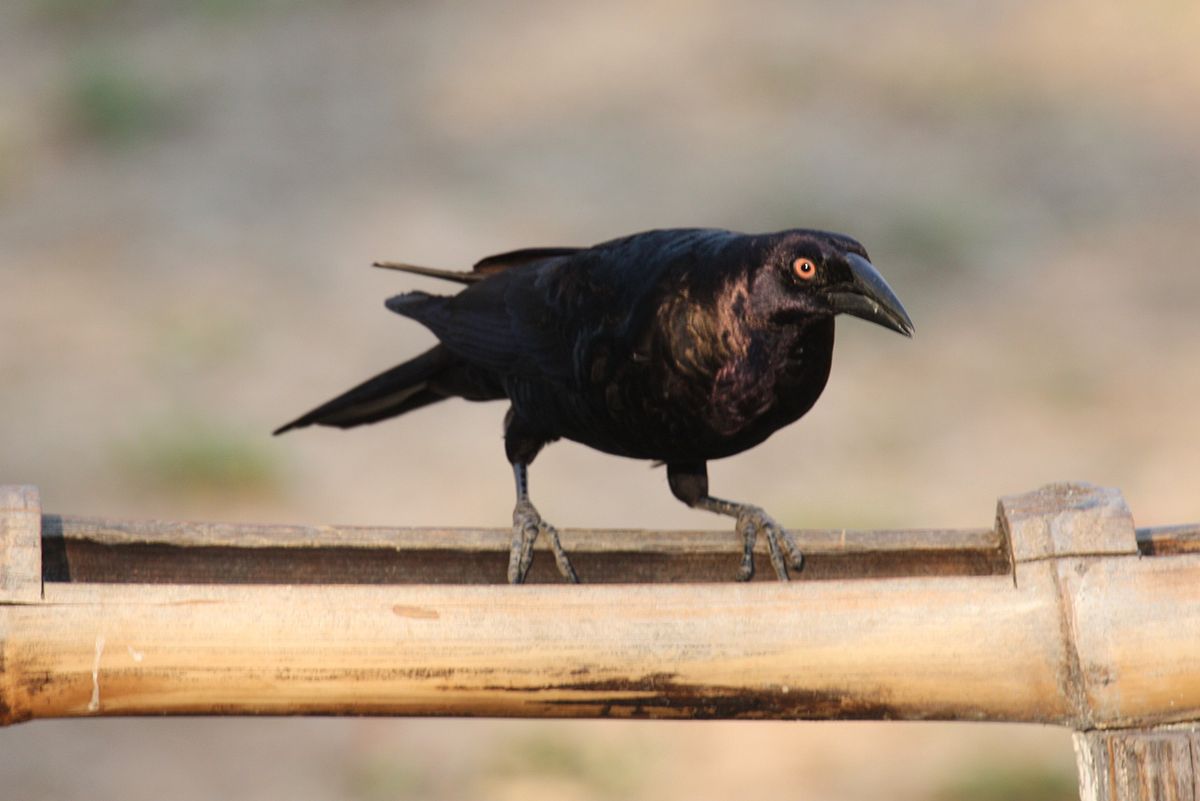
Wikipedia: Giant cowbird Source: OTHER
1200px-Molothrus_oryzivorus.jpg
![]() The giant cowbird (Molothrus oryzivorus) is a large passerine bird in the New World family Icteridae. It breeds from southern Mexico south to northern Argentina, and on Trinidad and Tobago. It may have relatively recently colonised the latter island.
[more]
The giant cowbird (Molothrus oryzivorus) is a large passerine bird in the New World family Icteridae. It breeds from southern Mexico south to northern Argentina, and on Trinidad and Tobago. It may have relatively recently colonised the latter island.
[more]
Profile Wikipedia eBird Xeno-Canto

Wikipedia: Crested oropendola Source: OTHER
1200px-Crested_oropendola_%28Psarocolius_decumanus_insularis%29.jpg
![]() The crested oropendola also known as the Suriname crested oropendola or the cornbird (Psarocolius decumanus) is a New World tropical icterid bird. It is a resident breeder in lowland South America east of the Andes, from Panama and Colombia south to northern Argentina, as well as on Trinidad and Tobago. If the genus Gymnostinax for the Montezuma oropendola and its closest relatives were considered valid, this species would probably belong in that genus (Price & Lanyon 2002).
[more]
The crested oropendola also known as the Suriname crested oropendola or the cornbird (Psarocolius decumanus) is a New World tropical icterid bird. It is a resident breeder in lowland South America east of the Andes, from Panama and Colombia south to northern Argentina, as well as on Trinidad and Tobago. If the genus Gymnostinax for the Montezuma oropendola and its closest relatives were considered valid, this species would probably belong in that genus (Price & Lanyon 2002).
[more]
Profile Wikipedia eBird Xeno-Canto

Wikipedia: Chestnut-headed oropendola Source: OTHER
1200px-Psarocolius_wagleri_-near_Rancho_Naturalista%2C_Cordillera_de_Talamanca%2C_Costa_Rica-8.jpg
![]() Psarocolius waglerii (lapsus)
[more]
Psarocolius waglerii (lapsus)
[more]
Profile Wikipedia eBird Xeno-Canto
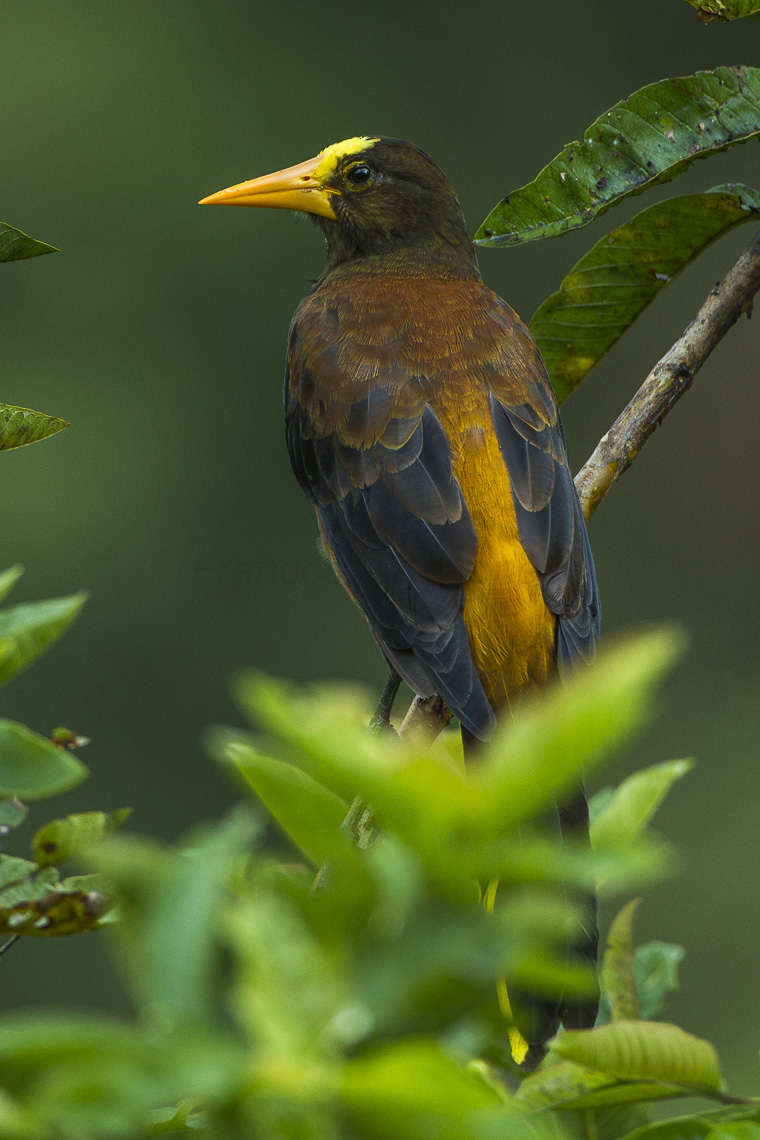
Wikipedia: Russet-backed oropendola Source: OTHER
Russet-backed_Oropendula_-_Colombia_S4E4256_%2823781027782%29.jpg
![]() The russet-backed oropendola (Psarocolius angustifrons) is a species of bird in the family Icteridae. It is found in wooded habitats in the highlands of the northern and central Andes and the Venezuelan Coastal Range, and in lowlands of the western Amazon. It is generally common and widespread. Males are larger than females, but otherwise the genders are similar. Its plumage is mainly olive and brown, and the outer rectrices are contrastingly yellow. The lowland nominate subspecies has a black bill, while the highland subspecies all have pale bills. These have been regarded as separate species, but as they hybridize freely, all major authorities now regard them as a single species.
[more]
The russet-backed oropendola (Psarocolius angustifrons) is a species of bird in the family Icteridae. It is found in wooded habitats in the highlands of the northern and central Andes and the Venezuelan Coastal Range, and in lowlands of the western Amazon. It is generally common and widespread. Males are larger than females, but otherwise the genders are similar. Its plumage is mainly olive and brown, and the outer rectrices are contrastingly yellow. The lowland nominate subspecies has a black bill, while the highland subspecies all have pale bills. These have been regarded as separate species, but as they hybridize freely, all major authorities now regard them as a single species.
[more]
Profile Wikipedia eBird Xeno-Canto

Wikipedia: Green oropendola Source: OTHER
1200px-Green_Oropendola_-_Psarocolius_viridis.jpg
![]() The green oropendola (Psarocolius viridis) is a species of bird in the family Icteridae. It is found in wooded habitats in the Amazon basin and Guianas of South America, and is generally common. Uniquely among the oropendolas, the green oropendola has a pale bill with an orange tip. Male oropendola weigh around 400 grams, while females are in the 200 gram range. This is a common species and the International Union for Conservation of Nature has rated its status as being of "least concern".[1]
[more]
The green oropendola (Psarocolius viridis) is a species of bird in the family Icteridae. It is found in wooded habitats in the Amazon basin and Guianas of South America, and is generally common. Uniquely among the oropendolas, the green oropendola has a pale bill with an orange tip. Male oropendola weigh around 400 grams, while females are in the 200 gram range. This is a common species and the International Union for Conservation of Nature has rated its status as being of "least concern".[1]
[more]

Wikipedia: Olive oropendola Source: OTHER
1200px-Psarocolius_%28bifasciatus%29_yurucares_-_Castelnau.jpg
![]() The olive oropendola (Psarocolius bifasciatus) is the largest member of the icterid family and rivals the Amazonian umbrellabird as the largest passerine bird in South America. It is sometimes placed in the genus Gymnostinops instead of Psarocolius. As suggested by its name, it is found widely – but often in low densities – throughout humid lowland forests of the Amazon Basin, with the notable exception of most of the Guiana Shield. It is sometimes split into two species, the western olive oropendola (P. yuracares) and the eastern Pará oropendola (P. bifasciatus), but the subspecies P. y. neivae is widely recognized as a hybrid swarm, and the vast majority of authorities consider them a single species.
[more]
The olive oropendola (Psarocolius bifasciatus) is the largest member of the icterid family and rivals the Amazonian umbrellabird as the largest passerine bird in South America. It is sometimes placed in the genus Gymnostinops instead of Psarocolius. As suggested by its name, it is found widely – but often in low densities – throughout humid lowland forests of the Amazon Basin, with the notable exception of most of the Guiana Shield. It is sometimes split into two species, the western olive oropendola (P. yuracares) and the eastern Pará oropendola (P. bifasciatus), but the subspecies P. y. neivae is widely recognized as a hybrid swarm, and the vast majority of authorities consider them a single species.
[more]
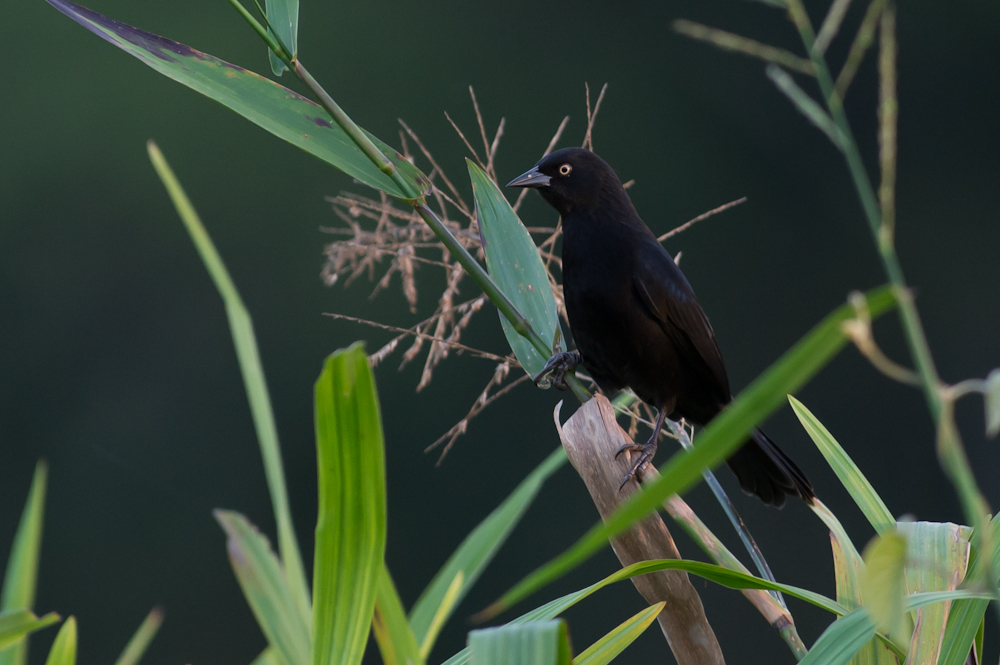
Wikipedia: Pale-eyed blackbird Source: OTHER
Agelasticus_xanthophthalmus_Pale-eyed_Blackbird.jpg
![]() The pale-eyed blackbird (Agelasticus xanthophthalmus) is a species of bird in the family Icteridae. It is found in Ecuador and Peru where its natural habitat is swamps. An inconspicuous bird of very local occurrence, it was first described in 1969 by American ornithologist Lester L. Short.
[more]
The pale-eyed blackbird (Agelasticus xanthophthalmus) is a species of bird in the family Icteridae. It is found in Ecuador and Peru where its natural habitat is swamps. An inconspicuous bird of very local occurrence, it was first described in 1969 by American ornithologist Lester L. Short.
[more]

Wikipedia: Golden-winged warbler Source: OTHER
Golden-winged_Warbler_NGM-v31-p308-C.jpg
![]() The golden-winged warbler (Vermivora chrysoptera) is a New World warbler. It breeds in southeastern and south-central Canada and in the Appalachian Mountains in northeastern to north-central United States. The majority (~70%) of the global population breeds in Wisconsin, Minnesota, and Manitoba. Golden-winged warbler populations are slowly expanding northwards, but are generally declining across its range, most likely as a result of habitat loss and competition/interbreeding with the very closely related blue-winged warbler, Vermivora cyanoptera.
[more]
The golden-winged warbler (Vermivora chrysoptera) is a New World warbler. It breeds in southeastern and south-central Canada and in the Appalachian Mountains in northeastern to north-central United States. The majority (~70%) of the global population breeds in Wisconsin, Minnesota, and Manitoba. Golden-winged warbler populations are slowly expanding northwards, but are generally declining across its range, most likely as a result of habitat loss and competition/interbreeding with the very closely related blue-winged warbler, Vermivora cyanoptera.
[more]

Wikipedia: Three-striped warbler Source: OTHER
1200px-Three-striped_Warbler_-_Chiv%C3%AD_Tres_Rayas_%28Basileuterus_tristriatus_bessereri%29_%2814259290176%29.jpg
![]() The three-striped warbler (Basileuterus tristriatus) is a species of bird in the family Parulidae. It was previously considered conspecific with the Tacarcuna warbler and the black-eared warbler. This bird is found in South America from Venezuela to Peru and Bolivia. Some authorities recognised birds from the southern part of the range as a separate species, the Yungas warbler (Basileuterus punctipectus).[2]
[more]
The three-striped warbler (Basileuterus tristriatus) is a species of bird in the family Parulidae. It was previously considered conspecific with the Tacarcuna warbler and the black-eared warbler. This bird is found in South America from Venezuela to Peru and Bolivia. Some authorities recognised birds from the southern part of the range as a separate species, the Yungas warbler (Basileuterus punctipectus).[2]
[more]
Profile Wikipedia eBird Xeno-Canto

Wikipedia: Three-banded warbler Source: OTHER
Three-banded_warbler.jpg
![]() The three-banded warbler (Basileuterus trifasciatus) is a species of bird in the family Parulidae.
It is found in Ecuador and Peru.
Its natural habitats are subtropical or tropical moist montane forests and heavily degraded former forest.
[more]
The three-banded warbler (Basileuterus trifasciatus) is a species of bird in the family Parulidae.
It is found in Ecuador and Peru.
Its natural habitats are subtropical or tropical moist montane forests and heavily degraded former forest.
[more]

Wikipedia: Mourning warbler Source: OTHER
Oporornis_philadelphiaAAP100CB1.jpg
![]() The mourning warbler (Geothlypis philadelphia) is a small songbird of the New World warbler family. Mourning warblers are native to eastern and central North America as well as some countries in Central America.[2] They are neotropical migrants and tend to be found in dense second growth forests.[3] They are under the Wood-warbler category, which consists of arboreal and terrestrial colorful passerines. Wood warblers are in the order Passeriformes, which are perching birds including more than half of all bird species, and the family Parulidae which also includes the Common Yellowthroat, Black and White Warbler, Nashville Warbler, ovenbird, and American Redstart. They are very similar to the MacGillivray's Warbler in appearance, especially in females and immature birds, but their breeding range does not overlap into the west.[4]
[more]
The mourning warbler (Geothlypis philadelphia) is a small songbird of the New World warbler family. Mourning warblers are native to eastern and central North America as well as some countries in Central America.[2] They are neotropical migrants and tend to be found in dense second growth forests.[3] They are under the Wood-warbler category, which consists of arboreal and terrestrial colorful passerines. Wood warblers are in the order Passeriformes, which are perching birds including more than half of all bird species, and the family Parulidae which also includes the Common Yellowthroat, Black and White Warbler, Nashville Warbler, ovenbird, and American Redstart. They are very similar to the MacGillivray's Warbler in appearance, especially in females and immature birds, but their breeding range does not overlap into the west.[4]
[more]
Profile Wikipedia eBird Xeno-Canto

Wikipedia: Olive-crowned yellowthroat Source: OTHER
Olive-crowned_Yellowthroat_-_South_Ecuador_S4E9098_%2822648743247%29.jpg
![]() The olive-crowned yellowthroat (Geothlypis semiflava) is a species of bird in the family Parulidae.
It is found in Colombia, Costa Rica, Ecuador, Honduras, Mexico, Nicaragua, and Panama.
Its natural habitats are subtropical or tropical moist shrubland and heavily degraded former forest.
[more]
The olive-crowned yellowthroat (Geothlypis semiflava) is a species of bird in the family Parulidae.
It is found in Colombia, Costa Rica, Ecuador, Honduras, Mexico, Nicaragua, and Panama.
Its natural habitats are subtropical or tropical moist shrubland and heavily degraded former forest.
[more]
Profile Wikipedia eBird Xeno-Canto

Wikipedia: Masked yellowthroat Source: OTHER
Geothlypis_velata%2C_Piraju-SP%2C_Brazil.jpg
![]() The masked yellowthroat (Geothlypis aequinoctialis) is a New World warbler. It has a number of separate resident breeding populations in Central and South America, some of which may be considered to form separate species.
[more]
The masked yellowthroat (Geothlypis aequinoctialis) is a New World warbler. It has a number of separate resident breeding populations in Central and South America, some of which may be considered to form separate species.
[more]

Wikipedia: Canada warbler Source: OTHER
1200px-8G7D5475-Canada.jpg
![]() The Canada warbler (Cardellina canadensis) is a small boreal songbird of the New World warbler family (Parulidae). It summers in Canada and northeastern United States and winters in northern South America.
[more]
The Canada warbler (Cardellina canadensis) is a small boreal songbird of the New World warbler family (Parulidae). It summers in Canada and northeastern United States and winters in northern South America.
[more]
Black and white warbler, Ecotucan, Bacalar. 2023-03-30 17.30.48 Yucatan
First observed in Yucatan on 2023-03-27.
![]() The black-and-white warbler (Mniotilta varia) is a species of New World warbler, and the only member of its genus, Mniotilta.[2]
It breeds in northern and eastern North America and winters in Florida, Central America, and the West Indies down to Peru. This species is a very rare vagrant to western Europe.[2]
[more]
The black-and-white warbler (Mniotilta varia) is a species of New World warbler, and the only member of its genus, Mniotilta.[2]
It breeds in northern and eastern North America and winters in Florida, Central America, and the West Indies down to Peru. This species is a very rare vagrant to western Europe.[2]
[more]
Profile Wikipedia eBird Xeno-Canto

Wikipedia: Slate-throated redstart Source: OTHER
1200px-Slate-throated_whitestart_%28Myioborus_miniatus_aurantiacus%29.jpg
![]() The slate-throated whitestart or slate-throated redstart (Myioborus miniatus) is a species of bird in the family Parulidae native to Central and South America.[1][2]
[more]
The slate-throated whitestart or slate-throated redstart (Myioborus miniatus) is a species of bird in the family Parulidae native to Central and South America.[1][2]
[more]
Profile Wikipedia eBird Xeno-Canto
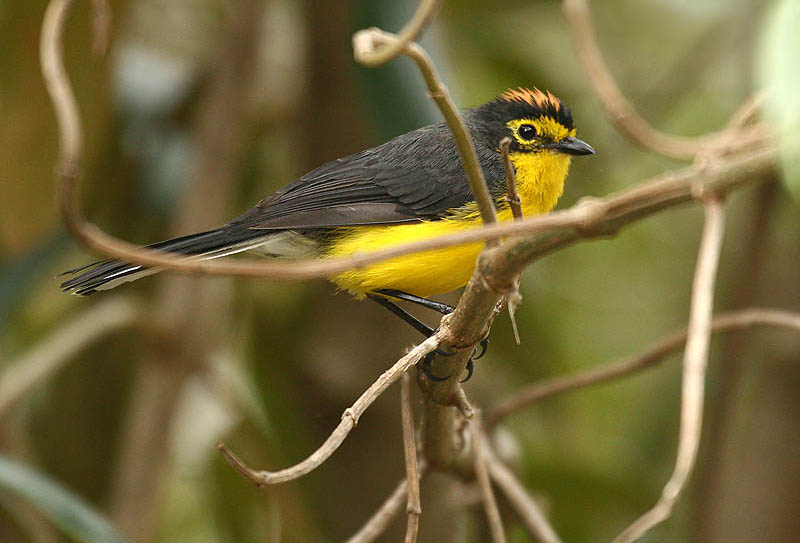
Wikipedia: Spectacled redstart Source: OTHER
Myioborus_melanocephalus_-Ecuador-8.jpg
Ecuador
![]() The spectacled whitestart or spectacled redstart (Myioborus melanocephalus) is a species of bird in the family Parulidae. It is found in humid Andean forests, woodland and scrub from southern Colombia to Bolivia
[more]
The spectacled whitestart or spectacled redstart (Myioborus melanocephalus) is a species of bird in the family Parulidae. It is found in humid Andean forests, woodland and scrub from southern Colombia to Bolivia
[more]
Profile Wikipedia eBird Audubon AllAboutBirds Xeno-Canto
MerlinBirdID suggest a prothonotary warbler, at botanical garden, Puerto Morelos. 2023-03-27 11.50.22 Yucatan
First observed in Yucatan on 2023-03-27.
![]() The prothonotary warbler (Protonotaria citrea) is a small songbird of the New World warbler family. It is the only member of the genus Protonotaria.[2]
[more]
The prothonotary warbler (Protonotaria citrea) is a small songbird of the New World warbler family. It is the only member of the genus Protonotaria.[2]
[more]

Wikipedia: Ovenbird Source: OTHER
1200px-Ovenbird_RWD2011b.jpg
![]() The ovenbird (Seiurus aurocapilla) is a small songbird of the New World warbler family (Parulidae). This migratory bird breeds in eastern North America and winters in Central America, many Caribbean islands, Florida and northern Venezuela.[2][3]
[more]
The ovenbird (Seiurus aurocapilla) is a small songbird of the New World warbler family (Parulidae). This migratory bird breeds in eastern North America and winters in Central America, many Caribbean islands, Florida and northern Venezuela.[2][3]
[more]

Wikipedia: Cerulean warbler Source: OTHER
Dendroica-cerulea-002.jpg
![]() The cerulean warbler (Setophaga cerulea) is a small songbird of the New World warbler family.
Adult males have pale cerulean blue and white upperparts with a black necklace across the breast and black streaks on the back and flanks. Females and immature birds have greyer or greenish upperparts, a pale stripe over the eye, and no streaking on the back and no neck. All of these birds have wing bars and a thin pointed bill.
They are found in deciduous forests of eastern North America during the breeding season and then migrate to forested mountain areas in South America.
The species is considered threatened with an IUCN status of near threatened, indicating it does not face any imminent threat of extinction in the wild.
[more]
The cerulean warbler (Setophaga cerulea) is a small songbird of the New World warbler family.
Adult males have pale cerulean blue and white upperparts with a black necklace across the breast and black streaks on the back and flanks. Females and immature birds have greyer or greenish upperparts, a pale stripe over the eye, and no streaking on the back and no neck. All of these birds have wing bars and a thin pointed bill.
They are found in deciduous forests of eastern North America during the breeding season and then migrate to forested mountain areas in South America.
The species is considered threatened with an IUCN status of near threatened, indicating it does not face any imminent threat of extinction in the wild.
[more]

Wikipedia: Blackburnian warbler Source: OTHER
1200px-Dendroica-fusca-001.jpg
![]() The Blackburnian warbler (Setophaga fusca) is a small New World warbler. They breed in eastern North America, from southern Canada, westwards to the southern Canadian Prairies, the Great Lakes region and New England, to North Carolina.
[more]
The Blackburnian warbler (Setophaga fusca) is a small New World warbler. They breed in eastern North America, from southern Canada, westwards to the southern Canadian Prairies, the Great Lakes region and New England, to North Carolina.
[more]
Yellow warbler, male of one of the mangrove subspecies, feeding off coconuts used just to sell the milk as a refreshing drink. 2023-04-21 07.08.16 Yucatan
First observed in Yucatan on 2023-04-21.
![]() The yellow warbler (Setophaga petechia) is a New World warbler species. Yellow warblers are the most widespread species in the diverse genus Setophaga. The species can be found throughout most of North America and migrates to wintering grounds from southern California to the Amazon region, Bolivia, and Peru.
[more]
The yellow warbler (Setophaga petechia) is a New World warbler species. Yellow warblers are the most widespread species in the diverse genus Setophaga. The species can be found throughout most of North America and migrates to wintering grounds from southern California to the Amazon region, Bolivia, and Peru.
[more]

Wikipedia: Blackpoll warbler Source: OTHER
1200px-Dendroica_striata_MN.jpg
![]() The blackpoll warbler (Setophaga striata) is a New World warbler. Breeding males are mostly black and white. They have a prominent black cap, white cheeks and white wing bars. The blackpoll breeds in forests of northern North America, from Alaska throughout most of Canada, to the mountains of New York and New England. They are a common migrant through much of North America. In fall, they fly south to the Greater Antilles and the northeastern coasts of South America in a non-stop long-distance migration over open water, averaging 2500 km, one of the longest distance non-stop overwater flights ever recorded for a migratory songbird. Rare vagrants to western Europe, they are one of the more frequent transatlantic passerine wanderers.
[more]
The blackpoll warbler (Setophaga striata) is a New World warbler. Breeding males are mostly black and white. They have a prominent black cap, white cheeks and white wing bars. The blackpoll breeds in forests of northern North America, from Alaska throughout most of Canada, to the mountains of New York and New England. They are a common migrant through much of North America. In fall, they fly south to the Greater Antilles and the northeastern coasts of South America in a non-stop long-distance migration over open water, averaging 2500 km, one of the longest distance non-stop overwater flights ever recorded for a migratory songbird. Rare vagrants to western Europe, they are one of the more frequent transatlantic passerine wanderers.
[more]
Profile Wikipedia eBird Audubon AllAboutBirds Xeno-Canto
Possibly a female American redstart at Maya site Becan. 2023-04-03 12.11.18 Yucatan
First observed in Cockeysville on 2022-05-02.
![]() The American redstart (Setophaga ruticilla) is a New World warbler. It is unrelated to the Old World (common) redstart.
[more]
The American redstart (Setophaga ruticilla) is a New World warbler. It is unrelated to the Old World (common) redstart.
[more]
Call:
Automatically generated from Xeno-Canto recording
♫ Source: BirdNet
20220502_085740 birdnet - American Redstart - 2022-05-02 08:57:40 - American Redstart - Cockeysville.mp3
2022-05-02 08.57.40 Cockeysville (song?)

Wikipedia: Bay-breasted warbler Source: OTHER
1200px-Dendroica-castanea-001.jpg
![]() The Bay-breasted Warbler (Setophaga castanea) is a small species of songbird in the New World warbler family, Parulidae. It is one of thirty-four species in the diverse genus Setophaga.[2] Like all songbirds, or passerines, the species is classified in the order Passeriformes.
[more]
The Bay-breasted Warbler (Setophaga castanea) is a small species of songbird in the New World warbler family, Parulidae. It is one of thirty-four species in the diverse genus Setophaga.[2] Like all songbirds, or passerines, the species is classified in the order Passeriformes.
[more]

Wikipedia: Tropical parula Source: OTHER
Parula_pitiayumi_-Piraju%2C_Sao_Paulo%2C_Brazil-8.jpg
![]() The tropical parula (Setophaga pitiayumi) is a small New World warbler. It breeds from southernmost Texas and northwest Mexico (Sonora) south through Central America to northern Argentina, including Trinidad and Tobago. This widespread and common species is not considered threatened by the IUCN.[1]
[more]
The tropical parula (Setophaga pitiayumi) is a small New World warbler. It breeds from southernmost Texas and northwest Mexico (Sonora) south through Central America to northern Argentina, including Trinidad and Tobago. This widespread and common species is not considered threatened by the IUCN.[1]
[more]

Wikipedia: Northern waterthrush Source: OTHER
Northern_Waterthrush%2C_Parkesia_noveboracensis.jpg
![]() The northern waterthrush (Parkesia noveboracensis[2]) is one of the larger New World warblers and one of the Nearctic-Neotropical migratory songbirds.[3] It breeds in the northern part of North America in Canada and the northern United States including Alaska. This bird is migratory, wintering in Central America, the West Indies and Florida, as well as in Venezuela, Colombia, and Ecuador. It is a very rare vagrant to other South American countries and to western Europe.
[more]
The northern waterthrush (Parkesia noveboracensis[2]) is one of the larger New World warblers and one of the Nearctic-Neotropical migratory songbirds.[3] It breeds in the northern part of North America in Canada and the northern United States including Alaska. This bird is migratory, wintering in Central America, the West Indies and Florida, as well as in Venezuela, Colombia, and Ecuador. It is a very rare vagrant to other South American countries and to western Europe.
[more]
![]() Der Schmätzerwaldsänger (Myiothlypis fulvicauda, Syn.: Phaeothlypis fulvicauda) ist ein kleiner Singvogel in der Gattung Myiothlypis aus der Familie der Waldsänger (Parulidae). Diese Art bildet mit dem Flusswaldsänger (Myiothlypis rivularis) eine Superspezies. Das Verbreitungsgebiet befindet sich in Zentral- und Südamerika. Die IUCN listet die Vogelart als „nicht gefährdet“ (least concern).
[more]
Der Schmätzerwaldsänger (Myiothlypis fulvicauda, Syn.: Phaeothlypis fulvicauda) ist ein kleiner Singvogel in der Gattung Myiothlypis aus der Familie der Waldsänger (Parulidae). Diese Art bildet mit dem Flusswaldsänger (Myiothlypis rivularis) eine Superspezies. Das Verbreitungsgebiet befindet sich in Zentral- und Südamerika. Die IUCN listet die Vogelart als „nicht gefährdet“ (least concern).
[more]

Wikipedia: Golden-bellied warbler Source: OTHER
1200px-Myiothlypis_chrysogaster_107354039.jpg
![]() The golden-bellied warbler or Cuzco Warbler (Myiothlypis chrysogaster) is a South American species of bird in the family Parulidae.[1][2] Its natural habitats are subtropical or tropical moist lowland forests, subtropical or tropical moist montane forests, and heavily degraded former forest.
[more]
The golden-bellied warbler or Cuzco Warbler (Myiothlypis chrysogaster) is a South American species of bird in the family Parulidae.[1][2] Its natural habitats are subtropical or tropical moist lowland forests, subtropical or tropical moist montane forests, and heavily degraded former forest.
[more]
Profile Wikipedia eBird Xeno-Canto
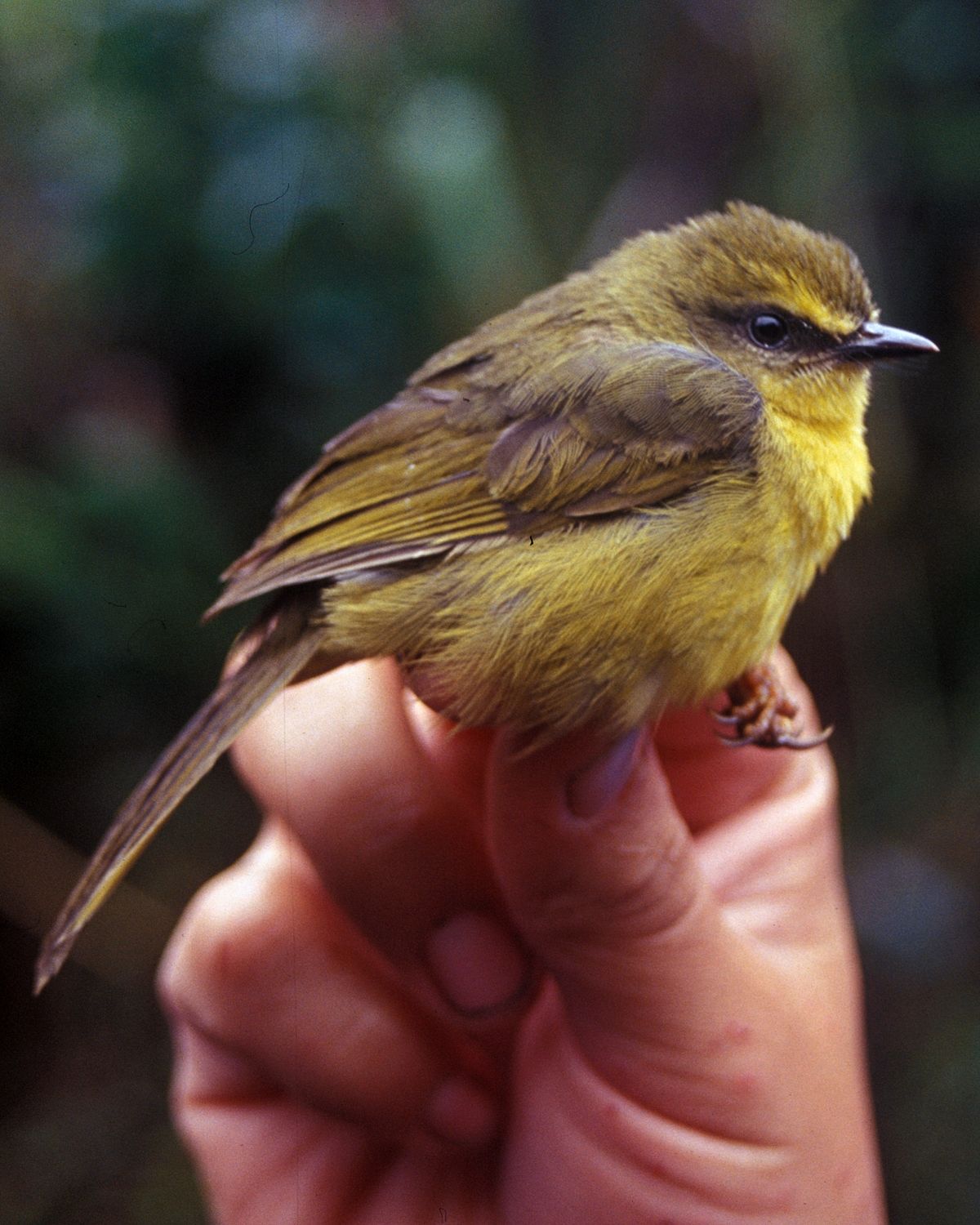
Wikipedia: Citrine warbler Source: OTHER
1200px-Basileuterus_luteoviridis.jpg
![]() The citrine warbler (Myiothlypis luteoviridis) is a species of bird in the family Parulidae. The term citrine refers to its yellowish colouration. It is found in Bolivia, Colombia, Ecuador, Peru, and Venezuela. Its natural habitat is subtropical or tropical moist montane forests.[2]
[more]
The citrine warbler (Myiothlypis luteoviridis) is a species of bird in the family Parulidae. The term citrine refers to its yellowish colouration. It is found in Bolivia, Colombia, Ecuador, Peru, and Venezuela. Its natural habitat is subtropical or tropical moist montane forests.[2]
[more]

Wikipedia: Grey-and-gold warbler Source: OTHER
Gray-and-gold_Warbler_-_South_Ecuador_S4E8591_%2823040933926%29.jpg
![]() The grey-and-gold warbler (Myiothlypis fraseri) is a species of bird in the family Parulidae.
It is found in Ecuador and Peru.
Its natural habitats are subtropical or tropical dry forests and subtropical or tropical moist lowland forests. Aspects of the grey-and-gold warbler's breeding biology were recently described by Miller et al. (2007), based on a sample of two nests. It was named after British zoologist and collector Louis Fraser.
[more]
The grey-and-gold warbler (Myiothlypis fraseri) is a species of bird in the family Parulidae.
It is found in Ecuador and Peru.
Its natural habitats are subtropical or tropical dry forests and subtropical or tropical moist lowland forests. Aspects of the grey-and-gold warbler's breeding biology were recently described by Miller et al. (2007), based on a sample of two nests. It was named after British zoologist and collector Louis Fraser.
[more]

Wikipedia: Black-crested warbler Source: OTHER
Black-crested_Warbler_%28Basileuterus_nigrocristatus%29.jpg
![]() The black-crested warbler (Myiothlypis nigrocristata) is a species of bird in the family Parulidae.
It is found in Colombia, Ecuador, Peru, and Venezuela.
Its natural habitats are subtropical or tropical moist montane forests and heavily degraded former forest.
[more]
The black-crested warbler (Myiothlypis nigrocristata) is a species of bird in the family Parulidae.
It is found in Colombia, Ecuador, Peru, and Venezuela.
Its natural habitats are subtropical or tropical moist montane forests and heavily degraded former forest.
[more]

Wikipedia: Russet-crowned warbler Source: OTHER
1200px-NBII_Image_Gallery_-Basileuterus_coronatus-a00207.jpg
![]() The russet-crowned warbler (Myiothlypis coronata) is a species of bird in the family Parulidae.
It is found in Bolivia, Colombia, Ecuador, Peru, and Venezuela.
Its natural habitats are subtropical or tropical moist montane forests and heavily degraded former forest.
[more]
The russet-crowned warbler (Myiothlypis coronata) is a species of bird in the family Parulidae.
It is found in Bolivia, Colombia, Ecuador, Peru, and Venezuela.
Its natural habitats are subtropical or tropical moist montane forests and heavily degraded former forest.
[more]
Red-crested cotinga / Rotschopfkotinga (Ampelion rubrocristatus)

Wikipedia: Red-crested cotinga Source: OTHER
Red-crested_Cotinga_-_EcuadorDSCN2925.jpg
![]() The red-crested cotinga (Ampelion rubrocristatus) is a species of bird in the family Cotingidae.
[more]
The red-crested cotinga (Ampelion rubrocristatus) is a species of bird in the family Cotingidae.
[more]
Chestnut-crested cotinga (Ampelion rufaxilla)
Profile Wikipedia eBird Xeno-Canto
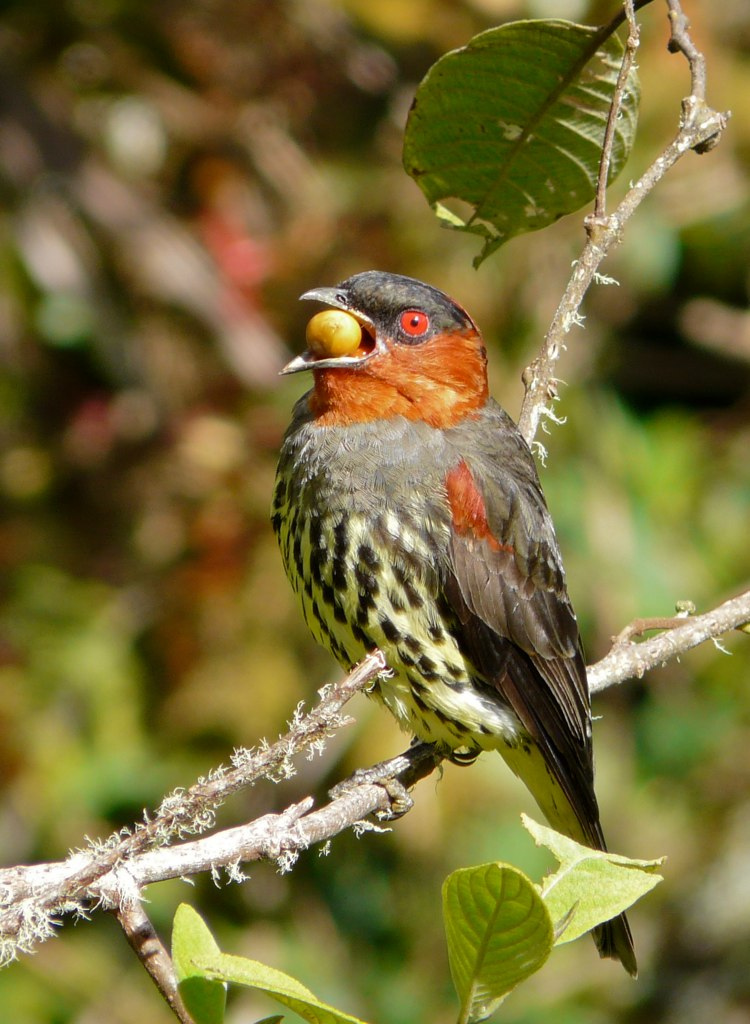
Wikipedia: Chestnut-crested cotinga Source: OTHER
Ampelion_rufaxilla_-_Chestnut-crested_Cotinga_%285741252596%29.jpg
![]() The chestnut-crested cotinga (Ampelion rufaxilla) is a species of bird in the family Cotingidae.
[more]
The chestnut-crested cotinga (Ampelion rufaxilla) is a species of bird in the family Cotingidae.
[more]
Andean cock-of-the-rock (alternate) / Andenfelsenhahn (Rupicola peruviana)
![]() Der Andenfelsenhahn (Rupicola peruvianus), auch Andenklippenvogel oder Roter Felsenhahn genannt, ist eine südamerikanischer Vogelart aus der Familie der Schmuckvögel (Cotingidae). Er ist der Nationalvogel von Peru.
[more]
Der Andenfelsenhahn (Rupicola peruvianus), auch Andenklippenvogel oder Roter Felsenhahn genannt, ist eine südamerikanischer Vogelart aus der Familie der Schmuckvögel (Cotingidae). Er ist der Nationalvogel von Peru.
[more]
Scaled fruiteater (Ampelioides tschudii)
Profile Wikipedia eBird Xeno-Canto

Wikipedia: Scaled fruiteater Source: OTHER
Scaled_Fruiteater.jpg
![]() The scaled fruiteater (Ampelioides tschudii) is a species of bird in the family Cotingidae. It is the only member of the genus Ampelioides.[2]
[more]
The scaled fruiteater (Ampelioides tschudii) is a species of bird in the family Cotingidae. It is the only member of the genus Ampelioides.[2]
[more]
Black-tipped cotinga (Carpodectes hopkei)
Profile Wikipedia eBird Xeno-Canto

Wikipedia: Black-tipped cotinga Source: OTHER
1200px-Carpodectes_hopkei_-_Black-tipped_Cotinga.jpg
![]() The black-tipped cotinga (Carpodectes hopkei), also known as the white cotinga, is a species of bird in the family Cotingidae. It is found in the Chocó region, from southeastern Panama to northwestern Ecuador ; its natural habitat is subtropical or tropical moist lowland forests. The male, being white, is conspicuous, but in general it is an uncommon species.
[more]
The black-tipped cotinga (Carpodectes hopkei), also known as the white cotinga, is a species of bird in the family Cotingidae. It is found in the Chocó region, from southeastern Panama to northwestern Ecuador ; its natural habitat is subtropical or tropical moist lowland forests. The male, being white, is conspicuous, but in general it is an uncommon species.
[more]
Amazonian umbrellabird (Cephalopterus ornatus)
Profile Wikipedia eBird Xeno-Canto
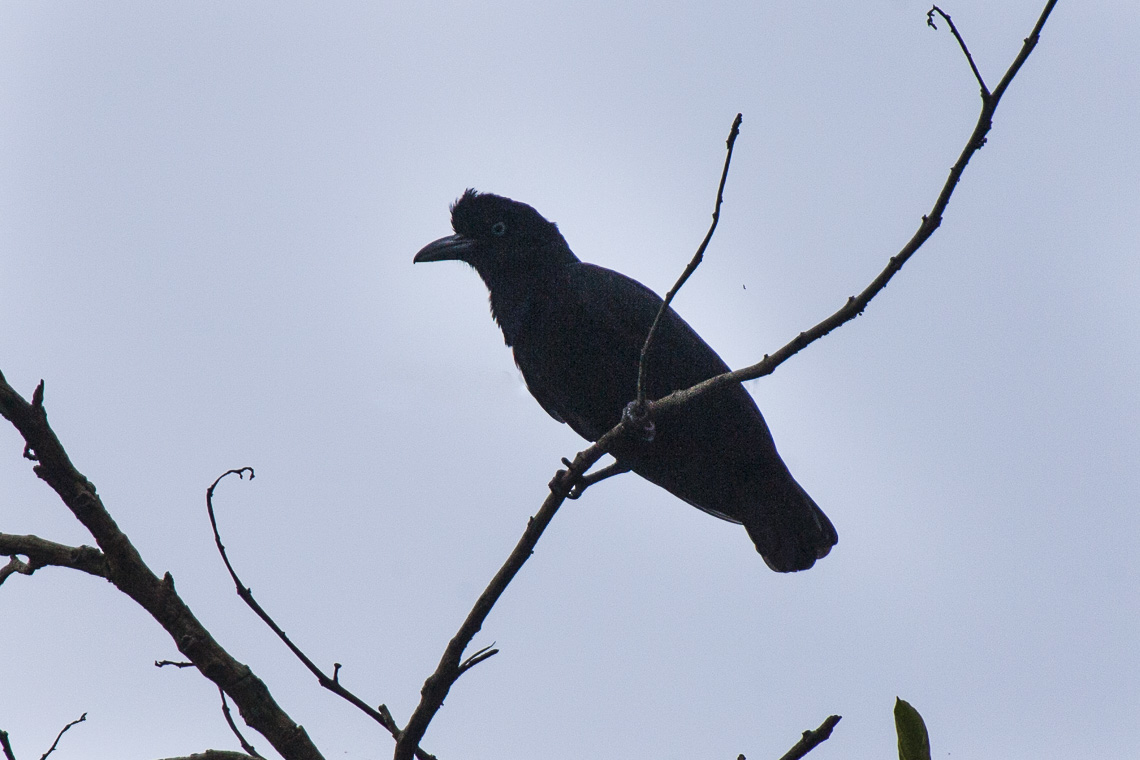
Wikipedia: Amazonian umbrellabird Source: OTHER
Amazonian_Umbrellabird_fem_-_Manu_NP_8291_%2816834437801%29.jpg
![]() The Amazonian umbrellabird (Cephalopterus ornatus) is a species of bird in the family Cotingidae native to the Amazon basin with a separate population on the eastern slopes of the Andes. The male bird is entirely black, with a black crest and inflatable wattle on the throat, and at 48 to 55 cm (19 to 22 in), may be the largest passerine bird in South America. The female is slightly smaller. Both have an undulating flight, described as woodpecker-like, and the male has a loud, booming call.
[more]
The Amazonian umbrellabird (Cephalopterus ornatus) is a species of bird in the family Cotingidae native to the Amazon basin with a separate population on the eastern slopes of the Andes. The male bird is entirely black, with a black crest and inflatable wattle on the throat, and at 48 to 55 cm (19 to 22 in), may be the largest passerine bird in South America. The female is slightly smaller. Both have an undulating flight, described as woodpecker-like, and the male has a loud, booming call.
[more]
Long-wattled umbrellabird (Cephalopterus penduliger)
Profile Wikipedia eBird Xeno-Canto

Wikipedia: Long-wattled umbrellabird Source: OTHER
Cotingidae_-_Cephalopterus_penduliger.jpg
![]() The long-wattled umbrellabird (Cephalopterus penduliger) is an Umbrellabird in the Cotinga family. Its common names include "Pájaro Bolsón", "Pájaro Toro", "Dungali" and "Vaca de Monte".[2] The Long-wattled Umbrellabird is considered rare and it resides in humid to wet premontane and cloud forest.[3] They are often found on the Pacific slopes of south-west Colombia and western Ecuador, but occasionally are found at lower altitudes.[3]
[more]
The long-wattled umbrellabird (Cephalopterus penduliger) is an Umbrellabird in the Cotinga family. Its common names include "Pájaro Bolsón", "Pájaro Toro", "Dungali" and "Vaca de Monte".[2] The Long-wattled Umbrellabird is considered rare and it resides in humid to wet premontane and cloud forest.[3] They are often found on the Pacific slopes of south-west Colombia and western Ecuador, but occasionally are found at lower altitudes.[3]
[more]
Blue cotinga / Nördliche Prachtkotinga (Cotinga nattererii)
Profile Wikipedia eBird Xeno-Canto

Wikipedia: Blue cotinga Source: OTHER
Blue_Cotinga_-_Panama_MG_2171_%2816835518485%29.jpg
![]() The blue cotinga (Cotinga nattererii) is a species of bird in the family Cotingidae. It is found in Colombia, north-west Ecuador, eastern and central Panama and western Venezuela in tropical moist lowland forests and heavily degraded former forest. In relation to range and population size this species is not considered to be vulnerable.[2]
[more]
The blue cotinga (Cotinga nattererii) is a species of bird in the family Cotingidae. It is found in Colombia, north-west Ecuador, eastern and central Panama and western Venezuela in tropical moist lowland forests and heavily degraded former forest. In relation to range and population size this species is not considered to be vulnerable.[2]
[more]
Spangled cotinga / Türkisblaue Kotinga (Cotinga cayana)
Profile Wikipedia eBird Xeno-Canto

Wikipedia: Spangled cotinga Source: OTHER
1200px-SpangledCotinga.jpg
![]() The spangled cotinga (Cotinga cayana) is a species of bird in the family Cotingidae, the cotingas. It is found in the canopy of the Amazon Rainforest in South America.
[more]
The spangled cotinga (Cotinga cayana) is a species of bird in the family Cotingidae, the cotingas. It is found in the canopy of the Amazon Rainforest in South America.
[more]
Plum-throated cotinga (Cotinga maynana)
Profile Wikipedia eBird Xeno-Canto

Wikipedia: Plum-throated cotinga Source: OTHER
Plum-throated_Cotinga_%28Cotinga_maynana%29_%2816781121739%29.jpg
![]() The plum-throated cotinga (Cotinga maynana) is a species of bird in the family Cotingidae. It is found in Bolivia, Brazil, Colombia, Ecuador, and Peru. Its natural habitats are subtropical or tropical moist lowland forest, subtropical or tropical swamps, and heavily degraded former forest.
[more]
The plum-throated cotinga (Cotinga maynana) is a species of bird in the family Cotingidae. It is found in Bolivia, Brazil, Colombia, Ecuador, and Peru. Its natural habitats are subtropical or tropical moist lowland forest, subtropical or tropical swamps, and heavily degraded former forest.
[more]
Chestnut-bellied cotinga (Doliornis remseni)

Wikipedia: Chestnut-bellied cotinga Source: OTHER
1200px-Doliornis_remseni_map.svg.png
![]() The chestnut-bellied cotinga (Doliornis remseni) is a species of bird in the family Cotingidae. It is found in Colombia, Ecuador, and far northern Peru. Its natural habitats are subtropical or tropical moist montane forests and subtropical or tropical high-altitude grassland. Declines in range and population are likely owing to continuing habitat loss and degradation, which has caused this species to be classified as vulnerable.[2]
[more]
The chestnut-bellied cotinga (Doliornis remseni) is a species of bird in the family Cotingidae. It is found in Colombia, Ecuador, and far northern Peru. Its natural habitats are subtropical or tropical moist montane forests and subtropical or tropical high-altitude grassland. Declines in range and population are likely owing to continuing habitat loss and degradation, which has caused this species to be classified as vulnerable.[2]
[more]
Bare-necked fruitcrow (Gymnoderus foetidus)
Profile Wikipedia eBird Xeno-Canto

Wikipedia: Bare-necked fruitcrow Source: OTHER
1200px-GymnoderusFoetidusKeulemans.jpg
![]() The bare-necked fruitcrow (Gymnoderus foetidus) is a species of bird in the family Cotingidae. It is the only member of the genus Gymnoderus. It is found in the Amazon Rainforest, especially near rivers. It is relatively common, but generally rarer and more local north of the Amazon River. Both sexes are overall mainly blackish, but the male has distinctive, large greyish-blue facial- and neck-wattles and greyish-white wings, which flash conspicuously in flight.
[more]
The bare-necked fruitcrow (Gymnoderus foetidus) is a species of bird in the family Cotingidae. It is the only member of the genus Gymnoderus. It is found in the Amazon Rainforest, especially near rivers. It is relatively common, but generally rarer and more local north of the Amazon River. Both sexes are overall mainly blackish, but the male has distinctive, large greyish-blue facial- and neck-wattles and greyish-white wings, which flash conspicuously in flight.
[more]
Whitebrowed purpletuft / Weißbrauen-Zwergbekarde (Iodopleura isabellae)
![]() Die Weißbrauen-Zwergbekarde (Iodopleura isabellae), früher als Weißbrauen-Zwergkotinga bezeichnet, ist eine südamerikanische Vogelart aus der Familie der Bekarden (Tityridae).
[more]
Die Weißbrauen-Zwergbekarde (Iodopleura isabellae), früher als Weißbrauen-Zwergkotinga bezeichnet, ist eine südamerikanische Vogelart aus der Familie der Bekarden (Tityridae).
[more]
Shrike-like cotinga (Laniisoma elegans)
Profile Wikipedia eBird Xeno-Canto
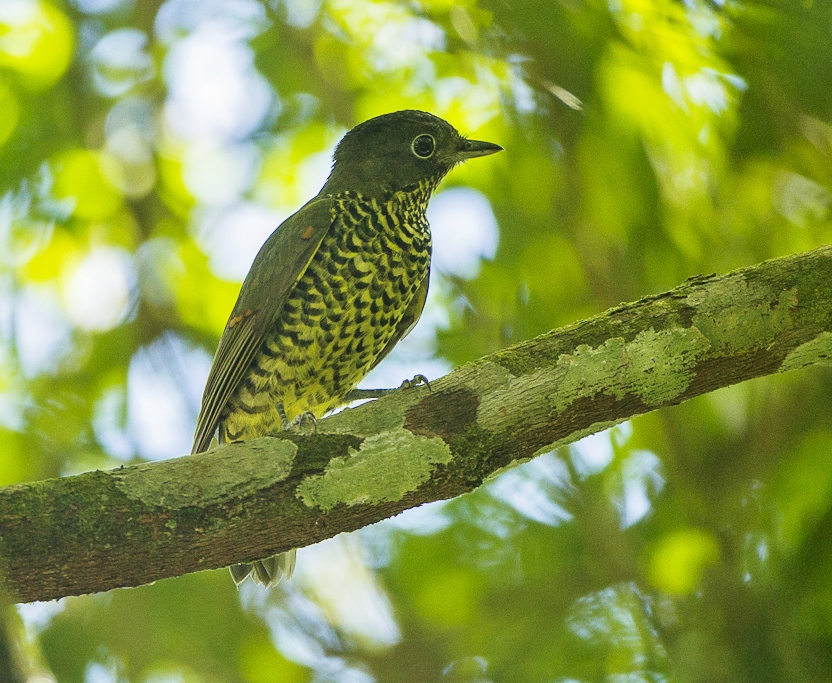
Wikipedia: Shrike-like cotinga Source: OTHER
Shrike-like_Cotinga_-_REGUA_-_Brazil_S4E1690_%2812814049155%29_%282%29.jpg
![]() The Brazilian laniisoma (Laniisoma elegans), also known as the shrike-like laniisoma, the shrike-like cotinga or the elegant mourner, is a species of bird in the family Tityridae. As suggested by its common name, it was formerly considered a cotinga. As it is far from being "shrike-like", this means that the widely used common name is entirely misleading.
[more]
The Brazilian laniisoma (Laniisoma elegans), also known as the shrike-like laniisoma, the shrike-like cotinga or the elegant mourner, is a species of bird in the family Tityridae. As suggested by its common name, it was formerly considered a cotinga. As it is far from being "shrike-like", this means that the widely used common name is entirely misleading.
[more]
Rufous piha (Lipaugus unirufus)
Profile Wikipedia eBird Xeno-Canto

Wikipedia: Rufous piha Source: OTHER
Rufous_Piha_-_Los_Cusingos_-_Costa_Rica_MG_7504_%2826423543660%29.jpg
![]() The rufous piha (Lipaugus unirufus) is a species of bird in the family Cotingidae.
It is found in Belize, Colombia, Costa Rica, Ecuador, Guatemala, Honduras, Mexico, Nicaragua, and Panama. Its natural habitat is subtropical or tropical moist lowland forests.[1]
[more]
The rufous piha (Lipaugus unirufus) is a species of bird in the family Cotingidae.
It is found in Belize, Colombia, Costa Rica, Ecuador, Guatemala, Honduras, Mexico, Nicaragua, and Panama. Its natural habitat is subtropical or tropical moist lowland forests.[1]
[more]
Screaming piha (Lipaugus vociferans)
Profile Wikipedia eBird Xeno-Canto

Wikipedia: Screaming piha Source: OTHER
1200px-Lipaugus_vociferans_-_Screaming_Piha%3B_Manaus%2C_Amazonas%2C_Brazil.jpg
![]() The screaming piha (Lipaugus vociferans) is a species of passerine bird in the family Cotingidae. It is found in humid forests in the Amazon and tropical parts of the Mata Atlântica in South America.[2] It is a common bird in the middle and lower parts of the canopy at altitudes below about 500 m (1,600 ft), or up to 1,000 m (3,300 ft) in Venezuela and the Andean foothills. It is adapting well to human settlement areas like gardens and parks, and is considered to be of least concern by BirdLife International.[1]
[more]
The screaming piha (Lipaugus vociferans) is a species of passerine bird in the family Cotingidae. It is found in humid forests in the Amazon and tropical parts of the Mata Atlântica in South America.[2] It is a common bird in the middle and lower parts of the canopy at altitudes below about 500 m (1,600 ft), or up to 1,000 m (3,300 ft) in Venezuela and the Andean foothills. It is adapting well to human settlement areas like gardens and parks, and is considered to be of least concern by BirdLife International.[1]
[more]
Dusky piha / Andengraupiha (Lipaugus fuscocinereus)
Profile Wikipedia eBird Xeno-Canto

Wikipedia: Dusky piha Source: OTHER
Dusky_Piha_-_Colombia_S4E2023_%2816215558333%29.jpg
![]() The dusky piha (Lipaugus fuscocinereus) is a species of bird in the family Cotingidae.
[more]
The dusky piha (Lipaugus fuscocinereus) is a species of bird in the family Cotingidae.
[more]
Sharpbill / Flammenkopfbekarde (Oxyruncus cristatus)

Wikipedia: Sharpbill Source: OTHER
1200px-Sharpbill.jpg
![]() The sharpbill (Oxyruncus cristatus) is a small passerine bird in the family Tityridae. Its range is from the mountainous areas of tropical South America and southern Central America (Panama and Costa Rica).
[more]
The sharpbill (Oxyruncus cristatus) is a small passerine bird in the family Tityridae. Its range is from the mountainous areas of tropical South America and southern Central America (Panama and Costa Rica).
[more]
Black-necked red-cotinga (Phoenicircus nigricollis)
Profile Wikipedia eBird Xeno-Canto
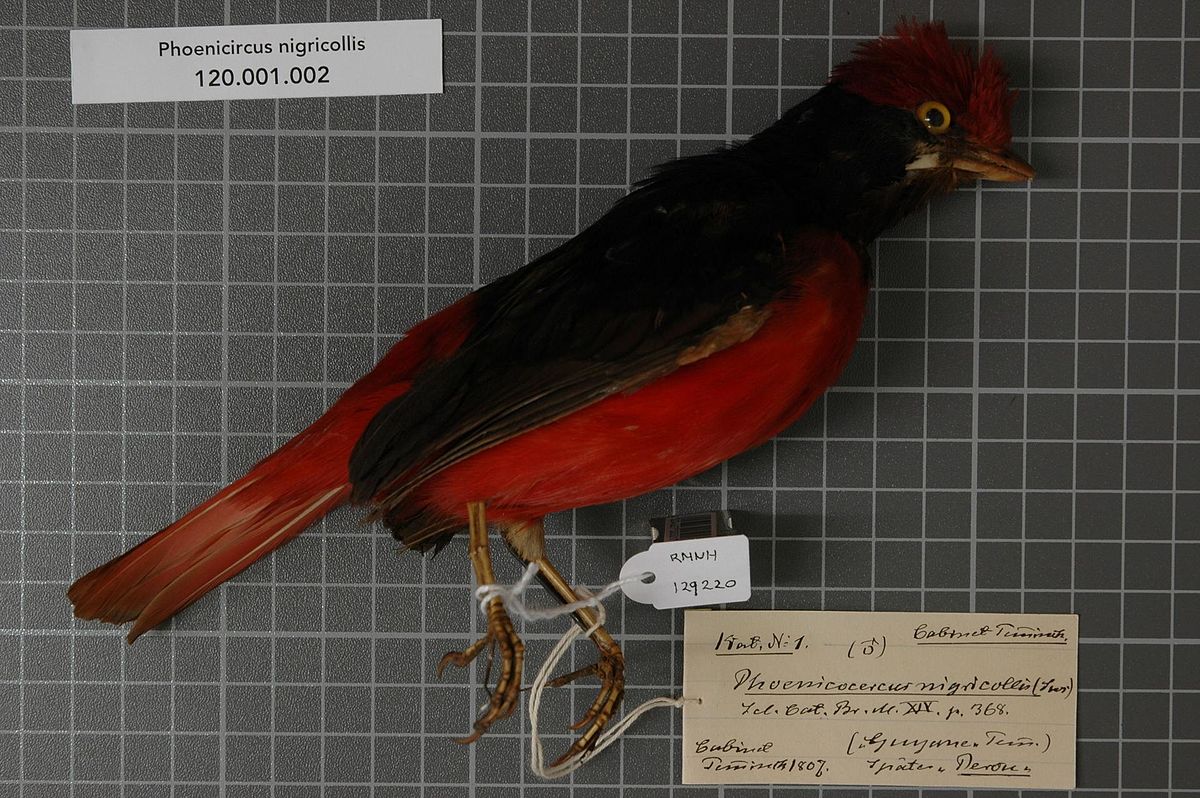
Wikipedia: Black-necked red-cotinga Source: OTHER
1200px-Naturalis_Biodiversity_Center_-_RMNH.AVES.129220_1_-_Phoenicircus_nigricollis_Swainson%2C_1832_-_Cotingidae_-_bird_skin_specimen.jpeg
![]() The black-necked red cotinga (Phoenicircus nigricollis) is a species of bird in the family Cotingidae, the cotingas.
[more]
The black-necked red cotinga (Phoenicircus nigricollis) is a species of bird in the family Cotingidae, the cotingas.
[more]
Barred fruiteater (Pipreola arcuata)
Profile Wikipedia eBird Xeno-Canto

Wikipedia: Barred fruiteater Source: OTHER
Pipreola_arcuata_%28male%29_-NW_Ecuador-4.jpg
![]() The barred fruiteater (Pipreola arcuata) is a species of bird in the family Cotingidae, found in Bolivia, Colombia, Ecuador, Peru, and Venezuela. Its natural habitat is subtropical or tropical moist montane forests. The population is stable, and they are considered common.[2]
[more]
The barred fruiteater (Pipreola arcuata) is a species of bird in the family Cotingidae, found in Bolivia, Colombia, Ecuador, Peru, and Venezuela. Its natural habitat is subtropical or tropical moist montane forests. The population is stable, and they are considered common.[2]
[more]
Black-chester fruiteater (Pipreola lubomirskii)
Green-and-black fruiteater / Goldbandkotinga (Pipreola riefferii)
Profile Wikipedia eBird Xeno-Canto

Wikipedia: Green-and-black fruiteater Source: OTHER
Green-and-black_Fruiteater_-_Colombia_S4E1819.jpg
![]() The green-and-black fruiteater (Pipreola riefferii) is a species of bird in the family Cotingidae. It is found in Colombia, Ecuador, Peru, and Venezuela, where its habitat is subtropical or tropical moist montane forests. Because of its range and population size this species is not classified as threatened.[2]
[more]
The green-and-black fruiteater (Pipreola riefferii) is a species of bird in the family Cotingidae. It is found in Colombia, Ecuador, Peru, and Venezuela, where its habitat is subtropical or tropical moist montane forests. Because of its range and population size this species is not classified as threatened.[2]
[more]
Orange-breasted fruiteater (Pipreola jucunda)
Profile Wikipedia eBird Xeno-Canto

Wikipedia: Orange-breasted fruiteater Source: OTHER
Orange-breasted_Fruiteater_-_Mindo_-_Ecuador_S4E5422.jpg
![]() The orange-breasted fruiteater (Pipreola jucunda) is a species of bird in the family Cotingidae native to Colombia and Ecuador. Its natural habitat is subtropical or tropical moist montane forests. It is a plump green bird about 18 centimetres (7 in) long. Males have a glossy black head and bib, an orange throat and yellow belly. Females lack the dark head and have green upper parts and green and yellow streaked underparts. Both sexes have orange beaks and greyish-green legs. This is a relatively common species with a wide range, and the International Union for Conservation of Nature has rated its conservation status as being of "least concern".
[more]
The orange-breasted fruiteater (Pipreola jucunda) is a species of bird in the family Cotingidae native to Colombia and Ecuador. Its natural habitat is subtropical or tropical moist montane forests. It is a plump green bird about 18 centimetres (7 in) long. Males have a glossy black head and bib, an orange throat and yellow belly. Females lack the dark head and have green upper parts and green and yellow streaked underparts. Both sexes have orange beaks and greyish-green legs. This is a relatively common species with a wide range, and the International Union for Conservation of Nature has rated its conservation status as being of "least concern".
[more]
Fiery-throated fruiteater (Pipreola chlorolepidota)
Profile Wikipedia eBird Xeno-Canto

Wikipedia: Fiery-throated fruiteater Source: OTHER
1200px-Pipreola_chlorolepidota_-_Fiery-throated_Fruiteater_-_male_%28cropped%29.jpg
![]() The fiery-throated fruiteater (Pipreola chlorolepidota) is a species of bird in the family Cotingidae. It is found in Colombia, Ecuador, and Peru where its natural habitats are subtropical or tropical moist lowland forests and subtropical or tropical moist montane forests. It is becoming rare due to habitat destruction of its rainforest habitat. Its population size and range are limited causing this species to be considered near threatened.
[more]
The fiery-throated fruiteater (Pipreola chlorolepidota) is a species of bird in the family Cotingidae. It is found in Colombia, Ecuador, and Peru where its natural habitats are subtropical or tropical moist lowland forests and subtropical or tropical moist montane forests. It is becoming rare due to habitat destruction of its rainforest habitat. Its population size and range are limited causing this species to be considered near threatened.
[more]
Scarlet-breasted fruiteater (Pipreola frontalis)
Profile Wikipedia eBird Xeno-Canto

Wikipedia: Scarlet-breasted fruiteater Source: OTHER
1200px-Pipreola_frontalis_squamipectus.jpg
![]() The scarlet-breasted fruiteater (Pipreola frontalis) is a species of bird in the family Cotingidae.
It is found in Bolivia, Ecuador, and Peru where its natural habitat is subtropical and tropical moist montane forests. Two subspecies are recognised though some researchers consider these should be regarded as distinct species. It is a plump green bird with a black head, the males having red throats and the females yellow. It is a relatively common species with a wide range, and the International Union for Conservation of Nature has rated its conservation status as being "least concern".
[more]
The scarlet-breasted fruiteater (Pipreola frontalis) is a species of bird in the family Cotingidae.
It is found in Bolivia, Ecuador, and Peru where its natural habitat is subtropical and tropical moist montane forests. Two subspecies are recognised though some researchers consider these should be regarded as distinct species. It is a plump green bird with a black head, the males having red throats and the females yellow. It is a relatively common species with a wide range, and the International Union for Conservation of Nature has rated its conservation status as being "least concern".
[more]
Purple-throated cotinga (Porphyrolaema porphyrolaema)
Profile Wikipedia eBird Xeno-Canto
Wikipedia: Purple-throated cotinga Source: OTHER
Porphyrolaema_porphyrolaema_-_Purple-throated_cotinga_%28male%29_01.JPG
![]() The purple-throated cotinga (Porphyrolaema porphyrolaema) is a species of bird in the cotinga family, Cotingidae. It is found in the western Amazon rainforest of South America; its range extends from southern Colombia south through eastern Ecuador and Peru and east through extreme northwestern Bolivia and into western Amazonian Brazil. It lives in the canopy or along the borders of humid forest throughout its range. The purple-throated cotinga is monotypic within the genus Porphyrolaema and has no known subspecies. It is one of the smaller cotinga species and expresses strong sexual dimorphism. Males have black upperparts with a bold white wingstripe and white edges to the tertial feathers and a white belly with some black barring on the rear flanks. The throat is a deep purple, giving the bird both its common and scientific names. Females are dark brown with pale buffy margins on the upperparts, buffy cinnamon with black barring on the underparts, and rufous on the throat. The male has a powerful voice.
[more]
The purple-throated cotinga (Porphyrolaema porphyrolaema) is a species of bird in the cotinga family, Cotingidae. It is found in the western Amazon rainforest of South America; its range extends from southern Colombia south through eastern Ecuador and Peru and east through extreme northwestern Bolivia and into western Amazonian Brazil. It lives in the canopy or along the borders of humid forest throughout its range. The purple-throated cotinga is monotypic within the genus Porphyrolaema and has no known subspecies. It is one of the smaller cotinga species and expresses strong sexual dimorphism. Males have black upperparts with a bold white wingstripe and white edges to the tertial feathers and a white belly with some black barring on the rear flanks. The throat is a deep purple, giving the bird both its common and scientific names. Females are dark brown with pale buffy margins on the upperparts, buffy cinnamon with black barring on the underparts, and rufous on the throat. The male has a powerful voice.
[more]
Red-ruffed fruitcrow (Pyroderus scutatus)
Profile Wikipedia eBird Xeno-Canto

Wikipedia: Red-ruffed fruitcrow Source: OTHER
Pyroderus_scutatus_-Intervales_State_Park%2C_Sao_Paulo%2C_Brazil-8.jpg
![]() The red-ruffed fruitcrow (Pyroderus scutatus) is a species of bird in the monotypic genus Pyroderus. It belongs to the family Cotingidae, and is one of the largest passerines in South America. Its common names in Spanish include yacutoro, toropisco montañero, sangretoro, pájaro torero, and cuervo-frutero de garganta roja. This species was first named Coracias scutata by Shaw in 1792, but was later changed to the current scientific name. This species has five subspecies P. s. scutatus (Shaw, 1792), P. s. orenocensis (Lafresnaye, 1846), P. s. granadensis (Lafresnaye, 1846), P. s. masoni (Ridgway, 1886), P. s. occidentalsis (Chapman, 1914).[1]
[more]
The red-ruffed fruitcrow (Pyroderus scutatus) is a species of bird in the monotypic genus Pyroderus. It belongs to the family Cotingidae, and is one of the largest passerines in South America. Its common names in Spanish include yacutoro, toropisco montañero, sangretoro, pájaro torero, and cuervo-frutero de garganta roja. This species was first named Coracias scutata by Shaw in 1792, but was later changed to the current scientific name. This species has five subspecies P. s. scutatus (Shaw, 1792), P. s. orenocensis (Lafresnaye, 1846), P. s. granadensis (Lafresnaye, 1846), P. s. masoni (Ridgway, 1886), P. s. occidentalsis (Chapman, 1914).[1]
[more]
Purple-throated fruitcrow (Querula purpurata)
Profile Wikipedia eBird Xeno-Canto

Wikipedia: Purple-throated fruitcrow Source: OTHER
1200px-Querula_purpurata_-_Purple-throated_Fruitcrow_%28male%29%3B_Parauapebas%2C_Par%C3%A1%2C_Brazil.jpg
![]() The purple-throated fruitcrow (Querula purpurata) is a species of bird in the family Cotingidae, the cotingas. It is the only species of the genus Querula.[2] It is native to Nicaragua, Costa Rica and Panama and most of the northern half of South America, its habitat being humid lowland forest where it feeds mainly on insects and fruit. It is a glossy black, medium-sized bird and the male has a purple-red throat patch. It nests in close vicinity with other birds of its species. Its population is in decline, but it is a common species with a very wide range, and the International Union for Conservation of Nature has assessed its conservation status as being of "least concern".
[more]
The purple-throated fruitcrow (Querula purpurata) is a species of bird in the family Cotingidae, the cotingas. It is the only species of the genus Querula.[2] It is native to Nicaragua, Costa Rica and Panama and most of the northern half of South America, its habitat being humid lowland forest where it feeds mainly on insects and fruit. It is a glossy black, medium-sized bird and the male has a purple-red throat patch. It nests in close vicinity with other birds of its species. Its population is in decline, but it is a common species with a very wide range, and the International Union for Conservation of Nature has assessed its conservation status as being of "least concern".
[more]
Pompadour cotinga (Xipholena punicea)
Profile Wikipedia eBird Xeno-Canto
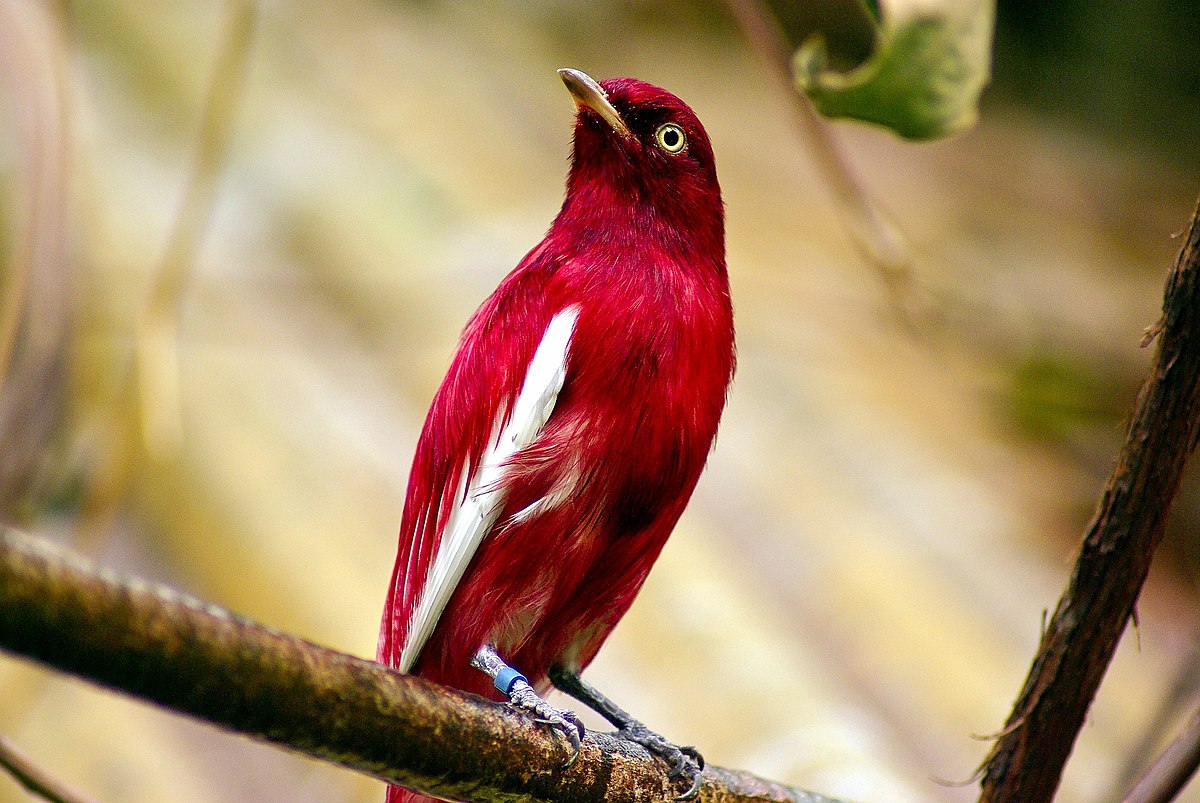
Wikipedia: Pompadour cotinga Source: OTHER
1200px-Perched_Pompadour_Cotinga.jpg
![]() The pompadour cotinga (Xipholena punicea) is a species of bird in the family Cotingidae. This species lives in the Amazonian rainforest and has a range that extends across the Amazon Basin and includes Peru, Brazil, Colombia, Venezuela, and the Guianas. The pompadour cotinga is primarily a frugivore but has been known to consume insects on occasion. This species of cotinga is distinct in that the males have a burgundy head and body, bright white wings, and yellow eyes. Like other members of the Cotingidae, this species is sexually dimorphic and the females have a pale grey head and body. Although there are not many documented observations of the nesting behavior of these birds, the males are known to perform elaborate mating displays for the females who then raise the young alone.
[more]
The pompadour cotinga (Xipholena punicea) is a species of bird in the family Cotingidae. This species lives in the Amazonian rainforest and has a range that extends across the Amazon Basin and includes Peru, Brazil, Colombia, Venezuela, and the Guianas. The pompadour cotinga is primarily a frugivore but has been known to consume insects on occasion. This species of cotinga is distinct in that the males have a burgundy head and body, bright white wings, and yellow eyes. Like other members of the Cotingidae, this species is sexually dimorphic and the females have a pale grey head and body. Although there are not many documented observations of the nesting behavior of these birds, the males are known to perform elaborate mating displays for the females who then raise the young alone.
[more]
Olivaceous piha (Snowornis cryptolophus)
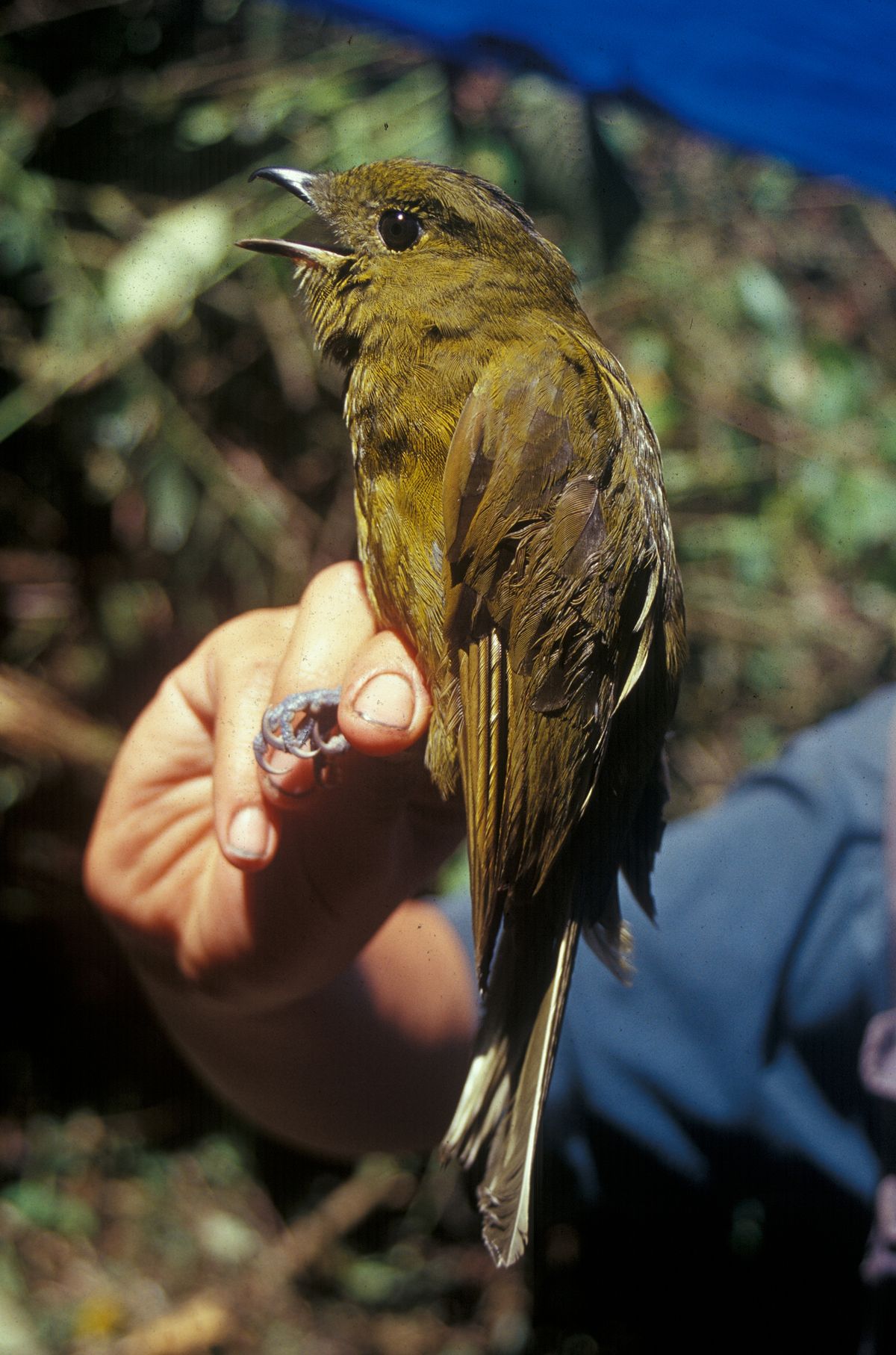
Wikipedia: Olivaceous piha Source: OTHER
1200px-Snowornis_cryptolophus_-NBII_Image_Gallery-2003.jpg
![]() The olivaceous piha (Snowornis cryptolophus) is a species of bird in the family Cotingidae. It is found in Colombia, Ecuador, and Peru. In regard to population density and range this species is not considered vulnerable.[2]
[more]
The olivaceous piha (Snowornis cryptolophus) is a species of bird in the family Cotingidae. It is found in Colombia, Ecuador, and Peru. In regard to population density and range this species is not considered vulnerable.[2]
[more]
Grey-tailed piha (Snowornis subalaris)

Wikipedia: Grey-tailed piha Source: OTHER
1200px-LipaugusSubalarisSmit.jpg
![]() The grey-tailed piha (Snowornis subalaris) is a species of bird in the family Cotingidae. It is found in Colombia, Ecuador and Peru where its natural habitat is subtropical or tropical moist montane forests.
[more]
The grey-tailed piha (Snowornis subalaris) is a species of bird in the family Cotingidae. It is found in Colombia, Ecuador and Peru where its natural habitat is subtropical or tropical moist montane forests.
[more]
Mouse-colored thistletail (Asthenes griseomurina)

Wikipedia: Mouse-colored thistletail Source: OTHER
Mouse-colored_Thistletail_-_South_Ecuador_S4E2287_%2816129504574%29.jpg
![]() The mouse-colored thistletail (Asthenes griseomurina) is a species of bird in the family Furnariidae. It is found in Ecuador and Peru.
[more]
The mouse-colored thistletail (Asthenes griseomurina) is a species of bird in the family Furnariidae. It is found in Ecuador and Peru.
[more]
White-chinned thistletail (Asthenes fuliginosa)

Wikipedia: White-chinned thistletail Source: OTHER
White-chinned_Thistletail_-_Ecuador_S4E4517.jpg
![]() The white-chinned thistletail or "colicardo barbiblanco" (Asthenes fuliginosa) is a species of bird in the family Furnariidae. It is found in Colombia, Ecuador, Peru, and Venezuela. Its natural habitats are subtropical or tropical moist montane forests and subtropical or tropical high-altitude grassland.
[more]
The white-chinned thistletail or "colicardo barbiblanco" (Asthenes fuliginosa) is a species of bird in the family Furnariidae. It is found in Colombia, Ecuador, Peru, and Venezuela. Its natural habitats are subtropical or tropical moist montane forests and subtropical or tropical high-altitude grassland.
[more]
Many-striped canastero (Asthenes flammulata)
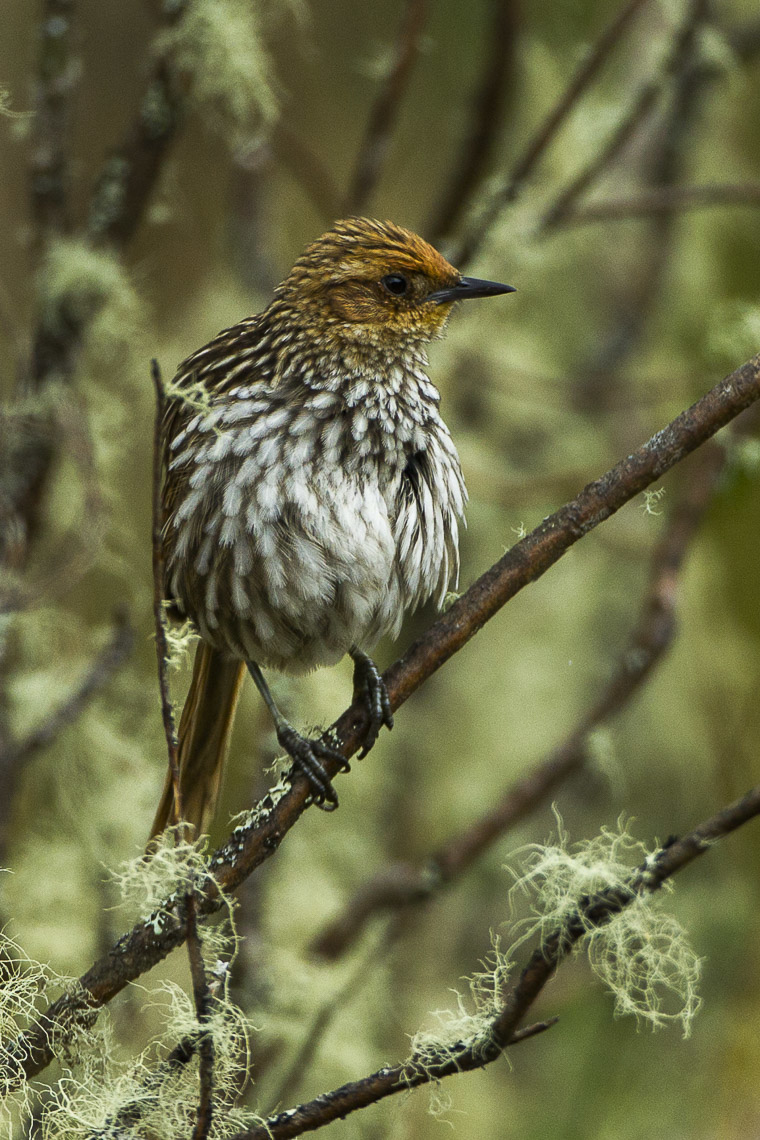
Wikipedia: Many-striped canastero Source: OTHER
Many-striped_Canastero_-_Colombia_S4E1138.jpg
![]() The many-striped canastero (Asthenes flammulata) is a species of bird in the family Furnariidae.
[more]
The many-striped canastero (Asthenes flammulata) is a species of bird in the family Furnariidae.
[more]
Streak-backed canastero (Asthenes wyatti)

Wikipedia: Streak-backed canastero Source: OTHER
Asthenes_wyatti_-_Streak-backed_Canastero%3B_Junin_Lake%2C_Peru_%28cropped%29.jpg
![]() The streak-backed canastero (Asthenes wyatti) is a species of bird in the family Furnariidae. It is found in Bolivia, Colombia, Ecuador, Peru, and Venezuela. Its natural habitat is subtropical or tropical high-altitude grassland. Seven subspecies are recognized:
[more]
The streak-backed canastero (Asthenes wyatti) is a species of bird in the family Furnariidae. It is found in Bolivia, Colombia, Ecuador, Peru, and Venezuela. Its natural habitat is subtropical or tropical high-altitude grassland. Seven subspecies are recognized:
[more]
Plain softtail (Thripophaga fusciceps)
Profile Wikipedia eBird Xeno-Canto

Wikipedia: Plain softtail Source: OTHER
Thripophaga_fusciceps_77344453_%28cropped%29.jpg
![]() The plain softtail (Thripophaga fusciceps) is a species of bird in the family Furnariidae. It is found in Bolivia, Brazil, Ecuador, and Peru. Its natural habitats are subtropical or tropical dry forest, subtropical or tropical moist lowland forest, and subtropical or tropical swamps.
[more]
The plain softtail (Thripophaga fusciceps) is a species of bird in the family Furnariidae. It is found in Bolivia, Brazil, Ecuador, and Peru. Its natural habitats are subtropical or tropical dry forest, subtropical or tropical moist lowland forest, and subtropical or tropical swamps.
[more]
Pale-legged hornero (Furnarius leucopus)
Profile Wikipedia eBird Xeno-Canto

Wikipedia: Pale-legged hornero Source: OTHER
Furnarius_leucopus_cinnamomeus-20090110.jpg
![]() The pale-legged hornero (Furnarius leucopus) is a species of bird in the family Furnariidae. It includes the Pacific hornero (F. leucopus cinnamomeus) and the Caribbean hornero (F. leucopus longirostris), which often are considered separate species.
[more]
The pale-legged hornero (Furnarius leucopus) is a species of bird in the family Furnariidae. It includes the Pacific hornero (F. leucopus cinnamomeus) and the Caribbean hornero (F. leucopus longirostris), which often are considered separate species.
[more]
Lesser hornero (Furnarius minor)
Profile Wikipedia eBird Xeno-Canto

Wikipedia: Lesser hornero Source: OTHER
Furnarius_minor_-_Lesser_Hornero.jpg
![]() The lesser hornero (Furnarius minor) is a species of bird in the ovenbird family Furnariidae. It is closely related to the Pale-legged hornero, and their global distribution overlaps somewhat. This species is monotypic, meaning there is only one subspecies.[2]
[more]
The lesser hornero (Furnarius minor) is a species of bird in the ovenbird family Furnariidae. It is closely related to the Pale-legged hornero, and their global distribution overlaps somewhat. This species is monotypic, meaning there is only one subspecies.[2]
[more]
Red-faced spinetail (Cranioleuca erythrops)
Profile Wikipedia eBird Xeno-Canto
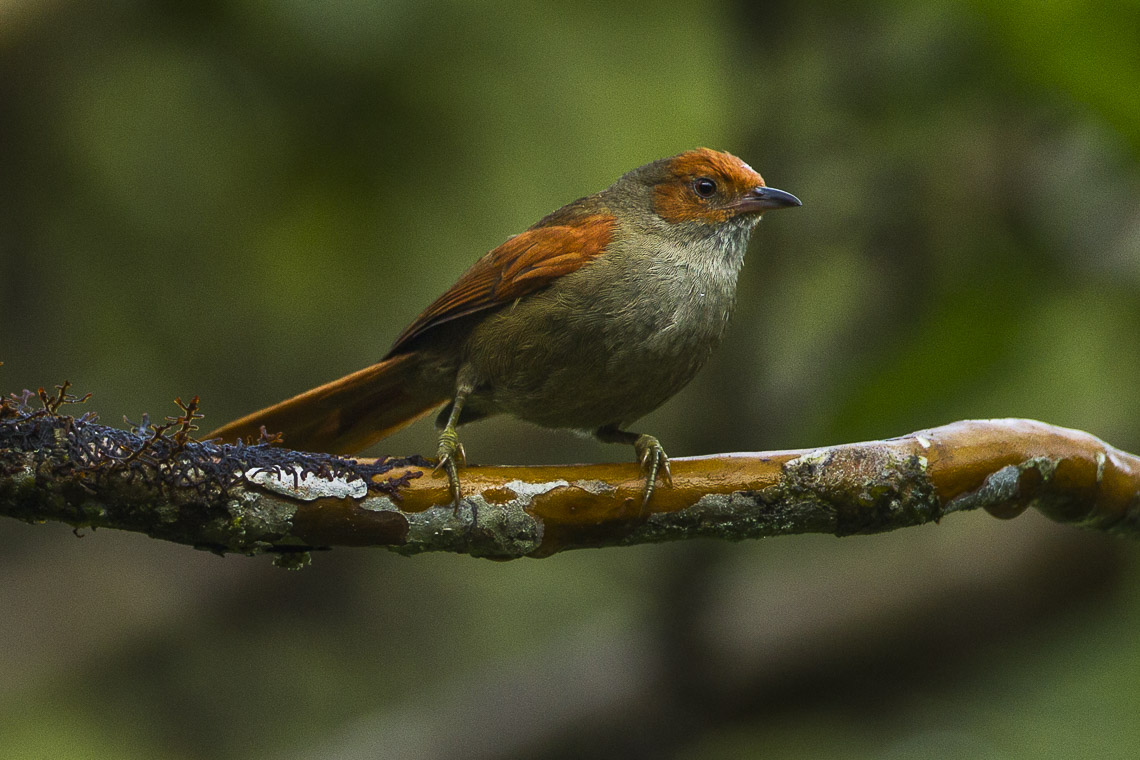
Wikipedia: Red-faced spinetail Source: OTHER
Red-faced_Spinetail_-_Colombia_S4E4386.jpg
![]() The red-faced spinetail (Cranioleuca erythrops) is a species of bird in the family Furnariidae. It is found in Colombia, Costa Rica, Ecuador, and Panama. Its natural habitat is subtropical or tropical moist montane forest.
[more]
The red-faced spinetail (Cranioleuca erythrops) is a species of bird in the family Furnariidae. It is found in Colombia, Costa Rica, Ecuador, and Panama. Its natural habitat is subtropical or tropical moist montane forest.
[more]
Parker's spinetail (Cranioleuca vulpecula)

Wikipedia: Parker's spinetail Source: OTHER
Cranioleuca_vulpecula_-_Parker%27s_spinetail%3B_Marchantaria_island%2C_Iranduba%2C_Amazonas%2C_Brazil.jpg
![]() Parker's spinetail (Cranioleuca vulpecula) or the white-breasted spinetail, is a species of bird in the family Furnariidae. It is found in Bolivia, Brazil, Ecuador, and Peru.
[more]
Parker's spinetail (Cranioleuca vulpecula) or the white-breasted spinetail, is a species of bird in the family Furnariidae. It is found in Bolivia, Brazil, Ecuador, and Peru.
[more]
Ash-browed spinetail (Cranioleuca curtata)
Profile Wikipedia eBird Xeno-Canto

Wikipedia: Ash-browed spinetail Source: OTHER
1200px-Cranioleuca_curtata_-_Ash-browed_Spinetail.jpg
![]() The ash-browed spinetail (Cranioleuca curtata) is a species of bird in the family Furnariidae. It is found in Bolivia, Colombia, Ecuador, and Peru. Its natural habitat is subtropical or tropical moist montane forest.
[more]
The ash-browed spinetail (Cranioleuca curtata) is a species of bird in the family Furnariidae. It is found in Bolivia, Colombia, Ecuador, and Peru. Its natural habitat is subtropical or tropical moist montane forest.
[more]
Speckled spinetail (Cranioleuca gutturata)
Profile Wikipedia eBird Xeno-Canto
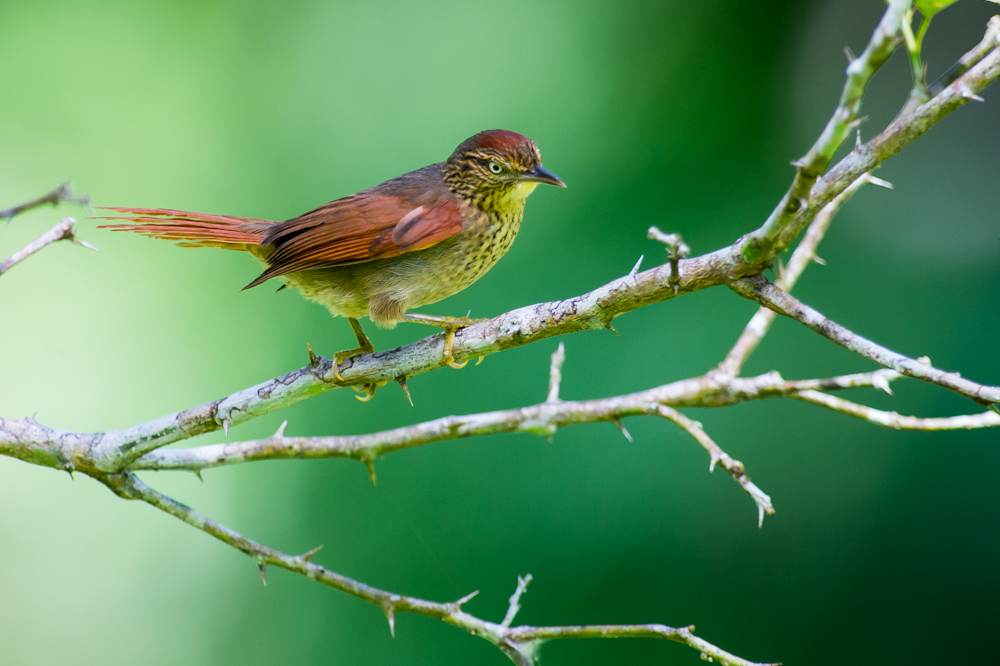
Wikipedia: Speckled spinetail Source: OTHER
Cranioleuca_gutturata%2C_Speckled_Spinetail.jpg
![]() The speckled spinetail (Cranioleuca gutturata) is a species of bird in the family Furnariidae. It is found in Bolivia, Brazil, Colombia, Ecuador, French Guiana, Peru, Suriname, and Venezuela. Its natural habitats are subtropical or tropical moist lowland forests and subtropical or tropical swamps.
[more]
The speckled spinetail (Cranioleuca gutturata) is a species of bird in the family Furnariidae. It is found in Bolivia, Brazil, Colombia, Ecuador, French Guiana, Peru, Suriname, and Venezuela. Its natural habitats are subtropical or tropical moist lowland forests and subtropical or tropical swamps.
[more]
Line-cheeked spinetail (Cranioleuca antisiensis)
Profile Wikipedia eBird Xeno-Canto

Wikipedia: Line-cheeked spinetail Source: OTHER
1200px-Cranioleuca_antisiensis_antisiensis_-_Line-cheeked_Spinetail.jpg
![]() The line-cheeked spinetail (Cranioleuca antisiensis) is an arboreal species of bird in the ovenbird family Furnariidae. It is a common species in the Andes in Ecuador and Peru. Its natural habitat is subtropical or tropical moist montane forests, woodland and scrub. It is distinguished from other species by its distribution, behaviour and white supercilium. There are two recognized subspecies, which are in reality a gradient in morphology and plumage from one extreme to the other.
[more]
The line-cheeked spinetail (Cranioleuca antisiensis) is an arboreal species of bird in the ovenbird family Furnariidae. It is a common species in the Andes in Ecuador and Peru. Its natural habitat is subtropical or tropical moist montane forests, woodland and scrub. It is distinguished from other species by its distribution, behaviour and white supercilium. There are two recognized subspecies, which are in reality a gradient in morphology and plumage from one extreme to the other.
[more]
White-browed spinetail (Hellmayrea gularis)
Profile Wikipedia eBird Xeno-Canto

Wikipedia: White-browed spinetail Source: OTHER
1200px-Hellmayrea_gularis_-_White-browed_Spinetail_-_Ecuador.jpg
![]() The white-browed spinetail (Hellmayrea gularis) is a species of bird in the family Furnariidae. It is the only member of the genus Hellmayrea.
[more]
The white-browed spinetail (Hellmayrea gularis) is a species of bird in the family Furnariidae. It is the only member of the genus Hellmayrea.
[more]
Slaty spinetail (Synallaxis brachyura)
Profile Wikipedia eBird Xeno-Canto

Wikipedia: Slaty spinetail Source: OTHER
Slaty_Spinetail_-_Colombia_S4E0885.jpg
![]() The slaty spinetail or slaty castlebuilder, (Synallaxis brachyura), is a passerine bird which breeds in the tropical New World from northern Honduras to western Ecuador and east-central Brazil.
[more]
The slaty spinetail or slaty castlebuilder, (Synallaxis brachyura), is a passerine bird which breeds in the tropical New World from northern Honduras to western Ecuador and east-central Brazil.
[more]
Rufous spinetail (Synallaxis unirufa)
Profile Wikipedia eBird Xeno-Canto

Wikipedia: Rufous spinetail Source: OTHER
1200px-Synallaxis_unirufa.jpg
![]() The rufous spinetail (Synallaxis unirufa) is a species of bird in the family Furnariidae. It is found in Colombia, Ecuador, Peru, and Venezuela. Its natural habitat is subtropical or tropical moist montane forests.
[more]
The rufous spinetail (Synallaxis unirufa) is a species of bird in the family Furnariidae. It is found in Colombia, Ecuador, Peru, and Venezuela. Its natural habitat is subtropical or tropical moist montane forests.
[more]
Chestnut-throated spinetail (Synallaxis cherriei)
Profile Wikipedia eBird Xeno-Canto

Wikipedia: Chestnut-throated spinetail Source: OTHER
Synallaxis_cherriei_-_Chestnut-throated_spinetail.jpg
![]() The chestnut-throated spinetail (Synallaxis cherriei) is a species of bird in the family Furnariidae. It is mainly found in the eastern Amazon Basin, with small numbers in Colombia, Ecuador, and Peru.
[more]
The chestnut-throated spinetail (Synallaxis cherriei) is a species of bird in the family Furnariidae. It is mainly found in the eastern Amazon Basin, with small numbers in Colombia, Ecuador, and Peru.
[more]
Plain-crowned spinetail (Synallaxis gujanensis)
Profile Wikipedia eBird Xeno-Canto
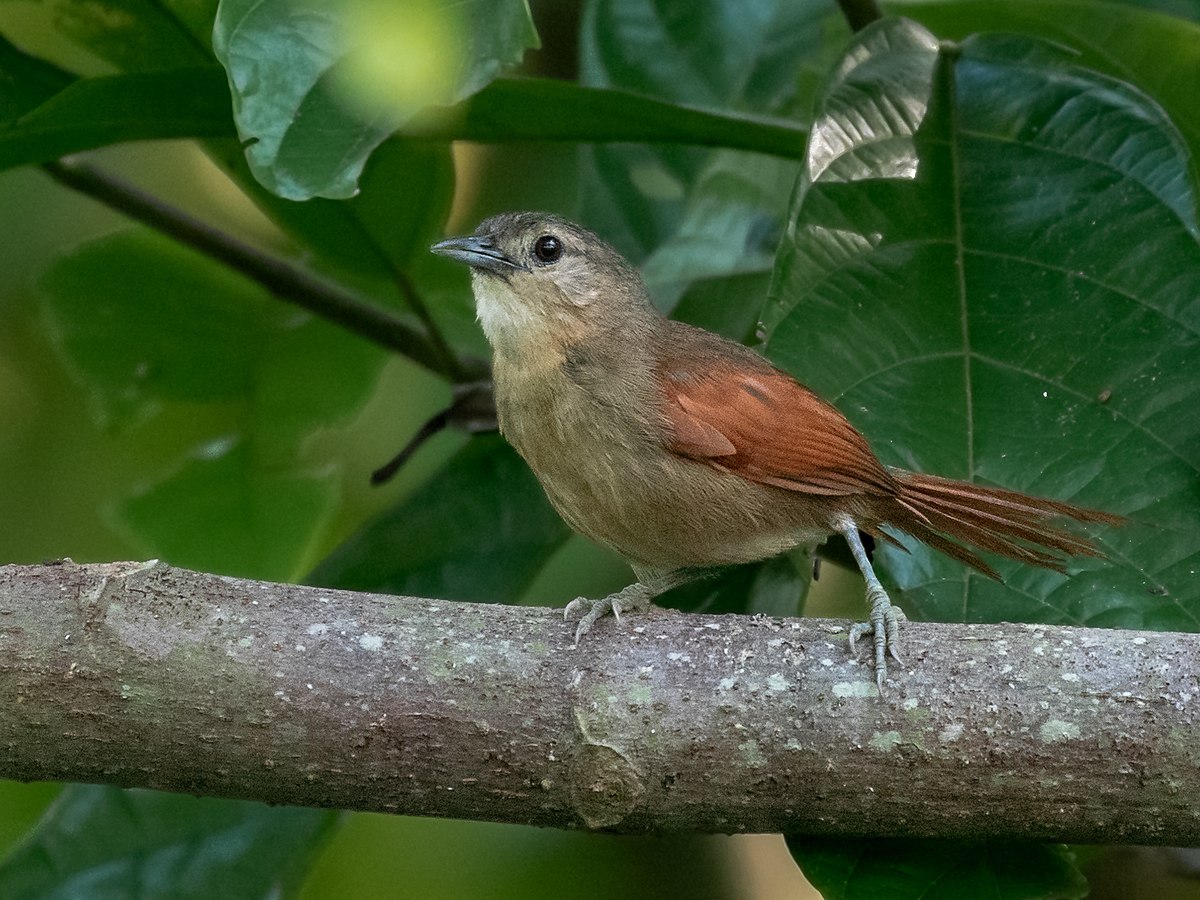
Wikipedia: Plain-crowned spinetail Source: OTHER
1200px-Synallaxis_gujanensis_-_Plain-crowned_Spinetail%3B_Amazon_river_island%2C_Itacoatiara%2C_Amazonas%2C_Brazil.jpg
![]() The plain-crowned spinetail (Synallaxis gujanensis) is a species of bird in the family Furnariidae. It is found in Bolivia, Brazil, Colombia, Ecuador, French Guiana, Guyana, Paraguay, Peru, Suriname, and Venezuela. Its natural habitats are subtropical or tropical moist lowland forests and heavily degraded former forest.
[more]
The plain-crowned spinetail (Synallaxis gujanensis) is a species of bird in the family Furnariidae. It is found in Bolivia, Brazil, Colombia, Ecuador, French Guiana, Guyana, Paraguay, Peru, Suriname, and Venezuela. Its natural habitats are subtropical or tropical moist lowland forests and heavily degraded former forest.
[more]
Dark-breasted spinetail (Synallaxis albigularis)
Profile Wikipedia eBird Xeno-Canto
Wikipedia: Dark-breasted spinetail Source: OTHER
Synallaxis_albigularis_-_Dark-breasted_Spinetail.JPG
![]() The dark-breasted spinetail (Synallaxis albigularis) is a species of bird in the family Furnariidae. It is found in Bolivia, Brazil, Colombia, Ecuador, and Peru. Its natural habitats are subtropical or tropical moist shrubland and heavily degraded former forest.
[more]
The dark-breasted spinetail (Synallaxis albigularis) is a species of bird in the family Furnariidae. It is found in Bolivia, Brazil, Colombia, Ecuador, and Peru. Its natural habitats are subtropical or tropical moist shrubland and heavily degraded former forest.
[more]
Blackish-headed spinetail (Synallaxis tithys)
Profile Wikipedia eBird Xeno-Canto

Wikipedia: Blackish-headed spinetail Source: OTHER
1200px-Synallaxis_tithys_-_Blackish-headed_Spinetail.jpg
![]() The blackish-headed spinetail (Synallaxis tithys) is a species of bird in the family Furnariidae. It is found in Ecuador and Peru. Its natural habitats are subtropical or tropical dry forests, subtropical or tropical moist lowland forests, and pastureland. It is threatened by habitat loss.
[more]
The blackish-headed spinetail (Synallaxis tithys) is a species of bird in the family Furnariidae. It is found in Ecuador and Peru. Its natural habitats are subtropical or tropical dry forests, subtropical or tropical moist lowland forests, and pastureland. It is threatened by habitat loss.
[more]
White-bellied spinetail (Mazaria propinqua)

Wikipedia: White-bellied spinetail Source: OTHER
1200px-Mazaria_propinqua_-_White-bellied_Spinetail%3B_Marchantaria_Island%2C_Iranduba%2C_Amazonas%2C_Brazil.jpg
![]() The white-bellied spinetail (Mazaria propinqua) is a species of bird in the family Furnariidae. It is found in river islands of the western Amazon Basin. Its natural habitat is subtropical or tropical moist shrubland.
[more]
The white-bellied spinetail (Mazaria propinqua) is a species of bird in the family Furnariidae. It is found in river islands of the western Amazon Basin. Its natural habitat is subtropical or tropical moist shrubland.
[more]
Azara's spinetail (Synallaxis azarae)
Profile Wikipedia eBird Xeno-Canto

Wikipedia: Azara's spinetail Source: OTHER
1200px-Synallaxis_azarae_76608368.jpg
![]() Azara's spinetail (Synallaxis azarae) is a species of bird in the family Furnariidae, named after Spanish naturalist Félix de Azara.[2]
[more]
Azara's spinetail (Synallaxis azarae) is a species of bird in the family Furnariidae, named after Spanish naturalist Félix de Azara.[2]
[more]
Marañon spinetail (Synallaxis maranonica)
Profile Wikipedia eBird Xeno-Canto

Wikipedia: Marañon spinetail Source: OTHER
1200px-Synallaxis_maranonica_map.svg.png
![]() The Marañón spinetail (Synallaxis maranonica) is a species of bird in the family Furnariidae. It is found in Ecuador and Peru. Its natural habitats are subtropical or tropical dry forests, subtropical or tropical moist lowland forests, and subtropical or tropical dry shrubland. It is threatened by habitat loss.
[more]
The Marañón spinetail (Synallaxis maranonica) is a species of bird in the family Furnariidae. It is found in Ecuador and Peru. Its natural habitats are subtropical or tropical dry forests, subtropical or tropical moist lowland forests, and subtropical or tropical dry shrubland. It is threatened by habitat loss.
[more]
Necklaced spinetail (Synallaxis stictothorax)
Profile Wikipedia eBird Xeno-Canto

Wikipedia: Necklaced spinetail Source: OTHER
1200px-Synallaxis_stictothorax_stictothorax_-_Necklaced_Spinetail.jpg
![]() The necklaced spinetail (Synallaxis stictothorax) is a species of ovenbird in the family Furnariidae. Found in Ecuador and Peru, its natural habitat is subtropical or tropical dry shrubland.
[more]
The necklaced spinetail (Synallaxis stictothorax) is a species of ovenbird in the family Furnariidae. Found in Ecuador and Peru, its natural habitat is subtropical or tropical dry shrubland.
[more]
Ruddy spinetail (Synallaxis rutilans)
Profile Wikipedia eBird Xeno-Canto

Wikipedia: Ruddy spinetail Source: OTHER
1200px-Synallaxis_rutilans_-_Ruddy_spinetail%2C_Pte._Figueiredo%2C_Amazonas%2C_Brazil.jpg
![]() The ruddy spinetail (Synallaxis rutilans) is a species of bird in the family Furnariidae. It is found in Bolivia, Brazil, Colombia, Ecuador, French Guiana, Guyana, Peru, Suriname, and Venezuela. Its natural habitat is subtropical or tropical moist lowland forests.
[more]
The ruddy spinetail (Synallaxis rutilans) is a species of bird in the family Furnariidae. It is found in Bolivia, Brazil, Colombia, Ecuador, French Guiana, Guyana, Peru, Suriname, and Venezuela. Its natural habitat is subtropical or tropical moist lowland forests.
[more]
Dusky spinetail (Synallaxis moesta)
Profile Wikipedia eBird Xeno-Canto

Wikipedia: Dusky spinetail Source: OTHER
1200px-Synallaxis_moesta_map.svg.png
![]() The dusky spinetail (Synallaxis moesta) is a species of bird in the family Furnariidae. It is found in Colombia, Ecuador, and Peru. Its natural habitats are subtropical or tropical moist lowland forests and heavily degraded former forest.
[more]
The dusky spinetail (Synallaxis moesta) is a species of bird in the family Furnariidae. It is found in Colombia, Ecuador, and Peru. Its natural habitats are subtropical or tropical moist lowland forests and heavily degraded former forest.
[more]
Wedge-billed woodcreeper (Glyphorynchus spirurus)
Profile Wikipedia eBird Xeno-Canto

Wikipedia: Wedge-billed woodcreeper Source: OTHER
Glyphorynchus_spirurus_-NW_Ecuador-8.jpg
![]() The wedge-billed woodcreeper (Glyphorynchus spirurus), is a passerine bird which breeds in the tropical New World from southern Mexico to northern Bolivia, central Brazil and the Guianas; it is absent from the Pacific coastal areas except between Costa Rica and Ecuador. It is the only member of the genus Glyphorynchus.
[more]
The wedge-billed woodcreeper (Glyphorynchus spirurus), is a passerine bird which breeds in the tropical New World from southern Mexico to northern Bolivia, central Brazil and the Guianas; it is absent from the Pacific coastal areas except between Costa Rica and Ecuador. It is the only member of the genus Glyphorynchus.
[more]
Sharp-tailed streamcreeper (Lochmias nematura)
Profile Wikipedia eBird Xeno-Canto

Wikipedia: Sharp-tailed streamcreeper Source: OTHER
Lochmias_nematura_-Parque_Estadual_da_Serra_da_Cantareira%2C_Sao_Paulo%2C_Brazil-8.jpg
![]() The sharp-tailed streamcreeper (Lochmias nematura) is a passerine bird of South America belonging to the family Furnariidae, the ovenbirds. It is the only member of the genus Lochmias. The species is also known as the streamside streamcreeper.[2]
[more]
The sharp-tailed streamcreeper (Lochmias nematura) is a passerine bird of South America belonging to the family Furnariidae, the ovenbirds. It is the only member of the genus Lochmias. The species is also known as the streamside streamcreeper.[2]
[more]
Flammulated treehunter (Thripadectes flammulatus)
Profile Wikipedia eBird Xeno-Canto

Wikipedia: Flammulated treehunter Source: OTHER
1200px-Thripadectes_flammulatus_-NBII_Image_Gallery-a00252.jpg
![]() The flammulated treehunter (Thripadectes flammulatus) is a species of bird in the family Furnariidae. It is found in Colombia, Ecuador, Peru, and Venezuela. Its natural habitat is subtropical or tropical moist montane forest.
[more]
The flammulated treehunter (Thripadectes flammulatus) is a species of bird in the family Furnariidae. It is found in Colombia, Ecuador, Peru, and Venezuela. Its natural habitat is subtropical or tropical moist montane forest.
[more]
Striped treehunter (Thripadectes holostictus)
Profile Wikipedia eBird Xeno-Canto

Wikipedia: Striped treehunter Source: OTHER
1200px-Striped_Treehunter_Side_Shot.png
![]() The striped treehunter (Thripadectes holostictus) is a species of bird in the family Furnariidae with a dusky-brown coloring with prominent buff streaking on the wings, throat, and breast. It is found in humid to wet montane forest that range locally in the Andes from west Venezuela to west Bolivia (Bolivia, Colombia, Ecuador, Peru, and Venezuela) most often at elevations of 1500–2500 m. It is most often mistaken for and with the larger flammulated treehunter due to many physical and behavioral similarities.
[more]
The striped treehunter (Thripadectes holostictus) is a species of bird in the family Furnariidae with a dusky-brown coloring with prominent buff streaking on the wings, throat, and breast. It is found in humid to wet montane forest that range locally in the Andes from west Venezuela to west Bolivia (Bolivia, Colombia, Ecuador, Peru, and Venezuela) most often at elevations of 1500–2500 m. It is most often mistaken for and with the larger flammulated treehunter due to many physical and behavioral similarities.
[more]
Uniform treehunter (Thripadectes ignobilis)
Profile Wikipedia eBird Xeno-Canto

Wikipedia: Uniform treehunter Source: OTHER
1200px-Thripadectes_ignobilis_-_Uniform_treehunter%3B_Cerro_Montezuma%2C_Risaralda%2C_Colombia.jpg
![]() \
The uniform treehunter (Thripadectes ignobilis) is a species of bird in the family Furnariidae. It is found in Colombia and Ecuador.
[more]
\
The uniform treehunter (Thripadectes ignobilis) is a species of bird in the family Furnariidae. It is found in Colombia and Ecuador.
[more]
Streak-capped treehunter (Thripadectes virgaticeps)
Profile Wikipedia eBird Xeno-Canto

Wikipedia: Streak-capped treehunter Source: OTHER
Streak-capped_Treehunter_%28Thripadectes_virgaticeps%29_%288079775965%29.jpg
![]() The streak-capped treehunter (Thripadectes virgaticeps) is a species of bird in the family Furnariidae.
[more]
The streak-capped treehunter (Thripadectes virgaticeps) is a species of bird in the family Furnariidae.
[more]
Black-billed treehunter (Thripadectes melanorhynchus)
Profile Wikipedia eBird Xeno-Canto

Wikipedia: Black-billed treehunter Source: OTHER
1200px-Thripadectes_melanorhynchus_-_Black-billed_Treehunter.jpg
![]() The black-billed treehunter (Thripadectes melanorhynchus) is a species of bird in the family Furnariidae. It is found in Colombia, Ecuador, and Peru. Its natural habitat is subtropical or tropical moist montane forest.
[more]
The black-billed treehunter (Thripadectes melanorhynchus) is a species of bird in the family Furnariidae. It is found in Colombia, Ecuador, and Peru. Its natural habitat is subtropical or tropical moist montane forest.
[more]
Slaty-winged foliage-gleaner (Philydor fuscipenne)
Profile Wikipedia eBird Xeno-Canto

Wikipedia: Slaty-winged foliage-gleaner Source: OTHER
1200px-PhilydorErythronotusSmit_cleaned.png
![]() The slaty-winged foliage-gleaner (Philydor fuscipenne) is a perching bird species in the ovenbird family (Furnariidae).
[more]
The slaty-winged foliage-gleaner (Philydor fuscipenne) is a perching bird species in the ovenbird family (Furnariidae).
[more]
Cinnamon-rumped foliage-gleaner (Philydor pyrrhodes)
Profile Wikipedia eBird Xeno-Canto

Wikipedia: Cinnamon-rumped foliage-gleaner Source: OTHER
1200px-Naturalis_Biodiversity_Center_-_RMNH.AVES.37961_1_-_Philydor_pyrrhodes_%28Cabanis%2C_1848%29_-_Furnariidae_-_bird_skin_specimen.jpeg
![]() The cinnamon-rumped foliage-gleaner (Philydor pyrrhodes) is a species of bird in the family Furnariidae.
It is found in Bolivia, Brazil, Colombia, Ecuador, French Guiana, Guyana, Peru, Suriname, and Venezuela.
Its natural habitats are subtropical or tropical moist lowland forest and subtropical or tropical swampland.
[more]
The cinnamon-rumped foliage-gleaner (Philydor pyrrhodes) is a species of bird in the family Furnariidae.
It is found in Bolivia, Brazil, Colombia, Ecuador, French Guiana, Guyana, Peru, Suriname, and Venezuela.
Its natural habitats are subtropical or tropical moist lowland forest and subtropical or tropical swampland.
[more]
Rufous-rumped foliage-gleaner / Rostbürzel-Blattspäher (Philydor erythrocercum)

Wikipedia: Rufous-rumped foliage-gleaner Source: OTHER
1200px-Philydor_erythrocercum_-_Rufous-rumped_Foliage-gleaner.jpg
![]() The rufous-rumped foliage-gleaner (Philydor erythrocercum) is a species of bird in the family Furnariidae.
It is found in Bolivia, Brazil, Colombia, Ecuador, French Guiana, Guyana, Peru, and Suriname.
Its natural habitats are subtropical or tropical moist lowland forest and subtropical or tropical moist montane forest.
[more]
The rufous-rumped foliage-gleaner (Philydor erythrocercum) is a species of bird in the family Furnariidae.
It is found in Bolivia, Brazil, Colombia, Ecuador, French Guiana, Guyana, Peru, and Suriname.
Its natural habitats are subtropical or tropical moist lowland forest and subtropical or tropical moist montane forest.
[more]
Fulvous-dotted treerunner (Margarornis stellatus)
Profile Wikipedia eBird Xeno-Canto

Wikipedia: Fulvous-dotted treerunner Source: OTHER
Fulvous-dotted_Treerunner_-_Colombia_S4E9530.jpg
![]() The star-chested treerunner or fulvous-dotted treerunner (Margarornis stellatus) is a species of bird in the family Furnariidae. It is found in Colombia and Ecuador.
[more]
The star-chested treerunner or fulvous-dotted treerunner (Margarornis stellatus) is a species of bird in the family Furnariidae. It is found in Colombia and Ecuador.
[more]
Pearled treerunner (Margarornis squamiger)
Profile Wikipedia eBird Xeno-Canto

Wikipedia: Pearled treerunner Source: OTHER
1200px-Margarornis_squamiger_68812121.jpg
![]() The pearled treerunner (Margarornis squamiger) is a species of bird in the family Furnariidae.
[more]
The pearled treerunner (Margarornis squamiger) is a species of bird in the family Furnariidae.
[more]
Scaly-throated leaftosser (Sclerurus guatemalensis)
Profile Wikipedia eBird Xeno-Canto
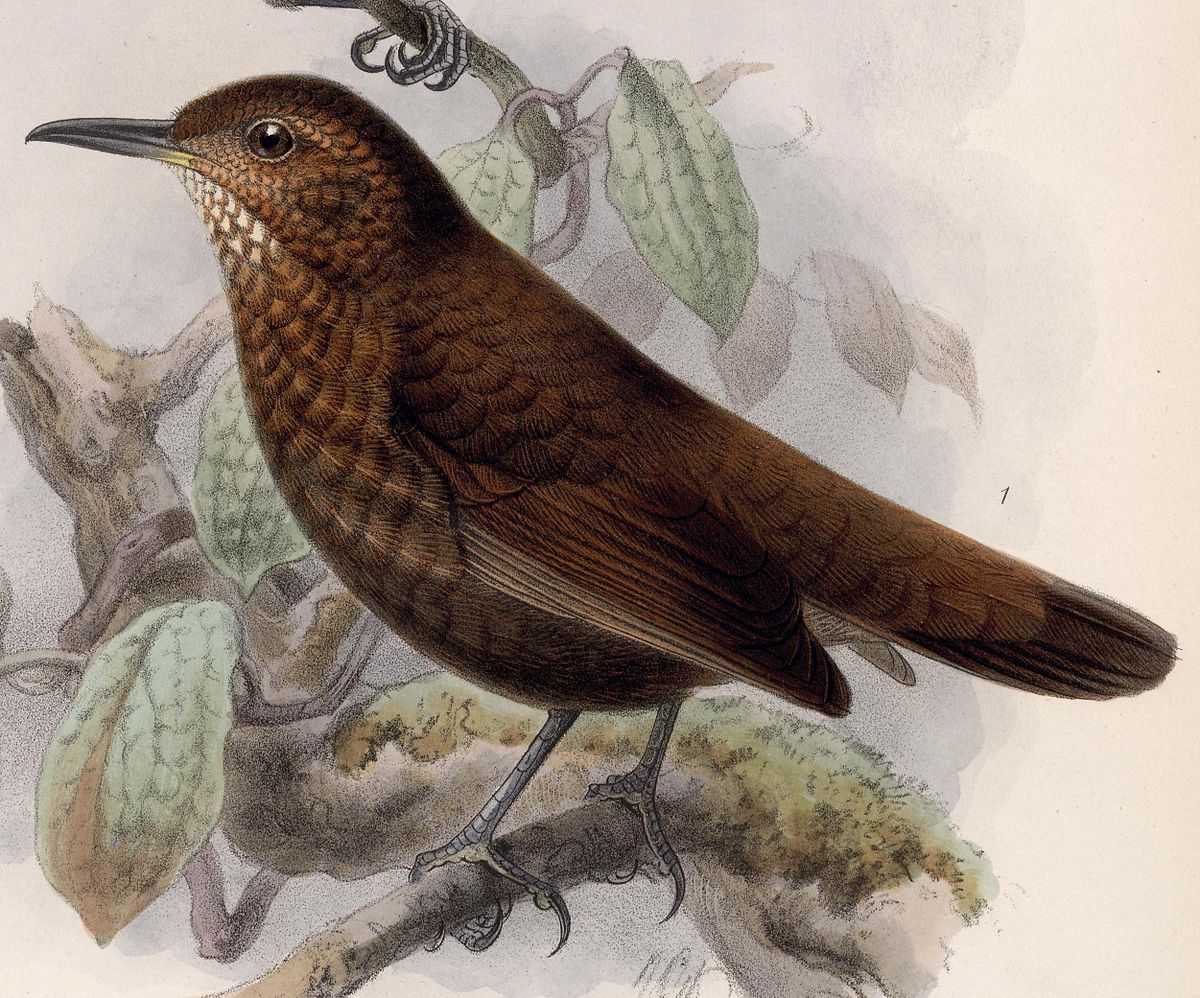
Wikipedia: Scaly-throated leaftosser Source: OTHER
1200px-Sclerurus_guatemalensis_1902.jpg
![]() The scaly-throated leaftosser (Sclerurus guatemalensis) is a species of bird in the family Furnariidae. It is found in Belize, Colombia, Costa Rica, Ecuador, Guatemala, Honduras, Mexico, Nicaragua, and Panama. Its natural habitats are subtropical or tropical moist lowland forest and subtropical or tropical moist montane forest.
[more]
The scaly-throated leaftosser (Sclerurus guatemalensis) is a species of bird in the family Furnariidae. It is found in Belize, Colombia, Costa Rica, Ecuador, Guatemala, Honduras, Mexico, Nicaragua, and Panama. Its natural habitats are subtropical or tropical moist lowland forest and subtropical or tropical moist montane forest.
[more]
Gray-throated leaftosser (Sclerurus albigularis)
Profile Wikipedia eBird Xeno-Canto

Wikipedia: Gray-throated leaftosser Source: OTHER
1200px-Gray_throated_leaftosser.jpg
![]() The grey-throated leaftosser (Sclerurus albigularis) is a species of bird in the family Furnariidae. It is found in Bolivia, Brazil, Colombia, Costa Rica, Ecuador, Panama, Peru, Trinidad and Tobago, and Venezuela. Its natural habitats are subtropical or tropical moist lowland forest and subtropical or tropical moist montane forest.
[more]
The grey-throated leaftosser (Sclerurus albigularis) is a species of bird in the family Furnariidae. It is found in Bolivia, Brazil, Colombia, Costa Rica, Ecuador, Panama, Peru, Trinidad and Tobago, and Venezuela. Its natural habitats are subtropical or tropical moist lowland forest and subtropical or tropical moist montane forest.
[more]
Short-billed leaftosser (Sclerurus rufigularis)
Profile Wikipedia eBird Xeno-Canto

Wikipedia: Short-billed leaftosser Source: OTHER
1200px-Sclerurus_rufigularis.jpg
![]() The short-billed leaftosser (Sclerurus rufigularis) is a species of bird in the family Furnariidae. It is found in Bolivia, Brazil, Colombia, Ecuador, French Guiana, Guyana, Peru, Suriname, and Venezuela. Its natural habitat is subtropical or tropical moist lowland forests.
[more]
The short-billed leaftosser (Sclerurus rufigularis) is a species of bird in the family Furnariidae. It is found in Bolivia, Brazil, Colombia, Ecuador, French Guiana, Guyana, Peru, Suriname, and Venezuela. Its natural habitat is subtropical or tropical moist lowland forests.
[more]
Black-tailed leaftosser (Sclerurus caudacutus)
Profile Wikipedia eBird Xeno-Canto

Wikipedia: Black-tailed leaftosser Source: OTHER
1200px-Naturalis_Biodiversity_Center_-_RMNH.AVES.72605_1_-_Sclerurus_caudacutus_caudacutus_%28Vieillot%2C_1816%29_-_Furnariidae_-_bird_skin_specimen.jpeg
![]() The black-tailed leaftosser (Sclerurus caudacutus) is a species of bird in the family Furnariidae. It is found in Bolivia, Brazil, Colombia, Ecuador, French Guiana, Guyana, Peru, Suriname, and Venezuela.
Its natural habitat is tropical moist lowland forests.
[more]
The black-tailed leaftosser (Sclerurus caudacutus) is a species of bird in the family Furnariidae. It is found in Bolivia, Brazil, Colombia, Ecuador, French Guiana, Guyana, Peru, Suriname, and Venezuela.
Its natural habitat is tropical moist lowland forests.
[more]
South American leaftosser (Sclerurus obscurior)
Profile Wikipedia eBird Xeno-Canto

Wikipedia: South American leaftosser Source: OTHER
Tawny-throated_Leaftosser.jpg
![]() The tawny-throated leaftosser (Sclerurus mexicanus) is a tropical American bird species in the ovenbird family Furnariidae. It is also known as the tawny-throated leafscraper, Mexican leaftosser or Mexican leafscraper. This bird might be a cryptic species complex.[2]
[more]
The tawny-throated leaftosser (Sclerurus mexicanus) is a tropical American bird species in the ovenbird family Furnariidae. It is also known as the tawny-throated leafscraper, Mexican leaftosser or Mexican leafscraper. This bird might be a cryptic species complex.[2]
[more]
Long-billed woodcreeper (Nasica longirostris)
Profile Wikipedia eBird Xeno-Canto

Wikipedia: Long-billed woodcreeper Source: OTHER
Nasica_longirostris_-_Long-billed_Woodcreeper.jpg
![]() The long-billed woodcreeper (Nasica longirostris) is a species of bird in the subfamily Dendrocolaptinae of the woodcreepers. It is the only species in the monotypic genus Nasica.[2]
[more]
The long-billed woodcreeper (Nasica longirostris) is a species of bird in the subfamily Dendrocolaptinae of the woodcreepers. It is the only species in the monotypic genus Nasica.[2]
[more]
Bar-bellied woodcreeper (Hylexetastes stresemanni)
Profile Wikipedia eBird Xeno-Canto

Wikipedia: Bar-bellied woodcreeper Source: OTHER
1200px-Hylexetastes_stresemanni_map.svg.png
![]() The bar-bellied woodcreeper (Hylexetastes stresemanni) is a species of bird in the Dendrocolaptinae subfamily.
It is found in humid forest of the western Amazon in northern Bolivia, far western Brazil, eastern Peru, southeastern Colombia, and, as recently confirmed, eastern Ecuador.
[more]
The bar-bellied woodcreeper (Hylexetastes stresemanni) is a species of bird in the Dendrocolaptinae subfamily.
It is found in humid forest of the western Amazon in northern Bolivia, far western Brazil, eastern Peru, southeastern Colombia, and, as recently confirmed, eastern Ecuador.
[more]
Cinnamon-throated woodcreeper (Dendrexetastes rufigula)
Profile Wikipedia eBird Xeno-Canto
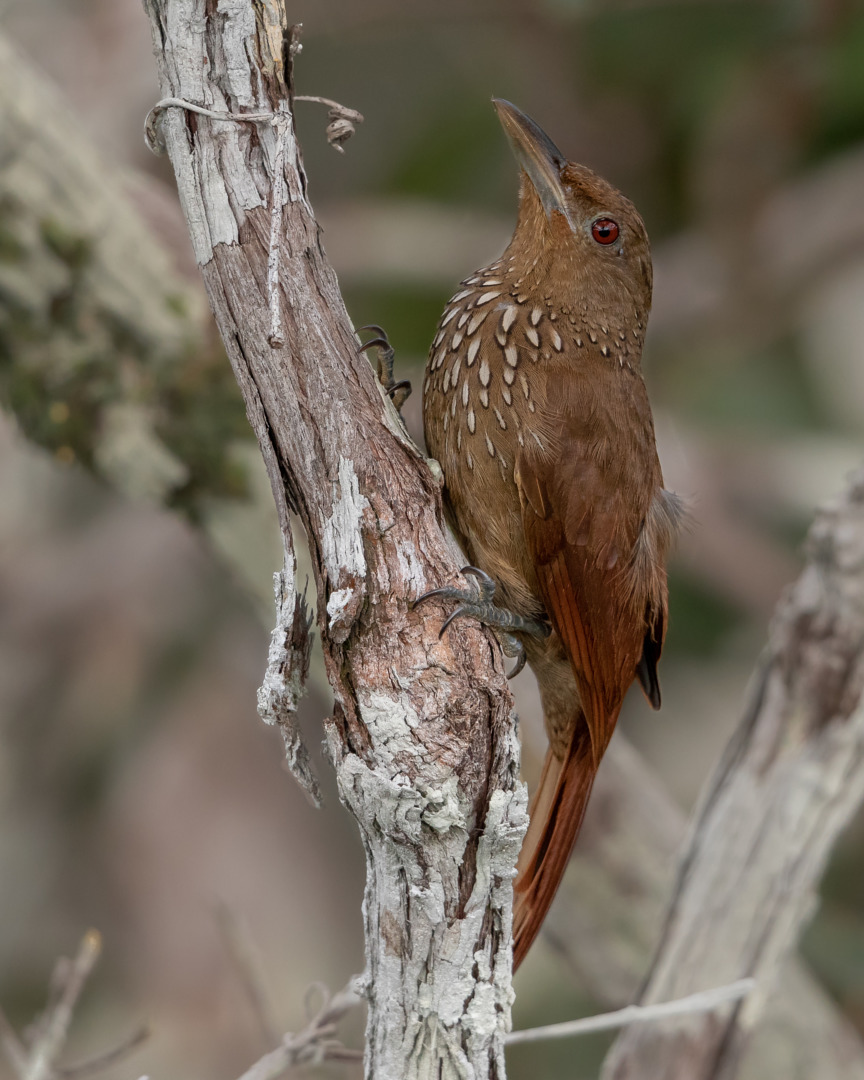
Wikipedia: Cinnamon-throated woodcreeper Source: OTHER
Dendexetastes_rufigula_-_Cinnamon-throated_Woodcreeper%3B_Manaus%2C_Amazonas%2C_Brazil.jpg
![]() The cinnamon-throated woodcreeper (Dendrexetastes rufigula) is a species of bird in the Dendrocolaptinae subfamily of the ovenbird family (Furnariidae). It makes up the monotypic genus Dendrexetastes.[2]
[more]
The cinnamon-throated woodcreeper (Dendrexetastes rufigula) is a species of bird in the Dendrocolaptinae subfamily of the ovenbird family (Furnariidae). It makes up the monotypic genus Dendrexetastes.[2]
[more]
Striped woodhaunter (Automolus subulatus)
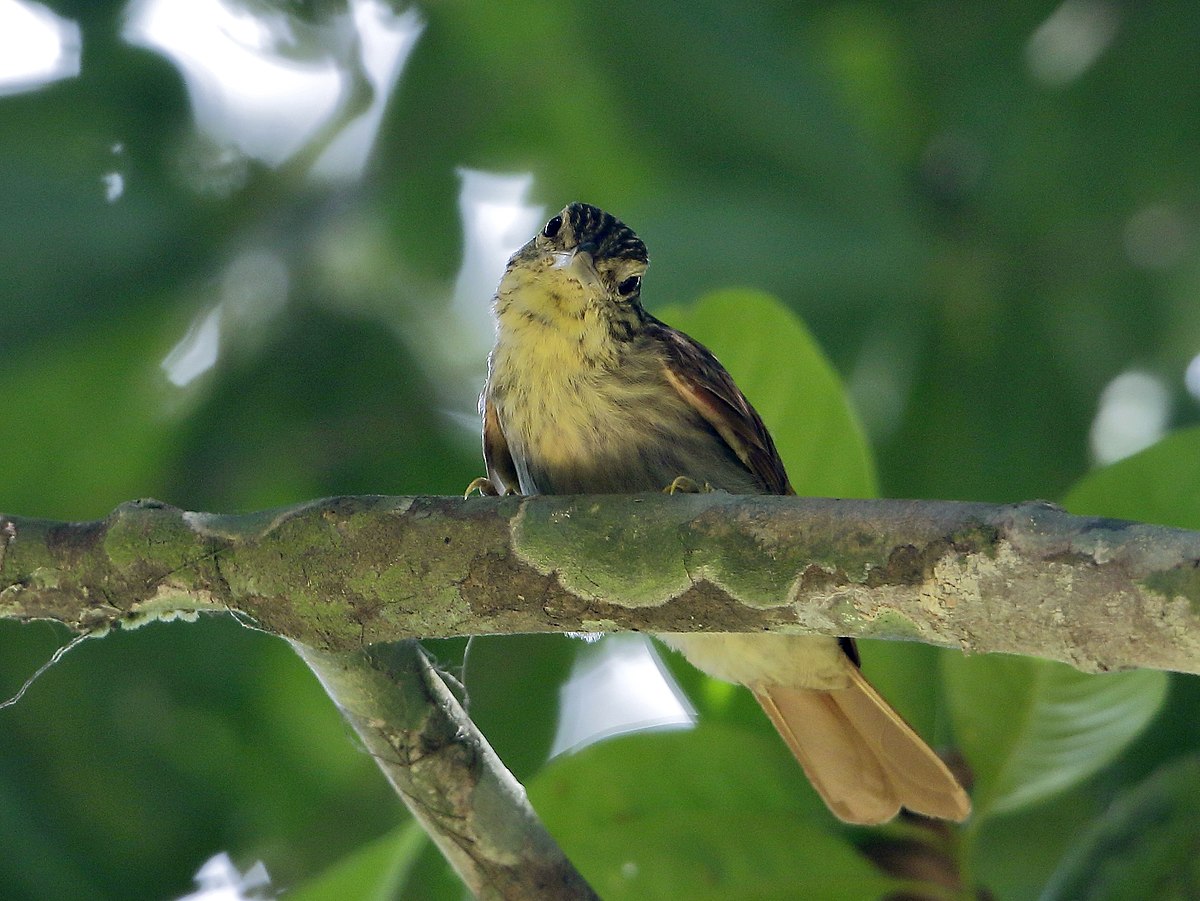
Wikipedia: Striped woodhaunter Source: OTHER
1200px-Automolus_subulatus_-_Striped_woodhunter%3B_Xapuri%2C_Acre%2C_Brazil.jpg
![]() The eastern woodhaunter (Automolus subulatus), also known as the Amazonian woodhaunter, is a species of bird in the family Furnariidae. It was formerly treated as conspecific with the western woodhaunter and when lumped had the name "striped woodhaunter". It is found in the western part of the Amazon rainforest: west Brazil, southeast Colombia, east Ecuador, northeast Peru, south Venezuela and north Bolivia. Its natural habitats are subtropical or tropical moist lowland forests and subtropical or tropical moist montane forests. The species nests in earth tunnels.[3]
[more]
The eastern woodhaunter (Automolus subulatus), also known as the Amazonian woodhaunter, is a species of bird in the family Furnariidae. It was formerly treated as conspecific with the western woodhaunter and when lumped had the name "striped woodhaunter". It is found in the western part of the Amazon rainforest: west Brazil, southeast Colombia, east Ecuador, northeast Peru, south Venezuela and north Bolivia. Its natural habitats are subtropical or tropical moist lowland forests and subtropical or tropical moist montane forests. The species nests in earth tunnels.[3]
[more]
Buff-throated foliage-gleaner (Automolus ochrolaemus)

Wikipedia: Buff-throated foliage-gleaner Source: OTHER
Buff-throated_Foliage-gleaner_%28Automolus_ochrolaemus%29_in_Costa_Rica.jpg
![]() The buff-throated foliage-gleaner (Automolus ochrolaemus) is a species of bird in the family Furnariidae.
[more]
The buff-throated foliage-gleaner (Automolus ochrolaemus) is a species of bird in the family Furnariidae.
[more]
Olive-backed foliage-gleaner (Automolus infuscatus)

Wikipedia: Olive-backed foliage-gleaner Source: OTHER
1200px-Naturalis_Biodiversity_Center_-_RMNH.AVES.72517_1_-_Automolus_infuscatus_cervicalis_%28Sclater%2C_1889_-_Furnariidae_-_bird_skin_specimen.jpeg
![]() The olive-backed foliage-gleaner (Automolus infuscatus) is a species of bird in the family Furnariidae. It is found in humid forest of most of the Amazon Basin, except in the southeastern part, where the Para foliage-gleaner is found. The two are closely related and were considered conspecific until recently.
[more]
The olive-backed foliage-gleaner (Automolus infuscatus) is a species of bird in the family Furnariidae. It is found in humid forest of most of the Amazon Basin, except in the southeastern part, where the Para foliage-gleaner is found. The two are closely related and were considered conspecific until recently.
[more]
Chestnut-crowned foliage-gleaner (Automolus rufipileatus)
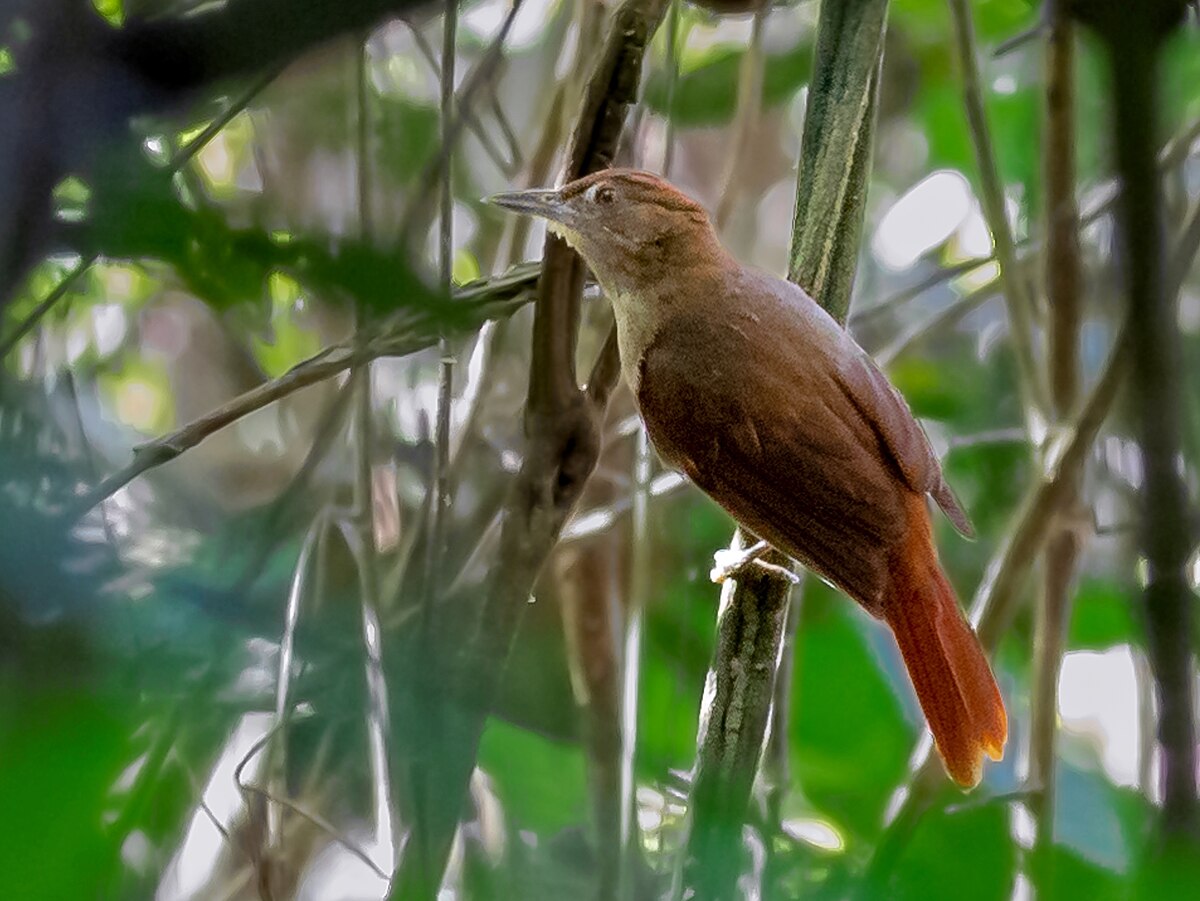
Wikipedia: Chestnut-crowned foliage-gleaner Source: OTHER
1200px-Automolus_rufipileatus_-_Chestnut-crowned_Foliage-gleaner_%2C_Carajas_National_Forest%2C_Par%C3%A1%2C_Brazil.jpg
![]() The chestnut-crowned foliage-gleaner (Automolus rufipileatus) is a species of bird in the family Furnariidae.
[more]
The chestnut-crowned foliage-gleaner (Automolus rufipileatus) is a species of bird in the family Furnariidae.
[more]
Brown-rumped foliage-gleaner (Automolus melanopezus)

Wikipedia: Brown-rumped foliage-gleaner Source: OTHER
1200px-Automolus_melanopezus_-_Brown-rumped_Foliage-gleaner.jpg
![]() The brown-rumped foliage-gleaner (Automolus melanopezus) is a species of bird in the family Furnariidae.
It is found in the western Amazon Basin (mainly Peru, Ecuador and western Brazil).
Its natural habitats are subtropical or tropical moist lowland forest and subtropical or tropical swampland.
[more]
The brown-rumped foliage-gleaner (Automolus melanopezus) is a species of bird in the family Furnariidae.
It is found in the western Amazon Basin (mainly Peru, Ecuador and western Brazil).
Its natural habitats are subtropical or tropical moist lowland forest and subtropical or tropical swampland.
[more]
Streaked xenops (Xenops rutilans)
Profile Wikipedia eBird Xeno-Canto

Wikipedia: Streaked xenops Source: OTHER
Xenops_rutilans_-Piraju%2C_Sao_Paulo%2C_Brazil-8.jpg
![]() The streaked xenops (Xenops rutilans) is a passerine bird which breeds in the tropical New World from Costa Rica and Trinidad south to Bolivia and northern Argentina. Like the closely related true woodcreepers, it is a member of the South American bird family Furnariidae.
[more]
The streaked xenops (Xenops rutilans) is a passerine bird which breeds in the tropical New World from Costa Rica and Trinidad south to Bolivia and northern Argentina. Like the closely related true woodcreepers, it is a member of the South American bird family Furnariidae.
[more]
Plain xenops (Xenops minutus)
Profile Wikipedia eBird Xeno-Canto

Wikipedia: Plain xenops Source: OTHER
1200px-Xenops_minutus_-_Plain_xenops%3B_Restinga_de_Bertioga_State_Park%2C_S%C3%A3o_Paulo%2C_Brazil.jpg
![]() The plain xenops (Xenops minutus) is a passerine bird which breeds in moist lowland forests in the tropical New World from southern Mexico south to western Ecuador, northeastern Argentina and central Brazil.
[more]
The plain xenops (Xenops minutus) is a passerine bird which breeds in moist lowland forests in the tropical New World from southern Mexico south to western Ecuador, northeastern Argentina and central Brazil.
[more]
Rufous-tailed xenops (Microxenops milleri)
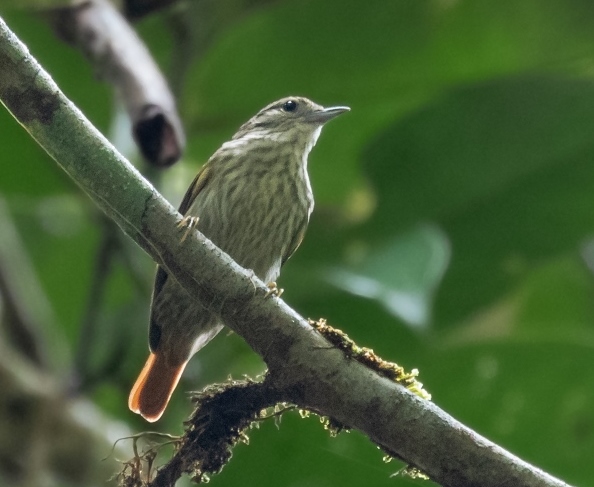
Wikipedia: Rufous-tailed xenops Source: OTHER
Microxenops_milleri_-_Rufous-tailed_Xenops%3B_Manacapuru%2C_Amazonas%2C_Brazil.jpg
![]() The rufous-tailed xenops (Microxenops milleri) is a species of bird in the family Furnariidae. It is found in Bolivia, Brazil, Colombia, Ecuador, French Guiana, Peru, Suriname, and Venezuela.
[more]
The rufous-tailed xenops (Microxenops milleri) is a species of bird in the family Furnariidae. It is found in Bolivia, Brazil, Colombia, Ecuador, French Guiana, Peru, Suriname, and Venezuela.
[more]
Slender-billed xenops (Xenops tenuirostris)
Profile Wikipedia eBird Xeno-Canto

Wikipedia: Slender-billed xenops Source: OTHER
1200px-Naturalis_Biodiversity_Center_-_RMNH.AVES.27983_1_-_Xenops_tenuirostris_hellmayri_Todd%2C_1925_-_Furnariidae_-_bird_skin_specimen.jpeg
![]() The slender-billed xenops (Xenops tenuirostris) is a species of bird in the family Furnariidae. It is found in Bolivia, Brazil, Colombia, Ecuador, French Guiana, Guyana, Peru, Suriname, and Venezuela. Its natural habitats are subtropical or tropical moist lowland forest and subtropical or tropical swampland.
[more]
The slender-billed xenops (Xenops tenuirostris) is a species of bird in the family Furnariidae. It is found in Bolivia, Brazil, Colombia, Ecuador, French Guiana, Guyana, Peru, Suriname, and Venezuela. Its natural habitats are subtropical or tropical moist lowland forest and subtropical or tropical swampland.
[more]
Slender-billed miner (Geositta tenuirostris)
Profile Wikipedia eBird Xeno-Canto
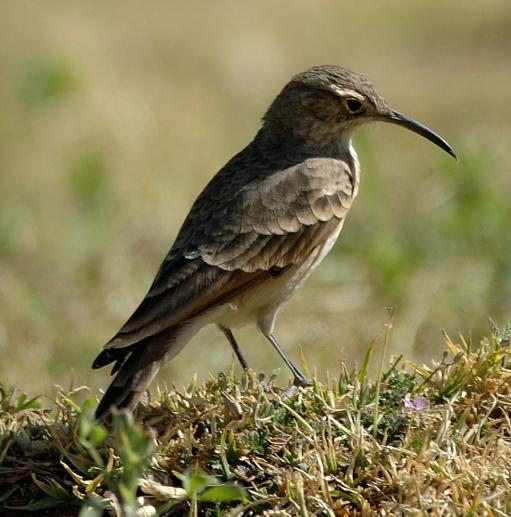
Wikipedia: Slender-billed miner Source: OTHER
Geositta_tenuirostris_1.jpg
![]() The slender-billed miner (Geositta tenuirostris) is a species of bird in the family Furnariidae. It is found in Argentina, Bolivia, Chile, Ecuador, and Peru. Its natural habitats are subtropical or tropical high-altitude grassland and pastureland.
[more]
The slender-billed miner (Geositta tenuirostris) is a species of bird in the family Furnariidae. It is found in Argentina, Bolivia, Chile, Ecuador, and Peru. Its natural habitats are subtropical or tropical high-altitude grassland and pastureland.
[more]
Chestnut-winged cinclodes (Cinclodes albidiventris)

Wikipedia: Chestnut-winged cinclodes Source: OTHER
Bar-winged_Cincloides_-_South-Ecuador_S4E3112.jpg
![]() The chestnut-winged cinclodes (Cinclodes albidiventris) is a species of bird in the family Furnariidae. It is found in Colombia, Venezuela, Ecuador, and Peru. It was formerly considered a subspecies of the bar-winged cinclodes. Its natural habitats are subtropical or tropical high-altitude shrubland and grassland.
[more]
The chestnut-winged cinclodes (Cinclodes albidiventris) is a species of bird in the family Furnariidae. It is found in Colombia, Venezuela, Ecuador, and Peru. It was formerly considered a subspecies of the bar-winged cinclodes. Its natural habitats are subtropical or tropical high-altitude shrubland and grassland.
[more]
Stout-billed cinclodes (Cinclodes excelsior)
Profile Wikipedia eBird Xeno-Canto
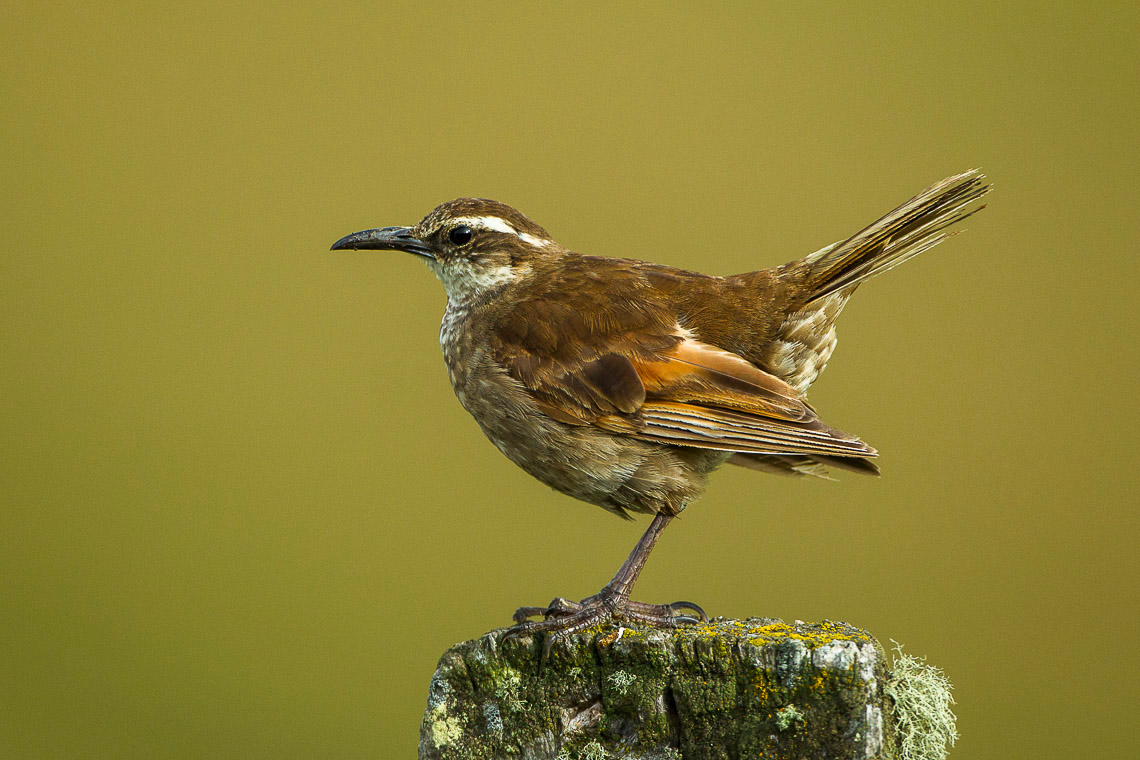
Wikipedia: Stout-billed cinclodes Source: OTHER
Stout-billed_Cinclodes_-_Colombia_S4E0981.jpg
![]() The stout-billed cinclodes (Cinclodes excelsior) is a species of bird in the family Furnariidae. It is found in Colombia, Ecuador, and Peru. Its natural habitats are subtropical or tropical high-altitude shrubland and subtropical or tropical high-altitude grassland.
[more]
The stout-billed cinclodes (Cinclodes excelsior) is a species of bird in the family Furnariidae. It is found in Colombia, Ecuador, and Peru. Its natural habitats are subtropical or tropical high-altitude shrubland and subtropical or tropical high-altitude grassland.
[more]
Andean tit-spinetail (Leptasthenura andicola)
Profile Wikipedia eBird Xeno-Canto
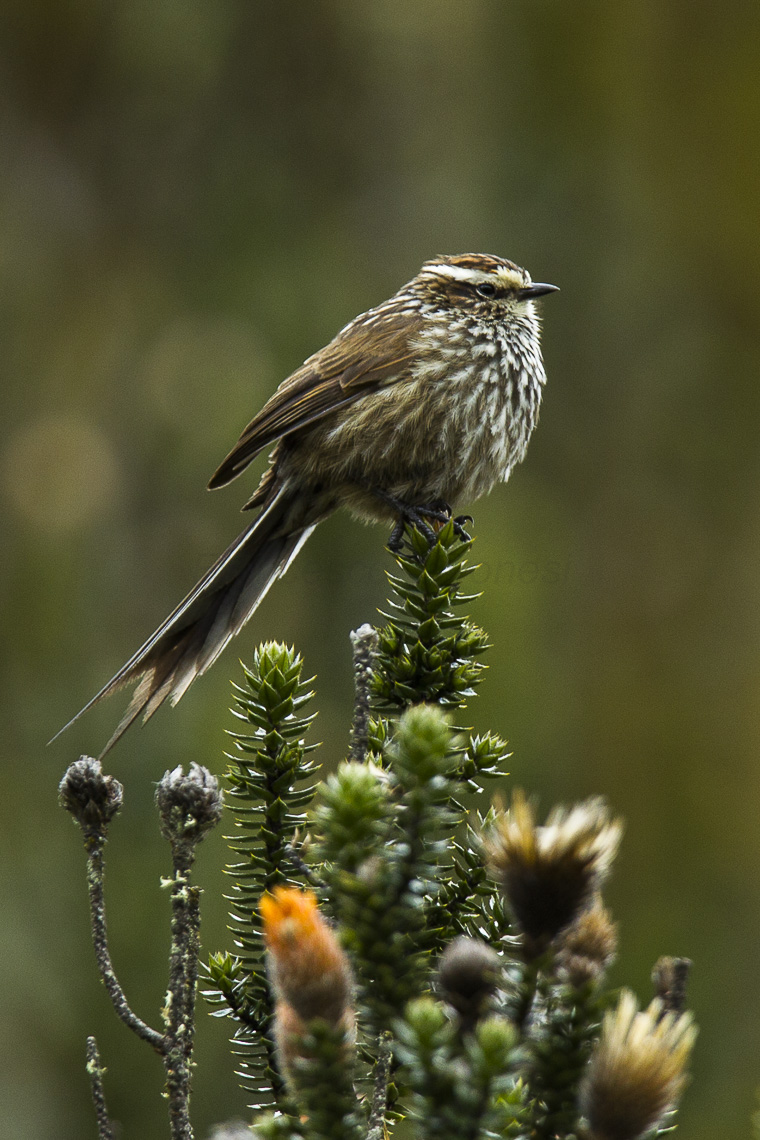
Wikipedia: Andean tit-spinetail Source: OTHER
Andean_Tit-Spinetail_-_South_Ecuador_S4E3047.jpg
![]() The Andean tit-spinetail (Leptasthenura andicola) is a species of bird in the family Furnariidae. It is found in Bolivia, Chile, Colombia, Ecuador, Peru, and Venezuela.
[more]
The Andean tit-spinetail (Leptasthenura andicola) is a species of bird in the family Furnariidae. It is found in Bolivia, Chile, Colombia, Ecuador, Peru, and Venezuela.
[more]
Rufous-fronted thornbird (Phacellodomus rufifrons)
Profile Wikipedia eBird Xeno-Canto
Wikipedia: Rufous-fronted thornbird Source: OTHER
Phacellodomus_rufifrons_-_Rufous-fronted_thornbird.JPG
![]() The rufous-fronted thornbird (Phacellodomus rufifrons) is a species of bird in the family Furnariidae.
[more]
The rufous-fronted thornbird (Phacellodomus rufifrons) is a species of bird in the family Furnariidae.
[more]
Point-tailed palmcreeper (Berlepschia rikeri)
Wikipedia: Point-tailed palmcreeper Source: OTHER
Berlepschia_rikeri_-_Point-tailed_Palmcreeper.JPG
![]() The point-tailed palmcreeper (Berlepschia rikeri) is a species of bird in the family Furnariidae, the ovenbirds. It is monotypic, the only member of the genus Berlepschia.
[more]
The point-tailed palmcreeper (Berlepschia rikeri) is a species of bird in the family Furnariidae, the ovenbirds. It is monotypic, the only member of the genus Berlepschia.
[more]
Rusty-winged barbtail (Premnornis guttuliger)
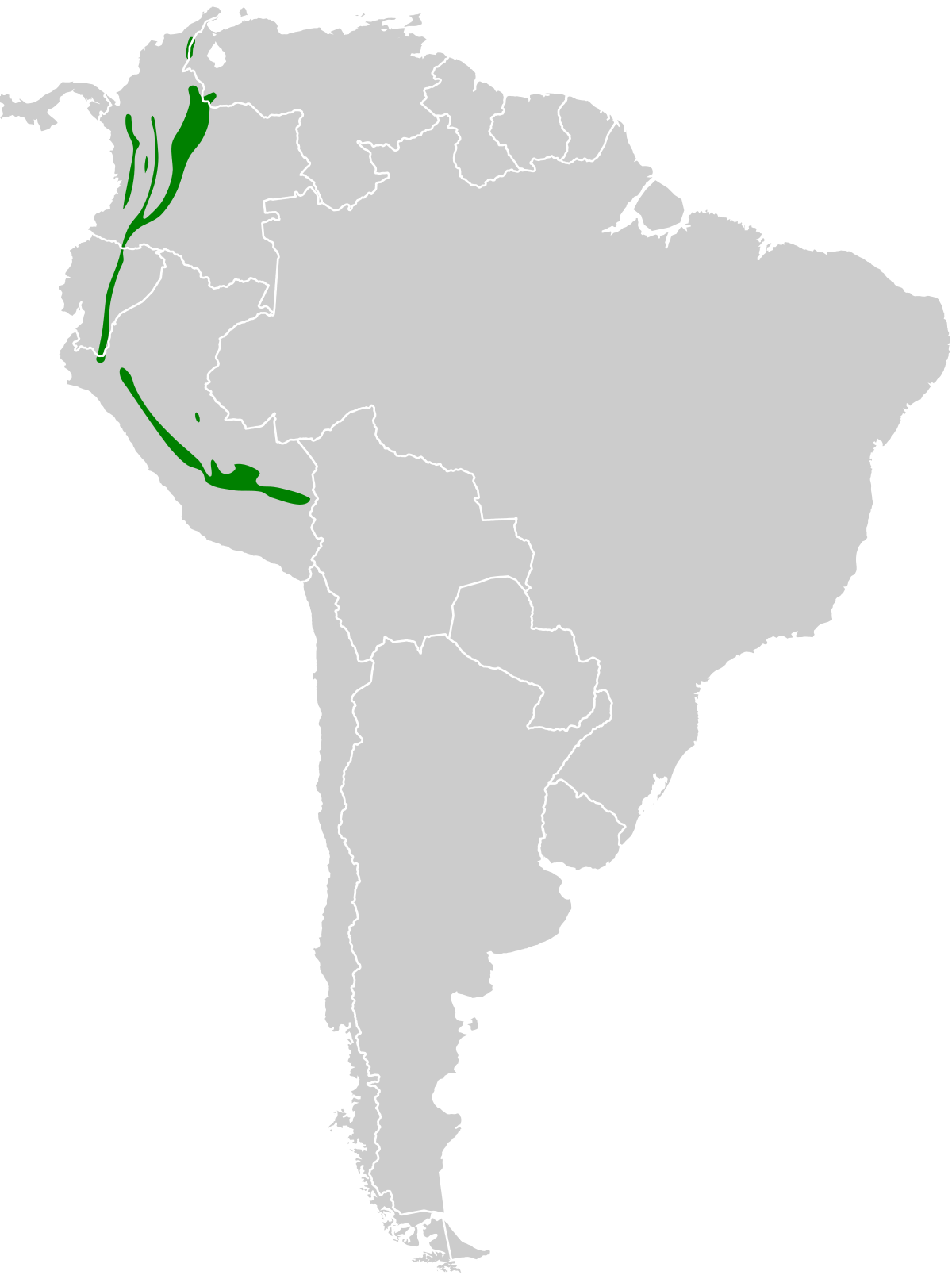
Wikipedia: Rusty-winged barbtail Source: OTHER
1200px-Premnornis_guttuliger_map.svg.png
![]() The rusty-winged barbtail (Premnornis guttuliger) is a species of bird in the family Furnariidae. It is the only member of the genus Premnornis.[2] It is found in Bolivia, Colombia, Ecuador, Peru, and Venezuela, where its natural habitat is subtropical or tropical moist montane forest.[1]
[more]
The rusty-winged barbtail (Premnornis guttuliger) is a species of bird in the family Furnariidae. It is the only member of the genus Premnornis.[2] It is found in Bolivia, Colombia, Ecuador, Peru, and Venezuela, where its natural habitat is subtropical or tropical moist montane forest.[1]
[more]
Spotted barbtail (Premnoplex brunnescens)
Profile Wikipedia eBird Xeno-Canto
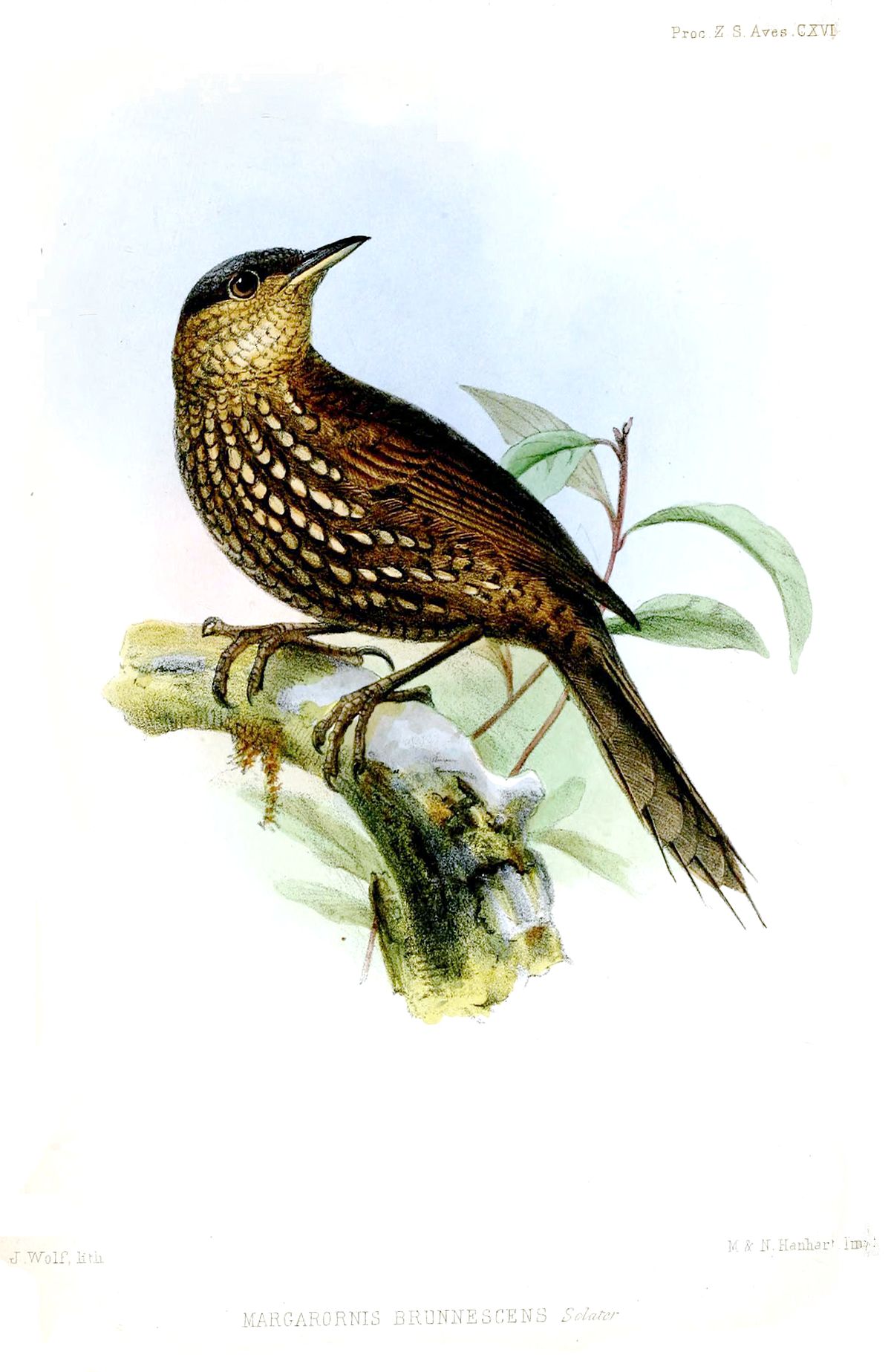
Wikipedia: Spotted barbtail Source: OTHER
1200px-MargarornisBrunnescensWolf.jpg
![]() The spotted barbtail (Premnoplex brunnescens) is a species of bird in the family Furnariidae. Its natural habitat is subtropical or tropical moist montane forest.
[more]
The spotted barbtail (Premnoplex brunnescens) is a species of bird in the family Furnariidae. Its natural habitat is subtropical or tropical moist montane forest.
[more]
Buffy tuftedcheek (Pseudocolaptes lawrencii)

Wikipedia: Buffy tuftedcheek Source: OTHER
1200px-Buffy_Tuftedcheek_%28Pseudocolaptes_lawrencii%29_%285771957543%29.jpg
![]() The buffy tuftedcheek or Lawrence's tuftedcheek (Pseudocolaptes lawrencii) is a passerine bird in the ovenbird family, which breeds in the tropical New World in Costa Rica, western Panama and the Andes of Colombia and Ecuador. It is sometimes considered conspecific with the streaked tuftedcheek, P. boissonneautii, of South America. Birds from Colombia and Ecuador are sometimes considered a separate species, the Pacific tuftedcheek (P. johnsoni).
[more]
The buffy tuftedcheek or Lawrence's tuftedcheek (Pseudocolaptes lawrencii) is a passerine bird in the ovenbird family, which breeds in the tropical New World in Costa Rica, western Panama and the Andes of Colombia and Ecuador. It is sometimes considered conspecific with the streaked tuftedcheek, P. boissonneautii, of South America. Birds from Colombia and Ecuador are sometimes considered a separate species, the Pacific tuftedcheek (P. johnsoni).
[more]
Streaked tuftedcheek (Pseudocolaptes boissonneautii)
Profile Wikipedia eBird Xeno-Canto

Wikipedia: Streaked tuftedcheek Source: OTHER
1200px-Pseudocolaptes_boissonneautii_68808554.jpg
![]() The streaked tuftedcheek (Pseudocolaptes boissonneautii) is a passerine bird in the ovenbird family, which breeds in the tropical New World in the coastal mountains of Venezuela, and the Andes from Venezuela to Bolivia. It is sometimes considered conspecific with the buffy tuftedcheek, P. lawrencii of Central America, Colombia and Ecuador.
[more]
The streaked tuftedcheek (Pseudocolaptes boissonneautii) is a passerine bird in the ovenbird family, which breeds in the tropical New World in the coastal mountains of Venezuela, and the Andes from Venezuela to Bolivia. It is sometimes considered conspecific with the buffy tuftedcheek, P. lawrencii of Central America, Colombia and Ecuador.
[more]
Scaly-throated foliage-gleaner (Anabacerthia variegaticeps)

Wikipedia: Scaly-throated foliage-gleaner Source: OTHER
Scaly-throated_Foliage-gleaner.jpg
![]() The scaly-throated foliage-gleaner (Anabacerthia variegaticeps), also known as the spectacled foliage-gleaner, is a species of bird in the family Furnariidae.
It is found in Belize, Colombia, Costa Rica, Ecuador, El Salvador, Guatemala, Honduras, Mexico, and Panama.
Its natural habitats are subtropical or tropical moist lowland forest and subtropical or tropical moist montane forest.
[more]
The scaly-throated foliage-gleaner (Anabacerthia variegaticeps), also known as the spectacled foliage-gleaner, is a species of bird in the family Furnariidae.
It is found in Belize, Colombia, Costa Rica, Ecuador, El Salvador, Guatemala, Honduras, Mexico, and Panama.
Its natural habitats are subtropical or tropical moist lowland forest and subtropical or tropical moist montane forest.
[more]
Montane foliage-gleaner (Anabacerthia striaticollis)
Profile Wikipedia eBird Xeno-Canto

Wikipedia: Montane foliage-gleaner Source: OTHER
Anabacerthia_striaticollis_%2815768922817%29.jpg
![]() The montane foliage-gleaner (Anabacerthia striaticollis) is a species of bird in the family Furnariidae.
It is found in Bolivia, Colombia, Ecuador, Peru, and Venezuela.
[more]
The montane foliage-gleaner (Anabacerthia striaticollis) is a species of bird in the family Furnariidae.
It is found in Bolivia, Colombia, Ecuador, Peru, and Venezuela.
[more]
Rufous-tailed foliage-gleaner (Anabacerthia ruficaudata)
Profile Wikipedia eBird Xeno-Canto

Wikipedia: Rufous-tailed foliage-gleaner Source: OTHER
1200px-Anabacerthia_ruficaudata_-_Rufous-tailed_Foliage-gleaner.jpg
![]() The rufous-tailed foliage-gleaner (Anabacerthia ruficaudata) is a species of bird in the family Furnariidae. It is found in Bolivia, Brazil, Colombia, Ecuador, French Guiana, Guyana, Peru, Suriname, and Venezuela. Its natural habitat is subtropical or tropical moist lowland forests.
[more]
The rufous-tailed foliage-gleaner (Anabacerthia ruficaudata) is a species of bird in the family Furnariidae. It is found in Bolivia, Brazil, Colombia, Ecuador, French Guiana, Guyana, Peru, Suriname, and Venezuela. Its natural habitat is subtropical or tropical moist lowland forests.
[more]
Lineated foliage-gleaner (Syndactyla subalaris)
Profile Wikipedia eBird Xeno-Canto
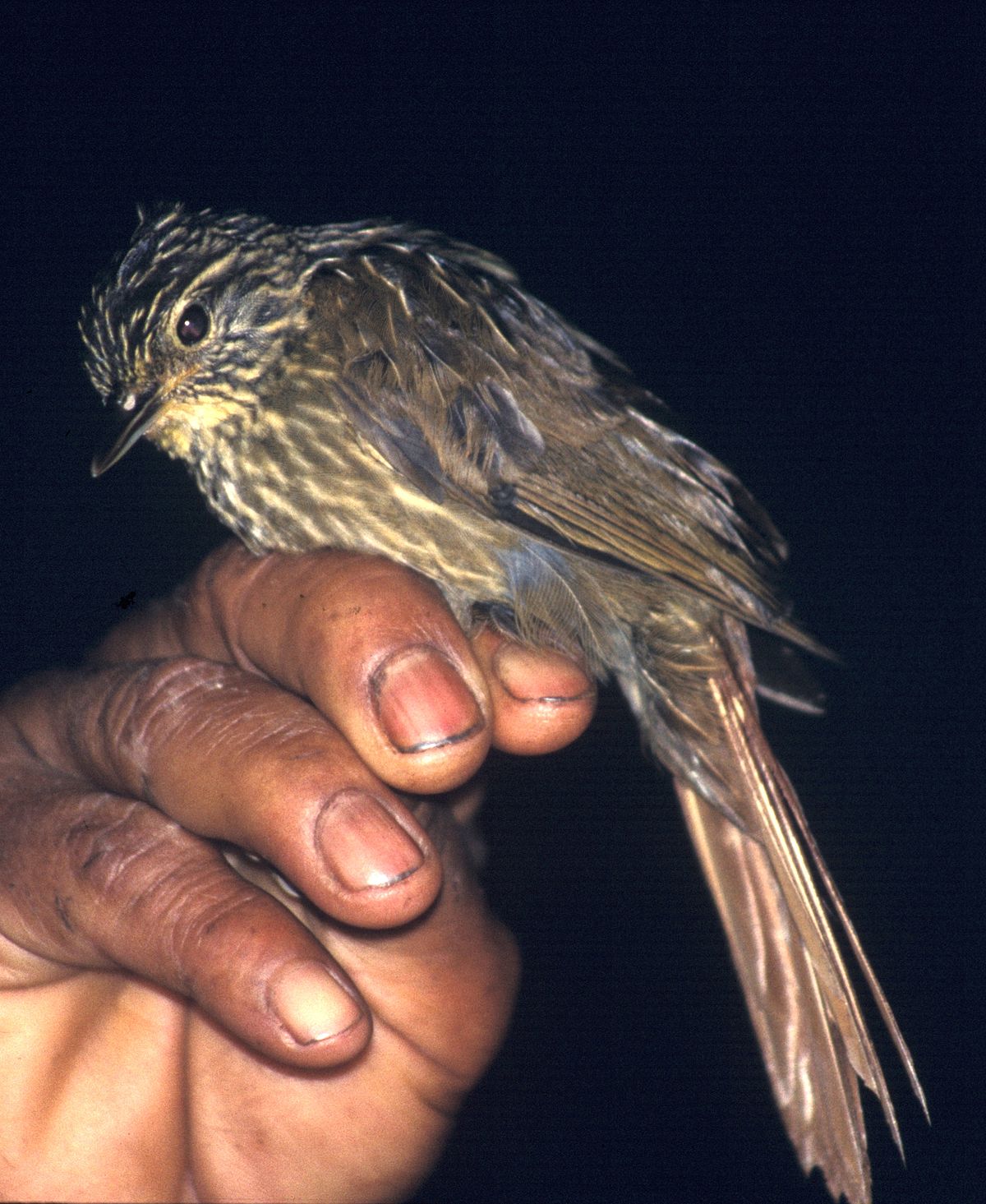
Wikipedia: Lineated foliage-gleaner Source: OTHER
1200px-Syndactyla_subalaris.jpg
![]() The lineated foliage-gleaner (Syndactyla subalaris) is a species of bird in the family Furnariidae. It is found in Colombia, Costa Rica, Ecuador, Panama, Peru, and Venezuela. Its natural habitat is subtropical or tropical moist montane forest.
[more]
The lineated foliage-gleaner (Syndactyla subalaris) is a species of bird in the family Furnariidae. It is found in Colombia, Costa Rica, Ecuador, Panama, Peru, and Venezuela. Its natural habitat is subtropical or tropical moist montane forest.
[more]
Buff-browed foliage-gleaner (Syndactyla rufosuperciliata)

Wikipedia: Buff-browed foliage-gleaner Source: OTHER
1200px-Buffbrowedfoliagegleaner.jpg
![]() The buff-browed foliage-gleaner (Syndactyla rufosuperciliata) is a species of bird in the family Furnariidae.
It is found in Argentina, Bolivia, Brazil, Ecuador, Paraguay, Peru, and Uruguay.
Its natural habitats are subtropical or tropical moist lowland forest and subtropical or tropical moist montane forest.
[more]
The buff-browed foliage-gleaner (Syndactyla rufosuperciliata) is a species of bird in the family Furnariidae.
It is found in Argentina, Bolivia, Brazil, Ecuador, Paraguay, Peru, and Uruguay.
Its natural habitats are subtropical or tropical moist lowland forest and subtropical or tropical moist montane forest.
[more]
Rufous-necked foliage-gleaner (Syndactyla ruficollis)
Profile Wikipedia eBird Xeno-Canto

Wikipedia: Rufous-necked foliage-gleaner Source: OTHER
Rufous-neckedFoliage-gleaner.jpg
![]() The rufous-necked foliage-gleaner (Syndactyla ruficollis) is a species of bird in the family Furnariidae. It is found in Ecuador and Peru. Its natural habitats are subtropical or tropical dry forests, subtropical or tropical moist lowland forests, and subtropical or tropical moist montane forests. It is threatened by habitat loss.
[more]
The rufous-necked foliage-gleaner (Syndactyla ruficollis) is a species of bird in the family Furnariidae. It is found in Ecuador and Peru. Its natural habitats are subtropical or tropical dry forests, subtropical or tropical moist lowland forests, and subtropical or tropical moist montane forests. It is threatened by habitat loss.
[more]
Double-banded graytail (Xenerpestes minlosi)
Profile Wikipedia eBird Xeno-Canto

Wikipedia: Double-banded graytail Source: OTHER
1200px-XenerpestesMinlosiKeulemans.jpg
![]() The double-banded greytail (Xenerpestes minlosi) is a species of bird in the family Furnariidae. It is found in Colombia, Ecuador, and Panama. Its natural habitats are subtropical or tropical moist lowland forest and subtropical or tropical moist montane forest.
[more]
The double-banded greytail (Xenerpestes minlosi) is a species of bird in the family Furnariidae. It is found in Colombia, Ecuador, and Panama. Its natural habitats are subtropical or tropical moist lowland forest and subtropical or tropical moist montane forest.
[more]
Equatorial graytail (Xenerpestes singularis)
Profile Wikipedia eBird Xeno-Canto

Wikipedia: Equatorial graytail Source: OTHER
EquatorialGraytail.jpg
![]() The equatorial greytail (Xenerpestes singularis) is a species of bird in the family Furnariidae. It is found in Ecuador and Peru. Its natural habitat is subtropical or tropical moist montane forest. It is threatened by habitat loss.
[more]
The equatorial greytail (Xenerpestes singularis) is a species of bird in the family Furnariidae. It is found in Ecuador and Peru. Its natural habitat is subtropical or tropical moist montane forest. It is threatened by habitat loss.
[more]
Orange-fronted plushcrown (Metopothrix aurantiaca)

Wikipedia: Orange-fronted plushcrown Source: OTHER
1200px-Metopothrix_aurantiaca_-_Orange-fronted_Plushcrown%3B_Ramal_do_Noca%2C_Rio_Branco%2C_Acre%2C_Brazil.jpg
![]() The orange-fronted plushcrown (Metopothrix aurantiaca) is a species of bird in the family Furnariidae. It is the only member of the genus Metopothrix.
[more]
The orange-fronted plushcrown (Metopothrix aurantiaca) is a species of bird in the family Furnariidae. It is the only member of the genus Metopothrix.
[more]
Dusky-cheeked foliage-gleaner (Anabazenops dorsalis)
Profile Wikipedia eBird Xeno-Canto

Wikipedia: Dusky-cheeked foliage-gleaner Source: OTHER
1200px-Anabazenops_dorsalis_map.svg.png
![]() The bamboo foliage-gleaner (Anabazenops dorsalis), also known as the crested foliage-gleaner or dusky-cheeked foliage-gleaner, is a species of bird in the family Furnariidae. It is found in Bolivia, Brazil, Colombia, Ecuador, and Peru.
[more]
The bamboo foliage-gleaner (Anabazenops dorsalis), also known as the crested foliage-gleaner or dusky-cheeked foliage-gleaner, is a species of bird in the family Furnariidae. It is found in Bolivia, Brazil, Colombia, Ecuador, and Peru.
[more]
Chestnut-winged hookbill (Ancistrops strigilatus)
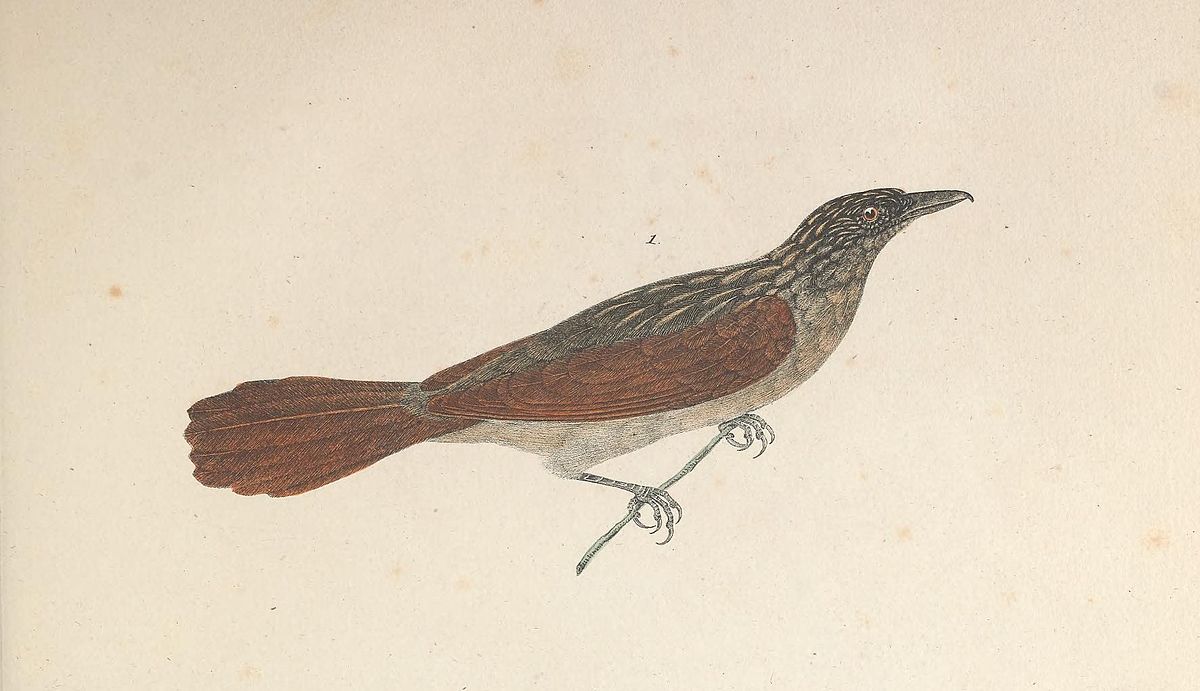
Wikipedia: Chestnut-winged hookbill Source: OTHER
1200px-Avium_Species_Novae_%288422834063%29_%28cropped%29.jpg
![]() The chestnut-winged hookbill (Ancistrops strigilatus) is a species of bird in the family Furnariidae. It is the only member of the genus Ancistrops.
[more]
The chestnut-winged hookbill (Ancistrops strigilatus) is a species of bird in the family Furnariidae. It is the only member of the genus Ancistrops.
[more]
Spectacled prickletail (Siptornis striaticollis)
Profile Wikipedia eBird Xeno-Canto

Wikipedia: Spectacled prickletail Source: OTHER
1200px-Siptornis_striaticollis_map.svg.png
![]() The spectacled prickletail (Siptornis striaticollis) is a species of bird in the family Furnariidae. Its genus, Siptornis, is monotypic.[2] It is found in the Andes of southwestern Colombia, Ecuador and far northern Peru. Its natural habitat is subtropical or tropical moist montane forests.[1]
[more]
The spectacled prickletail (Siptornis striaticollis) is a species of bird in the family Furnariidae. Its genus, Siptornis, is monotypic.[2] It is found in the Andes of southwestern Colombia, Ecuador and far northern Peru. Its natural habitat is subtropical or tropical moist montane forests.[1]
[more]
Ruddy foliage-gleaner (alternate) (Clibanornis rubiginosus)
Henna-hooded foliage-gleaner (Clibanornis erythrocephalus)
Profile Wikipedia eBird Xeno-Canto

Wikipedia: Henna-hooded foliage-gleaner Source: OTHER
1200px-Clibanornis_erythrocephalus_map.svg.png
![]() The henna-hooded foliage-gleaner (Clibanornis erythrocephalus) is a species of bird in the family Furnariidae. It is found in southwestern Ecuador and northwestern Peru.
[more]
The henna-hooded foliage-gleaner (Clibanornis erythrocephalus) is a species of bird in the family Furnariidae. It is found in southwestern Ecuador and northwestern Peru.
[more]
Choco tapaculo (Scytalopus chocoensis)
Profile Wikipedia eBird Xeno-Canto

Wikipedia: Choco tapaculo Source: OTHER
1200px-Scytalopus_chocoensis_-_Choco_Tapaculo.jpg
![]() The Chocó tapaculo (Scytalopus chocoensis) is a species of bird in the family Rhinocryptidae. It is found in Colombia, Ecuador, and Panama.
[more]
The Chocó tapaculo (Scytalopus chocoensis) is a species of bird in the family Rhinocryptidae. It is found in Colombia, Ecuador, and Panama.
[more]
Northern white-crowned tapaculo / Weißscheiteltapaculo (Scytalopus atratus)
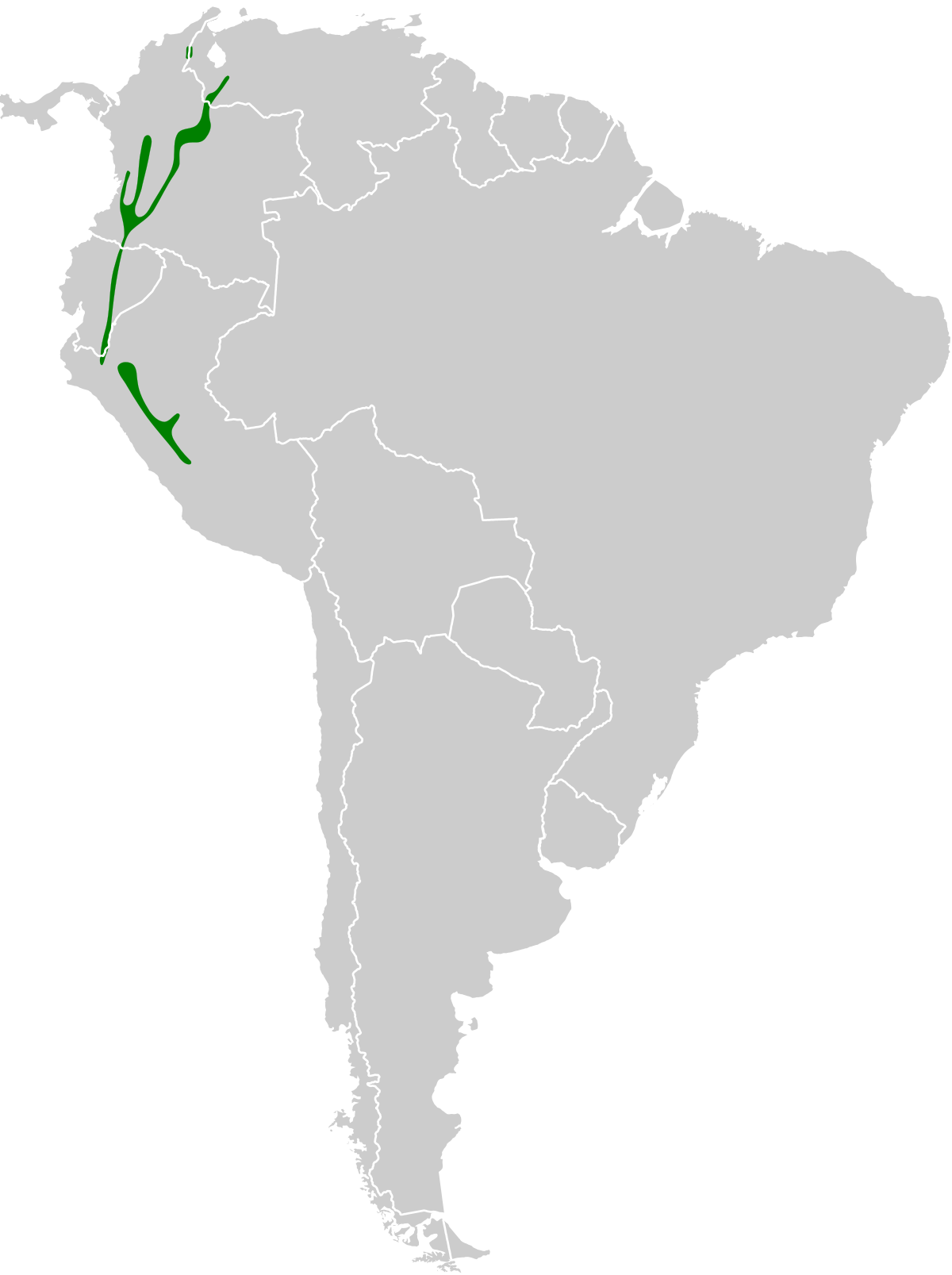
Wikipedia: Northern white-crowned tapaculo Source: OTHER
1200px-Scytalopus_atratus_map.svg.png
![]() The northern white-crowned tapaculo (Scytalopus atratus) is a species of bird in the family Rhinocryptidae. It is found in Bolivia, Colombia, Ecuador, Peru, and Venezuela.[2]
[more]
The northern white-crowned tapaculo (Scytalopus atratus) is a species of bird in the family Rhinocryptidae. It is found in Bolivia, Colombia, Ecuador, Peru, and Venezuela.[2]
[more]
Chusquea tapaculo (Scytalopus parkeri)
Profile Wikipedia eBird Xeno-Canto

Wikipedia: Chusquea tapaculo Source: OTHER
1200px-Scytalopus_parkeri_-_Chusquea_Tapaculo.jpg
![]() The chusquea tapaculo (Scytalopus parkeri) is a species of bird in the family Rhinocryptidae. It is found in souothern Ecuador and far northern Peru.[2]
[more]
The chusquea tapaculo (Scytalopus parkeri) is a species of bird in the family Rhinocryptidae. It is found in souothern Ecuador and far northern Peru.[2]
[more]
Ecuadorian tapaculo (Scytalopus robbinsi)
Profile Wikipedia eBird Xeno-Canto

Wikipedia: Ecuadorian tapaculo Source: OTHER
1200px-Scytalopus_robbinsi_map.svg.png
![]() The Ecuadorian tapaculo [3] or El Oro tapaculo [4] (Scytalopus robbinsi) is a small passerine bird belonging to the genus Scytalopus, a genus of tapaculos. It is restricted to a small area in south-western Ecuador and was not described until 1997.
[more]
The Ecuadorian tapaculo [3] or El Oro tapaculo [4] (Scytalopus robbinsi) is a small passerine bird belonging to the genus Scytalopus, a genus of tapaculos. It is restricted to a small area in south-western Ecuador and was not described until 1997.
[more]
Long-tailed tapaculo (Scytalopus micropterus)

Wikipedia: Long-tailed tapaculo Source: OTHER
Long-tailed_Tapaculo_-_Ecuador_S4E4271_%2816831736745%29.jpg
![]() The long-tailed tapaculo (Scytalopus micropterus) is a species of bird in the family Rhinocryptidae. It is found in the eastern Andes of Colombia, Ecuador and far northern Peru.[2]
[more]
The long-tailed tapaculo (Scytalopus micropterus) is a species of bird in the family Rhinocryptidae. It is found in the eastern Andes of Colombia, Ecuador and far northern Peru.[2]
[more]
Nariño tapaculo / Nariñotapaculo (Scytalopus vicinior)
Profile Wikipedia eBird Xeno-Canto
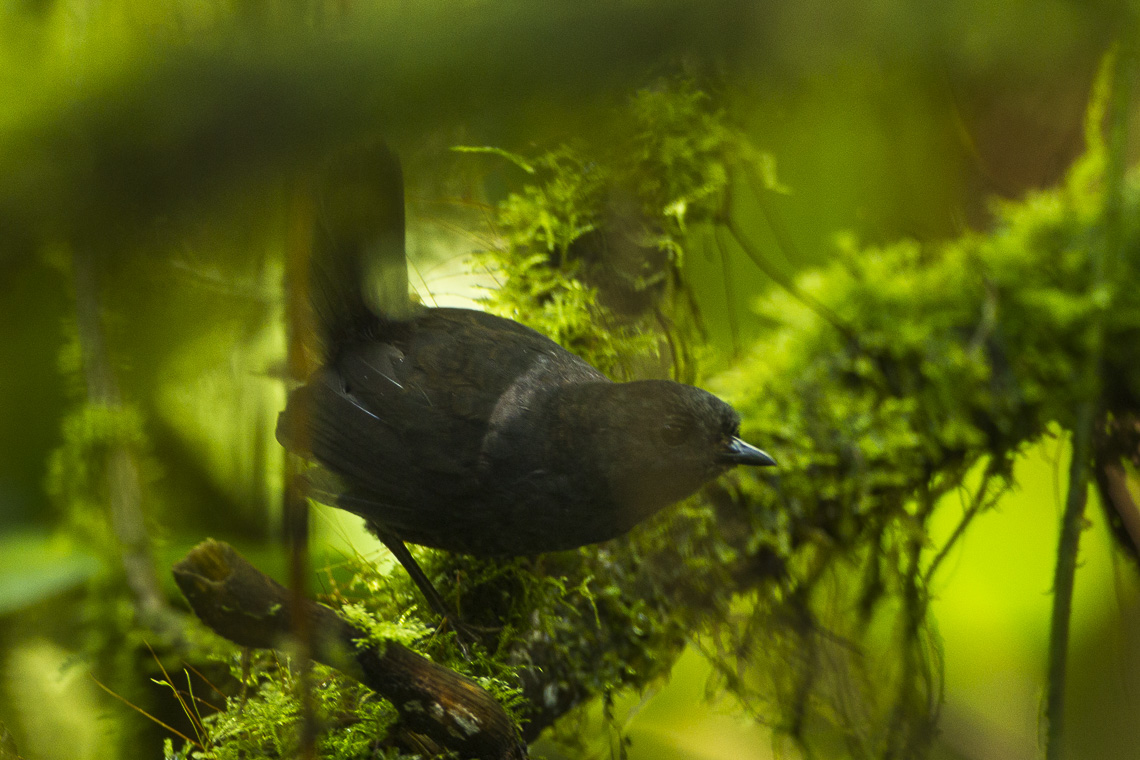
Wikipedia: Nariño tapaculo Source: OTHER
Narino_Tapaculo_-_Colombia_S4E9464_%2816644372930%29.jpg
![]() The Nariño tapaculo (Scytalopus vicinior) is a species of bird in the family Rhinocryptidae. It is found in Colombia and Ecuador.[2]
[more]
The Nariño tapaculo (Scytalopus vicinior) is a species of bird in the family Rhinocryptidae. It is found in Colombia and Ecuador.[2]
[more]
Blackish tapaculo / Schwarztapaculo (Scytalopus latrans)

Wikipedia: Blackish tapaculo Source: OTHER
1200px-Scytalopus_latrans_-NBII_Image_Gallery-a00273.jpg
![]() The blackish tapaculo (Scytalopus latrans) is a species of bird in the family Rhinocryptidae. It is found in Colombia, Ecuador, Peru, and Venezuela.
[more]
The blackish tapaculo (Scytalopus latrans) is a species of bird in the family Rhinocryptidae. It is found in Colombia, Ecuador, Peru, and Venezuela.
[more]
Loja tapaculo (Scytalopus androstictus)
Profile Wikipedia eBird Xeno-Canto

Wikipedia: Loja tapaculo Source: OTHER
1200px-Scytalopus_androstictus_map.svg.png
![]() The Loja tapaculo (Scytalopus androstictus) is a species of bird in the family Rhinocryptidae that the South American Classification Committee of the American Ornithological Society (AOS) accepted as a new species in July 2020. It had been classified as a subspecies of paramo tapaculo (Scytalopus opacus). It is found in Ecuador and Peru.[1]
[more]
The Loja tapaculo (Scytalopus androstictus) is a species of bird in the family Rhinocryptidae that the South American Classification Committee of the American Ornithological Society (AOS) accepted as a new species in July 2020. It had been classified as a subspecies of paramo tapaculo (Scytalopus opacus). It is found in Ecuador and Peru.[1]
[more]
Paramo tapaculo (Scytalopus opacus)
Profile Wikipedia eBird Xeno-Canto

Wikipedia: Paramo tapaculo Source: OTHER
Scytalopus_opacus.jpg
![]() The Paramo tapaculo (Scytalopus opacus) is a species of bird in the family Rhinocryptidae. It is found in the Andes of Ecuador and southern Colombia.[2]
[more]
The Paramo tapaculo (Scytalopus opacus) is a species of bird in the family Rhinocryptidae. It is found in the Andes of Ecuador and southern Colombia.[2]
[more]
Spillman's tapaculo / Roststeißtapaculo (Scytalopus spillmanni)

Wikipedia: Spillman's tapaculo Source: OTHER
1200px-Scytalopus_spillmanni_map.svg.png
![]() Spillmann's tapaculo (Scytalopus spillmanni) is a species of bird in the family Formicariidae. It inhabits the Andes of Colombia and Ecuador.[2]
[more]
Spillmann's tapaculo (Scytalopus spillmanni) is a species of bird in the family Formicariidae. It inhabits the Andes of Colombia and Ecuador.[2]
[more]
Marañon crescentchest (Melanopareia maranonica)
Profile Wikipedia eBird Xeno-Canto
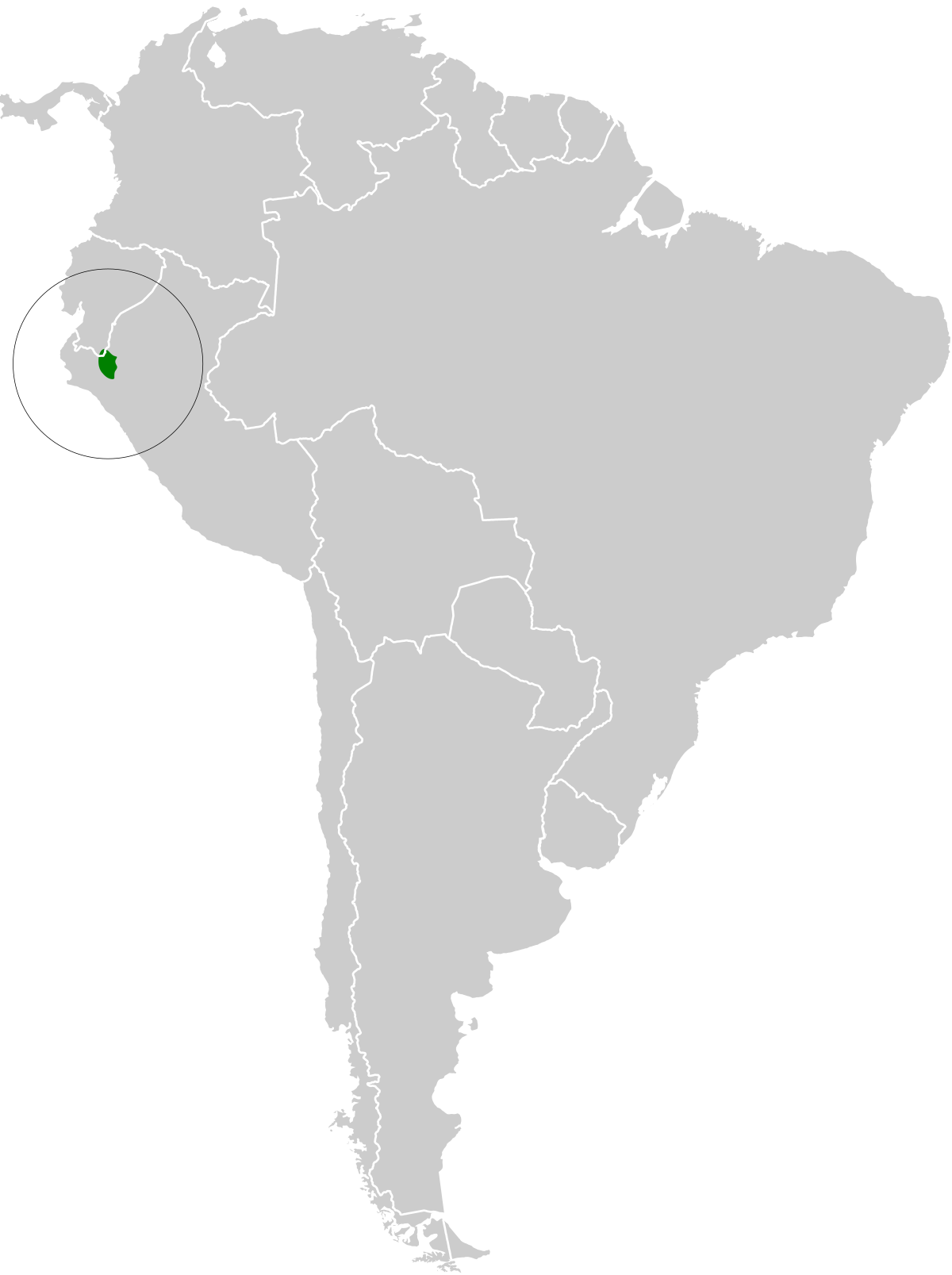
Wikipedia: Marañon crescentchest Source: OTHER
1200px-Melanopareia_maranonica_map.svg.png
![]() The Marañón crescentchest (Melanopareia maranonica) is a species of bird in the family Melanopareiidae. It is found in southern Ecuador and northern Peru.[2]
[more]
The Marañón crescentchest (Melanopareia maranonica) is a species of bird in the family Melanopareiidae. It is found in southern Ecuador and northern Peru.[2]
[more]
Elegant crescentchest (Melanopareia elegans)
Profile Wikipedia eBird Xeno-Canto

Wikipedia: Elegant crescentchest Source: OTHER
1200px-Melanopareia_elegans_elegans_1897.jpg
![]() The elegant crescentchest (Melanopareia elegans) is a species of bird in the family Melanopareiidae. It is found in Ecuador and Peru.[2]
[more]
The elegant crescentchest (Melanopareia elegans) is a species of bird in the family Melanopareiidae. It is found in Ecuador and Peru.[2]
[more]
Ash-colored tapaculo (Myornis senilis)
Profile Wikipedia eBird Xeno-Canto

Wikipedia: Ash-colored tapaculo Source: OTHER
1200px-Myornis_senilis_-_Ash-colored_Tapaculo.jpg
![]() The ash-colored tapaculo (Myornis senilis) is a species of bird in the family Rhinocryptidae. It is found in Colombia, Ecuador, and Peru.[2]
[more]
The ash-colored tapaculo (Myornis senilis) is a species of bird in the family Rhinocryptidae. It is found in Colombia, Ecuador, and Peru.[2]
[more]
Rusty-belted tapaculo (Liosceles thoracicus)

Wikipedia: Rusty-belted tapaculo Source: OTHER
1200px-Rusty_Belted_Tapaculo.jpg
![]() The rusty-belted tapaculo, Liosceles thoracicus, is a species of bird in the family Rhinocryptidae. It is found in Bolivia, Brazil, Colombia, Ecuador, and Peru.[2][3]
[more]
The rusty-belted tapaculo, Liosceles thoracicus, is a species of bird in the family Rhinocryptidae. It is found in Bolivia, Brazil, Colombia, Ecuador, and Peru.[2][3]
[more]
Ocellated tapaculo (Acropternis orthonyx)

Wikipedia: Ocellated tapaculo Source: OTHER
1200px-Ocellated_Tapaculo_%28Acropternis_orthonyx%29.jpg
![]() The ocellated tapaculo (Acropternis orthonyx) is a large bird found in the northern Andes in South America. It is a highly distinctive tapaculo; traditionally united with its closest relatives in the Rhinocryptidae, this family is paraphyletic with the Formicariidae (ground-antbirds) but instead of merging the tapaculos with the ground-antbird family, recent sources tend to split the antpittas from the Formicariidae.
[more]
The ocellated tapaculo (Acropternis orthonyx) is a large bird found in the northern Andes in South America. It is a highly distinctive tapaculo; traditionally united with its closest relatives in the Rhinocryptidae, this family is paraphyletic with the Formicariidae (ground-antbirds) but instead of merging the tapaculos with the ground-antbird family, recent sources tend to split the antpittas from the Formicariidae.
[more]
Gray-cheeked thrush / Grauwangendrossel (Catharus minimus)
Profile Wikipedia eBird Audubon AllAboutBirds Xeno-Canto

Wikipedia: Gray-cheeked thrush Source: OTHER
1200px-Graycheekedthrush36.jpg
![]() The grey-cheeked thrush (Catharus minimus) is a medium-sized thrush. This species is 15–17 cm (5.9–6.7 in) in length, and has the white-dark-white underwing pattern characteristic of Catharus thrushes. It is a member of a close-knit group of migrant species together with the veery and Bicknell's thrush;[2] it forms a cryptic species pair with the latter. The grey-cheeked thrush is all but indistinguishable from Bicknell's thrush except by its slightly larger size and different song. The two were formerly considered conspecific.[3] Of all the American spotted thrushes, the grey-cheeked has the most northern breeding range.[4]
[more]
The grey-cheeked thrush (Catharus minimus) is a medium-sized thrush. This species is 15–17 cm (5.9–6.7 in) in length, and has the white-dark-white underwing pattern characteristic of Catharus thrushes. It is a member of a close-knit group of migrant species together with the veery and Bicknell's thrush;[2] it forms a cryptic species pair with the latter. The grey-cheeked thrush is all but indistinguishable from Bicknell's thrush except by its slightly larger size and different song. The two were formerly considered conspecific.[3] Of all the American spotted thrushes, the grey-cheeked has the most northern breeding range.[4]
[more]
Swainson's thrush (Catharus ustulatus)
Profile Wikipedia eBird Audubon AllAboutBirds Xeno-Canto

Wikipedia: Swainson's thrush Source: OTHER
1200px-Catharus_ustulatus_-North_Dakota-8a.jpg
![]() Swainson's thrush (Catharus ustulatus), also called olive-backed thrush and russet-backed thrush, is a medium-sized thrush. It is a member of genus Catharus and is typical of it in terms of its subdued coloration and beautiful, ascending flute-like voice. Swainson's thrush was named after William Swainson, an English ornithologist.
[more]
Swainson's thrush (Catharus ustulatus), also called olive-backed thrush and russet-backed thrush, is a medium-sized thrush. It is a member of genus Catharus and is typical of it in terms of its subdued coloration and beautiful, ascending flute-like voice. Swainson's thrush was named after William Swainson, an English ornithologist.
[more]
Slaty-backed nightingale-thrush (Catharus fuscater)
Profile Wikipedia eBird Xeno-Canto

Wikipedia: Slaty-backed nightingale-thrush Source: OTHER
1200px-Catharus_fuscater_Santa_Elena_1.JPG
![]() The slaty-backed nightingale-thrush (Catharus fuscater) is a species of bird in the family Turdidae. It is found in Bolivia, Colombia, Costa Rica, Ecuador, Panama, Peru, and Venezuela.
[more]
The slaty-backed nightingale-thrush (Catharus fuscater) is a species of bird in the family Turdidae. It is found in Bolivia, Colombia, Costa Rica, Ecuador, Panama, Peru, and Venezuela.
[more]
White-throated thrush (Turdus assimilis)

Wikipedia: White-throated thrush Source: OTHER
1200px-Mirlo_Garganta_Blanca%2C_White_Throated_Thrush%2C_Turdus_assimilis_%2813362733943%29.jpg
![]() The white-throated thrush (Turdus assimilis) is a species of bird in the family Turdidae. It is found in Mexico and Central America, ranging south to central Panama.[2] Its natural habitats are subtropical or tropical dry forests, subtropical or tropical moist lowland forests, and subtropical or tropical moist montane forests. It is common in its range and an extremely rare vagrant into Texas and Arizona; 3 sightings have been recorded (1990 and 1998 in Texas and 2019 in Arizona).[3][4]
[more]
The white-throated thrush (Turdus assimilis) is a species of bird in the family Turdidae. It is found in Mexico and Central America, ranging south to central Panama.[2] Its natural habitats are subtropical or tropical dry forests, subtropical or tropical moist lowland forests, and subtropical or tropical moist montane forests. It is common in its range and an extremely rare vagrant into Texas and Arizona; 3 sightings have been recorded (1990 and 1998 in Texas and 2019 in Arizona).[3][4]
[more]
Pale-vented thrush (Turdus obsoletus)
Profile Wikipedia eBird Xeno-Canto

Wikipedia: Pale-vented thrush Source: OTHER
Turdus_obsoletus.jpg
![]() The pale-vented thrush (Turdus obsoletus) is a species of bird in the family Turdidae.
[more]
The pale-vented thrush (Turdus obsoletus) is a species of bird in the family Turdidae.
[more]
Marañon thrush (Turdus maranonicus)
Profile Wikipedia eBird Xeno-Canto

Wikipedia: Marañon thrush Source: OTHER
1200px-TurdusMaranonicusSmit.jpg
![]() The Marañón thrush (Turdus maranonicus) is a species of bird in the family Turdidae. It is found in far southern Ecuador and northern Peru. Its natural habitats are subtropical or tropical dry forests and subtropical or tropical moist lowland forests.
[more]
The Marañón thrush (Turdus maranonicus) is a species of bird in the family Turdidae. It is found in far southern Ecuador and northern Peru. Its natural habitats are subtropical or tropical dry forests and subtropical or tropical moist lowland forests.
[more]
Great thrush (Turdus fuscater)

Wikipedia: Great thrush Source: OTHER
GreatThrush.jpg
![]() The great thrush (Turdus fuscater) is a species of bird in the family Turdidae. It is found in Bolivia, Colombia, Ecuador, Peru, and Venezuela. It is considered as the largest thrush in South America.[2][3] The great thrush's size distinguishes it from the several other uniform slaty-colored thrushes in its range. It inhabits subtropical or tropical moist montane forests and high-altitude shrubland, but can also make use of degraded forest and urban areas.
[more]
The great thrush (Turdus fuscater) is a species of bird in the family Turdidae. It is found in Bolivia, Colombia, Ecuador, Peru, and Venezuela. It is considered as the largest thrush in South America.[2][3] The great thrush's size distinguishes it from the several other uniform slaty-colored thrushes in its range. It inhabits subtropical or tropical moist montane forests and high-altitude shrubland, but can also make use of degraded forest and urban areas.
[more]
Black-billed thrush (Turdus ignobilis)
Profile Wikipedia eBird Xeno-Canto

Wikipedia: Black-billed thrush Source: OTHER
Turdus_ignobilis%2C_Black-billed_Thrush.jpg
![]() The black-billed thrush (Turdus ignobilis) is a bird in the family Turdidae native to Colombia and also scantily distributed across Venezuela, the Guiana Shield and the western Amazon.
[more]
The black-billed thrush (Turdus ignobilis) is a bird in the family Turdidae native to Colombia and also scantily distributed across Venezuela, the Guiana Shield and the western Amazon.
[more]
Chiguanco thrush / Chiguancodrossel (Turdus chiguanco)
Profile Wikipedia eBird Xeno-Canto
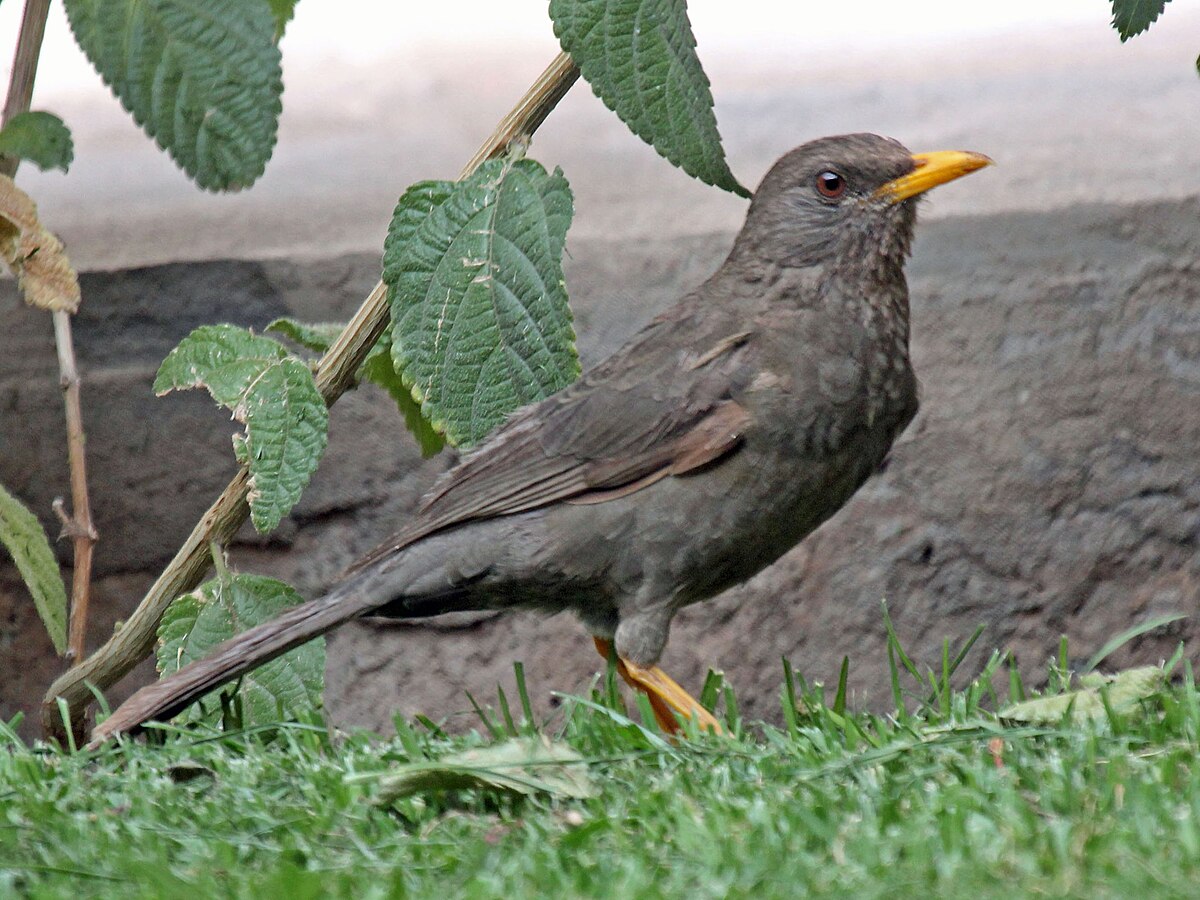
Wikipedia: Chiguanco thrush Source: OTHER
1200px-Chiguanco_Thrush_RWD5.jpg
![]() The Chiguanco thrush (Turdus chiguanco) is a species of bird in the family Turdidae. It is found in Ecuador and the Altiplano. Its natural habitats are subtropical or tropical high-altitude shrubland and heavily degraded former forest.
[more]
The Chiguanco thrush (Turdus chiguanco) is a species of bird in the family Turdidae. It is found in Ecuador and the Altiplano. Its natural habitats are subtropical or tropical high-altitude shrubland and heavily degraded former forest.
[more]
Hauxwell's thrush (Turdus hauxwelli)
Profile Wikipedia eBird Xeno-Canto

Wikipedia: Hauxwell's thrush Source: OTHER
Turdus_hauxwelli.jpg
![]() Hauxwell's thrush (Turdus hauxwelli) is a species of bird in the family Turdidae. It is found in Bolivia, Brazil, Colombia, Ecuador, Peru, and Venezuela.
[more]
Hauxwell's thrush (Turdus hauxwelli) is a species of bird in the family Turdidae. It is found in Bolivia, Brazil, Colombia, Ecuador, Peru, and Venezuela.
[more]
White-necked thrush / Trauerdrossel (Turdus albicollis)
Profile Wikipedia eBird Xeno-Canto

Wikipedia: White-necked thrush Source: OTHER
1200px-Turdus_albicollis.jpg
![]() The white-necked thrush (Turdus albicollis) is a songbird found in forest and woodland in South America. The taxonomy is potentially confusing, and it sometimes includes the members of the T. assimilis group as subspecies, in which case the "combined species" is referred to as the white-throated thrush (a name limited to T. assimilis when the two are split). On the contrary, it may be split into two species, the rufous-flanked thrush (T. albicollis) and the grey-flanked thrush (T. phaeopygos).
[more]
The white-necked thrush (Turdus albicollis) is a songbird found in forest and woodland in South America. The taxonomy is potentially confusing, and it sometimes includes the members of the T. assimilis group as subspecies, in which case the "combined species" is referred to as the white-throated thrush (a name limited to T. assimilis when the two are split). On the contrary, it may be split into two species, the rufous-flanked thrush (T. albicollis) and the grey-flanked thrush (T. phaeopygos).
[more]
Ecuadorian thrush (Turdus maculirostris)
Profile Wikipedia eBird Xeno-Canto

Wikipedia: Ecuadorian thrush Source: OTHER
Turdus_maculirostris_-NW_Ecuador-6.jpg
![]() The Ecuadorian thrush (Turdus maculirostris) is a resident bird found in western South America in western Ecuador and far northwestern Peru. It was formerly considered to be a subspecies of the spectacled thrush (yellow-eyed thrush), Turdus nudigenis, but has a narrower eyering, and is widely separated in range.
[more]
The Ecuadorian thrush (Turdus maculirostris) is a resident bird found in western South America in western Ecuador and far northwestern Peru. It was formerly considered to be a subspecies of the spectacled thrush (yellow-eyed thrush), Turdus nudigenis, but has a narrower eyering, and is widely separated in range.
[more]
Glossy-black thrush (Turdus serranus)
Profile Wikipedia eBird Xeno-Canto
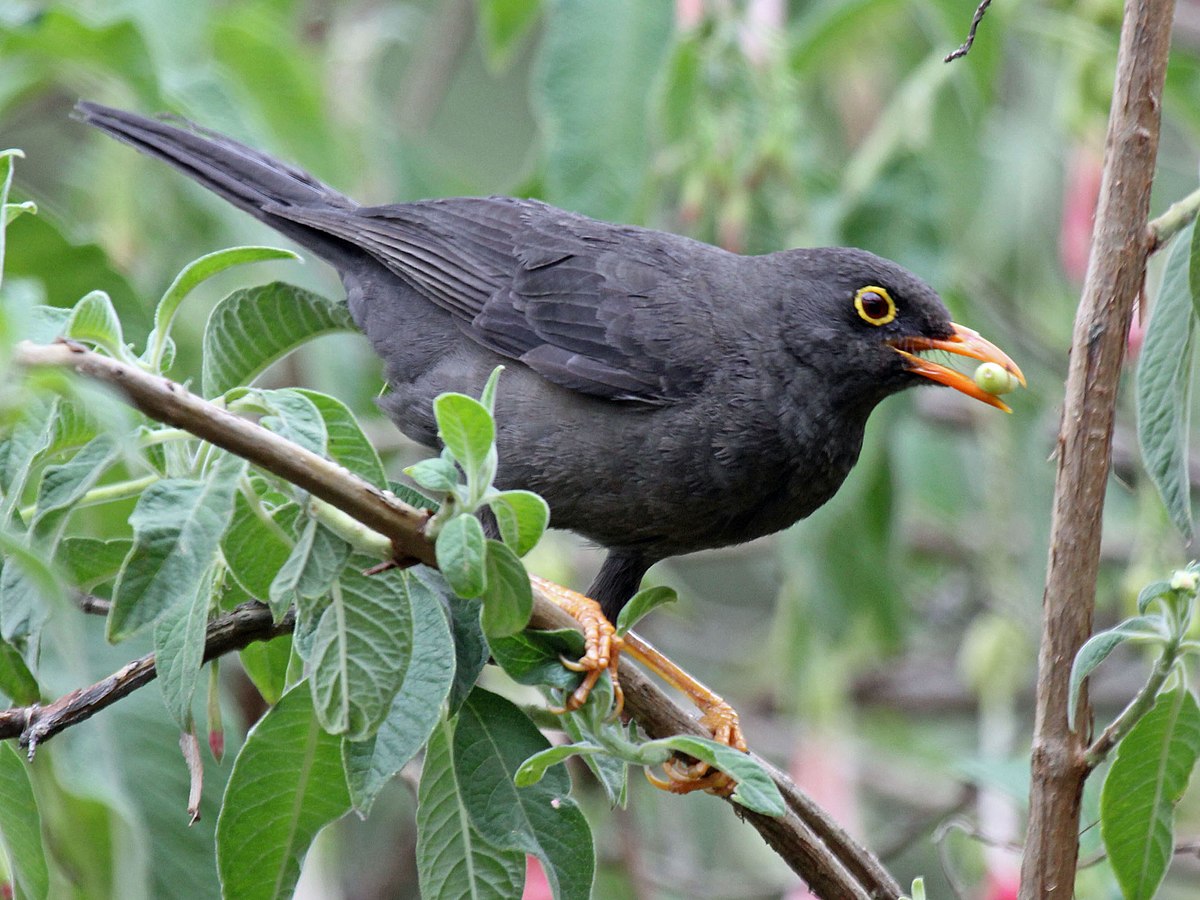
Wikipedia: Glossy-black thrush Source: OTHER
1200px-Glossy-black_Thrush_RWD3.jpg
![]() The glossy-black thrush (Turdus serranus) is a species of bird in the family Turdidae. It is found from northern Venezuela to northwestern Argentina. Its natural habitat is subtropical or tropical moist montane forests.
[more]
The glossy-black thrush (Turdus serranus) is a species of bird in the family Turdidae. It is found from northern Venezuela to northwestern Argentina. Its natural habitat is subtropical or tropical moist montane forests.
[more]
Pale-eyed thrush (Turdus leucops)
![]() The pale-eyed thrush (Turdus leucops) is a species of bird in the family Turdidae.
[more]
The pale-eyed thrush (Turdus leucops) is a species of bird in the family Turdidae.
[more]
Andean slaty thrush (Turdus nigriceps)
Profile Wikipedia eBird Xeno-Canto
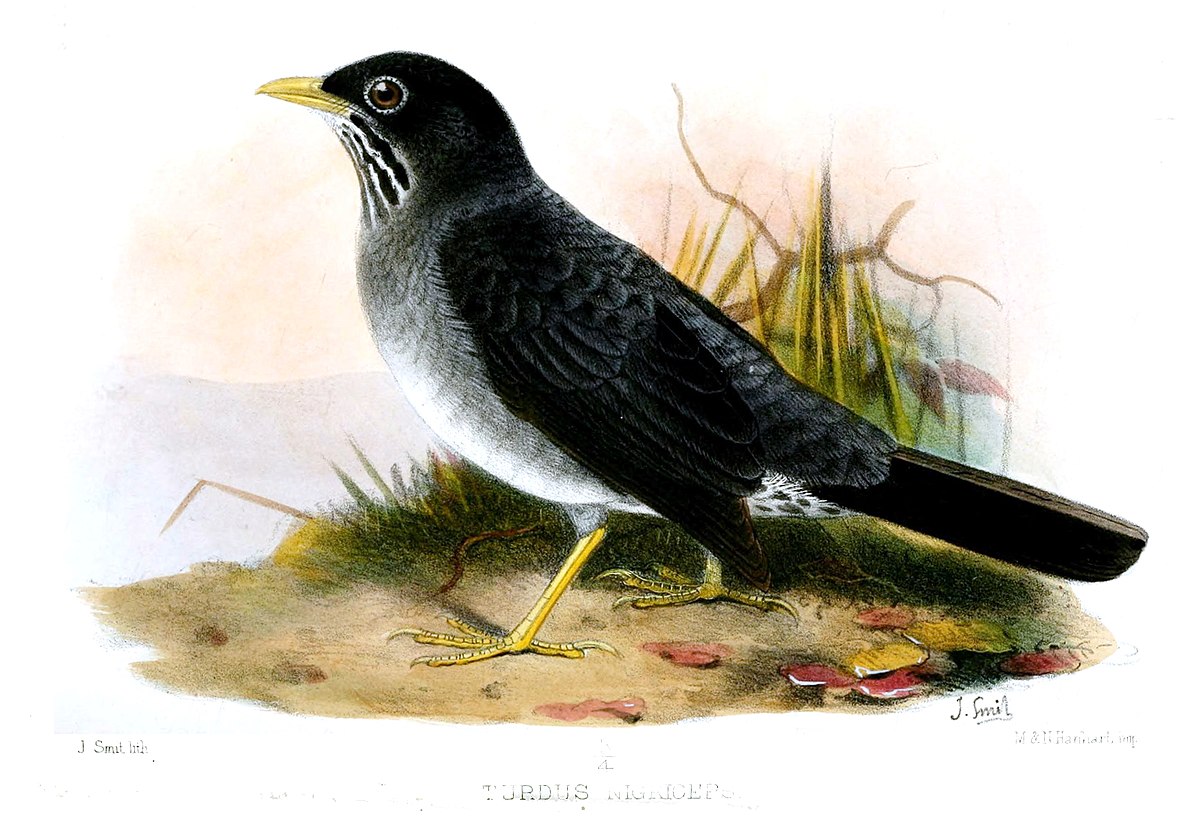
Wikipedia: Andean slaty thrush Source: OTHER
1200px-TurdusNigricepsSmit.jpg
![]() The Andean slaty thrush (Turdus nigriceps) is a species of bird in the family Turdidae.
[more]
The Andean slaty thrush (Turdus nigriceps) is a species of bird in the family Turdidae.
[more]
Chestnut-bellied thrush (Turdus fulviventris)
Profile Wikipedia eBird Xeno-Canto

Wikipedia: Chestnut-bellied thrush Source: OTHER
1200px-Chestnut-bellied_Thrush_%285304204959%29.jpg
![]() The chestnut-bellied thrush (Turdus fulviventris) is a species of bird in the family Turdidae. It is found in Colombia, Ecuador, Peru, and Venezuela. Its natural habitats are subtropical or tropical moist montane forests and heavily degraded former forest.
[more]
The chestnut-bellied thrush (Turdus fulviventris) is a species of bird in the family Turdidae. It is found in Colombia, Ecuador, Peru, and Venezuela. Its natural habitats are subtropical or tropical moist montane forests and heavily degraded former forest.
[more]
Plumbeous-backed thrush (Turdus reevei)
Profile Wikipedia eBird Xeno-Canto
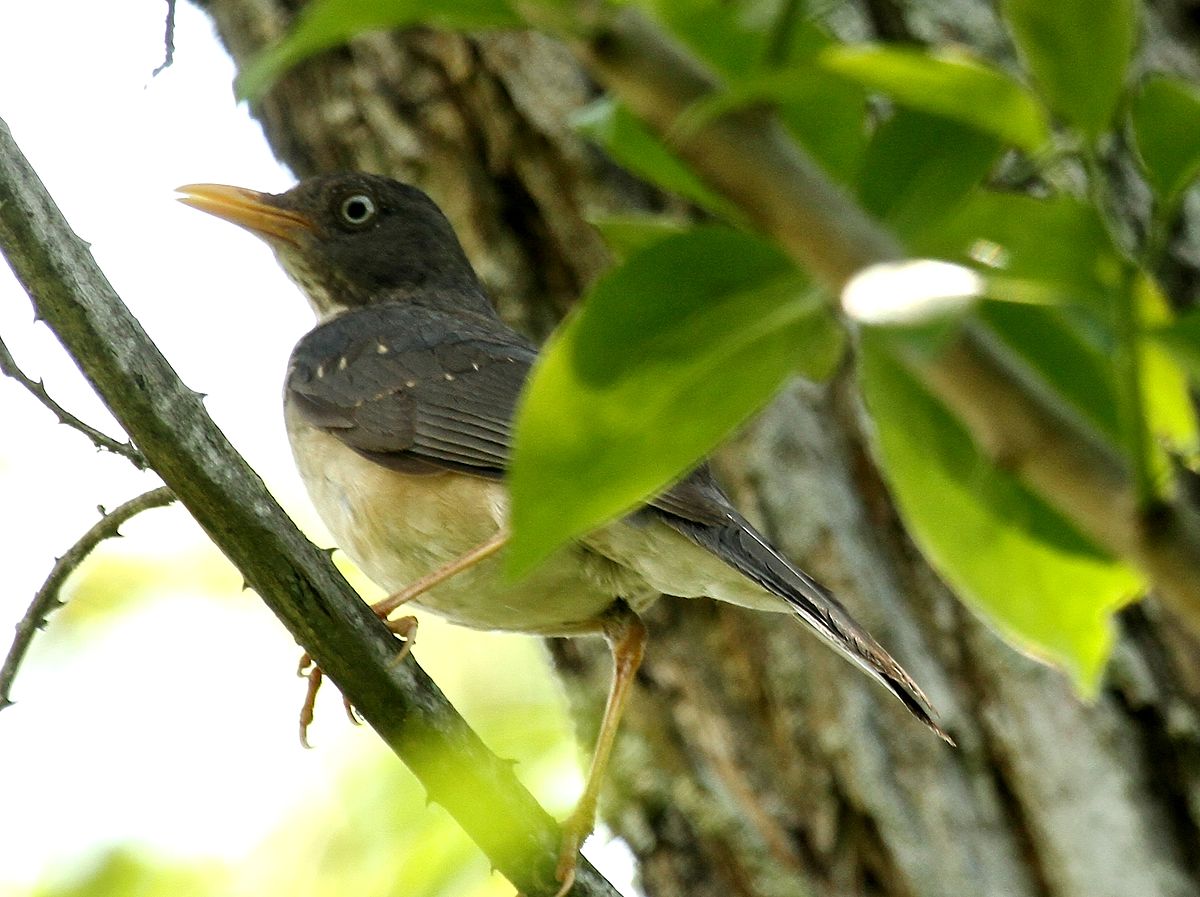
Wikipedia: Plumbeous-backed thrush Source: OTHER
1200px-Plumbeous-backedThrush.jpg
![]() The plumbeous-backed thrush (Turdus reevei) is a species of bird in the family Turdidae. It is found in Ecuador and Peru. Its natural habitats are subtropical or tropical dry forests, subtropical or tropical moist lowland forests, and subtropical or tropical moist montane forests.
[more]
The plumbeous-backed thrush (Turdus reevei) is a species of bird in the family Turdidae. It is found in Ecuador and Peru. Its natural habitats are subtropical or tropical dry forests, subtropical or tropical moist lowland forests, and subtropical or tropical moist montane forests.
[more]
Lawrence's thrush (Turdus lawrencii)
Profile Wikipedia eBird Xeno-Canto

Wikipedia: Lawrence's thrush Source: OTHER
1200px-TurdusLawrenciiKeulemans.jpg
![]() Lawrence's thrush (Turdus lawrencii) is a species of bird in the family Turdidae. It is found in Bolivia, Brazil, Colombia, Ecuador, Peru, and Venezuela. Described in 1878 by George N. Lawrence as Turdus brunneus, a name that was already in use (by Brewer, 1852 and used for Turdus rufescens) the species was therefore renamed as Turdus lawrencii by Elliott Coues in 1880.[2][3] Its natural habitats are subtropical or tropical moist lowland forests and subtropical or tropical swamps.
[more]
Lawrence's thrush (Turdus lawrencii) is a species of bird in the family Turdidae. It is found in Bolivia, Brazil, Colombia, Ecuador, Peru, and Venezuela. Described in 1878 by George N. Lawrence as Turdus brunneus, a name that was already in use (by Brewer, 1852 and used for Turdus rufescens) the species was therefore renamed as Turdus lawrencii by Elliott Coues in 1880.[2][3] Its natural habitats are subtropical or tropical moist lowland forests and subtropical or tropical swamps.
[more]
Andean solitaire (Myadestes ralloides)

Wikipedia: Andean solitaire Source: OTHER
1200px-Myadestes_ralloides_75757649.jpg
![]() The Andean solitaire (Myadestes ralloides) is a species of bird in the family Turdidae. It is found in Bolivia, Colombia, Ecuador, Peru, and Venezuela. Its natural habitats are subtropical or tropical moist montane forests and heavily degraded former forest.
[more]
The Andean solitaire (Myadestes ralloides) is a species of bird in the family Turdidae. It is found in Bolivia, Colombia, Ecuador, Peru, and Venezuela. Its natural habitats are subtropical or tropical moist montane forests and heavily degraded former forest.
[more]
Black solitaire (Entomodestes coracinus)
Profile Wikipedia eBird Xeno-Canto

Wikipedia: Black solitaire Source: OTHER
1200px-MyiadestesCoracinusKeulemans.jpg
![]() The black solitaire (Entomodestes coracinus) is a species of bird in the family Turdidae. It is found in Colombia and Ecuador. Its natural habitats are subtropical or tropical moist lowland forests and subtropical or tropical moist montane forests.
[more]
The black solitaire (Entomodestes coracinus) is a species of bird in the family Turdidae. It is found in Colombia and Ecuador. Its natural habitats are subtropical or tropical moist lowland forests and subtropical or tropical moist montane forests.
[more]
Rufous-brown solitaire (Cichlopsis leucogenys)
Profile Wikipedia eBird Xeno-Canto

Wikipedia: Rufous-brown solitaire Source: OTHER
CichlopsisLeucogonysSmit.jpg
![]() The rufous-brown solitaire (Cichlopsis leucogenys) is a species of bird in the family Turdidae. It is found in Brazil, Colombia, Ecuador, Guyana, Peru, Suriname, and Venezuela. Its natural habitats are subtropical or tropical moist lowland forest and subtropical or tropical moist montane forest.
[more]
The rufous-brown solitaire (Cichlopsis leucogenys) is a species of bird in the family Turdidae. It is found in Brazil, Colombia, Ecuador, Guyana, Peru, Suriname, and Venezuela. Its natural habitats are subtropical or tropical moist lowland forest and subtropical or tropical moist montane forest.
[more]
Acadian flycatcher / Buchentyrann (Empidonax virescens)
Profile Wikipedia eBird Audubon AllAboutBirds Xeno-Canto
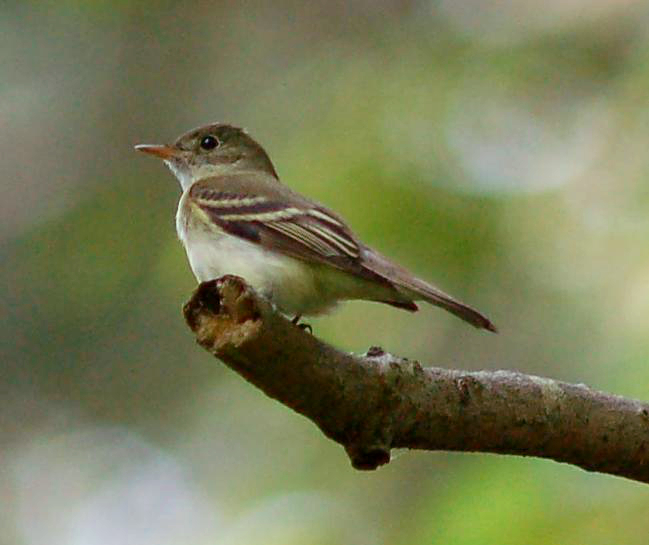
Wikipedia: Acadian flycatcher Source: OTHER
Acadian_Flycatcher.jpg
![]() The Acadian flycatcher (Empidonax virescens) is a small insect-eating bird of the tyrant flycatcher family.
[more]
The Acadian flycatcher (Empidonax virescens) is a small insect-eating bird of the tyrant flycatcher family.
[more]
Alder flycatcher (Empidonax alnorum)
Profile Wikipedia eBird Audubon AllAboutBirds Xeno-Canto

Wikipedia: Alder flycatcher Source: OTHER
1200px-Empidonax_alnorum_CT2.jpg
![]() The alder flycatcher (Empidonax alnorum) is a small insect-eating bird of the tyrant flycatcher family. The genus name Empidonax is from Ancient Greek empis, "gnat", and anax, "master". The specific alnorum is Latin and means "of the alders".[2]
[more]
The alder flycatcher (Empidonax alnorum) is a small insect-eating bird of the tyrant flycatcher family. The genus name Empidonax is from Ancient Greek empis, "gnat", and anax, "master". The specific alnorum is Latin and means "of the alders".[2]
[more]
Willow flycatcher (Empidonax traillii)
Profile Wikipedia eBird A-Z Animals Audubon AllAboutBirds Xeno-Canto

Wikipedia: Willow flycatcher Source: OTHER
Southwestern_Willow_Flycatcher.jpg
![]() The willow flycatcher (Empidonax traillii) is a small insect-eating, neotropical migrant bird of the tyrant flycatcher family. There are four subspecies of the willow flycatcher currently recognized, all of which breed in North America (including three subspecies that breed in California).[2] Empidonax flycatchers are almost impossible to tell apart in the field so biologists use their songs to distinguish between them.[3] The binomial commemorates the Scottish zoologist Thomas Stewart Traill.
[more]
The willow flycatcher (Empidonax traillii) is a small insect-eating, neotropical migrant bird of the tyrant flycatcher family. There are four subspecies of the willow flycatcher currently recognized, all of which breed in North America (including three subspecies that breed in California).[2] Empidonax flycatchers are almost impossible to tell apart in the field so biologists use their songs to distinguish between them.[3] The binomial commemorates the Scottish zoologist Thomas Stewart Traill.
[more]
Eastern kingbird / Königstyrann (Tyrannus tyrannus)
Profile Wikipedia eBird A-Z Animals Audubon AllAboutBirds Xeno-Canto
Eastern kingbird. 2022-04-29 12.54.00 Maryland
First observed in Maryland on 2021-06-14.
![]() Lanius tyrannus Linnaeus, 1758
[more]
Lanius tyrannus Linnaeus, 1758
[more]
Tropical kingbird / Trauertyrann (Tyrannus melancholicus)
Profile Wikipedia eBird Audubon AllAboutBirds Xeno-Canto
Tropical kingbird tenative ID by MerlinBirdID, tail markings. 2018-02-16 16.21.26 Costa Rica
First observed in Costa Rica on 2018-02-16.
![]() The tropical kingbird (Tyrannus melancholicus) is a large tyrant flycatcher. This bird breeds from southern Arizona and the lower Rio Grande Valley of Texas in the United States through Central America, South America as far as south as central Argentina and eastern Peru, and on Trinidad and Tobago. Birds from the northernmost and southern breeding areas migrate to warmer parts of the range after breeding.
[more]
The tropical kingbird (Tyrannus melancholicus) is a large tyrant flycatcher. This bird breeds from southern Arizona and the lower Rio Grande Valley of Texas in the United States through Central America, South America as far as south as central Argentina and eastern Peru, and on Trinidad and Tobago. Birds from the northernmost and southern breeding areas migrate to warmer parts of the range after breeding.
[more]
Fork-tailed flycatcher (Tyrannus savana)
Profile Wikipedia eBird Audubon AllAboutBirds Xeno-Canto

Wikipedia: Fork-tailed flycatcher Source: OTHER
1200px-Fork-tailed_flycatcher_%28Tyrannus_savana_monachus%29_female.jpg
![]() The fork-tailed flycatcher (Tyrannus savana) is a passerine bird of the tyrant flycatcher family, and is the member of a genus typically referred to as kingbirds. Named for their distinguishingly long forked tail, fork-tailed flycatchers are seen in lightly-forested or grassland areas; ranging from southern Mexico, to south past Argentina. They are most frequently observed sitting on conspicuous perches waiting for flying arthropods to fly past, they then sally out, eat their prey, and return to their perch. Northern populations near southern Mexico tend to be permanent residents, while fork-tailed flycatchers that live further south are migrants with a reputation to wander as far north as the eastern seaboard of the United States.
[more]
The fork-tailed flycatcher (Tyrannus savana) is a passerine bird of the tyrant flycatcher family, and is the member of a genus typically referred to as kingbirds. Named for their distinguishingly long forked tail, fork-tailed flycatchers are seen in lightly-forested or grassland areas; ranging from southern Mexico, to south past Argentina. They are most frequently observed sitting on conspicuous perches waiting for flying arthropods to fly past, they then sally out, eat their prey, and return to their perch. Northern populations near southern Mexico tend to be permanent residents, while fork-tailed flycatchers that live further south are migrants with a reputation to wander as far north as the eastern seaboard of the United States.
[more]
White-throated kingbird (Tyrannus albogularis)
Profile Wikipedia eBird Xeno-Canto

Wikipedia: White-throated kingbird Source: OTHER
1200px-Tyrannus_albogularis_-_White-throated_Flycatcher%3B_Iranduba%2C_Amazonas%2C_Brazil.jpg
![]() The white-throated kingbird (Tyrannus albogularis) is a species of bird in the family Tyrannidae, the tyrant flycatchers.
It is found in Bolivia, Brazil, Colombia, Ecuador, Peru, and Venezuela, and in the Guianas of Guyana, Suriname and French Guiana.
Its natural habitats are subtropical or tropical moist lowland forests and subtropical or tropical moist shrubland.
[more]
The white-throated kingbird (Tyrannus albogularis) is a species of bird in the family Tyrannidae, the tyrant flycatchers.
It is found in Bolivia, Brazil, Colombia, Ecuador, Peru, and Venezuela, and in the Guianas of Guyana, Suriname and French Guiana.
Its natural habitats are subtropical or tropical moist lowland forests and subtropical or tropical moist shrubland.
[more]
Snowy-throated kingbird (Tyrannus niveigularis)
Profile Wikipedia eBird Xeno-Canto

Wikipedia: Snowy-throated kingbird Source: OTHER
1200px-TyrannusNiveigularisSmit.jpg
![]() The snowy-throated kingbird (Tyrannus niveigularis) is a species of bird in the family Tyrannidae.
It is found in Colombia, Ecuador, and Peru.
Its natural habitats are subtropical or tropical moist lowland forests and subtropical or tropical dry shrubland.
[more]
The snowy-throated kingbird (Tyrannus niveigularis) is a species of bird in the family Tyrannidae.
It is found in Colombia, Ecuador, and Peru.
Its natural habitats are subtropical or tropical moist lowland forests and subtropical or tropical dry shrubland.
[more]
Black phoebe / Schwarzkopf-Phoebetyrann (Sayornis nigricans)
Profile Wikipedia eBird Audubon AllAboutBirds Xeno-Canto
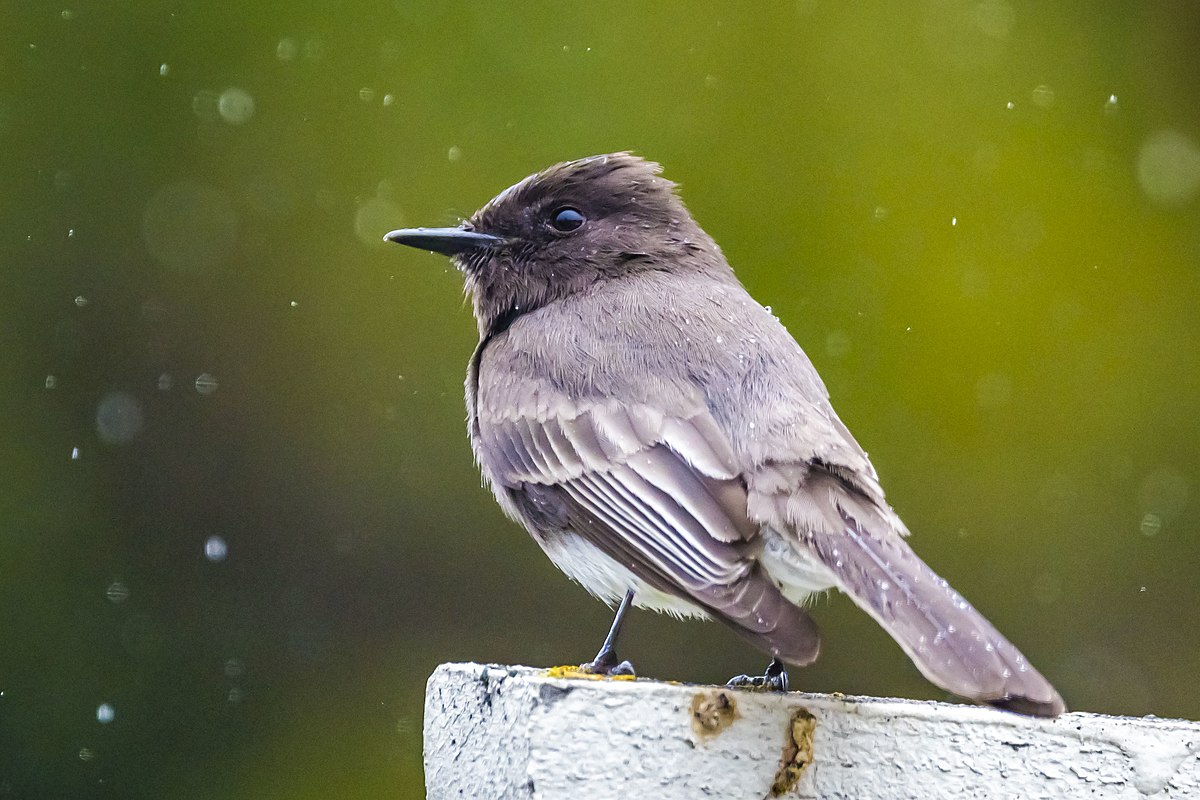
Wikipedia: Black phoebe Source: OTHER
1200px-Black_Phoebe_in_the_Rain.jpg
![]() The black phoebe (Sayornis nigricans) is a passerine bird in the tyrant-flycatcher family. It breeds from southwest Oregon and California south through Central and South America. It occurs year-round throughout most of its range and migrates less than the other birds in its genus, though its northern populations are partially migratory. Six subspecies are commonly recognized, although two are occasionally combined as a separate species, the white-winged phoebe.
[more]
The black phoebe (Sayornis nigricans) is a passerine bird in the tyrant-flycatcher family. It breeds from southwest Oregon and California south through Central and South America. It occurs year-round throughout most of its range and migrates less than the other birds in its genus, though its northern populations are partially migratory. Six subspecies are commonly recognized, although two are occasionally combined as a separate species, the white-winged phoebe.
[more]
Tufted tit-tyrant (Anairetes parulus)
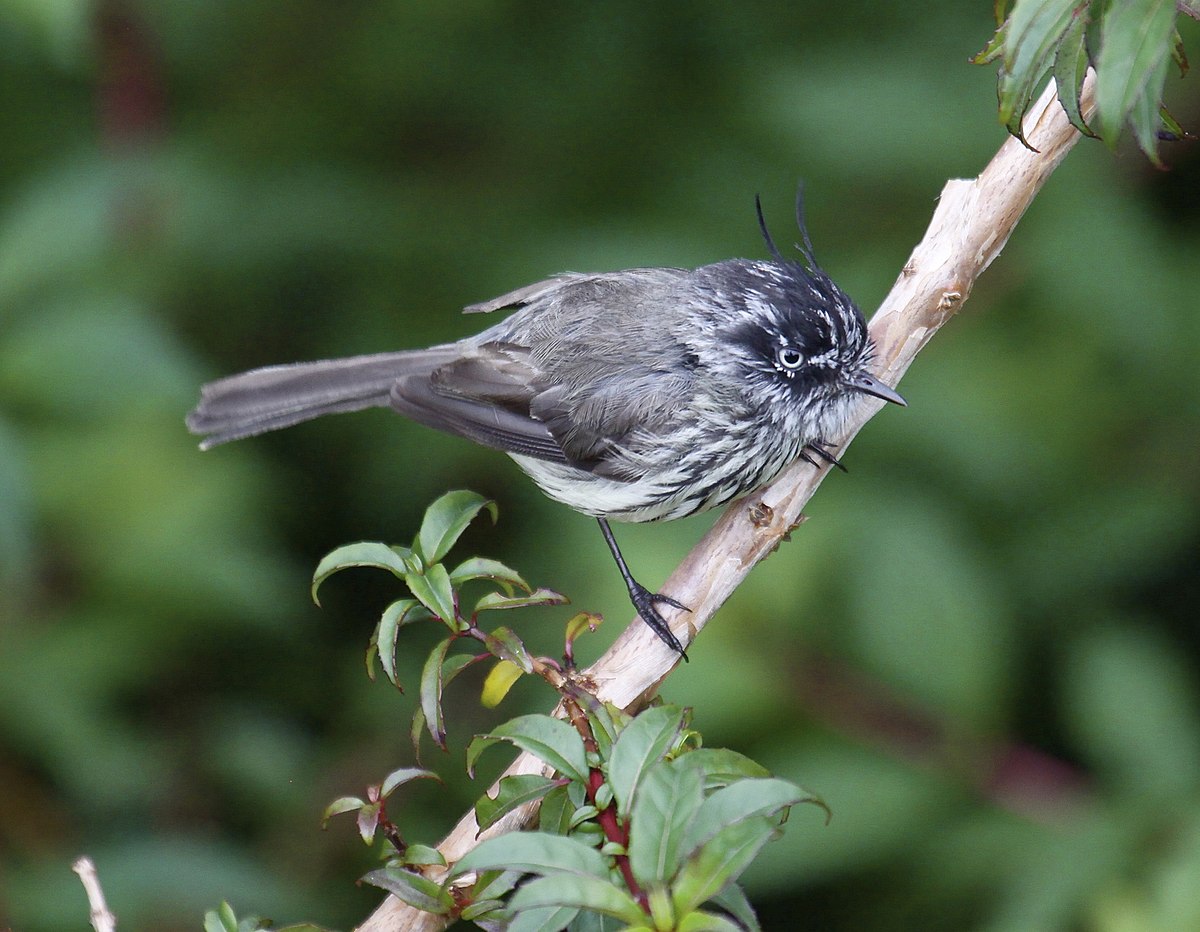
Wikipedia: Tufted tit-tyrant Source: OTHER
1200px-Tufted_Tit-Tyrant.jpg
![]() The tufted tit-tyrant (Anairetes parulus) is a species of bird in the tyrant flycatcher family Tyrannidae. This species is found in western South America; its range stretches from southern Colombia south along the Andes mountains to Tierra del Fuego. It prefers to live in upper montane forests and shrublands; however, it is a habitat generalist and can be found across a wide range of ecosystems. The tufted tit-tyrant has three subspecies, including the nominate subspecies Anairetes parulus parulus, A. p. aequatorialis, and A. p. patagonicus, and is very closely related to the Juan Fernández tit-tyrant. It is very small with a distinctive and conspicuous crest. The bird's head is black overall with white supraloral and postocular stripes. Its dull grayish-brown back contrasts with its white throat and breast that are covered with black streaks and pale, unmarked yellow underbelly. There are few noticeable differences in plumage between the subspecies. It is a vocal flycatcher with a broad repertoire of songs.
[more]
The tufted tit-tyrant (Anairetes parulus) is a species of bird in the tyrant flycatcher family Tyrannidae. This species is found in western South America; its range stretches from southern Colombia south along the Andes mountains to Tierra del Fuego. It prefers to live in upper montane forests and shrublands; however, it is a habitat generalist and can be found across a wide range of ecosystems. The tufted tit-tyrant has three subspecies, including the nominate subspecies Anairetes parulus parulus, A. p. aequatorialis, and A. p. patagonicus, and is very closely related to the Juan Fernández tit-tyrant. It is very small with a distinctive and conspicuous crest. The bird's head is black overall with white supraloral and postocular stripes. Its dull grayish-brown back contrasts with its white throat and breast that are covered with black streaks and pale, unmarked yellow underbelly. There are few noticeable differences in plumage between the subspecies. It is a vocal flycatcher with a broad repertoire of songs.
[more]
Black-crested tit-tyrant (Anairetes nigrocristatus)
Profile Wikipedia eBird Xeno-Canto
Wikipedia: Black-crested tit-tyrant Source: OTHER
Black-crested_Tit-tyrant.JPG
![]() The black-crested tit-tyrant or Marañón tit-tyrant (Anairetes nigrocristatus) is a species of bird in the family Tyrannidae. It is found in Ecuador and Peru. Its natural habitats are subtropical or tropical moist montane forests and subtropical or tropical high-altitude shrubland.
[more]
The black-crested tit-tyrant or Marañón tit-tyrant (Anairetes nigrocristatus) is a species of bird in the family Tyrannidae. It is found in Ecuador and Peru. Its natural habitats are subtropical or tropical moist montane forests and subtropical or tropical high-altitude shrubland.
[more]
Lesser wagtail-tyrant (Stigmatura napensis)
Profile Wikipedia eBird Xeno-Canto

Wikipedia: Lesser wagtail-tyrant Source: OTHER
1200px-Stigmatura_napensis_-_Lesser_wagtail_tyrant.JPG
![]() The lesser wagtail-tyrant (Stigmatura napensis) is a small South American species of bird in the family Tyrannidae. It occurs in two distinct populations: One found in wooded and shrubby habitats along major Amazonian rivers in Brazil, Peru, Ecuador and Colombia, and a second found in the comparable far drier northeastern Brazil. The latter is sometimes considered a separate species, the Bahian wagtail-tyrant (S. bahiae), named after the state Bahia, where the majority of its range is.
[more]
The lesser wagtail-tyrant (Stigmatura napensis) is a small South American species of bird in the family Tyrannidae. It occurs in two distinct populations: One found in wooded and shrubby habitats along major Amazonian rivers in Brazil, Peru, Ecuador and Colombia, and a second found in the comparable far drier northeastern Brazil. The latter is sometimes considered a separate species, the Bahian wagtail-tyrant (S. bahiae), named after the state Bahia, where the majority of its range is.
[more]
Agile tit-tyrant (Uromyias agilis)

Wikipedia: Agile tit-tyrant Source: OTHER
Anairetes_agilis.jpg
![]() The agile tit-tyrant (Uromyias agilis) is a species of bird in the family Tyrannidae, the tyrant flycatchers. It is native to Bolivia, Colombia, Ecuador, and Venezuela.[1]
[more]
The agile tit-tyrant (Uromyias agilis) is a species of bird in the family Tyrannidae, the tyrant flycatchers. It is native to Bolivia, Colombia, Ecuador, and Venezuela.[1]
[more]
Yellow-bellied elaenia (Elaenia flavogaster)
Profile Wikipedia eBird Xeno-Canto

Wikipedia: Yellow-bellied elaenia Source: OTHER
Flickr_-_Dario_Sanches_-_GUARACAVA-DE-BARRIGA-AMARELA_%28Elaenia_flavogaster%29.jpg
![]() The yellow-bellied elaenia (Elaenia flavogaster) is a small bird of the tyrant flycatcher family. It breeds from southern Mexico and the Yucatán Peninsula through Central and South America as far as northern Argentina, and on Trinidad and Tobago.
[more]
The yellow-bellied elaenia (Elaenia flavogaster) is a small bird of the tyrant flycatcher family. It breeds from southern Mexico and the Yucatán Peninsula through Central and South America as far as northern Argentina, and on Trinidad and Tobago.
[more]
Lesser elaenia (Elaenia chiriquensis)
Profile Wikipedia eBird Xeno-Canto
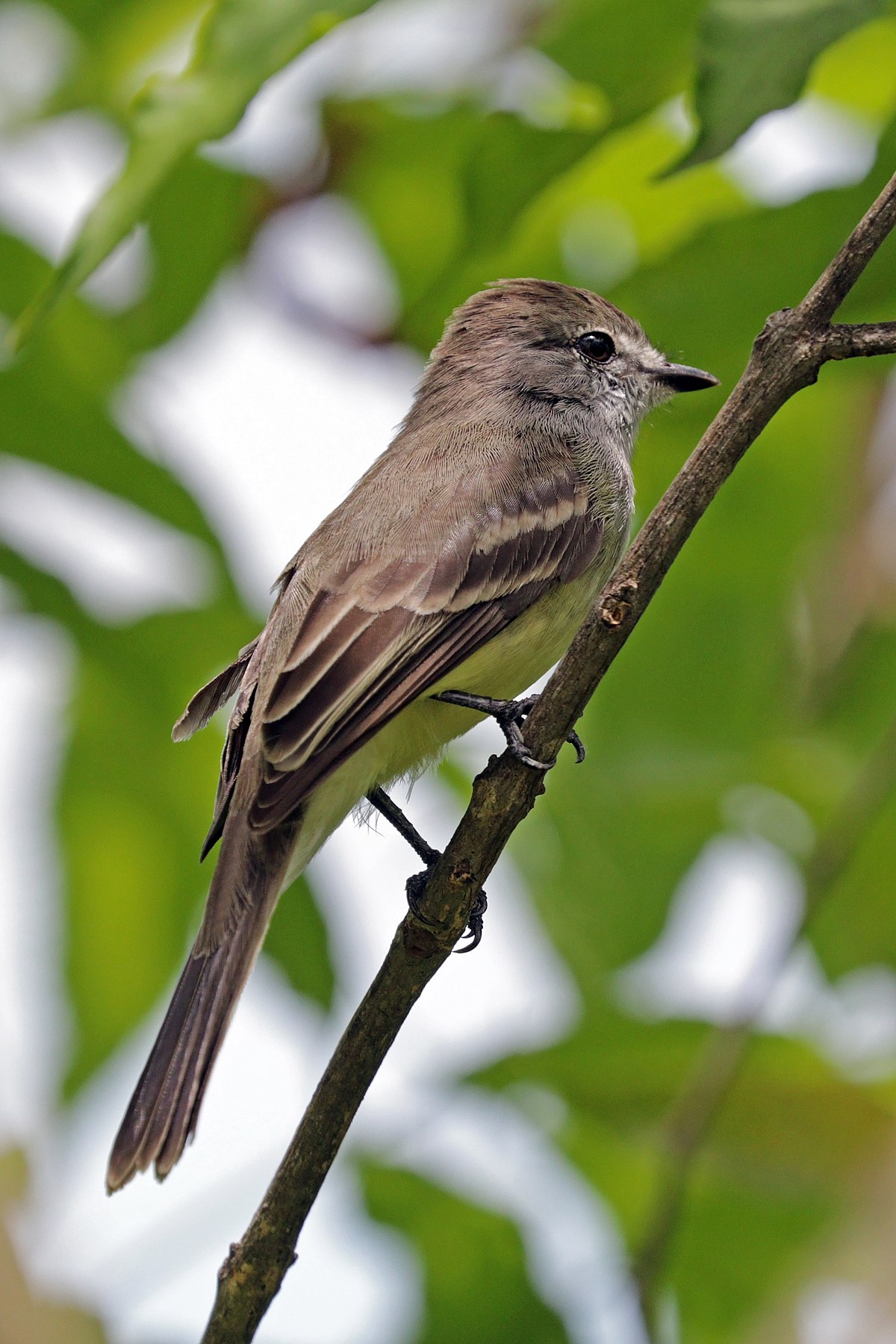
Wikipedia: Lesser elaenia Source: OTHER
1200px-Lesser_elaenia_%28Elaenia_chiriquensis_chiriquensis%29.jpg
![]() The lesser elaenia (Elaenia chiriquensis) is a species of bird in the family Tyrannidae, the tyrant flycatchers.
[more]
The lesser elaenia (Elaenia chiriquensis) is a species of bird in the family Tyrannidae, the tyrant flycatchers.
[more]
Sierran elaenia (Elaenia pallatangae)
Profile Wikipedia eBird Xeno-Canto
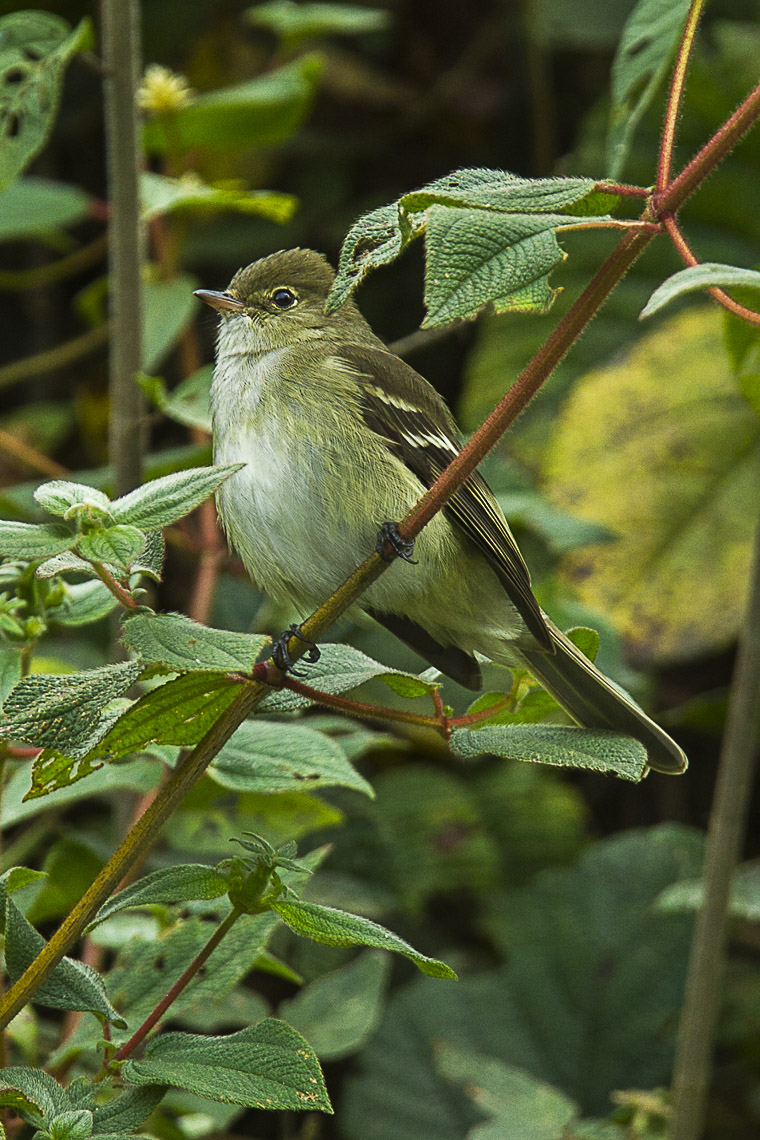
Wikipedia: Sierran elaenia Source: OTHER
Sierran_Elaenia_-_South_Ecuador.jpg
![]() The sierran elaenia (Elaenia pallatangae) is a species of bird in the family Tyrannidae.
[more]
The sierran elaenia (Elaenia pallatangae) is a species of bird in the family Tyrannidae.
[more]
Highland elaenia (Elaenia obscura)
Profile Wikipedia eBird Xeno-Canto

Wikipedia: Highland elaenia Source: OTHER
Highland_Elaenia_%28Elaenia_obscura%29_%288077622933%29.jpg
![]() The highland elaenia (Elaenia obscura) is a species of bird in the family Tyrannidae, the tyrant flycatchers. It is found in southeastern Ecuador to Bolivia and northwestern Argentina
[more]
The highland elaenia (Elaenia obscura) is a species of bird in the family Tyrannidae, the tyrant flycatchers. It is found in southeastern Ecuador to Bolivia and northwestern Argentina
[more]
Small-billed elaenia (Elaenia parvirostris)
Profile Wikipedia eBird Xeno-Canto
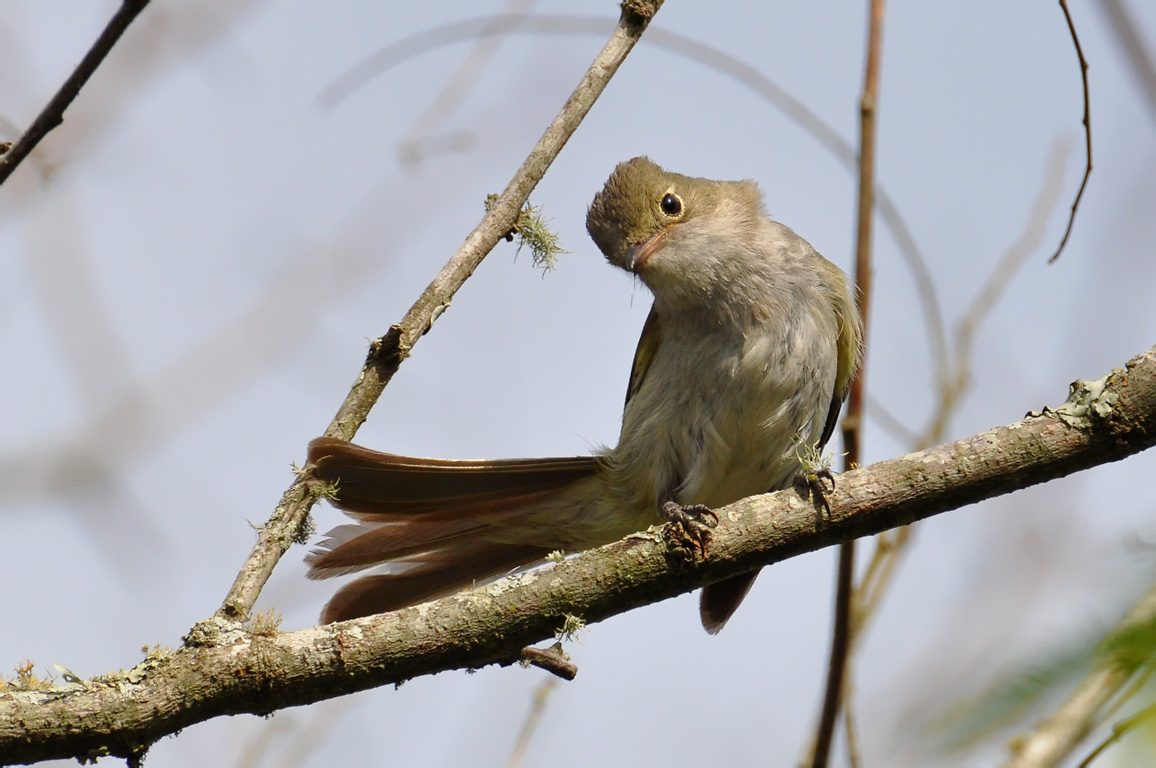
Wikipedia: Small-billed elaenia Source: OTHER
Elaenia_parvirostris_-Capao_do_Leao%2C_Rio_Grande_do_Sul%2C_Brasil-8.jpg
![]() The small-billed elaenia (Elaenia parvirostris) is a species of bird in the family Tyrannidae.
[more]
The small-billed elaenia (Elaenia parvirostris) is a species of bird in the family Tyrannidae.
[more]
White-crested elaenia (Elaenia albiceps)
Profile Wikipedia eBird Xeno-Canto

Wikipedia: White-crested elaenia Source: OTHER
1200px-White-crested_Elaenia_%28Elaenia_albiceps%29_%2815934867376%29.jpg
![]() The white-crested elaenia (Elaenia albiceps) is a species of bird in the family Tyrannidae, the tyrant flycatchers. It has several subspecies breeding across southern and western parts of South America. Southern birds migrate north in winter.
[more]
The white-crested elaenia (Elaenia albiceps) is a species of bird in the family Tyrannidae, the tyrant flycatchers. It has several subspecies breeding across southern and western parts of South America. Southern birds migrate north in winter.
[more]
Coopmans's elaenia (Elaenia brachyptera)

Wikipedia: Coopmans's elaenia Source: OTHER
1200px-Elaenia_brachyptera_map.svg.png
![]() Coopmans's elaenia (Elaenia brachyptera) is a species of bird in the family Tyrannidae, the tyrant flycatchers.
[more]
Coopmans's elaenia (Elaenia brachyptera) is a species of bird in the family Tyrannidae, the tyrant flycatchers.
[more]
Mottle-backed elaenia (Elaenia gigas)
Profile Wikipedia eBird Xeno-Canto

Wikipedia: Mottle-backed elaenia Source: OTHER
Mottle-backedElaenia.jpg
![]() The mottle-backed elaenia (Elaenia gigas) is a species of bird in the family Tyrannidae. It is found in Bolivia, Colombia, Ecuador, and Peru.
[more]
The mottle-backed elaenia (Elaenia gigas) is a species of bird in the family Tyrannidae. It is found in Bolivia, Colombia, Ecuador, and Peru.
[more]
Large elaenia (Elaenia spectabilis)
Profile Wikipedia eBird Xeno-Canto

Wikipedia: Large elaenia Source: OTHER
Elaenia_spectabilis.jpeg
![]() The large elaenia (Elaenia spectabilis) is a species of bird in the family Tyrannidae. It is found in South America from western Amazonia to eastern Brazil and central Bolivia.[2] Its natural habitats are subtropical or tropical moist lowland forest and heavily degraded former forest.
[more]
The large elaenia (Elaenia spectabilis) is a species of bird in the family Tyrannidae. It is found in South America from western Amazonia to eastern Brazil and central Bolivia.[2] Its natural habitats are subtropical or tropical moist lowland forest and heavily degraded former forest.
[more]
Cinnamon becard (Pachyramphus cinnamomeus)
Profile Wikipedia eBird Xeno-Canto

Wikipedia: Cinnamon becard Source: OTHER
Flickr_-_Rainbirder_-_Cinnamon_Becard_%28Pachyramphus_cinnamomeus%29_%281%29_%28cropped%29.jpg
![]() The cinnamon becard (Pachyramphus cinnamomeus) is a passerine bird found in Latin America.
[more]
The cinnamon becard (Pachyramphus cinnamomeus) is a passerine bird found in Latin America.
[more]
Barred becard (Pachyramphus versicolor)
Profile Wikipedia eBird Xeno-Canto
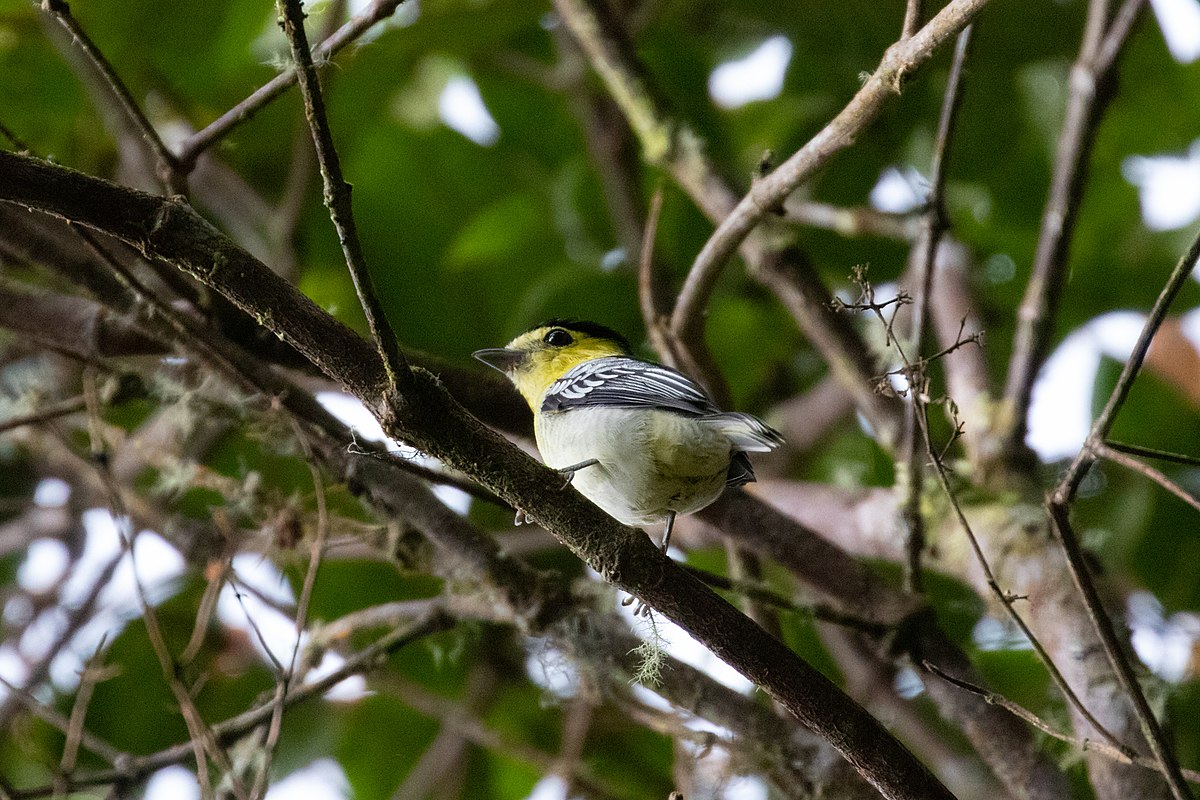
Wikipedia: Barred becard Source: OTHER
1200px-Pachyramphus_versicolor_70264620.jpg
![]() The barred becard (Pachyramphus versicolor) is a small passerine bird which is a resident breeding species in highlands from Costa Rica to northwestern Ecuador and northern Bolivia. It has traditionally been placed in Cotingidae or Tyrannidae, but evidence strongly suggests it belongs in Tityridae, where it is now placed by the South American Classification Committee.[2]
[more]
The barred becard (Pachyramphus versicolor) is a small passerine bird which is a resident breeding species in highlands from Costa Rica to northwestern Ecuador and northern Bolivia. It has traditionally been placed in Cotingidae or Tyrannidae, but evidence strongly suggests it belongs in Tityridae, where it is now placed by the South American Classification Committee.[2]
[more]
White-winged becard (Pachyramphus polychopterus)
Profile Wikipedia eBird Xeno-Canto

Wikipedia: White-winged becard Source: OTHER
1200px-Pachyramphus_polychopterus_-Panama-8.jpg
Panama
![]() The white-winged becard (Pachyramphus polychopterus) is a species of bird in the family Tityridae. It has traditionally been placed in Cotingidae or Tyrannidae, but evidence strongly suggest it is better placed in Tityridae,[2] where it is now placed by the South American Classification Committee. The species contains 8 subspecies that vary markedly in plumage and voice, and it has been suggested that they represent more than one species.
[more]
The white-winged becard (Pachyramphus polychopterus) is a species of bird in the family Tityridae. It has traditionally been placed in Cotingidae or Tyrannidae, but evidence strongly suggest it is better placed in Tityridae,[2] where it is now placed by the South American Classification Committee. The species contains 8 subspecies that vary markedly in plumage and voice, and it has been suggested that they represent more than one species.
[more]
Black-and-white becard (Pachyramphus albogriseus)
Profile Wikipedia eBird Xeno-Canto

Wikipedia: Black-and-white becard Source: OTHER
Black-and-White_Becard_-_Ecuador_S4E3868_%2816298262843%29.jpg
![]() The black-and-white becard (Pachyramphus albogriseus) is a species of bird in the family Tityridae. It has traditionally been placed in Cotingidae or Tyrannidae, but evidence strongly suggest it is better placed in Tityridae,[2] where it is now placed by the South American Classification Committee. It is found in Colombia, Costa Rica, Ecuador, Panama, Peru, and Venezuela. Its natural habitats are subtropical or tropical dry forests and subtropical or tropical moist montane forests.
[more]
The black-and-white becard (Pachyramphus albogriseus) is a species of bird in the family Tityridae. It has traditionally been placed in Cotingidae or Tyrannidae, but evidence strongly suggest it is better placed in Tityridae,[2] where it is now placed by the South American Classification Committee. It is found in Colombia, Costa Rica, Ecuador, Panama, Peru, and Venezuela. Its natural habitats are subtropical or tropical dry forests and subtropical or tropical moist montane forests.
[more]
One-colored becard (Pachyramphus homochrous)
Profile Wikipedia eBird Xeno-Canto

Wikipedia: One-colored becard Source: OTHER
One-colored_Becard_m_-_South_Ecuador_S4E8722_%2816730610578%29.jpg
![]() The one-colored becard (Pachyramphus homochrous) is a species of bird in the family Tityridae. It has traditionally been placed in Cotingidae or Tyrannidae, but evidence strongly suggest it is better placed in Tityridae,[2] where it is now placed by the South American Classification Committee.
[more]
The one-colored becard (Pachyramphus homochrous) is a species of bird in the family Tityridae. It has traditionally been placed in Cotingidae or Tyrannidae, but evidence strongly suggest it is better placed in Tityridae,[2] where it is now placed by the South American Classification Committee.
[more]
Pink-throated becard (Pachyramphus minor)
Profile Wikipedia eBird Xeno-Canto
Wikipedia: Pink-throated becard Source: OTHER
Pachyramphus_minor_-_Pink-throated_Becard_%28male%29.JPG
![]() The pink-throated becard (Pachyramphus minor) is a species of bird in the family Tityridae. It has traditionally been placed in Cotingidae or Tyrannidae, but evidence strongly suggest it is better placed in Tityridae,[2] where it is now placed by the South American Classification Committee.
It is found in Bolivia, Brazil, Colombia, Ecuador, French Guiana, Guyana, Peru, Suriname, and Venezuela.
[more]
The pink-throated becard (Pachyramphus minor) is a species of bird in the family Tityridae. It has traditionally been placed in Cotingidae or Tyrannidae, but evidence strongly suggest it is better placed in Tityridae,[2] where it is now placed by the South American Classification Committee.
It is found in Bolivia, Brazil, Colombia, Ecuador, French Guiana, Guyana, Peru, Suriname, and Venezuela.
[more]
Chestnut-crowned becard (Pachyramphus castaneus)
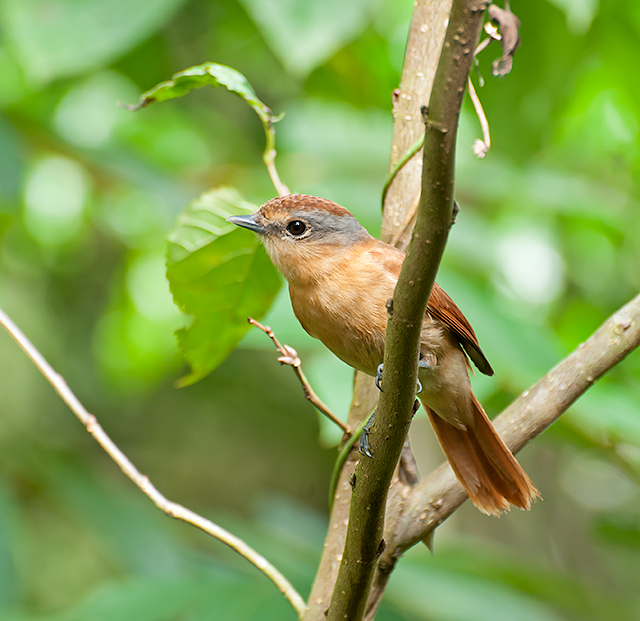
Wikipedia: Chestnut-crowned becard Source: OTHER
CANELEIRO_%28Pachyramphus_castaneus%29.jpg
![]() The chestnut-crowned becard (Pachyramphus castaneus) is a species of bird in the family Tityridae. It has traditionally been placed in Cotingidae or Tyrannidae, but evidence strongly suggest it is better placed in Tityridae,[2] where it is now placed by the South American Classification Committee.
[more]
The chestnut-crowned becard (Pachyramphus castaneus) is a species of bird in the family Tityridae. It has traditionally been placed in Cotingidae or Tyrannidae, but evidence strongly suggest it is better placed in Tityridae,[2] where it is now placed by the South American Classification Committee.
[more]
Black-capped becard (Pachyramphus marginatus)
Profile Wikipedia eBird Xeno-Canto

Wikipedia: Black-capped becard Source: OTHER
1200px-Black-capped_Becard.jpg
![]() The black-capped becard (Pachyramphus marginatus) is a species of bird in the family Tityridae. It has traditionally been placed in Cotingidae or Tyrannidae, but evidence strongly suggest it is better placed in Tityridae,[2] where it is now placed by the South American Classification Committee.
It is found in Bolivia, Brazil, Colombia, Ecuador, French Guiana, Guyana, Peru, Suriname, and Venezuela.
Its natural habitat is subtropical or tropical moist lowland forest.
[more]
The black-capped becard (Pachyramphus marginatus) is a species of bird in the family Tityridae. It has traditionally been placed in Cotingidae or Tyrannidae, but evidence strongly suggest it is better placed in Tityridae,[2] where it is now placed by the South American Classification Committee.
It is found in Bolivia, Brazil, Colombia, Ecuador, French Guiana, Guyana, Peru, Suriname, and Venezuela.
Its natural habitat is subtropical or tropical moist lowland forest.
[more]
Green-backed becard (Pachyramphus viridis)
Profile Wikipedia eBird Xeno-Canto
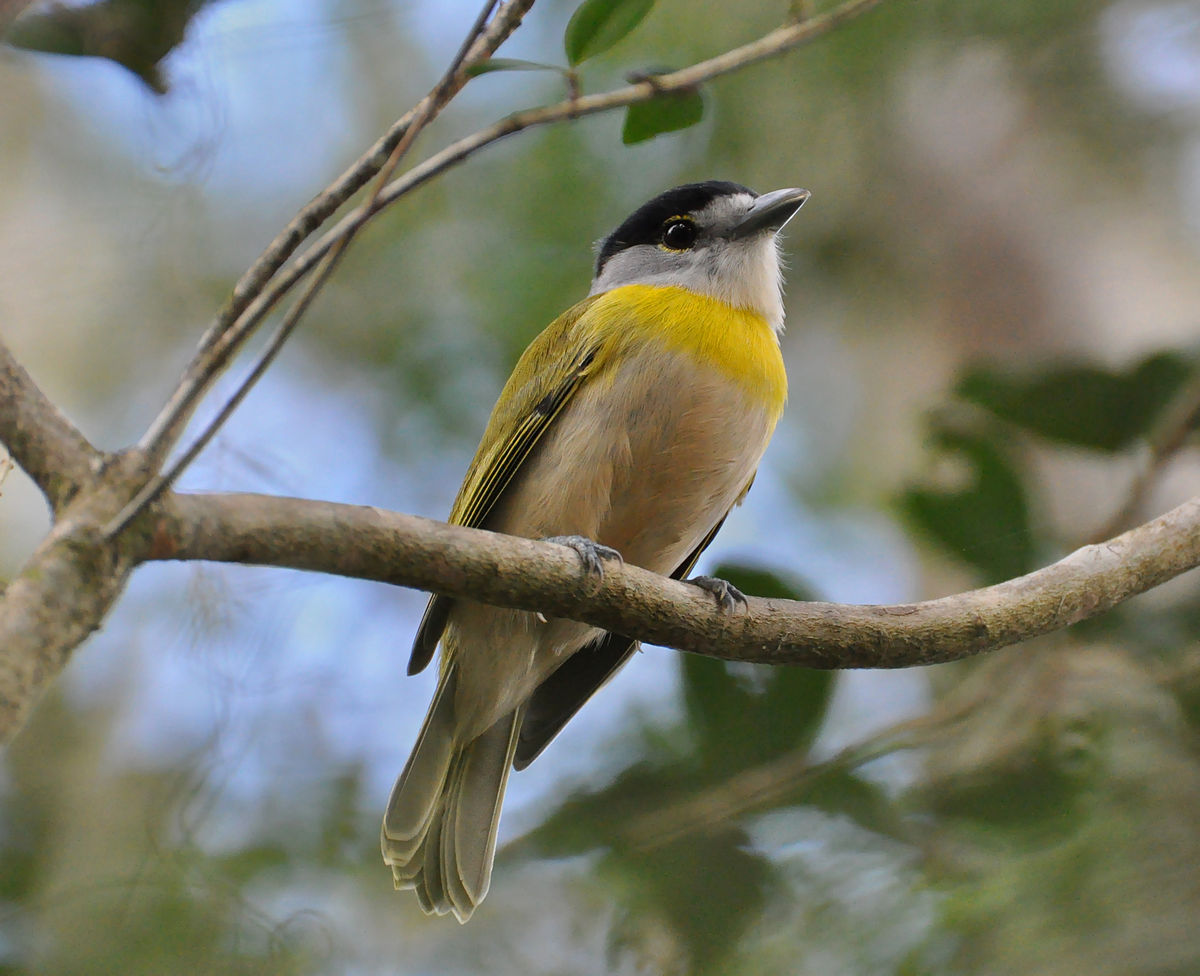
Wikipedia: Green-backed becard Source: OTHER
1200px-Pachyramphus_viridis_viridis.jpg
![]() The green-backed becard (Pachyramphus viridis) is a species of bird in the family Tityridae. It has traditionally been placed in Cotingidae or Tyrannidae, but evidence strongly suggest it is better placed in Tityridae,[2] where it is now placed by the South American Classification Committee. It often includes the Andean yellow-cheeked becard (Pachyramphus xanthogenys) as a subspecies.
[more]
The green-backed becard (Pachyramphus viridis) is a species of bird in the family Tityridae. It has traditionally been placed in Cotingidae or Tyrannidae, but evidence strongly suggest it is better placed in Tityridae,[2] where it is now placed by the South American Classification Committee. It often includes the Andean yellow-cheeked becard (Pachyramphus xanthogenys) as a subspecies.
[more]
Slaty becard (Pachyramphus spodiurus)
Profile Wikipedia eBird Xeno-Canto

Wikipedia: Slaty becard Source: OTHER
Slatybecard.jpg
![]() The slaty becard (Pachyramphus spodiurus) is a species of bird in the family Tityridae. It has traditionally been placed in Cotingidae or Tyrannidae, but evidence strongly suggest it is better placed in Tityridae,[2] where it is now placed by the South American Classification Committee.
[more]
The slaty becard (Pachyramphus spodiurus) is a species of bird in the family Tityridae. It has traditionally been placed in Cotingidae or Tyrannidae, but evidence strongly suggest it is better placed in Tityridae,[2] where it is now placed by the South American Classification Committee.
[more]
Black-crowned tityra (Tityra inquisitor)
Profile Wikipedia eBird Xeno-Canto

Wikipedia: Black-crowned tityra Source: OTHER
Black-crowned_tityra.jpg
![]() The black-crowned tityra (Tityra inquisitor) is a medium-sized passerine bird. It has traditionally been placed in the cotinga or the tyrant flycatcher family, but evidence strongly suggest it is better placed in Tityridae.
[more]
The black-crowned tityra (Tityra inquisitor) is a medium-sized passerine bird. It has traditionally been placed in the cotinga or the tyrant flycatcher family, but evidence strongly suggest it is better placed in Tityridae.
[more]
Masked tityra (Tityra semifasciata)
Profile Wikipedia eBird Xeno-Canto
Cahal pech resort masked tityra tentative ID by MerlinBirdID. 2018-02-05 17.22.32 Belize
First observed in Belize on 2018-02-05.
![]() The masked tityra (Tityra semifasciata) is a medium-sized passerine bird. It has traditionally been placed in the cotinga or the tyrant flycatcher family, but evidence strongly suggests that it is better placed in Tityridae,[2] where it is now placed by the South American Classification Committee.
[more]
The masked tityra (Tityra semifasciata) is a medium-sized passerine bird. It has traditionally been placed in the cotinga or the tyrant flycatcher family, but evidence strongly suggests that it is better placed in Tityridae,[2] where it is now placed by the South American Classification Committee.
[more]
Black-tailed tityra / Schwarznackenbekarde (Tityra cayana)
Profile Wikipedia eBird Xeno-Canto
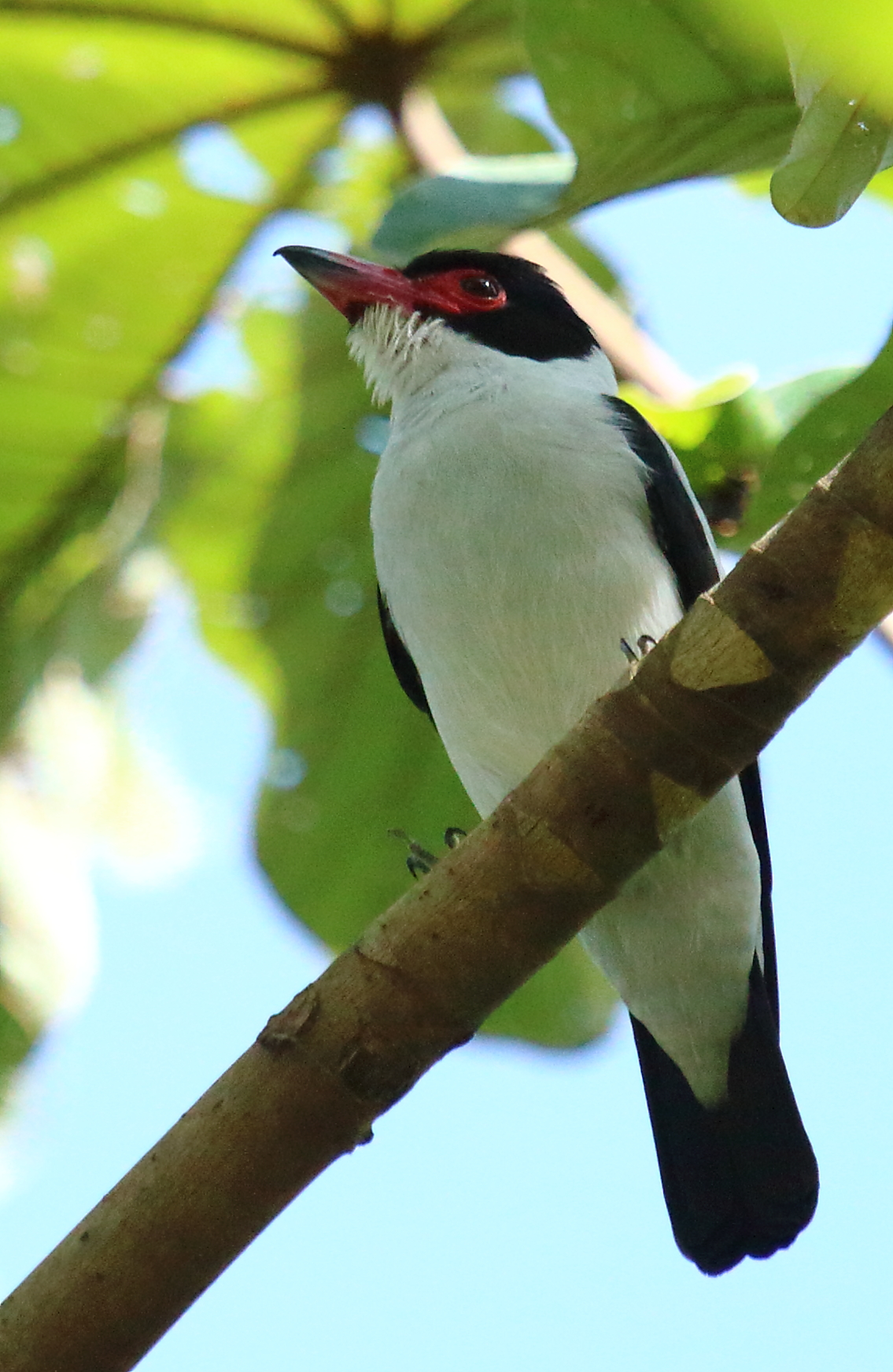
Wikipedia: Black-tailed tityra Source: OTHER
Black-tailed_tityra_%28Tityra_cayana%29.jpg
![]() The black-tailed tityra (Tityra cayana) is a medium-sized passerine bird of tropical South America. The tityras have been placed in the cotinga or the tyrant flycatcher families (Cotingidae and Tyrannidae) by various authors. But the weight of evidence strongly suggest they and their closest relatives are better separated as Tityridae; the AOU for example advocates this separation.[2]
[more]
The black-tailed tityra (Tityra cayana) is a medium-sized passerine bird of tropical South America. The tityras have been placed in the cotinga or the tyrant flycatcher families (Cotingidae and Tyrannidae) by various authors. But the weight of evidence strongly suggest they and their closest relatives are better separated as Tityridae; the AOU for example advocates this separation.[2]
[more]
Olive-striped flycatcher (Mionectes olivaceus)
Profile Wikipedia eBird Xeno-Canto

Wikipedia: Olive-striped flycatcher Source: OTHER
1200px-Olive-striped_flycatcher.jpg
![]() The olive-striped flycatcher (Mionectes olivaceus) is a species of bird in the family Tyrannidae.
[more]
The olive-striped flycatcher (Mionectes olivaceus) is a species of bird in the family Tyrannidae.
[more]
Ochre-bellied flycatcher (Mionectes oleagineus)

Wikipedia: Ochre-bellied flycatcher Source: OTHER
1200px-Mionectes_oleagineus_2.jpg
![]() The ochre-bellied flycatcher (Mionectes oleagineus) is a small bird of the tyrant flycatcher family. It breeds from southern Mexico through Central America, and South America east of the Andes as far as southern Brazil, and on Trinidad and Tobago.
[more]
The ochre-bellied flycatcher (Mionectes oleagineus) is a small bird of the tyrant flycatcher family. It breeds from southern Mexico through Central America, and South America east of the Andes as far as southern Brazil, and on Trinidad and Tobago.
[more]
Streak-necked flycatcher (Mionectes striaticollis)
Profile Wikipedia eBird Xeno-Canto

Wikipedia: Streak-necked flycatcher Source: OTHER
1200px-Mionectes_striaticollis_-NBII_Image_Gallery-a00255.jpg
![]() The streak-necked flycatcher (Mionectes striaticollis) is a species of bird in the family Tyrannidae.
[more]
The streak-necked flycatcher (Mionectes striaticollis) is a species of bird in the family Tyrannidae.
[more]
White-tailed shrike-tyrant (Agriornis albicauda)
Profile Wikipedia eBird Xeno-Canto

Wikipedia: White-tailed shrike-tyrant Source: OTHER
White-tailed_Shrike-Tyrant_-_South_Ecuador_S4E3293_%2816295894634%29.jpg
![]() The white-tailed shrike-tyrant (Agriornis albicauda) is a species of bird in the family Tyrannidae. It is found in Argentina, Bolivia, Chile, Ecuador, and Peru. At 25–28 cm (10–11 in) long, it is a very large flycatcher, second only to the great shrike-tyrant in size.
[more]
The white-tailed shrike-tyrant (Agriornis albicauda) is a species of bird in the family Tyrannidae. It is found in Argentina, Bolivia, Chile, Ecuador, and Peru. At 25–28 cm (10–11 in) long, it is a very large flycatcher, second only to the great shrike-tyrant in size.
[more]
Black-billed shrike-tyrant (Agriornis montanus)

Wikipedia: Black-billed shrike-tyrant Source: OTHER
Agriornis_montanus_-_Black-billed_shrike-tyrant.jpg
![]() The black-billed shrike-tyrant (Agriornis montanus) is a species of bird in the family Tyrannidae. It is found in Argentina, Bolivia, Chile, Colombia, Ecuador, Peru, and is a vagrant to the Falkland Islands. It is a large flycatcher at 23–25 cm (9–10 in) long. Its natural habitats are subtropical or tropical high-altitude shrubland, subtropical or tropical high-altitude grassland, and pastureland.
[more]
The black-billed shrike-tyrant (Agriornis montanus) is a species of bird in the family Tyrannidae. It is found in Argentina, Bolivia, Chile, Colombia, Ecuador, Peru, and is a vagrant to the Falkland Islands. It is a large flycatcher at 23–25 cm (9–10 in) long. Its natural habitats are subtropical or tropical high-altitude shrubland, subtropical or tropical high-altitude grassland, and pastureland.
[more]
Short-tailed field-tyrant (Muscigralla brevicauda)

Wikipedia: Short-tailed field-tyrant Source: OTHER
Short-tailed_Field-Tyrant_-_South_Ecuador_S4E8007_%2816710944637%29.jpg
![]() The short-tailed field tyrant (Muscigralla brevicauda) is a species of bird in the family Tyrannidae. It is monotypic within the genus Muscigralla.[2] It is found in Ecuador, Peru and far northern Chile[1] where its natural habitats are subtropical or tropical dry shrubland and pastureland.[3]
[more]
The short-tailed field tyrant (Muscigralla brevicauda) is a species of bird in the family Tyrannidae. It is monotypic within the genus Muscigralla.[2] It is found in Ecuador, Peru and far northern Chile[1] where its natural habitats are subtropical or tropical dry shrubland and pastureland.[3]
[more]
Plain-capped ground-tyrant (Muscisaxicola alpinus)

Wikipedia: Plain-capped ground-tyrant Source: OTHER
1200px-Dormilona_taczanowski.jpg
![]() Taczanowski's ground tyrant or plain-capped ground tyrant (Muscisaxicola griseus) is a species of bird in the family Tyrannidae.
It is found in Bolivia and Peru.
Its natural habitat is subtropical or tropical high-altitude grassland.
[more]
Taczanowski's ground tyrant or plain-capped ground tyrant (Muscisaxicola griseus) is a species of bird in the family Tyrannidae.
It is found in Bolivia and Peru.
Its natural habitat is subtropical or tropical high-altitude grassland.
[more]
Spot-billed ground-tyrant (Muscisaxicola maculirostris)
Profile Wikipedia eBird Xeno-Canto

Wikipedia: Spot-billed ground-tyrant Source: OTHER
Spot-billed_Ground-Tyrant.jpg
![]() The spot-billed ground tyrant (Muscisaxicola maculirostris) is a species of bird in the family Tyrannidae.
[more]
The spot-billed ground tyrant (Muscisaxicola maculirostris) is a species of bird in the family Tyrannidae.
[more]
White-browed ground-tyrant (Muscisaxicola albilora)
Profile Wikipedia eBird Xeno-Canto

Wikipedia: White-browed ground-tyrant Source: OTHER
1200px-White-browed_Ground-tyrant.jpg
![]() The white-browed ground tyrant (Muscisaxicola albilora) is a species of bird in the family Tyrannidae.
It breeds in the Andes in Argentina and Chile between 1,500 and 4,000 m above sea-level. It migrates north to Bolivia, Colombia, Ecuador and Peru. It is a vagrant to the Falkland Islands. Its natural habitat is subtropical or tropical high-altitude grassland.
[more]
The white-browed ground tyrant (Muscisaxicola albilora) is a species of bird in the family Tyrannidae.
It breeds in the Andes in Argentina and Chile between 1,500 and 4,000 m above sea-level. It migrates north to Bolivia, Colombia, Ecuador and Peru. It is a vagrant to the Falkland Islands. Its natural habitat is subtropical or tropical high-altitude grassland.
[more]
Ruddy-tailed flycatcher (Terenotriccus erythrurus)

Wikipedia: Ruddy-tailed flycatcher Source: OTHER
1200px-Terenotriccus_erythrurus_-_Ruddy-tailed_flycatcher%3B_Rio_Branco%2C_Acre%2C_Brazil.jpg
![]() The ruddy-tailed flycatcher (Terenotriccus erythrurus) is a small passerine bird in the family Tityridae. It breeds in lowlands from southeastern Mexico to northern Bolivia, north-central Brazil and the Guianas. This flycatcher ranges east of the Andes cordillera into the entire Amazon Basin of northern Brazil and the Guianas; to the west of the Andes in Colombia and Ecuador into Central America. It is the only member of the genus Terenotriccus, but some authorities place it in genus Myiobius. However, it differs in voice, behaviour, and structure from members of that group.
[more]
The ruddy-tailed flycatcher (Terenotriccus erythrurus) is a small passerine bird in the family Tityridae. It breeds in lowlands from southeastern Mexico to northern Bolivia, north-central Brazil and the Guianas. This flycatcher ranges east of the Andes cordillera into the entire Amazon Basin of northern Brazil and the Guianas; to the west of the Andes in Colombia and Ecuador into Central America. It is the only member of the genus Terenotriccus, but some authorities place it in genus Myiobius. However, it differs in voice, behaviour, and structure from members of that group.
[more]
Ringed antpipit (Corythopis torquatus)

Wikipedia: Ringed antpipit Source: OTHER
1200px-Corythopis_torquatus.jpg
![]() The ringed antpipit (Corythopis torquatus) is a species of bird in the family Tyrannidae, the tyrant flycatchers. It is one of two species in the genus Corythopis.
It is found in the Amazon Basin of Brazil and the Guianas, and Amazonian Colombia, Ecuador, Peru, and Bolivia; also Guyana, Suriname, French Guiana, and in eastern Venezuela in the Orinoco River drainage.
[more]
The ringed antpipit (Corythopis torquatus) is a species of bird in the family Tyrannidae, the tyrant flycatchers. It is one of two species in the genus Corythopis.
It is found in the Amazon Basin of Brazil and the Guianas, and Amazonian Colombia, Ecuador, Peru, and Bolivia; also Guyana, Suriname, French Guiana, and in eastern Venezuela in the Orinoco River drainage.
[more]
Olive-sided flycatcher / Fichtentyrann (Contopus cooperi)
Profile Wikipedia eBird Audubon AllAboutBirds Xeno-Canto

Wikipedia: Olive-sided flycatcher Source: OTHER
Olive-sided_Flycatcher.jpg
![]() The olive-sided flycatcher (Contopus cooperi) is a passerine bird. It is a medium-sized tyrant flycatcher.
[more]
The olive-sided flycatcher (Contopus cooperi) is a passerine bird. It is a medium-sized tyrant flycatcher.
[more]
Eastern wood-pewee (Contopus virens)
Profile Wikipedia eBird Audubon AllAboutBirds Xeno-Canto
Eastern wood pewee, last new bird we discovered - at the parking lot shortly before leaving, Oregon Ridge. 2021-06-19 09.34.10 Maryland
First observed in Maryland on 2021-06-19.
![]() The eastern wood pewee (Contopus virens) is a small tyrant flycatcher from North America. This bird and the western wood pewee (C. sordidulus) were formerly considered to be a single species. The two species are virtually identical in appearance, and can be distinguished most easily by their calls.
[more]
The eastern wood pewee (Contopus virens) is a small tyrant flycatcher from North America. This bird and the western wood pewee (C. sordidulus) were formerly considered to be a single species. The two species are virtually identical in appearance, and can be distinguished most easily by their calls.
[more]
Call:
Automatically generated from Xeno-Canto recording
♫ Source: BirdNet
20220501_084450 birdnet - Eastern Wood-Pewee - 2022-05-01 08:44:50 - Eastern Wood-Pewee - Cockeysville.mp3
2022-05-01 08.44.50 Cockeysville (song?)
Western wood-pewee (Contopus sordidulus)
Profile Wikipedia eBird Audubon AllAboutBirds Xeno-Canto
Arenal western wood-pewee tentative ID by MerlinBirdID. 2018-03-01 07.50.38 Costa Rica
First observed in Costa Rica on 2018-03-01.
![]() The western wood pewee (Contopus sordidulus) is a small tyrant flycatcher. Adults are gray-olive on the upperparts[2] with light underparts, washed with olive on the breast. They have two wing bars and a dark bill with yellow at the base of the lower mandible. This bird is very similar in appearance to the eastern wood pewee; the two birds were formerly considered to be one species. The call of C. sordidulus is a loud buzzy peeer; the song consists of three rapid descending tsees ending with a descending peeer.
[more]
The western wood pewee (Contopus sordidulus) is a small tyrant flycatcher. Adults are gray-olive on the upperparts[2] with light underparts, washed with olive on the breast. They have two wing bars and a dark bill with yellow at the base of the lower mandible. This bird is very similar in appearance to the eastern wood pewee; the two birds were formerly considered to be one species. The call of C. sordidulus is a loud buzzy peeer; the song consists of three rapid descending tsees ending with a descending peeer.
[more]
Tropical pewee (Contopus cinereus)
Profile Wikipedia eBird Xeno-Canto

Wikipedia: Tropical pewee Source: OTHER
Tropical_Pewee_-_Rio_Tigre_-_Costa_Rica.jpg
![]() The tropical pewee or southern tropical pewee (Contopus cinereus) is a small passerine bird in the tyrant flycatcher family. It breeds from southern Mexico and Trinidad south to Bolivia and Argentina. The taxon punensis, found in south-western Ecuador and western Peru, is usually included as a subspecies of the tropical pewee, but it has been suggested it should be considered a separate species, the Tumbes pewee (Contopus punensis) .
[more]
The tropical pewee or southern tropical pewee (Contopus cinereus) is a small passerine bird in the tyrant flycatcher family. It breeds from southern Mexico and Trinidad south to Bolivia and Argentina. The taxon punensis, found in south-western Ecuador and western Peru, is usually included as a subspecies of the tropical pewee, but it has been suggested it should be considered a separate species, the Tumbes pewee (Contopus punensis) .
[more]
Smoke-colored pewee (Contopus fumigatus)
Profile Wikipedia eBird Xeno-Canto

Wikipedia: Smoke-colored pewee Source: OTHER
Contopus_fumigatus%2C_Smoke-colored_Pewee.jpg
![]() The smoke-colored pewee (Contopus fumigatus) is a species of bird in the family Tyrannidae.
[more]
The smoke-colored pewee (Contopus fumigatus) is a species of bird in the family Tyrannidae.
[more]
Blackish pewee (Contopus nigrescens)
Profile Wikipedia eBird Xeno-Canto
Wikipedia: Blackish pewee Source: OTHER
Contopus_nigrescens_-_Blackish_pewee.JPG
![]() The blackish pewee (Contopus nigrescens) is a species of bird in the family Tyrannidae. It is found in Brazil, Ecuador, Guyana, and Peru.
[more]
The blackish pewee (Contopus nigrescens) is a species of bird in the family Tyrannidae. It is found in Brazil, Ecuador, Guyana, and Peru.
[more]
Euler's flycatcher (Lathrotriccus euleri)
Profile Wikipedia eBird Xeno-Canto
Wikipedia: Euler's flycatcher Source: OTHER
Lathrotriccus_euleri_Euler%27s_Flycatcher.JPG
![]() Euler's flycatcher (Lathrotriccus euleri) is a small passerine bird in the tyrant flycatcher family. It breeds in South America east of the Andes from Colombia and Venezuela south to Bolivia and Argentina, and on the islands of Trinidad and formerly also Grenada (see below). This species is named for the Swiss ornithologist Carl Euler.[2]
[more]
Euler's flycatcher (Lathrotriccus euleri) is a small passerine bird in the tyrant flycatcher family. It breeds in South America east of the Andes from Colombia and Venezuela south to Bolivia and Argentina, and on the islands of Trinidad and formerly also Grenada (see below). This species is named for the Swiss ornithologist Carl Euler.[2]
[more]
Gray-breasted flycatcher (Lathrotriccus griseipectus)
Profile Wikipedia eBird Xeno-Canto

Wikipedia: Gray-breasted flycatcher Source: OTHER
Gray-breasted_Flycatcher_-_South_Ecuador_S4E9465.jpg
![]() The grey-breasted flycatcher (Lathrotriccus griseipectus) is a species of bird in the family Tyrannidae. It is found in western Ecuador and northwestern Peru. Its natural habitats are subtropical or tropical dry forests, subtropical or tropical moist lowland forests, and subtropical or tropical moist montane forests. It is threatened by habitat loss.
[more]
The grey-breasted flycatcher (Lathrotriccus griseipectus) is a species of bird in the family Tyrannidae. It is found in western Ecuador and northwestern Peru. Its natural habitats are subtropical or tropical dry forests, subtropical or tropical moist lowland forests, and subtropical or tropical moist montane forests. It is threatened by habitat loss.
[more]
Fuscous flycatcher (Cnemotriccus fuscatus)
Profile Wikipedia eBird Xeno-Canto

Wikipedia: Fuscous flycatcher Source: OTHER
1200px-Cnemotriccus_fuscatus_-_Fuscous_Flycatcher%3B_Bodoquena%2C_Mato_Grosso_do_Sul%2C_Brazil.jpg
![]() The fuscous flycatcher (Cnemotriccus fuscatus) is a small passerine bird in the tyrant flycatcher family, and the only member of the genus Cnemotriccus. It breeds from Colombia and Venezuela south to Bolivia, Paraguay and Argentina, and on both Trinidad and Tobago. The fuscous flycatcher ranges in northern and eastern South America, including the entire Amazon Basin, and the Guianas; also all of Brazil except the very southeastern border area with Uruguay.
[more]
The fuscous flycatcher (Cnemotriccus fuscatus) is a small passerine bird in the tyrant flycatcher family, and the only member of the genus Cnemotriccus. It breeds from Colombia and Venezuela south to Bolivia, Paraguay and Argentina, and on both Trinidad and Tobago. The fuscous flycatcher ranges in northern and eastern South America, including the entire Amazon Basin, and the Guianas; also all of Brazil except the very southeastern border area with Uruguay.
[more]
Tufted flycatcher (Mitrephanes phaeocercus)
Profile Wikipedia eBird Xeno-Canto

Wikipedia: Tufted flycatcher Source: OTHER
Mitrephanes_phaeocercus_-Costa_Rica-8a.jpg
![]() The northern tufted flycatcher or simply tufted flycatcher (Mitrephanes phaeocercus) is a small passerine bird in the tyrant flycatcher family. It breeds in highlands from northwestern Mexico to northwestern Ecuador. The olive flycatcher (Mitrephanes olivaceus) of Peru and Bolivia is now considered a separate species.
[more]
The northern tufted flycatcher or simply tufted flycatcher (Mitrephanes phaeocercus) is a small passerine bird in the tyrant flycatcher family. It breeds in highlands from northwestern Mexico to northwestern Ecuador. The olive flycatcher (Mitrephanes olivaceus) of Peru and Bolivia is now considered a separate species.
[more]
Amazonian scrub-flycatcher (Sublegatus obscurior)
Profile Wikipedia eBird Xeno-Canto

Wikipedia: Amazonian scrub-flycatcher Source: OTHER
1200px-Sublegatus_obscurior_-_Todd%27s_scrub-flycatcher%2C_Pte._Figueiredo%2C_Amazonas%2C_Brazil.jpg
![]() The Amazonian scrub flycatcher or Todd's scrub flycatcher (Sublegatus obscurior) is a species of bird in the family Tyrannidae, the tyrant flycatchers.
It is found in South America in its natural habitats of subtropical or tropical dry forests and subtropical or tropical moist lowland forests.
[more]
The Amazonian scrub flycatcher or Todd's scrub flycatcher (Sublegatus obscurior) is a species of bird in the family Tyrannidae, the tyrant flycatchers.
It is found in South America in its natural habitats of subtropical or tropical dry forests and subtropical or tropical moist lowland forests.
[more]
Black-tailed flycatcher (Myiobius atricaudus)
Profile Wikipedia eBird Xeno-Canto
Wikipedia: Black-tailed flycatcher Source: OTHER
Myiobius_atricaudus_-_Black-tailed_Flycatcher.JPG
![]() The black-tailed myiobius or black-tailed flycatcher (Myiobius atricaudus) is a species of passerine bird in the family Tityridae. It was previously placed in the family Tyrannidae.[2] Black-tailed flycatchers are found in Brazil, Colombia, Costa Rica, Ecuador, Panama, Peru, and Venezuela.[3] Their natural habitats are subtropical or tropical moist lowland forests and heavily degraded former forest. They are usually found alone or in pairs, but may join flocks of several species.[3]
[more]
The black-tailed myiobius or black-tailed flycatcher (Myiobius atricaudus) is a species of passerine bird in the family Tityridae. It was previously placed in the family Tyrannidae.[2] Black-tailed flycatchers are found in Brazil, Colombia, Costa Rica, Ecuador, Panama, Peru, and Venezuela.[3] Their natural habitats are subtropical or tropical moist lowland forests and heavily degraded former forest. They are usually found alone or in pairs, but may join flocks of several species.[3]
[more]
Sulphur-rumped flycatcher (alternate) (Myiobius barbatus)
Tawny-breasted flycatcher (Myiobius villosus)
Profile Wikipedia eBird Xeno-Canto

Wikipedia: Tawny-breasted flycatcher Source: OTHER
1200px-Tawny-breasted_Flycatcher.jpg
![]() The tawny-breasted myiobius or tawny-breasted flycatcher (Myiobius villosus) is a species of passerine bird in the family Tityridae. It is found in Bolivia, Colombia, Ecuador, Panama, Peru, and Venezuela.
Its natural habitat is subtropical or tropical moist montane forests.
[more]
The tawny-breasted myiobius or tawny-breasted flycatcher (Myiobius villosus) is a species of passerine bird in the family Tityridae. It is found in Bolivia, Colombia, Ecuador, Panama, Peru, and Venezuela.
Its natural habitat is subtropical or tropical moist montane forests.
[more]
Great crested flycatcher (Myiarchus crinitus)
Profile Wikipedia eBird A-Z Animals Audubon AllAboutBirds Xeno-Canto

Wikipedia: Great crested flycatcher Source: OTHER
Great_Crested_Flycatcher_RWD2.jpg
First observed in 🇨🇭 on 2021-03-18.
![]() The great crested flycatcher (Myiarchus crinitus) is a large insect-eating bird of the tyrant flycatcher family. It is the most widespread member of the genus Myiarchus in North America, and is found over most of the eastern and mid-western portions of the continent.[2] It dwells mostly in the treetops and rarely is found on the ground.[3]
[more]
The great crested flycatcher (Myiarchus crinitus) is a large insect-eating bird of the tyrant flycatcher family. It is the most widespread member of the genus Myiarchus in North America, and is found over most of the eastern and mid-western portions of the continent.[2] It dwells mostly in the treetops and rarely is found on the ground.[3]
[more]
Call:
Automatically generated from Xeno-Canto recording
♫ Source: BirdNet
20210318_165219- birdnet 9 - Great Crested Flycatcher - 2020-02-25 18:26:45 - birdnet_mobile_5867288364_recording_15.wav.mp3
2021-03-18 16.52.19 Fehraltorf (song?)
Dusky-capped flycatcher (Myiarchus tuberculifer)
Profile Wikipedia eBird Audubon AllAboutBirds Xeno-Canto

Wikipedia: Dusky-capped flycatcher Source: OTHER
Myiarchus-tuberculifer-001.jpg
![]() The dusky-capped flycatcher (Myiarchus tuberculifer) is a passerine bird in the tyrant flycatcher family. It breeds in forest and other woodland from southern Arizona, as well as the Chisos Mountains, Texas, south to northern Argentina and on Trinidad. It is resident in most of its range, but American breeders retreat to Mexico in winter.
[more]
The dusky-capped flycatcher (Myiarchus tuberculifer) is a passerine bird in the tyrant flycatcher family. It breeds in forest and other woodland from southern Arizona, as well as the Chisos Mountains, Texas, south to northern Argentina and on Trinidad. It is resident in most of its range, but American breeders retreat to Mexico in winter.
[more]
Panama flycatcher (Myiarchus panamensis)
Profile Wikipedia eBird Xeno-Canto

Wikipedia: Panama flycatcher Source: OTHER
Panama_Flycatcher_-_Panama_H8O3031.jpg
![]() The Panamanian flycatcher (Myiarchus panamensis) is a species of bird in the family Tyrannidae. It is found in Colombia, Costa Rica, Panama, and Venezuela. Its natural habitats are subtropical or tropical dry forest, subtropical or tropical moist lowland forest, subtropical or tropical mangrove forest, subtropical or tropical dry shrubland, and heavily degraded former forest.
[more]
The Panamanian flycatcher (Myiarchus panamensis) is a species of bird in the family Tyrannidae. It is found in Colombia, Costa Rica, Panama, and Venezuela. Its natural habitats are subtropical or tropical dry forest, subtropical or tropical moist lowland forest, subtropical or tropical mangrove forest, subtropical or tropical dry shrubland, and heavily degraded former forest.
[more]
Swainson's flycatcher (Myiarchus swainsoni)
Profile Wikipedia eBird Xeno-Canto
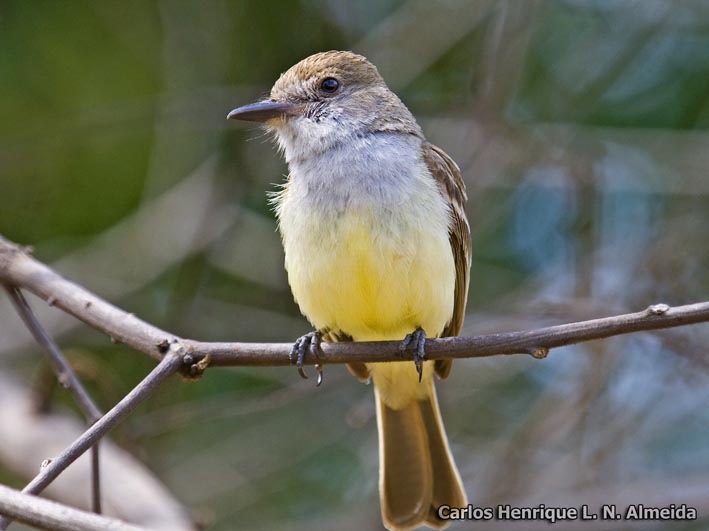
Wikipedia: Swainson's flycatcher Source: OTHER
Myiarchus_swainsoni.jpeg
![]() Swainson's flycatcher (Myiarchus swainsoni) is a species of bird in the family Tyrannidae.
It is found in Argentina, Bolivia, Brazil, Colombia, Ecuador, French Guiana, Guyana, Paraguay, Peru, Suriname, Trinidad and Tobago, Uruguay, and Venezuela.
Its natural habitats are subtropical or tropical dry forests, subtropical or tropical moist lowland forests, and heavily degraded former forest.
[more]
Swainson's flycatcher (Myiarchus swainsoni) is a species of bird in the family Tyrannidae.
It is found in Argentina, Bolivia, Brazil, Colombia, Ecuador, French Guiana, Guyana, Paraguay, Peru, Suriname, Trinidad and Tobago, Uruguay, and Venezuela.
Its natural habitats are subtropical or tropical dry forests, subtropical or tropical moist lowland forests, and heavily degraded former forest.
[more]
Sooty-crowned flycatcher (Myiarchus phaeocephalus)
Profile Wikipedia eBird Xeno-Canto

Wikipedia: Sooty-crowned flycatcher Source: OTHER
1200px-Sooty-crowned_Flycatcher_%28Myiarchus_phaeocephalus%29_%2820027044745%29.jpg
![]() The sooty-crowned flycatcher (Myiarchus phaeocephalus) is a species of bird in the family Tyrannidae.
It is found in Ecuador and Peru.
Its natural habitats are subtropical or tropical dry forests and subtropical or tropical moist lowland forests.
[more]
The sooty-crowned flycatcher (Myiarchus phaeocephalus) is a species of bird in the family Tyrannidae.
It is found in Ecuador and Peru.
Its natural habitats are subtropical or tropical dry forests and subtropical or tropical moist lowland forests.
[more]
Short-crested flycatcher (Myiarchus ferox)
Profile Wikipedia eBird Xeno-Canto

Wikipedia: Short-crested flycatcher Source: OTHER
1200px-Myiarchus_ferox-Short-crested_Flycatcher.JPG
![]() The short-crested flycatcher (Myiarchus ferox) is a species of bird in the family Tyrannidae.
[more]
The short-crested flycatcher (Myiarchus ferox) is a species of bird in the family Tyrannidae.
[more]
Pale-edged flycatcher (Myiarchus cephalotes)
Profile Wikipedia eBird Xeno-Canto

Wikipedia: Pale-edged flycatcher Source: OTHER
1200px-Myiarchus_cephalotes_%28Atrapamoscas_monta%C3%B1ero%29_%2816089213637%29.jpg
![]() The pale-edged flycatcher (Myiarchus cephalotes) is a species of bird in the family Tyrannidae.
It is found in Bolivia, Colombia, Ecuador, Peru, and Venezuela.
Its natural habitats are subtropical or tropical moist montane forests and heavily degraded former forest.
[more]
The pale-edged flycatcher (Myiarchus cephalotes) is a species of bird in the family Tyrannidae.
It is found in Bolivia, Colombia, Ecuador, Peru, and Venezuela.
Its natural habitats are subtropical or tropical moist montane forests and heavily degraded former forest.
[more]
Masked water-tyrant (Fluvicola nengeta)
Profile Wikipedia eBird Xeno-Canto
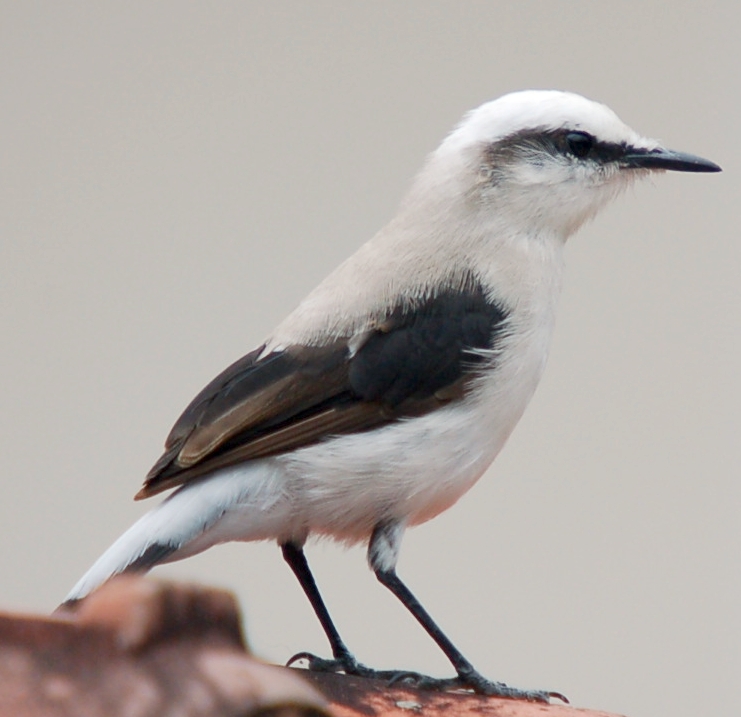
Wikipedia: Masked water-tyrant Source: OTHER
Lavadeira_mascarada.jpg
![]() The masked water tyrant (Fluvicola nengeta) is a species of bird in the family Tyrannidae, the tyrant flycatchers, one of three in the genus Fluvicola.
[more]
The masked water tyrant (Fluvicola nengeta) is a species of bird in the family Tyrannidae, the tyrant flycatchers, one of three in the genus Fluvicola.
[more]
Slaty-capped flycatcher (Leptopogon superciliaris)
Profile Wikipedia eBird Xeno-Canto
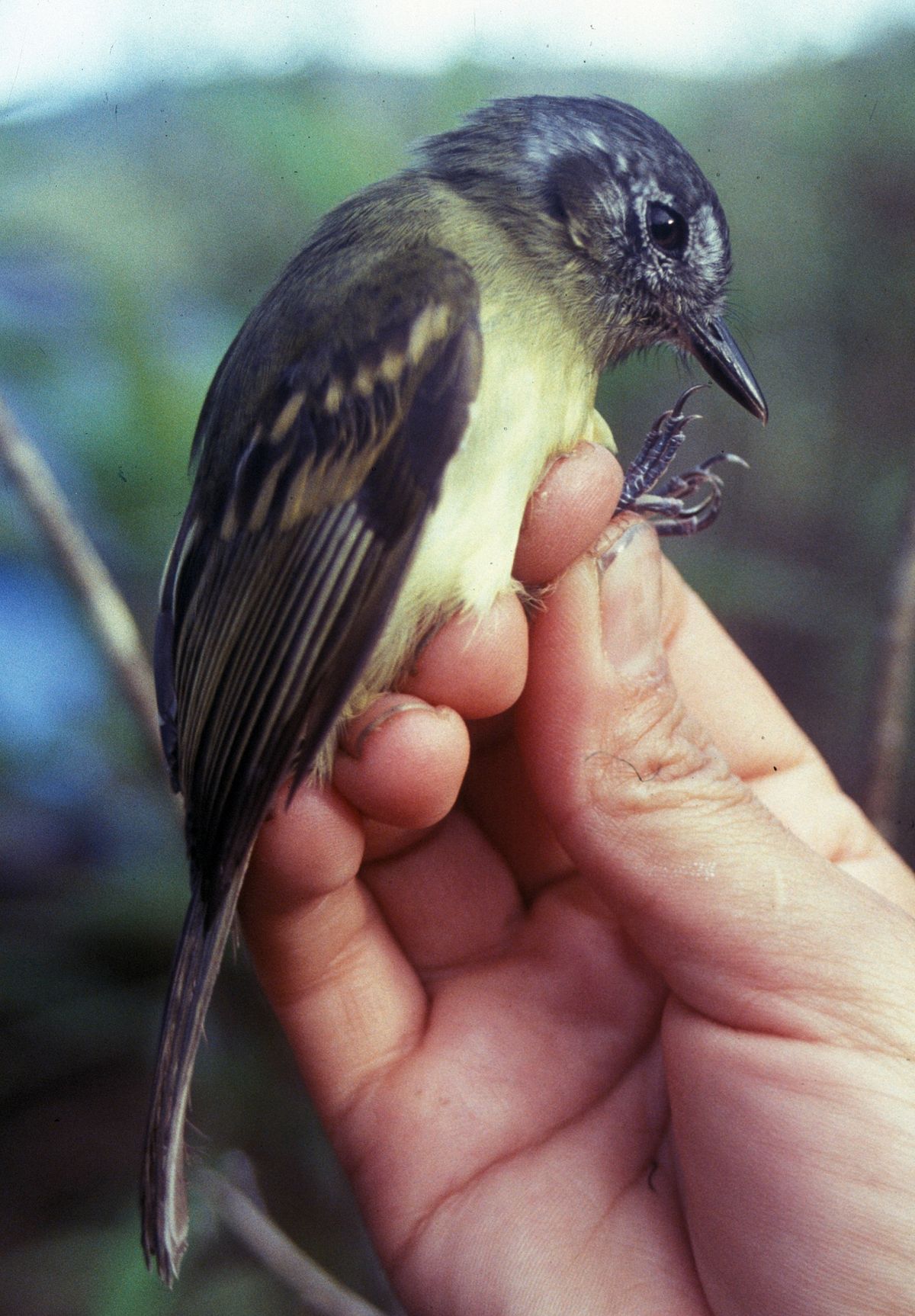
Wikipedia: Slaty-capped flycatcher Source: OTHER
1200px-Leptopogon_superciliaris.jpg
![]() The slaty-capped flycatcher (Leptopogon superciliaris) is a small passerine bird in the tyrant flycatcher family. It is found in northern Bolivia to Costa Rica and in Trinidad.
[more]
The slaty-capped flycatcher (Leptopogon superciliaris) is a small passerine bird in the tyrant flycatcher family. It is found in northern Bolivia to Costa Rica and in Trinidad.
[more]
Sepia-capped flycatcher (Leptopogon amaurocephalus)
Profile Wikipedia eBird Xeno-Canto

Wikipedia: Sepia-capped flycatcher Source: OTHER
Leptopogon_amaurocephalus_-Piraju%2C_Sao_Paulo%2C_Brazil-8.jpg
![]() The sepia-capped flycatcher (Leptopogon amaurocephalus) is a species of bird in the family Tyrannidae.
[more]
The sepia-capped flycatcher (Leptopogon amaurocephalus) is a species of bird in the family Tyrannidae.
[more]
Rufous-breasted flycatcher (Leptopogon rufipectus)

Wikipedia: Rufous-breasted flycatcher Source: OTHER
Rufous-breasted_Flycatcher_-_Ecuador_S4E4101_%2816253355453%29.jpg
![]() The rufous-breasted flycatcher (Leptopogon rufipectus) is a species of bird in the family Tyrannidae. It is found in Colombia, Ecuador, far northwestern Peru and far western Venezuela. Its natural habitat is subtropical or tropical moist montane forests.
[more]
The rufous-breasted flycatcher (Leptopogon rufipectus) is a species of bird in the family Tyrannidae. It is found in Colombia, Ecuador, far northwestern Peru and far western Venezuela. Its natural habitat is subtropical or tropical moist montane forests.
[more]
Greenish elaenia (Myiopagis viridicata)
Profile Wikipedia eBird Xeno-Canto

Wikipedia: Greenish elaenia Source: OTHER
1200px-Myiopagis_viridicata.jpg
![]() The greenish elaenia (Myiopagis viridicata) is a species of bird in the family Tyrannidae, the tyrant flycatchers.
It is found in Argentina, Belize, Bolivia, Brazil, Colombia, Costa Rica, Ecuador, El Salvador, Guatemala, Guyana, Honduras, Mexico, Nicaragua, Panama, Paraguay, Peru, the United States, and Venezuela.
Its natural habitats are subtropical or tropical dry forests, subtropical or tropical moist lowland forests, and heavily degraded former forest.
[more]
The greenish elaenia (Myiopagis viridicata) is a species of bird in the family Tyrannidae, the tyrant flycatchers.
It is found in Argentina, Belize, Bolivia, Brazil, Colombia, Costa Rica, Ecuador, El Salvador, Guatemala, Guyana, Honduras, Mexico, Nicaragua, Panama, Paraguay, Peru, the United States, and Venezuela.
Its natural habitats are subtropical or tropical dry forests, subtropical or tropical moist lowland forests, and heavily degraded former forest.
[more]
Gray elaenia (Myiopagis caniceps)
Profile Wikipedia eBird Xeno-Canto
Wikipedia: Gray elaenia Source: OTHER
Myiopagis_caniceps-Gray_Elaenia.JPG
![]() The grey elaenia (Myiopagis caniceps) is a species of bird in the family Tyrannidae. It is found in Argentina, Bolivia, Brazil, Colombia, Ecuador, French Guiana, Guyana, Panama, Paraguay, Peru, and Venezuela. Its natural habitat is subtropical or tropical moist lowland forest.
[more]
The grey elaenia (Myiopagis caniceps) is a species of bird in the family Tyrannidae. It is found in Argentina, Bolivia, Brazil, Colombia, Ecuador, French Guiana, Guyana, Panama, Paraguay, Peru, and Venezuela. Its natural habitat is subtropical or tropical moist lowland forest.
[more]
Forest elaenia (Myiopagis gaimardii)
Profile Wikipedia eBird Xeno-Canto

Wikipedia: Forest elaenia Source: OTHER
1200px-Myiopagis_gaimardii_-_Forest_Elaenia%3B_Manacapuru%2C_Amazonas%2C_Brazil.jpg
![]() The forest elaenia (Myiopagis gaimardii) is a small passerine bird in the tyrant flycatcher family. It breeds from Panama through Colombia, Venezuela and the Guianas to Bolivia and Brazil. It also occurs on Trinidad.
[more]
The forest elaenia (Myiopagis gaimardii) is a small passerine bird in the tyrant flycatcher family. It breeds from Panama through Colombia, Venezuela and the Guianas to Bolivia and Brazil. It also occurs on Trinidad.
[more]
Pacific elaenia (Myiopagis subplacens)
Profile Wikipedia eBird Xeno-Canto

Wikipedia: Pacific elaenia Source: OTHER
1200px-Myiopagis_subplacens_1859.jpg
![]() The Pacific elaenia (Myiopagis subplacens) is a species of bird in the family Tyrannidae. It is found in Ecuador and Peru. Its natural habitats are subtropical or tropical dry forests and subtropical or tropical moist lowland forests.
[more]
The Pacific elaenia (Myiopagis subplacens) is a species of bird in the family Tyrannidae. It is found in Ecuador and Peru. Its natural habitats are subtropical or tropical dry forests and subtropical or tropical moist lowland forests.
[more]
Foothill elaenia (Myiopagis olallai)
Profile Wikipedia eBird Xeno-Canto

Wikipedia: Foothill elaenia Source: OTHER
Coopmansi_%2815536659372%29.jpg
![]() The foothill elaenia (Myiopagis olallai) is a species of bird in the family Tyrannidae. It is found in Ecuador and Peru. Its natural habitat is subtropical or tropical moist montane forests. It is threatened by habitat loss.
[more]
The foothill elaenia (Myiopagis olallai) is a species of bird in the family Tyrannidae. It is found in Ecuador and Peru. Its natural habitat is subtropical or tropical moist montane forests. It is threatened by habitat loss.
[more]
Yellow-crowned elaenia (Myiopagis flavivertex)
Profile Wikipedia eBird Xeno-Canto
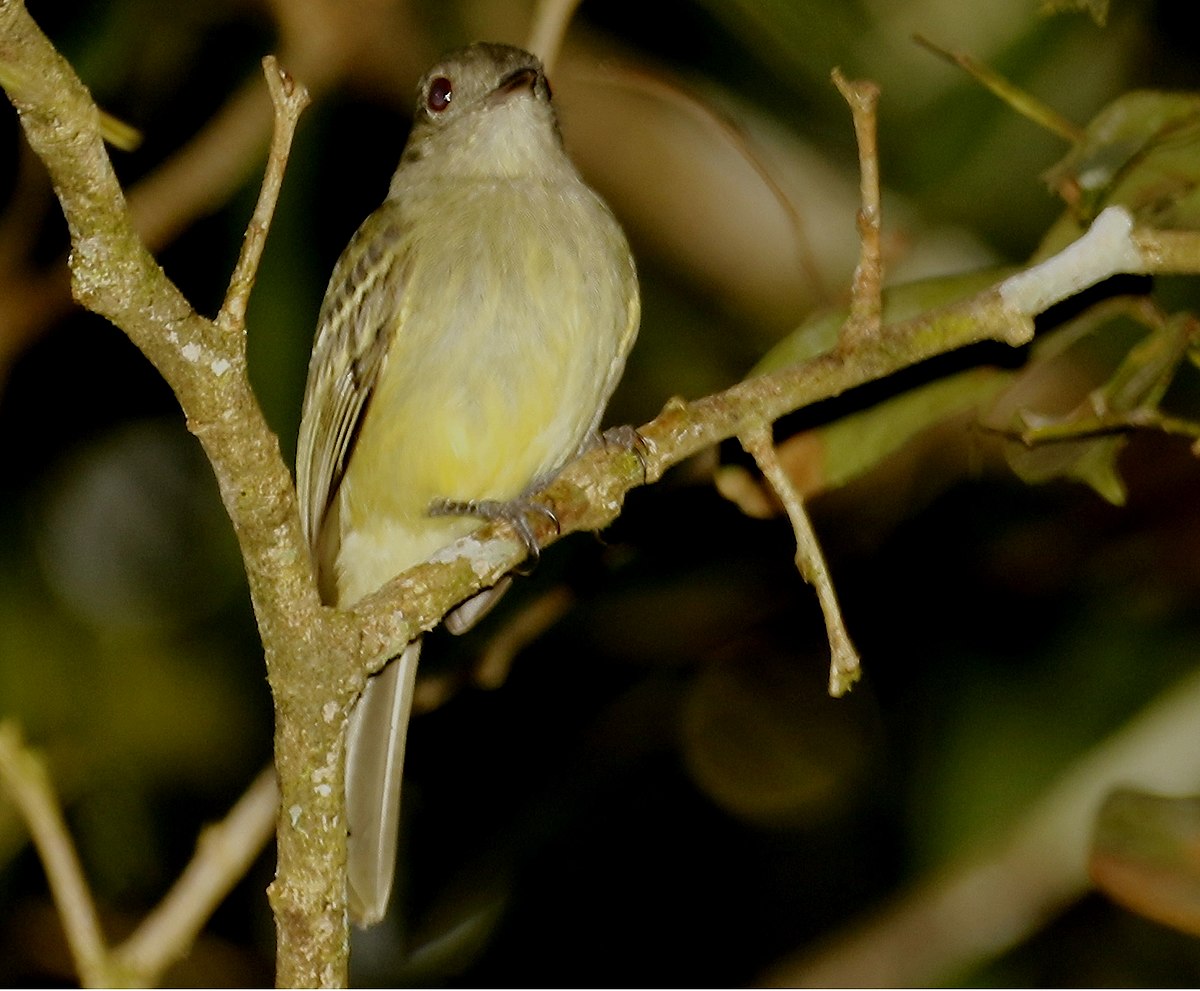
Wikipedia: Yellow-crowned elaenia Source: OTHER
1200px-Yellow-crowned_Elaenia.jpg
![]() The yellow-crowned elaenia (Myiopagis flavivertex) is a species of bird in the family Tyrannidae, the tyrant flycatchers.
It is found in eastern Orinoco Basin Venezuela, the Guianas, and along the Amazon River corridor; also Colombia, Brazil, Guyana, Suriname, French Guiana, Ecuador and Peru.
[more]
The yellow-crowned elaenia (Myiopagis flavivertex) is a species of bird in the family Tyrannidae, the tyrant flycatchers.
It is found in eastern Orinoco Basin Venezuela, the Guianas, and along the Amazon River corridor; also Colombia, Brazil, Guyana, Suriname, French Guiana, Ecuador and Peru.
[more]
Common tody flycatcher (Todirostrum cinereum)

Wikipedia: Common tody flycatcher Source: OTHER
Common_Tody-Flycatcher.jpg
![]() The common tody-flycatcher or black-fronted tody-flycatcher (Todirostrum cinereum) is a very small passerine bird in the tyrant flycatcher family. It breeds from southern Mexico to northwestern Peru, eastern Bolivia and southern, eastern and northeast Brazil.
[more]
The common tody-flycatcher or black-fronted tody-flycatcher (Todirostrum cinereum) is a very small passerine bird in the tyrant flycatcher family. It breeds from southern Mexico to northwestern Peru, eastern Bolivia and southern, eastern and northeast Brazil.
[more]
Black-headed tody-flycatcher (Todirostrum nigriceps)
Profile Wikipedia eBird Xeno-Canto

Wikipedia: Black-headed tody-flycatcher Source: OTHER
1200px-Black-headed_tody-flycatcher.jpg
![]() The black-headed tody-flycatcher (Todirostrum nigriceps) is a species of bird in the family Tyrannidae.
It is found in Colombia, Costa Rica, Ecuador, Panama, and Venezuela.
Its natural habitat is subtropical or tropical moist lowland forests.
[more]
The black-headed tody-flycatcher (Todirostrum nigriceps) is a species of bird in the family Tyrannidae.
It is found in Colombia, Costa Rica, Ecuador, Panama, and Venezuela.
Its natural habitat is subtropical or tropical moist lowland forests.
[more]
Spotted tody-flycatcher (Todirostrum maculatum)
Profile Wikipedia eBird Xeno-Canto

Wikipedia: Spotted tody-flycatcher Source: OTHER
Todirostrum_maculatum_JJK%271.jpg
![]() The spotted tody-flycatcher (Todirostrum maculatum) is a species of bird in the family Tyrannidae, the tyrant flycatchers.
It is found in Bolivia, Brazil, Colombia, Ecuador, French Guiana, Guyana, Peru, Suriname, Trinidad and Tobago, and Venezuela, and is mostly a species of the Amazon Basin countries and Guianan countries.
[more]
The spotted tody-flycatcher (Todirostrum maculatum) is a species of bird in the family Tyrannidae, the tyrant flycatchers.
It is found in Bolivia, Brazil, Colombia, Ecuador, French Guiana, Guyana, Peru, Suriname, Trinidad and Tobago, and Venezuela, and is mostly a species of the Amazon Basin countries and Guianan countries.
[more]
Yellow-browed tody-flycatcher (Todirostrum chrysocrotaphum)
Profile Wikipedia eBird Xeno-Canto
Wikipedia: Yellow-browed tody-flycatcher Source: OTHER
Todirostrum_chrysocrotaphum_-_Yellow-browed_Tody-Flycatcher.JPG
![]() The yellow-browed tody-flycatcher (Todirostrum chrysocrotaphum) is a species of bird in the family Tyrannidae, the tyrant flycatchers. It is found mainly in the southern Amazon Basin of Brazil, also Amazonian Colombia, Ecuador, Peru, and Bolivia; the species is recorded in Venezuela. Its natural habitats are subtropical or tropical moist lowland forests, subtropical or tropical swamps, and heavily degraded former forest.
[more]
The yellow-browed tody-flycatcher (Todirostrum chrysocrotaphum) is a species of bird in the family Tyrannidae, the tyrant flycatchers. It is found mainly in the southern Amazon Basin of Brazil, also Amazonian Colombia, Ecuador, Peru, and Bolivia; the species is recorded in Venezuela. Its natural habitats are subtropical or tropical moist lowland forests, subtropical or tropical swamps, and heavily degraded former forest.
[more]
Rufous mourner (Rhytipterna holerythra)
Profile Wikipedia eBird Xeno-Canto
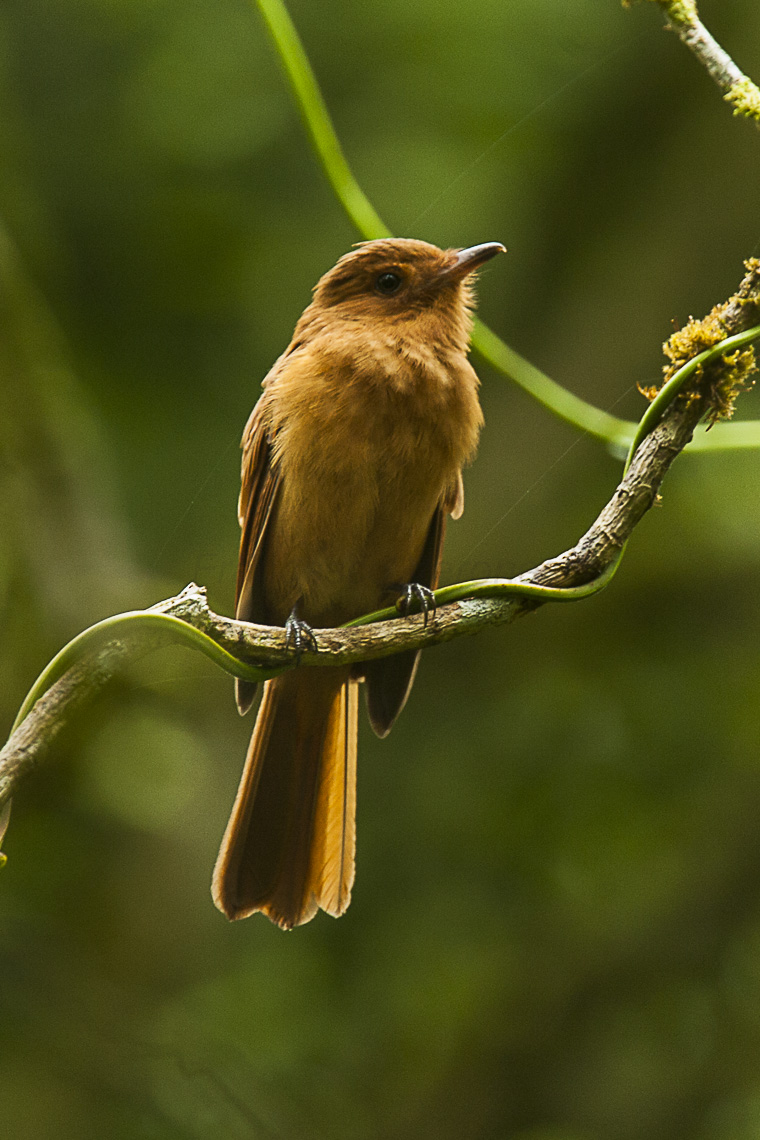
Wikipedia: Rufous mourner Source: OTHER
Rufous_Mourner_-_Panama_H8O0032.jpg
![]() The rufous mourner (Rhytipterna holerythra) is a small passerine bird in the tyrant flycatcher family. It breeds from southwestern Mexico to northwestern Ecuador. It was formerly believed to be a cotinga, but well-supported anatomical evidence has shown it to be related to tyrant flycatchers of the genera Myiarchus, Sirystes and Casiornis.[2]
[more]
The rufous mourner (Rhytipterna holerythra) is a small passerine bird in the tyrant flycatcher family. It breeds from southwestern Mexico to northwestern Ecuador. It was formerly believed to be a cotinga, but well-supported anatomical evidence has shown it to be related to tyrant flycatchers of the genera Myiarchus, Sirystes and Casiornis.[2]
[more]
Grayish mourner (Rhytipterna simplex)
Profile Wikipedia eBird Xeno-Canto
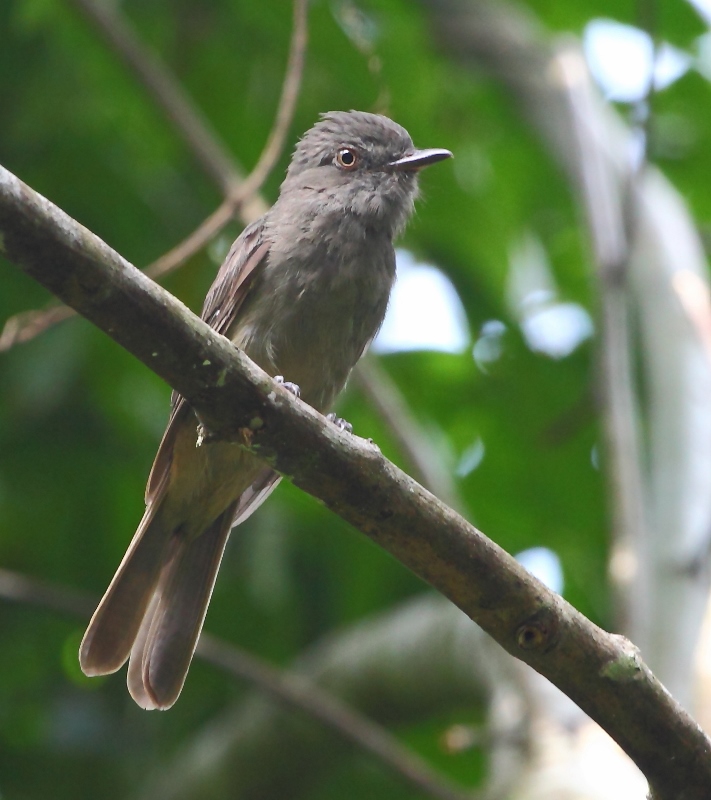
Wikipedia: Grayish mourner Source: OTHER
Rhytipterna_simplex_-_Grayish_Mourner.jpg
![]() The greyish mourner (Rhytipterna simplex) is a species of bird in the family Tyrannidae.
It is found in Bolivia, Brazil, Colombia, Ecuador, French Guiana, Guyana, Peru, Suriname, and Venezuela.
Its natural habitat is subtropical or tropical moist lowland forest.
[more]
The greyish mourner (Rhytipterna simplex) is a species of bird in the family Tyrannidae.
It is found in Bolivia, Brazil, Colombia, Ecuador, French Guiana, Guyana, Peru, Suriname, and Venezuela.
Its natural habitat is subtropical or tropical moist lowland forest.
[more]
Broad-billed sapayoa / Tyrannenbreitrachen (Sapayoa aenigma)

Wikipedia: Broad-billed sapayoa Source: OTHER
1200px-Sapayoa_aenigma%2C_Nusagandi%2C_Panama.jpg
![]() The sapayoa or broad-billed sapayoa (Sapayoa aenigma) is a suboscine passerine found in lowland rainforests in Panama and north-western South America. As the epithet aenigma ("the enigma") implies, its relationships have long been elusive. It is easy to overlook, but appears to be common in a wide range and is not considered threatened by the IUCN.[1][2]
[more]
The sapayoa or broad-billed sapayoa (Sapayoa aenigma) is a suboscine passerine found in lowland rainforests in Panama and north-western South America. As the epithet aenigma ("the enigma") implies, its relationships have long been elusive. It is easy to overlook, but appears to be common in a wide range and is not considered threatened by the IUCN.[1][2]
[more]
White-eyed tody-tyrant (Hemitriccus zosterops)
Profile Wikipedia eBird Xeno-Canto
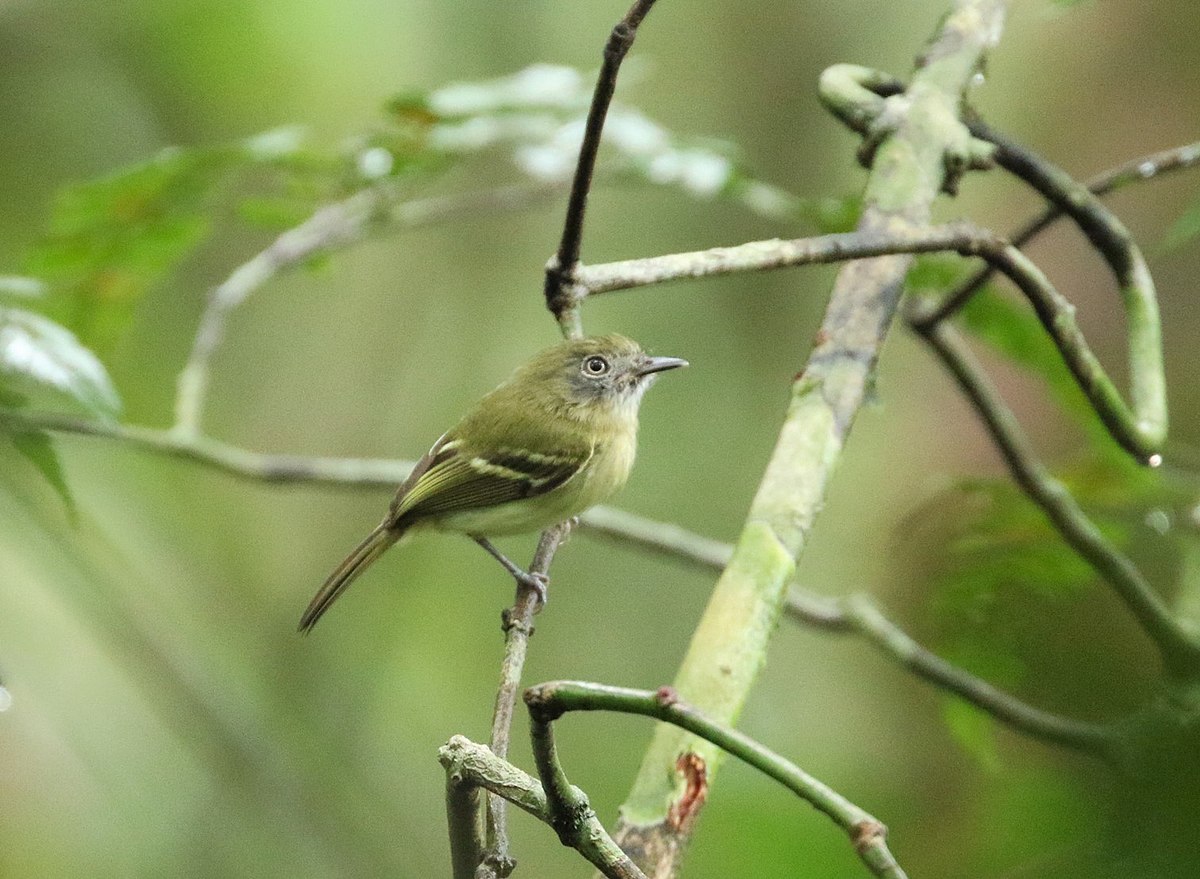
Wikipedia: White-eyed tody-tyrant Source: OTHER
1200px-Hemitriccus_zosterops_64004204.jpg
![]() The white-eyed tody-tyrant (Hemitriccus zosterops) is a species of bird in the family Tyrannidae, the tyrant flycatchers.
[more]
The white-eyed tody-tyrant (Hemitriccus zosterops) is a species of bird in the family Tyrannidae, the tyrant flycatchers.
[more]
Buff-throated tody-tyrant (Hemitriccus rufigularis)
Profile Wikipedia eBird Xeno-Canto

Wikipedia: Buff-throated tody-tyrant Source: OTHER
1200px-Hemitriccus_rufigularis_map.svg.png
![]() The buff-throated tody-tyrant (Hemitriccus rufigularis) is a species of bird in the family Tyrannidae. It is found in Bolivia, Ecuador, and Peru. Its natural habitat is subtropical or tropical moist montane forests. It is threatened by habitat loss.
[more]
The buff-throated tody-tyrant (Hemitriccus rufigularis) is a species of bird in the family Tyrannidae. It is found in Bolivia, Ecuador, and Peru. Its natural habitat is subtropical or tropical moist montane forests. It is threatened by habitat loss.
[more]
Zimmer's tody-tyrant (Hemitriccus minimus)
Profile Wikipedia eBird Xeno-Canto

Wikipedia: Zimmer's tody-tyrant Source: OTHER
1200px-Hemitriccus_minimus_-_Zimmer%27s_Tody-Tyrant%2C_Carajas_National_Forest%2C_Par%C3%A1%2C_Brazil.jpg
![]() Zimmer's tody-tyrant (Hemitriccus minimus) is a species of bird in the family Tyrannidae.
[more]
Zimmer's tody-tyrant (Hemitriccus minimus) is a species of bird in the family Tyrannidae.
[more]
Black-throated tody-tyrant (Hemitriccus granadensis)

Wikipedia: Black-throated tody-tyrant Source: OTHER
1200px-Hemitriccus_granadensis_2.jpg
![]() The black-throated tody-tyrant (Hemitriccus granadensis) is a species of bird in the family Tyrannidae.
[more]
The black-throated tody-tyrant (Hemitriccus granadensis) is a species of bird in the family Tyrannidae.
[more]
Cinnamon-breasted tody-tyrant (Hemitriccus cinnamomeipectus)
Profile Wikipedia eBird Xeno-Canto

Wikipedia: Cinnamon-breasted tody-tyrant Source: OTHER
1200px-Hemitriccus_cinnamomeipectus.jpg
![]() The cinnamon-breasted tody-tyrant (Hemitriccus cinnamomeipectus) is a species of bird in the family Tyrannidae. It is found in Ecuador and Peru. Its natural habitat is subtropical or tropical moist montane forests. It is threatened by habitat loss.
[more]
The cinnamon-breasted tody-tyrant (Hemitriccus cinnamomeipectus) is a species of bird in the family Tyrannidae. It is found in Ecuador and Peru. Its natural habitat is subtropical or tropical moist montane forests. It is threatened by habitat loss.
[more]
Johannes's tody-tyrant (Hemitriccus iohannis)
Profile Wikipedia eBird Xeno-Canto

Wikipedia: Johannes's tody-tyrant Source: OTHER
1200px-Hemitriccus_iohannis_-_Johannes%27s_Tody-Tyrant%3B_Cruzeiro_do_Sul%2C_Acre%2C_Brazil.jpg
![]() Johannes's tody-tyrant (Hemitriccus iohannis) is a species of bird in the family Tyrannidae. It is found in Bolivia, Brazil, Colombia, Ecuador, and Peru. Its natural habitats are subtropical or tropical moist lowland forests and heavily degraded former forest.
[more]
Johannes's tody-tyrant (Hemitriccus iohannis) is a species of bird in the family Tyrannidae. It is found in Bolivia, Brazil, Colombia, Ecuador, and Peru. Its natural habitats are subtropical or tropical moist lowland forests and heavily degraded former forest.
[more]
Speckled mourner (Laniocera rufescens)
Profile Wikipedia eBird Xeno-Canto

Wikipedia: Speckled mourner Source: OTHER
LipaugusRufescensSmit.jpg
![]() The speckled mourner (Laniocera rufescens) is a species of bird in the family Tityridae. It has traditionally been placed in the family Cotingidae, but evidence strongly suggest it is better placed in Tityridae,[2] where it is now placed by the SACC. It is found in Belize, Colombia, Costa Rica, Ecuador, Guatemala, Honduras, Mexico, Nicaragua, and Panama. Its natural habitat is subtropical or tropical moist lowland forest.
[more]
The speckled mourner (Laniocera rufescens) is a species of bird in the family Tityridae. It has traditionally been placed in the family Cotingidae, but evidence strongly suggest it is better placed in Tityridae,[2] where it is now placed by the SACC. It is found in Belize, Colombia, Costa Rica, Ecuador, Guatemala, Honduras, Mexico, Nicaragua, and Panama. Its natural habitat is subtropical or tropical moist lowland forest.
[more]
Cinereous mourner (Laniocera hypopyrra)
Wikipedia: Cinereous mourner Source: OTHER
Laniocera_hypopyrra_-_Cinereous_Mourner.JPG
![]() The cinereous mourner (Laniocera hypopyrra) is a species of bird in the family Tityridae. The term cinereous describes its colouration. It has traditionally been placed in the cotinga family, but evidence strongly suggest it is better placed in Tityridae,[2] where now placed by SACC. It is found in Bolivia, Brazil, Colombia, Ecuador, French Guiana, Guyana, Peru, Suriname, and Venezuela.
Its natural habitat is subtropical or tropical moist lowland forests.
[more]
The cinereous mourner (Laniocera hypopyrra) is a species of bird in the family Tityridae. The term cinereous describes its colouration. It has traditionally been placed in the cotinga family, but evidence strongly suggest it is better placed in Tityridae,[2] where now placed by SACC. It is found in Bolivia, Brazil, Colombia, Ecuador, French Guiana, Guyana, Peru, Suriname, and Venezuela.
Its natural habitat is subtropical or tropical moist lowland forests.
[more]
Long-tailed tyrant (Colonia colonus)
Profile Wikipedia eBird Xeno-Canto

Wikipedia: Long-tailed tyrant Source: OTHER
1200px-Colonia_colonus_-Parque_Nacional_do_Itatiaia%2C_Rio_de_Janeiro%2C_Brazil-8.jpg
![]() The long-tailed tyrant (Colonia colonus) is a species of bird in the family Tyrannidae, the only member of genus Colonia.
[more]
The long-tailed tyrant (Colonia colonus) is a species of bird in the family Tyrannidae, the only member of genus Colonia.
[more]
Scale-crested pygmy-tyrant (Lophotriccus pileatus)
Profile Wikipedia eBird Xeno-Canto

Wikipedia: Scale-crested pygmy-tyrant Source: OTHER
1200px-Scale-crested_Pygmy-Tirant.jpg
![]() The scale-crested pygmy tyrant (Lophotriccus pileatus) is a species of bird in the family Tyrannidae.
[more]
The scale-crested pygmy tyrant (Lophotriccus pileatus) is a species of bird in the family Tyrannidae.
[more]
Double-banded pygmy-tyrant (Lophotriccus vitiosus)
Profile Wikipedia eBird Xeno-Canto

Wikipedia: Double-banded pygmy-tyrant Source: OTHER
1200px-Lophotriccus_vitiosus_-_Double-banded_pygmy-tyrant.jpg
![]() The double-banded pygmy tyrant (Lophotriccus vitiosus) is a species of bird in the family Tyrannidae. It is found in Brazil, Colombia, Ecuador, French Guiana, Guyana, Peru, and Suriname. Its natural habitats are subtropical or tropical moist lowland forest and subtropical or tropical swampland.
[more]
The double-banded pygmy tyrant (Lophotriccus vitiosus) is a species of bird in the family Tyrannidae. It is found in Brazil, Colombia, Ecuador, French Guiana, Guyana, Peru, and Suriname. Its natural habitats are subtropical or tropical moist lowland forest and subtropical or tropical swampland.
[more]
Black-capped pygmy-tyrant (Myiornis atricapillus)
Profile Wikipedia eBird Xeno-Canto

Wikipedia: Black-capped pygmy-tyrant Source: OTHER
Myiornis_atricapillus_1.jpg
![]() The black-capped pygmy tyrant (Myiornis atricapillus) is the smallest passerine bird in its range, though larger than its cousin, the short-tailed pygmy tyrant. This tyrant flycatcher occurs from Costa Rica to north-western Ecuador.
[more]
The black-capped pygmy tyrant (Myiornis atricapillus) is the smallest passerine bird in its range, though larger than its cousin, the short-tailed pygmy tyrant. This tyrant flycatcher occurs from Costa Rica to north-western Ecuador.
[more]
White-bellied pygmy-tyrant (Myiornis albiventris)
Profile Wikipedia eBird Xeno-Canto

Wikipedia: White-bellied pygmy-tyrant Source: OTHER
1200px-Myiornis_albiventris_map.svg.png
![]() The white-bellied pygmy tyrant (Myiornis albiventris) is a species of bird in the family Tyrannidae. It is found in Bolivia and Peru. Its natural habitat is subtropical or tropical moist lowland forests.
[more]
The white-bellied pygmy tyrant (Myiornis albiventris) is a species of bird in the family Tyrannidae. It is found in Bolivia and Peru. Its natural habitat is subtropical or tropical moist lowland forests.
[more]
Short-tailed pygmy-tyrant (Myiornis ecaudatus)
Profile Wikipedia eBird Xeno-Canto

Wikipedia: Short-tailed pygmy-tyrant Source: OTHER
Myiornis_ecaudatus_-_Short-tailed_Pigmy-Tyrant_%28Manaus%29.jpg
![]() The short-tailed pygmy tyrant (Myiornis ecaudatus) is a small species of tyrant-flycatcher. The species is one of the smallest birds on Earth and the smallest passerine.[2] Among both the family and the order, only the closely related black-capped pygmy tyrant approaches similarly diminutive sizes. The pygmy tyrant is widespread throughout most of the Amazon in northern and central South America.
[more]
The short-tailed pygmy tyrant (Myiornis ecaudatus) is a small species of tyrant-flycatcher. The species is one of the smallest birds on Earth and the smallest passerine.[2] Among both the family and the order, only the closely related black-capped pygmy tyrant approaches similarly diminutive sizes. The pygmy tyrant is widespread throughout most of the Amazon in northern and central South America.
[more]
Brownish twistwing (Cnipodectes subbrunneus)
Profile Wikipedia eBird Xeno-Canto

Wikipedia: Brownish twistwing Source: OTHER
1200px-Cnipodectes_subbrunneus_-_Brownish_twistwing%2C_Careiro%2C_Amazonas%2C_Brazil.jpg
![]() The brownish twistwing (Cnipodectes subbrunneus), also known as the brownish flycatcher, is a species of bird in the Tyrannidae. It was the only member of the genus Cnipodectes until the description of Cnipodectes superrufus in 2007.
[more]
The brownish twistwing (Cnipodectes subbrunneus), also known as the brownish flycatcher, is a species of bird in the Tyrannidae. It was the only member of the genus Cnipodectes until the description of Cnipodectes superrufus in 2007.
[more]
Ornate flycatcher (Myiotriccus ornatus)
Profile Wikipedia eBird Xeno-Canto

Wikipedia: Ornate flycatcher Source: OTHER
Ornate_Flycatcher_-_South_Ecuador_S4E0633.jpg
![]() The ornate flycatcher (Myiotriccus ornatus) is a species of bird in the family Tyrannidae. It is the only member of the genus Myiotriccus.[2] It is found in Colombia, Ecuador, and Peru.
[more]
The ornate flycatcher (Myiotriccus ornatus) is a species of bird in the family Tyrannidae. It is the only member of the genus Myiotriccus.[2] It is found in Colombia, Ecuador, and Peru.
[more]
Royal flycatcher (Onychorhynchus coronatus)
Profile Wikipedia eBird Xeno-Canto

Wikipedia: Royal flycatcher Source: OTHER
Onychorhynchus_coronatus_-_Amazonian_Royal_Flycatcher.JPG
![]() The royal flycatchers are a genus, Onychorhynchus, of passerine birds in the family Tityridae[1][2] according to the IOC. Other taxonomic authorities including the AOU, Clements, and the IUCN, include it in Onychorhynchidae. Depending on authority, it includes a single widespread,[1] or four more localized species.[2] The specific epithet of the type species, coronatus, and the common name of all the species in this genus, royal flycatcher, refer to the striking, colourful crest,[3] which is seen displayed very rarely,[3] except after mating, while preening, in courtship as well as being handled.[3]
[more]
The royal flycatchers are a genus, Onychorhynchus, of passerine birds in the family Tityridae[1][2] according to the IOC. Other taxonomic authorities including the AOU, Clements, and the IUCN, include it in Onychorhynchidae. Depending on authority, it includes a single widespread,[1] or four more localized species.[2] The specific epithet of the type species, coronatus, and the common name of all the species in this genus, royal flycatcher, refer to the striking, colourful crest,[3] which is seen displayed very rarely,[3] except after mating, while preening, in courtship as well as being handled.[3]
[more]
Yellow tyrannulet (Capsiempis flaveola)

Wikipedia: Yellow tyrannulet Source: OTHER
1200px-Capsiempis_flaveola_-Costa_Rica-8_%281%29.jpg
![]() The yellow tyrannulet (Capsiempis flaveola) is a very small passerine bird in the tyrant flycatcher family. It breeds from Nicaragua south to northeastern Argentina and southeastern Brazil. It is the only member of the genus Capsiempis, but its taxonomy is uncertain, and it has been allocated to at least three other genera in the past.
[more]
The yellow tyrannulet (Capsiempis flaveola) is a very small passerine bird in the tyrant flycatcher family. It breeds from Nicaragua south to northeastern Argentina and southeastern Brazil. It is the only member of the genus Capsiempis, but its taxonomy is uncertain, and it has been allocated to at least three other genera in the past.
[more]
Golden-crowned spadebill (Platyrinchus coronatus)
Profile Wikipedia eBird Xeno-Canto

Wikipedia: Golden-crowned spadebill Source: OTHER
Golden-crowned_Spadebill_-_Rio_Tigre_-_Costa_Rica_MG_7766_%2826669722376%29.jpg
![]() The golden-crowned spadebill (Platyrinchus coronatus) is a species of bird in the family Tyrannidae. It is found in Bolivia, Brazil, Colombia, Costa Rica, Ecuador, French Guiana, Guyana, Honduras, Nicaragua, Panama, Peru, Suriname, and Venezuela. Its natural habitat is subtropical or tropical moist lowland forests.
[more]
The golden-crowned spadebill (Platyrinchus coronatus) is a species of bird in the family Tyrannidae. It is found in Bolivia, Brazil, Colombia, Costa Rica, Ecuador, French Guiana, Guyana, Honduras, Nicaragua, Panama, Peru, Suriname, and Venezuela. Its natural habitat is subtropical or tropical moist lowland forests.
[more]
White-throated spadebill (Platyrinchus mystaceus)
Profile Wikipedia eBird Xeno-Canto

Wikipedia: White-throated spadebill Source: OTHER
PATINHO_%28Platyrinchus_mystaceus%29.jpg
![]() The white-throated spadebill (Platyrinchus mystaceus) is a tiny passerine bird in the tyrant flycatcher family. It lives in the tropical Americas.
[more]
The white-throated spadebill (Platyrinchus mystaceus) is a tiny passerine bird in the tyrant flycatcher family. It lives in the tropical Americas.
[more]
White-crested spadebill (Platyrinchus platyrhynchos)
Profile Wikipedia eBird Xeno-Canto
Wikipedia: White-crested spadebill Source: OTHER
Platyrinchus_platyrhynchos_-_White-crested_spadebill.JPG
![]() The white-crested spadebill (Platyrinchus platyrhynchos) is a species of bird in the family Tyrannidae. It is found in Bolivia, Brazil, Colombia, Ecuador, French Guiana, Guyana, Peru, Suriname, and Venezuela. Its natural habitat is subtropical or tropical moist lowland forests.[1]
[more]
The white-crested spadebill (Platyrinchus platyrhynchos) is a species of bird in the family Tyrannidae. It is found in Bolivia, Brazil, Colombia, Ecuador, French Guiana, Guyana, Peru, Suriname, and Venezuela. Its natural habitat is subtropical or tropical moist lowland forests.[1]
[more]
Cinnamon-crested spadebill (Platyrinchus saturatus)
Profile Wikipedia eBird Xeno-Canto

Wikipedia: Cinnamon-crested spadebill Source: OTHER
1200px-Naturalis_Biodiversity_Center_-_RMNH.AVES.72157_1_-_Platyrinchus_saturatus_saturatus_Salvin_and_Godman%2C_1882_-_Tyrannidae_-_bird_skin_specimen.jpeg
![]() The cinnamon-crested spadebill (Platyrinchus saturatus) is a species of bird in the family Tyrannidae.
It is found in Brazil, Colombia, Ecuador, French Guiana, Guyana, Peru, Suriname, and Venezuela.
[more]
The cinnamon-crested spadebill (Platyrinchus saturatus) is a species of bird in the family Tyrannidae.
It is found in Brazil, Colombia, Ecuador, French Guiana, Guyana, Peru, Suriname, and Venezuela.
[more]
Yellow-throated spadebill (Platyrinchus flavigularis)
Profile Wikipedia eBird Xeno-Canto

Wikipedia: Yellow-throated spadebill Source: OTHER
PlatyrhynchusSmit.jpg
![]() The yellow-throated spadebill (Platyrinchus flavigularis) is a species of bird in the family Tyrannidae. It is found in Colombia, Ecuador, Peru, and Venezuela. Its natural habitat is subtropical or tropical moist montane forests.
[more]
The yellow-throated spadebill (Platyrinchus flavigularis) is a species of bird in the family Tyrannidae. It is found in Colombia, Ecuador, Peru, and Venezuela. Its natural habitat is subtropical or tropical moist montane forests.
[more]
Rough-legged tyrannulet (Phyllomyias burmeisteri)
Profile Wikipedia eBird Xeno-Canto
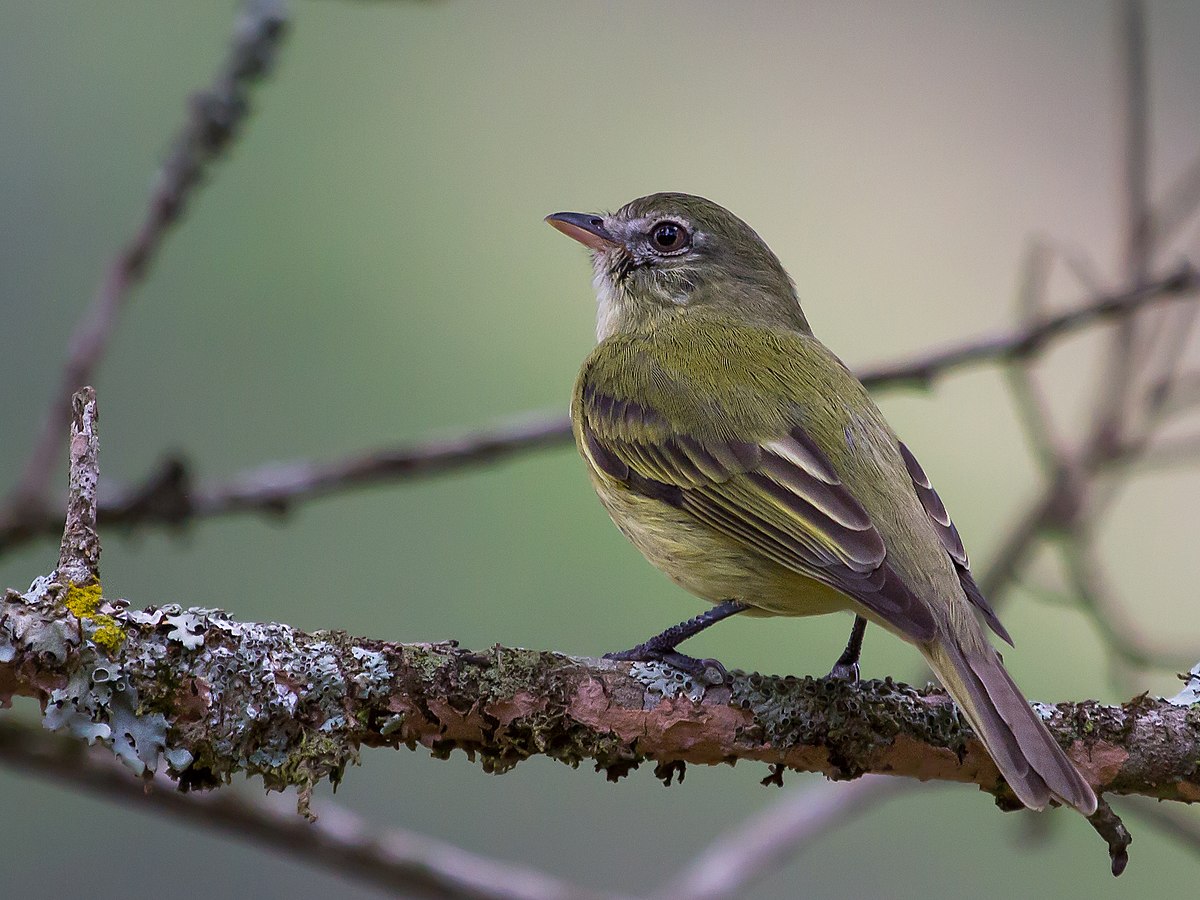
Wikipedia: Rough-legged tyrannulet Source: OTHER
1200px-Phyllomyias_burmeisteri_-_Rough-legged_tyrannulet%3B_Extrema%2C_Minas_Gerais%2C_Brazil.jpg
![]() The rough-legged tyrannulet (Phyllomyias burmeisteri) is a species of bird in the family Tyrannidae. It is found in Argentina, Bolivia, Brazil, Colombia, Costa Rica, Ecuador, Panama, Paraguay, Peru, and Venezuela. Its natural habitats are subtropical or tropical moist lowland forest and subtropical or tropical moist montane forest.
[more]
The rough-legged tyrannulet (Phyllomyias burmeisteri) is a species of bird in the family Tyrannidae. It is found in Argentina, Bolivia, Brazil, Colombia, Costa Rica, Ecuador, Panama, Paraguay, Peru, and Venezuela. Its natural habitats are subtropical or tropical moist lowland forest and subtropical or tropical moist montane forest.
[more]
Sooty-headed tyrannulet (Phyllomyias griseiceps)
Profile Wikipedia eBird Xeno-Canto

Wikipedia: Sooty-headed tyrannulet Source: OTHER
Sooty-headedTyrannulet.jpg
![]() The sooty-headed tyrannulet (Phyllomyias griseiceps) is a species of bird in the family Tyrannidae. It is found in Brazil, Colombia, Ecuador, Guyana, Panama, Peru, and Venezuela.
[more]
The sooty-headed tyrannulet (Phyllomyias griseiceps) is a species of bird in the family Tyrannidae. It is found in Brazil, Colombia, Ecuador, Guyana, Panama, Peru, and Venezuela.
[more]
Tawny-rumped tyrannulet (Phyllomyias uropygialis)
Profile Wikipedia eBird Xeno-Canto
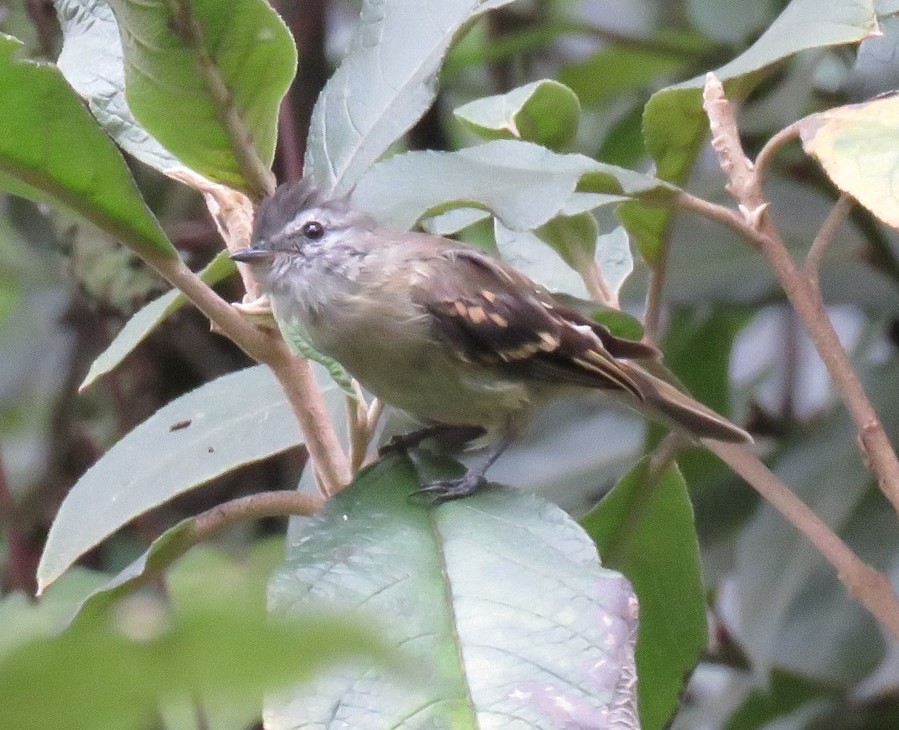
Wikipedia: Tawny-rumped tyrannulet Source: OTHER
Phyllomyias_uropygialis_cropped.jpg
![]() The tawny-rumped tyrannulet (Phyllomyias uropygialis) is a species of bird in the family Tyrannidae. It is found in Argentina, Bolivia, Colombia, Ecuador, Peru, and Venezuela. Its natural habitats are subtropical or tropical moist montane forests and heavily degraded former forest.
[more]
The tawny-rumped tyrannulet (Phyllomyias uropygialis) is a species of bird in the family Tyrannidae. It is found in Argentina, Bolivia, Colombia, Ecuador, Peru, and Venezuela. Its natural habitats are subtropical or tropical moist montane forests and heavily degraded former forest.
[more]
Plumbeous-crowned tyrannulet (Phyllomyias plumbeiceps)
Profile Wikipedia eBird Xeno-Canto

Wikipedia: Plumbeous-crowned tyrannulet Source: OTHER
1200px-Phyllomyias_plumbeiceps_map.svg.png
![]() The plumbeous-crowned tyrannulet (Phyllomyias plumbeiceps) is a species of bird in the family Tyrannidae. It is found in the countries of Colombia, Ecuador, and Peru. Its natural habitat is subtropical or tropical moist montanes.
[more]
The plumbeous-crowned tyrannulet (Phyllomyias plumbeiceps) is a species of bird in the family Tyrannidae. It is found in the countries of Colombia, Ecuador, and Peru. Its natural habitat is subtropical or tropical moist montanes.
[more]
Black-capped tyrannulet (Phyllomyias nigrocapillus)
Profile Wikipedia eBird Xeno-Canto

Wikipedia: Black-capped tyrannulet Source: OTHER
Black-cappedTyrannulet.jpg
![]() The black-capped tyrannulet (Phyllomyias nigrocapillus) is a species of bird in the family Tyrannidae. It is found in Colombia, Ecuador, Peru, and Venezuela. Its natural habitat is subtropical or tropical moist montane forests.
[more]
The black-capped tyrannulet (Phyllomyias nigrocapillus) is a species of bird in the family Tyrannidae. It is found in Colombia, Ecuador, Peru, and Venezuela. Its natural habitat is subtropical or tropical moist montane forests.
[more]
Ashy-headed tyrannulet (Phyllomyias cinereiceps)
Profile Wikipedia eBird Xeno-Canto

Wikipedia: Ashy-headed tyrannulet Source: OTHER
TyranniscusSmit.jpg
![]() The ashy-headed tyrannulet (Phyllomyias cinereiceps) is a species of bird in the family Tyrannidae. It is found in Colombia, Ecuador, and Peru.
[more]
The ashy-headed tyrannulet (Phyllomyias cinereiceps) is a species of bird in the family Tyrannidae. It is found in Colombia, Ecuador, and Peru.
[more]
Dusky-tailed flatbill (Ramphotrigon fuscicauda)
Profile Wikipedia eBird Xeno-Canto

Wikipedia: Dusky-tailed flatbill Source: OTHER
1200px-Ramphotrigon_fuscicauda_-_Dusky-tailed_Flatbill%3B_Ramal_do_Noca%2C_Rio_Branco%2C_Acre%2C_Brazil.jpg
![]() The dusky-tailed flatbill (Ramphotrigon fuscicauda) is a species of bird in the family Tyrannidae. It is found in Bolivia, Brazil, Colombia, Ecuador, and Peru.
[more]
The dusky-tailed flatbill (Ramphotrigon fuscicauda) is a species of bird in the family Tyrannidae. It is found in Bolivia, Brazil, Colombia, Ecuador, and Peru.
[more]
Large-headed flatbill (Ramphotrigon megacephalum)

Wikipedia: Large-headed flatbill Source: OTHER
Ramphotrigon_megacephalum_-_Large-headed_Flatbill.jpg
![]() The large-headed flatbill (Ramphotrigon megacephalum), also known as the bamboo flatbill, is a species of bird in the family Tyrannidae.
It is found in Argentina, Bolivia, Brazil, Colombia, Ecuador, Paraguay, Peru, and Venezuela.
Its natural habitats are subtropical or tropical moist lowland forests and subtropical or tropical moist montane forests.
[more]
The large-headed flatbill (Ramphotrigon megacephalum), also known as the bamboo flatbill, is a species of bird in the family Tyrannidae.
It is found in Argentina, Bolivia, Brazil, Colombia, Ecuador, Paraguay, Peru, and Venezuela.
Its natural habitats are subtropical or tropical moist lowland forests and subtropical or tropical moist montane forests.
[more]
Rufous-tailed flatbill (Ramphotrigon ruficauda)
Profile Wikipedia eBird Xeno-Canto

Wikipedia: Rufous-tailed flatbill Source: OTHER
1200px-Ramphotrigon_ruficauda_-_Rufous-tailed_Flatbill%3B_Xapuri%2C_Acre%2C_Brazil.jpg
![]() The rufous-tailed flatbill (Ramphotrigon ruficauda) is a species of bird in the family Tyrannidae.
It is found in Bolivia, Brazil, Colombia, Ecuador, French Guiana, Guyana, Peru, Suriname, and Venezuela.
Its natural habitat is subtropical or tropical moist lowland forests.
[more]
The rufous-tailed flatbill (Ramphotrigon ruficauda) is a species of bird in the family Tyrannidae.
It is found in Bolivia, Brazil, Colombia, Ecuador, French Guiana, Guyana, Peru, Suriname, and Venezuela.
Its natural habitat is subtropical or tropical moist lowland forests.
[more]
Yellow-margined flycatcher (Tolmomyias assimilis)
Profile Wikipedia eBird Xeno-Canto

Wikipedia: Yellow-margined flycatcher Source: OTHER
Tolmomyias_assimilis_-NW_Ecuador-8.jpg
![]() Zimmer's flatbill (Tolmomyias assimilis) or the yellow-margined flatbill is a species of bird in the tyrant flycatcher family Tyrannidae. It is found in humid forest in southern Central America, and the Chocó and Amazon in South America.
[more]
Zimmer's flatbill (Tolmomyias assimilis) or the yellow-margined flatbill is a species of bird in the tyrant flycatcher family Tyrannidae. It is found in humid forest in southern Central America, and the Chocó and Amazon in South America.
[more]
Yellow-olive flycatcher (Tolmomyias sulphurescens)
Profile Wikipedia eBird Xeno-Canto

Wikipedia: Yellow-olive flycatcher Source: OTHER
Tolmomyias_sulphurescens_-Parque_Estadual_da_Cantareira%2C_Sao_Paulo%2C_Brazil-8.jpg
![]() The yellow-olive flatbill or yellow-olive flycatcher (Tolmomyias sulphurescens) is a species of bird in the family Tyrannidae. It is found in tropical and subtopical forest and woodland in Central and South America, but over its range there are significant variations in plumage, iris-colour and voice, leading to speculations that more than one species is involved. Its plumage is overall greenish-yellow, the lores are whitish, the crown is often greyish and some subspecies have a dusky patch on the auriculars. The flat bill is black above and pale pinkish or greyish below; similar to the yellow-margined flatbill, but unlike the grey-crowned flatbill.
[more]
The yellow-olive flatbill or yellow-olive flycatcher (Tolmomyias sulphurescens) is a species of bird in the family Tyrannidae. It is found in tropical and subtopical forest and woodland in Central and South America, but over its range there are significant variations in plumage, iris-colour and voice, leading to speculations that more than one species is involved. Its plumage is overall greenish-yellow, the lores are whitish, the crown is often greyish and some subspecies have a dusky patch on the auriculars. The flat bill is black above and pale pinkish or greyish below; similar to the yellow-margined flatbill, but unlike the grey-crowned flatbill.
[more]
Yellow-breasted flycatcher (Tolmomyias flaviventris)
Profile Wikipedia eBird Xeno-Canto

Wikipedia: Yellow-breasted flycatcher Source: OTHER
1200px-Tolmomyias_flaviventris_-_Yellow-breasted_Flycatcher.JPG
![]() The ochre-lored flatbill (Tolmomyias flaviventris) or yellow-breasted flycatcher, is a passerine bird in the tyrant flycatcher family. It is found in South America, ranging from Colombia and Venezuela south to Peru, Bolivia, and Brazil, and on both Trinidad and Tobago. There are significant variations in its voice and plumage, with western birds duller and more olive, and eastern and northern birds brighter and more ochre-yellow. The two are sometimes considered separate species, the western olive-faced flatbill (or flycatcher), T. viridiceps, and the eastern and northern ochre-lored flatbill (or flycatcher), T. flaviventris.[2]
[more]
The ochre-lored flatbill (Tolmomyias flaviventris) or yellow-breasted flycatcher, is a passerine bird in the tyrant flycatcher family. It is found in South America, ranging from Colombia and Venezuela south to Peru, Bolivia, and Brazil, and on both Trinidad and Tobago. There are significant variations in its voice and plumage, with western birds duller and more olive, and eastern and northern birds brighter and more ochre-yellow. The two are sometimes considered separate species, the western olive-faced flatbill (or flycatcher), T. viridiceps, and the eastern and northern ochre-lored flatbill (or flycatcher), T. flaviventris.[2]
[more]
Orange-eyed flycatcher (Tolmomyias traylori)
Profile Wikipedia eBird Xeno-Canto
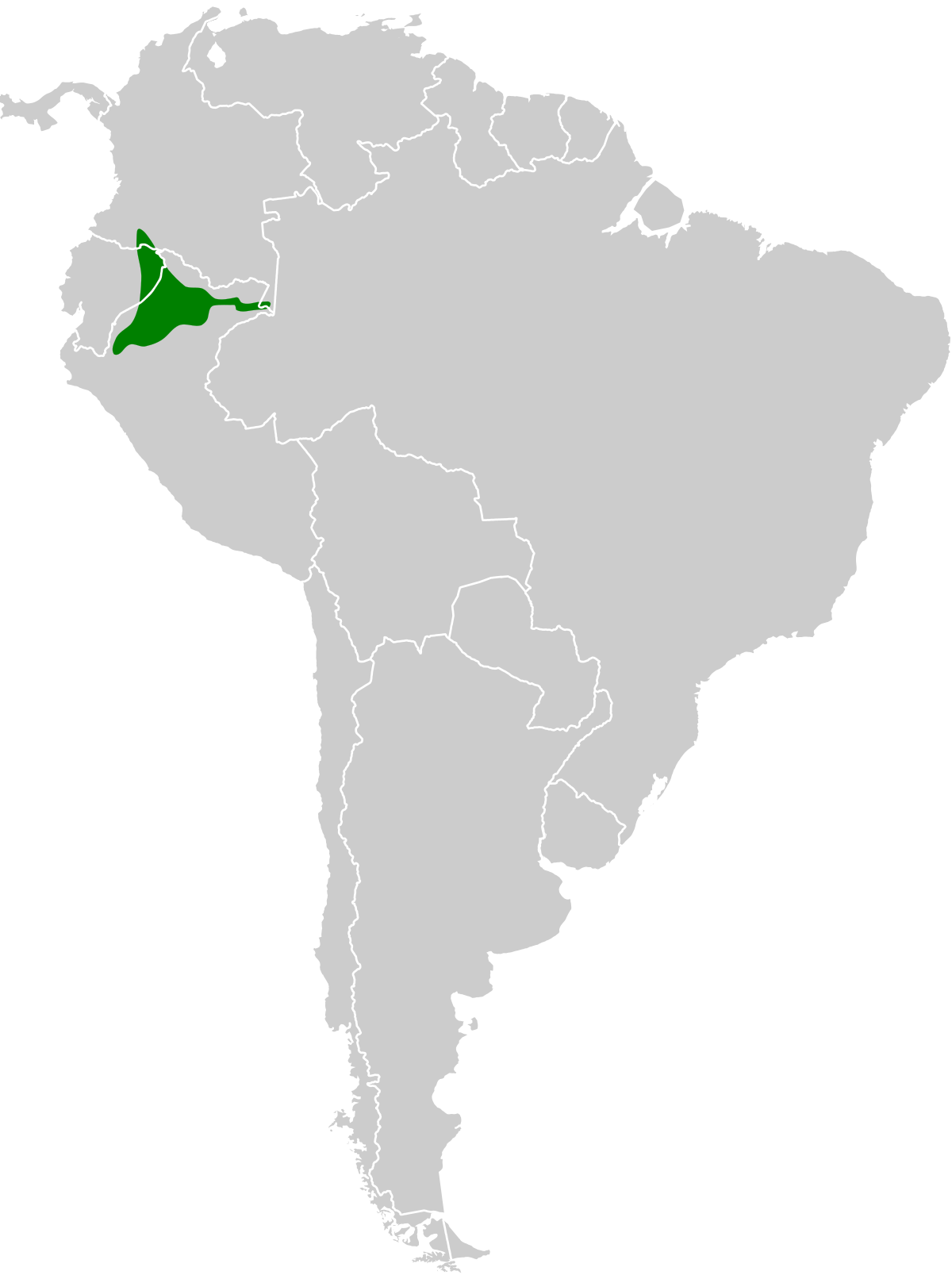
Wikipedia: Orange-eyed flycatcher Source: OTHER
1200px-Tolmomyias_traylori_map.svg.png
![]() The orange-eyed flatbill or orange-eyed flycatcher (Tolmomyias traylori) is a species of bird in the family Tyrannidae. It is found in the Amazon (specifically in várzea forest) in south-eastern Colombia, eastern Ecuador, and north-eastern Peru. First recognized as a species due to its distinct voice, it was only described in 1997; the binomial commemorates the American ornithologist Melvin Alvah Traylor Jr.[3] The International Union for Conservation of Nature has rated the conservation status of this species as being of "least concern".
[more]
The orange-eyed flatbill or orange-eyed flycatcher (Tolmomyias traylori) is a species of bird in the family Tyrannidae. It is found in the Amazon (specifically in várzea forest) in south-eastern Colombia, eastern Ecuador, and north-eastern Peru. First recognized as a species due to its distinct voice, it was only described in 1997; the binomial commemorates the American ornithologist Melvin Alvah Traylor Jr.[3] The International Union for Conservation of Nature has rated the conservation status of this species as being of "least concern".
[more]
Gray-crowned flycatcher (Tolmomyias poliocephalus)
Profile Wikipedia eBird Xeno-Canto
Wikipedia: Gray-crowned flycatcher Source: OTHER
Tolmomyias_poliocephalus_-_Gray-crowned_Flycatcher.JPG
![]() The grey-crowned flatbill or grey-crowned flycatcher (Tolmomyias poliocephalus) is a species of bird in the family Tyrannidae.
It is found in humid forest in the Amazon and Atlantic Forest in South America. It closely resembles the yellow-margined and yellow-olive flatbills, but its lower mandible is dark with a pale base. It is a fairly common bird with a wide range and the International Union for Conservation of Nature has rated it as "least concern".
[more]
The grey-crowned flatbill or grey-crowned flycatcher (Tolmomyias poliocephalus) is a species of bird in the family Tyrannidae.
It is found in humid forest in the Amazon and Atlantic Forest in South America. It closely resembles the yellow-margined and yellow-olive flatbills, but its lower mandible is dark with a pale base. It is a fairly common bird with a wide range and the International Union for Conservation of Nature has rated it as "least concern".
[more]
Black-and-white tody-flycatcher (Poecilotriccus capitalis)
Profile Wikipedia Xeno-Canto

Wikipedia: Black-and-white tody-flycatcher Source: OTHER
1200px-Poecilotriccus_capitalis_132295026.jpg
![]() The black-and-white tody-flycatcher (Poecilotriccus capitalis) is a species of bird in the family Tyrannidae. It was formerly placed in the genus Todirostrum, and known as the black-and-white tody-tyrant.[2] It is found in thickets, especially bamboo, in southern Colombia, eastern Ecuador, eastern Peru, and south-western Brazil.
[more]
The black-and-white tody-flycatcher (Poecilotriccus capitalis) is a species of bird in the family Tyrannidae. It was formerly placed in the genus Todirostrum, and known as the black-and-white tody-tyrant.[2] It is found in thickets, especially bamboo, in southern Colombia, eastern Ecuador, eastern Peru, and south-western Brazil.
[more]
Rusty-fronted tody-flycatcher (Poecilotriccus latirostris)
Profile Wikipedia eBird Xeno-Canto

Wikipedia: Rusty-fronted tody-flycatcher Source: OTHER
1200px-Poecilotriccus_latirostris_-_Rusty-fronted_tody-flycatcher.jpg
![]() The rusty-fronted tody-flycatcher (Poecilotriccus latirostris) is a species of bird in the family Tyrannidae, and one of twelve in the genus Poecilotriccus. It is found in Bolivia, Brazil, Colombia, Ecuador, and Peru. Its natural habitats are subtropical or tropical moist lowland forest and heavily degraded former forest.
[more]
The rusty-fronted tody-flycatcher (Poecilotriccus latirostris) is a species of bird in the family Tyrannidae, and one of twelve in the genus Poecilotriccus. It is found in Bolivia, Brazil, Colombia, Ecuador, and Peru. Its natural habitats are subtropical or tropical moist lowland forest and heavily degraded former forest.
[more]
Golden-winged tody-flycatcher (Poecilotriccus calopterus)
Profile Wikipedia eBird Xeno-Canto

Wikipedia: Golden-winged tody-flycatcher Source: OTHER
1200px-Poecilotriccus_calopterus_Wolf.jpg
![]() The golden-winged tody-flycatcher (Poecilotriccus calopterus) is a species of bird in the family Tyrannidae, and one of twelve in the genus Poecilotriccus.
[more]
The golden-winged tody-flycatcher (Poecilotriccus calopterus) is a species of bird in the family Tyrannidae, and one of twelve in the genus Poecilotriccus.
[more]
Rufous-crowned tody-flycatcher (Poecilotriccus ruficeps)
Profile Wikipedia eBird Xeno-Canto

Wikipedia: Rufous-crowned tody-flycatcher Source: OTHER
1200px-Poecilotriccus_ruficeps.jpg
![]() The rufous-crowned tody-flycatcher (Poecilotriccus ruficeps) is a species of bird in the family Tyrannidae, the tyrant flycatchers. It was formerly placed in the genus Todirostrum, and has been known as the rufous-crowned tody-tyrant.[2]
It is found in thickets and second growth in the Andes of Venezuela, Colombia, Ecuador and far northern Peru.
[more]
The rufous-crowned tody-flycatcher (Poecilotriccus ruficeps) is a species of bird in the family Tyrannidae, the tyrant flycatchers. It was formerly placed in the genus Todirostrum, and has been known as the rufous-crowned tody-tyrant.[2]
It is found in thickets and second growth in the Andes of Venezuela, Colombia, Ecuador and far northern Peru.
[more]
Bronze-olive pygmy-tyrant (Pseudotriccus pelzelni)
Profile Wikipedia eBird Xeno-Canto
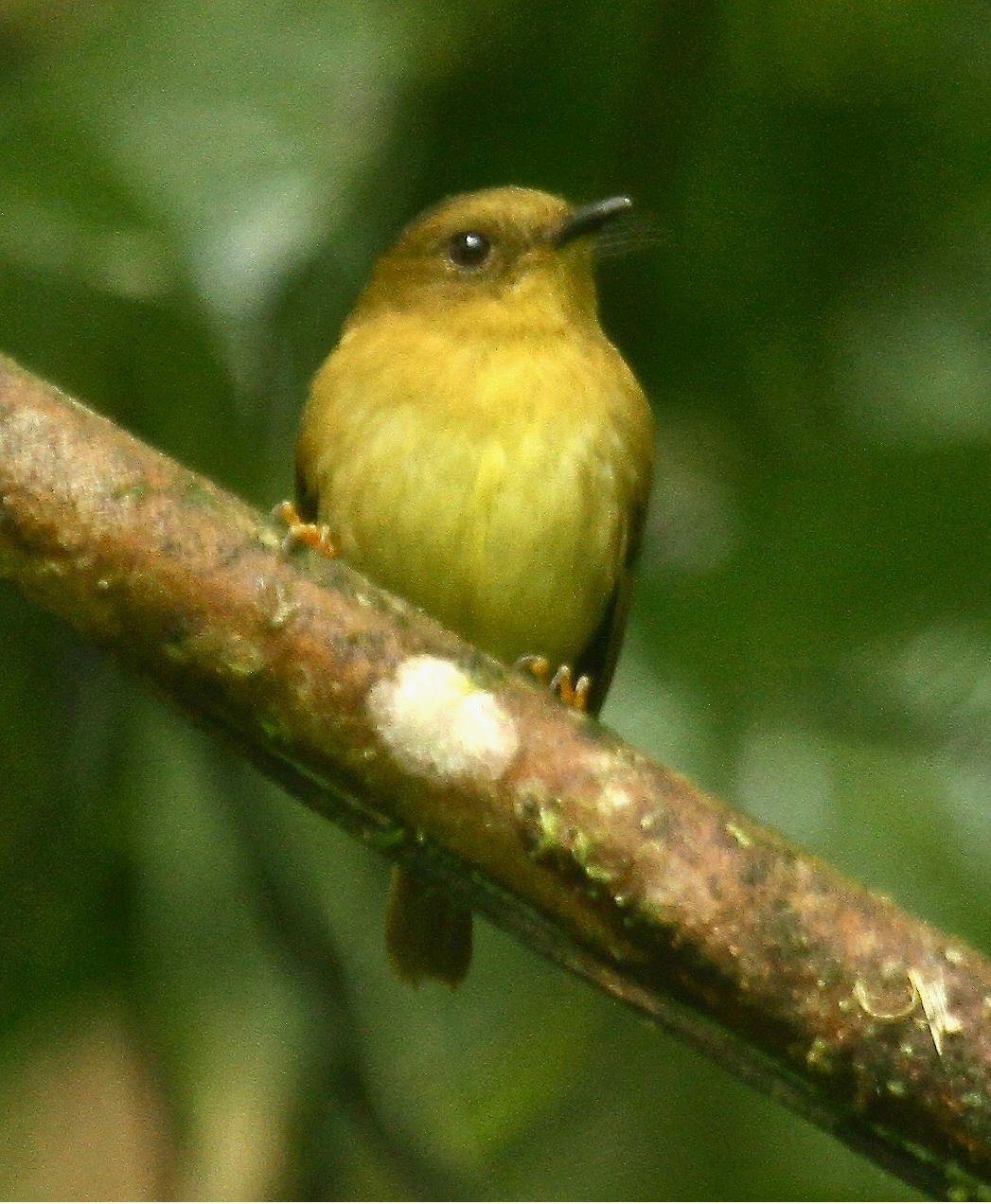
Wikipedia: Bronze-olive pygmy-tyrant Source: OTHER
Bronze-olivePygmy-Tyrant.jpg
![]() The bronze-olive pygmy tyrant (Pseudotriccus pelzelni) is a species of bird in the family Tyrannidae. It is found in Colombia, Ecuador, Panama, and Peru. Its natural habitat is subtropical or tropical moist montane forests.
[more]
The bronze-olive pygmy tyrant (Pseudotriccus pelzelni) is a species of bird in the family Tyrannidae. It is found in Colombia, Ecuador, Panama, and Peru. Its natural habitat is subtropical or tropical moist montane forests.
[more]
Rufous-headed pygmy-tyrant (Pseudotriccus ruficeps)
Profile Wikipedia eBird Xeno-Canto

Wikipedia: Rufous-headed pygmy-tyrant Source: OTHER
1200px-Pseudotriccus_ruficeps_-NBII_Image_Gallery-a00198.jpg
![]() The rufous-headed pygmy tyrant (Pseudotriccus ruficeps) is a species of bird in the family Tyrannidae. It is found in Bolivia, Colombia, Ecuador, and Peru. Its natural habitat is subtropical or tropical moist montane forests.
[more]
The rufous-headed pygmy tyrant (Pseudotriccus ruficeps) is a species of bird in the family Tyrannidae. It is found in Bolivia, Colombia, Ecuador, and Peru. Its natural habitat is subtropical or tropical moist montane forests.
[more]
Olivaceous flatbill (Rhynchocyclus olivaceus)
Profile Wikipedia eBird Xeno-Canto

Wikipedia: Olivaceous flatbill Source: OTHER
1200px-Rhynchocyclus_olivaceus_Picoplano_oliv%C3%A1ceo_Olivaceous_flatbill_%2812226833734%29.jpg
![]() The olivaceous flatbill (Rhynchocyclus olivaceus) is a species of bird in the family Tyrannidae.
[more]
The olivaceous flatbill (Rhynchocyclus olivaceus) is a species of bird in the family Tyrannidae.
[more]
Fulvous-breasted flatbill (Rhynchocyclus fulvipectus)
Profile Wikipedia eBird Xeno-Canto

Wikipedia: Fulvous-breasted flatbill Source: OTHER
Rhynchocyclus_fulvipectus_-_Fulvous-breasted_Flatbill_-_3.jpg
![]() The fulvous-breasted flatbill (Rhynchocyclus fulvipectus) is a species of bird in the family Tyrannidae. It is found in Bolivia, Colombia, Ecuador, Peru, and Venezuela. Its natural habitat is subtropical or tropical moist montane forests.
[more]
The fulvous-breasted flatbill (Rhynchocyclus fulvipectus) is a species of bird in the family Tyrannidae. It is found in Bolivia, Colombia, Ecuador, Peru, and Venezuela. Its natural habitat is subtropical or tropical moist montane forests.
[more]
Pacific flatbill (Rhynchocyclus pacificus)
Profile Wikipedia eBird Xeno-Canto

Wikipedia: Pacific flatbill Source: OTHER
1200px-Rhynchocyclus_pacificus_map.svg.png
![]() The Pacific flatbill (Rhynchocyclus pacificus) is a species of bird in the family Tyrannidae. It is found in Colombia and Ecuador.
[more]
The Pacific flatbill (Rhynchocyclus pacificus) is a species of bird in the family Tyrannidae. It is found in Colombia and Ecuador.
[more]
Streaked flycatcher / Südlicher Fleckenmaskentyrann (Myiodynastes maculatus)
Profile Wikipedia eBird Xeno-Canto
Streaked flycatcher. 2020-02-20 14.53.44 Panama
First observed in Panama on 2020-02-20.
We saw this at Los Lagartos Restaurant on the grounds of Gamboa Rainforest Resort in Panama.
General: ![]() The streaked flycatcher (Myiodynastes maculatus) is a passerine bird in the tyrant flycatcher family.
[more]
The streaked flycatcher (Myiodynastes maculatus) is a passerine bird in the tyrant flycatcher family.
[more]
Sulphur-bellied flycatcher (Myiodynastes luteiventris)
Profile Wikipedia eBird Audubon AllAboutBirds Xeno-Canto
Sulphur-bellied flycatcher, Ecotucan. 2023-04-01 09.30.12 Yucatan
First observed in Yucatan on 2023-04-01.
![]() The sulphur-bellied flycatcher (Myiodynastes luteiventris) is a large tyrant flycatcher. This bird breeds from southeasternmost Arizona of the United States (the Madrean sky islands region of Arizona, southwestern New Mexico, and northern Sonora, Mexico) to Costa Rica. They are short distance migrants, spending winters in the eastern Andean foothills of Colombia, Ecuador, Peru, Bolivia, and Brazil, and are passage migrants over the southern portions of Central America.
[more]
The sulphur-bellied flycatcher (Myiodynastes luteiventris) is a large tyrant flycatcher. This bird breeds from southeasternmost Arizona of the United States (the Madrean sky islands region of Arizona, southwestern New Mexico, and northern Sonora, Mexico) to Costa Rica. They are short distance migrants, spending winters in the eastern Andean foothills of Colombia, Ecuador, Peru, Bolivia, and Brazil, and are passage migrants over the southern portions of Central America.
[more]
Golden-crowned flycatcher (Myiodynastes chrysocephalus)
Profile Wikipedia eBird Xeno-Canto

Wikipedia: Golden-crowned flycatcher Source: OTHER
1200px-Myiodynastes_chrysocephalus-2.jpg
![]() The golden-crowned flycatcher (Myiodynastes chrysocephalus) is a species of bird in the family Tyrannidae.
[more]
The golden-crowned flycatcher (Myiodynastes chrysocephalus) is a species of bird in the family Tyrannidae.
[more]
Baird's flycatcher (Myiodynastes bairdii)
Profile Wikipedia eBird Xeno-Canto

Wikipedia: Baird's flycatcher Source: OTHER
1200px-Baird%E2%80%98s_Flycatcher.jpg
![]() Baird's flycatcher (Myiodynastes bairdii) is a species of bird in the family Tyrannidae.
It is found in Ecuador and Peru.
Its natural habitats are subtropical or tropical dry forests, subtropical or tropical moist lowland forests, and heavily degraded former forest.
[more]
Baird's flycatcher (Myiodynastes bairdii) is a species of bird in the family Tyrannidae.
It is found in Ecuador and Peru.
Its natural habitats are subtropical or tropical dry forests, subtropical or tropical moist lowland forests, and heavily degraded former forest.
[more]
Great kiskadee / Schwefelmaskentyrann (Pitangus sulphuratus)
Profile Wikipedia eBird A-Z Animals Audubon AllAboutBirds Xeno-Canto
Great kiskadee bird eating fruit. 2018-02-26 10.28.58 Costa Rica
First observed in Costa Rica on 2018-02-26.
![]() The great kiskadee (Pitangus sulphuratus), called bem-te-vi in Brazil, is a passerine bird in the tyrant flycatcher family Tyrannidae. It is the only member of the genus Pitangus.
[more]
The great kiskadee (Pitangus sulphuratus), called bem-te-vi in Brazil, is a passerine bird in the tyrant flycatcher family Tyrannidae. It is the only member of the genus Pitangus.
[more]
Vermilion flycatcher (Pyrocephalus rubinus)
Profile Wikipedia eBird A-Z Animals Audubon AllAboutBirds Xeno-Canto

Wikipedia: Vermilion flycatcher Source: OTHER
1200px-Vermilion_Flycatcher_by_Dan_Pancamo.jpg
![]() The vermilion flycatcher (Pyrocephalus obscurus) is a small passerine bird in the tyrant flycatcher family found throughout South America and southern North America. It is a striking exception among the generally drab Tyrannidae due to its vermilion-red coloration. The males have bright red crowns, chests, and underparts, with brownish wings and tails. Females lack the vivid red coloration and can be hard to identify—they may be confused for the Say's phoebe. The vermilion flycatcher's song is a pit pit pit pidddrrrreeedrr, which is variable and important in establishing a territory. Riparian habitats and semi-open environments are preferred. As aerial insectivores, they catch their prey while flying. Their several months-long molt begins in summer.
[more]
The vermilion flycatcher (Pyrocephalus obscurus) is a small passerine bird in the tyrant flycatcher family found throughout South America and southern North America. It is a striking exception among the generally drab Tyrannidae due to its vermilion-red coloration. The males have bright red crowns, chests, and underparts, with brownish wings and tails. Females lack the vivid red coloration and can be hard to identify—they may be confused for the Say's phoebe. The vermilion flycatcher's song is a pit pit pit pidddrrrreeedrr, which is variable and important in establishing a territory. Riparian habitats and semi-open environments are preferred. As aerial insectivores, they catch their prey while flying. Their several months-long molt begins in summer.
[more]
Southern beardless-tyrannulet (Camptostoma obsoletum)
Profile Wikipedia eBird Xeno-Canto
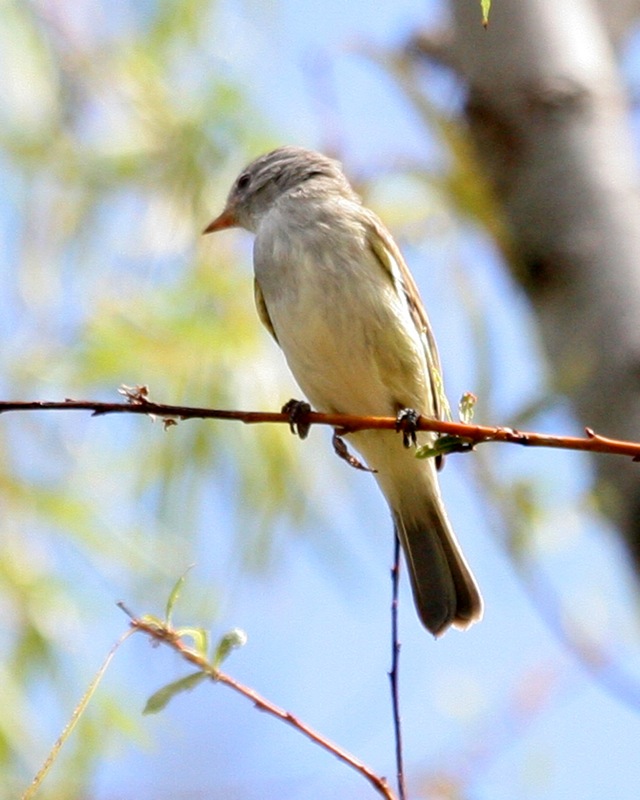
Wikipedia: Southern beardless-tyrannulet Source: OTHER
Southern_Beardless_Tyrannulet.jpg
![]() The southern beardless tyrannulet (Camptostoma obsoletum) is a small passerine bird in the tyrant flycatcher family. It breeds from Costa Rica through South America south to Paraguay, Bolivia, and Argentina.
[more]
The southern beardless tyrannulet (Camptostoma obsoletum) is a small passerine bird in the tyrant flycatcher family. It breeds from Costa Rica through South America south to Paraguay, Bolivia, and Argentina.
[more]
Riverside tyrant (Knipolegus orenocensis)
Profile Wikipedia eBird Xeno-Canto

Wikipedia: Riverside tyrant Source: OTHER
1200px-Cnipolegusorenocensis.JPG
![]() The riverside tyrant (Knipolegus orenocensis) is a species of bird in the family Tyrannidae.
It is found in Brazil, Colombia, Ecuador, Peru, and Venezuela.
Its natural habitat is subtropical or tropical moist shrubland.
[more]
The riverside tyrant (Knipolegus orenocensis) is a species of bird in the family Tyrannidae.
It is found in Brazil, Colombia, Ecuador, Peru, and Venezuela.
Its natural habitat is subtropical or tropical moist shrubland.
[more]
Amazonian black-tyrant (Knipolegus poecilocercus)

Wikipedia: Amazonian black-tyrant Source: OTHER
1200px-Knipolegus_poecilocercus_-_Amazonian_Black-Tyrant_%28female%29%2C_Anavilhanas_islands%2C_%2C_Novo_Air%C3%A3o%2C_Amazonas%2C_Brazil.jpg
![]() The Amazonian black tyrant (Knipolegus poecilocercus) is a species of bird in the family Tyrannidae. It is found in subtropical or tropical swamps in Brazil, Colombia, Ecuador, Guyana, Peru, and Venezuela.
[more]
The Amazonian black tyrant (Knipolegus poecilocercus) is a species of bird in the family Tyrannidae. It is found in subtropical or tropical swamps in Brazil, Colombia, Ecuador, Guyana, Peru, and Venezuela.
[more]
Rufous-tailed tyrant (Knipolegus poecilurus)
Profile Wikipedia eBird Xeno-Canto

Wikipedia: Rufous-tailed tyrant Source: OTHER
1200px-Knipolegus_poecilurus_%28Atrapamoscas_ojirrojo%29_%2814021842042%29.jpg
![]() The rufous-tailed tyrant (Knipolegus poecilurus) is a species of bird in the family Tyrannidae.
It is found in Bolivia, Brazil, Colombia, Ecuador, Guyana, Peru, and Venezuela.
Its natural habitats are subtropical or tropical moist montane forests, subtropical or tropical high-altitude shrubland, and heavily degraded former forest.
[more]
The rufous-tailed tyrant (Knipolegus poecilurus) is a species of bird in the family Tyrannidae.
It is found in Bolivia, Brazil, Colombia, Ecuador, Guyana, Peru, and Venezuela.
Its natural habitats are subtropical or tropical moist montane forests, subtropical or tropical high-altitude shrubland, and heavily degraded former forest.
[more]
Jelski's black-tyrant (Knipolegus signatus)
Profile Wikipedia eBird Xeno-Canto

Wikipedia: Jelski's black-tyrant Source: OTHER
1200px-Knipolegus_signatus_map.svg.png
![]() Jelski's black tyrant (Knipolegus signatus) is a species of bird in the family Tyrannidae. It is found from southern Ecuador to northwestern Argentina. Its natural habitat is subtropical or tropical moist montane forests. This and the plumbeous tyrant are sometimes considered conspecific, in which case, the bird is then usually referred to as the Andean tyrant.
[more]
Jelski's black tyrant (Knipolegus signatus) is a species of bird in the family Tyrannidae. It is found from southern Ecuador to northwestern Argentina. Its natural habitat is subtropical or tropical moist montane forests. This and the plumbeous tyrant are sometimes considered conspecific, in which case, the bird is then usually referred to as the Andean tyrant.
[more]
Torrent tyrannulet (Serpophaga cinerea)
Profile Wikipedia eBird Xeno-Canto

Wikipedia: Torrent tyrannulet Source: OTHER
1200px-Torrent_Tyrannulet.jpg
![]() The torrent tyrannulet (Serpophaga cinerea) is a small bird of the tyrant flycatcher family. It breeds from Costa Rica south to northern Bolivia and northwestern Venezuela.
[more]
The torrent tyrannulet (Serpophaga cinerea) is a small bird of the tyrant flycatcher family. It breeds from Costa Rica south to northern Bolivia and northwestern Venezuela.
[more]
River tyrannulet (Serpophaga hypoleuca)
Profile Wikipedia eBird Xeno-Canto

Wikipedia: River tyrannulet Source: OTHER
1200px-Serpophaga_hypoleuca_-_River_tyrannulet%3B_Marchantaria_Island%2C_Iranduba%2C_Amazonas%2C_Brazil.jpg
![]() The river tyrannulet (Serpophaga hypoleuca) is a species of bird in the family Tyrannidae, the tyrant flycatchers.
It is found in Peru, Venezuela and Brazil; also river extensions into Ecuador, Colombia-(border) and Bolivia.
[more]
The river tyrannulet (Serpophaga hypoleuca) is a species of bird in the family Tyrannidae, the tyrant flycatchers.
It is found in Peru, Venezuela and Brazil; also river extensions into Ecuador, Colombia-(border) and Bolivia.
[more]
White-throated tyrannulet (Mecocerculus leucophrys)
Profile Wikipedia eBird Xeno-Canto

Wikipedia: White-throated tyrannulet Source: OTHER
Mecocerculus_leucophrys_-Ecuador-8.jpg
Ecuador
![]() The white-throated tyrannulet (Mecocerculus leucophrys) is a species of bird in the family Tyrannidae.
[more]
The white-throated tyrannulet (Mecocerculus leucophrys) is a species of bird in the family Tyrannidae.
[more]
White-banded tyrannulet (Mecocerculus stictopterus)
Profile Wikipedia eBird Xeno-Canto

Wikipedia: White-banded tyrannulet Source: OTHER
Mecocerculus_stictopterus_-Eduador-8.jpg
![]() The white-banded tyrannulet (Mecocerculus stictopterus) is a species of bird in the family Tyrannidae.
[more]
The white-banded tyrannulet (Mecocerculus stictopterus) is a species of bird in the family Tyrannidae.
[more]
White-tailed tyrannulet (Mecocerculus poecilocercus)
Profile Wikipedia eBird Xeno-Canto

Wikipedia: White-tailed tyrannulet Source: OTHER
White-tailedTyrannulet.jpg
![]() The white-tailed tyrannulet (Mecocerculus poecilocercus) is a species of bird in the family Tyrannidae.
[more]
The white-tailed tyrannulet (Mecocerculus poecilocercus) is a species of bird in the family Tyrannidae.
[more]
Rufous-winged tyrannulet (Mecocerculus calopterus)
Profile Wikipedia eBird Xeno-Canto

Wikipedia: Rufous-winged tyrannulet Source: OTHER
1200px-ChlorospingusSerpophagaKeulemans_%28cropped%29_%28cropped%29.jpg
![]() The rufous-winged tyrannulet (Mecocerculus calopterus) is a species of bird in the family Tyrannidae. It is found in Ecuador and Peru. Its natural habitats are subtropical or tropical dry forests and subtropical or tropical moist montane forests.
[more]
The rufous-winged tyrannulet (Mecocerculus calopterus) is a species of bird in the family Tyrannidae. It is found in Ecuador and Peru. Its natural habitats are subtropical or tropical dry forests and subtropical or tropical moist montane forests.
[more]
Sulphur-bellied tyrannulet (Mecocerculus minor)
Profile Wikipedia eBird Xeno-Canto
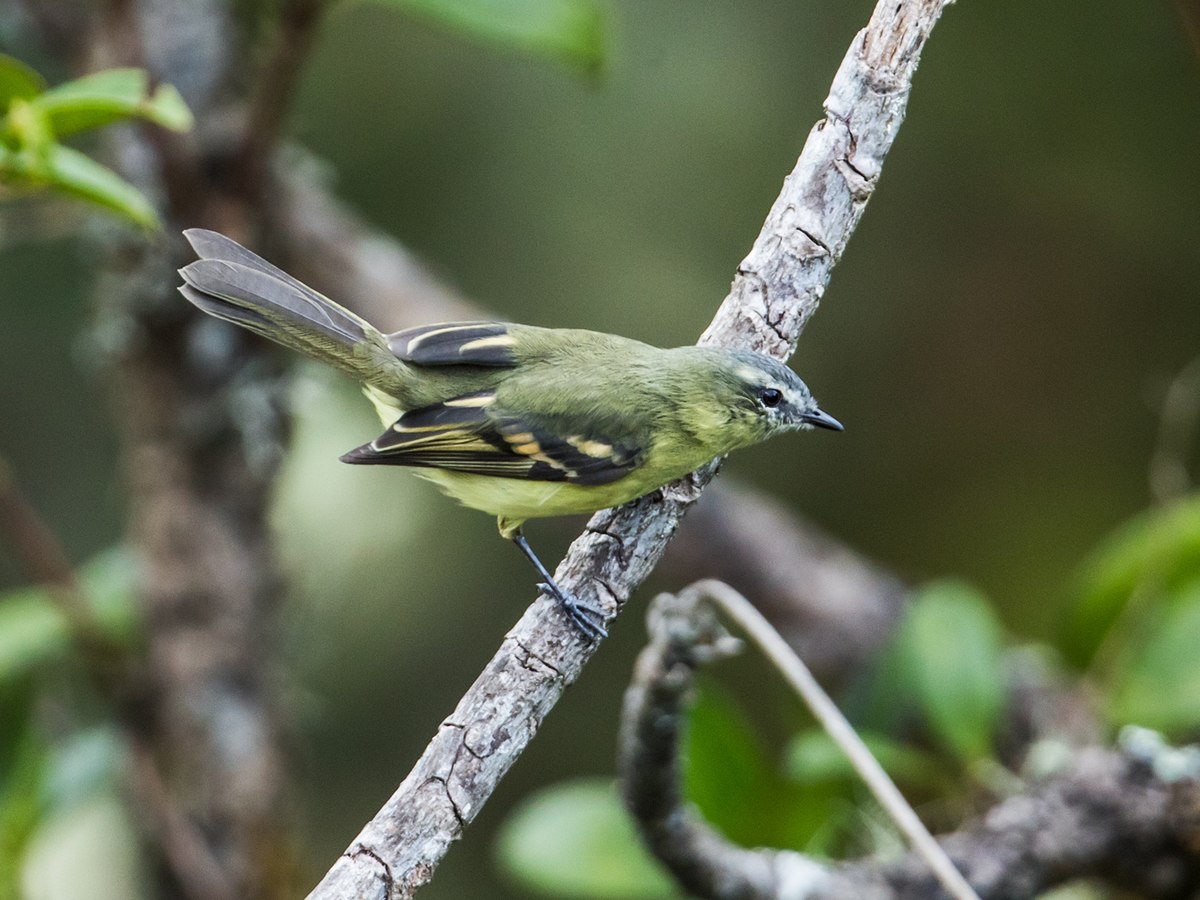
Wikipedia: Sulphur-bellied tyrannulet Source: OTHER
1200px-Mecocerculus_minor_-_Sulphur-bellied_Tyrannulet_%28cropped%29.jpg
![]() The sulphur-bellied tyrannulet (Mecocerculus minor) is a species of bird in the family Tyrannidae. It is found in the eastern Andes of Colombia, Ecuador and Peru. Its natural habitat is subtropical or tropical moist montane forests.
[more]
The sulphur-bellied tyrannulet (Mecocerculus minor) is a species of bird in the family Tyrannidae. It is found in the eastern Andes of Colombia, Ecuador and Peru. Its natural habitat is subtropical or tropical moist montane forests.
[more]
Bran-colored flycatcher (Myiophobus fasciatus)
Profile Wikipedia eBird Xeno-Canto

Wikipedia: Bran-colored flycatcher Source: OTHER
1200px-Myiophobus_fasciatus_54670465.jpg
![]() The bran-colored flycatcher (Myiophobus fasciatus) is a small passerine bird in the tyrant flycatcher family. It breeds from Costa Rica through South America to Bolivia, Uruguay, and Argentina. It also occurs on Trinidad.
[more]
The bran-colored flycatcher (Myiophobus fasciatus) is a small passerine bird in the tyrant flycatcher family. It breeds from Costa Rica through South America to Bolivia, Uruguay, and Argentina. It also occurs on Trinidad.
[more]
Olive-chested flycatcher (Myiophobus cryptoxanthus)
Profile Wikipedia eBird Xeno-Canto

Wikipedia: Olive-chested flycatcher Source: OTHER
1200px-Myiophobus_cryptoxanthus_map.svg.png
![]() The olive-chested flycatcher (Myiophobus cryptoxanthus) is a species of bird in the family Tyrannidae. It is found in Ecuador and Peru. Its natural habitat is subtropical or tropical moist montane forests.
[more]
The olive-chested flycatcher (Myiophobus cryptoxanthus) is a species of bird in the family Tyrannidae. It is found in Ecuador and Peru. Its natural habitat is subtropical or tropical moist montane forests.
[more]
Flavescent flycatcher (Myiophobus flavicans)
Profile Wikipedia eBird Xeno-Canto

Wikipedia: Flavescent flycatcher Source: OTHER
1200px-MyiobiusFlavicansSmit.jpg
![]() The flavescent flycatcher (Myiophobus flavicans) is a species of bird in the family Tyrannidae. Its name comes from flavescent, a yellowish colour. It is found in Colombia, Ecuador, Peru, and Venezuela. Its natural habitat is subtropical or tropical moist montane forests.
[more]
The flavescent flycatcher (Myiophobus flavicans) is a species of bird in the family Tyrannidae. Its name comes from flavescent, a yellowish colour. It is found in Colombia, Ecuador, Peru, and Venezuela. Its natural habitat is subtropical or tropical moist montane forests.
[more]
Roraiman flycatcher (Myiophobus roraimae)
Profile Wikipedia eBird Xeno-Canto

Wikipedia: Roraiman flycatcher Source: OTHER
1200px-Myiophobus_roraimae.jpg
![]() The Roraiman flycatcher (Myiophobus roraimae) is a species of bird in the family Tyrannidae. It is found in Bolivia, Brazil, Colombia, Ecuador, Guyana, Peru, and Venezuela. Its natural habitat is subtropical or tropical moist montane forests.
[more]
The Roraiman flycatcher (Myiophobus roraimae) is a species of bird in the family Tyrannidae. It is found in Bolivia, Brazil, Colombia, Ecuador, Guyana, Peru, and Venezuela. Its natural habitat is subtropical or tropical moist montane forests.
[more]
Orange-crested flycatcher (Myiophobus phoenicomitra)
Profile Wikipedia eBird Xeno-Canto

Wikipedia: Orange-crested flycatcher Source: OTHER
1200px-Myiophobus_phoenicomitra.jpg
![]() The orange-crested flycatcher (Myiophobus phoenicomitra) is a species of bird in the family Tyrannidae. It is found in Colombia, Ecuador, and Peru. Its natural habitat is subtropical or tropical moist montane forests.
[more]
The orange-crested flycatcher (Myiophobus phoenicomitra) is a species of bird in the family Tyrannidae. It is found in Colombia, Ecuador, and Peru. Its natural habitat is subtropical or tropical moist montane forests.
[more]
Cinnamon manakin-tyrant (Neopipo cinnamomea)
Profile Wikipedia eBird Xeno-Canto

Wikipedia: Cinnamon manakin-tyrant Source: OTHER
Neopipo_cinnamomea_-_Cinnamon_neopipo.jpg
![]() The cinnamon neopipo or cinnamon manakin-tyrant (Neopipo cinnamomea) is a species of bird in the family Tyrannidae. It is the only member of the genus Neopipo.[3]
[more]
The cinnamon neopipo or cinnamon manakin-tyrant (Neopipo cinnamomea) is a species of bird in the family Tyrannidae. It is the only member of the genus Neopipo.[3]
[more]
White-browed chat-tyrant (Ochthoeca leucophrys)
Profile Wikipedia eBird Xeno-Canto

Wikipedia: White-browed chat-tyrant Source: OTHER
1200px-OchthoecaLeucometopaSmit.jpg
![]() The white-browed chat-tyrant (Ochthoeca leucophrys) is a species of bird in the family Tyrannidae. It is found in the Puna grassland.
[more]
The white-browed chat-tyrant (Ochthoeca leucophrys) is a species of bird in the family Tyrannidae. It is found in the Puna grassland.
[more]
Rufous-breasted chat-tyrant (Ochthoeca rufipectoralis)
Profile Wikipedia eBird Xeno-Canto
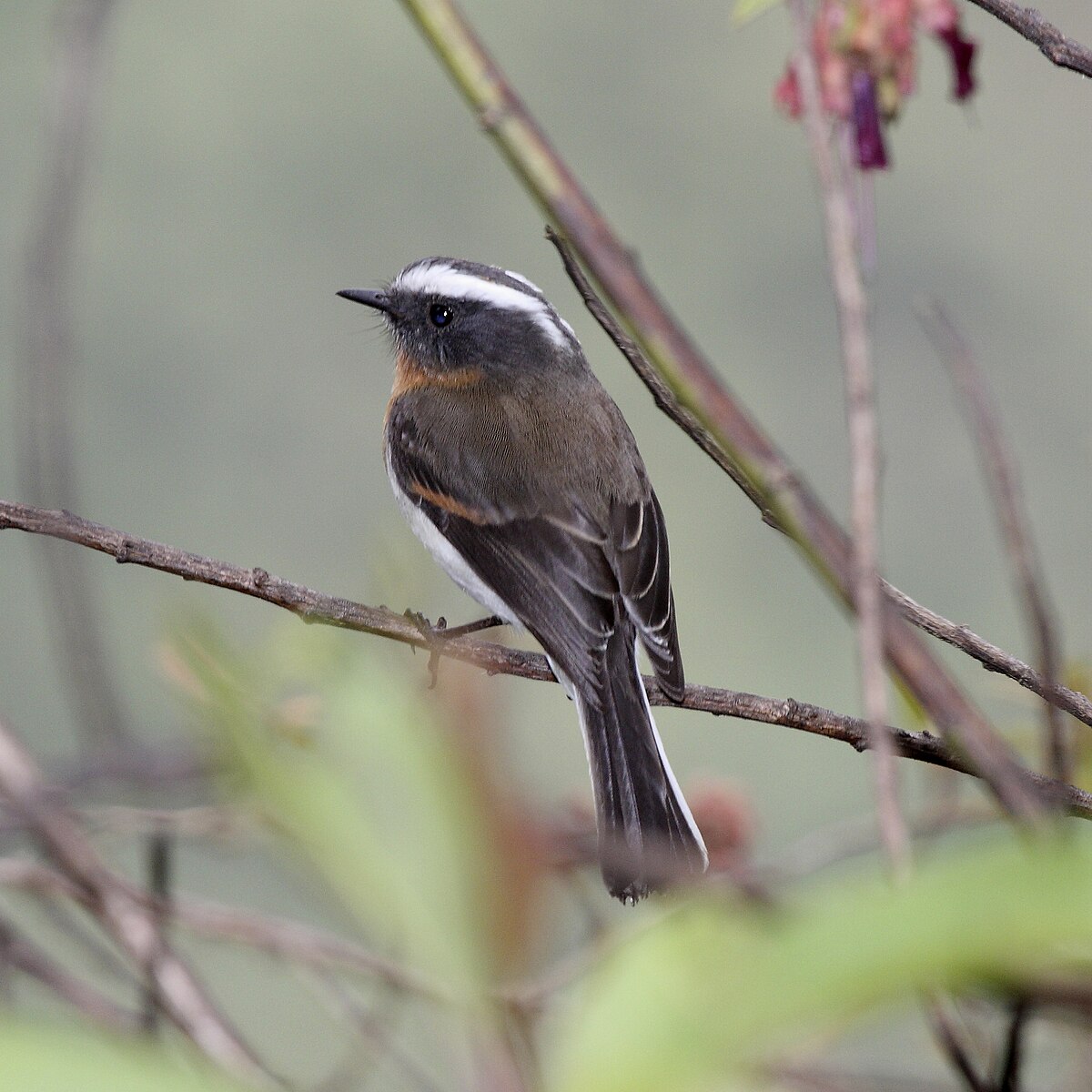
Wikipedia: Rufous-breasted chat-tyrant Source: OTHER
1200px-Rufous-breasted_Chat-tyrant_%28Ochthoeca_rufipectoralis%29.jpg
![]() The rufous-breasted chat-tyrant (Ochthoeca rufipectoralis) is a species of bird in the family Tyrannidae. It is found in Bolivia, Colombia, Ecuador, Peru, and Venezuela.
[more]
The rufous-breasted chat-tyrant (Ochthoeca rufipectoralis) is a species of bird in the family Tyrannidae. It is found in Bolivia, Colombia, Ecuador, Peru, and Venezuela.
[more]
Brown-backed chat-tyrant (Ochthoeca fumicolor)
Profile Wikipedia eBird Xeno-Canto
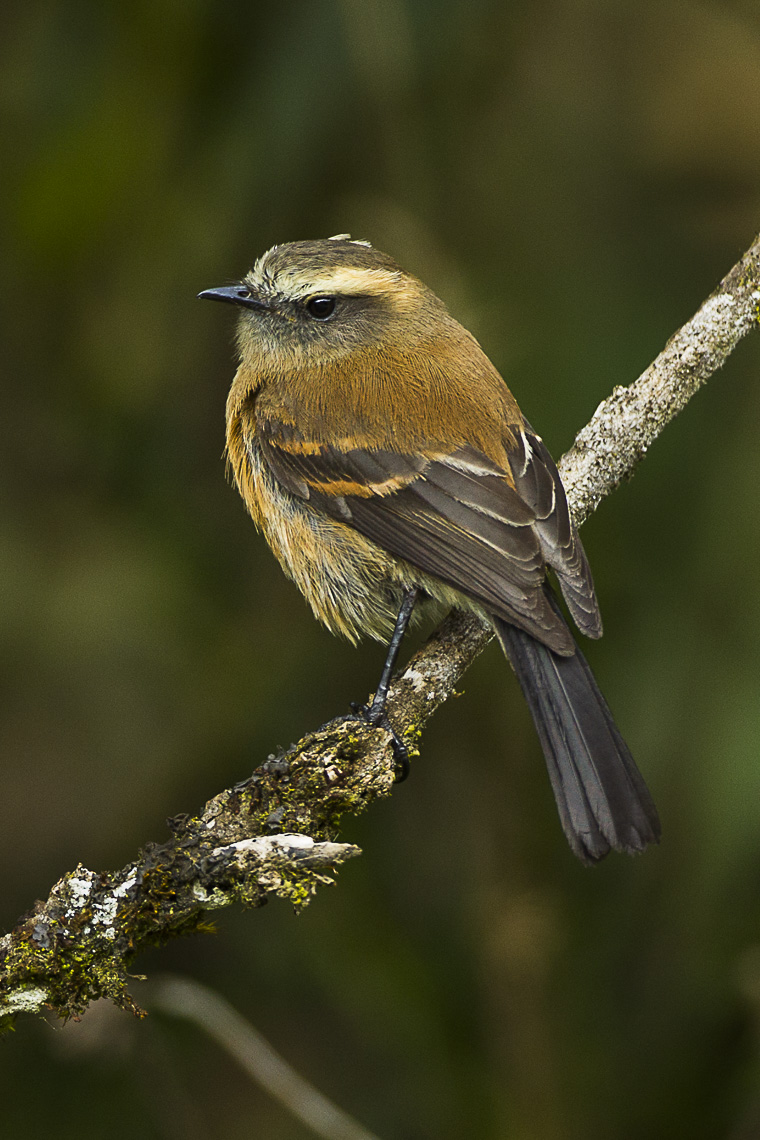
Wikipedia: Brown-backed chat-tyrant Source: OTHER
Brown-backed_Chat-Tyrant_-_Colombia_S4E1525.jpg
![]() The brown-backed chat-tyrant (Ochthoeca fumicolor) is a species of bird in the family Tyrannidae. It is found in Bolivia, Colombia, Ecuador, Peru, and Venezuela.
[more]
The brown-backed chat-tyrant (Ochthoeca fumicolor) is a species of bird in the family Tyrannidae. It is found in Bolivia, Colombia, Ecuador, Peru, and Venezuela.
[more]
Yellow-bellied chat-tyrant (Ochthoeca diadema)
Profile Wikipedia eBird Xeno-Canto

Wikipedia: Yellow-bellied chat-tyrant Source: OTHER
1200px-Ochthoeca_diadema.jpg
![]() The yellow-bellied chat-tyrant (Silvicultrix diadema) is a species of passerine bird in the family Tyrannidae. It is 12–12.5 cm (4.7–4.9 in) in length. It is a chunky bird with a short, thin bill. It is mostly olive with an ochre yellow forehead and long yellow eyebrow. It has dusky colored wings and tail with two rufous tail bars. It is mostly found in Colombia, Ecuador, Peru, and Venezuela. It feeds in separated pairs hunting near the ground in foliage.
[more]
The yellow-bellied chat-tyrant (Silvicultrix diadema) is a species of passerine bird in the family Tyrannidae. It is 12–12.5 cm (4.7–4.9 in) in length. It is a chunky bird with a short, thin bill. It is mostly olive with an ochre yellow forehead and long yellow eyebrow. It has dusky colored wings and tail with two rufous tail bars. It is mostly found in Colombia, Ecuador, Peru, and Venezuela. It feeds in separated pairs hunting near the ground in foliage.
[more]
Slaty-backed chat-tyrant (Ochthoeca cinnamomeiventris)
Profile Wikipedia eBird Xeno-Canto

Wikipedia: Slaty-backed chat-tyrant Source: OTHER
1200px-Ochthoeca_cinnamomeiventris_106401038.jpg
![]() The slaty-backed chat-tyrant (Ochthoeca cinnamomeiventris) is a species of bird in the tyrant flycatcher family. It is found in Bolivia, Colombia, Ecuador, Peru, and Venezuela. Its natural habitats are subtropical or tropical moist montane forests and heavily degraded former forest.
[more]
The slaty-backed chat-tyrant (Ochthoeca cinnamomeiventris) is a species of bird in the tyrant flycatcher family. It is found in Bolivia, Colombia, Ecuador, Peru, and Venezuela. Its natural habitats are subtropical or tropical moist montane forests and heavily degraded former forest.
[more]
Brown-capped tyrannulet (Ornithion brunneicapillus)
Profile Wikipedia eBird Xeno-Canto
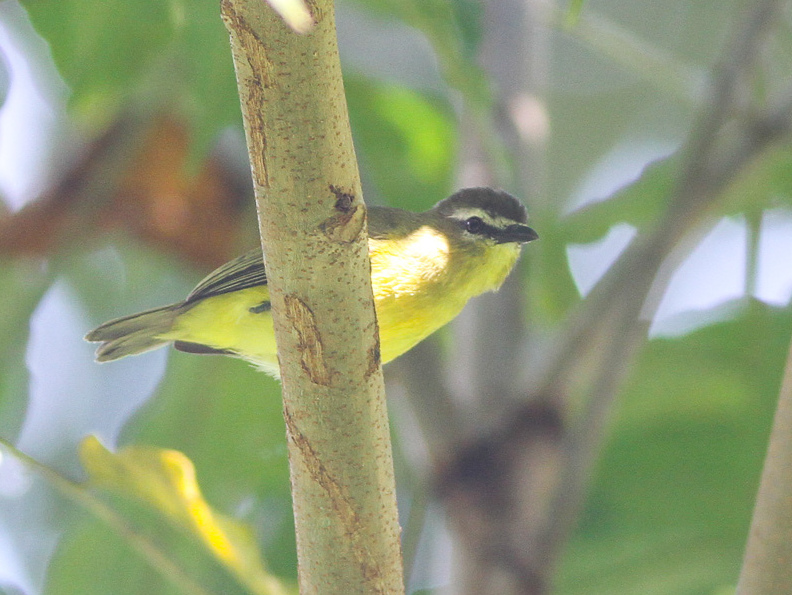
Wikipedia: Brown-capped tyrannulet Source: OTHER
Brown-capped_Tyrannulet_%28Ornithion_brunneicapillus%29_%288079747729%29.jpg
![]() The brown-capped tyrannulet (Ornithion brunneicapillus) is a species of bird in the family Tyrannidae. It is found in Colombia, Costa Rica, Ecuador, Panama, and Venezuela. Its natural habitats are subtropical or tropical moist lowland forests and heavily degraded former forest.
[more]
The brown-capped tyrannulet (Ornithion brunneicapillus) is a species of bird in the family Tyrannidae. It is found in Colombia, Costa Rica, Ecuador, Panama, and Venezuela. Its natural habitats are subtropical or tropical moist lowland forests and heavily degraded former forest.
[more]
White-lored tyrannulet (Ornithion inerme)
Profile Wikipedia eBird Xeno-Canto
Wikipedia: White-lored tyrannulet Source: OTHER
Ornithion_inerme_-_White-lored_tyrannulet.JPG
![]() The white-lored tyrannulet (Ornithion inerme) is a species of bird in the family Tyrannidae. It is found in Bolivia, Brazil, Colombia, Ecuador, French Guiana, Guyana, Peru, Suriname, and Venezuela. Its natural habitats are subtropical or tropical moist lowland forest and subtropical or tropical swamps.
[more]
The white-lored tyrannulet (Ornithion inerme) is a species of bird in the family Tyrannidae. It is found in Bolivia, Brazil, Colombia, Ecuador, French Guiana, Guyana, Peru, Suriname, and Venezuela. Its natural habitats are subtropical or tropical moist lowland forest and subtropical or tropical swamps.
[more]
Mouse-colored tyrannulet (alternate) (Phaeomyias murina)
Rufous-browed tyrannulet (Phylloscartes superciliaris)
Profile Wikipedia eBird Xeno-Canto

Wikipedia: Rufous-browed tyrannulet Source: OTHER
Phylloscartes_superciliaris.jpg
![]() The rufous-browed tyrannulet (Phylloscartes superciliaris) is a species of bird in the family Tyrannidae.
[more]
The rufous-browed tyrannulet (Phylloscartes superciliaris) is a species of bird in the family Tyrannidae.
[more]
Ecuadorian tyrannulet (Phylloscartes gualaquizae)
Profile Wikipedia eBird Xeno-Canto
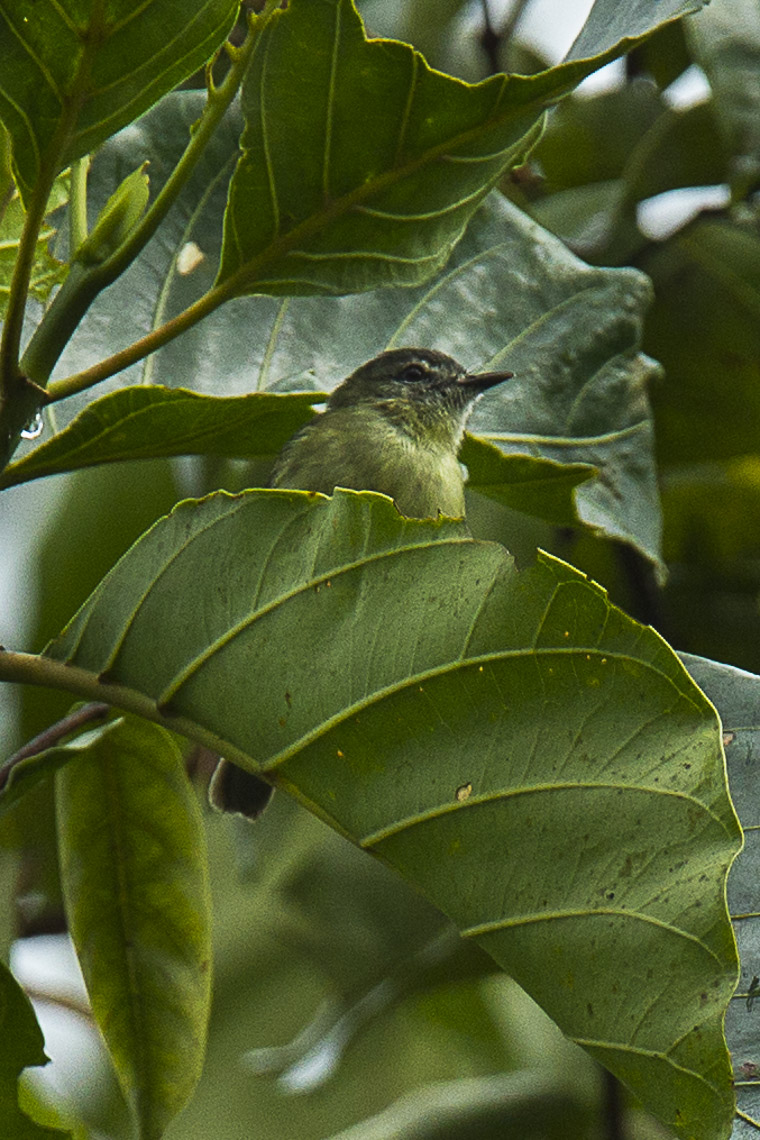
Wikipedia: Ecuadorian tyrannulet Source: OTHER
Ecuadorian_Tyrannulet_-_South_Ecuador_S4E0296_%2816685960400%29.jpg
![]() The Ecuadorian tyrannulet (Phylloscartes gualaquizae) is a species of bird in the family Tyrannidae. It is found in Ecuador and northern Peru. Its natural habitat is subtropical or tropical moist montane forests.
[more]
The Ecuadorian tyrannulet (Phylloscartes gualaquizae) is a species of bird in the family Tyrannidae. It is found in Ecuador and northern Peru. Its natural habitat is subtropical or tropical moist montane forests.
[more]
Spectacled bristle-tyrant (Phylloscartes orbitalis)
Profile Wikipedia eBird Xeno-Canto

Wikipedia: Spectacled bristle-tyrant Source: OTHER
1200px-Phylloscartes_orbitalis_map.svg.png
![]() The spectacled bristle tyrant (Pogonotriccus orbitalis) is a species of passerine bird in the family Tyrannidae. This species is sometimes placed in the genus Phylloscartes.
[more]
The spectacled bristle tyrant (Pogonotriccus orbitalis) is a species of passerine bird in the family Tyrannidae. This species is sometimes placed in the genus Phylloscartes.
[more]
Variegated bristle-tyrant (Phylloscartes poecilotis)
Profile Wikipedia eBird Xeno-Canto
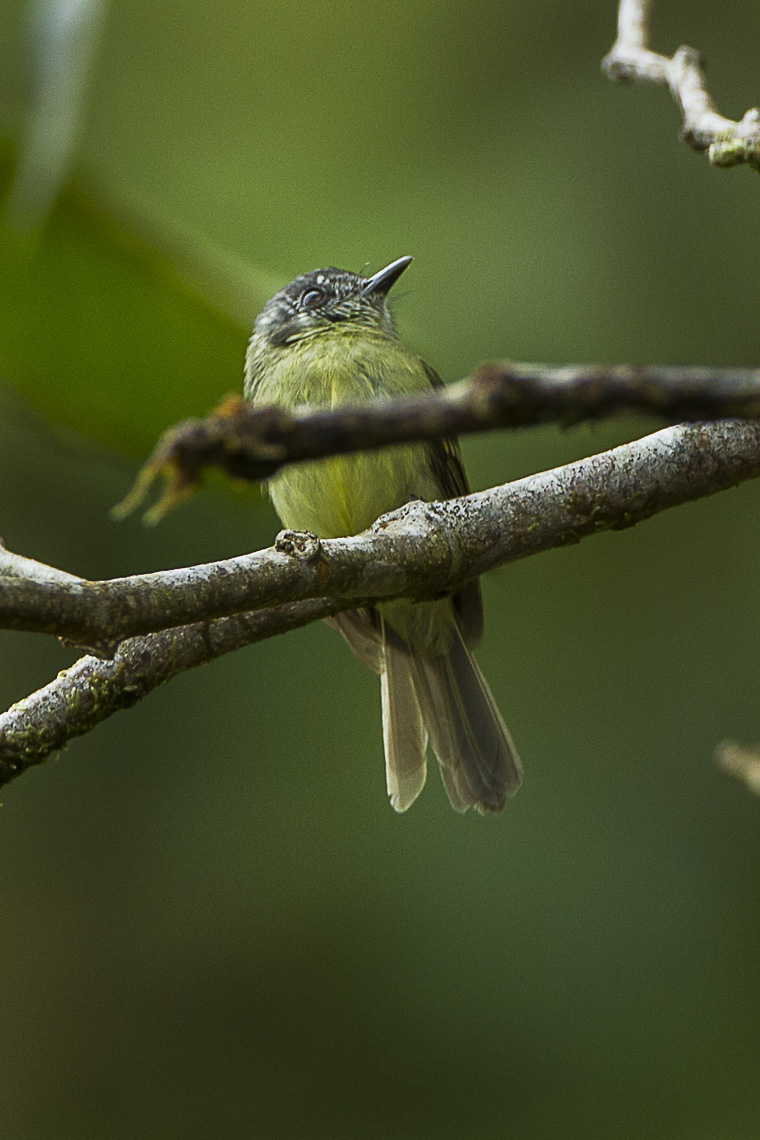
Wikipedia: Variegated bristle-tyrant Source: OTHER
Variegated_Bristle-Tyrant_-_Colombia_S4E9894_%2816251007584%29.jpg
![]() The variegated bristle tyrant (Pogonotriccus poecilotis) is a species of passerine bird in the family Tyrannidae. It is found in Colombia, Ecuador, Peru, and Venezuela. This species is sometimes placed in the genus Phylloscartes.
[more]
The variegated bristle tyrant (Pogonotriccus poecilotis) is a species of passerine bird in the family Tyrannidae. It is found in Colombia, Ecuador, Peru, and Venezuela. This species is sometimes placed in the genus Phylloscartes.
[more]
Marble-faced bristle-tyrant (Phylloscartes ophthalmicus)
Profile Wikipedia eBird Xeno-Canto

Wikipedia: Marble-faced bristle-tyrant Source: OTHER
1200px-Marble-faced-Bristle-tyrant.jpg
![]() The marble-faced bristle tyrant (Pogonotriccus ophthalmicus) is a species of passerine bird in the family Tyrannidae. This species is sometimes placed in the genus Phylloscartes. It is found in Bolivia, Colombia, Ecuador, Peru, and Venezuela. Its natural habitat is subtropical or tropical moist montane forests.
[more]
The marble-faced bristle tyrant (Pogonotriccus ophthalmicus) is a species of passerine bird in the family Tyrannidae. This species is sometimes placed in the genus Phylloscartes. It is found in Bolivia, Colombia, Ecuador, Peru, and Venezuela. Its natural habitat is subtropical or tropical moist montane forests.
[more]
Yellow-crowned tyrannulet (Tyrannulus elatus)
Profile Wikipedia eBird Xeno-Canto

Wikipedia: Yellow-crowned tyrannulet Source: OTHER
1200px-Yellow-crowned_Tyrannulet_%28Tyrannulus_elatus%29.jpg
![]() The yellow-crowned tyrannulet (Tyrannulus elatus) is a species of bird in the family Tyrannidae. It is monotypic within the genus Tyrannulus.[2] It is found in Bolivia, Brazil, Colombia, Costa Rica, Ecuador, French Guiana, Guyana, Panama, Peru, Suriname, and Venezuela, where its natural habitats are subtropical or tropical moist lowland forest, subtropical or tropical swamps, and heavily degraded former forest.[1]
[more]
The yellow-crowned tyrannulet (Tyrannulus elatus) is a species of bird in the family Tyrannidae. It is monotypic within the genus Tyrannulus.[2] It is found in Bolivia, Brazil, Colombia, Costa Rica, Ecuador, French Guiana, Guyana, Panama, Peru, Suriname, and Venezuela, where its natural habitats are subtropical or tropical moist lowland forest, subtropical or tropical swamps, and heavily degraded former forest.[1]
[more]
Choco tyrannulet (Zimmerius albigularis)

Wikipedia: Choco tyrannulet Source: OTHER
1200px-Zimmerius_albigularis_map.svg.png
![]() The Choco tyrannulet (Zimmerius albigularis) is a species of bird in the family Tyrannidae, the tyrant flycatchers. It is found in forests in the Chocó of south-western Colombia and western Ecuador. It was previously treated as a conspecific with the golden-faced tyrannulet (Zimmerius chrysops) but the species were split based on the molecular and vocal differences.[2][3][4] It is restricted to a region with extensive habitat destruction but it is generally fairly common and therefore unlikely to be seriously threatened.
[more]
The Choco tyrannulet (Zimmerius albigularis) is a species of bird in the family Tyrannidae, the tyrant flycatchers. It is found in forests in the Chocó of south-western Colombia and western Ecuador. It was previously treated as a conspecific with the golden-faced tyrannulet (Zimmerius chrysops) but the species were split based on the molecular and vocal differences.[2][3][4] It is restricted to a region with extensive habitat destruction but it is generally fairly common and therefore unlikely to be seriously threatened.
[more]
Peruvian tyrannulet (Zimmerius viridiflavus)
Profile Wikipedia eBird Xeno-Canto

Wikipedia: Peruvian tyrannulet Source: OTHER
1200px-Peruvian_Tyrannulet.jpg
![]() The Peruvian tyrannulet (Zimmerius viridiflavus) is a species of bird in the family Tyrannidae. As traditionally defined, it is endemic to Peru, but recent genetic evidence suggests it should include the taxon flavidifrons as a subspecies, in which case the range of the Peruvian tyrannulet extends into far southern Ecuador. Alternatively, flavidifrons is sometimes considered a separate species, the Loja tyrannulet, but it is not closely related to the golden-faced tyrannulet as previously believed.
[more]
The Peruvian tyrannulet (Zimmerius viridiflavus) is a species of bird in the family Tyrannidae. As traditionally defined, it is endemic to Peru, but recent genetic evidence suggests it should include the taxon flavidifrons as a subspecies, in which case the range of the Peruvian tyrannulet extends into far southern Ecuador. Alternatively, flavidifrons is sometimes considered a separate species, the Loja tyrannulet, but it is not closely related to the golden-faced tyrannulet as previously believed.
[more]
Red-billed tyrannulet (Zimmerius cinereicapilla)

Wikipedia: Red-billed tyrannulet Source: OTHER
Zimmerius_cinereicapilla_86969947.jpg
![]() The red-billed tyrannulet (Zimmerius cinereicapilla) is a species of bird in the family Tyrannidae. It is found in Bolivia, Ecuador, and Peru. Its natural habitats are subtropical or tropical moist lowland forests and subtropical or tropical moist montane forests.
[more]
The red-billed tyrannulet (Zimmerius cinereicapilla) is a species of bird in the family Tyrannidae. It is found in Bolivia, Ecuador, and Peru. Its natural habitats are subtropical or tropical moist lowland forests and subtropical or tropical moist montane forests.
[more]
Slender-footed tyrannulet (Zimmerius gracilipes)
Profile Wikipedia eBird Xeno-Canto

Wikipedia: Slender-footed tyrannulet Source: OTHER
TyranniscusSmit.jpg
![]() The slender-footed tyrannulet (Zimmerius gracilipes) is a species of bird in the family Tyrannidae, the tyrant flycatchers. It is found in humid forests of the west Amazon Basin in Venezuela, Colombia, Ecuador, Peru, Bolivia and Brazil. Until recently, it included the Guianan tyrannulet as a subspecies.
[more]
The slender-footed tyrannulet (Zimmerius gracilipes) is a species of bird in the family Tyrannidae, the tyrant flycatchers. It is found in humid forests of the west Amazon Basin in Venezuela, Colombia, Ecuador, Peru, Bolivia and Brazil. Until recently, it included the Guianan tyrannulet as a subspecies.
[more]
Golden-faced tyrannulet (Zimmerius chrysops)
Profile Wikipedia eBird Xeno-Canto
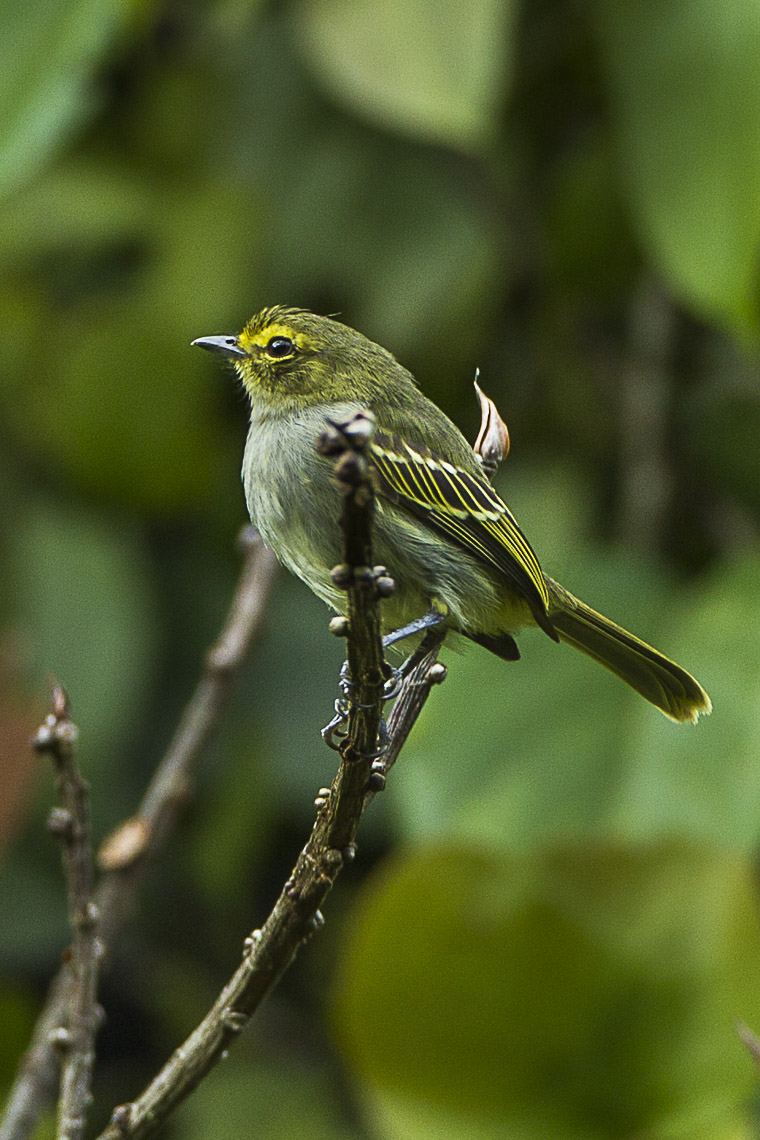
Wikipedia: Golden-faced tyrannulet Source: OTHER
Golden-faced_Tyrannulet_-_Colombia_S4E9917.jpg
![]() The golden-faced tyrannulet (Zimmerius chrysops) is a species of bird belonging to the family Tyrannidae.
It is found in Colombia, Ecuador, Peru, and Venezuela.
[more]
The golden-faced tyrannulet (Zimmerius chrysops) is a species of bird belonging to the family Tyrannidae.
It is found in Colombia, Ecuador, Peru, and Venezuela.
[more]
Bright-rumped attila (Attila spadiceus)
Profile Wikipedia eBird Xeno-Canto

Wikipedia: Bright-rumped attila Source: OTHER
1200px-Attila_spadiceus.jpg
![]() The bright-rumped attila or polymorphic attila (Attila spadiceus) is a small passerine bird in the tyrant flycatcher family (Tyrannidae). It breeds from northwestern Mexico to western Ecuador, Bolivia and southeastern Brazil, and on Trinidad.
[more]
The bright-rumped attila or polymorphic attila (Attila spadiceus) is a small passerine bird in the tyrant flycatcher family (Tyrannidae). It breeds from northwestern Mexico to western Ecuador, Bolivia and southeastern Brazil, and on Trinidad.
[more]
Ochraceous attila (Attila torridus)
Profile Wikipedia eBird Xeno-Canto

Wikipedia: Ochraceous attila Source: OTHER
1200px-Attila_torridus_-_Ochraceous_Attila_2.jpg
![]() The ochraceous attila (Attila torridus) is a species of bird in the family Tyrannidae.
It is found in Colombia, Ecuador, and Peru.
Its natural habitats are subtropical or tropical moist lowland forests and plantations .
It is threatened by habitat loss.
[more]
The ochraceous attila (Attila torridus) is a species of bird in the family Tyrannidae.
It is found in Colombia, Ecuador, and Peru.
Its natural habitats are subtropical or tropical moist lowland forests and plantations .
It is threatened by habitat loss.
[more]
Citron-bellied attila (Attila citriniventris)
Profile Wikipedia eBird Xeno-Canto
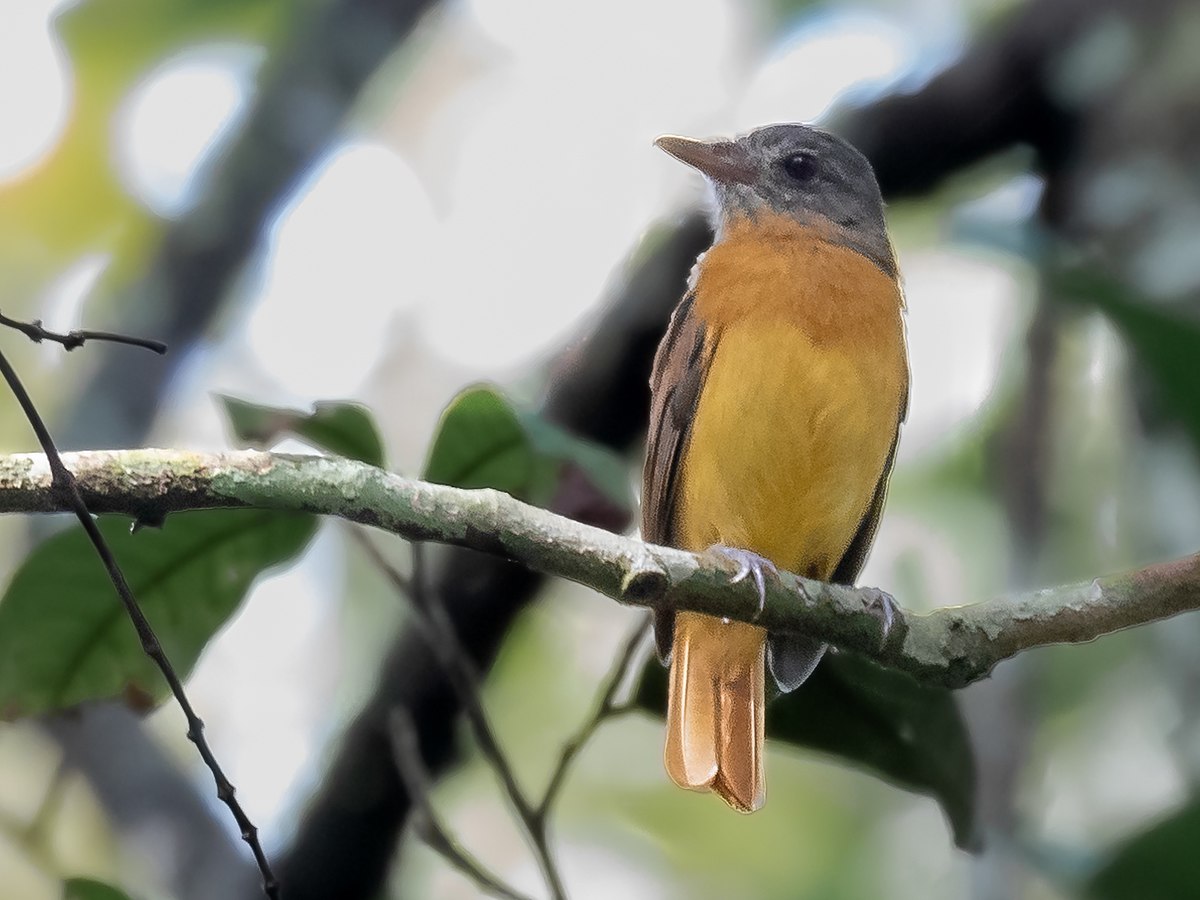
Wikipedia: Citron-bellied attila Source: OTHER
1200px-Attila_citriniventris_-_Citron-bellied_Attila%3B_Careiro%2C_Amazonas%2C_Brazil.jpg
![]() The citron-bellied attila (Attila citriniventris) is a species of bird in the family Tyrannidae.
[more]
The citron-bellied attila (Attila citriniventris) is a species of bird in the family Tyrannidae.
[more]
Cinnamon attila (Attila cinnamomeus)

Wikipedia: Cinnamon attila Source: OTHER
1200px-Attila_cinnamomeus_-_Cinnamon_Attila%3B_Caxias%2C_Maranh%C3%A3o%2C_Brazil.jpg
![]() The cinnamon attila (Attila cinnamomeus) is a species of bird in the family Tyrannidae, the tyrant flycatchers.
It is found in northern South America in the Amazon Basin of Brazil and the Guianas.
It is found in Brazil, Colombia, Venezuela, Guyana, Suriname, and French Guiana; also Amazonian Ecuador, Peru, and regions of Bolivia.
Its natural habitat is subtropical or tropical swamps.
[more]
The cinnamon attila (Attila cinnamomeus) is a species of bird in the family Tyrannidae, the tyrant flycatchers.
It is found in northern South America in the Amazon Basin of Brazil and the Guianas.
It is found in Brazil, Colombia, Venezuela, Guyana, Suriname, and French Guiana; also Amazonian Ecuador, Peru, and regions of Bolivia.
Its natural habitat is subtropical or tropical swamps.
[more]
Variegated flycatcher (Empidonomus varius)
Profile Wikipedia eBird Xeno-Canto

Wikipedia: Variegated flycatcher Source: OTHER
Empidonomus_varius-2.jpg
![]() The variegated flycatcher (Empidonomus varius) is a species of bird in the family Tyrannidae. With the crowned slaty flycatcher being moved to its own genus, this is now the only species remaining in Empidonomus.
[more]
The variegated flycatcher (Empidonomus varius) is a species of bird in the family Tyrannidae. With the crowned slaty flycatcher being moved to its own genus, this is now the only species remaining in Empidonomus.
[more]
Tawny-crowned pygmy-tyrant (Euscarthmus meloryphus)
Profile Wikipedia eBird Xeno-Canto

Wikipedia: Tawny-crowned pygmy-tyrant Source: OTHER
Euscarthmus_meloryphus_-Piraju%2C_Sao_Paulo%2C_Brazil-8.jpg
![]() The tawny-crowned pygmy tyrant (Euscarthmus meloryphus) is a species of bird in the family Tyrannidae. It is found in Argentina, Bolivia, Brazil, Colombia, Ecuador, Paraguay, Peru, Uruguay, and Venezuela. Its natural habitats are dry savanna, subtropical or tropical dry shrubland, and subtropical or tropical high-altitude shrubland.
[more]
The tawny-crowned pygmy tyrant (Euscarthmus meloryphus) is a species of bird in the family Tyrannidae. It is found in Argentina, Bolivia, Brazil, Colombia, Ecuador, Paraguay, Peru, Uruguay, and Venezuela. Its natural habitats are dry savanna, subtropical or tropical dry shrubland, and subtropical or tropical high-altitude shrubland.
[more]
Piratic flycatcher (Legatus leucophaius)
Profile Wikipedia eBird Xeno-Canto
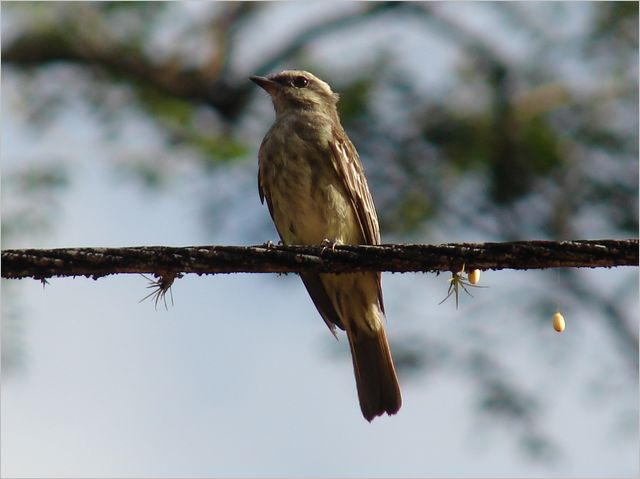
Wikipedia: Piratic flycatcher Source: OTHER
Piratic_flycatcher.jpg
![]() The piratic flycatcher (Legatus leucophaius) is a passerine bird, the only member of the genus Legatus. It is a resident breeder from southern Mexico and Trinidad south to Bolivia and Argentina. At least some birds from Central America and Trinidad are migratory, and this species also visits Tobago.
[more]
The piratic flycatcher (Legatus leucophaius) is a passerine bird, the only member of the genus Legatus. It is a resident breeder from southern Mexico and Trinidad south to Bolivia and Argentina. At least some birds from Central America and Trinidad are migratory, and this species also visits Tobago.
[more]
Boat-billed flycatcher (Megarynchus pitangua)
Profile Wikipedia eBird Xeno-Canto
Boat billed flycatcher has a much bigger beak than other yellow birds, photo at Ecotucan. 2023-03-31 08.05.34 Yucatan
First observed in Yucatan on 2023-03-31.
![]() The boat-billed flycatcher (Megarynchus pitangua) is a passerine bird. It is a large tyrant flycatcher, the only member of the monotypic genus Megarynchus.
[more]
The boat-billed flycatcher (Megarynchus pitangua) is a passerine bird. It is a large tyrant flycatcher, the only member of the monotypic genus Megarynchus.
[more]
Gray-capped flycatcher (Myiozetetes granadensis)
Profile Wikipedia eBird Xeno-Canto
La tarde last morning gray-capped flycatcher. 2018-03-11 10.56.34 Costa Rica
First observed in Costa Rica on 2018-03-11.
![]() The grey-capped flycatcher (Myiozetetes granadensis) is a passerine bird, a member of the large tyrant flycatcher family.
[more]
The grey-capped flycatcher (Myiozetetes granadensis) is a passerine bird, a member of the large tyrant flycatcher family.
[more]
Social flycatcher (Myiozetetes similis)
Profile Wikipedia eBird Xeno-Canto
MerlinBirdID suggests social flycatcher at botanical garden, Puerto Morelos 2. 2023-03-27 11.50.34 Yucatan
First observed in Yucatan on 2023-03-27.
![]() The social flycatcher (Myiozetetes similis) is a passerine bird from the Americas, a member of the large tyrant flycatcher family (Tyrannidae).
[more]
The social flycatcher (Myiozetetes similis) is a passerine bird from the Americas, a member of the large tyrant flycatcher family (Tyrannidae).
[more]
Rusty-margined flycatcher (Myiozetetes cayanensis)
Profile Wikipedia eBird Xeno-Canto

Wikipedia: Rusty-margined flycatcher Source: OTHER
1200px-Rusty-margined_flycatcher_%28Myiozetetes_cayanensis_hellmayri%29.jpg
![]() The rusty-margined flycatcher (Myiozetetes cayanensis) is a species of bird in the family Tyrannidae, the tyrant flycatchers.
[more]
The rusty-margined flycatcher (Myiozetetes cayanensis) is a species of bird in the family Tyrannidae, the tyrant flycatchers.
[more]
Dusky-chested flycatcher (Myiozetetes luteiventris)
Profile Wikipedia eBird Xeno-Canto

Wikipedia: Dusky-chested flycatcher Source: OTHER
1200px-Myiozetetes_luteiventris_-_Dusky-chested_Flycatcher%3B_Carajas_National_Forest%2C_Par%C3%A1%2C_Brazil.jpg
![]() The dusky-chested flycatcher (Myiozetetes luteiventris) is a species of bird in the family Tyrannidae.
It is found in Bolivia, Brazil, Colombia, Ecuador, French Guiana, Peru, Suriname, and Venezuela.
Its natural habitats are subtropical or tropical moist lowland forests and subtropical or tropical swamps.
[more]
The dusky-chested flycatcher (Myiozetetes luteiventris) is a species of bird in the family Tyrannidae.
It is found in Bolivia, Brazil, Colombia, Ecuador, French Guiana, Peru, Suriname, and Venezuela.
Its natural habitats are subtropical or tropical moist lowland forests and subtropical or tropical swamps.
[more]
Subtropical doradito (Pseudocolopteryx acutipennis)
Profile Wikipedia eBird Xeno-Canto

Wikipedia: Subtropical doradito Source: OTHER
1200px-Pseudocolopteryx_acutipennis_map.svg.png
![]() The subtropical doradito (Pseudocolopteryx acutipennis) is a species of bird in the family Tyrannidae. It is found in Argentina, Bolivia, Colombia, Ecuador, Paraguay, and Peru. Its natural habitats are subtropical or tropical moist shrubland and swamps.
[more]
The subtropical doradito (Pseudocolopteryx acutipennis) is a species of bird in the family Tyrannidae. It is found in Argentina, Bolivia, Colombia, Ecuador, Paraguay, and Peru. Its natural habitats are subtropical or tropical moist shrubland and swamps.
[more]
Choco sirystes (Sirystes albogriseus)
Profile Wikipedia eBird Xeno-Canto

Wikipedia: Choco sirystes Source: OTHER
1200px-Sirystes_albogriseus_1902.jpg
![]() The western sirystes or Chocó sirystes (Sirystes albogriseus) is a species of bird in the family Tyrannidae. It was formerly considered conspecific with the sibilant sirystes.
[more]
The western sirystes or Chocó sirystes (Sirystes albogriseus) is a species of bird in the family Tyrannidae. It was formerly considered conspecific with the sibilant sirystes.
[more]
White-rumped sirystes (Sirystes albocinereus)
Profile Wikipedia eBird Xeno-Canto

Wikipedia: White-rumped sirystes Source: OTHER
1200px-SirystesAlbocinereusSmit.jpg
![]() The white-rumped sirystes (Sirystes albocinereus), is a species of bird in the family Tyrannidae. It was formerly considered conspecific with the sibilant sirystes.
[more]
The white-rumped sirystes (Sirystes albocinereus), is a species of bird in the family Tyrannidae. It was formerly considered conspecific with the sibilant sirystes.
[more]
Crowned slaty flycatcher (Griseotyrannus aurantioatrocristatus)

Wikipedia: Crowned slaty flycatcher Source: OTHER
1200px-Griseotyrannus_aurantioatrocristatus_-_Crowned_slaty_flycatcher.JPG
![]() The crowned slaty flycatcher (Griseotyrannus aurantioatrocristatus) is a species of bird in the family Tyrannidae, the tyrant flycatchers. It was formerly united in the genus Empidonomus with the variegated flycatcher, but is now considered the only species of Griseotyrannus. The name Griseotyrannus aurantioatrocristatus means "orange-black crested gray Tyrannus".
[more]
The crowned slaty flycatcher (Griseotyrannus aurantioatrocristatus) is a species of bird in the family Tyrannidae, the tyrant flycatchers. It was formerly united in the genus Empidonomus with the variegated flycatcher, but is now considered the only species of Griseotyrannus. The name Griseotyrannus aurantioatrocristatus means "orange-black crested gray Tyrannus".
[more]
Lesser kiskadee (Philohydor lictor)

Wikipedia: Lesser kiskadee Source: OTHER
1200px-Lesser_kiskadee_%28Pitangus_lictor_panamense%29.jpg
![]() The lesser kiskadee (Philohydor lictor) is a species of passerine bird in the family Tyrannidae. It is the only species in the genus Philohydor. It is found in Argentina, Bermuda, Bolivia, Brazil, Colombia, Ecuador, French Guiana, Guyana, Panama, Peru, Suriname, Trinidad, Guatemala, and Venezuela. Its natural habitats are subtropical or tropical moist shrubland and swamps.
[more]
The lesser kiskadee (Philohydor lictor) is a species of passerine bird in the family Tyrannidae. It is the only species in the genus Philohydor. It is found in Argentina, Bermuda, Bolivia, Brazil, Colombia, Ecuador, French Guiana, Guyana, Panama, Peru, Suriname, Trinidad, Guatemala, and Venezuela. Its natural habitats are subtropical or tropical moist shrubland and swamps.
[more]
Cinnamon flycatcher (Pyrrhomyias cinnamomeus)

Wikipedia: Cinnamon flycatcher Source: OTHER
Cinnamon_Flycatcher_%28Pyrrhomyias_cinnamomeus%29.jpg
![]() The cinnamon flycatcher (Pyrrhomyias cinnamomeus) is a species of bird in the family Tyrannidae. It is the only member of the genus Pyrrhomyias.[2]
[more]
The cinnamon flycatcher (Pyrrhomyias cinnamomeus) is a species of bird in the family Tyrannidae. It is the only member of the genus Pyrrhomyias.[2]
[more]
Cliff flycatcher (Hirundinea ferruginea)
Profile Wikipedia eBird Xeno-Canto

Wikipedia: Cliff flycatcher Source: OTHER
1200px-Gib%C3%A3o_de_couro.jpg
![]() The cliff flycatcher (Hirundinea ferruginea) is a species of bird in the tyrant flycatcher family, Tyrannidae. The cliff flycatcher is the only species in the genus Hirundinea after the swallow flycatcher was merged, becoming subspecies Hirundinea ferruginea bellicosa. It is native to South America, where its natural habitats are cliffs and crags in the vicinity of subtropical or tropical dry forest, subtropical or tropical moist lowland forest, subtropical or tropical moist montane forest, and heavily degraded former forest.
[more]
The cliff flycatcher (Hirundinea ferruginea) is a species of bird in the tyrant flycatcher family, Tyrannidae. The cliff flycatcher is the only species in the genus Hirundinea after the swallow flycatcher was merged, becoming subspecies Hirundinea ferruginea bellicosa. It is native to South America, where its natural habitats are cliffs and crags in the vicinity of subtropical or tropical dry forest, subtropical or tropical moist lowland forest, subtropical or tropical moist montane forest, and heavily degraded former forest.
[more]
Tumbes tyrant (Tumbezia salvini)
Profile Wikipedia eBird Xeno-Canto

Wikipedia: Tumbes tyrant Source: OTHER
Tumbes_Tyrant_-_South_Ecuador_S4E9643_%2816666065997%29.jpg
![]() The Tumbes tyrant (Tumbezia salvini) is a species of bird in the family Tyrannidae. It is monotypic within the genus Tumbezia.[2] It is endemic to Peru, where its natural habitats are subtropical or tropical dry forest, subtropical or tropical moist lowland forest, and subtropical or tropical dry shrubland. It is threatened by habitat loss.[1]
[more]
The Tumbes tyrant (Tumbezia salvini) is a species of bird in the family Tyrannidae. It is monotypic within the genus Tumbezia.[2] It is endemic to Peru, where its natural habitats are subtropical or tropical dry forest, subtropical or tropical moist lowland forest, and subtropical or tropical dry shrubland. It is threatened by habitat loss.[1]
[more]
Red-rumped bush-tyrant (Cnemarchus erythropygius)
Profile Wikipedia eBird Xeno-Canto

Wikipedia: Red-rumped bush-tyrant Source: OTHER
1200px-Red-rumped-Bush-tyrant.jpg
![]() The red-rumped bush tyrant (Cnemarchus erythropygius) is a species of bird in the family Tyrannidae, the only one in the genus Cnemarchus. It is found in Bolivia, Colombia, Ecuador, and Peru.
Its natural habitats are subtropical or tropical moist montane forests and subtropical or tropical high-altitude grassland.
[more]
The red-rumped bush tyrant (Cnemarchus erythropygius) is a species of bird in the family Tyrannidae, the only one in the genus Cnemarchus. It is found in Bolivia, Colombia, Ecuador, and Peru.
Its natural habitats are subtropical or tropical moist montane forests and subtropical or tropical high-altitude grassland.
[more]
Smoky bush-tyrant / Rußbuschtyrann (Myiotheretes fumigatus)
Profile Wikipedia eBird Xeno-Canto

Wikipedia: Smoky bush-tyrant Source: OTHER
1200px-Smoky_Bush-tyrant.jpg
![]() The smoky bush tyrant (Myiotheretes fumigatus) is a species of bird in the family Tyrannidae.
[more]
The smoky bush tyrant (Myiotheretes fumigatus) is a species of bird in the family Tyrannidae.
[more]
Streak-throated bush-tyrant (Myiotheretes striaticollis)
Profile Wikipedia eBird Xeno-Canto

Wikipedia: Streak-throated bush-tyrant Source: OTHER
Myiotheretes_striaticollis_-Ecuador-6.jpg
Ecuador
![]() The streak-throated bush tyrant (Myiotheretes striaticollis) is a species of bird in the family Tyrannidae.
[more]
The streak-throated bush tyrant (Myiotheretes striaticollis) is a species of bird in the family Tyrannidae.
[more]
Cattle tyrant / Graslandtyrann (Machetornis rixosa)

Wikipedia: Cattle tyrant Source: OTHER
Cattle_Tyrant_-_Pantanal_-_Brazil_H8O0107_%2816298240983%29.jpg
![]() The cattle tyrant (Machetornis rixosa) is a species of bird in the tyrant-flycatcher family Tyrannidae. It is the only member of the genus Machetornis. The relationships of this species and genus to other genera in the tyrant flycatchers are uncertain. It resembles Tyrannus flycatchers, but this may be the result of convergence. Three subspecies are recognised, the nominate race, M. r. flavigularis and M. r. obscurodorsalis, although the latter two may not be distinct from M. r. flavigularis. The genus name was given to the species by George Robert Gray and is derived from the Ancient Greek makhētēs for fighter and ornis for bird, a reference to its pugnacious behaviour and habit of dispossessing other species of their nests. The specific name comes from the Latin rixosus meaning quarrelsome, again referring to the species/ behaviour and temperament.[3]
[more]
The cattle tyrant (Machetornis rixosa) is a species of bird in the tyrant-flycatcher family Tyrannidae. It is the only member of the genus Machetornis. The relationships of this species and genus to other genera in the tyrant flycatchers are uncertain. It resembles Tyrannus flycatchers, but this may be the result of convergence. Three subspecies are recognised, the nominate race, M. r. flavigularis and M. r. obscurodorsalis, although the latter two may not be distinct from M. r. flavigularis. The genus name was given to the species by George Robert Gray and is derived from the Ancient Greek makhētēs for fighter and ornis for bird, a reference to its pugnacious behaviour and habit of dispossessing other species of their nests. The specific name comes from the Latin rixosus meaning quarrelsome, again referring to the species/ behaviour and temperament.[3]
[more]
Drab water tyrant (Ochthornis littoralis)
Profile Wikipedia eBird Xeno-Canto

Wikipedia: Drab water tyrant Source: OTHER
Ochthornis_littoralis_-_Drab_Water-Tyrant.jpg
![]() The drab water tyrant (Ochthornis littoralis) is a species of bird in the family Tyrannidae, the tyrant flycatchers, and is the only species in the monotypic genus Ochthornis.[2] It is found in Bolivia, Brazil, Colombia, Ecuador, French Guiana, Guyana, Peru, and Venezuela, where its natural habitat is rivers.[1]
[more]
The drab water tyrant (Ochthornis littoralis) is a species of bird in the family Tyrannidae, the tyrant flycatchers, and is the only species in the monotypic genus Ochthornis.[2] It is found in Bolivia, Brazil, Colombia, Ecuador, French Guiana, Guyana, Peru, and Venezuela, where its natural habitat is rivers.[1]
[more]
Gray-and-white tyrannulet (Pseudelaenia leucospodia)
Profile Wikipedia eBird Xeno-Canto

Wikipedia: Gray-and-white tyrannulet Source: OTHER
1200px-Pseudelaenia_leucospodia_map.svg.png
![]() The grey-and-white tyrannulet (Pseudelaenia leucospodia) is a species of bird in the tyrant flycatcher family Tyrannidae. It is the only species placed in the genus Pseudelaenia.[2] It is found in Ecuador and Peru, where natural habitats are subtropical or tropical dry shrubland and subtropical or tropical moist shrubland.[1]
[more]
The grey-and-white tyrannulet (Pseudelaenia leucospodia) is a species of bird in the tyrant flycatcher family Tyrannidae. It is the only species placed in the genus Pseudelaenia.[2] It is found in Ecuador and Peru, where natural habitats are subtropical or tropical dry shrubland and subtropical or tropical moist shrubland.[1]
[more]
Sulphury flycatcher (Tyrannopsis sulphurea)
Profile Wikipedia eBird Xeno-Canto
Wikipedia: Sulphury flycatcher Source: OTHER
Tyrannopsis_sulphurea_-_Sulphury_Flycatcher.JPG
![]() The sulphury flycatcher (Tyrannopsis sulphurea) is a passerine bird which is a localised resident breeder from Trinidad, the Guianas and Venezuela south to Amazonian Peru, northern Bolivia and Brazil.
[more]
The sulphury flycatcher (Tyrannopsis sulphurea) is a passerine bird which is a localised resident breeder from Trinidad, the Guianas and Venezuela south to Amazonian Peru, northern Bolivia and Brazil.
[more]
White-ringed flycatcher (Conopias albovittatus)
Profile Wikipedia eBird Xeno-Canto

Wikipedia: White-ringed flycatcher Source: OTHER
1200px-White-ringed_Flycatcher_2014-11-16.jpg
![]() The white-ringed flycatcher (Conopias albovittatus) is a species of bird in the family Tyrannidae.
[more]
The white-ringed flycatcher (Conopias albovittatus) is a species of bird in the family Tyrannidae.
[more]
Three-striped flycatcher (Conopias trivirgatus)
Profile Wikipedia eBird Xeno-Canto
Wikipedia: Three-striped flycatcher Source: OTHER
Conopias_trivirgatus-Three-striped_Flycatcher.JPG
![]() The three-striped flycatcher (Conopias trivirgatus) is a species of bird in the family Tyrannidae.
It is found in Argentina, Bolivia, Brazil, Ecuador, Paraguay, Peru, and Venezuela.
Its natural habitats are subtropical or tropical moist lowland forest and subtropical or tropical swamps.
[more]
The three-striped flycatcher (Conopias trivirgatus) is a species of bird in the family Tyrannidae.
It is found in Argentina, Bolivia, Brazil, Ecuador, Paraguay, Peru, and Venezuela.
Its natural habitats are subtropical or tropical moist lowland forest and subtropical or tropical swamps.
[more]
Lemon-browed flycatcher (Conopias cinchoneti)
Profile Wikipedia eBird Xeno-Canto

Wikipedia: Lemon-browed flycatcher Source: OTHER
1200px-Lemon-browed_Flycatcher_%285285655862%29.jpg
![]() The lemon-browed flycatcher (Conopias cinchoneti) is a species of bird in the family Tyrannidae.
It is found in Bolivia, Colombia, Ecuador, Peru, and Venezuela.
Its natural habitat is subtropical or tropical moist montane forests.
[more]
The lemon-browed flycatcher (Conopias cinchoneti) is a species of bird in the family Tyrannidae.
It is found in Bolivia, Colombia, Ecuador, Peru, and Venezuela.
Its natural habitat is subtropical or tropical moist montane forests.
[more]
Yellow-throated flycatcher (Conopias parvus)
Profile Wikipedia eBird Xeno-Canto
Wikipedia: Yellow-throated flycatcher Source: OTHER
Conopias_parvus_-_Yellow-throated_Flycatcher.JPG
![]() The yellow-throated flycatcher (Conopias parvus) is a species[2] of bird in the family Tyrannidae.
It is found in Bolivia, Brazil, Colombia, Ecuador, French Guiana, Guyana, Peru, Suriname, and Venezuela.
Its natural habitat is subtropical or tropical moist lowland forests.
[more]
The yellow-throated flycatcher (Conopias parvus) is a species[2] of bird in the family Tyrannidae.
It is found in Bolivia, Brazil, Colombia, Ecuador, French Guiana, Guyana, Peru, Suriname, and Venezuela.
Its natural habitat is subtropical or tropical moist lowland forests.
[more]
Jelski's chat-tyrant (Silvicultrix jelskii)

Wikipedia: Jelski's chat-tyrant Source: OTHER
1200px-Ochthoeca_jelskii_map.svg.png
![]() Jelski's chat-tyrant (Silvicultrix jelskii) is a species of passerine bird in the family Tyrannidae. It is found Peru and southern Ecuador. Its natural habitat is subtropical or tropical moist montane forests.
[more]
Jelski's chat-tyrant (Silvicultrix jelskii) is a species of passerine bird in the family Tyrannidae. It is found Peru and southern Ecuador. Its natural habitat is subtropical or tropical moist montane forests.
[more]
Crowned chat-tyrant (Silvicultrix frontalis)

Wikipedia: Crowned chat-tyrant Source: OTHER
1200px-Ochthoeca_frontalis_-NBII_Image_Gallery-a00286.jpg
![]() The crowned chat-tyrant (Silvicultrix frontalis) is a species of bird in the tyrant flycatcher family.
[more]
The crowned chat-tyrant (Silvicultrix frontalis) is a species of bird in the tyrant flycatcher family.
[more]
Handsome flycatcher (Nephelomyias pulcher)
Profile Wikipedia eBird Xeno-Canto

Wikipedia: Handsome flycatcher Source: OTHER
Handsome_Flycatcher_-_Colombia_S4E3093_%2816687220829%29.jpg
![]() The handsome flycatcher (Nephelomyias pulcher) is a species of bird in the family Tyrannidae. It is found in Bolivia, Colombia, Ecuador, and Peru. Its natural habitat is subtropical or tropical moist montane forests.
[more]
The handsome flycatcher (Nephelomyias pulcher) is a species of bird in the family Tyrannidae. It is found in Bolivia, Colombia, Ecuador, and Peru. Its natural habitat is subtropical or tropical moist montane forests.
[more]
Orange-banded flycatcher (Nephelomyias lintoni)
Profile Wikipedia eBird Xeno-Canto

Wikipedia: Orange-banded flycatcher Source: OTHER
1200px-Myiophobus_lintoni.jpg
![]() The orange-banded flycatcher (Nephelomyias lintoni) is a species of bird in the family Tyrannidae. It is found in southern Ecuador and far northern Peru. Its natural habitat is subtropical or tropical moist montane forests. It is threatened by habitat loss.
[more]
The orange-banded flycatcher (Nephelomyias lintoni) is a species of bird in the family Tyrannidae. It is found in southern Ecuador and far northern Peru. Its natural habitat is subtropical or tropical moist montane forests. It is threatened by habitat loss.
[more]
Tropical mockingbird (Mimus gilvus)
Profile Wikipedia eBird Xeno-Canto
Tropical mockingbird in Puerto Morelos. 2023-03-26 16.27.30 Yucatan
First observed in Yucatan on 2023-03-26.
![]() The tropical mockingbird (Mimus gilvus) is a resident breeding bird from southern Mexico south to northern Brazil, and in the Lesser Antilles and other Caribbean islands. The birds in Panama and Trinidad may have been introduced. The northern mockingbird (M. polyglottos) is its closest living relative, but the critically endangered Socorro mockingbird (M. graysoni) is also much closer to these two than previously believed .[2]
[more]
The tropical mockingbird (Mimus gilvus) is a resident breeding bird from southern Mexico south to northern Brazil, and in the Lesser Antilles and other Caribbean islands. The birds in Panama and Trinidad may have been introduced. The northern mockingbird (M. polyglottos) is its closest living relative, but the critically endangered Socorro mockingbird (M. graysoni) is also much closer to these two than previously believed .[2]
[more]
Long-tailed mockingbird (Mimus longicaudatus)
Profile Wikipedia eBird Xeno-Canto

Wikipedia: Long-tailed mockingbird Source: OTHER
1200px-Long-tailed_Mockingbird_RWD3.jpg
![]() The long-tailed mockingbird (Mimus longicaudatus) is a species of bird in the family Mimidae. It is found in dry scrubland and woodland in western Ecuador and Peru (north of Camaná).
[more]
The long-tailed mockingbird (Mimus longicaudatus) is a species of bird in the family Mimidae. It is found in dry scrubland and woodland in western Ecuador and Peru (north of Camaná).
[more]
Black-capped donacobius / Rohrspotter (Donacobius atricapilla)

Wikipedia: Black-capped donacobius Source: OTHER
1200px-Donacobius_atricapilla_-Fazenda_Campo_de_Ouro%2C_Piraju%2C_Sao_Paulo%2C_Brasil-8.jpg
![]() The black-capped donacobius (Donacobius atricapilla) is a conspicuous, vocal South American bird. It is found in tropical swamps and wetlands in Argentina, Bolivia, Brazil, Colombia, Ecuador, French Guiana, Guyana, Paraguay, Peru, Suriname, and Venezuela; also Panama of Central America.[1]
[more]
The black-capped donacobius (Donacobius atricapilla) is a conspicuous, vocal South American bird. It is found in tropical swamps and wetlands in Argentina, Bolivia, Brazil, Colombia, Ecuador, French Guiana, Guyana, Paraguay, Peru, Suriname, and Venezuela; also Panama of Central America.[1]
[more]
Profile Wikipedia eBird A-Z Animals Audubon AllAboutBirds Xeno-Canto
House wren. 2022-05-05 08.41.48 Maryland
First observed in Cherrywood on 2021-06-17.
![]() The house wren (Troglodytes aedon) is a very small songbird of the wren family, Troglodytidae. It occurs from Canada to southernmost South America, and is thus the most widely distributed native bird in the Americas.[2] It occurs in most suburban areas in its range and it is the single most common wren. Its taxonomy is highly complex and some subspecies groups are often considered separate species.
[more]
The house wren (Troglodytes aedon) is a very small songbird of the wren family, Troglodytidae. It occurs from Canada to southernmost South America, and is thus the most widely distributed native bird in the Americas.[2] It occurs in most suburban areas in its range and it is the single most common wren. Its taxonomy is highly complex and some subspecies groups are often considered separate species.
[more]
Call:
Automatically generated from Xeno-Canto recording
♫ Source: BirdNet
20220503_103153 birdnet - House Wren - 2022-05-03 10:31:53 - House Wren - Cockeysville.mp3
2022-05-03 10.31.53 Cockeysville (song?)
Profile Wikipedia eBird Xeno-Canto
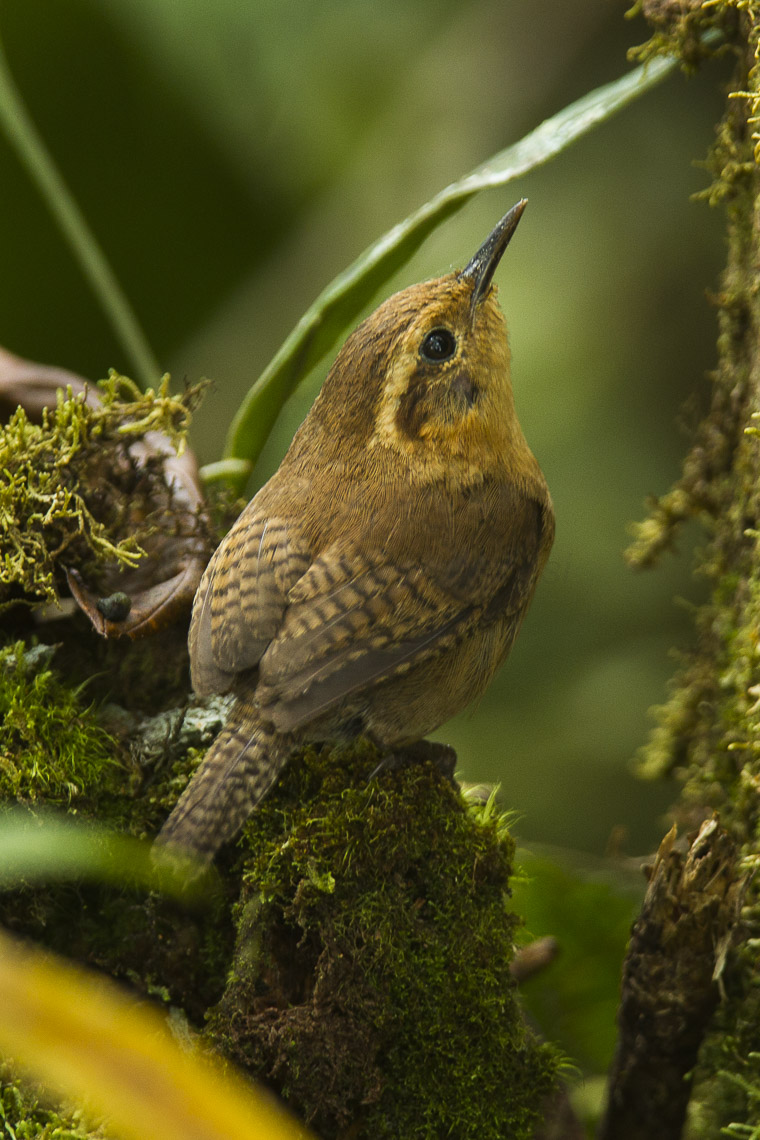
Wikipedia: Mountain wren Source: OTHER
Mountain_Wren_-_Ecuador_S4E3967_%2817168286775%29.jpg
![]() The mountain wren (Troglodytes solstitialis) is a species of bird in the family Troglodytidae. It is found in the Andes or north-west Argentina, Bolivia, Colombia, Ecuador, Peru, and western Venezuela. Its natural habitat is subtropical or tropical moist montane forests.
[more]
The mountain wren (Troglodytes solstitialis) is a species of bird in the family Troglodytidae. It is found in the Andes or north-west Argentina, Bolivia, Colombia, Ecuador, Peru, and western Venezuela. Its natural habitat is subtropical or tropical moist montane forests.
[more]
Profile Wikipedia eBird Xeno-Canto

Wikipedia: Band-backed wren Source: OTHER
1200px-Campylorhynchus_zonatus.jpg
![]() The band-backed wren (Campylorhynchus zonatus) is a small songbird of the wren family.
[more]
The band-backed wren (Campylorhynchus zonatus) is a small songbird of the wren family.
[more]
Profile Wikipedia eBird Xeno-Canto
Wikipedia: Thrush-like wren Source: OTHER
Campylorhynchus_turdinus-Thrush-like_Wren.JPG
![]() The thrush-like wren (Campylorhynchus turdinus) is a South American species of bird in the family Troglodytidae, the wrens. As suggested by its common and scientific name, its size and coloration are vaguely reminiscent of that of a thrush, although the general impression it gives in life is very different and not at all "thrush-like".
[more]
The thrush-like wren (Campylorhynchus turdinus) is a South American species of bird in the family Troglodytidae, the wrens. As suggested by its common and scientific name, its size and coloration are vaguely reminiscent of that of a thrush, although the general impression it gives in life is very different and not at all "thrush-like".
[more]
Profile Wikipedia eBird Xeno-Canto

Wikipedia: Fasciated wren Source: OTHER
Fasciated_Wren_-_South_Ecuador_S4E1692_%2817142371156%29.jpg
![]() The fasciated wren (Campylorhynchus fasciatus) is a species of bird in the family Troglodytidae. It is found in Ecuador and Peru.[2]
[more]
The fasciated wren (Campylorhynchus fasciatus) is a species of bird in the family Troglodytidae. It is found in Ecuador and Peru.[2]
[more]

Wikipedia: Grey-breasted wood-wren Source: OTHER
Gray-breasted_Wood-Wren_-_Colombia_S4E9753_%2816982145839%29.jpg
![]() The grey-breasted wood wren (Henicorhina leucophrys) is a species of bird in the family Troglodytidae.
It is found at low levels in wooded montane areas of Mexico, Central America and the northern Andes.
[more]
The grey-breasted wood wren (Henicorhina leucophrys) is a species of bird in the family Troglodytidae.
It is found at low levels in wooded montane areas of Mexico, Central America and the northern Andes.
[more]
Profile Wikipedia eBird Xeno-Canto

Wikipedia: White-breasted wood-wren Source: OTHER
1200px-Henicorhina_leucosticta_%28Cucarachero_pechiblanco%29_-_Juvenil_%2814037225664%29.jpg
![]() The white-breasted wood wren (Henicorhina leucosticta) is a small songbird of the wren family. It is a resident breeding species from central Mexico to northeastern Peru and Suriname.
[more]
The white-breasted wood wren (Henicorhina leucosticta) is a small songbird of the wren family. It is a resident breeding species from central Mexico to northeastern Peru and Suriname.
[more]
Profile Wikipedia eBird Xeno-Canto

Wikipedia: Bar-winged wood-wren Source: OTHER
1200px-Henicorhina_leucoptera.jpg
![]() The bar-winged wood wren (Henicorhina leucoptera) is a species of bird in the family Troglodytidae.
It is found locally in humid Andean forest in southern Ecuador and northern Peru.
It is threatened by habitat loss. As suggested by its name, it has a single distinctive white wing-bar.
[more]
The bar-winged wood wren (Henicorhina leucoptera) is a species of bird in the family Troglodytidae.
It is found locally in humid Andean forest in southern Ecuador and northern Peru.
It is threatened by habitat loss. As suggested by its name, it has a single distinctive white wing-bar.
[more]
Profile Wikipedia eBird Xeno-Canto

Wikipedia: Song wren Source: OTHER
1200px-Song_Wren_-_iNaturalist_Panam%C3%A1_3.jpg
![]() The song wren (Cyphorhinus phaeocephalus) is a species of bird in the family Troglodytidae.
[more]
The song wren (Cyphorhinus phaeocephalus) is a species of bird in the family Troglodytidae.
[more]

Wikipedia: Musician wren Source: OTHER
1200px-Cyphorhinus_arada_arada_-_Musician_wren%2C_Pte._Figueiredo%2C_Amazonas%2C_Brazil.jpg
![]() The musician wren or organ wren (Cyphorhinus arada) is a species of wren named for its elaborate song. It is native to the Amazon Rainforest in South America, and west and southwestwards into the Amazonian Andes. In Portuguese it is known as uirapuru or many other variants of this name, all based on the Tupi wirapu 'ru. Especially in Brazil, the musician wren is the subject of several legends and fables, most relating to its loud and beautiful song. One of these tells that when it starts singing all other birds stop their song to hear it. The musician wren is also believed to bring good luck, which leads some people to kill it in order to have it stuffed.[2] Even though there are no reliable statistics of its numbers, the musician wren, due to its large range and being locally fairly common, is not considered threatened.
[more]
The musician wren or organ wren (Cyphorhinus arada) is a species of wren named for its elaborate song. It is native to the Amazon Rainforest in South America, and west and southwestwards into the Amazonian Andes. In Portuguese it is known as uirapuru or many other variants of this name, all based on the Tupi wirapu 'ru. Especially in Brazil, the musician wren is the subject of several legends and fables, most relating to its loud and beautiful song. One of these tells that when it starts singing all other birds stop their song to hear it. The musician wren is also believed to bring good luck, which leads some people to kill it in order to have it stuffed.[2] Even though there are no reliable statistics of its numbers, the musician wren, due to its large range and being locally fairly common, is not considered threatened.
[more]
Profile Wikipedia eBird Xeno-Canto

Wikipedia: Chestnut-breasted wren Source: OTHER
1200px-Cyphorhinus_thoracicus_Tschudi_1846.png
![]() The chestnut-breasted wren (Cyphorhinus thoracicus) is a species of bird in the family Troglodytidae. It is found in the Andes of Colombia, Ecuador, Peru and western Bolivia. Its natural habitat is subtropical or tropical moist montane forests.
[more]
The chestnut-breasted wren (Cyphorhinus thoracicus) is a species of bird in the family Troglodytidae. It is found in the Andes of Colombia, Ecuador, Peru and western Bolivia. Its natural habitat is subtropical or tropical moist montane forests.
[more]
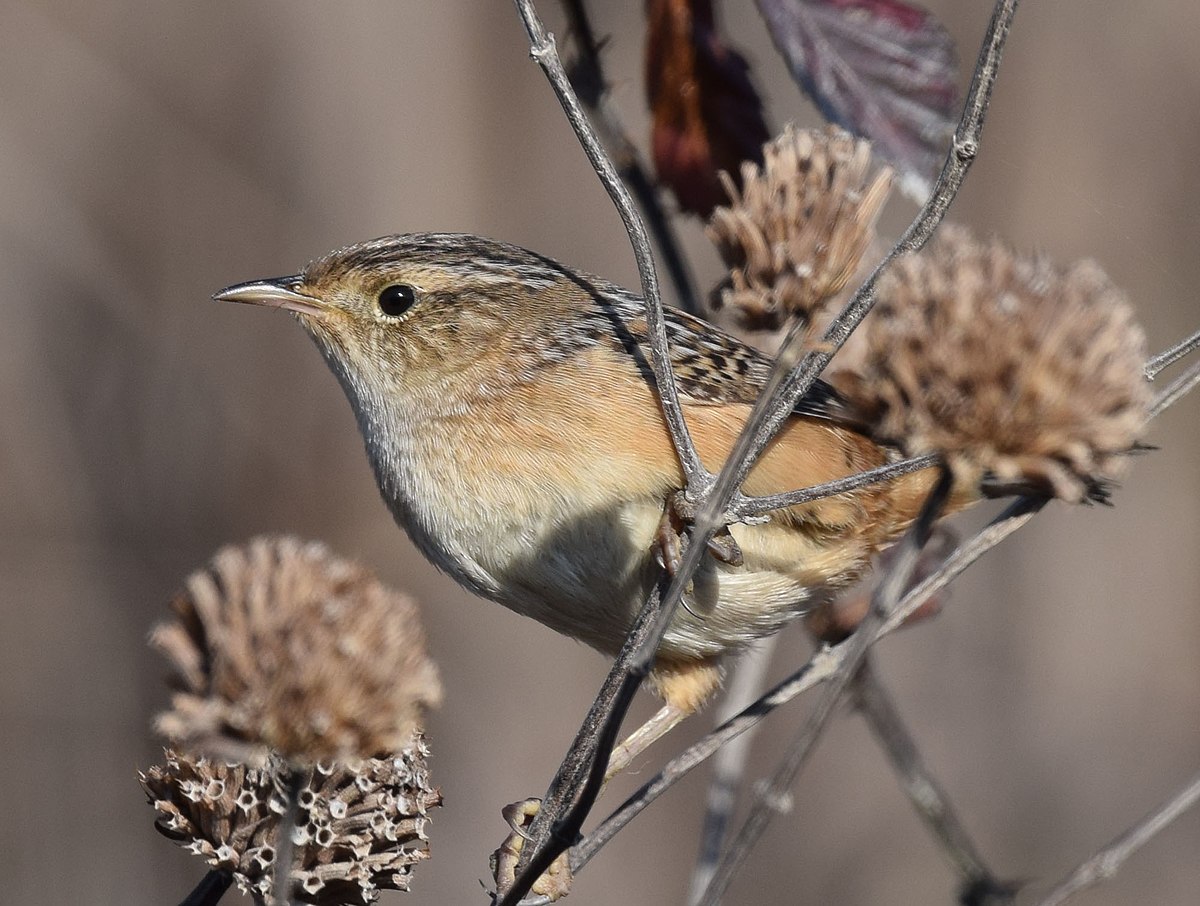
Wikipedia: Sedge wren Source: OTHER
1200px-Sedge_Wren_%2831204304001%29.jpg
![]() The sedge wren (Cistothorus stellaris) is a small and secretive passerine bird in the family Troglodytidae. It is widely distributed in North America. It is often found in wet grasslands and meadows where it nests in the tall grasses and sedges and feeds on insects. The sedge wren was formerly considered as conspecific with the non-migratory grass wren of central and South America.
[more]
The sedge wren (Cistothorus stellaris) is a small and secretive passerine bird in the family Troglodytidae. It is widely distributed in North America. It is often found in wet grasslands and meadows where it nests in the tall grasses and sedges and feeds on insects. The sedge wren was formerly considered as conspecific with the non-migratory grass wren of central and South America.
[more]

Wikipedia: Sharpe's wren Source: OTHER
1200px-Cinnycerthia_olivascens.jpg
![]() The sepia-brown wren or Sharpe's wren (Cinnycerthia olivascens) is a species of bird in the family Troglodytidae. It is found in Colombia, Ecuador, and Peru.[2][3]
[more]
The sepia-brown wren or Sharpe's wren (Cinnycerthia olivascens) is a species of bird in the family Troglodytidae. It is found in Colombia, Ecuador, and Peru.[2][3]
[more]
Profile Wikipedia eBird Xeno-Canto

Wikipedia: Rufous wren Source: OTHER
Rufous_Wren_%28Cinnycerthia_unirufa%29.jpg
![]() The rufous wren (Cinnycerthia unirufa) is a species of bird in the family Troglodytidae. It is found in Colombia, Ecuador, Peru, and Venezuela. Its natural habitat is subtropical or tropical moist montane forests.
[more]
The rufous wren (Cinnycerthia unirufa) is a species of bird in the family Troglodytidae. It is found in Colombia, Ecuador, Peru, and Venezuela. Its natural habitat is subtropical or tropical moist montane forests.
[more]

Wikipedia: Southern nightingale-wren Source: OTHER
1200px-Microcerculus_marginatus.jpg
![]() The southern nightingale-wren (Microcerculus marginatus), also known as the scaly-breasted wren, is a species of bird in the family Troglodytidae. Its rich song varies locally over its range, suggesting that more than one species is included in the taxonomic complex currently called the southern nightingale-wren.
[more]
The southern nightingale-wren (Microcerculus marginatus), also known as the scaly-breasted wren, is a species of bird in the family Troglodytidae. Its rich song varies locally over its range, suggesting that more than one species is included in the taxonomic complex currently called the southern nightingale-wren.
[more]
Profile Wikipedia eBird Xeno-Canto

Wikipedia: Wing-banded wren Source: OTHER
1200px-Microcerculus_bamblaDraw.jpg
![]() The wing-banded wren (Microcerculus bambla) is a species of bird in the family Troglodytidae.
It is found in Brazil, Ecuador, French Guiana, Guyana, Peru, Suriname, and Venezuela.
Its natural habitat is tropical moist lowland forests.
[more]
The wing-banded wren (Microcerculus bambla) is a species of bird in the family Troglodytidae.
It is found in Brazil, Ecuador, French Guiana, Guyana, Peru, Suriname, and Venezuela.
Its natural habitat is tropical moist lowland forests.
[more]
Profile Wikipedia eBird Xeno-Canto

Wikipedia: Gray-mantled wren Source: OTHER
1200px-Odontorchilus_branickii.jpg
![]() The grey-mantled wren (Odontorchilus branickii) is a species of bird in the family Troglodytidae. It is found in Bolivia, Colombia, Ecuador, and Peru.[2]
[more]
The grey-mantled wren (Odontorchilus branickii) is a species of bird in the family Troglodytidae. It is found in Bolivia, Colombia, Ecuador, and Peru.[2]
[more]
Profile Wikipedia eBird Xeno-Canto

Wikipedia: Plain-tailed wren Source: OTHER
1200px-Plain-tailedwren2.jpg
![]() The plain-tailed wren (Pheugopedius euophrys) is a species of songbird in the family Troglodytidae. It has a mostly rufous body with a gray, black, and white striped head. It is found in the Andes of southern Colombia, Ecuador, and northern Peru. Its natural habitat is subtropical or tropical moist montane forests. Plain-tailed wrens are so-called bamboo specialists and live almost exclusively in chusquea bamboo thickets. Like other wrens, its diet consists mainly of insects with some seeds and berries.
[more]
The plain-tailed wren (Pheugopedius euophrys) is a species of songbird in the family Troglodytidae. It has a mostly rufous body with a gray, black, and white striped head. It is found in the Andes of southern Colombia, Ecuador, and northern Peru. Its natural habitat is subtropical or tropical moist montane forests. Plain-tailed wrens are so-called bamboo specialists and live almost exclusively in chusquea bamboo thickets. Like other wrens, its diet consists mainly of insects with some seeds and berries.
[more]
![]() Der Corayazaunkönig (Pheugopedius coraya) ist eine Vogelart aus der Familie der Zaunkönige (Troglodytidae), die in Guyana, Suriname, Französisch-Guayana, Venezuela, Kolumbien, Ecuador, Peru und Brasilien verbreitet ist. Der Bestand wird von der IUCN als nicht gefährdet (Least Concern) eingeschätzt.
[more]
Der Corayazaunkönig (Pheugopedius coraya) ist eine Vogelart aus der Familie der Zaunkönige (Troglodytidae), die in Guyana, Suriname, Französisch-Guayana, Venezuela, Kolumbien, Ecuador, Peru und Brasilien verbreitet ist. Der Bestand wird von der IUCN als nicht gefährdet (Least Concern) eingeschätzt.
[more]
Profile Wikipedia eBird Xeno-Canto
![]() The speckle-breasted wren (Pheugopedius sclateri) is a species of bird in the family Troglodytidae. It is found in Colombia, Ecuador, and Peru.[4]
[more]
The speckle-breasted wren (Pheugopedius sclateri) is a species of bird in the family Troglodytidae. It is found in Colombia, Ecuador, and Peru.[4]
[more]
Profile Wikipedia eBird Xeno-Canto

Wikipedia: Whiskered wren Source: OTHER
Pheugopedius_mystacalis_-_Whiskered_wren%3B_Rubio%2C_T%C3%A1chira%2C_Venezuela.jpg
![]() The whiskered wren (Pheugopedius mystacalis) is a species of bird in the family Troglodytidae. It is found in Colombia, Ecuador, and Venezuela.[2]
[more]
The whiskered wren (Pheugopedius mystacalis) is a species of bird in the family Troglodytidae. It is found in Colombia, Ecuador, and Venezuela.[2]
[more]
Profile Wikipedia eBird Xeno-Canto

Wikipedia: Bay wren Source: OTHER
1200px-Bay_Wren.jpg
![]() The bay wren (Cantorchilus nigricapillus) is a species of bird in the family Troglodytidae. It is native to southern Central America and northwestern South America.[2]
[more]
The bay wren (Cantorchilus nigricapillus) is a species of bird in the family Troglodytidae. It is native to southern Central America and northwestern South America.[2]
[more]
Profile Wikipedia eBird Xeno-Canto

Wikipedia: Stripe-throated wren Source: OTHER
1200px-Cantorchilus_leucopogon_map.svg.png
![]() The stripe-throated wren (Cantorchilus leucopogon) is a species of bird in the family Troglodytidae. It is found in Colombia, Ecuador, and Panama.[2]
[more]
The stripe-throated wren (Cantorchilus leucopogon) is a species of bird in the family Troglodytidae. It is found in Colombia, Ecuador, and Panama.[2]
[more]

Wikipedia: Buff-breasted wren Source: OTHER
Cantorchilus_leucotis-Buff-breasted_Wren.jpg
![]() The buff-breasted wren (Cantorchilus leucotis) is a species of bird in the family Troglodytidae, the wrens.
It is found in the Amazon Basin of northern Brazil and Amazonian Colombia, Ecuador, Peru and northern-border Bolivia; also the Guianan countries Guyana, Suriname, French Guiana. It occurs in non-Amazonian regions of Venezuela and Colombia and its range extends into eastern Panama.
[more]
The buff-breasted wren (Cantorchilus leucotis) is a species of bird in the family Troglodytidae, the wrens.
It is found in the Amazon Basin of northern Brazil and Amazonian Colombia, Ecuador, Peru and northern-border Bolivia; also the Guianan countries Guyana, Suriname, French Guiana. It occurs in non-Amazonian regions of Venezuela and Colombia and its range extends into eastern Panama.
[more]

Wikipedia: Superciliated wren Source: OTHER
Superciliated_Wren_-_Ecuador_S4E9157_%2817166675562%29.jpg
![]() The superciliated wren (Cantorchilus superciliaris) is a species of bird in the family Troglodytidae. It is found in Ecuador and Peru.[2]
[more]
The superciliated wren (Cantorchilus superciliaris) is a species of bird in the family Troglodytidae. It is found in Ecuador and Peru.[2]
[more]
Profile Wikipedia eBird Xeno-Canto

Wikipedia: Tropical gnatcatcher Source: OTHER
Tropical_Gnatcatcher_%28Polioptila_plumbea%29.jpg
![]() The tropical gnatcatcher (Polioptila plumbea) is a small active insectivorous songbird, which is a resident species throughout a large part of the Neotropics. There are large geographical variations in its voice and plumage, resulting in some populations sometimes being considered separate species, notably the bilineata group as the white-browed gnatcatcher, and the taxon maior as the Marañón gnatcatcher.[2]
[more]
The tropical gnatcatcher (Polioptila plumbea) is a small active insectivorous songbird, which is a resident species throughout a large part of the Neotropics. There are large geographical variations in its voice and plumage, resulting in some populations sometimes being considered separate species, notably the bilineata group as the white-browed gnatcatcher, and the taxon maior as the Marañón gnatcatcher.[2]
[more]
Profile Wikipedia eBird Xeno-Canto

Wikipedia: Slate-throated gnatcatcher Source: OTHER
1200px-Polioptila_schistaceigula_map.svg.png
![]() The slate-throated gnatcatcher (Polioptila schistaceigula) is a species of bird in the family Polioptilidae.
It is found in Colombia, Ecuador, and Panama.
Its natural habitat is subtropical or tropical moist lowland forests.
[more]
The slate-throated gnatcatcher (Polioptila schistaceigula) is a species of bird in the family Polioptilidae.
It is found in Colombia, Ecuador, and Panama.
Its natural habitat is subtropical or tropical moist lowland forests.
[more]

Wikipedia: Tawny-faced gnatwren Source: OTHER
1200px-Microbates_cinereiventris_map.svg.png
![]() The tawny-faced gnatwren or half-collared gnatwren (Microbates cinereiventris) is a species of bird in the family Polioptilidae.
[more]
The tawny-faced gnatwren or half-collared gnatwren (Microbates cinereiventris) is a species of bird in the family Polioptilidae.
[more]
Profile Wikipedia eBird Xeno-Canto

Wikipedia: Collared gnatwren Source: OTHER
1200px-Microbates_collaris_-_Collared_Gnatwren%3B_Presidente_Figueiredo%2C_Amazonas%2C_Brazil.jpg
![]() The collared gnatwren (Microbates collaris) is a species of bird in the family Polioptilidae, the gnatcatchers. It is found in Brazil, Colombia, Ecuador, French Guiana, Guyana, Peru, Suriname, and Venezuela.[2]
[more]
The collared gnatwren (Microbates collaris) is a species of bird in the family Polioptilidae, the gnatcatchers. It is found in Brazil, Colombia, Ecuador, French Guiana, Guyana, Peru, Suriname, and Venezuela.[2]
[more]
Black-striped woodcreeper / Tränen-Baumsteiger (Xiphorhynchus lachrymosus)
Profile Wikipedia eBird Xeno-Canto
Black-striped woodcreeper in Manzanillo, Costa Rica. 2020-03-12 09.50.48 Costa Rica
First observed in Costa Rica on 2020-03-12.
![]() The black-striped woodcreeper (Xiphorhynchus lachrymosus) is a species of bird in the Dendrocolaptinae subfamily.
[more]
The black-striped woodcreeper (Xiphorhynchus lachrymosus) is a species of bird in the Dendrocolaptinae subfamily.
[more]
Spotted woodcreeper (Xiphorhynchus erythropygius)
Profile Wikipedia eBird Xeno-Canto

Wikipedia: Spotted woodcreeper Source: OTHER
Xiphorhynchus_erythropygius_-NW_Ecuador-8.jpg
![]() The spotted woodcreeper (Xiphorhynchus erythropygius) is a species of bird in the Dendrocolaptinae subfamily. It is found in Belize, Colombia, Costa Rica, Ecuador, El Salvador, Guatemala, Honduras, Mexico, Nicaragua, and Panama.
[more]
The spotted woodcreeper (Xiphorhynchus erythropygius) is a species of bird in the Dendrocolaptinae subfamily. It is found in Belize, Colombia, Costa Rica, Ecuador, El Salvador, Guatemala, Honduras, Mexico, Nicaragua, and Panama.
[more]
Straight-billed woodcreeper (Dendroplex picus)
Wikipedia: Straight-billed woodcreeper Source: OTHER
Dendroplex_picus_-_Straight-billed_Woodcreeper.JPG
![]() The straight-billed woodcreeper (Dendroplex picus) is a species of bird in the woodcreeper subfamily (Dendrocolaptinae). Its genus, Dendroplex, was recently confirmed to be distinct from Xiphorhynchus.
It is found in Bolivia, Brazil, Colombia, Ecuador, French Guiana, Guyana, Panama, Peru, Suriname, Trinidad and Tobago, and Venezuela.
Its natural habitats are subtropical or tropical dry forests, subtropical or tropical moist lowland forests, subtropical or tropical mangrove forests, and heavily degraded former forest.
[more]
The straight-billed woodcreeper (Dendroplex picus) is a species of bird in the woodcreeper subfamily (Dendrocolaptinae). Its genus, Dendroplex, was recently confirmed to be distinct from Xiphorhynchus.
It is found in Bolivia, Brazil, Colombia, Ecuador, French Guiana, Guyana, Panama, Peru, Suriname, Trinidad and Tobago, and Venezuela.
Its natural habitats are subtropical or tropical dry forests, subtropical or tropical moist lowland forests, subtropical or tropical mangrove forests, and heavily degraded former forest.
[more]
Olive-backed woodcreeper (Xiphorhynchus triangularis)
Profile Wikipedia eBird Xeno-Canto

Wikipedia: Olive-backed woodcreeper Source: OTHER
Olive-backed_Woodcreeper_-_Ecuador_S4E3621_%2816568144480%29.jpg
![]() The olive-backed woodcreeper (Xiphorhynchus triangularis) is a species of bird in the subfamily Dendrocolaptinae. It is found in Bolivia, Colombia, Ecuador, Peru, and Venezuela. Its natural habitat is subtropical or tropical moist montane forests.
[more]
The olive-backed woodcreeper (Xiphorhynchus triangularis) is a species of bird in the subfamily Dendrocolaptinae. It is found in Bolivia, Colombia, Ecuador, Peru, and Venezuela. Its natural habitat is subtropical or tropical moist montane forests.
[more]
Striped woodcreeper (Xiphorhynchus obsoletus)
Profile Wikipedia eBird Xeno-Canto
Wikipedia: Striped woodcreeper Source: OTHER
Xiphorhynchus_obsoletus_-_Striped_Woodcreeper.JPG
![]() The striped woodcreeper (Xiphorhynchus obsoletus) is a species of bird in the woodcreeper subfamily (Dendrocolaptinae). It is found in Bolivia, Brazil, Colombia, Ecuador, French Guiana, Guyana, Peru, Suriname, and Venezuela. Its natural habitats are subtropical or tropical moist lowland forests, subtropical or tropical swamps, and subtropical or tropical dry shrubland.
[more]
The striped woodcreeper (Xiphorhynchus obsoletus) is a species of bird in the woodcreeper subfamily (Dendrocolaptinae). It is found in Bolivia, Brazil, Colombia, Ecuador, French Guiana, Guyana, Peru, Suriname, and Venezuela. Its natural habitats are subtropical or tropical moist lowland forests, subtropical or tropical swamps, and subtropical or tropical dry shrubland.
[more]
Ocellated woodcreeper (Xiphorhynchus ocellatus)
Profile Wikipedia eBird Xeno-Canto

Wikipedia: Ocellated woodcreeper Source: OTHER
1200px-Xiphorhynchus_ocellatus_Castelnau.jpg
![]() The ocellated woodcreeper (Xiphorhynchus ocellatus) is a species of bird in the Dendrocolaptinae subfamily of the ovenbird family (Furnariidae). It sometimes includes the Tschudi's woodcreeper as a subspecies.
[more]
The ocellated woodcreeper (Xiphorhynchus ocellatus) is a species of bird in the Dendrocolaptinae subfamily of the ovenbird family (Furnariidae). It sometimes includes the Tschudi's woodcreeper as a subspecies.
[more]
Elegant woodcreeper (Xiphorhynchus elegans)

Wikipedia: Elegant woodcreeper Source: OTHER
Xiphorhynchus_elegans.jpg
![]() The elegant woodcreeper (Xiphorhynchus elegans) is a species of bird in the woodcreeper subfamily (Dendrocolaptinae). It was formerly considered a subspecies of Spix's woodcreeper. It is found in the western and southern Amazon in Bolivia, Brazil, Colombia, Ecuador, and Peru. Its natural habitat is tropical humid lowland forests. The subspecies X. e. juruanus is sometimes treated as a separate species, Juruá woodcreeper.
[more]
The elegant woodcreeper (Xiphorhynchus elegans) is a species of bird in the woodcreeper subfamily (Dendrocolaptinae). It was formerly considered a subspecies of Spix's woodcreeper. It is found in the western and southern Amazon in Bolivia, Brazil, Colombia, Ecuador, and Peru. Its natural habitat is tropical humid lowland forests. The subspecies X. e. juruanus is sometimes treated as a separate species, Juruá woodcreeper.
[more]
Buff-throated woodcreeper (Xiphorhynchus guttatus)
Profile Wikipedia eBird Xeno-Canto

Wikipedia: Buff-throated woodcreeper Source: OTHER
1200px-Xiphorhyinchus_guttatus_-_Buff-throated_Woodcreeper.JPG
![]() The buff-throated woodcreeper (Xiphorhynchus guttatus) is a resident passerine bird found in tropical South America in the Guiana Shield and disjunctly in the northern Atlantic Forest. It formerly included the cocoa woodcreeper and the Lafresnaye's woodcreeper as subspecies. Some authorities retain Lafresnaye's position as a subspecies of the buff-throated woodcreeper, but the resulting group is polyphyletic (see Systematics and evolution).
[more]
The buff-throated woodcreeper (Xiphorhynchus guttatus) is a resident passerine bird found in tropical South America in the Guiana Shield and disjunctly in the northern Atlantic Forest. It formerly included the cocoa woodcreeper and the Lafresnaye's woodcreeper as subspecies. Some authorities retain Lafresnaye's position as a subspecies of the buff-throated woodcreeper, but the resulting group is polyphyletic (see Systematics and evolution).
[more]
Streak-headed woodcreeper (Lepidocolaptes souleyetii)
Profile Wikipedia eBird Xeno-Canto
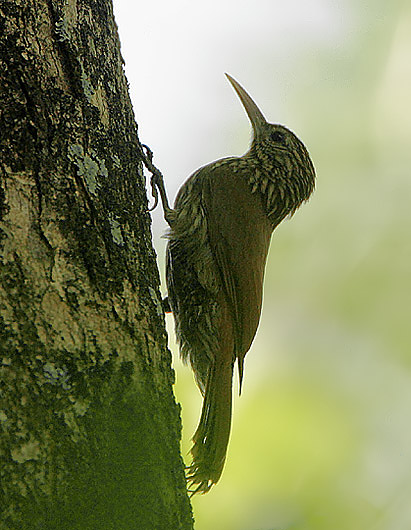
Wikipedia: Streak-headed woodcreeper Source: OTHER
Flickr_-_Rainbirder_-_Streak-headed_Woodcreeper_%28Lepidocolaptes_souleyetii%29.jpg
![]() The streak-headed woodcreeper (Lepidocolaptes souleyetii) is a passerine bird which breeds in the tropical New World from southern Mexico to northwestern Peru, northern Brazil and Guyana, and also on Trinidad.
[more]
The streak-headed woodcreeper (Lepidocolaptes souleyetii) is a passerine bird which breeds in the tropical New World from southern Mexico to northwestern Peru, northern Brazil and Guyana, and also on Trinidad.
[more]
Montane woodcreeper (Lepidocolaptes lacrymiger)
Profile Wikipedia eBird Xeno-Canto

Wikipedia: Montane woodcreeper Source: OTHER
Lepidocolaptes_lacrymiger_-NW_Ecuador-6.jpg
![]() The montane woodcreeper (Lepidocolaptes lacrymiger) is a perching bird species in the subfamily Dendrocolaptinae of the ovenbird family (Furnariidae).
[more]
The montane woodcreeper (Lepidocolaptes lacrymiger) is a perching bird species in the subfamily Dendrocolaptinae of the ovenbird family (Furnariidae).
[more]
Duida woodcreeper (Lepidocolaptes duidae)

Wikipedia: Duida woodcreeper Source: OTHER
1200px-Duida_Woodcreeper.jpg
![]() The Duida woodcreeper (Lepidocolaptes duidae) is a species of bird in the subfamily Dendrocolaptinae. It is found in northwest Amazonia in Brazil, Colombia, Ecuador, Peru, and Venezuela. Its natural habitat is subtropical or tropical moist lowland forests.
[more]
The Duida woodcreeper (Lepidocolaptes duidae) is a species of bird in the subfamily Dendrocolaptinae. It is found in northwest Amazonia in Brazil, Colombia, Ecuador, Peru, and Venezuela. Its natural habitat is subtropical or tropical moist lowland forests.
[more]
Olivaceous woodcreeper (Sittasomus griseicapillus)
Profile Wikipedia eBird Xeno-Canto

Wikipedia: Olivaceous woodcreeper Source: OTHER
Sittasomus_griseicapillus_Olivaceous_Woodcreeper.jpg
![]() The olivaceous woodcreeper (Sittasomus griseicapillus) is a passerine bird of the tropical Americas. It belongs to the true woodcreepers (tribe Dendrocolaptini) of the ovenbird family (Furnariidae).
[more]
The olivaceous woodcreeper (Sittasomus griseicapillus) is a passerine bird of the tropical Americas. It belongs to the true woodcreepers (tribe Dendrocolaptini) of the ovenbird family (Furnariidae).
[more]
Northern barred-woodcreeper (Dendrocolaptes sanctithomae)
Profile Wikipedia eBird Xeno-Canto

Wikipedia: Northern barred-woodcreeper Source: OTHER
Flickr_-_Rainbirder_-_Northern_Barred_Woodcreeper_%28Dendrocolaptes_sanctithomae%29.jpg
![]() The northern barred woodcreeper (Dendrocolaptes sanctithomae) is a species of bird in the subfamily Dendrocolaptinae. It was formerly included as a subspecies of the Amazonian barred woodcreeper (D. certhia).
[more]
The northern barred woodcreeper (Dendrocolaptes sanctithomae) is a species of bird in the subfamily Dendrocolaptinae. It was formerly included as a subspecies of the Amazonian barred woodcreeper (D. certhia).
[more]
Black-banded woodcreeper (Dendrocolaptes picumnus)
Profile Wikipedia eBird Xeno-Canto

Wikipedia: Black-banded woodcreeper Source: OTHER
1200px-DendrocolaptesPuncticollisSmit.jpg
![]() The black-banded woodcreeper (Dendrocolaptes picumnus) is a species of bird in the Dendrocolaptinae subfamily, the woodcreepers.
It is discontinuously spread from Chiapas to Paraguay and northern Argentina.
Its natural habitats are subtropical or tropical moist lowland forests and subtropical or tropical moist montane forests.
[more]
The black-banded woodcreeper (Dendrocolaptes picumnus) is a species of bird in the Dendrocolaptinae subfamily, the woodcreepers.
It is discontinuously spread from Chiapas to Paraguay and northern Argentina.
Its natural habitats are subtropical or tropical moist lowland forests and subtropical or tropical moist montane forests.
[more]
Amazonian barred-woodcreeper (Dendrocolaptes certhia)
Profile Wikipedia eBird Xeno-Canto

Wikipedia: Amazonian barred-woodcreeper Source: OTHER
Amazonian_Barred-woodcreeper_%28Dendrocolaptes_certhia%29.jpg
![]() The Amazonian barred woodcreeper (Dendrocolaptes certhia) is a species of bird in the Dendrocolaptinae subfamily, the woodcreepers. The northern barred woodcreeper (D. sanctithomae) was formerly included in this species. The Amazonian barred woodcreeper still includes the subspecies concolor, which sometimes is considered a separate species, the concolor woodcreeper.
[more]
The Amazonian barred woodcreeper (Dendrocolaptes certhia) is a species of bird in the Dendrocolaptinae subfamily, the woodcreepers. The northern barred woodcreeper (D. sanctithomae) was formerly included in this species. The Amazonian barred woodcreeper still includes the subspecies concolor, which sometimes is considered a separate species, the concolor woodcreeper.
[more]
Strong-billed woodcreeper (Xiphocolaptes promeropirhynchus)
Profile Wikipedia eBird Xeno-Canto

Wikipedia: Strong-billed woodcreeper Source: OTHER
1200px-Strong-billed_woodcreeper_2.jpg
![]() The strong-billed woodcreeper (Xiphocolaptes promeropirhynchus) is a species of bird in the Dendrocolaptinae subfamily. It is one of the largest woodcreepers and the largest furnariids, though the slender long-billed woodcreeper is longer and the great rufous woodcreeper is larger overall. There is some size variation across the range, with typical birds measuring 28–31 cm (11-12.5 in) long and weighing about 120 grams (4.2 oz). Large strong-billed woodcreepers can measure up to 35 cm (14 in) and weigh 169 grams (6 oz).[2] The most distinctive feature of this typically marked striped, brownish bird (other than its size) is its massive, semi-decurved bill, which may be brown or blackish.
[more]
The strong-billed woodcreeper (Xiphocolaptes promeropirhynchus) is a species of bird in the Dendrocolaptinae subfamily. It is one of the largest woodcreepers and the largest furnariids, though the slender long-billed woodcreeper is longer and the great rufous woodcreeper is larger overall. There is some size variation across the range, with typical birds measuring 28–31 cm (11-12.5 in) long and weighing about 120 grams (4.2 oz). Large strong-billed woodcreepers can measure up to 35 cm (14 in) and weigh 169 grams (6 oz).[2] The most distinctive feature of this typically marked striped, brownish bird (other than its size) is its massive, semi-decurved bill, which may be brown or blackish.
[more]
Plain-brown woodcreeper (Dendrocincla fuliginosa)
Profile Wikipedia eBird Xeno-Canto
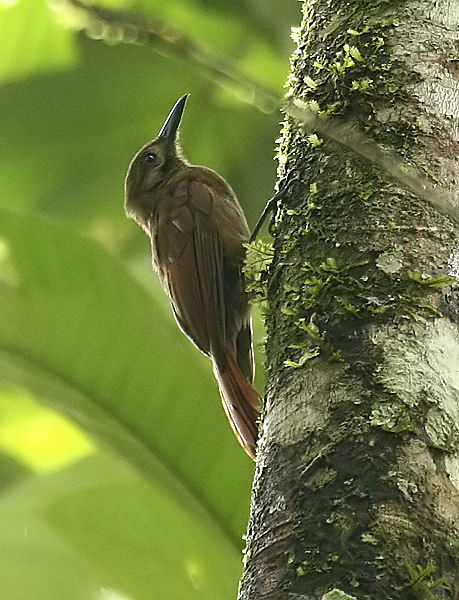
Wikipedia: Plain-brown woodcreeper Source: OTHER
Dendrocincla_fuliginosa_-NW_Ecuador-8.jpg
![]() The plain-brown woodcreeper (Dendrocincla fuliginosa), is a sub-oscine passerine bird which breeds in the tropical New World from Honduras through South America to northern Argentina, and in Trinidad and Tobago. Sometimes it is considered to include the plain-winged woodcreeper (D. turdina) as a subspecies.
[more]
The plain-brown woodcreeper (Dendrocincla fuliginosa), is a sub-oscine passerine bird which breeds in the tropical New World from Honduras through South America to northern Argentina, and in Trinidad and Tobago. Sometimes it is considered to include the plain-winged woodcreeper (D. turdina) as a subspecies.
[more]
White-chinned woodcreeper (Dendrocincla merula)

Wikipedia: White-chinned woodcreeper Source: OTHER
1200px-Dendrocincla_merula_-_White-chinned_Woodcreeper%3B_Madre_de_Dios%2C_Per%C3%BA.jpg
![]() The white-chinned woodcreeper (Dendrocincla merula) is a species of bird in the Dendrocolaptinae subfamily.
It is found in Bolivia, Brazil, Colombia, Ecuador, French Guiana, Guyana, Peru, Suriname, and Venezuela.
Its natural habitat is subtropical or tropical moist lowland forests.
[more]
The white-chinned woodcreeper (Dendrocincla merula) is a species of bird in the Dendrocolaptinae subfamily.
It is found in Bolivia, Brazil, Colombia, Ecuador, French Guiana, Guyana, Peru, Suriname, and Venezuela.
Its natural habitat is subtropical or tropical moist lowland forests.
[more]
Tryannine woodcreeper (Dendrocincla tyrannina)
Red-billed scythebill / Rotrücken-Sensenschnabel (Campylorhamphus trochilirostris)
Profile Wikipedia eBird Xeno-Canto
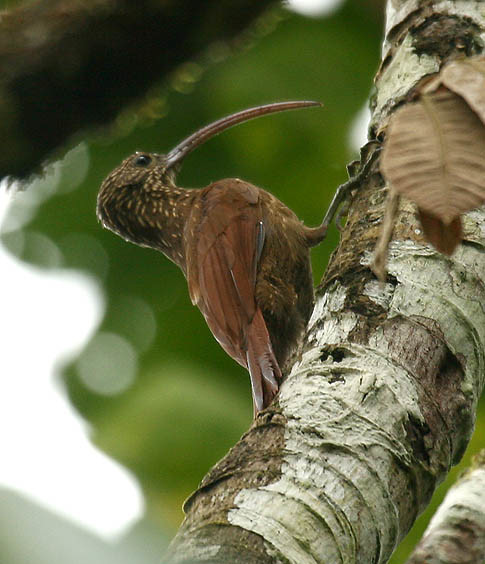
Wikipedia: Red-billed scythebill Source: OTHER
Campylorhamphus_trochilirostris_-NW_Ecuador-8.jpg
![]() The red-billed scythebill (Campylorhamphus trochilirostris) is a species of bird in the Dendrocolaptinae subfamily.
[more]
The red-billed scythebill (Campylorhamphus trochilirostris) is a species of bird in the Dendrocolaptinae subfamily.
[more]
Brown-billed scythebill (Campylorhamphus pusillus)
Profile Wikipedia eBird Xeno-Canto

Wikipedia: Brown-billed scythebill Source: OTHER
1200px-Campylorhamphus_pusillus_-_Brown-billed_Scythebill_1_%28cropped%29.jpg
![]() The brown-billed scythebill (Campylorhamphus pusillus) is a species of bird in the family Furnariidae.
[more]
The brown-billed scythebill (Campylorhamphus pusillus) is a species of bird in the family Furnariidae.
[more]
Greater scythebill (Drymotoxeres pucherani)

Wikipedia: Greater scythebill Source: OTHER
1200px-Drymotoxeres_pucheranii_1849.jpg
![]() The greater scythebill (Drymotoxeres pucheranii) is a species of bird in the Dendrocolaptinae subfamily. This species is found at very low densities in highland forest in the Andes, ranging from southern Colombia to far northern Peru. It has traditionally been included in Campylorhamphus together with the other scythebills, but it is closer to the scimitar-billed woodcreeper, leading to the description of the new genus Drymotoxeres.[1]
[more]
The greater scythebill (Drymotoxeres pucheranii) is a species of bird in the Dendrocolaptinae subfamily. This species is found at very low densities in highland forest in the Andes, ranging from southern Colombia to far northern Peru. It has traditionally been included in Campylorhamphus together with the other scythebills, but it is closer to the scimitar-billed woodcreeper, leading to the description of the new genus Drymotoxeres.[1]
[more]
Curve-billed scythebill (Campylorhamphus procurvoides)
Profile Wikipedia eBird Xeno-Canto

Wikipedia: Curve-billed scythebill Source: OTHER
Campylorhamphus_procurvoides_-_Curve-billed_Scythebill%3B_Botanic_Garden_Tower%2C_Manaus%2C_Amazonas%2C_Brazil.jpg
![]() The curve-billed scythebill (Campylorhamphus procurvoides) is a species of bird in the ovenbird family.
It is found in Amazonia. Its natural habitat is subtropical or tropical moist lowland forests.
[more]
The curve-billed scythebill (Campylorhamphus procurvoides) is a species of bird in the ovenbird family.
It is found in Amazonia. Its natural habitat is subtropical or tropical moist lowland forests.
[more]
Long-tailed woodcreeper (Deconychura longicauda)
Profile Wikipedia eBird Xeno-Canto
Wikipedia: Long-tailed woodcreeper Source: OTHER
Deconychura_longicauda_-_Long-tailed_Woodcreeper.JPG
![]() The long-tailed woodcreeper (Deconychura longicauda) is a species of bird in the Dendrocolaptinae subfamily. It is monotypic within Deconychura, but formerly this genus also included the spot-throated woodcreeper.[2]
[more]
The long-tailed woodcreeper (Deconychura longicauda) is a species of bird in the Dendrocolaptinae subfamily. It is monotypic within Deconychura, but formerly this genus also included the spot-throated woodcreeper.[2]
[more]
Spot-throated woodcreeper (Certhiasomus stictolaemus)
![]() The spot-throated woodcreeper (Certhiasomus stictolaemus) is a species of bird in the Dendrocolaptinae subfamily. It is the only species in the genus Certhiasomus (i.e. the genus is monotypic). It was formerly included in Deconychura together with the long-tailed woodcreeper, but the two are not closely related.[1]
[more]
The spot-throated woodcreeper (Certhiasomus stictolaemus) is a species of bird in the Dendrocolaptinae subfamily. It is the only species in the genus Certhiasomus (i.e. the genus is monotypic). It was formerly included in Deconychura together with the long-tailed woodcreeper, but the two are not closely related.[1]
[more]
Rufous-breasted antthrush (Formicarius rufipectus)
Profile Wikipedia eBird Xeno-Canto

Wikipedia: Rufous-breasted antthrush Source: OTHER
1200px-Formicarius_rufipectus.jpg
![]() The rufous-breasted antthrush (Formicarius rufipectus) is a species of bird in the family Formicariidae. It is found in Colombia, Costa Rica, Ecuador, Panama, Peru, and Venezuela. Its natural habitat is subtropical or tropical moist montane forest.
[more]
The rufous-breasted antthrush (Formicarius rufipectus) is a species of bird in the family Formicariidae. It is found in Colombia, Costa Rica, Ecuador, Panama, Peru, and Venezuela. Its natural habitat is subtropical or tropical moist montane forest.
[more]
Black-faced antthrush (Formicarius analis)
Profile Wikipedia eBird Xeno-Canto

Wikipedia: Black-faced antthrush Source: OTHER
Black-faced_Antthrush_-_Rio_Tigre_-_Costa_Rica_%2826631229751%29.jpg
![]() The black-faced antthrush (Formicarius analis), is a species of passerine bird in the family Formicariidae.
[more]
The black-faced antthrush (Formicarius analis), is a species of passerine bird in the family Formicariidae.
[more]
Black-headed antthrush (Formicarius nigricapillus)
Profile Wikipedia eBird Xeno-Canto

Wikipedia: Black-headed antthrush Source: OTHER
1200px-Formicarius_nigricapillus_dist.png
![]() The black-headed antthrush (Formicarius nigricapillus) is a species of bird in the family Formicariidae.
Its natural habitats are subtropical or tropical moist lowland forests and subtropical or tropical moist montane forests.
[more]
The black-headed antthrush (Formicarius nigricapillus) is a species of bird in the family Formicariidae.
Its natural habitats are subtropical or tropical moist lowland forests and subtropical or tropical moist montane forests.
[more]
Rufous-capped antthrush (Formicarius colma)
Profile Wikipedia eBird Xeno-Canto

Wikipedia: Rufous-capped antthrush Source: OTHER
Formicarius_colma_-Vale_do_Ribeira%2C_Registro%2C_Sao_Paulo%2C_Brazil-8_%281%29.jpg
![]() The rufous-capped antthrush (Formicarius colma) is a small species of bird in the family Formicariidae located in the order Passeriformes.
It is considered to be uncommon but widespread, found in Bolivia, Brazil, Colombia, Ecuador, French Guiana, Guyana, Peru, Suriname, and Venezuela.
The rufous-capped antthrush is typically found inhabiting the shady floor of tall, humid forests on solid ground, and is occasionally spotted in transitional forests (várzea) and savanna forests (Suriname).[2]
[more]
The rufous-capped antthrush (Formicarius colma) is a small species of bird in the family Formicariidae located in the order Passeriformes.
It is considered to be uncommon but widespread, found in Bolivia, Brazil, Colombia, Ecuador, French Guiana, Guyana, Peru, Suriname, and Venezuela.
The rufous-capped antthrush is typically found inhabiting the shady floor of tall, humid forests on solid ground, and is occasionally spotted in transitional forests (várzea) and savanna forests (Suriname).[2]
[more]
Scaled antpitta (Grallaria guatimalensis)
Profile Wikipedia eBird Xeno-Canto

Wikipedia: Scaled antpitta Source: OTHER
1200px-Scaled_Antpitta_%28Grallaria_guatimalensis%29.jpg
![]() The scaled antpitta (Grallaria guatimalensis) is a species of bird in the family Grallariidae.
[more]
The scaled antpitta (Grallaria guatimalensis) is a species of bird in the family Grallariidae.
[more]
Moustached antpitta (Grallaria alleni)
Profile Wikipedia eBird Xeno-Canto

Wikipedia: Moustached antpitta Source: OTHER
1200px-Moustached_Antpitta%2C_Paz_de_las_Aves%2C_Ecuador_%285746102084%29.jpg
![]() The moustached antpitta (Grallaria alleni) is a species of bird placed in the family Grallariidae.
[more]
The moustached antpitta (Grallaria alleni) is a species of bird placed in the family Grallariidae.
[more]
Scrub antpitta (Grallaria watkinsi)

Wikipedia: Scrub antpitta Source: OTHER
Watkins%27_Antpitta_-_South_Ecuador_S4E9791_%2816824015255%29.jpg
![]() Watkins's antpitta (Grallaria watkinsi) or scrub antpitta, is a species of bird in the family Grallariidae. It is found in Ecuador and Peru.
[more]
Watkins's antpitta (Grallaria watkinsi) or scrub antpitta, is a species of bird in the family Grallariidae. It is found in Ecuador and Peru.
[more]
Undulated antpitta (Grallaria squamigera)
Profile Wikipedia eBird Xeno-Canto

Wikipedia: Undulated antpitta Source: OTHER
1200px-Naturalis_Biodiversity_Center_-_RMNH.AVES.120540_-_Grallaria_squamigera_squamigera_Pr%C3%A9vost_%26_Des_Murs%2C_1842_-_Formicariidae_-_bird_skin_specimen.jpeg
![]() The undulated antpitta (Grallaria squamigera) is a bird in the family Grallariidae. The species was first described by Florent Prévost and Marc Athanase Parfait Œillet des Murs in 1842.
[more]
The undulated antpitta (Grallaria squamigera) is a bird in the family Grallariidae. The species was first described by Florent Prévost and Marc Athanase Parfait Œillet des Murs in 1842.
[more]
Tawny antpitta (Grallaria quitensis)
Profile Wikipedia eBird Xeno-Canto

Wikipedia: Tawny antpitta Source: OTHER
Tawny_Antpitta.jpg
![]() The tawny antpitta (Grallaria quitensis) is a species of bird in the family Grallariidae.
[more]
The tawny antpitta (Grallaria quitensis) is a species of bird in the family Grallariidae.
[more]
Yellow-breasted antpitta (Grallaria flavotincta)

Wikipedia: Yellow-breasted antpitta Source: OTHER
1200px-Yellow-breasted_Antpitta%2C_Paz_de_las_Aves%2C_Ecuador_%285745552999%29.jpg
![]() The yellow-breasted antpitta (Grallaria flavotincta) is a species of bird in the family Grallariidae.
[more]
The yellow-breasted antpitta (Grallaria flavotincta) is a species of bird in the family Grallariidae.
[more]
Giant antpitta (Grallaria gigantea)
Profile Wikipedia eBird Xeno-Canto

Wikipedia: Giant antpitta Source: OTHER
1200px-Grallaria_gigantea.jpg
![]() The giant antpitta (Grallaria gigantea) is a perching bird species in the antpitta family (Grallariidae).
[more]
The giant antpitta (Grallaria gigantea) is a perching bird species in the antpitta family (Grallariidae).
[more]
Chestnut-naped antpitta (Grallaria nuchalis)
Profile Wikipedia eBird Xeno-Canto

Wikipedia: Chestnut-naped antpitta Source: OTHER
1200px-Grallaria_nuchalis_by_Alejandro_Bayer_Tamayo.jpg
![]() The chestnut-naped antpitta (Grallaria nuchalis) is a species of bird placed in the family Grallariidae.
[more]
The chestnut-naped antpitta (Grallaria nuchalis) is a species of bird placed in the family Grallariidae.
[more]
Plain-backed antpitta (Grallaria haplonota)
Profile Wikipedia eBird Xeno-Canto

Wikipedia: Plain-backed antpitta Source: OTHER
GrallariaHaplonotaSmit.jpg
![]() The plain-backed antpitta (Grallaria haplonota) is a species of bird in the family Grallariidae. It is found in the Andes of Ecuador and the Venezuelan Coastal Range. Its natural habitats are subtropical or tropical moist montane forest and heavily degraded former forest.
[more]
The plain-backed antpitta (Grallaria haplonota) is a species of bird in the family Grallariidae. It is found in the Andes of Ecuador and the Venezuelan Coastal Range. Its natural habitats are subtropical or tropical moist montane forest and heavily degraded former forest.
[more]
Bicolored antpitta (Grallaria rufocinerea)
Profile Wikipedia eBird Xeno-Canto

Wikipedia: Bicolored antpitta Source: OTHER
1200px-Bicolored_Antpitta_%28Grallaria_rufocinerea%29.jpg
![]() The bicolored antpitta (Grallaria rufocinerea) is a species of bird in the family Grallariidae. In 2020, genetic evidence revealed that the bicolored pitta is a member of the rufous antpitta species complex.[3] It is found in Colombia and Ecuador. Its natural habitat is subtropical or tropical moist montane forest. It is threatened by habitat loss.
[more]
The bicolored antpitta (Grallaria rufocinerea) is a species of bird in the family Grallariidae. In 2020, genetic evidence revealed that the bicolored pitta is a member of the rufous antpitta species complex.[3] It is found in Colombia and Ecuador. Its natural habitat is subtropical or tropical moist montane forest. It is threatened by habitat loss.
[more]
Jocotoco antpitta (Grallaria ridgelyi)
Profile Wikipedia eBird Xeno-Canto

Wikipedia: Jocotoco antpitta Source: OTHER
Jocotoco_Antpitta.jpg
![]() The jocotoco antpitta (Grallaria ridgelyi) is an endangered antpitta, a bird from Ecuador and Peru. It was discovered in 1997, and scientifically described in 1999.
[more]
The jocotoco antpitta (Grallaria ridgelyi) is an endangered antpitta, a bird from Ecuador and Peru. It was discovered in 1997, and scientifically described in 1999.
[more]
White-bellied antpitta (Grallaria hypoleuca)
Profile Wikipedia eBird Xeno-Canto

Wikipedia: White-bellied antpitta Source: OTHER
White-bellied_Antpitta_-_San_Isidro_-_South_Ecuador_S4E3747.jpg
![]() The white-bellied antpitta (Grallaria hypoleuca) is a species of bird in the family Grallariidae. It is found in Colombia, Ecuador and far northern Peru.
[more]
The white-bellied antpitta (Grallaria hypoleuca) is a species of bird in the family Grallariidae. It is found in Colombia, Ecuador and far northern Peru.
[more]
Ochre-striped antpitta (Grallaria dignissima)
Profile Wikipedia eBird Xeno-Canto

Wikipedia: Ochre-striped antpitta Source: OTHER
1200px-GrallariaDignissimaKeulemans.jpg
![]() The ochre-striped antpitta (Grallaria dignissima) is a species of bird in the family Grallariidae. It is found in Ecuador, Peru and southern Colombia.
[more]
The ochre-striped antpitta (Grallaria dignissima) is a species of bird in the family Grallariidae. It is found in Ecuador, Peru and southern Colombia.
[more]
Chestnut-crowned antpitta (Grallaria ruficapilla)
Profile Wikipedia eBird Xeno-Canto

Wikipedia: Chestnut-crowned antpitta Source: OTHER
1200px-Chestnut-crowned_Antpitta%2C_Rio_Blanco%2C_Colombia_%285746788680%29.jpg
![]() The chestnut-crowned antpitta (Grallaria ruficapilla) is a species of bird in the family Grallariidae. It is found in Colombia, Ecuador, Peru, and Venezuela. Its natural habitats are subtropical or tropical moist montane forest and heavily degraded former forest, which it has a much greater tolerance for than most antpittas. Usually this bird lives at elevations of 1,900 to 3,100 meters (6,200–10,200 ft).
[more]
The chestnut-crowned antpitta (Grallaria ruficapilla) is a species of bird in the family Grallariidae. It is found in Colombia, Ecuador, Peru, and Venezuela. Its natural habitats are subtropical or tropical moist montane forest and heavily degraded former forest, which it has a much greater tolerance for than most antpittas. Usually this bird lives at elevations of 1,900 to 3,100 meters (6,200–10,200 ft).
[more]
Rufous antpitta / Einfarb-Ameisenpitta (Grallaria rufula)
Profile Wikipedia eBird Xeno-Canto

Wikipedia: Rufous antpitta Source: OTHER
1200px-Rufous_Antpitta%2C_Tapichalaca%2C_Ecuador_%285746102588%29.jpg
![]() The rufous antpitta (Grallaria rufula) was a species of bird in the family Grallaridae that, in 2020, was found to be a species complex made up of 13 visually similar, but distinct species.[2]
[more]
The rufous antpitta (Grallaria rufula) was a species of bird in the family Grallaridae that, in 2020, was found to be a species complex made up of 13 visually similar, but distinct species.[2]
[more]
Ochre-breasted antpitta (Grallaricula flavirostris)
Profile Wikipedia eBird Xeno-Canto

Wikipedia: Ochre-breasted antpitta Source: OTHER
1200px-Grallaricula_flavirostris.jpg
![]() The ochre-breasted antpitta (Grallaricula flavirostris) is a species of bird placed in the family Grallariidae.
[more]
The ochre-breasted antpitta (Grallaricula flavirostris) is a species of bird placed in the family Grallariidae.
[more]
Crescent-faced antpitta (Grallaricula lineifrons)
Profile Wikipedia eBird Xeno-Canto

Wikipedia: Crescent-faced antpitta Source: OTHER
1200px-Crescent-faced_Antpitta.jpg
![]() The crescent-faced antpitta (Grallaricula lineifrons) is a species of bird in the family Grallariidae. It is found in Colombia and Ecuador.
[more]
The crescent-faced antpitta (Grallaricula lineifrons) is a species of bird in the family Grallariidae. It is found in Colombia and Ecuador.
[more]
Peruvian antpitta (Grallaricula peruviana)
Profile Wikipedia eBird Xeno-Canto

Wikipedia: Peruvian antpitta Source: OTHER
1200px-Grallaricula_peruviana.jpg
![]() The Peruvian antpitta (Grallaricula peruviana) is a species of bird in the family Grallariidae. It is found in Ecuador and northern Peru.
[more]
The Peruvian antpitta (Grallaricula peruviana) is a species of bird in the family Grallariidae. It is found in Ecuador and northern Peru.
[more]
Slate-crowned antpitta (Grallaricula nana)
Profile Wikipedia eBird Xeno-Canto

Wikipedia: Slate-crowned antpitta Source: OTHER
Slate-crowned_Antpitta_-_Colombia_S4E1919.jpg
![]() The slaty-crowned antpitta (Grallaricula nana) is a species of bird placed in the family Grallariidae.
[more]
The slaty-crowned antpitta (Grallaricula nana) is a species of bird placed in the family Grallariidae.
[more]
Rufous-breasted antpitta (Grallaricula leymebambae)

Wikipedia: Rufous-breasted antpitta Source: OTHER
1200px-Grallaricula_leymebambae_106401195.jpg
![]() The rufous-breasted antpitta or leymebamba antpitta (Grallaricula leymebambae) is a species of bird in the family Grallariidae. It was first described by American ornithologist and entomologist Melbourne Armstrong Carriker. It is found in Peru and western Bolivia. Its natural habitats are subtropical or tropical moist montane forest and heavily degraded former forest. It has been recently considered a subspecies of Grallaricula ferrugineipectus.[2]
[more]
The rufous-breasted antpitta or leymebamba antpitta (Grallaricula leymebambae) is a species of bird in the family Grallariidae. It was first described by American ornithologist and entomologist Melbourne Armstrong Carriker. It is found in Peru and western Bolivia. Its natural habitats are subtropical or tropical moist montane forest and heavily degraded former forest. It has been recently considered a subspecies of Grallaricula ferrugineipectus.[2]
[more]
Streak-chested antpitta (Hylopezus perspicillatus)
Profile Wikipedia eBird Xeno-Canto

Wikipedia: Streak-chested antpitta Source: OTHER
1200px-Hylopezus_perspicillatus_-Carara_National_Park%2C_Central_Pacific_Conservation_Area%2C_Costa_Rica-8.jpg
![]() The streak-chested antpitta or spectacled antpitta (Hylopezus perspicillatus) is a species of bird in the family Grallariidae.
It is found in Colombia, Costa Rica, Ecuador, Honduras, Nicaragua, and Panama.
Its natural habitat is subtropical or tropical moist lowland forest.[2]
[more]
The streak-chested antpitta or spectacled antpitta (Hylopezus perspicillatus) is a species of bird in the family Grallariidae.
It is found in Colombia, Costa Rica, Ecuador, Honduras, Nicaragua, and Panama.
Its natural habitat is subtropical or tropical moist lowland forest.[2]
[more]
Thrush-like antpitta (Myrmothera campanisona)
Profile Wikipedia eBird Xeno-Canto

Wikipedia: Thrush-like antpitta Source: OTHER
1200px-GrallariaModestaWolf.jpg
![]() The thrush-like antpitta (Myrmothera campanisona) is a species of bird in the family Grallariidae.
[more]
The thrush-like antpitta (Myrmothera campanisona) is a species of bird in the family Grallariidae.
[more]
White-lored antpitta (Myrmothera fulviventris)
Profile Wikipedia eBird Xeno-Canto

Wikipedia: White-lored antpitta Source: OTHER
GrallariaFulviventrisSmit.jpg
![]() The white-lored antpitta or fulvous-bellied antpitta (Hylopezus fulviventris) is a species of bird in the family Grallariidae. It is found in Colombia, Ecuador, and Peru. Its natural habitats are subtropical or tropical moist lowland forest and heavily degraded former forest.
[more]
The white-lored antpitta or fulvous-bellied antpitta (Hylopezus fulviventris) is a species of bird in the family Grallariidae. It is found in Colombia, Ecuador, and Peru. Its natural habitats are subtropical or tropical moist lowland forest and heavily degraded former forest.
[more]
Striated antthrush (Chamaeza nobilis)
Profile Wikipedia eBird Xeno-Canto

Wikipedia: Striated antthrush Source: OTHER
1200px-Chamaeza_nobilis.jpg
![]() The striated antthrush (Chamaeza nobilis) is a species of bird in the family Formicariidae.
It is found in Bolivia, Brazil, Colombia, Ecuador, and Peru.
Its natural habitat is subtropical or tropical moist lowland forests.
[more]
The striated antthrush (Chamaeza nobilis) is a species of bird in the family Formicariidae.
It is found in Bolivia, Brazil, Colombia, Ecuador, and Peru.
Its natural habitat is subtropical or tropical moist lowland forests.
[more]
Short-tailed antthrush (Chamaeza campanisona)
Profile Wikipedia eBird Xeno-Canto

Wikipedia: Short-tailed antthrush Source: OTHER
Chamaeza_campanisona.jpeg
![]() The short-tailed antthrush (Chamaeza campanisona) is a South American species of bird in the family Formicariidae. Its distribution is highly disjunct with populations in the Atlantic Forest in eastern Brazil, eastern Paraguay and northeastern Argentina, isolated highland forests in northeastern Brazil, forests on the tepuis in southern Venezuela, Guyana and northern Brazil, and in forests along the east Andean slope from Venezuela to Bolivia.
[more]
The short-tailed antthrush (Chamaeza campanisona) is a South American species of bird in the family Formicariidae. Its distribution is highly disjunct with populations in the Atlantic Forest in eastern Brazil, eastern Paraguay and northeastern Argentina, isolated highland forests in northeastern Brazil, forests on the tepuis in southern Venezuela, Guyana and northern Brazil, and in forests along the east Andean slope from Venezuela to Bolivia.
[more]
Barred antthrush (Chamaeza mollissima)
Profile Wikipedia eBird Xeno-Canto

Wikipedia: Barred antthrush Source: OTHER
1200px-ChamaezaMollissimaWolf.jpg
![]() The barred antthrush (Chamaeza mollissima) is a species of bird in the family Formicariidae.
[more]
The barred antthrush (Chamaeza mollissima) is a species of bird in the family Formicariidae.
[more]
Dusky antbird (Cercomacroides tyrannina)

Wikipedia: Dusky antbird Source: OTHER
Cercomacra_tyrannina_%28female%29_-NW_Ecuador-8.jpg
![]() The dusky antbird or tyrannine antbird (Cercomacroides tyrannina) is a passerine bird in the antbird family. It is a resident breeder in tropical Central and South America from southeastern Mexico southwards to western Ecuador, and Amazonian Brazil.
[more]
The dusky antbird or tyrannine antbird (Cercomacroides tyrannina) is a passerine bird in the antbird family. It is a resident breeder in tropical Central and South America from southeastern Mexico southwards to western Ecuador, and Amazonian Brazil.
[more]
Jet antbird (Cercomacra nigricans)
Profile Wikipedia eBird Xeno-Canto

Wikipedia: Jet antbird Source: OTHER
Jet_Antbird_-_Colombia_S4E9202_%2816823101325%29.jpg
![]() The jet antbird (Cercomacra nigricans) is a species of bird in the family Thamnophilidae. It is found in Colombia, Venezuela, Panama and western Ecuador. Its natural habitat is subtropical or tropical moist lowland forests.
[more]
The jet antbird (Cercomacra nigricans) is a species of bird in the family Thamnophilidae. It is found in Colombia, Venezuela, Panama and western Ecuador. Its natural habitat is subtropical or tropical moist lowland forests.
[more]
Black antbird (Cercomacroides serva)
Profile Wikipedia eBird Xeno-Canto

Wikipedia: Black antbird Source: OTHER
1200px-Cercomacroides_serva_-_Black_antbird_%28male%29%2C_Careiro%2C_Amazonas%2C_Brazil.jpg
![]() The black antbird (Cercomacroides serva) is a species of passerine bird in the family Thamnophilidae. It is found in Bolivia, Brazil, Colombia, Ecuador, and Peru. Its natural habitat is subtropical or tropical moist lowland forests.
[more]
The black antbird (Cercomacroides serva) is a species of passerine bird in the family Thamnophilidae. It is found in Bolivia, Brazil, Colombia, Ecuador, and Peru. Its natural habitat is subtropical or tropical moist lowland forests.
[more]
Blackish antbird (Cercomacroides nigrescens)

Wikipedia: Blackish antbird Source: OTHER
1200px-Cercomacra_nigrescens_-_Blackish_Antbird_%28male%29.JPG
![]() The blackish antbird (Cercomacroides nigrescens) is a species of passerine bird in the family Thamnophilidae. It is found in Bolivia, Brazil, Colombia, Ecuador, French Guiana, Peru, and Suriname. Its natural habitats are subtropical or tropical moist lowland forests, subtropical or tropical moist montane forests, and heavily degraded former forest.
[more]
The blackish antbird (Cercomacroides nigrescens) is a species of passerine bird in the family Thamnophilidae. It is found in Bolivia, Brazil, Colombia, Ecuador, French Guiana, Peru, and Suriname. Its natural habitats are subtropical or tropical moist lowland forests, subtropical or tropical moist montane forests, and heavily degraded former forest.
[more]
Gray antbird (Cercomacra cinerascens)
Profile Wikipedia eBird Xeno-Canto

Wikipedia: Gray antbird Source: OTHER
1200px-Cercomacra_cinerascens_-_Gray_Anbird_male%3B_Caraj%C3%A1s_National_Forest%2C_Para%2C_Brazil.jpg
![]() The grey antbird (Cercomacra cinerascens) is a species of bird in the antbird family Thamnophilidae.
It is found in Bolivia, Brazil, Colombia, Ecuador, French Guiana, Guyana, Peru, Suriname, and Venezuela.
Its natural habitat is subtropical or tropical moist lowland forests.
[more]
The grey antbird (Cercomacra cinerascens) is a species of bird in the antbird family Thamnophilidae.
It is found in Bolivia, Brazil, Colombia, Ecuador, French Guiana, Guyana, Peru, Suriname, and Venezuela.
Its natural habitat is subtropical or tropical moist lowland forests.
[more]
Western fire-eye (Pyriglena maura)
Profile Wikipedia eBird Xeno-Canto
![]() The western fire-eye (Pyriglena maura) is an insectivorous bird in the antbird family Thamnophilidae.
It is found in Ecuador, Peru, Colombia, Bolivia, and Brazil.
[more]
The western fire-eye (Pyriglena maura) is an insectivorous bird in the antbird family Thamnophilidae.
It is found in Ecuador, Peru, Colombia, Bolivia, and Brazil.
[more]
Rufous-crowned antpitta (Pittasoma rufopileatum)
Profile Wikipedia eBird Xeno-Canto

Wikipedia: Rufous-crowned antpitta Source: OTHER
1200px-PittasomaRufopileatumKeulemans.jpg
![]() The rufous-crowned antpitta, or rufous-crowned pittasoma, (Pittasoma rufopileatum) is a species of bird in the gnateater family, Conopophagidae. It is found in Colombia and Ecuador.[2][1]
[more]
The rufous-crowned antpitta, or rufous-crowned pittasoma, (Pittasoma rufopileatum) is a species of bird in the gnateater family, Conopophagidae. It is found in Colombia and Ecuador.[2][1]
[more]
Barred antshrike / Binden-Ameisenwürger (Thamnophilus doliatus)
Profile Wikipedia eBird Xeno-Canto

Wikipedia: Barred antshrike Source: OTHER
1200px-Thamnophilus_doliatus_-Goias%2C_Brazil-8.jpg
![]() The barred antshrike (Thamnophilus doliatus) is a passerine bird in the antbird family. It is found in the Neotropics from Tamaulipas, Mexico, through Central America, Trinidad and Tobago, and a large part of South America east of the Andes as far south as northern Argentina, Bolivia and Paraguay. There is one accepted record from southern Texas.[2] It is found in a wide range of wooded habitats (even gardens and parks) in both humid and arid regions. Throughout a large part of its range, it is among the most common antbirds.
[more]
The barred antshrike (Thamnophilus doliatus) is a passerine bird in the antbird family. It is found in the Neotropics from Tamaulipas, Mexico, through Central America, Trinidad and Tobago, and a large part of South America east of the Andes as far south as northern Argentina, Bolivia and Paraguay. There is one accepted record from southern Texas.[2] It is found in a wide range of wooded habitats (even gardens and parks) in both humid and arid regions. Throughout a large part of its range, it is among the most common antbirds.
[more]
Black-crowned antshrike (Thamnophilus atrinucha)
Profile Wikipedia eBird Xeno-Canto

Wikipedia: Black-crowned antshrike Source: OTHER
1200px-Black-crowned_Antshrike_%2840880837972%29.jpg
![]() The black-crowned antshrike or western slaty antshrike (Thamnophilus atrinucha) is a species of bird in the family Thamnophilidae.
It is found in from western Ecuador, western Colombia, western Venezuela, and Central America as far north as Belize.
[more]
The black-crowned antshrike or western slaty antshrike (Thamnophilus atrinucha) is a species of bird in the family Thamnophilidae.
It is found in from western Ecuador, western Colombia, western Venezuela, and Central America as far north as Belize.
[more]
Collared antshrike (Thamnophilus bernardi)

Wikipedia: Collared antshrike Source: OTHER
1200px-CollaredAntshrike.jpg
![]() The collared antshrike (Thamnophilus bernardi) is a species of bird in the family Thamnophilidae.
It is found in Ecuador and Peru.
Its natural habitats are subtropical or tropical dry forests, subtropical or tropical dry shrubland, and subtropical or tropical moist shrubland.
[more]
The collared antshrike (Thamnophilus bernardi) is a species of bird in the family Thamnophilidae.
It is found in Ecuador and Peru.
Its natural habitats are subtropical or tropical dry forests, subtropical or tropical dry shrubland, and subtropical or tropical moist shrubland.
[more]
Uniform antshrike / Einfarb-Ameisenwürger (Thamnophilus unicolor)
Profile Wikipedia eBird Xeno-Canto
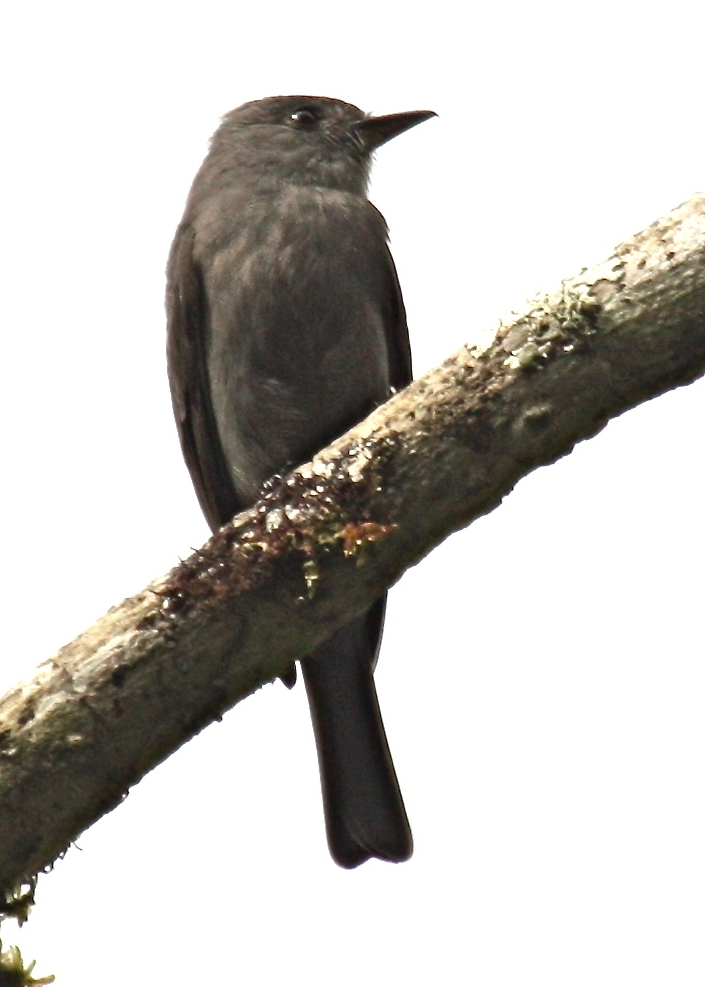
Wikipedia: Uniform antshrike Source: OTHER
Uniform_Antshrike.jpg
![]() The uniform antshrike (Thamnophilus unicolor) is a species of bird in the family Thamnophilidae. It is found in Colombia, Ecuador, and Peru. Its natural habitat is subtropical or tropical moist montane forests.
[more]
The uniform antshrike (Thamnophilus unicolor) is a species of bird in the family Thamnophilidae. It is found in Colombia, Ecuador, and Peru. Its natural habitat is subtropical or tropical moist montane forests.
[more]
Plain-winged antshrike (Thamnophilus schistaceus)
Profile Wikipedia eBird Xeno-Canto

Wikipedia: Plain-winged antshrike Source: OTHER
1200px-Thamnophilus_schistaceus_-_Plain-winged_Antshrike_%28male%29%2C_Parauapebas%2C_Par%C3%A1%2C_Brazil.jpg
![]() The plain-winged antshrike (Thamnophilus schistaceus) is a species of bird in the family Thamnophilidae. It is found in Bolivia, Brazil, Colombia, Ecuador, and Peru. Its natural habitats are subtropical or tropical moist lowland forests and subtropical or tropical swamps.
[more]
The plain-winged antshrike (Thamnophilus schistaceus) is a species of bird in the family Thamnophilidae. It is found in Bolivia, Brazil, Colombia, Ecuador, and Peru. Its natural habitats are subtropical or tropical moist lowland forests and subtropical or tropical swamps.
[more]
Northern slaty-antshrike / Tüpfelwollrücken (Thamnophilus punctatus)
Profile Wikipedia eBird Xeno-Canto

Wikipedia: Northern slaty-antshrike Source: OTHER
1200px-Naturalis_Biodiversity_Center_-_RMNH.AVES.30396_1_-_Thamnophilus_punctatus_punctatus_%28Shaw%2C_1809%29_-_Formicariidae_-_bird_skin_specimen.jpeg
![]() The northern slaty antshrike (Thamnophilus punctatus) is a species of bird in the family Thamnophilidae. It previously included the Natterer's slaty antshrike, Bolivian slaty antshrike, Planalto slaty antshrike and Sooretama slaty antshrike as subspecies, in which case the combined species simply was referred to as the slaty antshrike.
[more]
The northern slaty antshrike (Thamnophilus punctatus) is a species of bird in the family Thamnophilidae. It previously included the Natterer's slaty antshrike, Bolivian slaty antshrike, Planalto slaty antshrike and Sooretama slaty antshrike as subspecies, in which case the combined species simply was referred to as the slaty antshrike.
[more]
White-shouldered antshrike / Perlschulter-Ameisenwürger (Thamnophilus aethiops)
Profile Wikipedia eBird Xeno-Canto

Wikipedia: White-shouldered antshrike Source: OTHER
1200px-Thamnophilus_aethiops.jpg
![]() The white-shouldered antshrike (Thamnophilus aethiops) is a species of bird in the family Thamnophilidae. It is found in Bolivia, Brazil, Colombia, Ecuador, Peru, and Venezuela. Its natural habitat is subtropical or tropical moist lowland forests.
[more]
The white-shouldered antshrike (Thamnophilus aethiops) is a species of bird in the family Thamnophilidae. It is found in Bolivia, Brazil, Colombia, Ecuador, Peru, and Venezuela. Its natural habitat is subtropical or tropical moist lowland forests.
[more]
Lined antshrike / Feinstreifen-Ameisenwürger (Thamnophilus tenuepunctatus)
Profile Wikipedia eBird Xeno-Canto

Wikipedia: Lined antshrike Source: OTHER
Lined-Antshrike.jpg
![]() The lined antshrike (Thamnophilus tenuepunctatus) is a species of bird in the family Thamnophilidae.
[more]
The lined antshrike (Thamnophilus tenuepunctatus) is a species of bird in the family Thamnophilidae.
[more]
Mouse-colored antshrike / Braunflügel-Ameisenwürger (Thamnophilus murinus)
Profile Wikipedia eBird Xeno-Canto

Wikipedia: Mouse-colored antshrike Source: OTHER
1200px-Mouse-colored_Antshrike.jpg
![]() The mouse-colored antshrike (Thamnophilus murinus) is a species of bird in the family Thamnophilidae.
[more]
The mouse-colored antshrike (Thamnophilus murinus) is a species of bird in the family Thamnophilidae.
[more]
Chapman's antshrike (Thamnophilus zarumae)
Profile Wikipedia eBird Xeno-Canto
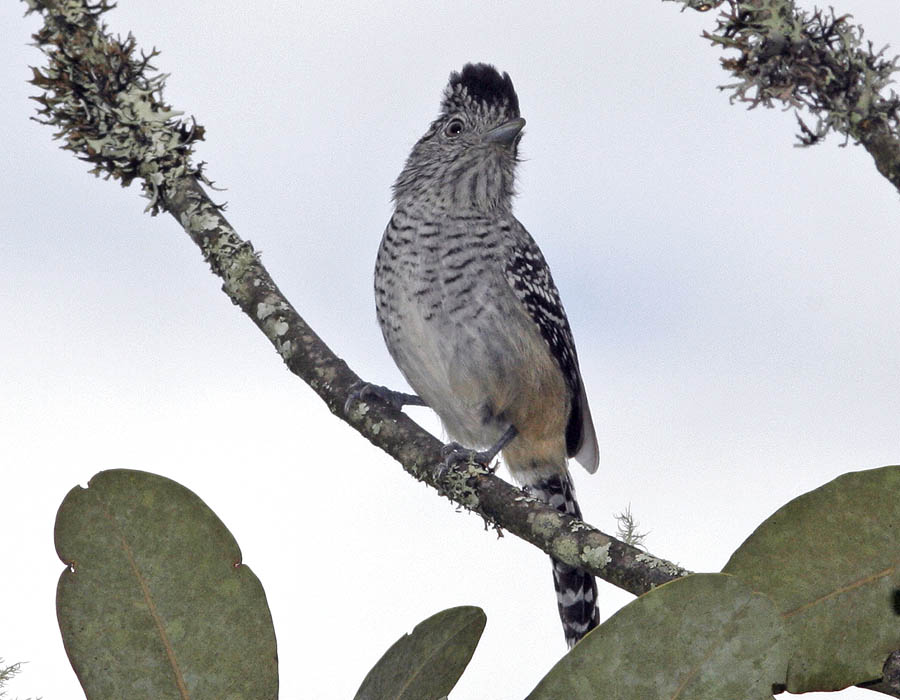
Wikipedia: Chapman's antshrike Source: OTHER
Chapman%27s_Antshrike%2C_male_%28530829149%29.jpg
![]() Chapman's antshrike (Thamnophilus zarumae) is a species of bird in the family Thamnophilidae. It is found in Ecuador and Peru.
[more]
Chapman's antshrike (Thamnophilus zarumae) is a species of bird in the family Thamnophilidae. It is found in Ecuador and Peru.
[more]
Amazonian antshrike / Amazonien-Tropfenameisenwürger (Thamnophilus amazonicus)
Profile Wikipedia eBird Xeno-Canto

Wikipedia: Amazonian antshrike Source: OTHER
Thamnophilus_amazonicus_-_Amazonian_Antshrike_%28female%29_01.JPG
![]() The Amazonian antshrike (Thamnophilus amazonicus) is a species of bird in the family Thamnophilidae, the antbirds. It occurs in the Amazon Basin of Brazil, and east to Maranhão state; also Amazonian Colombia, Ecuador, Peru, and Bolivia. It is in the Guianas in Guyana, Suriname and French Guiana, also two regions of Venezuela. Its natural habitats are subtropical or tropical moist lowland forests and subtropical or tropical swamps.
[more]
The Amazonian antshrike (Thamnophilus amazonicus) is a species of bird in the family Thamnophilidae, the antbirds. It occurs in the Amazon Basin of Brazil, and east to Maranhão state; also Amazonian Colombia, Ecuador, Peru, and Bolivia. It is in the Guianas in Guyana, Suriname and French Guiana, also two regions of Venezuela. Its natural habitats are subtropical or tropical moist lowland forests and subtropical or tropical swamps.
[more]
Cocha antshrike / Südlicher Schwarzameisenwürger (Thamnophilus praecox)
Profile Wikipedia eBird Xeno-Canto

Wikipedia: Cocha antshrike Source: OTHER
1200px-Thamnophilus_praecox_-_Cocha_Antshrike_-_female_%28cropped%29.jpg
![]() The cocha antshrike (Thamnophilus praecox) is a species of bird in the family Thamnophilidae. It is endemic to Ecuador.
[more]
The cocha antshrike (Thamnophilus praecox) is a species of bird in the family Thamnophilidae. It is endemic to Ecuador.
[more]
Castelnau's antshrike / Flussufer-Ameisenwürger (Thamnophilus cryptoleucus)
Profile Wikipedia eBird Xeno-Canto

Wikipedia: Castelnau's antshrike Source: OTHER
1200px-Thamnophilus_cryptoleucus_-_Castelnau%27s_Antshrike_%28cropped%29.jpg
![]() Castelnau's antshrike (Thamnophilus cryptoleucus) is a species of bird in the family Thamnophilidae. It is found in Brazil, Colombia, Ecuador, and Peru. Its natural habitats are riverine subtropical or tropical moist lowland forests and heavily degraded former forest.
[more]
Castelnau's antshrike (Thamnophilus cryptoleucus) is a species of bird in the family Thamnophilidae. It is found in Brazil, Colombia, Ecuador, and Peru. Its natural habitats are riverine subtropical or tropical moist lowland forests and heavily degraded former forest.
[more]
Striated antbird (Drymophila devillei)
Profile Wikipedia eBird Xeno-Canto

Wikipedia: Striated antbird Source: OTHER
Drymophila_devillei_-_Striated_Antbird%3B_Madre_de_Dios%2C_Peru_2.jpg
![]() The striated antbird (Drymophila devillei) is a species of bird in the family Thamnophilidae, the antbirds. It is found in the western and south-central Amazon in South America. As presently defined, it has two subspecies: the nominate subspecies in the west, and D. d. subochracea in the south-central Amazon. The latter is sometimes known as the Xingu antbird, but this leads to confusion with Willisornis vidua.
[more]
The striated antbird (Drymophila devillei) is a species of bird in the family Thamnophilidae, the antbirds. It is found in the western and south-central Amazon in South America. As presently defined, it has two subspecies: the nominate subspecies in the west, and D. d. subochracea in the south-central Amazon. The latter is sometimes known as the Xingu antbird, but this leads to confusion with Willisornis vidua.
[more]
Streak-headed antbird (Drymophila striaticeps)

Wikipedia: Streak-headed antbird Source: OTHER
Drymophila_striaticeps_%28Streak-headed_Antbird%29_-_male_%287062565647%29.jpg
![]() The streak-headed antbird (Drymophila striaticeps) is a species of bird in the family Thamnophilidae. It is found in humid highland forests, especially near bamboo, ranging through the Andes from Bolivia to Colombia. This 15 cm (6 in) bird is found at higher elevations. It was previously considered conspecific with the long-tailed antbird.
[more]
The streak-headed antbird (Drymophila striaticeps) is a species of bird in the family Thamnophilidae. It is found in humid highland forests, especially near bamboo, ranging through the Andes from Bolivia to Colombia. This 15 cm (6 in) bird is found at higher elevations. It was previously considered conspecific with the long-tailed antbird.
[more]
Dugand's antwren (Herpsilochmus dugandi)
Profile Wikipedia eBird Xeno-Canto

Wikipedia: Dugand's antwren Source: OTHER
1200px-Herpsilochmus_dugandi_-_Dugand%27s_Antwren.jpg
![]() Dugand's antwren (Herpsilochmus dugandi) is a species of bird in the family Thamnophilidae. It is found in Colombia, Ecuador, and Peru. Its natural habitat is subtropical or tropical moist lowland forests.
[more]
Dugand's antwren (Herpsilochmus dugandi) is a species of bird in the family Thamnophilidae. It is found in Colombia, Ecuador, and Peru. Its natural habitat is subtropical or tropical moist lowland forests.
[more]
Yellow-breasted antwren (Herpsilochmus axillaris)
Profile Wikipedia eBird Xeno-Canto

Wikipedia: Yellow-breasted antwren Source: OTHER
Yellow-breasted-antwren.jpg
![]() The yellow-breasted antwren (Herpsilochmus axillaris) is a species of bird in the family Thamnophilidae. It is found in Colombia, Ecuador, and Peru. Its natural habitat is subtropical or tropical moist montane forests.
[more]
The yellow-breasted antwren (Herpsilochmus axillaris) is a species of bird in the family Thamnophilidae. It is found in Colombia, Ecuador, and Peru. Its natural habitat is subtropical or tropical moist montane forests.
[more]
Ancient antwren (Herpsilochmus gentryi)
Profile Wikipedia eBird Xeno-Canto

Wikipedia: Ancient antwren Source: OTHER
Herpsilochmus_gentryi_-_Ancient_Antwren_1.jpg
![]() The ancient antwren (Herpsilochmus gentryi) is a species of bird in the family Thamnophilidae. It is found in northern Peru and southeastern Ecuador.
Its natural habitat is subtropical or tropical moist lowland forests. It is threatened by habitat loss.
[more]
The ancient antwren (Herpsilochmus gentryi) is a species of bird in the family Thamnophilidae. It is found in northern Peru and southeastern Ecuador.
Its natural habitat is subtropical or tropical moist lowland forests. It is threatened by habitat loss.
[more]
Yellow-browed antbird (Hypocnemis hypoxantha)
Profile Wikipedia eBird Xeno-Canto

Wikipedia: Yellow-browed antbird Source: OTHER
1200px-Hypocnemis_hypoxantha_-_Yellow-browed_antbird%2C_Manacapuru%2C_Amazonas%2C_Brazil.jpg
![]() The yellow-browed antbird (Hypocnemis hypoxantha) is a species of bird in the antbird family Thamnophilidae. It is found in Brazil, Colombia, Ecuador, and Peru. Its natural habitat is subtropical or tropical moist lowland forests.
[more]
The yellow-browed antbird (Hypocnemis hypoxantha) is a species of bird in the antbird family Thamnophilidae. It is found in Brazil, Colombia, Ecuador, and Peru. Its natural habitat is subtropical or tropical moist lowland forests.
[more]
Peruvian warbling antbird (Hypocnemis peruviana)

Wikipedia: Peruvian warbling antbird Source: OTHER
1200px-Hypocnemis_peruviana_-_Peruvian_warbling-antbird_01.jpg
![]() The Peruvian warbling antbird (Hypocnemis peruviana) is a species of bird in the family Thamnophilidae. It was considered a subspecies of Hypocnemis cantator, but based on vocal differences and to a lesser degree differences in plumages, it has been recommended that they be treated as separate species. As presently defined, the Peruvian warbling antbird includes a single subspecies, saturata. It has a black, white, and grey head and breast, with rufous flanks and a dull brown lower back and tail.
[more]
The Peruvian warbling antbird (Hypocnemis peruviana) is a species of bird in the family Thamnophilidae. It was considered a subspecies of Hypocnemis cantator, but based on vocal differences and to a lesser degree differences in plumages, it has been recommended that they be treated as separate species. As presently defined, the Peruvian warbling antbird includes a single subspecies, saturata. It has a black, white, and grey head and breast, with rufous flanks and a dull brown lower back and tail.
[more]
White-fronted antwren / Weißflanken-Ameisenschlüpfer (Myrmotherula axillaris)
![]() Der Weißflanken-Ameisenschlüpfer (Myrmotherula axillaris) zählt innerhalb der Familie der Ameisenvögel (Thamnophilidae) zur Gattung Myrmotherula.[1]
[more]
Der Weißflanken-Ameisenschlüpfer (Myrmotherula axillaris) zählt innerhalb der Familie der Ameisenvögel (Thamnophilidae) zur Gattung Myrmotherula.[1]
[more]
Slaty antwren (Myrmotherula schisticolor)
Profile Wikipedia eBird Xeno-Canto

Wikipedia: Slaty antwren Source: OTHER
Slaty_Antwren_-_Ecuador_05_dgs_%2816823121085%29.jpg
![]() The slaty antwren (Myrmotherula schisticolor) is a small passerine bird in the antbird family. It is a resident breeder in tropical Central and South America from southern Mexico to western Ecuador and eastern Peru.
[more]
The slaty antwren (Myrmotherula schisticolor) is a small passerine bird in the antbird family. It is a resident breeder in tropical Central and South America from southern Mexico to western Ecuador and eastern Peru.
[more]
Pacific antwren / Westlicher Strichelameisenschlüpfer (Myrmotherula pacifica)
Profile Wikipedia eBird Xeno-Canto

Wikipedia: Pacific antwren Source: OTHER
1200px-Pacific_Antwren_%28Myrmotherula_pacifica%29_%285833660102%29.jpg
![]() The Pacific antwren, or Pacific streaked antwren, (Myrmotherula pacifica) is a species of bird in the family Thamnophilidae. It is found in Colombia, Ecuador and Panama, living in forests, clearings, woodland verges and gardens.
[more]
The Pacific antwren, or Pacific streaked antwren, (Myrmotherula pacifica) is a species of bird in the family Thamnophilidae. It is found in Colombia, Ecuador and Panama, living in forests, clearings, woodland verges and gardens.
[more]
Colombian antwren (Myrmotherula ignota)
Stripe-chested antwren (Myrmotherula longicauda)
Profile Wikipedia eBird Xeno-Canto

Wikipedia: Stripe-chested antwren Source: OTHER
Stripe-chested_Antwren_-_Manu_NP_7858_%2816635561888%29.jpg
![]() The stripe-chested antwren (Myrmotherula longicauda) is a species of bird in the family Thamnophilidae found in Bolivia, Ecuador, and Peru and southwestern Colombia. Its natural habitats are subtropical or tropical moist lowland forests, subtropical or tropical moist montane forests, and heavily degraded former forest.
[more]
The stripe-chested antwren (Myrmotherula longicauda) is a species of bird in the family Thamnophilidae found in Bolivia, Ecuador, and Peru and southwestern Colombia. Its natural habitats are subtropical or tropical moist lowland forests, subtropical or tropical moist montane forests, and heavily degraded former forest.
[more]
Plain-winged antwren / Grauflügel-Ameisenschlüpfer (Myrmotherula behni)
Profile Wikipedia eBird Xeno-Canto

Wikipedia: Plain-winged antwren Source: OTHER
1200px-Myrmotherula_behni_map.svg.png
![]() The plain-winged antwren (Myrmotherula behni) is a species of bird in the family Thamnophilidae. It is found in Brazil, Colombia, Ecuador, French Guiana, Guyana, and Venezuela.
[more]
The plain-winged antwren (Myrmotherula behni) is a species of bird in the family Thamnophilidae. It is found in Brazil, Colombia, Ecuador, French Guiana, Guyana, and Venezuela.
[more]
Pygmy antwren / Östlicher Weißkehl-Ameisenschlüpfer (Myrmotherula brachyura)
Profile Wikipedia eBird Xeno-Canto
Wikipedia: Pygmy antwren Source: OTHER
Myrmotherula_brachyura_-_Pigmy_antwren.JPG
![]() The pygmy antwren (Myrmotherula brachyura) is a species of bird in the family Thamnophilidae, the antbirds. It is found in Bolivia, Brazil, Colombia, Ecuador, French Guiana, Guyana, Peru, Suriname, and Venezuela. Its natural habitats are subtropical or tropical moist lowland forests, subtropical or tropical swamps, and heavily degraded former forest.
[more]
The pygmy antwren (Myrmotherula brachyura) is a species of bird in the family Thamnophilidae, the antbirds. It is found in Bolivia, Brazil, Colombia, Ecuador, French Guiana, Guyana, Peru, Suriname, and Venezuela. Its natural habitats are subtropical or tropical moist lowland forests, subtropical or tropical swamps, and heavily degraded former forest.
[more]
Plain-throated antwren (Isleria hauxwelli)

Wikipedia: Plain-throated antwren Source: OTHER
1200px-Isleria_Hauxwelli_-_Plain-throated_antwren_%28male%29.jpg
![]() The plain-throated antwren (Isleria hauxwelli) is a species of bird in the family Thamnophilidae. It is found in all the countries of the Amazon Basin. Its natural habitat is subtropical or tropical moist lowland forests. Unlike other Myrmotherula, it stays near ground level often clinging sideways to saplings.
[more]
The plain-throated antwren (Isleria hauxwelli) is a species of bird in the family Thamnophilidae. It is found in all the countries of the Amazon Basin. Its natural habitat is subtropical or tropical moist lowland forests. Unlike other Myrmotherula, it stays near ground level often clinging sideways to saplings.
[more]
Gray antwren / Blassgrauer Ameisenschlüpfer (Myrmotherula menetriesii)
Profile Wikipedia eBird Xeno-Canto

Wikipedia: Gray antwren Source: OTHER
1200px-Naturalis_Biodiversity_Center_-_RMNH.AVES.34368_1_-_Myrmotherula_menetriesii_cinereiventris_Sclater_%26_Salvin%2C_1867_-_Formicariidae_-_bird_skin_specimen.jpeg
![]() The grey antwren (Myrmotherula menetriesii) is a species of bird in the family Thamnophilidae. It is found in Bolivia, Brazil, Colombia, Ecuador, French Guiana, Guyana, Peru, Suriname, and Venezuela.
[more]
The grey antwren (Myrmotherula menetriesii) is a species of bird in the family Thamnophilidae. It is found in Bolivia, Brazil, Colombia, Ecuador, French Guiana, Guyana, Peru, Suriname, and Venezuela.
[more]
Rio Suno antwren / Kleiner Silberameisenschlüpfer (Myrmotherula sunensis)
Profile Wikipedia eBird Xeno-Canto

Wikipedia: Rio Suno antwren Source: OTHER
1200px-Myrmotherula_sunensis_map.svg.png
![]() The Rio Suno antwren (Myrmotherula sunensis) is a species of bird in the family Thamnophilidae. It is found in western Brazil Colombia, Ecuador and Peru.
[more]
The Rio Suno antwren (Myrmotherula sunensis) is a species of bird in the family Thamnophilidae. It is found in western Brazil Colombia, Ecuador and Peru.
[more]
Amazonian streaked-antwren / Amazonien-Strichelameisenschlüpfer (Myrmotherula multostriata)
Profile Wikipedia eBird Xeno-Canto

Wikipedia: Amazonian streaked-antwren Source: OTHER
Myrmotherula_multostriata_-_Amazonian_Streaked-Antwren_%28female%29.JPG
![]() The Amazonian streaked antwren (Myrmotherula multostriata) is a species of bird in the family Thamnophilidae. It is found in South America where its natural habitats are subtropical or tropical moist lowland forests and subtropical or tropical swamps.
[more]
The Amazonian streaked antwren (Myrmotherula multostriata) is a species of bird in the family Thamnophilidae. It is found in South America where its natural habitats are subtropical or tropical moist lowland forests and subtropical or tropical swamps.
[more]
Long-winged antwren / Silber-Ameisenschlüpfer (Myrmotherula longipennis)
Profile Wikipedia eBird Xeno-Canto

Wikipedia: Long-winged antwren Source: OTHER
1200px-Myrmotherula_longipennis_-_Long-winged_antwren_%28male%29.jpg
![]() The long-winged antwren (Myrmotherula longipennis) is a species of bird in the family Thamnophilidae. It is found in Bolivia, Brazil, Colombia, Ecuador, French Guiana, Guyana, Peru, Suriname, and Venezuela. Its natural habitat is subtropical or tropical moist lowland forests.
[more]
The long-winged antwren (Myrmotherula longipennis) is a species of bird in the family Thamnophilidae. It is found in Bolivia, Brazil, Colombia, Ecuador, French Guiana, Guyana, Peru, Suriname, and Venezuela. Its natural habitat is subtropical or tropical moist lowland forests.
[more]
Black-spotted bare-eye (Phlegopsis nigromaculata)
Profile Wikipedia eBird Xeno-Canto

Wikipedia: Black-spotted bare-eye Source: OTHER
1200px-Phlegopsis_nigromaculata_1847.jpg
![]() The black-spotted bare-eye (Phlegopsis nigromaculata) is a species of insectivore passerine bird in the antbird family Thamnophilidae. It is found in Bolivia, Brazil, Colombia, Ecuador, and Peru. Its natural habitats are subtropical or tropical moist lowland forests.[1]
[more]
The black-spotted bare-eye (Phlegopsis nigromaculata) is a species of insectivore passerine bird in the antbird family Thamnophilidae. It is found in Bolivia, Brazil, Colombia, Ecuador, and Peru. Its natural habitats are subtropical or tropical moist lowland forests.[1]
[more]
Reddish-winged bare-eye (Phlegopsis erythroptera)
Profile Wikipedia eBird Xeno-Canto
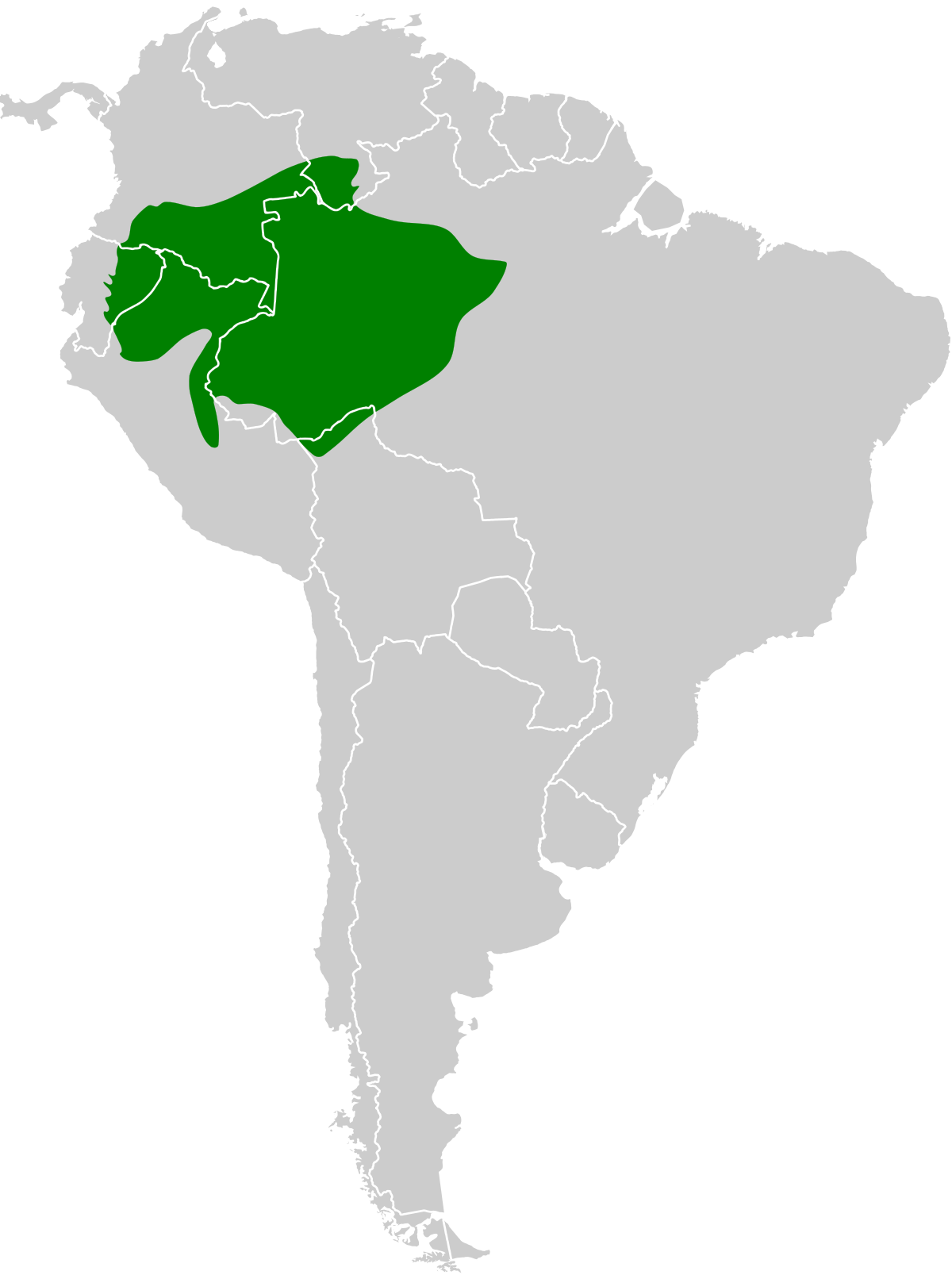
Wikipedia: Reddish-winged bare-eye Source: OTHER
1200px-Phlegopsis_erythroptera_map.svg.png
![]() The reddish-winged bare-eye (Phlegopsis erythroptera) is a species of insectivorous passerine bird in the antbird family, Thamnophilidae.
It is found in Bolivia, Brazil, Colombia, Ecuador, Peru, and Venezuela.
Its natural habitat is subtropical or tropical moist lowland forests.
[more]
The reddish-winged bare-eye (Phlegopsis erythroptera) is a species of insectivorous passerine bird in the antbird family, Thamnophilidae.
It is found in Bolivia, Brazil, Colombia, Ecuador, Peru, and Venezuela.
Its natural habitat is subtropical or tropical moist lowland forests.
[more]
Wing-banded antbird (Myrmornis torquata)
Profile Wikipedia eBird Xeno-Canto

Wikipedia: Wing-banded antbird Source: OTHER
Myrmornis_torquata_-_Wing-banded_Antbird_%28male%29%29%2C_Carajas_National_Forest%2C_Par%C3%A1%2C_Brazil.jpg
![]() The wing-banded antbird (Myrmornis torquata) is a species of passerine bird in the antbird family, Thamnophilidae. It is placed in the monotypic genus Myrmornis.[2]
It is found in Brazil, Colombia, Ecuador, French Guiana, Guyana, Nicaragua, Panama, Peru, Suriname, and Venezuela. Its natural habitat is subtropical or tropical moist lowland forests.[1]
[more]
The wing-banded antbird (Myrmornis torquata) is a species of passerine bird in the antbird family, Thamnophilidae. It is placed in the monotypic genus Myrmornis.[2]
It is found in Brazil, Colombia, Ecuador, French Guiana, Guyana, Nicaragua, Panama, Peru, Suriname, and Venezuela. Its natural habitat is subtropical or tropical moist lowland forests.[1]
[more]
Fulvous antshrike (Frederickena fulva)
Profile Wikipedia eBird Xeno-Canto

Wikipedia: Fulvous antshrike Source: OTHER
1200px-Frederickena_fulva_map.svg.png
![]() The fulvous antshrike (Frederickena fulva) is a monotypic species of antbird in the family Thamnophilidae.[1] Formerly considered to be a subspecies of the undulated antshrike, it was determined to be a distinct species based on vocal differences.[2][3] The species occurs from the western Amazon in eastern Ecuador, south-eastern Colombia, north-eastern Peru, and possibly extreme western Brazil. Only the female is overall fulvous with dark barring; the male is black with whitish barring.
[more]
The fulvous antshrike (Frederickena fulva) is a monotypic species of antbird in the family Thamnophilidae.[1] Formerly considered to be a subspecies of the undulated antshrike, it was determined to be a distinct species based on vocal differences.[2][3] The species occurs from the western Amazon in eastern Ecuador, south-eastern Colombia, north-eastern Peru, and possibly extreme western Brazil. Only the female is overall fulvous with dark barring; the male is black with whitish barring.
[more]
White-plumed antbird (Pithys albifrons)
Profile Wikipedia eBird Xeno-Canto

Wikipedia: White-plumed antbird Source: OTHER
1200px-Pithys_albifrons_-NBII_Image_Gallery-a00203.jpg
![]() The white-plumed antbird (Pithys albifrons) is a small species of insectivorous bird found in the understories of rainforests.[2] It is smaller than most species of its family (Thamnophilidae), weighing 26 grams on average. The family Thamnophilidae is known commonly as the antbirds, as they use the presence of ants (army ants in particular) to locate food. This species is largely solitary except during the breeding season, and different individuals will follow individual ant swarms.
[more]
The white-plumed antbird (Pithys albifrons) is a small species of insectivorous bird found in the understories of rainforests.[2] It is smaller than most species of its family (Thamnophilidae), weighing 26 grams on average. The family Thamnophilidae is known commonly as the antbirds, as they use the presence of ants (army ants in particular) to locate food. This species is largely solitary except during the breeding season, and different individuals will follow individual ant swarms.
[more]
Great antshrike (Taraba major)
Profile Wikipedia eBird Xeno-Canto

Wikipedia: Great antshrike Source: OTHER
1200px-Great_Antshrike_-_Male.jpg
![]() The great antshrike (Taraba major) is a passerine bird in the antbird family, Thamnophilidae. It is the only member of the genus Taraba. It is a resident breeder in the tropical New World in southern Mexico, Central America, Trinidad and South America down to northern Argentina and southeastern Brazil.
[more]
The great antshrike (Taraba major) is a passerine bird in the antbird family, Thamnophilidae. It is the only member of the genus Taraba. It is a resident breeder in the tropical New World in southern Mexico, Central America, Trinidad and South America down to northern Argentina and southeastern Brazil.
[more]
Pearly antshrike (Megastictus margaritatus)
Profile Wikipedia eBird Xeno-Canto

Wikipedia: Pearly antshrike Source: OTHER
1200px-Megastictus_margaritatus_-_Pearly_Antshrike_%28male%29%2C_Novo_Air%C3%A3o%2C_Amazonas%2C_Brazil.jpg
![]() The pearly antshrike (Megastictus margaritatus) is a species of bird in the family Thamnophilidae. It is monotypic within the genus Megastictus.[2] It is found in Brazil, Colombia, Ecuador, Peru, and Venezuela, where its natural habitat is subtropical or tropical moist lowland forests.[1]
[more]
The pearly antshrike (Megastictus margaritatus) is a species of bird in the family Thamnophilidae. It is monotypic within the genus Megastictus.[2] It is found in Brazil, Colombia, Ecuador, Peru, and Venezuela, where its natural habitat is subtropical or tropical moist lowland forests.[1]
[more]
Spot-winged antshrike (Pygiptila stellaris)
Profile Wikipedia eBird Xeno-Canto

Wikipedia: Spot-winged antshrike Source: OTHER
Spot-winged_Antshrike_-_Avium_Species_Novae.jpg
![]() The spot-winged antshrike (Pygiptila stellaris) is a species of bird in the family Thamnophilidae. It is monotypic within the genus Pygiptila.[2] It is found in Bolivia, Brazil, Colombia, Ecuador, French Guiana, Peru, Suriname, and Venezuela, where its natural habitat is subtropical or tropical moist lowland forests.[1]
[more]
The spot-winged antshrike (Pygiptila stellaris) is a species of bird in the family Thamnophilidae. It is monotypic within the genus Pygiptila.[2] It is found in Bolivia, Brazil, Colombia, Ecuador, French Guiana, Peru, Suriname, and Venezuela, where its natural habitat is subtropical or tropical moist lowland forests.[1]
[more]
Russet antshrike (Thamnistes anabatinus)
Profile Wikipedia eBird Xeno-Canto
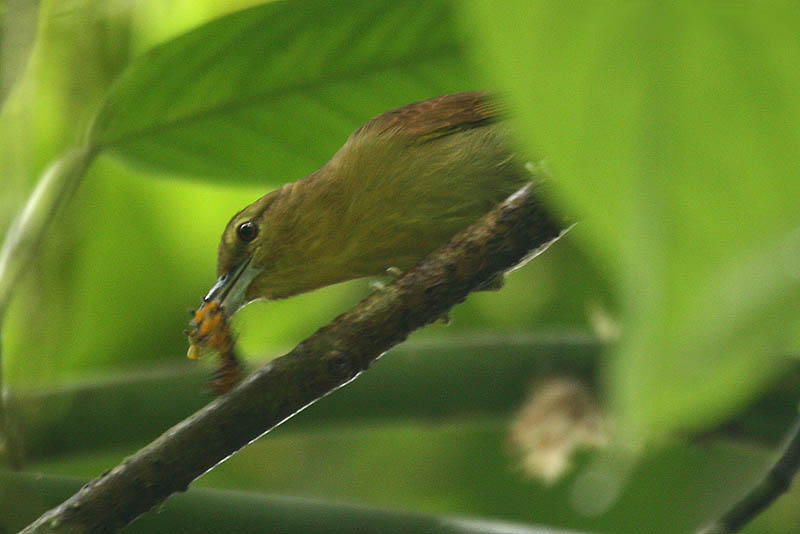
Wikipedia: Russet antshrike Source: OTHER
Thamnistes_anabatinus_-NW_Ecuador-6.jpg
![]() The russet antshrike (Thamnistes anabatinus) is a passerine bird in the antbird family.
[more]
The russet antshrike (Thamnistes anabatinus) is a passerine bird in the antbird family.
[more]
Rufescent antshrike (Thamnistes rufescens)
Profile Wikipedia eBird Xeno-Canto

Wikipedia: Rufescent antshrike Source: OTHER
1200px-Thamnistes_rufescens_map.svg.png
![]() The rufescent antshrike (Thamnistes rufescens) is a passerine bird in the antbird family.
[more]
The rufescent antshrike (Thamnistes rufescens) is a passerine bird in the antbird family.
[more]
Dusky-throated antshrike (Thamnomanes ardesiacus)
Profile Wikipedia eBird Xeno-Canto

Wikipedia: Dusky-throated antshrike Source: OTHER
Thamnomanes_ardesiacus_-_Dusky-throated_antshrike_%28male%29.jpg
![]() The dusky-throated antshrike (Thamnomanes ardesiacus) is a species of bird in the family Thamnophilidae. It is found in Bolivia, Brazil, Colombia, Ecuador, French Guiana, Guyana, Peru, Suriname, and Venezuela. Its natural habitat is subtropical or tropical moist lowland forests.
[more]
The dusky-throated antshrike (Thamnomanes ardesiacus) is a species of bird in the family Thamnophilidae. It is found in Bolivia, Brazil, Colombia, Ecuador, French Guiana, Guyana, Peru, Suriname, and Venezuela. Its natural habitat is subtropical or tropical moist lowland forests.
[more]
Cinereous antshrike (Thamnomanes caesius)
Profile Wikipedia eBird Xeno-Canto

Wikipedia: Cinereous antshrike Source: OTHER
1200px-Thamnomanes_caesius_-_Cinereous_antshrike.jpg
![]() The cinereous antshrike (Thamnomanes caesius) is an insectivorous bird in the antbird family Thamnophilidae. The term cinereous describes its colouration. It is found in Bolivia, Brazil, Colombia, Ecuador, French Guiana, Guyana, Peru, Suriname, and Venezuela. Its natural habitat is subtropical or tropical moist lowland forests.
[more]
The cinereous antshrike (Thamnomanes caesius) is an insectivorous bird in the antbird family Thamnophilidae. The term cinereous describes its colouration. It is found in Bolivia, Brazil, Colombia, Ecuador, French Guiana, Guyana, Peru, Suriname, and Venezuela. Its natural habitat is subtropical or tropical moist lowland forests.
[more]
Spot-crowned antvireo (Dysithamnus puncticeps)
Profile Wikipedia eBird Xeno-Canto

Wikipedia: Spot-crowned antvireo Source: OTHER
1200px-Dysithamnus_puncticeps_map.svg.png
![]() The spot-crowned antvireo (Dysithamnus puncticeps) is a species of bird in the family Thamnophilidae. It is found in Colombia, Costa Rica, Ecuador, and Panama. Its natural habitat is subtropical or tropical moist lowland forests.
[more]
The spot-crowned antvireo (Dysithamnus puncticeps) is a species of bird in the family Thamnophilidae. It is found in Colombia, Costa Rica, Ecuador, and Panama. Its natural habitat is subtropical or tropical moist lowland forests.
[more]
Plain antvireo (Dysithamnus mentalis)
Profile Wikipedia eBird Xeno-Canto

Wikipedia: Plain antvireo Source: OTHER
1200px-Dysithamnus_mentalis_-_Plain_Antvireo_%28male%29.JPG
![]() The plain antvireo (Dysithamnus mentalis) is a passerine bird species in the antbird family (Thamnophilidae). It is a resident breeder in tropical Central and South America.
[more]
The plain antvireo (Dysithamnus mentalis) is a passerine bird species in the antbird family (Thamnophilidae). It is a resident breeder in tropical Central and South America.
[more]
White-streaked antvireo (Dysithamnus leucostictus)
Profile Wikipedia eBird Xeno-Canto

Wikipedia: White-streaked antvireo Source: OTHER
1200px-White-streaked_Antvireo_-_Dysithamnus_leucostictus.jpg
![]() The white-streaked antvireo or white-spotted antvireo (Dysithamnus leucostictus) is a species of bird in the family Thamnophilidae. It is found in Colombia, Ecuador, Peru, and Venezuela. Its natural habitat is subtropical or tropical moist montane forests.
[more]
The white-streaked antvireo or white-spotted antvireo (Dysithamnus leucostictus) is a species of bird in the family Thamnophilidae. It is found in Colombia, Ecuador, Peru, and Venezuela. Its natural habitat is subtropical or tropical moist montane forests.
[more]
Bicolored antvireo (Dysithamnus occidentalis)
Profile Wikipedia eBird Xeno-Canto

Wikipedia: Bicolored antvireo Source: OTHER
1200px-Dysithamnus_occidentalis_-_Bicolored_Antvireo.jpg
![]() The bicolored antvireo (Dysithamnus occidentalis) is an insectivorous bird in the antbird family Thamnophilidae. It is found on the west slope of the Andes from southwest Colombia to northwest Ecuador. Its natural habitat is subtropical or tropical moist montane forests. It is threatened by habitat loss.
[more]
The bicolored antvireo (Dysithamnus occidentalis) is an insectivorous bird in the antbird family Thamnophilidae. It is found on the west slope of the Andes from southwest Colombia to northwest Ecuador. Its natural habitat is subtropical or tropical moist montane forests. It is threatened by habitat loss.
[more]
Black-faced antbird (Myrmoborus myotherinus)
Profile Wikipedia eBird Xeno-Canto
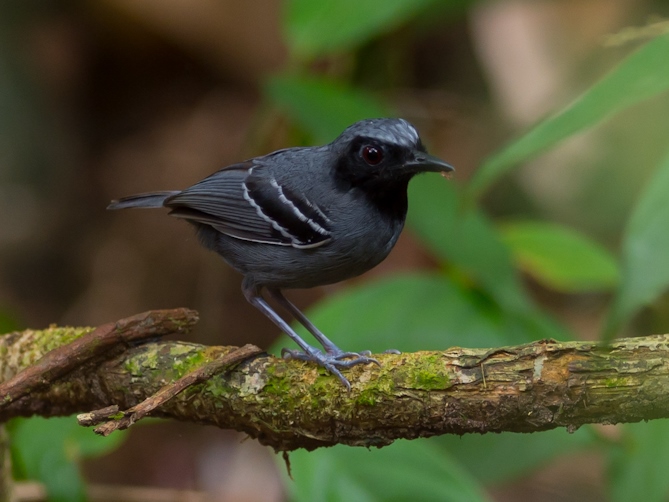
Wikipedia: Black-faced antbird Source: OTHER
Myrmoborus_myotherinus_ardesiacus_-_Black-faced_Antbird_%28male%29.jpg
![]() The black-faced antbird (Myrmoborus myotherinus) is a species of bird, about 12–13 cm (5 inches) long, in the antbird family Thamnophilidae. It is endemic to a wide range across the Amazon basin. It feeds on insects and spiders and sometimes follows army ants to catch the insects disturbed by their march.
[more]
The black-faced antbird (Myrmoborus myotherinus) is a species of bird, about 12–13 cm (5 inches) long, in the antbird family Thamnophilidae. It is endemic to a wide range across the Amazon basin. It feeds on insects and spiders and sometimes follows army ants to catch the insects disturbed by their march.
[more]
White-browed antbird (Myrmoborus leucophrys)
Profile Wikipedia eBird Xeno-Canto

Wikipedia: White-browed antbird Source: OTHER
1200px-Myrmoborus_leucophrys_leucophrys_Wolf.jpg
![]() The white-browed antbird (Myrmoborus leucophrys) is a species of perching bird in the family Thamnophilidae. It is found in Bolivia, Brazil, Colombia, Ecuador, French Guiana, Guyana, Peru, Suriname, and Venezuela. Its natural habitats are subtropical or tropical moist lowland forests and subtropical or tropical moist montane forests.
[more]
The white-browed antbird (Myrmoborus leucophrys) is a species of perching bird in the family Thamnophilidae. It is found in Bolivia, Brazil, Colombia, Ecuador, French Guiana, Guyana, Peru, Suriname, and Venezuela. Its natural habitats are subtropical or tropical moist lowland forests and subtropical or tropical moist montane forests.
[more]
Ash-breasted antbird (Myrmoborus lugubris)
Profile Wikipedia eBird Xeno-Canto

Wikipedia: Ash-breasted antbird Source: OTHER
1200px-Myrmoborus_lugubris_stictopterus_-_Ash-breasted_Antbird_%28female%29%3B_Anavilhanas_islands%2C_Novo_Air%C3%A3o%3B_Amazonas%2C_Brazil.jpg
![]() The ash-breasted antbird (Myrmoborus lugubris) is an insectivorous bird in the antbird family, Thamnophilidae. It is found in Brazil, Colombia, Ecuador, and Peru. Its natural habitat is subtropical or tropical moist lowland forests.
[more]
The ash-breasted antbird (Myrmoborus lugubris) is an insectivorous bird in the antbird family, Thamnophilidae. It is found in Brazil, Colombia, Ecuador, and Peru. Its natural habitat is subtropical or tropical moist lowland forests.
[more]
Ocellated antbird (Phaenostictus mcleannani)
Profile Wikipedia eBird Xeno-Canto

Wikipedia: Ocellated antbird Source: OTHER
1200px-Phaenostictus-mcleannani-001.jpg
![]() The ocellated antbird (Phaenostictus mcleannani) is a species of antbird in the family Thamnophilidae. It is monotypic within the genus Phaenostictus and is found in southern Central America and the northwestern part of South America. Its natural habitat is the understory of tropical moist lowland forest, foothill forest, and tall secondary growth woodlands.
[more]
The ocellated antbird (Phaenostictus mcleannani) is a species of antbird in the family Thamnophilidae. It is monotypic within the genus Phaenostictus and is found in southern Central America and the northwestern part of South America. Its natural habitat is the understory of tropical moist lowland forest, foothill forest, and tall secondary growth woodlands.
[more]
Hairy-crested antbird (Rhegmatorhina melanosticta)
Profile Wikipedia eBird Xeno-Canto

Wikipedia: Hairy-crested antbird Source: OTHER
1200px-Rhegmatorhina_melanosticta_-NBII_Image_Gallery-a00183.jpg
![]() The hairy-crested antbird (Rhegmatorhina melanosticta) is a species of bird in the family Thamnophilidae. It is found in Bolivia, Brazil, Colombia, Ecuador, and Peru. Its natural habitat is subtropical or tropical moist lowland forests.
[more]
The hairy-crested antbird (Rhegmatorhina melanosticta) is a species of bird in the family Thamnophilidae. It is found in Bolivia, Brazil, Colombia, Ecuador, and Peru. Its natural habitat is subtropical or tropical moist lowland forests.
[more]
Bicolored antbird (Gymnopithys bicolor)

Wikipedia: Bicolored antbird Source: OTHER
1200px-Gymnopithys-leucaspis-001_edit2.jpg
![]() The bicolored antbird (Gymnopithys bicolor) is a species of bird in the family Thamnophilidae. It is found in Honduras south to Panama, western Colombia and Ecuador. Its natural habitat is subtropical or tropical moist lowland forest.
[more]
The bicolored antbird (Gymnopithys bicolor) is a species of bird in the family Thamnophilidae. It is found in Honduras south to Panama, western Colombia and Ecuador. Its natural habitat is subtropical or tropical moist lowland forest.
[more]
Bicolored antbird (alternate) (Gymnopithys leucaspis)
Dot-winged antwren (Microrhopias quixensis)
Profile Wikipedia eBird Xeno-Canto
Wikipedia: Dot-winged antwren Source: OTHER
Microrhopias_quixensis_-_Dot-winged_Antwren_%28male%29.JPG
![]() The dot-winged antwren (Microrhopias quixensis) is a passerine bird in the antbird family. In the past it was sometimes known as the velvety antwren, and some of its more distinctive subspecies have their own infrequently used English names. It is a resident in tropical Central and South America from southeastern Mexico south to western Ecuador, northern Bolivia, central Brazil and the Guianas. It is the only member of the genus Microrhopias.
[more]
The dot-winged antwren (Microrhopias quixensis) is a passerine bird in the antbird family. In the past it was sometimes known as the velvety antwren, and some of its more distinctive subspecies have their own infrequently used English names. It is a resident in tropical Central and South America from southeastern Mexico south to western Ecuador, northern Bolivia, central Brazil and the Guianas. It is the only member of the genus Microrhopias.
[more]
Black bushbird (Neoctantes niger)
Profile Wikipedia eBird Xeno-Canto

Wikipedia: Black bushbird Source: OTHER
1200px-Neoctantes_niger_-_Black_Bushbird_-_female_%28cropped%29.jpg
![]() The black bushbird (Neoctantes niger) is a species of insectivorous bird in the antbird family Thamnophilidae. It is monotypic within the genus Neoctantes.[2] It is found in Brazil, Colombia, Ecuador, and Peru. Its natural habitat is subtropical or tropical moist lowland forests.[1]
[more]
The black bushbird (Neoctantes niger) is a species of insectivorous bird in the antbird family Thamnophilidae. It is monotypic within the genus Neoctantes.[2] It is found in Brazil, Colombia, Ecuador, and Peru. Its natural habitat is subtropical or tropical moist lowland forests.[1]
[more]
Banded antbird (Dichrozona cincta)
Profile Wikipedia eBird Xeno-Canto

Wikipedia: Banded antbird Source: OTHER
1200px-Dichrozona_cincta_map.svg.png
![]() The banded antbird (Dichrozona cincta) – sometimes called banded antwren despite not being close to the true antwrens – is a species of bird in the family Thamnophilidae. It is the only member of the genus Dichrozona. Its natural habitat is subtropical or tropical moist lowland forests. Hence why it is predominately located in Bolivia, Brazil, Colombia, Ecuador, Peru, and
[more]
The banded antbird (Dichrozona cincta) – sometimes called banded antwren despite not being close to the true antwrens – is a species of bird in the family Thamnophilidae. It is the only member of the genus Dichrozona. Its natural habitat is subtropical or tropical moist lowland forests. Hence why it is predominately located in Bolivia, Brazil, Colombia, Ecuador, Peru, and
[more]
Spotted antbird (Hylophylax naevioides)
Profile Wikipedia eBird Xeno-Canto

Wikipedia: Spotted antbird Source: OTHER
1200px-Spotted_Antbird.jpg
![]() The spotted antbird (Hylophylax naevioides) is a species of bird in the family Thamnophilidae.
In southern Central America, it is found in Honduras, Nicaragua, Costa Rica and Panama; also Colombia and Ecuador of northwestern South America.
Its natural habitat is subtropical or tropical moist lowland forests.
[more]
The spotted antbird (Hylophylax naevioides) is a species of bird in the family Thamnophilidae.
In southern Central America, it is found in Honduras, Nicaragua, Costa Rica and Panama; also Colombia and Ecuador of northwestern South America.
Its natural habitat is subtropical or tropical moist lowland forests.
[more]
Spot-backed antbird (Hylophylax naevius)

Wikipedia: Spot-backed antbird Source: OTHER
1200px-Hylophylax_naevia.jpg
![]() The spot-backed antbird (Hylophylax naevius) is a species of bird in the family Thamnophilidae, the antbirds. It is found in Bolivia, Brazil, Colombia, Ecuador, French Guiana, Guyana, Peru, Suriname, and Venezuela. Its natural habitats are subtropical or tropical moist lowland forests and subtropical or tropical swamps.
[more]
The spot-backed antbird (Hylophylax naevius) is a species of bird in the family Thamnophilidae, the antbirds. It is found in Bolivia, Brazil, Colombia, Ecuador, French Guiana, Guyana, Peru, Suriname, and Venezuela. Its natural habitats are subtropical or tropical moist lowland forests and subtropical or tropical swamps.
[more]
Dot-backed antbird (Hylophylax punctulatus)
Wikipedia: Dot-backed antbird Source: OTHER
Hylophylax_punctulatus_-_Dot-backed_Antbird_%28male%29.JPG
![]() The dot-backed antbird (Hylophylax punctulatus) is a species of bird in the family Thamnophilidae. It is found in Bolivia, Brazil, Colombia, Ecuador, French Guiana, Peru, and Venezuela. Its natural habitat is subtropical or tropical swamps.
[more]
The dot-backed antbird (Hylophylax punctulatus) is a species of bird in the family Thamnophilidae. It is found in Bolivia, Brazil, Colombia, Ecuador, French Guiana, Peru, and Venezuela. Its natural habitat is subtropical or tropical swamps.
[more]
Black-and-white antbird (Myrmochanes hemileucus)
Profile Wikipedia eBird Xeno-Canto

Wikipedia: Black-and-white antbird Source: OTHER
1200px-Myrmochanes_hemileucus_-_Black-and-white_antbird_%28male%29%3B_Marchantaria_island%2C_Iranduba%2C_Amazonas%2C_Brazil.jpg
![]() The black-and-white antbird (Myrmochanes hemileucus) is a species of bird in the family Thamnophilidae. It is monotypic within the genus Myrmochanes.[2] It is found in Bolivia, Brazil, Colombia, Ecuador, and Peru. Its natural habitats are subtropical or tropical moist lowland forests and subtropical or tropical moist shrubland.[1]
[more]
The black-and-white antbird (Myrmochanes hemileucus) is a species of bird in the family Thamnophilidae. It is monotypic within the genus Myrmochanes.[2] It is found in Bolivia, Brazil, Colombia, Ecuador, and Peru. Its natural habitats are subtropical or tropical moist lowland forests and subtropical or tropical moist shrubland.[1]
[more]
Black-chinned antbird (Hypocnemoides melanopogon)
Profile Wikipedia eBird Xeno-Canto

Wikipedia: Black-chinned antbird Source: OTHER
1200px-Hypocnemoides_melanopogon_-_Black-chinned_Antbird_%28female%29%2C_Anavilhanas_islands%2C_Novo_Air%C3%A3o%2C_Amanazonas%2C_Brazil.jpg
![]() The black-chinned antbird (Hypocnemoides melanopogon) is a species of bird in the family Thamnophilidae. It is found in Brazil, Colombia, Ecuador, French Guiana, Guyana, Peru, Suriname, and Venezuela. Its natural habitat is subtropical or tropical swamps.
[more]
The black-chinned antbird (Hypocnemoides melanopogon) is a species of bird in the family Thamnophilidae. It is found in Brazil, Colombia, Ecuador, French Guiana, Guyana, Peru, Suriname, and Venezuela. Its natural habitat is subtropical or tropical swamps.
[more]
Silvered antbird (Sclateria naevia)
Profile Wikipedia eBird Xeno-Canto

Wikipedia: Silvered antbird Source: OTHER
1200px-Sclateria_naevia_Castelnau.jpg
![]() The silvered antbird (Sclateria naevia) is a passerine bird in the antbird family, the only member of the genus Sclateria. It is a resident breeder in tropical South America from Colombia and Trinidad south to Peru, Bolivia and central Brazil.
[more]
The silvered antbird (Sclateria naevia) is a passerine bird in the antbird family, the only member of the genus Sclateria. It is a resident breeder in tropical South America from Colombia and Trinidad south to Peru, Bolivia and central Brazil.
[more]
Fasciated antshrike / Zebra-Ameisenwürger (Cymbilaimus lineatus)
Profile Wikipedia eBird Xeno-Canto

Wikipedia: Fasciated antshrike Source: OTHER
1200px-Fasciated_Antshrike_male.jpg
![]() The fasciated antshrike (Cymbilaimus lineatus) is a species of bird in the antbird family Thamnophilidae. The species is found in Central and Southern America.
[more]
The fasciated antshrike (Cymbilaimus lineatus) is a species of bird in the antbird family Thamnophilidae. The species is found in Central and Southern America.
[more]
Checker-throated antwren (Epinecrophylla fulviventris)

Wikipedia: Checker-throated antwren Source: OTHER
1200px-Epinecrophylla_fulviventris.jpg
![]() The checker-throated stipplethroat (Epinecrophylla fulviventris), also called fulvous-bellied antwren or checker-throated antwren, is a small passerine bird in the antbird family. It has traditionally been placed in the genus Myrmotherula, but is, together with other members of the so-called "stipple-throated group", now placed in the new genus Epinecrophylla. This is supported by molecular work, behavior, voice and morphology. Now treated as monotypic, it includes the former subspecies E. f. costaricensis and E. f. salmoni.
[more]
The checker-throated stipplethroat (Epinecrophylla fulviventris), also called fulvous-bellied antwren or checker-throated antwren, is a small passerine bird in the antbird family. It has traditionally been placed in the genus Myrmotherula, but is, together with other members of the so-called "stipple-throated group", now placed in the new genus Epinecrophylla. This is supported by molecular work, behavior, voice and morphology. Now treated as monotypic, it includes the former subspecies E. f. costaricensis and E. f. salmoni.
[more]
Ornate stipplethroat (Epinecrophylla ornata)

Wikipedia: Ornate stipplethroat Source: OTHER
1200px-Epinecrophylla_ornata.jpg
![]() The ornate stipplethroat or ornate antwren (Epinecrophylla ornata) is a species of bird in the family Thamnophilidae. It is found in Bolivia, Brazil, Colombia, Ecuador, and Peru. Its natural habitats are subtropical or tropical moist lowland forests and subtropical or tropical swamps.
[more]
The ornate stipplethroat or ornate antwren (Epinecrophylla ornata) is a species of bird in the family Thamnophilidae. It is found in Bolivia, Brazil, Colombia, Ecuador, and Peru. Its natural habitats are subtropical or tropical moist lowland forests and subtropical or tropical swamps.
[more]
Rufous-tailed stipplethroat (Epinecrophylla erythrura)
Profile Wikipedia eBird Xeno-Canto

Wikipedia: Rufous-tailed stipplethroat Source: OTHER
MyrmotherulaErythruraSmit.jpg
![]() The rufous-tailed stipplethroat or rufous-tailed antwren (Epinecrophylla erythrura) is a species of insectivorous bird in the antbird family Thamnophilidae. It was formerly placed in the genus Myrmotherula. It is found in Brazil, Colombia, Ecuador, and Peru. Its natural habitat is subtropical or tropical moist lowland forests.
[more]
The rufous-tailed stipplethroat or rufous-tailed antwren (Epinecrophylla erythrura) is a species of insectivorous bird in the antbird family Thamnophilidae. It was formerly placed in the genus Myrmotherula. It is found in Brazil, Colombia, Ecuador, and Peru. Its natural habitat is subtropical or tropical moist lowland forests.
[more]
Rufous-backed stipplethroat (Epinecrophylla haematonota)
Profile Wikipedia eBird Xeno-Canto

Wikipedia: Rufous-backed stipplethroat Source: OTHER
1200px-Epinecrophylla_haematonota_map.svg.png
![]() The rufous-backed stipplethroat (Epinecrophylla haematonota), also called the rufous-backed antwren or the stipple-throated antwren, is a species of bird in the family Thamnophilidae. It is found in southeastern Colombia and southern Venezuela to eastern Ecuador, northern and eastern Peru and western Brazil in its natural habitat of subtropical or tropical moist lowland forests.[2]
[more]
The rufous-backed stipplethroat (Epinecrophylla haematonota), also called the rufous-backed antwren or the stipple-throated antwren, is a species of bird in the family Thamnophilidae. It is found in southeastern Colombia and southern Venezuela to eastern Ecuador, northern and eastern Peru and western Brazil in its natural habitat of subtropical or tropical moist lowland forests.[2]
[more]
Foothill stipplethroat (Epinecrophylla spodionota)
Profile Wikipedia eBird Xeno-Canto

Wikipedia: Foothill stipplethroat Source: OTHER
1200px-Epinecrophylla_spodionota_map.svg.png
![]() The foothill stipplethroat or foothill antwren (Epinecrophylla spodionota) is a species of bird in the family Thamnophilidae. It is found in Peru, Ecuador and southwestern Colombia. Its natural habitats are subtropical or tropical moist lowland forests and subtropical or tropical moist montane forests.
[more]
The foothill stipplethroat or foothill antwren (Epinecrophylla spodionota) is a species of bird in the family Thamnophilidae. It is found in Peru, Ecuador and southwestern Colombia. Its natural habitats are subtropical or tropical moist lowland forests and subtropical or tropical moist montane forests.
[more]
Scale-backed antbird (Willisornis poecilinotus)

Wikipedia: Scale-backed antbird Source: OTHER
1200px-Willisornis_poecilonotus_male.jpg
![]() The common scale-backed antbird (Willisornis poecilinotus) is a species of passerine bird in the antbird family, Thamnophilidae. It is found in the Amazon of Bolivia, Brazil, Colombia, Ecuador, French Guiana, Guyana, Peru, Suriname, and Venezuela.
Its natural habitat is tropical moist lowland forests. As with other species of antbirds, it regularly follows swarms of army ants as they flush insects and other arthropods out of the leaf litter.
[more]
The common scale-backed antbird (Willisornis poecilinotus) is a species of passerine bird in the antbird family, Thamnophilidae. It is found in the Amazon of Bolivia, Brazil, Colombia, Ecuador, French Guiana, Guyana, Peru, Suriname, and Venezuela.
Its natural habitat is tropical moist lowland forests. As with other species of antbirds, it regularly follows swarms of army ants as they flush insects and other arthropods out of the leaf litter.
[more]
Plumbeous antbird (Myrmelastes hyperythrus)
Profile Wikipedia eBird Xeno-Canto

Wikipedia: Plumbeous antbird Source: OTHER
1200px-Myrmelastes_hyperythrus_-_Plumbeous_antbird_%28male%29.jpg
![]() The plumbeous antbird (Myrmelastes hyperythrus) is a species of bird in the family Thamnophilidae.
[more]
The plumbeous antbird (Myrmelastes hyperythrus) is a species of bird in the family Thamnophilidae.
[more]
Spot-winged antbird (Myrmelastes leucostigma)

Wikipedia: Spot-winged antbird Source: OTHER
1200px-Schistocichla_leucostigma.jpg
![]() The spot-winged antbird (Myrmelastes leucostigma) is a species of bird in the family Thamnophilidae. It is found in humid forest in the Amazon north of the Amazon River, and in the far western Amazon and adjacent lower east Andean slopes.
[more]
The spot-winged antbird (Myrmelastes leucostigma) is a species of bird in the family Thamnophilidae. It is found in humid forest in the Amazon north of the Amazon River, and in the far western Amazon and adjacent lower east Andean slopes.
[more]
Slate-colored antbird (Myrmelastes schistaceus)

Wikipedia: Slate-colored antbird Source: OTHER
1200px-Myrmelastes_schistaceus_map.svg.png
![]() The slate-colored antbird (Myrmelastes schistaceus) is a species of bird in the family Thamnophilidae. It is found in Brazil, Colombia, Ecuador, and Peru. Its natural habitat is subtropical or tropical moist lowland forest.
[more]
The slate-colored antbird (Myrmelastes schistaceus) is a species of bird in the family Thamnophilidae. It is found in Brazil, Colombia, Ecuador, and Peru. Its natural habitat is subtropical or tropical moist lowland forest.
[more]
Rufous-rumped antwren (alternate) (Euchrepomis callinota)
Ash-winged antwren (Euchrepomis spodioptila)
Profile Wikipedia eBird Xeno-Canto

Wikipedia: Ash-winged antwren Source: OTHER
1200px-Euchrepomis_spodioptila_-_Ash-winged_antwren_%28male%29%3B_Manaus%2C_Amazonas%2C_Brazil.jpg
![]() The ash-winged antwren (Euchrepomis spodioptila) is an insectivorous bird in the antbird family Thamnophilidae. It is found in Brazil, Colombia, Ecuador, French Guiana, Guyana, Peru, Suriname, and Venezuela. Its natural habitat is subtropical or tropical moist lowland forests.
[more]
The ash-winged antwren (Euchrepomis spodioptila) is an insectivorous bird in the antbird family Thamnophilidae. It is found in Brazil, Colombia, Ecuador, French Guiana, Guyana, Peru, Suriname, and Venezuela. Its natural habitat is subtropical or tropical moist lowland forests.
[more]
Chestnut-shouldered antwren (Euchrepomis humeralis)
Profile Wikipedia eBird Xeno-Canto

Wikipedia: Chestnut-shouldered antwren Source: OTHER
1200px-Terenura_humoralis_Keulemans.jpg
![]() The chestnut-shouldered antwren (Euchrepomis humeralis) is an insectorivous bird in the antbird family Thamnophilidae. It is found in far northwestern Bolivia, Peru, Ecuador and western Brazil. Its natural habitat is subtropical or tropical moist lowland forests.
[more]
The chestnut-shouldered antwren (Euchrepomis humeralis) is an insectorivous bird in the antbird family Thamnophilidae. It is found in far northwestern Bolivia, Peru, Ecuador and western Brazil. Its natural habitat is subtropical or tropical moist lowland forests.
[more]
Stub-tailed antbird (Sipia berlepschi)
Profile Wikipedia eBird Xeno-Canto

Wikipedia: Stub-tailed antbird Source: OTHER
1200px-Sipia_berlepschi_-_Stub-tailed_Antbird_-_male_%28cropped%29.jpg
![]() The stub-tailed antbird (Sipia berlepschi) is a species of bird in the family Thamnophilidae. It is found in Colombia and Ecuador. Its natural habitat is subtropical or tropical moist lowland forests.
[more]
The stub-tailed antbird (Sipia berlepschi) is a species of bird in the family Thamnophilidae. It is found in Colombia and Ecuador. Its natural habitat is subtropical or tropical moist lowland forests.
[more]
Esmeraldas antbird (Sipia nigricauda)

Wikipedia: Esmeraldas antbird Source: OTHER
Myrmeciza_nigricauda_%28male%29_-NW_Ecuador-4.jpg
![]() The Esmeraldas antbird (Sipia nigricauda) is a species of bird in the family Thamnophilidae. It is found in Colombia and Ecuador. Its natural habitats are subtropical or tropical moist lowland forests and subtropical or tropical moist montane forests.
[more]
The Esmeraldas antbird (Sipia nigricauda) is a species of bird in the family Thamnophilidae. It is found in Colombia and Ecuador. Its natural habitats are subtropical or tropical moist lowland forests and subtropical or tropical moist montane forests.
[more]
White-shouldered antbird (Akletos melanoceps)

Wikipedia: White-shouldered antbird Source: OTHER
1200px-Akletos_melanoceps_-_White-shouldered_Antbird_%28male%29%3B_River_Moa%2C_Mancio_Lima%2C_Acre%2C_Brazil.jpg
![]() The white-shouldered antbird (Percnostola melanoceps) is a species of bird in the family Thamnophilidae. It is found in Brazil, Colombia, Ecuador, and Peru. Its natural habitat is subtropical or tropical swamps.
[more]
The white-shouldered antbird (Percnostola melanoceps) is a species of bird in the family Thamnophilidae. It is found in Brazil, Colombia, Ecuador, and Peru. Its natural habitat is subtropical or tropical swamps.
[more]
Gray-headed antbird (Ampelornis griseiceps)

Wikipedia: Gray-headed antbird Source: OTHER
1200px-Ampelornis_griseiceps_map.svg.png
![]() The grey-headed antbird (Ampelornis griseiceps) is a species of bird in the family Thamnophilidae. It is found in Ecuador and Peru.
[more]
The grey-headed antbird (Ampelornis griseiceps) is a species of bird in the family Thamnophilidae. It is found in Ecuador and Peru.
[more]
Zeledon's antbird (alternate) (Hafferia zeledoni)
Sooty antbird (Hafferia fortis)
Profile Wikipedia eBird Xeno-Canto

Wikipedia: Sooty antbird Source: OTHER
1200px-Hafferia_fortis_-_Sooty_Antbird_-_male_%28cropped%29.jpg
![]() The sooty antbird (Percnostola fortis) is a species of bird in the family Thamnophilidae. It is found in Bolivia, Brazil, Colombia, Ecuador, and Peru. Its natural habitat is subtropical or tropical moist lowland forests.[2]
[more]
The sooty antbird (Percnostola fortis) is a species of bird in the family Thamnophilidae. It is found in Bolivia, Brazil, Colombia, Ecuador, and Peru. Its natural habitat is subtropical or tropical moist lowland forests.[2]
[more]
Black-throated antbird (Myrmophylax atrothorax)
Profile Wikipedia eBird Xeno-Canto

Wikipedia: Black-throated antbird Source: OTHER
1200px-Myrmophilax_atrothorax_-_Black-throated_Antbird_%28male%29%3B_Manaus%2C_Amazonas%2C_Brazil.jpg
![]() The black-throated antbird (Myrmophylax atrothorax) is a species of passerine bird in the family Thamnophilidae. It is the only species in the genus Myrmophylax. It is found in Bolivia, Brazil, Colombia, Ecuador, French Guiana, Guyana, Peru, Suriname, and Venezuela.[1] Its natural habitats are subtropical or tropical moist lowland forests and heavily degraded former forest.[2]
[more]
The black-throated antbird (Myrmophylax atrothorax) is a species of passerine bird in the family Thamnophilidae. It is the only species in the genus Myrmophylax. It is found in Bolivia, Brazil, Colombia, Ecuador, French Guiana, Guyana, Peru, Suriname, and Venezuela.[1] Its natural habitats are subtropical or tropical moist lowland forests and heavily degraded former forest.[2]
[more]
Lunulated antbird (Oneillornis lunulatus)

Wikipedia: Lunulated antbird Source: OTHER
1200px-PithysLunulataSmit.jpg
![]() The lunulated antbird (Oneillornis lunulatus) is a species of insectivorous bird in the family Thamnophilidae. It is found in Ecuador and Peru. Its natural habitat is subtropical or tropical moist lowland forests.
[more]
The lunulated antbird (Oneillornis lunulatus) is a species of insectivorous bird in the family Thamnophilidae. It is found in Ecuador and Peru. Its natural habitat is subtropical or tropical moist lowland forests.
[more]
Chestnut-backed antbird (Poliocrania exsul)

Wikipedia: Chestnut-backed antbird Source: OTHER
1200px-Chestnut-backed_Antbird%2C_El_Paujil%2C_Cololmbia_%285746230497%29.jpg
![]() The chestnut-backed antbird (Poliocrania exsul) is a passerine bird in the antbird family. It is found in humid forests in Central and South America (Chocó-Magdalena), ranging from eastern Nicaragua to western Ecuador. It mainly occurs in lowlands up to an altitude of 900 metres (3,000 ft) m, but locally it occurs higher.
[more]
The chestnut-backed antbird (Poliocrania exsul) is a passerine bird in the antbird family. It is found in humid forests in Central and South America (Chocó-Magdalena), ranging from eastern Nicaragua to western Ecuador. It mainly occurs in lowlands up to an altitude of 900 metres (3,000 ft) m, but locally it occurs higher.
[more]
Wire-tailed manakin / Fadenpipra (Pipra filicauda)
Profile Wikipedia eBird Xeno-Canto

Wikipedia: Wire-tailed manakin Source: OTHER
Pipra_filicauda_-_Wire-tailed_Manakin.jpg
![]() The wire-tailed manakin (Pipra filicauda) is a species of bird in the family Pipridae. It forms a superspecies with both the Band-tailed Manakin (Pipra fasciicauda) and the Crimson-hooded Manakin (Pipra aureola).[2]
It is found upriver in the western Amazon Basin and the neighboring countries of northern Peru, eastern Ecuador and Colombia, and southern and western portions of Venezuela. In Venezuela it occurs upriver in the Orinoco River basin, but not the final 1300 km; its range in Venezuela continues around the Andes cordillera to the northwestern coast. In northwest Brazil, the species ranges from Roraima and Amazonas west to Venezuela and Colombia, and southwest from Rondônia and Acre to Peru and Ecuador.
[more]
The wire-tailed manakin (Pipra filicauda) is a species of bird in the family Pipridae. It forms a superspecies with both the Band-tailed Manakin (Pipra fasciicauda) and the Crimson-hooded Manakin (Pipra aureola).[2]
It is found upriver in the western Amazon Basin and the neighboring countries of northern Peru, eastern Ecuador and Colombia, and southern and western portions of Venezuela. In Venezuela it occurs upriver in the Orinoco River basin, but not the final 1300 km; its range in Venezuela continues around the Andes cordillera to the northwestern coast. In northwest Brazil, the species ranges from Roraima and Amazonas west to Venezuela and Colombia, and southwest from Rondônia and Acre to Peru and Ecuador.
[more]
Club-winged manakin (Machaeropterus deliciosus)
Profile Wikipedia eBird Xeno-Canto

Wikipedia: Club-winged manakin Source: OTHER
Machaeropterus_deliciosus_-NW_Ecuador-6.jpg
![]() The club-winged manakin (Machaeropterus deliciosus) is a small passerine bird which is a resident breeding species in the cloud forest on the western slopes of the Andes Mountains of Colombia and northwestern Ecuador. The manakins are a family (Pipridae) of small bird species of subtropical and tropical Central and South America.
[more]
The club-winged manakin (Machaeropterus deliciosus) is a small passerine bird which is a resident breeding species in the cloud forest on the western slopes of the Andes Mountains of Colombia and northwestern Ecuador. The manakins are a family (Pipridae) of small bird species of subtropical and tropical Central and South America.
[more]
Striolated manakin (Machaeropterus striolatus)

Wikipedia: Striolated manakin Source: OTHER
1200px-Machaeropterus_striolatus_-_Western_Striped_Manakin_%28male%29%3B_Serra_do_Divisor_National_Park%2C_Acre%2C_Brazil.jpg
![]() The striolated manakin or western striped manakin (Machaeropterus striolatus) is a small South American species of passerine bird in the family Pipridae. It is found in west and north west Amazonia. The striolated manakin was formerly considered conspecific with the kinglet manakin (Machaeropterus regulus) with the common name "striped manakin". Males have a bright red crown, which the females lack.
[more]
The striolated manakin or western striped manakin (Machaeropterus striolatus) is a small South American species of passerine bird in the family Pipridae. It is found in west and north west Amazonia. The striolated manakin was formerly considered conspecific with the kinglet manakin (Machaeropterus regulus) with the common name "striped manakin". Males have a bright red crown, which the females lack.
[more]
White-winged piprites (Piprites chloris)
Northern schiffornis (Schiffornis veraepacis)
Profile Wikipedia eBird Xeno-Canto

Wikipedia: Northern schiffornis Source: OTHER
1200px-Schiffornis_veraepacis_%2815150857585%29.jpg
![]() The northern schiffornis (Schiffornis veraepacis), is a species of Neotropical bird.
[more]
The northern schiffornis (Schiffornis veraepacis), is a species of Neotropical bird.
[more]
Thrush-like schiffornis (Schiffornis turdina)
Greater schiffornis (Schiffornis major)

Wikipedia: Greater schiffornis Source: OTHER
1200px-Schiffornis_major_-_Greater_schiffornis%3B_Anavilhanas_islands%2C_Novo_Air%C3%A3o%2C_Amazonas%2C_Brazil.jpg
![]() The varzea schiffornis (Schiffornis major), also called várzea mourner or greater schiffornis, is a species of bird in the family Tityridae. It has traditionally been placed in the manakin family, but evidence strongly suggest it is better placed in Tityridae,[2] where now placed by SACC.
[more]
The varzea schiffornis (Schiffornis major), also called várzea mourner or greater schiffornis, is a species of bird in the family Tityridae. It has traditionally been placed in the manakin family, but evidence strongly suggest it is better placed in Tityridae,[2] where now placed by SACC.
[more]
Foothill schiffornis (Schiffornis aenea)
Profile Wikipedia eBird Xeno-Canto

Wikipedia: Foothill schiffornis Source: OTHER
1200px-Schiffornis_aenea_map.svg.png
![]() The foothill schiffornis (Schiffornis aenea) is a species of Neotropical bird.
[more]
The foothill schiffornis (Schiffornis aenea) is a species of Neotropical bird.
[more]
Jet manakin (Chloropipo unicolor)

Wikipedia: Jet manakin Source: OTHER
1200px-Chloropipo_unicolor_map.svg.png
![]() The jet manakin (Chloropipo unicolor) is a species of bird in the family Pipridae. It is found in Ecuador and Peru. Its natural habitat is subtropical or tropical moist montane forest.
[more]
The jet manakin (Chloropipo unicolor) is a species of bird in the family Pipridae. It is found in Ecuador and Peru. Its natural habitat is subtropical or tropical moist montane forest.
[more]
Yellow-headed manakin (Chloropipo flavicapilla)

Wikipedia: Yellow-headed manakin Source: OTHER
HeteropelmaFlavicapillumSmit.jpg
![]() The yellow-headed manakin (Chloropipo flavicapilla) is a species of bird in the family Pipridae.
[more]
The yellow-headed manakin (Chloropipo flavicapilla) is a species of bird in the family Pipridae.
[more]
Blue-backed manakin (Chiroxiphia pareola)
Profile Wikipedia eBird Xeno-Canto

Wikipedia: Blue-backed manakin Source: OTHER
1200px-Prachtpipra_%28Chiroxiphia_pareola%29_01.jpg
![]() The blue-backed manakin (Chiroxiphia pareola) is a small passerine bird which breeds in tropical South America, its range extending from Colombia and Tobago to southeastern Brazil. It is found in deciduous forests but not evergreen rainforests. It is a small, plump bird about 13 centimetres (5 in) long. Males have black plumage with a bright blue back and a red or yellow crown. Females and juveniles are olive-green with paler underparts. At breeding time, males are involved in a cooperative lekking behaviour during which they jump and twirl. This is a fairly common species with a wide range, and the International Union for Conservation of Nature has rated its conservation status as being of "least concern".
[more]
The blue-backed manakin (Chiroxiphia pareola) is a small passerine bird which breeds in tropical South America, its range extending from Colombia and Tobago to southeastern Brazil. It is found in deciduous forests but not evergreen rainforests. It is a small, plump bird about 13 centimetres (5 in) long. Males have black plumage with a bright blue back and a red or yellow crown. Females and juveniles are olive-green with paler underparts. At breeding time, males are involved in a cooperative lekking behaviour during which they jump and twirl. This is a fairly common species with a wide range, and the International Union for Conservation of Nature has rated its conservation status as being of "least concern".
[more]
White-bearded manakin (Manacus manacus)
Profile Wikipedia eBird Xeno-Canto

Wikipedia: White-bearded manakin Source: OTHER
Manacus_manacus.jpg
![]() The white-bearded manakin (Manacus manacus) is a small passerine bird which breeds in tropical South America. It is found from Colombia, Venezuela and Trinidad south to Bolivia and northern Argentina. This manakin is found in forests, secondary growth and plantations. It is a small, plump bird about 10.7 centimetres (4.2 in) long. Males have a black crown, upper back, wings and tail and are otherwise white. Females are olive-green and resemble female golden-headed manakins. At breeding time, males are involved in lekking behaviour on the forest floor during which they puff out their neck feathers. This is a fairly common species with a wide range, and the International Union for Conservation of Nature has rated its conservation status as being of "least concern".
[more]
The white-bearded manakin (Manacus manacus) is a small passerine bird which breeds in tropical South America. It is found from Colombia, Venezuela and Trinidad south to Bolivia and northern Argentina. This manakin is found in forests, secondary growth and plantations. It is a small, plump bird about 10.7 centimetres (4.2 in) long. Males have a black crown, upper back, wings and tail and are otherwise white. Females are olive-green and resemble female golden-headed manakins. At breeding time, males are involved in lekking behaviour on the forest floor during which they puff out their neck feathers. This is a fairly common species with a wide range, and the International Union for Conservation of Nature has rated its conservation status as being of "least concern".
[more]
Dwarf tyrant-manakin (Tyranneutes stolzmanni)
Profile Wikipedia eBird Xeno-Canto

Wikipedia: Dwarf tyrant-manakin Source: OTHER
1200px-Tyranneutes_stolzmanni_132818882.jpg
![]() The dwarf tyrant-manakin or dwarf tyranneutes (Tyranneutes stolzmanni) is a species of bird in the family Pipridae.
[more]
The dwarf tyrant-manakin or dwarf tyranneutes (Tyranneutes stolzmanni) is a species of bird in the family Pipridae.
[more]
Blue-crowned manakin (Lepidothrix coronata)

Wikipedia: Blue-crowned manakin Source: OTHER
Blue-crowned_manakin_male.png
![]() The blue-crowned manakin (Lepidothrix coronata) is a species of bird in the family Pipridae. The males have a brilliant blue cap; some have black, others have green body plumage, but the relationship between the subspecies is not well understood.
[more]
The blue-crowned manakin (Lepidothrix coronata) is a species of bird in the family Pipridae. The males have a brilliant blue cap; some have black, others have green body plumage, but the relationship between the subspecies is not well understood.
[more]
Blue-rumped manakin (Lepidothrix isidorei)

Wikipedia: Blue-rumped manakin Source: OTHER
Lepidothrix_isidorei_%28male%29_-NBII_Image_Gallery-a00296.jpg
![]() The blue-rumped manakin (Lepidothrix isidorei) is a species of bird in the family Pipridae. It is found in Colombia, Ecuador, and Peru. Its natural habitat is montane forest and, in Ecuador, the species is considered a foothill specialty. These tiny manakins, which average 8 cm (3.1 in) in length, are infrequently encountered away from their leks, where the black, white-capped and blue backed males display for female attentions.
[more]
The blue-rumped manakin (Lepidothrix isidorei) is a species of bird in the family Pipridae. It is found in Colombia, Ecuador, and Peru. Its natural habitat is montane forest and, in Ecuador, the species is considered a foothill specialty. These tiny manakins, which average 8 cm (3.1 in) in length, are infrequently encountered away from their leks, where the black, white-capped and blue backed males display for female attentions.
[more]
Orange-crowned manakin (Heterocercus aurantiivertex)
Profile Wikipedia eBird Xeno-Canto

Wikipedia: Orange-crowned manakin Source: OTHER
HeterocercusAurantiivertex.jpg
![]() The orange-crested manakin (Heterocercus aurantiivertex) is a species of bird in the family Pipridae. It is found in Ecuador and Peru. Its natural habitats are subtropical or tropical swampland and subtropical or tropical dry shrubland.
[more]
The orange-crested manakin (Heterocercus aurantiivertex) is a species of bird in the family Pipridae. It is found in Ecuador and Peru. Its natural habitats are subtropical or tropical swampland and subtropical or tropical dry shrubland.
[more]
Golden-winged manakin (Masius chrysopterus)
Profile Wikipedia eBird Xeno-Canto

Wikipedia: Golden-winged manakin Source: OTHER
1200px-Masius_chrysopterus_-_male.jpg
![]() The golden-winged manakin (Masius chrysopterus) is a species of bird in the family Pipridae. It is the only member of the monotypic genus, Masius.[2]
[more]
The golden-winged manakin (Masius chrysopterus) is a species of bird in the family Pipridae. It is the only member of the monotypic genus, Masius.[2]
[more]
Red-capped manakin (Ceratopipra mentalis)
Profile Wikipedia eBird Xeno-Canto

Wikipedia: Red-capped manakin Source: OTHER
Red-capped-manakin.png
![]() The red-capped manakin (Ceratopipra mentalis) is a species of bird in the family Pipridae.
It is found in Belize, Colombia, Costa Rica, Ecuador, Guatemala, Honduras, Mexico, Nicaragua, Peru and Panama.
Its natural habitat is subtropical or tropical moist lowland forest.
[more]
The red-capped manakin (Ceratopipra mentalis) is a species of bird in the family Pipridae.
It is found in Belize, Colombia, Costa Rica, Ecuador, Guatemala, Honduras, Mexico, Nicaragua, Peru and Panama.
Its natural habitat is subtropical or tropical moist lowland forest.
[more]
Golden-headed manakin (Ceratopipra erythrocephala)
Profile Wikipedia eBird Xeno-Canto

Wikipedia: Golden-headed manakin Source: OTHER
1200px-Golden-headed_Manakin_RWD.jpg
![]() The golden-headed manakin (Ceratopipra erythrocephala) is a small passerine bird which breeds in tropical Central and South America in both wet and dry forests, secondary growth and plantations. It is a small mannakin, about 9.4 centimetres (3.7 in) long. Males are entirely black apart from a golden head, yellow bill, white and red thighs and pink legs. Females and juveniles are olive-green with pink legs. At breeding time, males are involved in a cooperative lekking behaviour during which they jump, slide and dart from perch to perch. This is a fairly common species with a wide range, and the International Union for Conservation of Nature has rated its conservation status as being of "least concern".
[more]
The golden-headed manakin (Ceratopipra erythrocephala) is a small passerine bird which breeds in tropical Central and South America in both wet and dry forests, secondary growth and plantations. It is a small mannakin, about 9.4 centimetres (3.7 in) long. Males are entirely black apart from a golden head, yellow bill, white and red thighs and pink legs. Females and juveniles are olive-green with pink legs. At breeding time, males are involved in a cooperative lekking behaviour during which they jump, slide and dart from perch to perch. This is a fairly common species with a wide range, and the International Union for Conservation of Nature has rated its conservation status as being of "least concern".
[more]
Green manakin (Cryptopipo holochlora)

Wikipedia: Green manakin Source: OTHER
1200px-Xenopipo_holochlora_a00282.jpg
![]() Chloropipo holochlora
Chloropipo holochlora
Xenopipo holochlora
[more]
Chestnut-belted gnateater (Conopophaga aurita)
Profile Wikipedia eBird Xeno-Canto

Wikipedia: Chestnut-belted gnateater Source: OTHER
1200px-Conopophaga_aurita_-_Chestnut-belted_gnateater.jpg
![]() The chestnut-belted gnateater (Conopophaga aurita) is a species of bird in the family Conopophagidae, the gnateaters. It is found in the Amazon Basin of northern Brazil, southern Colombia and eastern Peru and Ecuador; also the Guianan countries of Guyana, Suriname and eastern French Guiana.
Its natural habitat is tropical moist lowland forest.
[more]
The chestnut-belted gnateater (Conopophaga aurita) is a species of bird in the family Conopophagidae, the gnateaters. It is found in the Amazon Basin of northern Brazil, southern Colombia and eastern Peru and Ecuador; also the Guianan countries of Guyana, Suriname and eastern French Guiana.
Its natural habitat is tropical moist lowland forest.
[more]
Ash-throated gnateater (Conopophaga peruviana)
Profile Wikipedia eBird Xeno-Canto

Wikipedia: Ash-throated gnateater Source: OTHER
Conopophaga_peruviana_castelnau.jpg
![]() The ash-throated gnateater (Conopophaga peruviana) is a species of bird in the family Conopophagidae. It is found in Bolivia, Brazil, Ecuador, and Peru.[2]
[more]
The ash-throated gnateater (Conopophaga peruviana) is a species of bird in the family Conopophagidae. It is found in Bolivia, Brazil, Ecuador, and Peru.[2]
[more]
Chestnut-crowned gnateater (Conopophaga castaneiceps)
Profile Wikipedia eBird Xeno-Canto

Wikipedia: Chestnut-crowned gnateater Source: OTHER
Conopophaga_castaneiceps.jpg
![]() The chestnut-crowned gnateater (Conopophaga castaneiceps) is a species of bird in the family Conopophagidae. It is found in Colombia, Ecuador, and Peru.[3]
[more]
The chestnut-crowned gnateater (Conopophaga castaneiceps) is a species of bird in the family Conopophagidae. It is found in Colombia, Ecuador, and Peru.[3]
[more]
White-capped dipper (Cinclus leucocephalus)
Profile Wikipedia eBird Xeno-Canto

Wikipedia: White-capped dipper Source: OTHER
White-capped_Dipper_-_Colombia_S4E0638_%2816432276063%29.jpg
![]() The white-capped dipper (Cinclus leucocephalus) is an aquatic passerine found in South America. It is a small black bird with white spots. It is found in the Andes from northern Bolivia, through Peru, Ecuador, Colombia to northwest Venezuela.
[more]
The white-capped dipper (Cinclus leucocephalus) is an aquatic passerine found in South America. It is a small black bird with white spots. It is found in the Andes from northern Bolivia, through Peru, Ecuador, Colombia to northwest Venezuela.
[more]
Profile Wikipedia eBird Xeno-Canto

Wikipedia: Beautiful jay Source: OTHER
Cyanolyca_pulchra_-NW_Ecuador-6.jpg
![]() The beautiful jay (Cyanolyca pulchra) is a species of bird in the crow and jay family Corvidae. It is closely related to the azure-hooded jay, and the two species are considered sister species. The species is monotypic, having no subspecies. The specific name for the beautiful jay, pulchra, is derived from the Latin word for beautiful.[2]
[more]
The beautiful jay (Cyanolyca pulchra) is a species of bird in the crow and jay family Corvidae. It is closely related to the azure-hooded jay, and the two species are considered sister species. The species is monotypic, having no subspecies. The specific name for the beautiful jay, pulchra, is derived from the Latin word for beautiful.[2]
[more]
Profile Wikipedia eBird Xeno-Canto

Wikipedia: Turquoise jay Source: OTHER
1200px-Turquoise_jay_Ecuador_1241a.jpg
![]() The turquoise jay (Cyanolyca turcosa) is a species of bird in the family Corvidae.
[more]
The turquoise jay (Cyanolyca turcosa) is a species of bird in the family Corvidae.
[more]
Profile Wikipedia eBird Xeno-Canto

Wikipedia: Black-collared jay Source: OTHER
1134px-Cyanolyca_armillata.jpg
![]() The black-collared jay (Cyanolyca armillata) is a jay found in Andean forests in Ecuador, Colombia and Venezuela. It was formerly considered conspecific with the white-collared jay.
[more]
The black-collared jay (Cyanolyca armillata) is a jay found in Andean forests in Ecuador, Colombia and Venezuela. It was formerly considered conspecific with the white-collared jay.
[more]

Wikipedia: Green jay Source: OTHER
Cyanocorax_luxuosus_calling.jpg
![]() The green jay (Cyanocorax luxuosus) is a species of the New World jays, and is found in Central America. Adults are about 27 cm (11 in) long and variable in colour across their range; they usually have blue and black heads, green wings and mantle, bluish-green tails, black bills, yellow or brown eye rings, and dark legs. The basic diet consists of arthropods, vertebrates, seeds, and fruit. The nest is usually built in a thorny bush; the female incubates the clutch of three to five eggs. This is a common species of jay with a wide range and the International Union for Conservation of Nature has rated its conservation status as being of "least concern".
[more]
The green jay (Cyanocorax luxuosus) is a species of the New World jays, and is found in Central America. Adults are about 27 cm (11 in) long and variable in colour across their range; they usually have blue and black heads, green wings and mantle, bluish-green tails, black bills, yellow or brown eye rings, and dark legs. The basic diet consists of arthropods, vertebrates, seeds, and fruit. The nest is usually built in a thorny bush; the female incubates the clutch of three to five eggs. This is a common species of jay with a wide range and the International Union for Conservation of Nature has rated its conservation status as being of "least concern".
[more]
Profile Wikipedia eBird Xeno-Canto

Wikipedia: Violaceous jay Source: OTHER
Cyanocorax_violaceus.jpg
![]() The violaceous jay (Cyanocorax violaceus) is a species of bird in the family Corvidae, the crows and their allies.
[more]
The violaceous jay (Cyanocorax violaceus) is a species of bird in the family Corvidae, the crows and their allies.
[more]
Profile Wikipedia eBird Xeno-Canto

Wikipedia: White-tailed jay Source: OTHER
White-tailed_Jay.jpg
![]() The white-tailed jay (Cyanocorax mystacalis) is a species of bird in the family Corvidae.
It is found in Ecuador and Peru.
Its natural habitats are subtropical or tropical dry forest and subtropical or tropical moist lowland forest. It exhibits no sexual dimorphism.[2] it forages in the open on beetles, ants, and other insects, with a vocal repetitive hollow call.[3][4]
[more]
The white-tailed jay (Cyanocorax mystacalis) is a species of bird in the family Corvidae.
It is found in Ecuador and Peru.
Its natural habitats are subtropical or tropical dry forest and subtropical or tropical moist lowland forest. It exhibits no sexual dimorphism.[2] it forages in the open on beetles, ants, and other insects, with a vocal repetitive hollow call.[3][4]
[more]
Profile Wikipedia eBird Xeno-Canto
Rufous-browed peppershrike in garden at Izamal. 2023-04-12 07.19.10 Yucatan
First observed in Yucatan on 2023-04-12.
![]() The rufous-browed peppershrike (Cyclarhis gujanensis) is a passerine bird in the vireo family. It is widespread and often common in woodland, forest edge, and cultivation with some tall trees from Mexico and Trinidad south to Argentina and Uruguay.
[more]
The rufous-browed peppershrike (Cyclarhis gujanensis) is a passerine bird in the vireo family. It is widespread and often common in woodland, forest edge, and cultivation with some tall trees from Mexico and Trinidad south to Argentina and Uruguay.
[more]
Profile Wikipedia eBird Xeno-Canto

Wikipedia: Black-billed peppershrike Source: OTHER
1200px-CyclorhisAtrirostrisKeulemans.jpg
![]() The black-billed peppershrike (Cyclarhis nigrirostris) is a species of bird in the family Vireonidae. It is found in the Andes of Colombia and northern Ecuador. Its natural habitats are subtropical or tropical moist montane forests and heavily degraded former forest.
[more]
The black-billed peppershrike (Cyclarhis nigrirostris) is a species of bird in the family Vireonidae. It is found in the Andes of Colombia and northern Ecuador. Its natural habitats are subtropical or tropical moist montane forests and heavily degraded former forest.
[more]
Profile Wikipedia eBird Audubon AllAboutBirds Xeno-Canto

Wikipedia: Red-eyed vireo Source: OTHER
1200px-Vireo_olivaceus_-Madison_-Wisconsin_-USA-8.jpg
First observed in Cockeysville on 2021-06-13.
![]() The red-eyed vireo (Vireo olivaceus) is a small American songbird. It is somewhat warbler-like but not closely related to the New World warblers (Parulidae). Common across its vast range, this species is not considered threatened by the IUCN.
[more]
The red-eyed vireo (Vireo olivaceus) is a small American songbird. It is somewhat warbler-like but not closely related to the New World warblers (Parulidae). Common across its vast range, this species is not considered threatened by the IUCN.
[more]
Song:
Automatically generated from Xeno-Canto recording
Song attributes:
Frequency:
♫ Source: BirdNet
20210615_182200 birdnet 1658 - Red-eyed Vireo, two-part song - Red-eyed Vireo - Cockeysville.mp3
2021-06-15 18.22.00 Cockeysville (song)
Call:
Automatically generated from Xeno-Canto recording
♫ Supposedly red eyed vireo at ncr trail, did not see. 2021-06-15 12.23.30 Maryland (song?)
Profile Wikipedia eBird Audubon AllAboutBirds Xeno-Canto
MerlinBirdID says yellow-green vireo, one of the many yellow birds, Ecotucan, Bacalar. 2023-03-31 07.37.58 Yucatan
First observed in Yucatan on 2023-03-31.
![]() The yellow-green vireo (Vireo flavoviridis) is a small American passerine bird. It is migratory breeding from Mexico to Panama and wintering in the northern and eastern Andes and the western Amazon Basin.
[more]
The yellow-green vireo (Vireo flavoviridis) is a small American passerine bird. It is migratory breeding from Mexico to Panama and wintering in the northern and eastern Andes and the western Amazon Basin.
[more]
Profile Wikipedia eBird Xeno-Canto

Wikipedia: Brown-capped vireo Source: OTHER
Brown-capped_Vireo_-_South_Ecuador_S4E8717_%2822991156292%29.jpg
![]() The brown-capped vireo (Vireo leucophrys) is a small passerine bird. It breeds in highlands from southern Mexico south to northwestern Bolivia. It is sometimes considered to be conspecific with the similar warbling vireo.
[more]
The brown-capped vireo (Vireo leucophrys) is a small passerine bird. It breeds in highlands from southern Mexico south to northwestern Bolivia. It is sometimes considered to be conspecific with the similar warbling vireo.
[more]
Profile Wikipedia eBird Xeno-Canto

Wikipedia: Choco vireo Source: OTHER
Vireo_masteri_17620880_%28cropped%29.jpg
![]() The Chocó vireo (Vireo masteri) is a species of bird in the family Vireonidae that was discovered by Paul Salaman in 1991 and described in 1996.[2] It is found in western Colombia and has recently been found in north-west Ecuador.[3] Its natural habitat is subtropical or tropical moist montane forests. It is threatened by habitat loss.
[more]
The Chocó vireo (Vireo masteri) is a species of bird in the family Vireonidae that was discovered by Paul Salaman in 1991 and described in 1996.[2] It is found in western Colombia and has recently been found in north-west Ecuador.[3] Its natural habitat is subtropical or tropical moist montane forests. It is threatened by habitat loss.
[more]
Profile Wikipedia eBird Xeno-Canto
Wikipedia: Slaty-capped shrike-vireo Source: OTHER
Vireolanius_leucotis_-_Slaty-capped_Shrike-Vireo.JPG
![]() The slaty-capped shrike-vireo (Vireolanius leucotis) is a species of bird in the family Vireonidae. It is found in Bolivia, Brazil, Colombia, Ecuador, French Guiana, Guyana, Peru, Suriname, and Venezuela. Its natural habitats are subtropical or tropical moist lowland forests and subtropical or tropical moist montane forests.
[more]
The slaty-capped shrike-vireo (Vireolanius leucotis) is a species of bird in the family Vireonidae. It is found in Bolivia, Brazil, Colombia, Ecuador, French Guiana, Guyana, Peru, Suriname, and Venezuela. Its natural habitats are subtropical or tropical moist lowland forests and subtropical or tropical moist montane forests.
[more]

Wikipedia: Tawny-crowned greenlet Source: OTHER
1200px-Hylophilus_ochraceiceps_-NBII_Image_Gallery-a00166.jpg
![]() The tawny-crowned greenlet (Tunchiornis ochraceiceps) is a species of bird in the family Vireonidae. It is found in Belize, Bolivia, Brazil, Colombia, Costa Rica, Ecuador, French Guiana, Guatemala, Guyana, Honduras, Mexico, Nicaragua, Panama, Peru, Suriname, and Venezuela. Its natural habitat is subtropical or tropical moist lowland forest. It is monotypic in the genus Tunchiornis.
[more]
The tawny-crowned greenlet (Tunchiornis ochraceiceps) is a species of bird in the family Vireonidae. It is found in Belize, Bolivia, Brazil, Colombia, Costa Rica, Ecuador, French Guiana, Guatemala, Guyana, Honduras, Mexico, Nicaragua, Panama, Peru, Suriname, and Venezuela. Its natural habitat is subtropical or tropical moist lowland forest. It is monotypic in the genus Tunchiornis.
[more]

Wikipedia: Olivaceous greenlet Source: OTHER
Olivaceous_Greenlet_-_South_Ecuador_S4E2555_%2823015707721%29.jpg
![]() The olivaceous greenlet (Hylophilus olivaceus) is a species of bird in the family Vireonidae. It is found in on the eastern slope of the Andes in Ecuador and Peru. Its natural habitat is subtropical or tropical moist montane forests.
[more]
The olivaceous greenlet (Hylophilus olivaceus) is a species of bird in the family Vireonidae. It is found in on the eastern slope of the Andes in Ecuador and Peru. Its natural habitat is subtropical or tropical moist montane forests.
[more]

Wikipedia: Dusky-capped greenlet Source: OTHER
1200px-Dusky-capped_Greenlet_%28Hylophilus_hypoxanthus%29.jpg
![]() The dusky-capped greenlet (Pachysylvia hypoxantha) is a species of bird in the family Vireonidae.
It is found in Bolivia, Brazil, Colombia, Ecuador, Peru, and Venezuela.
Its natural habitat is subtropical or tropical moist lowland forests.
[more]
The dusky-capped greenlet (Pachysylvia hypoxantha) is a species of bird in the family Vireonidae.
It is found in Bolivia, Brazil, Colombia, Ecuador, Peru, and Venezuela.
Its natural habitat is subtropical or tropical moist lowland forests.
[more]
Profile Wikipedia eBird Xeno-Canto

Wikipedia: Lemon-chested greenlet Source: OTHER
1200px-Hylophilus_thoracicus_-_Lemmon-chested_greenlet.jpg
![]() The lemon-chested greenlet (Hylophilus thoracicus) is a species of bird in the family Vireonidae.
It is found in Bolivia, Brazil, Colombia, Ecuador, French Guiana, Guyana, Peru, Suriname, and Venezuela.
[more]
The lemon-chested greenlet (Hylophilus thoracicus) is a species of bird in the family Vireonidae.
It is found in Bolivia, Brazil, Colombia, Ecuador, French Guiana, Guyana, Peru, Suriname, and Venezuela.
[more]
Flame-rumped tanager (Ramphocelus flammigerus)

Wikipedia: Flame-rumped tanager Source: OTHER
Flame-rumped_Tanager_%28Ramphocelus_flammigerus%29_male.jpg
![]() The flame-rumped tanager (Ramphocelus flammigerus) is a species of bird in the family Thraupidae. It is found in semi-open forest and woodland.
[more]
The flame-rumped tanager (Ramphocelus flammigerus) is a species of bird in the family Thraupidae. It is found in semi-open forest and woodland.
[more]
Silver-beaked tanager (Ramphocelus carbo)
Profile Wikipedia eBird Xeno-Canto

Wikipedia: Silver-beaked tanager Source: OTHER
1200px-Ramphocelus_carbo_-Piraju%2C_Sao_Paulo%2C_Brazil_-male-8.jpg
![]() The silver-beaked tanager (Ramphocelus carbo) is a medium-sized passerine bird. This tanager is a resident breeder in South America from eastern Colombia and Venezuela south to Paraguay and central Brazil, Perú and on Trinidad. It is common and conspicuous.
[more]
The silver-beaked tanager (Ramphocelus carbo) is a medium-sized passerine bird. This tanager is a resident breeder in South America from eastern Colombia and Venezuela south to Paraguay and central Brazil, Perú and on Trinidad. It is common and conspicuous.
[more]
Masked crimson tanager / Maskentangare (Ramphocelus nigrogularis)
Profile Wikipedia eBird Xeno-Canto

Wikipedia: Masked crimson tanager Source: OTHER
Ramphocelus_nigrogularis%2C_Masked_Crimson_Tanager.jpg
![]() The masked crimson tanager (Ramphocelus nigrogularis) is a species of bird in the family Thraupidae.
It is found in Bolivia, Brazil, Colombia, Ecuador, and Peru.
Its natural habitats are subtropical or tropical swamps and subtropical or tropical moist shrubland.
[more]
The masked crimson tanager (Ramphocelus nigrogularis) is a species of bird in the family Thraupidae.
It is found in Bolivia, Brazil, Colombia, Ecuador, and Peru.
Its natural habitats are subtropical or tropical swamps and subtropical or tropical moist shrubland.
[more]
Summer tanager (Piranga rubra)
Profile Wikipedia eBird A-Z Animals Audubon AllAboutBirds Xeno-Canto
Arenal feeder summer tanager tenatative ID. 2018-02-27 12.58.26 Costa Rica
First observed in Costa Rica on 2018-02-27.
![]() The summer tanager (Piranga rubra) is a medium-sized American songbird. Formerly placed in the tanager family (Thraupidae), it and other members of its genus are now classified in the cardinal family (Cardinalidae).[2] The species's plumage and vocalizations are similar to other members of the cardinal family.
[more]
The summer tanager (Piranga rubra) is a medium-sized American songbird. Formerly placed in the tanager family (Thraupidae), it and other members of its genus are now classified in the cardinal family (Cardinalidae).[2] The species's plumage and vocalizations are similar to other members of the cardinal family.
[more]
Scarlet tanager (Piranga olivacea)
Profile Wikipedia eBird Audubon AllAboutBirds Xeno-Canto
Scarlet tanager. 2022-05-07 17.51.00 Maryland
First observed in Maryland on 2022-05-07.
![]() The scarlet tanager (Piranga olivacea) is a medium-sized American songbird. Until recently, it was placed in the tanager family (Thraupidae), but it and other members of its genus are now classified as belonging to the cardinal family (Cardinalidae).[2] The species' plumage and vocalizations are similar to other members of the cardinal family, although the Piranga species lacks the thick conical bill (well suited to seed and insect eating) that many cardinals possess. The species resides in thick deciduous woodlands and suburbs.
[more]
The scarlet tanager (Piranga olivacea) is a medium-sized American songbird. Until recently, it was placed in the tanager family (Thraupidae), but it and other members of its genus are now classified as belonging to the cardinal family (Cardinalidae).[2] The species' plumage and vocalizations are similar to other members of the cardinal family, although the Piranga species lacks the thick conical bill (well suited to seed and insect eating) that many cardinals possess. The species resides in thick deciduous woodlands and suburbs.
[more]
Hepatic tanager (Piranga flava)
Profile Wikipedia eBird Audubon AllAboutBirds Xeno-Canto

Wikipedia: Hepatic tanager Source: OTHER
Piranga_hepatica.jpg
![]() The hepatic tanager (Piranga flava) is a medium-sized American songbird. Formerly placed in the tanager family (Thraupidae), it and other members of the genus Piranga are now classified in the cardinal family (Cardinalidae).[2] The species's plumage and vocalizations are similar to other members of the cardinal family.
[more]
The hepatic tanager (Piranga flava) is a medium-sized American songbird. Formerly placed in the tanager family (Thraupidae), it and other members of the genus Piranga are now classified in the cardinal family (Cardinalidae).[2] The species's plumage and vocalizations are similar to other members of the cardinal family.
[more]
White-winged tanager (Piranga leucoptera)
Profile Wikipedia eBird Xeno-Canto

Wikipedia: White-winged tanager Source: OTHER
1200px-Piranga_leucoptera_-_Waraira_Repano_National_Park%2C_Venezuela_-male-8.jpg
![]() The white-winged tanager (Piranga leucoptera) is a medium-sized American songbird. Formerly placed in the tanager family (Thraupidae),other members of its genus and it are now classified in the cardinal family (Cardinalidae).[2] The species' plumage and vocalizations are similar to other members of the cardinal family. Along with the red-headed tanager and red-hooded tanager, it is sometimes placed in the genus Spermagra.
[more]
The white-winged tanager (Piranga leucoptera) is a medium-sized American songbird. Formerly placed in the tanager family (Thraupidae),other members of its genus and it are now classified in the cardinal family (Cardinalidae).[2] The species' plumage and vocalizations are similar to other members of the cardinal family. Along with the red-headed tanager and red-hooded tanager, it is sometimes placed in the genus Spermagra.
[more]
Red-hooded tanager (Piranga rubriceps)
Profile Wikipedia eBird Xeno-Canto

Wikipedia: Red-hooded tanager Source: OTHER
1200px-Naturalis_Biodiversity_Center_-_RMNH.AVES.152222_2_-_Piranga_rubriceps_%28G.R._Gray%2C_1844%29_-_Emberizidae_-_bird_skin_specimen.jpeg
![]()
The red-hooded tanager (Piranga rubriceps), is a medium-sized American songbird in the family Cardinalidae, the cardinals or cardinal grosbeaks. It is found in Colombia, Ecuador, and Peru.[2]
[more]
Green honeycreeper (Chlorophanes spiza)
Profile Wikipedia eBird Xeno-Canto

Wikipedia: Green honeycreeper Source: OTHER
1200px-Green_honey_creeper_%28Chlorophanes_spiza_spiza%29_male.jpg
![]() The green honeycreeper (Chlorophanes spiza) is a small bird in the tanager family. It is found in the tropical New World from southern Mexico south to Brazil, and on Trinidad. It is the only member of the genus Chlorophanes.
[more]
The green honeycreeper (Chlorophanes spiza) is a small bird in the tanager family. It is found in the tropical New World from southern Mexico south to Brazil, and on Trinidad. It is the only member of the genus Chlorophanes.
[more]
Carmiol's tanager (Chlorothraupis carmioli)
Profile Wikipedia eBird Xeno-Canto

Wikipedia: Carmiol's tanager Source: OTHER
Chlorothraupis_carmioli_-Costa_Rica-8.jpg
![]() The olive tanager (Chlorothraupis carmioli), also known as Carmiol's tanager, is a species of bird traditionally placed in the family Thraupidae (tanagers), though molecular evidence indicates it should be placed in Cardinalidae (cardinals).[1] This bird's natural habitats are subtropical or tropical moist lowland forests and heavily degraded former forest.
[more]
The olive tanager (Chlorothraupis carmioli), also known as Carmiol's tanager, is a species of bird traditionally placed in the family Thraupidae (tanagers), though molecular evidence indicates it should be placed in Cardinalidae (cardinals).[1] This bird's natural habitats are subtropical or tropical moist lowland forests and heavily degraded former forest.
[more]
Lemon-spectacled tanager (Chlorothraupis olivacea)
Profile Wikipedia eBird Xeno-Canto

Wikipedia: Lemon-spectacled tanager Source: OTHER
1200px-Chlorothraupis_olivacea_map.svg.png
![]() The lemon-spectacled tanager (Chlorothraupis olivacea) is a species of bird in the family Cardinalidae. It is found in Colombia, Ecuador, and Panama where its natural habitats are subtropical or tropical moist lowland forest, subtropical or tropical moist montane forest, and heavily degraded former forest.
[more]
The lemon-spectacled tanager (Chlorothraupis olivacea) is a species of bird in the family Cardinalidae. It is found in Colombia, Ecuador, and Panama where its natural habitats are subtropical or tropical moist lowland forest, subtropical or tropical moist montane forest, and heavily degraded former forest.
[more]
Ochre-breasted tanager (Chlorothraupis stolzmanni)
Profile Wikipedia eBird Xeno-Canto

Wikipedia: Ochre-breasted tanager Source: OTHER
Chlorothraupis_stolzmanni_-NW_Ecuador-8.jpg
![]() The ochre-breasted tanager (Chlorothraupis stolzmanni) is a species of bird in the family Cardinalidae. It is found in Colombia and Ecuador where its natural habitats are subtropical or tropical moist lowland forests and subtropical or tropical moist montane forests. As a fairly common species with a stable population, the International Union for Conservation of Nature has rated this bird as being of "least concern".[1]
[more]
The ochre-breasted tanager (Chlorothraupis stolzmanni) is a species of bird in the family Cardinalidae. It is found in Colombia and Ecuador where its natural habitats are subtropical or tropical moist lowland forests and subtropical or tropical moist montane forests. As a fairly common species with a stable population, the International Union for Conservation of Nature has rated this bird as being of "least concern".[1]
[more]
Scarlet-and-white tanager (Chrysothlypis salmoni)
Profile Wikipedia eBird Xeno-Canto

Wikipedia: Scarlet-and-white tanager Source: OTHER
Chrysothlypis_salmoni_-_Scarlet-and-White_Tanager.jpg
![]() The scarlet-and-white tanager (Chrysothlypis salmoni) is a species of bird in the family Thraupidae.
It is found in Colombia and northern Ecuador.
Its natural habitats are subtropical or tropical moist lowland forests and heavily degraded former forest.
[more]
The scarlet-and-white tanager (Chrysothlypis salmoni) is a species of bird in the family Thraupidae.
It is found in Colombia and northern Ecuador.
Its natural habitats are subtropical or tropical moist lowland forests and heavily degraded former forest.
[more]
Gray-hooded bush tanager (Cnemoscopus rubrirostris)
Profile Wikipedia eBird Xeno-Canto

Wikipedia: Gray-hooded bush tanager Source: OTHER
1200px-Cnemoscopus_rubrirostris.jpg
![]() The grey-hooded bush tanager (Cnemoscopus rubrirostris) is a species of South American bird in the tanager family Thraupidae. It is the only member of the genus Cnemoscopus.
It is found in Bolivia, Colombia, Ecuador, Peru, and Venezuela.
Its natural habitat is subtropical or tropical moist montane forests.
[more]
The grey-hooded bush tanager (Cnemoscopus rubrirostris) is a species of South American bird in the tanager family Thraupidae. It is the only member of the genus Cnemoscopus.
It is found in Bolivia, Colombia, Ecuador, Peru, and Venezuela.
Its natural habitat is subtropical or tropical moist montane forests.
[more]
Black-and-white tanager (Conothraupis speculigera)
Profile Wikipedia eBird Xeno-Canto

Wikipedia: Black-and-white tanager Source: OTHER
1200px-Conothraupis_speculigera_-_Black-and-white_Tanager_-_male_%28cropped%29.jpg
![]() The black-and-white tanager (Conothraupis speculigera) is a tanager found in the Tumbes region of southwestern Ecuador and northwestern Peru; it migrates eastwards as far as Acre. The only other member of its genus is the recently rediscovered cone-billed tanager.
[more]
The black-and-white tanager (Conothraupis speculigera) is a tanager found in the Tumbes region of southwestern Ecuador and northwestern Peru; it migrates eastwards as far as Acre. The only other member of its genus is the recently rediscovered cone-billed tanager.
[more]
Rufous-crested tanager (Creurgops verticalis)
Profile Wikipedia eBird Xeno-Canto

Wikipedia: Rufous-crested tanager Source: OTHER
1200px-EuchaetesCreurgopsWolf.jpg
![]() The rufous-crested tanager (Creurgops verticalis) is a species of bird in the family Thraupidae.
It is found in Colombia, Ecuador, Peru and Venezuela.
Its natural habitat is subtropical or tropical moist montane forests.
[more]
The rufous-crested tanager (Creurgops verticalis) is a species of bird in the family Thraupidae.
It is found in Colombia, Ecuador, Peru and Venezuela.
Its natural habitat is subtropical or tropical moist montane forests.
[more]
Blue dacnis / Blaukopfpitpit (Dacnis cayana)
Profile Wikipedia eBird Xeno-Canto

Wikipedia: Blue dacnis Source: OTHER
1200px-Pitpit.jpg
![]() The blue dacnis or turquoise honeycreeper (Dacnis cayana) is a small passerine bird. This member of the tanager family is found from Nicaragua to Panama, on Trinidad, and in South America south to Bolivia and northern Argentina. It is widespread and often common, especially in parts of its South American range.
[more]
The blue dacnis or turquoise honeycreeper (Dacnis cayana) is a small passerine bird. This member of the tanager family is found from Nicaragua to Panama, on Trinidad, and in South America south to Bolivia and northern Argentina. It is widespread and often common, especially in parts of its South American range.
[more]
Scarlet-thighed dacnis (Dacnis venusta)
Profile Wikipedia eBird Xeno-Canto

Wikipedia: Scarlet-thighed dacnis Source: OTHER
1200px-Dacnis_venusta_-Panama-8a.jpg
Panama
![]() The scarlet-thighed dacnis (Dacnis venusta) is a tanager 4¾" long. It is found in Costa Rica, Colombia, Ecuador and Panama.
[more]
The scarlet-thighed dacnis (Dacnis venusta) is a tanager 4¾" long. It is found in Costa Rica, Colombia, Ecuador and Panama.
[more]
White-bellied dacnis (Dacnis albiventris)
Profile Wikipedia eBird Xeno-Canto

Wikipedia: White-bellied dacnis Source: OTHER
1200px-Dacnis_albiventris_-_White-bellied_dacnis%2C_male%3B_Beruri%2C_Amazonas%2C_Brazil.jpg
![]() The white-bellied dacnis (Dacnis albiventris) is a species of bird in the family Thraupidae.
It is found in Brazil, Colombia, Ecuador, Peru, and Venezuela.
Its natural habitat is subtropical or tropical moist lowland forests.
[more]
The white-bellied dacnis (Dacnis albiventris) is a species of bird in the family Thraupidae.
It is found in Brazil, Colombia, Ecuador, Peru, and Venezuela.
Its natural habitat is subtropical or tropical moist lowland forests.
[more]
Scarlet-breasted dacnis / Rotbrustpitpit (Dacnis berlepschi)
Profile Wikipedia eBird Xeno-Canto

Wikipedia: Scarlet-breasted dacnis Source: OTHER
1200px-Dacnis_berlepschi_1901.jpg
![]() The scarlet-breasted dacnis (Dacnis berlepschi) is a species of bird in the family Thraupidae.
It is found in Colombia and Ecuador.
Its natural habitat is subtropical or tropical moist lowland forests.
It is threatened by habitat loss.
[more]
The scarlet-breasted dacnis (Dacnis berlepschi) is a species of bird in the family Thraupidae.
It is found in Colombia and Ecuador.
Its natural habitat is subtropical or tropical moist lowland forests.
It is threatened by habitat loss.
[more]
Yellow-bellied dacnis (Dacnis flaviventer)
Profile Wikipedia eBird Xeno-Canto

Wikipedia: Yellow-bellied dacnis Source: OTHER
Dacnis_flaviventer%2C_Yellow-bellied_Dacnis.jpg
![]() The yellow-bellied dacnis (Dacnis flaviventer) is a species of bird in the family Thraupidae, the Tanagers. It is found in Amazonian regions of Colombia, Ecuador, Peru, Bolivia and Brazil; also the eastern Orinoco River region of Venezuela. Its natural habitat is the canopy of tropical humid lowland forest.
[more]
The yellow-bellied dacnis (Dacnis flaviventer) is a species of bird in the family Thraupidae, the Tanagers. It is found in Amazonian regions of Colombia, Ecuador, Peru, Bolivia and Brazil; also the eastern Orinoco River region of Venezuela. Its natural habitat is the canopy of tropical humid lowland forest.
[more]
Black-faced dacnis (Dacnis lineata)
Profile Wikipedia eBird Xeno-Canto

Wikipedia: Black-faced dacnis Source: OTHER
1200px-Black-faced_Dacnis_%28Dacnis_lineata%29.jpg
![]() The black-faced dacnis (Dacnis lineata) is a species of bird in the family Thraupidae. It is found in humid forest in the Amazon and the Chocó-Magdalena. The latter population has a yellow (not white) belly and is sometimes considered a separate species, the yellow-tufted dacnis (D. egregia).
[more]
The black-faced dacnis (Dacnis lineata) is a species of bird in the family Thraupidae. It is found in humid forest in the Amazon and the Chocó-Magdalena. The latter population has a yellow (not white) belly and is sometimes considered a separate species, the yellow-tufted dacnis (D. egregia).
[more]
Indigo flowerpiercer (Diglossa indigotica)

Wikipedia: Indigo flowerpiercer Source: OTHER
Indigo_Flowerpiercer_-_Colombia_S4E9812_%2822765133693%29.jpg
![]() The indigo flowerpiercer (Diglossa indigotica) is a species of bird in the family Thraupidae. It is found in humid forest on the lower west Andean slopes in northern Ecuador and Colombia.
[more]
The indigo flowerpiercer (Diglossa indigotica) is a species of bird in the family Thraupidae. It is found in humid forest on the lower west Andean slopes in northern Ecuador and Colombia.
[more]
Rusty flowerpiercer (Diglossa sittoides)
Profile Wikipedia eBird Xeno-Canto

Wikipedia: Rusty flowerpiercer Source: OTHER
Rusty_Flowerpiercer_fem_-_Colombia_S4E8749_%2822763945584%29.jpg
![]() The rusty flowerpiercer (Diglossa sittoides) is a species of bird in the family Thraupidae. It is found in Argentina, Bolivia, Colombia, Ecuador, Peru, and Venezuela.
[more]
The rusty flowerpiercer (Diglossa sittoides) is a species of bird in the family Thraupidae. It is found in Argentina, Bolivia, Colombia, Ecuador, Peru, and Venezuela.
[more]
Black flowerpiercer (Diglossa humeralis)
Profile Wikipedia eBird Xeno-Canto

Wikipedia: Black flowerpiercer Source: OTHER
1200px-Black_flowerpiercer_GC.jpg
![]() The black flowerpiercer (Diglossa humeralis) is a species of bird in the family Thraupidae of the order Passeriformes. The family Thraupidae is known for tanagers and other very similar species of birds, but it is still facing classification issues. The black flowerpiercer is found in Colombia, Ecuador, Peru, and Venezuela.
[more]
The black flowerpiercer (Diglossa humeralis) is a species of bird in the family Thraupidae of the order Passeriformes. The family Thraupidae is known for tanagers and other very similar species of birds, but it is still facing classification issues. The black flowerpiercer is found in Colombia, Ecuador, Peru, and Venezuela.
[more]
Glossy flowerpiercer (Diglossa lafresnayii)
Profile Wikipedia eBird Xeno-Canto

Wikipedia: Glossy flowerpiercer Source: OTHER
1200px-Diglossa_lafresnayii.jpg
![]() The glossy flowerpiercer (Diglossa lafresnayii) is a species of bird in the family Thraupidae. It is found in Colombia, Ecuador, Peru, and Venezuela.
[more]
The glossy flowerpiercer (Diglossa lafresnayii) is a species of bird in the family Thraupidae. It is found in Colombia, Ecuador, Peru, and Venezuela.
[more]
White-sided flowerpiercer (Diglossa albilatera)
Profile Wikipedia eBird Xeno-Canto
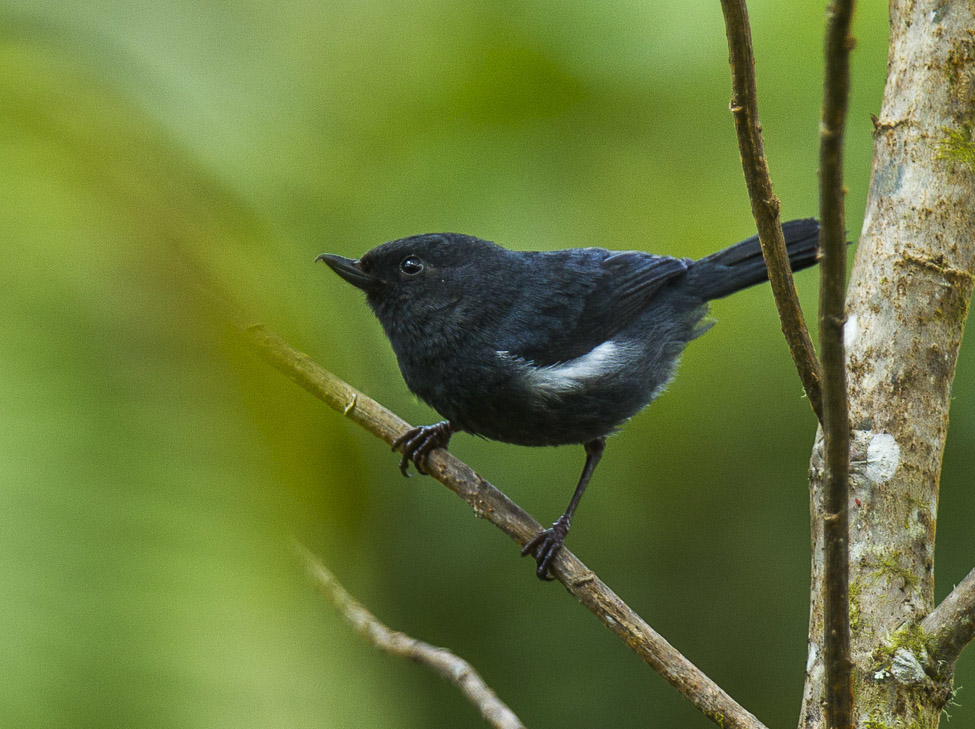
Wikipedia: White-sided flowerpiercer Source: OTHER
White-sided_Flowerpiercer_-_South_Ecuador_S4E2856_%2823391895895%29.jpg
![]() The white-sided flowerpiercer (Diglossa albilatera) is a species of bird in the family Thraupidae.
[more]
The white-sided flowerpiercer (Diglossa albilatera) is a species of bird in the family Thraupidae.
[more]
Deep-blue flowerpiercer (Diglossa glauca)

Wikipedia: Deep-blue flowerpiercer Source: OTHER
1200px-Diglossopis_glauca.jpg
![]() The golden-eyed flowerpiercer (Diglossa glauca), also known as the deep-blue flowerpiercer, is a species of bird in the tanager family Thraupidae. It is found in humid Andean forests in Colombia, Ecuador, Peru and Bolivia. It is the only species of flowerpiercer with bright yellow eyes.
[more]
The golden-eyed flowerpiercer (Diglossa glauca), also known as the deep-blue flowerpiercer, is a species of bird in the tanager family Thraupidae. It is found in humid Andean forests in Colombia, Ecuador, Peru and Bolivia. It is the only species of flowerpiercer with bright yellow eyes.
[more]
Bluish flowerpiercer / Silberhakenschnabel (Diglossa caerulescens)

Wikipedia: Bluish flowerpiercer Source: OTHER
1200px-Bluish_Flowerpiercer_%285283140856%29.jpg
![]() The bluish flowerpiercer (Diglossa caerulescens) is a species of bird in the family Thraupidae. It is found in humid montane forest in Bolivia, Colombia, Ecuador, Peru and Venezuela.
[more]
The bluish flowerpiercer (Diglossa caerulescens) is a species of bird in the family Thraupidae. It is found in humid montane forest in Bolivia, Colombia, Ecuador, Peru and Venezuela.
[more]
Masked flowerpiercer / Maskenhakenschnabel (Diglossa cyanea)
Profile Wikipedia eBird Xeno-Canto

Wikipedia: Masked flowerpiercer Source: OTHER
Masked_Flowerpiercer_%28Diglossopis_cyanea%29.jpg
![]()
The masked flowerpiercer (Diglossa cyanea) is a species of bird in the tanager family, Thraupidae. It is found in humid montane forest and scrub in Venezuela, Colombia, Ecuador, Peru and Bolivia. Flowerpiercers got their name from the fact that they have a sharp hook on the tip of their upper mandible which they use to slice open the base of flowers to get at the nectar.
[more]
Gray-headed tanager (Eucometis penicillata)
Profile Wikipedia eBird Xeno-Canto

Wikipedia: Gray-headed tanager Source: OTHER
1200px-Eucometis_penicillata_-Manizales%2C_Caldas%2C_Colombia-8.jpg
![]() The grey-headed tanager (Eucometis penicillata) is a widely distributed species of small Neotropical bird in the tanager family Thraupidae. It is the only member of the genus Eucometis.
[more]
The grey-headed tanager (Eucometis penicillata) is a widely distributed species of small Neotropical bird in the tanager family Thraupidae. It is the only member of the genus Eucometis.
[more]
Red-crowned ant-tanager (Habia rubica)
Profile Wikipedia eBird Xeno-Canto

Wikipedia: Red-crowned ant-tanager Source: OTHER
1200px-Habia_rubica_-_Red-crowned_Ant-Tanager_%28male%29.JPG
![]() The red-crowned ant tanager (Habia rubica) is a medium-sized passerine bird from tropical America. The genus Habia was long placed with the tanagers (Thraupidae), but it is actually closer to the cardinals (Cardinalidae). Consequently, it can be argued that referring to the members of this genus as ant-tanagers is misleading, but no other common name has gained usage.
[more]
The red-crowned ant tanager (Habia rubica) is a medium-sized passerine bird from tropical America. The genus Habia was long placed with the tanagers (Thraupidae), but it is actually closer to the cardinals (Cardinalidae). Consequently, it can be argued that referring to the members of this genus as ant-tanagers is misleading, but no other common name has gained usage.
[more]
Yellow-backed tanager (Hemithraupis flavicollis)
Profile Wikipedia eBird Xeno-Canto

Wikipedia: Yellow-backed tanager Source: OTHER
Hemithraupis_flavicollis_insignis.jpg
![]() The yellow-backed tanager (Hemithraupis flavicollis) is a species of bird in the family Thraupidae, the tanagers.
[more]
The yellow-backed tanager (Hemithraupis flavicollis) is a species of bird in the family Thraupidae, the tanagers.
[more]
Guira tanager (Hemithraupis guira)
Profile Wikipedia eBird Xeno-Canto

Wikipedia: Guira tanager Source: OTHER
Hemithraupis_guira.jpg
![]() The guira tanager (Hemithraupis guira) is a species of bird in the family Thraupidae.
[more]
The guira tanager (Hemithraupis guira) is a species of bird in the family Thraupidae.
[more]
Scarlet-browed tanager (Heterospingus xanthopygius)
Profile Wikipedia eBird Xeno-Canto

Wikipedia: Scarlet-browed tanager Source: OTHER
Scarlet-browed_Tanager_%28Heterospingus_xanthopygius_%288079749074%29.jpg
![]() The scarlet-browed tanager (Heterospingus xanthopygius) is a species of bird in the family Thraupidae.
[more]
The scarlet-browed tanager (Heterospingus xanthopygius) is a species of bird in the family Thraupidae.
[more]
Fulvous shrike-tanager (Lanio fulvus)
Profile Wikipedia eBird Xeno-Canto

Wikipedia: Fulvous shrike-tanager Source: OTHER
1200px-Lanio_fulvus_-_Fulvous_Shrike-Tanager_%28male%29%3B_Botanic_Garden%2C_Manaus%2C_Amazonas%2C_Brazil.jpg
![]() The fulvous shrike-tanager (Lanio fulvus) is a South American bird in the tanager family Thraupidae.
It is found in Brazil, Colombia, Ecuador, French Guiana, Guyana, Peru, Suriname, and Venezuela.
Its natural habitat is subtropical or tropical moist lowland forests.
[more]
The fulvous shrike-tanager (Lanio fulvus) is a South American bird in the tanager family Thraupidae.
It is found in Brazil, Colombia, Ecuador, French Guiana, Guyana, Peru, Suriname, and Venezuela.
Its natural habitat is subtropical or tropical moist lowland forests.
[more]
Dusky-faced tanager (Mitrospingus cassinii)
Profile Wikipedia eBird Xeno-Canto

Wikipedia: Dusky-faced tanager Source: OTHER
1200px-Dusky-faced_tanager_%28Mitrospingus_cassinii_cassinii%29.jpg
![]() The dusky-faced tanager (Mitrospingus cassinii) is a species of bird formerly in the family Thraupidae.
[more]
The dusky-faced tanager (Mitrospingus cassinii) is a species of bird formerly in the family Thraupidae.
[more]
White-capped tanager (Sericossypha albocristata)
Profile Wikipedia eBird Xeno-Canto

Wikipedia: White-capped tanager Source: OTHER
1200px-Sericossypha_albocristata_Pollo_de_monte_White-capped_Tanager_%2811198141456%29.jpg
![]() The white-capped tanager (Sericossypha albocristata) is a South American bird in the tanager family Thraupidae. It is the only member of the genus Sericossypha . It is the heaviest but not the longest species of tanager, at a weight of 114 g (4 oz) and a length of 24 cm (9.5 in). This species is glossy black overall with a large white crown and a red throat (which is brightest in adult males). It occurs in Colombia, Venezuela, Ecuador and Peru at elevations of 1600–3200 m. It lives in humid Andean forest in groups of up to 20 individuals. Flocks of these tanagers stay in tight formation, often foraging from tree to tree together. They may eat fruits, seeds, hymenoptera, and coleoptera.
[more]
The white-capped tanager (Sericossypha albocristata) is a South American bird in the tanager family Thraupidae. It is the only member of the genus Sericossypha . It is the heaviest but not the longest species of tanager, at a weight of 114 g (4 oz) and a length of 24 cm (9.5 in). This species is glossy black overall with a large white crown and a red throat (which is brightest in adult males). It occurs in Colombia, Venezuela, Ecuador and Peru at elevations of 1600–3200 m. It lives in humid Andean forest in groups of up to 20 individuals. Flocks of these tanagers stay in tight formation, often foraging from tree to tree together. They may eat fruits, seeds, hymenoptera, and coleoptera.
[more]
White-lined tanager (Tachyphonus rufus)
Profile Wikipedia eBird Xeno-Canto

Wikipedia: White-lined tanager Source: OTHER
1200px-White-lined_tanager_%28Tachyphonus_rufus%29_male.jpg
![]() The white-lined tanager (Tachyphonus rufus) is a medium-sized passerine bird in the tanager family Thraupidae. It is a resident breeder from Costa Rica south to northern Argentina, and on the islands of Trinidad and Tobago.
[more]
The white-lined tanager (Tachyphonus rufus) is a medium-sized passerine bird in the tanager family Thraupidae. It is a resident breeder from Costa Rica south to northern Argentina, and on the islands of Trinidad and Tobago.
[more]
Tawny-crested tanager (alternate) / Schwarzachseltangare (Tachyphonus delatrii)
![]() Die Schwarzachseltangare (Tachyphonus delatrii) ist eine in Süd- und Mittelamerika verbreitete Vogelart der Gattung der Schwarztangaren (Tachyphonus) aus der Familie der Tangaren (Thraupidae).
[more]
Die Schwarzachseltangare (Tachyphonus delatrii) ist eine in Süd- und Mittelamerika verbreitete Vogelart der Gattung der Schwarztangaren (Tachyphonus) aus der Familie der Tangaren (Thraupidae).
[more]
Fulvous-crested tanager (Tachyphonus surinamus)
Profile Wikipedia eBird Xeno-Canto

Wikipedia: Fulvous-crested tanager Source: OTHER
1200px-Tachyphonus_surinamus_-_Fulvous-crested_Tanager_%28male%29_%3B_Ramal_do_Pau_Rosa%2C_Manaus%2C_Amazonas%2C_Brazil.jpg
![]() The fulvous-crested tanager (Tachyphonus surinamus) is a species of bird in the family Thraupidae, the tanagers.
[more]
The fulvous-crested tanager (Tachyphonus surinamus) is a species of bird in the family Thraupidae, the tanagers.
[more]
Orange-headed tanager (Thlypopsis sordida)
Profile Wikipedia eBird Xeno-Canto

Wikipedia: Orange-headed tanager Source: OTHER
1200px-Thlypopsis_sordida.jpg
![]() The orange-headed tanager (Thlypopsis sordida) is a species of bird in the family Thraupidae.
It is found in Argentina, Bolivia, Brazil, Colombia, Ecuador, Paraguay, Peru, and Venezuela.
Its natural habitats are subtropical or tropical moist lowland forests, subtropical or tropical moist shrubland, and heavily degraded former forest.
[more]
The orange-headed tanager (Thlypopsis sordida) is a species of bird in the family Thraupidae.
It is found in Argentina, Bolivia, Brazil, Colombia, Ecuador, Paraguay, Peru, and Venezuela.
Its natural habitats are subtropical or tropical moist lowland forests, subtropical or tropical moist shrubland, and heavily degraded former forest.
[more]
Rufous-chested tanager (Thlypopsis ornata)
Profile Wikipedia eBird Xeno-Canto

Wikipedia: Rufous-chested tanager Source: OTHER
1200px-Thlypopsis_ornata_103050574.jpg
![]() The rufous-chested tanager (Thlypopsis ornata) is a species of bird in the family Thraupidae.
[more]
The rufous-chested tanager (Thlypopsis ornata) is a species of bird in the family Thraupidae.
[more]
Superciliaried hemispingus (Thlypopsis superciliaris)
Profile Wikipedia eBird Xeno-Canto

Wikipedia: Superciliaried hemispingus Source: OTHER
Hemispingus_superciliaris.jpg
![]() The superciliaried hemispingus (Thlypopsis superciliaris) is a species of bird in the family Thraupidae.
[more]
The superciliaried hemispingus (Thlypopsis superciliaris) is a species of bird in the family Thraupidae.
[more]
Buff-bellied tanager (Thlypopsis inornata)
Profile Wikipedia eBird Xeno-Canto

Wikipedia: Buff-bellied tanager Source: OTHER
Thlypopsis_inornata_-_Buff-bellied_Tanager_%28cropped%29.jpg
![]() The buff-bellied tanager (Thlypopsis inornata) is a species of bird in the family Thraupidae.
[more]
The buff-bellied tanager (Thlypopsis inornata) is a species of bird in the family Thraupidae.
[more]
Tit-like dacnis (Xenodacnis parina)
Profile Wikipedia eBird Xeno-Canto

Wikipedia: Tit-like dacnis Source: OTHER
1200px-Tit-like-dacnis.jpg
![]() The tit-like dacnis (Xenodacnis parina) is a small neotropical passerine bird found in southern Ecuador and Peru. In Spanish, it is known as Azulito Altoandino. It is found in Andean montane scrub forests from 3000 m to 4600 m elevation.
[more]
The tit-like dacnis (Xenodacnis parina) is a small neotropical passerine bird found in southern Ecuador and Peru. In Spanish, it is known as Azulito Altoandino. It is found in Andean montane scrub forests from 3000 m to 4600 m elevation.
[more]
Bananaquit (Coereba flaveola)
Profile Wikipedia eBird Xeno-Canto
Possibly a bananaquit at the botanical garden, Puerto Morelos. 2023-03-27 11.43.00 Yucatan
First observed in Yucatan on 2023-03-27.
![]() The bananaquit (Coereba flaveola) is a species of passerine bird in the tanager family Thraupidae. Before the development of molecular genetics in the 21st century, its relationship to other species was uncertain and it was either placed with the buntings and New World sparrows in the family Emberizidae, with New World warblers in the family Parulidae or in its own monotypic family Coerebidae. This small, active nectarivore is found in warmer parts of the Americas, and is generally common.
[more]
The bananaquit (Coereba flaveola) is a species of passerine bird in the tanager family Thraupidae. Before the development of molecular genetics in the 21st century, its relationship to other species was uncertain and it was either placed with the buntings and New World sparrows in the family Emberizidae, with New World warblers in the family Parulidae or in its own monotypic family Coerebidae. This small, active nectarivore is found in warmer parts of the Americas, and is generally common.
[more]
Yellow-faced grassquit (Tiaris olivaceus)
MerlinBirdID says yellow-faced grassquit. 2023-04-01 09.25.10 Yucatan
First observed in Yucatan on 2023-04-01.
![]() The yellow-faced grassquit (Tiaris olivaceus) is a passerine bird in the tanager family Thraupidae and is the only member of the genus Tiaris. It is native to the Central America, South America, and the Caribbean.
[more]
The yellow-faced grassquit (Tiaris olivaceus) is a passerine bird in the tanager family Thraupidae and is the only member of the genus Tiaris. It is native to the Central America, South America, and the Caribbean.
[more]
Slaty finch (Haplospiza rustica)
Profile Wikipedia eBird Xeno-Canto

Wikipedia: Slaty finch Source: OTHER
Haplospiza-rustica-002.jpg
![]() The slaty finch (Haplospiza rustica) is a bird species in the family Thraupidae (formerly in Emberizidae).
[more]
The slaty finch (Haplospiza rustica) is a bird species in the family Thraupidae (formerly in Emberizidae).
[more]
Slate-colored seedeater (Sporophila schistacea)
Profile Wikipedia eBird Xeno-Canto

Wikipedia: Slate-colored seedeater Source: OTHER
1200px-Sporophila_schistacea.jpg
![]() The slate-coloured seedeater (Sporophila schistacea) is a bird species in the family Thraupidae.
[more]
The slate-coloured seedeater (Sporophila schistacea) is a bird species in the family Thraupidae.
[more]
Thick-billed seed-finch (Sporophila funerea)
Profile Wikipedia eBird Xeno-Canto

Wikipedia: Thick-billed seed-finch Source: OTHER
Thick-billed_Seed-Finch_-_Sarapiqui_-_Costa_Rica_MG_0887_%2826405624880%29.jpg
![]() The thick-billed seed finch (Sporophila funerea) is a species of bird in the family Thraupidae, but was until recently placed in Emberizidae. It is found widely in shrubby and grassy areas from southern Mexico, through Central America, to the Chocó in Colombia and Ecuador. It is replaced by the closely related chestnut-bellied seed finch in South America east of the Andes, as well as the valleys of Cauca and Magdalena in Colombia. The two have often been considered conspecific as the lesser seed-finch (Oryzoborus angolensis).
[more]
The thick-billed seed finch (Sporophila funerea) is a species of bird in the family Thraupidae, but was until recently placed in Emberizidae. It is found widely in shrubby and grassy areas from southern Mexico, through Central America, to the Chocó in Colombia and Ecuador. It is replaced by the closely related chestnut-bellied seed finch in South America east of the Andes, as well as the valleys of Cauca and Magdalena in Colombia. The two have often been considered conspecific as the lesser seed-finch (Oryzoborus angolensis).
[more]
Yellow-bellied seedeater / Gelbbauchpfäffchen (Sporophila nigricollis)
Profile Wikipedia eBird Xeno-Canto

Wikipedia: Yellow-bellied seedeater Source: OTHER
Sporophila_nigricollis_%28male%29_-NW_Ecuador.jpg
![]() The yellow-bellied seedeater (Sporophila nigricollis) is a species of bird in the family Thraupidae, formerly placed with the American sparrows in the Emberizidae.
[more]
The yellow-bellied seedeater (Sporophila nigricollis) is a species of bird in the family Thraupidae, formerly placed with the American sparrows in the Emberizidae.
[more]
Variable seedeater (Sporophila corvina)
Profile Wikipedia eBird Xeno-Canto

Wikipedia: Variable seedeater Source: OTHER
Sporophila-corvina-002.jpg
![]() The variable seedeater (Sporophila corvina) is a passerine bird which breeds from southern Mexico through Central America to the Chocó of northwestern South America. The taxonomy is confusing, and it was formerly considered a subspecies of Sporophila americana (see Taxonomy). Even within the variable seedeater as presently defined, there are great variations in plumage.
[more]
The variable seedeater (Sporophila corvina) is a passerine bird which breeds from southern Mexico through Central America to the Chocó of northwestern South America. The taxonomy is confusing, and it was formerly considered a subspecies of Sporophila americana (see Taxonomy). Even within the variable seedeater as presently defined, there are great variations in plumage.
[more]
Ruddy-breasted seedeater (Sporophila minuta)
Profile Wikipedia eBird Xeno-Canto

Wikipedia: Ruddy-breasted seedeater Source: OTHER
1200px-Sporophila_minuta_Espiguero_ladrillo_Ruddy-breasted_Seedeater_%2811481101056%29.jpg
![]() The ruddy-breasted seedeater (Sporophila minuta) is a species of bird in the tanager family Thraupidae.
It is found in Brazil, Colombia, Costa Rica, Ecuador, El Salvador, French Guiana, Guatemala, Guyana, Honduras, Mexico, Nicaragua, Panama, Suriname, Trinidad and Tobago, and Venezuela.
Its natural habitats are dry savanna, subtropical or tropical seasonally wet or flooded lowland grassland, and heavily degraded former forest.
[more]
The ruddy-breasted seedeater (Sporophila minuta) is a species of bird in the tanager family Thraupidae.
It is found in Brazil, Colombia, Costa Rica, Ecuador, El Salvador, French Guiana, Guatemala, Guyana, Honduras, Mexico, Nicaragua, Panama, Suriname, Trinidad and Tobago, and Venezuela.
Its natural habitats are dry savanna, subtropical or tropical seasonally wet or flooded lowland grassland, and heavily degraded former forest.
[more]
Large-billed seed-finch (Sporophila crassirostris)
Profile Wikipedia eBird Xeno-Canto

Wikipedia: Large-billed seed-finch Source: OTHER
1200px-Oryzoborus_crassirostris_female_Naturhistorisches_Museum_%28MoNH%29_Vienna.jpg
![]() The large-billed seed finch (Sporophila crassirostris) is a species of bird in the family Thraupidae.
[more]
The large-billed seed finch (Sporophila crassirostris) is a species of bird in the family Thraupidae.
[more]
Lined seedeater (Sporophila lineola)
Profile Wikipedia eBird Xeno-Canto

Wikipedia: Lined seedeater Source: OTHER
BIGODINHO_%28Sporophila_lineola_%29.jpg
![]() The lined seedeater (Sporophila lineola) is a species of bird in the family Thraupidae.
[more]
The lined seedeater (Sporophila lineola) is a species of bird in the family Thraupidae.
[more]
Drab seedeater (Sporophila simplex)
Profile Wikipedia eBird Xeno-Canto

Wikipedia: Drab seedeater Source: OTHER
DrabSeedeater.jpg
![]() The drab seedeater (Sporophila simplex) is a species of bird in the family Thraupidae.
It is found in Ecuador and Peru.
Its natural habitats are subtropical or tropical dry shrubland, subtropical or tropical moist shrubland, and subtropical or tropical high-altitude shrubland.
[more]
The drab seedeater (Sporophila simplex) is a species of bird in the family Thraupidae.
It is found in Ecuador and Peru.
Its natural habitats are subtropical or tropical dry shrubland, subtropical or tropical moist shrubland, and subtropical or tropical high-altitude shrubland.
[more]
Black-and-white seedeater (Sporophila luctuosa)
Profile Wikipedia eBird Xeno-Canto

Wikipedia: Black-and-white seedeater Source: OTHER
1200px-Black-and-white_Seedeater_BW12b.jpg
![]() The black-and-white seedeater (Sporophila luctuosa) is a species of bird in the family Thraupidae.
It is found in Bolivia, Brazil, Colombia, Ecuador, Peru, and Venezuela.
Its natural habitats are subtropical or tropical moist shrubland, subtropical or tropical high-altitude shrubland, and heavily degraded former forest.
[more]
The black-and-white seedeater (Sporophila luctuosa) is a species of bird in the family Thraupidae.
It is found in Bolivia, Brazil, Colombia, Ecuador, Peru, and Venezuela.
Its natural habitats are subtropical or tropical moist shrubland, subtropical or tropical high-altitude shrubland, and heavily degraded former forest.
[more]
Black-billed seed-finch (Sporophila atrirostris)
Profile Wikipedia eBird Xeno-Canto

Wikipedia: Black-billed seed-finch Source: OTHER
Black-billed_seed_finch_%28Sporophila_atrirostris%29_%28cropped%29.jpg
![]() The black-billed seed finch (Sporophila atrirostris) is a species of bird in the family Thraupidae.
It is found in the western Amazon Basin (Ecuador, Peru and northwestern Bolivia).
[more]
The black-billed seed finch (Sporophila atrirostris) is a species of bird in the family Thraupidae.
It is found in the western Amazon Basin (Ecuador, Peru and northwestern Bolivia).
[more]
Chestnut-throated seedeater (Sporophila telasco)
Profile Wikipedia eBird Xeno-Canto

Wikipedia: Chestnut-throated seedeater Source: OTHER
Chestnut-throatedSeedeater.jpg
![]() The chestnut-throated seedeater (Sporophila telasco) is Neotropical songbird in the family Thraupidae.
[more]
The chestnut-throated seedeater (Sporophila telasco) is Neotropical songbird in the family Thraupidae.
[more]
Caqueta seedeater (Sporophila murallae)
Profile Wikipedia eBird Xeno-Canto

Wikipedia: Caqueta seedeater Source: OTHER
1200px-Sporophila_murallae_-_Caqueta_seedeater_%28male%29%3B_Serra_do_Divisor_National_Park%2C_Acre%2C_Brazil.jpg
![]() The Caquetá seedeater (Sporophila murallae) is a passerine bird from the western Amazon Basin in south-eastern Colombia, eastern Ecuador, north-eastern Peru and far western Brazil (western Acre and Amazonas only). The status in south-eastern Peru is unclear. Together with the mainly Central American S. corvina, it was formerly considered a subspecies of S. americana, in which case the common name for the combined species was variable seed eater. Following the split, this common name is now restricted to S. corvina.
[more]
The Caquetá seedeater (Sporophila murallae) is a passerine bird from the western Amazon Basin in south-eastern Colombia, eastern Ecuador, north-eastern Peru and far western Brazil (western Acre and Amazonas only). The status in south-eastern Peru is unclear. Together with the mainly Central American S. corvina, it was formerly considered a subspecies of S. americana, in which case the common name for the combined species was variable seed eater. Following the split, this common name is now restricted to S. corvina.
[more]
Chestnut-bellied seedeater (Sporophila castaneiventris)
Profile Wikipedia eBird Xeno-Canto

Wikipedia: Chestnut-bellied seedeater Source: OTHER
Sporophila_castaneiventris_-_Chestnut-bellied_seedeater_%28male%29%2C_Rio_Branco%2C_Acre%2C_Brazil.jpg
![]() The chestnut-bellied seedeater (Sporophila castaneiventris) is a species of bird in the family Thraupidae.
It is found in Bolivia, Brazil, Colombia, Ecuador, French Guiana, Guyana, Peru, Suriname, and Venezuela.
Its natural habitats are subtropical or tropical moist shrubland and heavily degraded former forest.
[more]
The chestnut-bellied seedeater (Sporophila castaneiventris) is a species of bird in the family Thraupidae.
It is found in Bolivia, Brazil, Colombia, Ecuador, French Guiana, Guyana, Peru, Suriname, and Venezuela.
Its natural habitats are subtropical or tropical moist shrubland and heavily degraded former forest.
[more]
Lesson's seedeater (Sporophila bouvronides)
Profile Wikipedia eBird Xeno-Canto

Wikipedia: Lesson's seedeater Source: OTHER
Spermophila_ocellata_Keulemans.jpg
![]() Lesson's seedeater (Sporophila bouvronides) is a bird species in the family Thraupidae (formerly in Emberizidae).
[more]
Lesson's seedeater (Sporophila bouvronides) is a bird species in the family Thraupidae (formerly in Emberizidae).
[more]
Parrot-billed seedeater (Sporophila peruviana)
Profile Wikipedia eBird Xeno-Canto

Wikipedia: Parrot-billed seedeater Source: OTHER
1200px-Sporophila_peruviana_-_Parrot-billed_Seedeater_-_male.jpg
![]() The parrot-billed seedeater (Sporophila peruviana) is a small species of bird in the family Thraupidae. It is found in various shrubby habitats in western Ecuador and western Peru. Outside the breeding season, it is quite social and frequently seen in flocks with other small seed-eating birds.
[more]
The parrot-billed seedeater (Sporophila peruviana) is a small species of bird in the family Thraupidae. It is found in various shrubby habitats in western Ecuador and western Peru. Outside the breeding season, it is quite social and frequently seen in flocks with other small seed-eating birds.
[more]
Chestnut-bellied seed-finch (Sporophila angolensis)

Wikipedia: Chestnut-bellied seed-finch Source: OTHER
1200px-Oryzoborus_angolensis.jpg
![]() The chestnut-bellied seed finch (Sporophila angolensis) is a species of bird in the family Thraupidae, but was until recently placed in Emberizidae.
[more]
The chestnut-bellied seed finch (Sporophila angolensis) is a species of bird in the family Thraupidae, but was until recently placed in Emberizidae.
[more]
Blue-black grassquit (Volatinia jacarina)

Wikipedia: Blue-black grassquit Source: OTHER
Tiziu.jpg
![]() Tanagra jacarina Linnaeus, 1766
[more]
Tanagra jacarina Linnaeus, 1766
[more]
Collared warbling-finch (Poospiza hispaniolensis)

Wikipedia: Collared warbling-finch Source: OTHER
1200px-Poospiza_hispaniolensis_-_Collared_Warbling-Finch_-_male_%28cropped%29.jpg
![]() The collared warbling finch (Poospiza hispaniolensis) is a species of bird in the family Thraupidae. It is found in Ecuador and Peru.
[more]
The collared warbling finch (Poospiza hispaniolensis) is a species of bird in the family Thraupidae. It is found in Ecuador and Peru.
[more]
Red-crested finch (Coryphospingus cucullatus)

Wikipedia: Red-crested finch Source: OTHER
1200px-Coryphospingus_cucullatus_-Piraju%2C_Sao_Paulo%2C_Brazil-8.jpg
![]() The red pileated finch (Coryphospingus cucullatus), also known as the red-crested finch, is a species of bird in the family Thraupidae. It is found in Argentina, Bolivia, Brazil, Ecuador, French Guiana, Guyana, Paraguay, Peru, on the eastern side of the Andes. Its natural habitats are subtropical or tropical dry forests, subtropical or tropical moist lowland forests, subtropical or tropical dry shrubland, and heavily degraded former forest. This is a common species, and the International Union for Conservation of Nature has rated its conservation status as "least concern".
[more]
The red pileated finch (Coryphospingus cucullatus), also known as the red-crested finch, is a species of bird in the family Thraupidae. It is found in Argentina, Bolivia, Brazil, Ecuador, French Guiana, Guyana, Paraguay, Peru, on the eastern side of the Andes. Its natural habitats are subtropical or tropical dry forests, subtropical or tropical moist lowland forests, subtropical or tropical dry shrubland, and heavily degraded former forest. This is a common species, and the International Union for Conservation of Nature has rated its conservation status as "least concern".
[more]
Band-tailed seedeater (Catamenia analis)
Profile Wikipedia eBird Xeno-Canto

Wikipedia: Band-tailed seedeater Source: OTHER
1200px-Band-tailed_Seedeater%2C_Lomas_de_Lachay%2C_Peru_%285964875508%29.jpg
![]() The band-tailed seedeater (Catamenia analis) is a species of bird in the family Thraupidae.
It is found in Argentina, Bolivia, Chile, Colombia, Ecuador, and Peru.
Its natural habitats are subtropical or tropical high-altitude shrubland and heavily degraded former forest.
[more]
The band-tailed seedeater (Catamenia analis) is a species of bird in the family Thraupidae.
It is found in Argentina, Bolivia, Chile, Colombia, Ecuador, and Peru.
Its natural habitats are subtropical or tropical high-altitude shrubland and heavily degraded former forest.
[more]
Plain-colored seedeater (Catamenia inornata)
Profile Wikipedia eBird Xeno-Canto

Wikipedia: Plain-colored seedeater Source: OTHER
1200px-NBII_Image_Gallery_-Catamenia_inornata-a00269.jpg
![]() The plain-colored seedeater (Catamenia inornata) is a species of bird in the family Thraupidae.
[more]
The plain-colored seedeater (Catamenia inornata) is a species of bird in the family Thraupidae.
[more]
Paramo seedeater (Catamenia homochroa)
Profile Wikipedia eBird Xeno-Canto

Wikipedia: Paramo seedeater Source: OTHER
Paramo_seedeater.jpg
![]() The paramo seedeater (Catamenia homochroa) is a species of bird in the family Thraupidae.
[more]
The paramo seedeater (Catamenia homochroa) is a species of bird in the family Thraupidae.
[more]
Saffron finch (Sicalis flaveola)
Profile Wikipedia eBird Audubon AllAboutBirds Xeno-Canto

Wikipedia: Saffron finch Source: OTHER
1200px-Saffron_finch_%28Sicalis_flaveola%29_male.JPG
![]() The saffron finch (Sicalis flaveola) is a tanager from South America that is common in open and semi-open areas in lowlands outside the Amazon Basin. They have a wide distribution in Colombia, northern Venezuela (where it is called "canario de tejado" or "roof canary"), western Ecuador, western Peru, eastern and southern Brazil (where it is called "canário-da-terra" or "native canary"), Bolivia, Paraguay, Uruguay, northern Argentina, and Trinidad and Tobago. It has also been introduced to Hawaii, Puerto Rico and elsewhere. Although commonly regarded as a canary, it is not related to the Atlantic canary. Formerly, it was placed in the Emberizidae but it is close to the seedeaters.
[more]
The saffron finch (Sicalis flaveola) is a tanager from South America that is common in open and semi-open areas in lowlands outside the Amazon Basin. They have a wide distribution in Colombia, northern Venezuela (where it is called "canario de tejado" or "roof canary"), western Ecuador, western Peru, eastern and southern Brazil (where it is called "canário-da-terra" or "native canary"), Bolivia, Paraguay, Uruguay, northern Argentina, and Trinidad and Tobago. It has also been introduced to Hawaii, Puerto Rico and elsewhere. Although commonly regarded as a canary, it is not related to the Atlantic canary. Formerly, it was placed in the Emberizidae but it is close to the seedeaters.
[more]
Grassland yellow-finch (Sicalis luteola)
Profile Wikipedia eBird Xeno-Canto

Wikipedia: Grassland yellow-finch Source: OTHER
1200px-Sicalis_luteola.jpg
![]() The grassland yellow finch (Sicalis luteola) is a small passerine bird. Despite its name, it is not a finch, but is a seedeater. These were formerly united with the buntings and American sparrows in the Emberizidae, but are now known to be tanagers.
[more]
The grassland yellow finch (Sicalis luteola) is a small passerine bird. Despite its name, it is not a finch, but is a seedeater. These were formerly united with the buntings and American sparrows in the Emberizidae, but are now known to be tanagers.
[more]
Sulphur-throated finch (Sicalis taczanowskii)
Profile Wikipedia eBird Xeno-Canto

Wikipedia: Sulphur-throated finch Source: OTHER
1200px-Sicalis_taczanowskii_-_Sulphur-throated_Finch_-_male.jpg
![]() The sulphur-throated finch (Sicalis taczanowskii) is a species of bird in the family Thraupidae.
It is found in Ecuador and Peru.
Its natural habitat is subtropical or tropical dry shrubland.
[more]
The sulphur-throated finch (Sicalis taczanowskii) is a species of bird in the family Thraupidae.
It is found in Ecuador and Peru.
Its natural habitat is subtropical or tropical dry shrubland.
[more]
Blue-backed conebill (Conirostrum sitticolor)
Profile Wikipedia eBird Xeno-Canto

Wikipedia: Blue-backed conebill Source: OTHER
1200px-Conirostrum_sitticolor_-_Conirrostro_encapuchado_-_Blue-backed_Conebill_%288730321476%29.jpg
![]() The blue-backed conebill (Conirostrum sitticolor) is a species of bird in the family Thraupidae (Tanager).
It is found in Bolivia, Colombia, Ecuador, Peru, and Venezuela.
Its natural habitat is subtropical or tropical moist montane forests.
[more]
The blue-backed conebill (Conirostrum sitticolor) is a species of bird in the family Thraupidae (Tanager).
It is found in Bolivia, Colombia, Ecuador, Peru, and Venezuela.
Its natural habitat is subtropical or tropical moist montane forests.
[more]
Pearly-breasted conebill (Conirostrum margaritae)
Profile Wikipedia eBird Xeno-Canto

Wikipedia: Pearly-breasted conebill Source: OTHER
1200px-Conirostrum_margaritae.png
![]() The pearly-breasted conebill (Conirostrum margaritae) is a species of bird in the family Thraupidae.
[more]
The pearly-breasted conebill (Conirostrum margaritae) is a species of bird in the family Thraupidae.
[more]
Capped conebill (Conirostrum albifrons)
Profile Wikipedia eBird Xeno-Canto
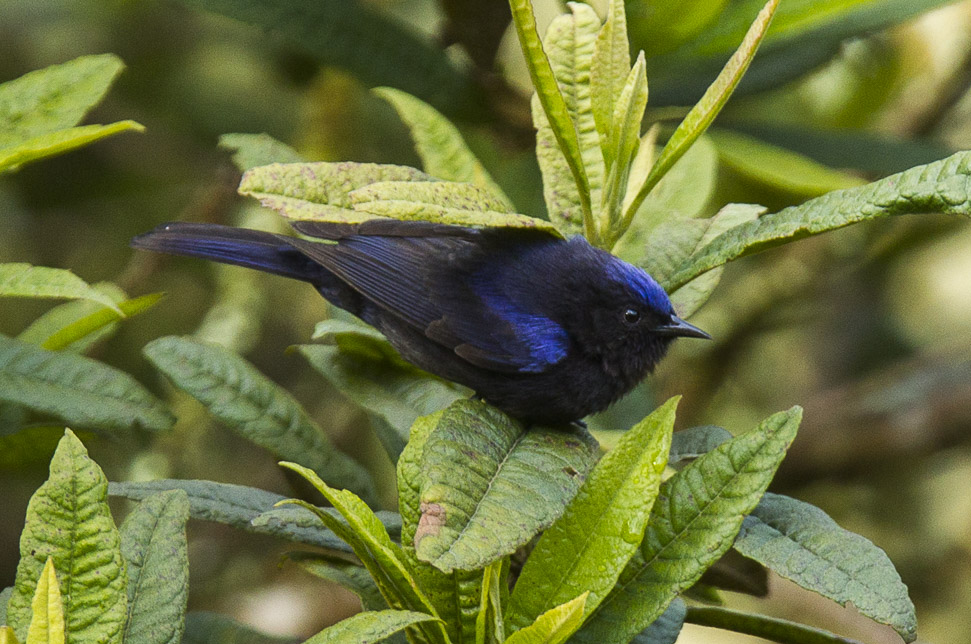
Wikipedia: Capped conebill Source: OTHER
Capped_Conebill_-_Ecuador_S4E4700_%2822882391489%29.jpg
![]() The capped conebill (Conirostrum albifrons) is a species of bird in the family Thraupidae.
[more]
The capped conebill (Conirostrum albifrons) is a species of bird in the family Thraupidae.
[more]
Giant conebill / Riesenspitzschnabel (Conirostrum binghami)
Profile Wikipedia eBird Xeno-Canto

Wikipedia: Giant conebill Source: OTHER
1200px-Giant_Conebill%2C_Cajas%2C_Ecuador_%285771232969%29.jpg
![]() The giant conebill (Conirostrum binghami) is a small passerine bird, one of the tanager family. It is closely related to the regular conebills Conirostrum though it differs in its larger size and nuthatch-like foraging habits.
[more]
The giant conebill (Conirostrum binghami) is a small passerine bird, one of the tanager family. It is closely related to the regular conebills Conirostrum though it differs in its larger size and nuthatch-like foraging habits.
[more]
Cinereous conebill (Conirostrum cinereum)
Profile Wikipedia eBird Xeno-Canto

Wikipedia: Cinereous conebill Source: OTHER
1200px-Cinereous_Conebill_RWD2.jpg
![]() The cinereous conebill (Conirostrum cinereum) is a species of bird in the tanager family Thraupidae. The term cinereous describes its colouration. It is found in Bolivia, Chile, Colombia, Ecuador, and Peru. Its natural habitats are subtropical or tropical moist shrubland, subtropical or tropical high-altitude shrubland, and heavily degraded former forest.
[more]
The cinereous conebill (Conirostrum cinereum) is a species of bird in the tanager family Thraupidae. The term cinereous describes its colouration. It is found in Bolivia, Chile, Colombia, Ecuador, and Peru. Its natural habitats are subtropical or tropical moist shrubland, subtropical or tropical high-altitude shrubland, and heavily degraded former forest.
[more]
Bicolored conebill (Conirostrum bicolor)
Profile Wikipedia eBird Xeno-Canto
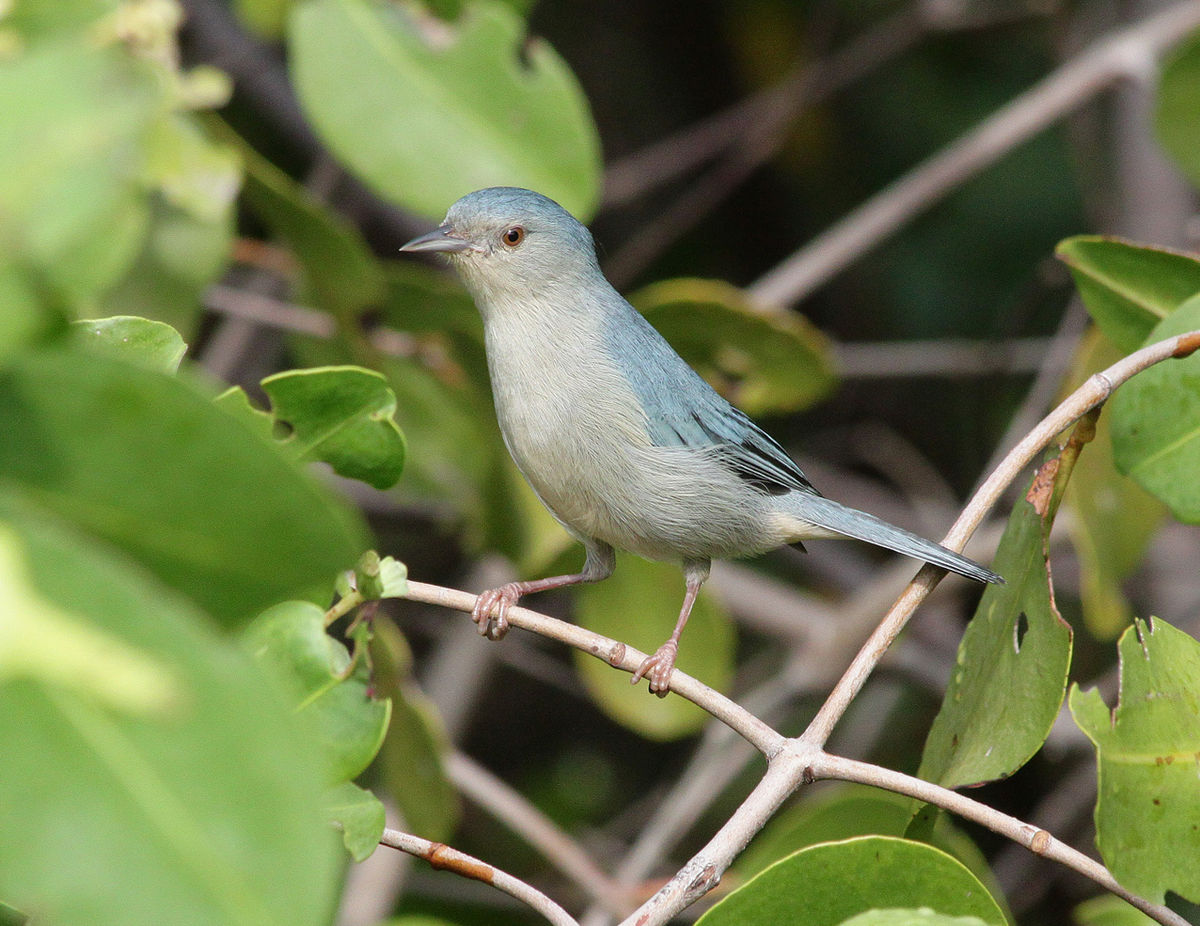
Wikipedia: Bicolored conebill Source: OTHER
1200px-Bicolored_Conebill_%28Conirostrum_bicolor%29.jpg
![]() The bicolored conebill (Conirostrum bicolor) is a small passerine bird. This member of the tanager family is a resident breeder in South America from Colombia, Venezuela and Trinidad south and east to the Guianas, northeast Peru and Brazil.
[more]
The bicolored conebill (Conirostrum bicolor) is a small passerine bird. This member of the tanager family is a resident breeder in South America from Colombia, Venezuela and Trinidad south and east to the Guianas, northeast Peru and Brazil.
[more]
Chestnut-vented conebill (Conirostrum speciosum)
Profile Wikipedia eBird Xeno-Canto

Wikipedia: Chestnut-vented conebill Source: OTHER
1200px-Chestnut-vented_Conebill.jpg
![]() The chestnut-vented conebill (Conirostrum speciosum) is a species of bird in the family Thraupidae.
It is found in Argentina, Bolivia, Brazil, Colombia, Ecuador, French Guiana, Guyana, Paraguay, Peru, Suriname, and Venezuela.
Its natural habitats are subtropical or tropical moist lowland forests and heavily degraded former forest.
[more]
The chestnut-vented conebill (Conirostrum speciosum) is a species of bird in the family Thraupidae.
It is found in Argentina, Bolivia, Brazil, Colombia, Ecuador, French Guiana, Guyana, Paraguay, Peru, Suriname, and Venezuela.
Its natural habitats are subtropical or tropical moist lowland forests and heavily degraded former forest.
[more]
Plushcap (Catamblyrhynchus diadema)
Profile Wikipedia eBird Xeno-Canto

Wikipedia: Plushcap Source: OTHER
Plush-capped_Finch_-_Colombia_S4E1689_%2822623276893%29.jpg
![]() The plushcap (Catamblyrhynchus diadema) is a species of bird in the tanager family Thraupidae and it is the only member of the genus Catamblyrhynchus.
[more]
The plushcap (Catamblyrhynchus diadema) is a species of bird in the tanager family Thraupidae and it is the only member of the genus Catamblyrhynchus.
[more]
Wedge-tailed grass-finch (Emberizoides herbicola)
Profile Wikipedia eBird Xeno-Canto

Wikipedia: Wedge-tailed grass-finch Source: OTHER
1200px-Emberizoides_herbicola_-nature_reserve%2C_Piraju%2C_Sao_paulo%2C_Brazil-8.jpg
![]() The wedge-tailed grass finch (Emberizoides herbicola) is a species of bird in the family Thraupidae; it was formerly placed in the Emberizidae. It is found in Argentina, Bolivia, Brazil, Colombia, Costa Rica, Ecuador, French Guiana, Guyana, Panama, Paraguay, Peru, Suriname, Uruguay, and Venezuela.
[more]
The wedge-tailed grass finch (Emberizoides herbicola) is a species of bird in the family Thraupidae; it was formerly placed in the Emberizidae. It is found in Argentina, Bolivia, Brazil, Colombia, Costa Rica, Ecuador, French Guiana, Guyana, Panama, Paraguay, Peru, Suriname, Uruguay, and Venezuela.
[more]
Blue seedeater (Amaurospiza concolor)
Profile Wikipedia eBird Xeno-Canto

Wikipedia: Blue seedeater Source: OTHER
1200px-Amaurospiza_concolor_map_after_split_with_aequatorialis.svg.png
![]() The Cabanis's seedeater (Amaurospiza concolor) is a species of bird in the cardinal family Cardinalidae.[2] It is found in highland forest and woodland, mainly near bamboo, in southern Mexico and Central America. Due to its association with bamboo, it is often local and erratic in occurrence, but overall it is not considered threatened and therefore listed as Least Concern by BirdLife International and IUCN.[1]
[more]
The Cabanis's seedeater (Amaurospiza concolor) is a species of bird in the cardinal family Cardinalidae.[2] It is found in highland forest and woodland, mainly near bamboo, in southern Mexico and Central America. Due to its association with bamboo, it is often local and erratic in occurrence, but overall it is not considered threatened and therefore listed as Least Concern by BirdLife International and IUCN.[1]
[more]
Crimson-breasted finch (Rhodospingus cruentus)
Profile Wikipedia eBird Xeno-Canto

Wikipedia: Crimson-breasted finch Source: OTHER
RhodospingusHart.jpg
![]() The crimson-breasted finch (Rhodospingus cruentus), also known as the crimson finch-tanager, is a species of small finch-like bird native to woodland and scrub of western Ecuador and adjacent north-western Peru. It is the only member of the genus Rhodospingus. It has traditionally been placed in the family Emberizidae, but molecular phylogenetic studies have shown that it belongs to the tanager family Thraupidae. It is strongly sexually dichromatic, with males being blackish above and rich orange-red below and on the crown, while females are overall dull greyish-buff.
[more]
The crimson-breasted finch (Rhodospingus cruentus), also known as the crimson finch-tanager, is a species of small finch-like bird native to woodland and scrub of western Ecuador and adjacent north-western Peru. It is the only member of the genus Rhodospingus. It has traditionally been placed in the family Emberizidae, but molecular phylogenetic studies have shown that it belongs to the tanager family Thraupidae. It is strongly sexually dichromatic, with males being blackish above and rich orange-red below and on the crown, while females are overall dull greyish-buff.
[more]
Golden-collared honeycreeper (Iridophanes pulcherrimus)
Profile Wikipedia eBird Xeno-Canto

Wikipedia: Golden-collared honeycreeper Source: OTHER
1200px-Iridophanes_pulcherrimus_-_Golden-collared_Honeycreeper%3B_Ecuador.jpg
![]() The golden-collared honeycreeper (Iridophanes pulcherrimus) is an uncommon species of Neotropical bird in the tanager family Thraupidae. It is the only member of the genus Iridophanes.
[more]
The golden-collared honeycreeper (Iridophanes pulcherrimus) is an uncommon species of Neotropical bird in the tanager family Thraupidae. It is the only member of the genus Iridophanes.
[more]
Black-backed bush tanager (Urothraupis stolzmanni)
Profile Wikipedia eBird Xeno-Canto

Wikipedia: Black-backed bush tanager Source: OTHER
1200px-Black-backed_Bush_Tanager_%28Urothraupis_stolzmanni%29.jpg
![]() The black-backed bush tanager (Urothraupis stolzmanni), also known as the black-backed bush-finch, is a species of bird in the family Thraupidae. It is the only member in the genus Urothraupis. It is found in Colombia and Ecuador. Its natural habitat is subtropical or tropical moist montane forests.
[more]
The black-backed bush tanager (Urothraupis stolzmanni), also known as the black-backed bush-finch, is a species of bird in the family Thraupidae. It is the only member in the genus Urothraupis. It is found in Colombia and Ecuador. Its natural habitat is subtropical or tropical moist montane forests.
[more]

Wikipedia: Grayish saltator Source: OTHER
1200px-Grausaltator_.jpg
![]() The greyish saltator (Saltator coerulescens) is a passerine bird in the tanager family Thraupidae that is widespread in the tropical Americas. In El Salvador, it is well known as dichosofui after the "elaborate" version of its call, which sounds like a drawn-out ¡dichoso fui!, Spanish for "I was happy!"
[more]
The greyish saltator (Saltator coerulescens) is a passerine bird in the tanager family Thraupidae that is widespread in the tropical Americas. In El Salvador, it is well known as dichosofui after the "elaborate" version of its call, which sounds like a drawn-out ¡dichoso fui!, Spanish for "I was happy!"
[more]
Profile Wikipedia eBird Xeno-Canto

Wikipedia: Slate-colored grosbeak Source: OTHER
1200px-Saltator_grossus.jpg
![]() The slate-coloured grosbeak (Saltator grossus) is a species of grosbeak in the family Thraupidae. Most of its range is the Amazon in South America, but it is also found in forests of the Chocó in Ecuador and Colombia, and southern Central America from Panama to Honduras.
[more]
The slate-coloured grosbeak (Saltator grossus) is a species of grosbeak in the family Thraupidae. Most of its range is the Amazon in South America, but it is also found in forests of the Chocó in Ecuador and Colombia, and southern Central America from Panama to Honduras.
[more]
Profile Wikipedia eBird Xeno-Canto

Wikipedia: Buff-throated saltator Source: OTHER
1200px-Buff-throated_Saltator.jpg
![]() The buff-throated saltator (Saltator maximus) is a seed-eating bird in the tanager family Thraupidae. It breeds from southeastern Mexico to western Ecuador and northeastern Brazil.
[more]
The buff-throated saltator (Saltator maximus) is a seed-eating bird in the tanager family Thraupidae. It breeds from southeastern Mexico to western Ecuador and northeastern Brazil.
[more]
Profile Wikipedia eBird Xeno-Canto
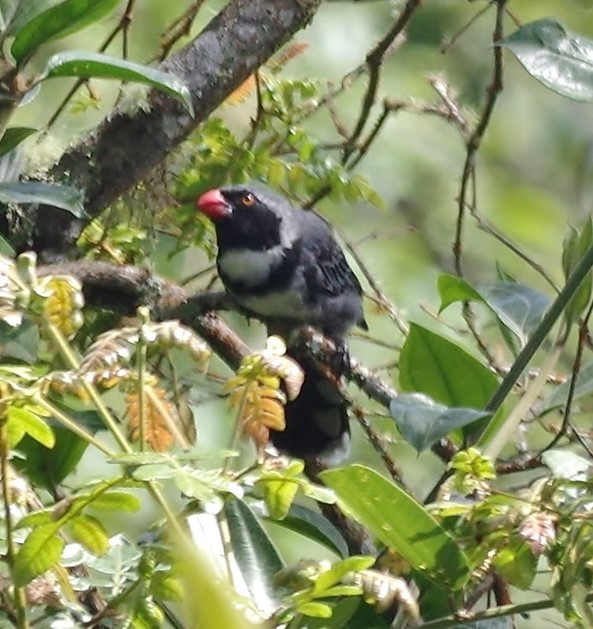
Wikipedia: Masked saltator Source: OTHER
Saltator_cinctus.jpg
![]() The masked saltator (Saltator cinctus) is a species passerine bird in the tanager family Thraupidae.
[more]
The masked saltator (Saltator cinctus) is a species passerine bird in the tanager family Thraupidae.
[more]
Profile Wikipedia eBird Xeno-Canto

Wikipedia: Black-winged saltator Source: OTHER
1200px-Saltator_atripennis_-Manizales%2C_Caldas%2C_Colombia-8.jpg
![]() The black-winged saltator (Saltator atripennis) is a species of songbird found in Colombia and Ecuador. Its natural habitat is subtropical or tropical moist montane forests. While saltators were traditionally placed in the family Cardinalidae, they are now placed in the tanager family Thraupidae.
[more]
The black-winged saltator (Saltator atripennis) is a species of songbird found in Colombia and Ecuador. Its natural habitat is subtropical or tropical moist montane forests. While saltators were traditionally placed in the family Cardinalidae, they are now placed in the tanager family Thraupidae.
[more]
Profile Wikipedia eBird Xeno-Canto

Wikipedia: Black-cowled saltator Source: OTHER
1200px-Black-CowledSaltator.jpg
![]() The black-cowled saltator (Saltator nigriceps) is a seed-eating passerine bird in the tanager family Thraupidae. It is found in the southern border region of Ecuador and the northern border region of Peru. Its natural habitats are subtropical or tropical dry forests and subtropical or tropical moist lowland forests.
[more]
The black-cowled saltator (Saltator nigriceps) is a seed-eating passerine bird in the tanager family Thraupidae. It is found in the southern border region of Ecuador and the northern border region of Peru. Its natural habitats are subtropical or tropical dry forests and subtropical or tropical moist lowland forests.
[more]
Blue gray tanager. 2020-02-18 09.21.16 Panama
First observed in Costa Rica on 2018-02-27.
We saw this on the grounds of Gamboa Rainforest Resort.
General: ![]() The blue-gray tanager (Thraupis episcopus) is a medium-sized South American songbird of the tanager family, Thraupidae. Its range is from Mexico south to northeast Bolivia and northern Brazil, all of the Amazon Basin, except the very south. It has been introduced to Lima (Peru). On Trinidad and Tobago, this bird is called blue jean.
[more]
The blue-gray tanager (Thraupis episcopus) is a medium-sized South American songbird of the tanager family, Thraupidae. Its range is from Mexico south to northeast Bolivia and northern Brazil, all of the Amazon Basin, except the very south. It has been introduced to Lima (Peru). On Trinidad and Tobago, this bird is called blue jean.
[more]
Zoom one golden-hooded tanager on telephone wire. 2020-02-18 10.52.28
First observed in Costa Rica on 2018-02-27.
We saw this on a nature tour on the grounds of Gamboa Rainforest Resort. I noted it as a honeycreeper, which it is not - not sure if my mistake or the guide's.
General: ![]() The golden-hooded tanager (Stilpnia larvata) is a medium-sized passerine bird. This tanager is a resident breeder from southern Mexico south to western Ecuador.
[more]
The golden-hooded tanager (Stilpnia larvata) is a medium-sized passerine bird. This tanager is a resident breeder from southern Mexico south to western Ecuador.
[more]
Profile Wikipedia eBird Xeno-Canto

Wikipedia: Bay-headed tanager Source: OTHER
1200px-Tangara_gyrola_-Manizales%2C_Caldas%2C_Colombia-8_%282%29.jpg
![]() The bay-headed tanager (Tangara gyrola) is a medium-sized passerine bird. This tanager is a resident breeder in Costa Rica, Panama, South America south to Ecuador, Bolivia and southern Brazil, and on Trinidad.
[more]
The bay-headed tanager (Tangara gyrola) is a medium-sized passerine bird. This tanager is a resident breeder in Costa Rica, Panama, South America south to Ecuador, Bolivia and southern Brazil, and on Trinidad.
[more]
Profile Wikipedia eBird Xeno-Canto

Wikipedia: Rufous-winged tanager Source: OTHER
1200px-Rufous-winged_tanager.jpg
![]() The rufous-winged tanager (Tangara lavinia) is a species of bird in the family Thraupidae. It is found in Colombia, Costa Rica, Ecuador, Honduras, Nicaragua, and Panama. Its natural habitats are subtropical or tropical moist lowland forests and heavily degraded former forest.
[more]
The rufous-winged tanager (Tangara lavinia) is a species of bird in the family Thraupidae. It is found in Colombia, Costa Rica, Ecuador, Honduras, Nicaragua, and Panama. Its natural habitats are subtropical or tropical moist lowland forests and heavily degraded former forest.
[more]
Profile Wikipedia eBird Xeno-Canto

Wikipedia: Emerald tanager Source: OTHER
Emerald_Tanager_-_San_Luis_-_Costa_Rica_MG_1694_%2826584929732%29.jpg
![]() The emerald tanager (Tangara florida) is a species of bird in the family Thraupidae.
It is found in Colombia, Costa Rica, Ecuador, and Panama.
Its natural habitats are subtropical or tropical moist lowland forests and subtropical or tropical moist montane forests.
[more]
The emerald tanager (Tangara florida) is a species of bird in the family Thraupidae.
It is found in Colombia, Costa Rica, Ecuador, and Panama.
Its natural habitats are subtropical or tropical moist lowland forests and subtropical or tropical moist montane forests.
[more]

Wikipedia: Silver-throated tanager Source: OTHER
1200px-Silver-throated_tanager_%28Tangara_icterocephala%29.jpg
![]() The silver-throated tanager (Tangara icterocephala) is a small passerine bird. This brightly coloured tanager is a resident from Costa Rica, through Panama and western Colombia, to western Ecuador.
[more]
The silver-throated tanager (Tangara icterocephala) is a small passerine bird. This brightly coloured tanager is a resident from Costa Rica, through Panama and western Colombia, to western Ecuador.
[more]
Profile Wikipedia eBird Xeno-Canto
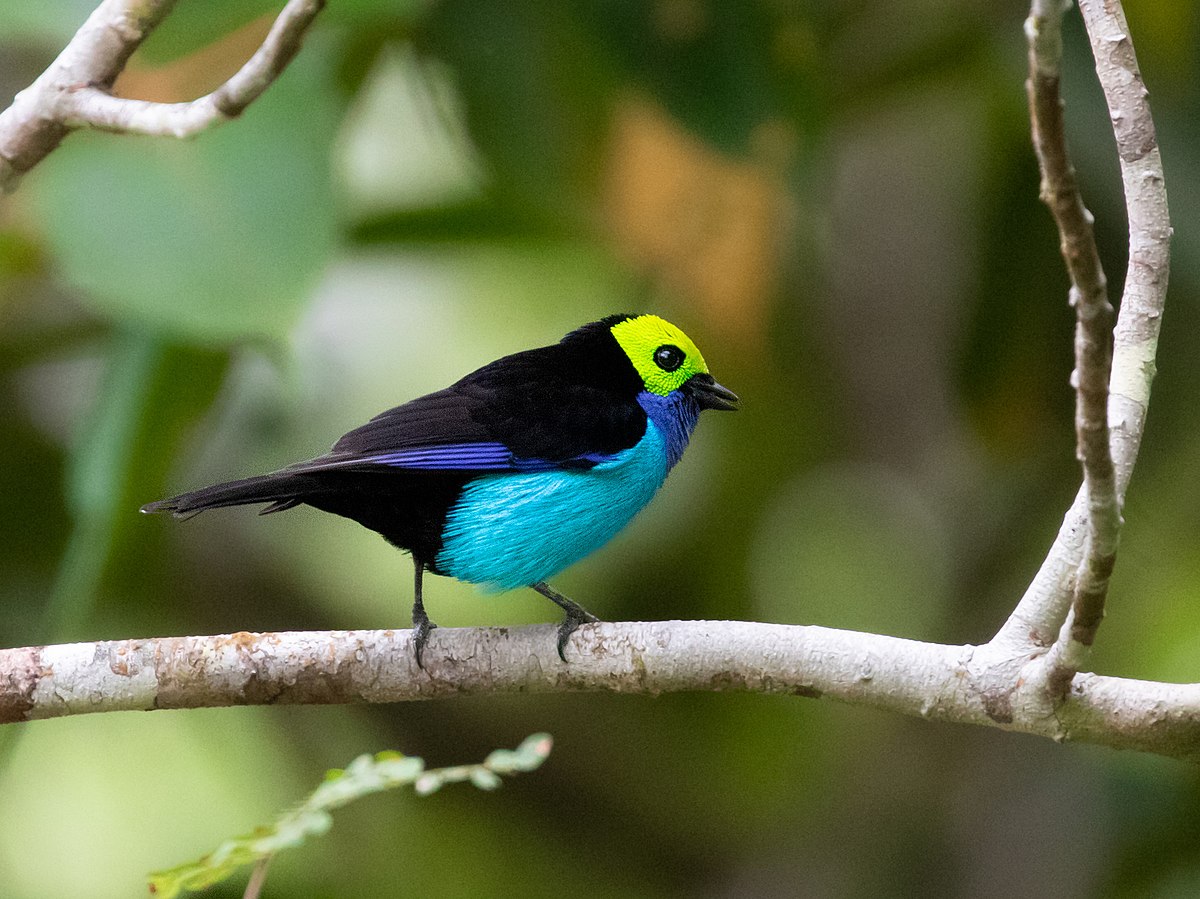
Wikipedia: Paradise tanager Source: OTHER
1200px-Tangara_chilensis_94893412.jpg
![]() The paradise tanager (Tangara chilensis) is a brilliantly multicolored, medium-sized songbird whose length varies between 13.5 and 15 cm. It has a light green head, sky blue underparts and black upper body plumage. Depending on subspecies, the behind is yellow and red or all red. The beak is black and the legs are grey. it is from the amazon rainforest.
[more]
The paradise tanager (Tangara chilensis) is a brilliantly multicolored, medium-sized songbird whose length varies between 13.5 and 15 cm. It has a light green head, sky blue underparts and black upper body plumage. Depending on subspecies, the behind is yellow and red or all red. The beak is black and the legs are grey. it is from the amazon rainforest.
[more]
Profile Wikipedia eBird Xeno-Canto

Wikipedia: Metallic-green tanager Source: OTHER
1200px-Metallic-green_Tanager_JCB.jpg
![]() The metallic-green tanager (Tangara labradorides) is a species of bird in the family Thraupidae.
[more]
The metallic-green tanager (Tangara labradorides) is a species of bird in the family Thraupidae.
[more]
Profile Wikipedia eBird Xeno-Canto

Wikipedia: Opal-crowned tanager Source: OTHER
1200px-Tangara_callophrys_-_Opal-crowned_Tanager%3B_Serra_do_Divisor_National_Park%2C_Acre%2C_Brazil.jpg
![]() The opal-crowned tanager (Tangara callophrys) is a species of bird in the family Thraupidae, the tanagers. It is one of 49 species in the genus Tangara.
[more]
The opal-crowned tanager (Tangara callophrys) is a species of bird in the family Thraupidae, the tanagers. It is one of 49 species in the genus Tangara.
[more]
Profile Wikipedia eBird Xeno-Canto

Wikipedia: Blue-browed tanager Source: OTHER
1200px-Tangara_cyanotis_-_Blue-browed_Tanager_%28cropped%29.jpg
![]() The blue-browed tanager (Tangara cyanotis) is a species of bird in the family Thraupidae.
It is found in Bolivia, Colombia, Ecuador, and Peru.
Its natural habitat is subtropical or tropical moist montane forests.
[more]
The blue-browed tanager (Tangara cyanotis) is a species of bird in the family Thraupidae.
It is found in Bolivia, Colombia, Ecuador, and Peru.
Its natural habitat is subtropical or tropical moist montane forests.
[more]
Profile Wikipedia eBird Xeno-Canto

Wikipedia: Blue-and-black tanager Source: OTHER
Tangara_vassorii_by_Francesco_Veronesi.jpg
![]() The blue-and-black tanager (Tangara vassorii) is a species of bird in the family Thraupidae.
[more]
The blue-and-black tanager (Tangara vassorii) is a species of bird in the family Thraupidae.
[more]
Profile Wikipedia eBird Xeno-Canto

Wikipedia: Turquoise tanager Source: OTHER
Sa%C3%ADra-de-bando.jpg
![]() The turquoise tanager (Tangara mexicana) is a medium-sized passerine bird in the tanager family Thraupidae. It is a resident bird from Trinidad, Colombia and Venezuela south to Bolivia and much of Brazil (despite its scientific name, it is not found in Mexico). It is restricted to areas with humid forest, with its primary distribution being the Amazon, while a disjunct population occurs in the Atlantic Forest of eastern Brazil. The latter population is sometimes considered a separate species, the white-bellied tanager (Tangara brasiliensis) .
[more]
The turquoise tanager (Tangara mexicana) is a medium-sized passerine bird in the tanager family Thraupidae. It is a resident bird from Trinidad, Colombia and Venezuela south to Bolivia and much of Brazil (despite its scientific name, it is not found in Mexico). It is restricted to areas with humid forest, with its primary distribution being the Amazon, while a disjunct population occurs in the Atlantic Forest of eastern Brazil. The latter population is sometimes considered a separate species, the white-bellied tanager (Tangara brasiliensis) .
[more]
Profile Wikipedia eBird Xeno-Canto

Wikipedia: Flame-faced tanager Source: OTHER
1200px-Flame-faced_Tanager_%2847050446254%29.jpg
![]() The flame-faced tanager (Tangara parzudakii) is a species of bird in the family Thraupidae.
It is found in the eastern Andes of Colombia, Ecuador, Peru and Venezuela.
Its natural habitat is subtropical or tropical moist montane forests.
[more]
The flame-faced tanager (Tangara parzudakii) is a species of bird in the family Thraupidae.
It is found in the eastern Andes of Colombia, Ecuador, Peru and Venezuela.
Its natural habitat is subtropical or tropical moist montane forests.
[more]
Profile Wikipedia eBird Xeno-Canto

Wikipedia: Golden tanager Source: OTHER
1200px-Tangara_arthus_-_T%C3%A1ngara_dorada_-_Golden_Tanager_%288542820434%29.jpg
![]() The golden tanager (Tangara arthus) is a species of bird in the family Thraupidae. It is widespread and often common in highland forests of the Andes (from Bolivia and northwards) and Venezuelan Coastal Range in north-western South America.
[more]
The golden tanager (Tangara arthus) is a species of bird in the family Thraupidae. It is widespread and often common in highland forests of the Andes (from Bolivia and northwards) and Venezuelan Coastal Range in north-western South America.
[more]
Profile Wikipedia eBird Xeno-Canto

Wikipedia: Golden-eared tanager Source: OTHER
1200px-Golden-eared-tanager.jpg
![]() The golden-eared tanager (Tangara chrysotis) is a species of bird in the family Thraupidae (tanagers).
[more]
The golden-eared tanager (Tangara chrysotis) is a species of bird in the family Thraupidae (tanagers).
[more]
Profile Wikipedia eBird Xeno-Canto
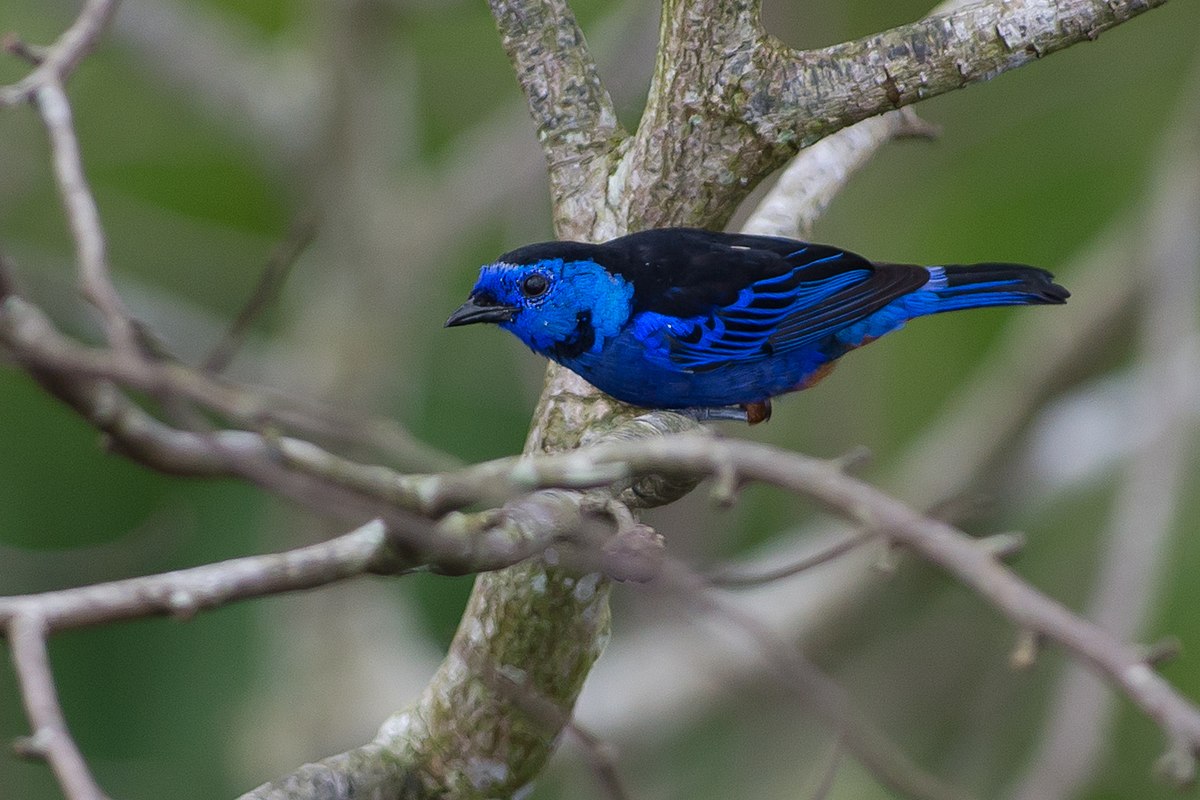
Wikipedia: Opal-rumped tanager Source: OTHER
1200px-Tangara_velia_Opal-rumped_Tanager.jpg
![]() The opal-rumped tanager (Tangara velia) is a species of bird in the family Thraupidae. It is found in the Amazon and Atlantic Forest of South America. The population of the Atlantic Forest has a far paler chest than the other populations, and has often been considered a separate species as the silvery-breasted tanager (Tangara cyanomelas). Today most authorities treat it as a subspecies of the opal-rumped tanager.
[more]
The opal-rumped tanager (Tangara velia) is a species of bird in the family Thraupidae. It is found in the Amazon and Atlantic Forest of South America. The population of the Atlantic Forest has a far paler chest than the other populations, and has often been considered a separate species as the silvery-breasted tanager (Tangara cyanomelas). Today most authorities treat it as a subspecies of the opal-rumped tanager.
[more]
Profile Wikipedia eBird Xeno-Canto

Wikipedia: Blue-whiskered tanager Source: OTHER
1200px-TangaraJohannaeKeulemans.jpg
![]() The blue-whiskered tanager (Tangara johannae) is a species of bird in the family Thraupidae.
It is found in the Chocó of Colombia and Ecuador.
Its natural habitat is subtropical or tropical moist lowland forests.
It is threatened by habitat loss.
[more]
The blue-whiskered tanager (Tangara johannae) is a species of bird in the family Thraupidae.
It is found in the Chocó of Colombia and Ecuador.
Its natural habitat is subtropical or tropical moist lowland forests.
It is threatened by habitat loss.
[more]
Profile Wikipedia eBird Xeno-Canto

Wikipedia: Beryl-spangled tanager Source: OTHER
1200px-Tangara_nigroviridis_T%C3%A1ngara_berlina_Beryl-spangled_Tanager_%2814996504381%29_%28cropped%29.jpg
![]() The beryl-spangled tanager (Tangara nigroviridis) is a small songbird of the northern Andes.
[more]
The beryl-spangled tanager (Tangara nigroviridis) is a small songbird of the northern Andes.
[more]
Profile Wikipedia eBird Xeno-Canto

Wikipedia: Green-and-gold tanager Source: OTHER
Green-and-gold_Tanager_-_South_Ecuador_S4E0470_%2822856239437%29.jpg
![]() The green-and-gold tanager (Tangara schrankii) is a species of bird in the family Thraupidae, the tanagers. It is one of 49 species in the genus Tangara.
[more]
The green-and-gold tanager (Tangara schrankii) is a species of bird in the family Thraupidae, the tanagers. It is one of 49 species in the genus Tangara.
[more]
Profile Wikipedia eBird Xeno-Canto

Wikipedia: Saffron-crowned tanager Source: OTHER
1200px-Saffron-crowned_Tanager_%28Tangara_xanthocephala%29.jpg
![]() The saffron-crowned tanager (Tangara xanthocephala) is a species of bird in the family Thraupidae.
It is found in the northern Andes of Bolivia, Colombia, Ecuador, Peru, and Venezuela.
Its natural habitats are subtropical or tropical moist montane forests and heavily degraded former forest.
[more]
The saffron-crowned tanager (Tangara xanthocephala) is a species of bird in the family Thraupidae.
It is found in the northern Andes of Bolivia, Colombia, Ecuador, Peru, and Venezuela.
Its natural habitats are subtropical or tropical moist montane forests and heavily degraded former forest.
[more]
Arenal feeder palm tanager. 2018-02-27 12.23.14 Costa Rica
First observed in Costa Rica on 2018-02-27.
![]() The palm tanager (Thraupis palmarum) is a medium-sized passerine bird. This tanager is a resident breeder from Nicaragua south to Bolivia, Paraguay and southern Brazil.[2][3] It also breeds on Trinidad and, since 1962, on Tobago. In Trinidad and Tobago, it is known by colloquial names such as the "palmiste" and the "green jean".[4]
[more]
The palm tanager (Thraupis palmarum) is a medium-sized passerine bird. This tanager is a resident breeder from Nicaragua south to Bolivia, Paraguay and southern Brazil.[2][3] It also breeds on Trinidad and, since 1962, on Tobago. In Trinidad and Tobago, it is known by colloquial names such as the "palmiste" and the "green jean".[4]
[more]

Wikipedia: Black-chinned mountain-tanager Source: OTHER
Anisognathus_notabilis_-Ecuador-8.jpg
Ecuador
![]() The black-chinned mountain tanager (Anisognathus notabilis) is a species of bird in the family Thraupidae.
It is found in Colombia and Ecuador.
Its natural habitat is subtropical or tropical moist montane forests.
[more]
The black-chinned mountain tanager (Anisognathus notabilis) is a species of bird in the family Thraupidae.
It is found in Colombia and Ecuador.
Its natural habitat is subtropical or tropical moist montane forests.
[more]

Wikipedia: Blue-winged mountain-tanager Source: OTHER
1200px-Blue-winged_Mountain-tanager_Ecuador_1357a.jpg
![]() The blue-winged mountain tanager (Anisognathus somptuosus) is a species of bird in the family Thraupidae, the tanagers. It is found in highland forest and woodland in the Andes of Bolivia, Colombia, Ecuador, Peru and Venezuela, as well as a disjunct population in the Venezuelan Coastal Range. It is a common species and its populations appear to be stable.[1] It is generally bright yellow and black with blue to the wings and tail; some populations have a moss-green back.[2] In Bolivia and southernmost Peru, the rump is blue and the voice is very different;[2] this population is sometimes recognized as a separate species, the Bolivian mountain tanager (A. flavinucha).[3]
[more]
The blue-winged mountain tanager (Anisognathus somptuosus) is a species of bird in the family Thraupidae, the tanagers. It is found in highland forest and woodland in the Andes of Bolivia, Colombia, Ecuador, Peru and Venezuela, as well as a disjunct population in the Venezuelan Coastal Range. It is a common species and its populations appear to be stable.[1] It is generally bright yellow and black with blue to the wings and tail; some populations have a moss-green back.[2] In Bolivia and southernmost Peru, the rump is blue and the voice is very different;[2] this population is sometimes recognized as a separate species, the Bolivian mountain tanager (A. flavinucha).[3]
[more]

Wikipedia: Lacrimose mountain-tanager Source: OTHER
1200px-Anisognathus_lacrymosus_-_Tangara_lacrimosa_-_Lachrymose_Mountain-Tanager_%288729291521%29.jpg
![]() The lacrimose mountain tanager (Anisognathus lacrymosus) is a species of bird in the family Thraupidae. It is found in Andean highland forest from Venezuela, through Colombia and Ecuador, to Peru. Some of its 11 subspecies are quite distinctive and A. l. yariguierum was only scientifically described in 2010.[2][3]
[more]
The lacrimose mountain tanager (Anisognathus lacrymosus) is a species of bird in the family Thraupidae. It is found in Andean highland forest from Venezuela, through Colombia and Ecuador, to Peru. Some of its 11 subspecies are quite distinctive and A. l. yariguierum was only scientifically described in 2010.[2][3]
[more]
Profile Wikipedia eBird Xeno-Canto

Wikipedia: Scarlet-bellied mountain-tanager Source: OTHER
Anisognathus_igniventris_by_Francesco_Veronesi.jpg
![]() The scarlet-bellied mountain tanager (Anisognathus igniventris) is a species of bird in the family Thraupidae. It is found in
[more]
The scarlet-bellied mountain tanager (Anisognathus igniventris) is a species of bird in the family Thraupidae. It is found in
[more]
Profile Wikipedia eBird Xeno-Canto

Wikipedia: Hooded mountain-tanager Source: OTHER
Buthraupis_montana_Hooded_Mountain_Tanager%2C_Puno%2C_Peru_%28cropped%29.jpg
![]() The hooded mountain tanager (Buthraupis montana) is a species of bird in the tanager family Thraupidae. It is the only member of the genus Buthraupis. This yellow, blue and black tanager is found in forest, woodland and shrub in the Andean highlands of Bolivia, Colombia, Ecuador, Peru, and Venezuela. At 23 centimetres (9.1 in) and 85 grams (3.0 oz), it is one of the largest tanagers (second in weight only to the white-capped tanager).
[more]
The hooded mountain tanager (Buthraupis montana) is a species of bird in the tanager family Thraupidae. It is the only member of the genus Buthraupis. This yellow, blue and black tanager is found in forest, woodland and shrub in the Andean highlands of Bolivia, Colombia, Ecuador, Peru, and Venezuela. At 23 centimetres (9.1 in) and 85 grams (3.0 oz), it is one of the largest tanagers (second in weight only to the white-capped tanager).
[more]
Profile Wikipedia eBird Xeno-Canto

Wikipedia: Vermilion tanager Source: OTHER
1200px-Calochaetes_coccineus_-_Vermilion_Tanager_%28cropped%29.jpg
![]() The vermilion tanager (Calochaetes coccineus) is a species of Neotropical bird in the tanager family Thraupidae. It is the only member of its genus Calochaetes.
[more]
The vermilion tanager (Calochaetes coccineus) is a species of Neotropical bird in the tanager family Thraupidae. It is the only member of its genus Calochaetes.
[more]
Profile Wikipedia eBird Xeno-Canto

Wikipedia: Glistening-green tanager Source: OTHER
1200px-Glistening-green_Tanager.jpeg
![]() The glistening-green tanager (Chlorochrysa phoenicotis) is a species of bird in the family Thraupidae. It is found in Colombia and Ecuador.
[more]
The glistening-green tanager (Chlorochrysa phoenicotis) is a species of bird in the family Thraupidae. It is found in Colombia and Ecuador.
[more]
Profile Wikipedia eBird Xeno-Canto

Wikipedia: Orange-eared tanager Source: OTHER
1200px-Chlorochrysa_calliparaea.jpg
![]() The orange-eared tanager (Chlorochrysa calliparaea) is a species of bird in the family Thraupidae.
It is found in Bolivia, Colombia, Ecuador, Peru, and Venezuela.
Its natural habitat is subtropical or tropical moist montane forests.
[more]
The orange-eared tanager (Chlorochrysa calliparaea) is a species of bird in the family Thraupidae.
It is found in Bolivia, Colombia, Ecuador, Peru, and Venezuela.
Its natural habitat is subtropical or tropical moist montane forests.
[more]
Profile Wikipedia eBird Xeno-Canto
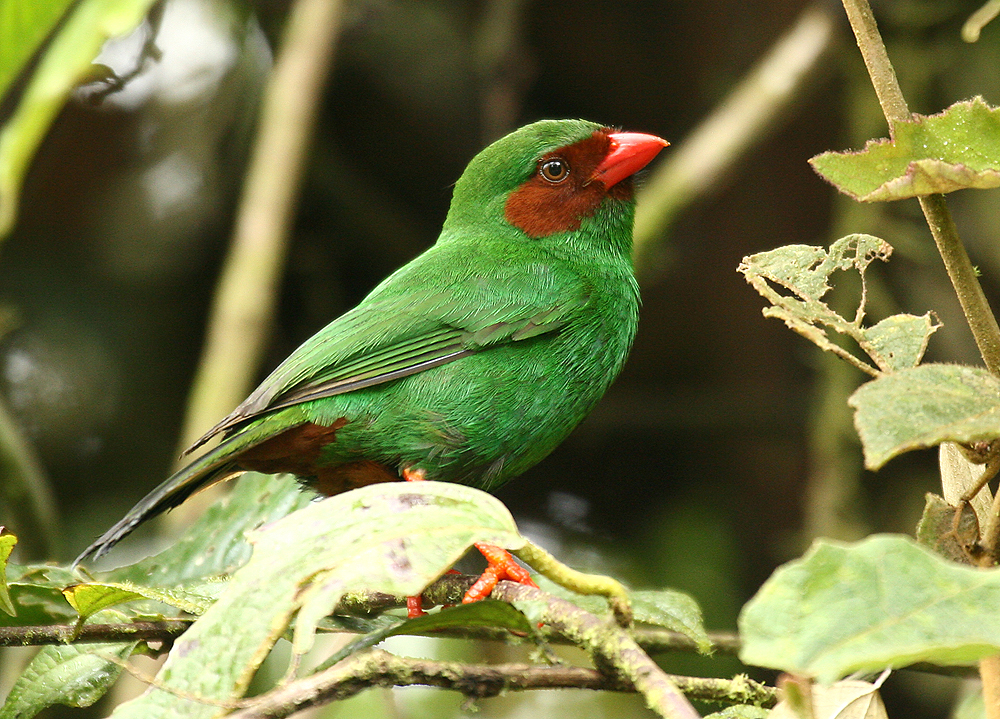
Wikipedia: Grass-green tanager Source: OTHER
Chlorornis_riefferii.jpg
![]() The grass-green tanager (Chlorornis riefferii) is a small South America bird in the tanager family Thraupidae. It is the only member of the genus Chlorornis.
[more]
The grass-green tanager (Chlorornis riefferii) is a small South America bird in the tanager family Thraupidae. It is the only member of the genus Chlorornis.
[more]

Wikipedia: Magpie tanager Source: OTHER
Magpie_Tanager_-_Manu_NP_-_Per%C3%B9_8577_%2822954466240%29.jpg
![]() The magpie tanager (Cissopis leverianus) is a South American species of tanager. It is the only member of the monotypic genus Cissopis. As suggested by its common name, this blue-black and white species is superficially reminiscent of a European magpie. With a total length of 25–30 centimetres (9.8–11.8 in), a large percentage of which is tail, it is the longest species of tanager. It weighs 69–76 grams (2.4–2.7 oz).
[more]
The magpie tanager (Cissopis leverianus) is a South American species of tanager. It is the only member of the monotypic genus Cissopis. As suggested by its common name, this blue-black and white species is superficially reminiscent of a European magpie. With a total length of 25–30 centimetres (9.8–11.8 in), a large percentage of which is tail, it is the longest species of tanager. It weighs 69–76 grams (2.4–2.7 oz).
[more]
Profile Wikipedia eBird Xeno-Canto

Wikipedia: Buff-breasted mountain-tanager Source: OTHER
Dubusia_taeniata_imported_from_iNaturalist_photo_42811486_on_1_December_2019.jpg
![]() The buff-breasted mountain tanager (Dubusia taeniata) is a species of Neotropical bird in the tanager family Thraupidae.
[more]
The buff-breasted mountain tanager (Dubusia taeniata) is a species of Neotropical bird in the tanager family Thraupidae.
[more]
Profile Wikipedia eBird Xeno-Canto

Wikipedia: Golden-crowned tanager Source: OTHER
Iridosornis_rufivertex.jpg
![]() The golden-crowned tanager (Iridosornis rufivertex) is a species of bird in the family Thraupidae.
[more]
The golden-crowned tanager (Iridosornis rufivertex) is a species of bird in the family Thraupidae.
[more]

Wikipedia: Purplish-mantled tanager Source: OTHER
Purplish-mantled_Tanager_-_Colombia_S4E9634_%2822856163507%29.jpg
![]() The purplish-mantled tanager (Iridosornis porphyrocephalus) is a species of bird in the family Thraupidae.
It is found in Colombia and Ecuador.
Its natural habitats are subtropical or tropical moist montane forests and heavily degraded former forest.
It is threatened by habitat loss.
[more]
The purplish-mantled tanager (Iridosornis porphyrocephalus) is a species of bird in the family Thraupidae.
It is found in Colombia and Ecuador.
Its natural habitats are subtropical or tropical moist montane forests and heavily degraded former forest.
It is threatened by habitat loss.
[more]
Profile Wikipedia eBird Xeno-Canto

Wikipedia: Yellow-throated tanager Source: OTHER
1200px-Iridosornis_analis_-NBII_Image_Gallery-a00213.jpg
![]() The yellow-throated tanager (Iridosornis analis) is a species of bird in the family Thraupidae.
It is found in Colombia, Ecuador, and Peru.
Its natural habitat is subtropical or tropical moist montane forests.
[more]
The yellow-throated tanager (Iridosornis analis) is a species of bird in the family Thraupidae.
It is found in Colombia, Ecuador, and Peru.
Its natural habitat is subtropical or tropical moist montane forests.
[more]
Profile Wikipedia eBird Xeno-Canto

Wikipedia: Fawn-breasted tanager Source: OTHER
Pipraeidea_melanonota%2C_Sa%C3%ADra-vi%C3%BAva%2C_Fawn-breasted_Tanager.jpg
![]() The fawn-breasted tanager (Pipraeidea melanonota) is a species of tanager with a blue head and yellow breast. It occurs in the Andes of northwestern Argentina, Bolivia, Colombia, Ecuador, Peru and Venezuela, as well as in the highlands of northeastern Argentina, south Brazil, Paraguay and Uruguay.
[more]
The fawn-breasted tanager (Pipraeidea melanonota) is a species of tanager with a blue head and yellow breast. It occurs in the Andes of northwestern Argentina, Bolivia, Colombia, Ecuador, Peru and Venezuela, as well as in the highlands of northeastern Argentina, south Brazil, Paraguay and Uruguay.
[more]
Profile Wikipedia eBird Xeno-Canto
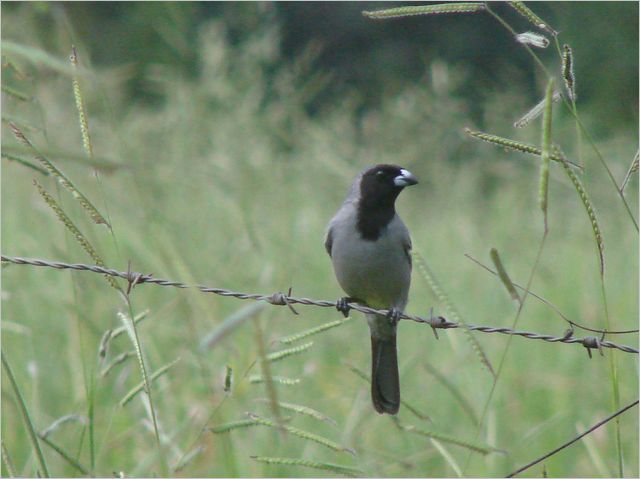
Wikipedia: Black-faced tanager Source: OTHER
Black-faced_tanager.jpg
![]() The black-faced tanager (Schistochlamys melanopis) is a species of bird in the family Thraupidae.
[more]
The black-faced tanager (Schistochlamys melanopis) is a species of bird in the family Thraupidae.
[more]
Profile Wikipedia eBird Xeno-Canto

Wikipedia: Red-capped cardinal Source: OTHER
1200px-Thraupidae_-_Paroaria_gularis.JPG
![]() The red-capped cardinal (Paroaria gularis) is a small South American bird. It belongs to Paroaria, a genus in the tanager family Thraupidae.
[more]
The red-capped cardinal (Paroaria gularis) is a small South American bird. It belongs to Paroaria, a genus in the tanager family Thraupidae.
[more]
Profile Wikipedia eBird Xeno-Canto
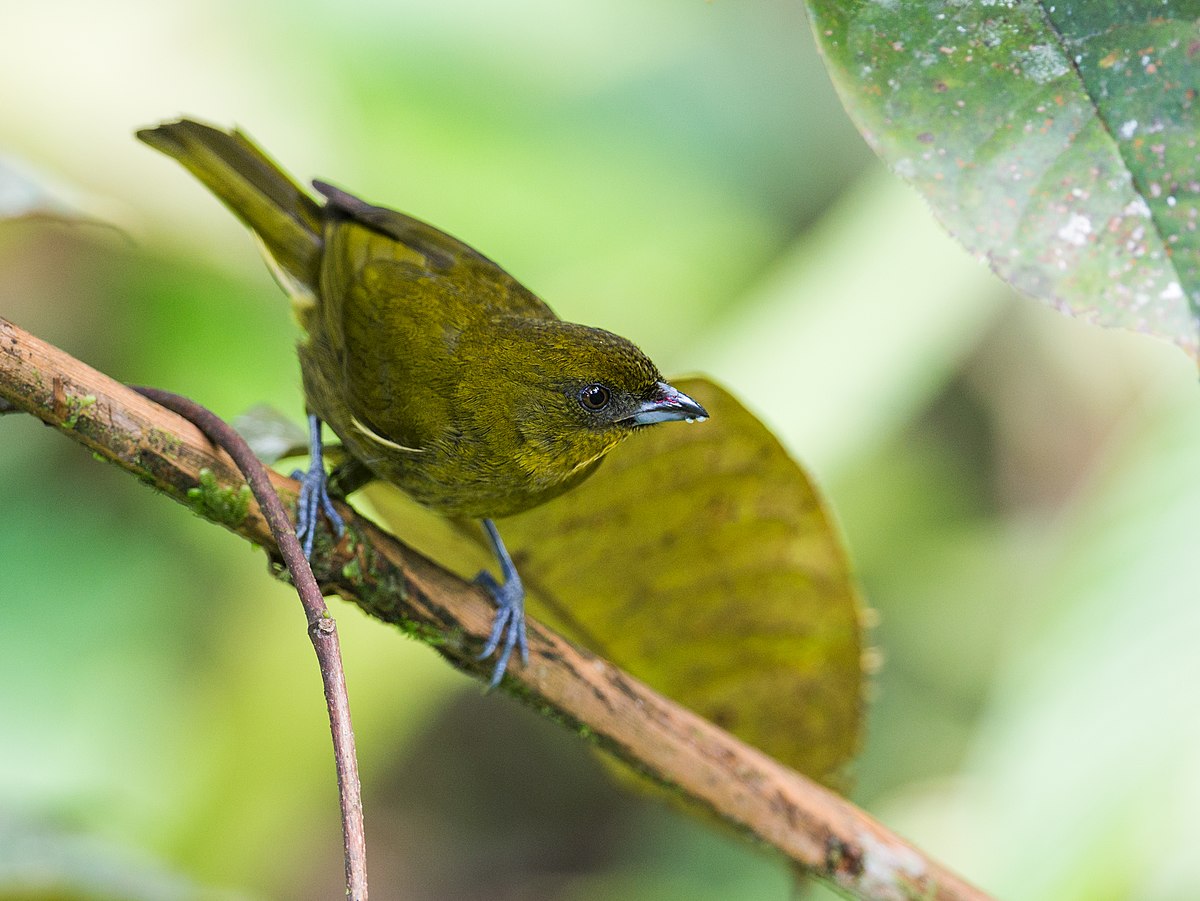
Wikipedia: Yellow-green tanager Source: OTHER
1200px-Bangsia_flavovirens_-_Yellow-green_Tanager_2_%28cropped%29.jpg
![]() The yellow-green tanager (Bangsia flavovirens) is a species of bird in the family Thraupidae.[1][2] It is also known as the yellow-green bush tanager as it was formerly place in the genus Chlorospingus with other bush tanagers. The whole genus was moved to the New World sparrow family Passerellidae when bush tanagers were found to be more closely related to the genus Arremonops. However, recent molecular analysis has discovered that this species is neither a bush tanager or sparrow and the species returned to Thraupidae and placed in the genus Bangsia.[3] It is found in Colombia and Ecuador.
Its natural habitats are subtropical or tropical moist lowland forest and subtropical or tropical moist montane forest.
It is threatened by habitat loss[1]
[more]
The yellow-green tanager (Bangsia flavovirens) is a species of bird in the family Thraupidae.[1][2] It is also known as the yellow-green bush tanager as it was formerly place in the genus Chlorospingus with other bush tanagers. The whole genus was moved to the New World sparrow family Passerellidae when bush tanagers were found to be more closely related to the genus Arremonops. However, recent molecular analysis has discovered that this species is neither a bush tanager or sparrow and the species returned to Thraupidae and placed in the genus Bangsia.[3] It is found in Colombia and Ecuador.
Its natural habitats are subtropical or tropical moist lowland forest and subtropical or tropical moist montane forest.
It is threatened by habitat loss[1]
[more]

Wikipedia: Moss-backed tanager Source: OTHER
1200px-Moss-backed_Tanager_%2815742706581%29.jpg
![]() The moss-backed tanager (Bangsia edwardsi) is a species of bird in the family Thraupidae.
It is found in Colombia and Ecuador.
Its natural habitats are subtropical or tropical moist lowland forests and subtropical or tropical moist montane forests.
[more]
The moss-backed tanager (Bangsia edwardsi) is a species of bird in the family Thraupidae.
It is found in Colombia and Ecuador.
Its natural habitats are subtropical or tropical moist lowland forests and subtropical or tropical moist montane forests.
[more]

Wikipedia: Golden-chested tanager Source: OTHER
1200px-Bangsia_rothschildi_1897.jpg
![]() The golden-chested tanager (Bangsia rothschildi) is a species of bird in the family Thraupidae.
It is found in Colombia and Ecuador.
Its natural habitats are subtropical or tropical moist lowland forests and subtropical or tropical moist montane forests.
[more]
The golden-chested tanager (Bangsia rothschildi) is a species of bird in the family Thraupidae.
It is found in Colombia and Ecuador.
Its natural habitats are subtropical or tropical moist lowland forests and subtropical or tropical moist montane forests.
[more]
Profile Wikipedia eBird Xeno-Canto

Wikipedia: Orange-throated tanager Source: OTHER
Wetmorethraupis_sterrhopteron_-_Orange-throated_Tanager_%28cropped%29.jpg
![]() The orange-throated tanager (Wetmorethraupis sterrhopteron) is a species of bird in the tanager family Thraupidae that is found very locally in humid forests around the Ecuador-Peru border. As a species it is considered threatened. The orange-throated tanager is the only member of the genus Wetmorethraupis, named after the ornithologist Alexander Wetmore. It is closely related to members of the genus Bangsia.
[more]
The orange-throated tanager (Wetmorethraupis sterrhopteron) is a species of bird in the tanager family Thraupidae that is found very locally in humid forests around the Ecuador-Peru border. As a species it is considered threatened. The orange-throated tanager is the only member of the genus Wetmorethraupis, named after the ornithologist Alexander Wetmore. It is closely related to members of the genus Bangsia.
[more]
Ash-breasted sierra finch (Geospizopsis plebejus)
Profile Wikipedia eBird Xeno-Canto

Wikipedia: Ash-breasted sierra finch Source: OTHER
1200px-Ash-breasted_Sierra-Finch_%28Phrygilus_plebejus%29.jpg
![]() The ash-breasted sierra finch (Geospizopsis plebejus) is a species of bird in the family Thraupidae.
[more]
The ash-breasted sierra finch (Geospizopsis plebejus) is a species of bird in the family Thraupidae.
[more]
Plumbeous sierra finch (Geospizopsis unicolor)

Wikipedia: Plumbeous sierra finch Source: OTHER
1200px-Plumbeous_Sierra-finch.jpg
![]() The plumbeous sierra finch (Geospizopsis unicolor) is a species of bird in the family Thraupidae.
[more]
The plumbeous sierra finch (Geospizopsis unicolor) is a species of bird in the family Thraupidae.
[more]
Band-tailed sierra finch (Rhopospina alaudina)
Profile Wikipedia eBird Xeno-Canto
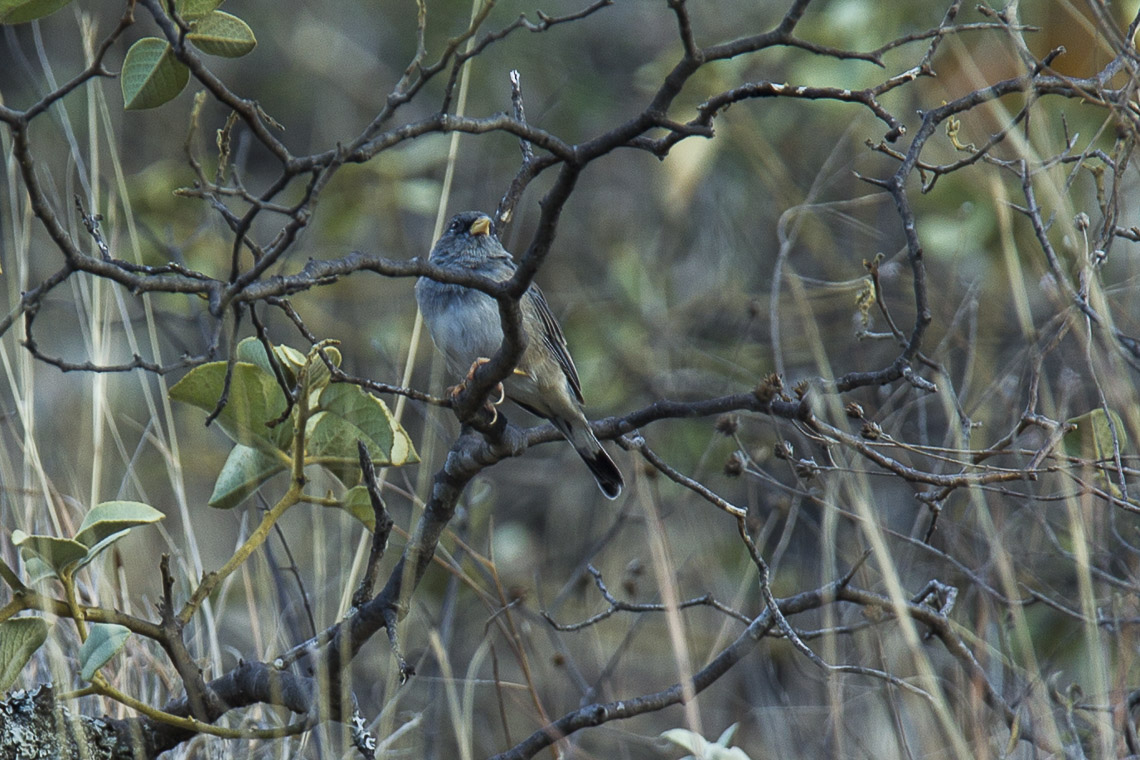
Wikipedia: Band-tailed sierra finch Source: OTHER
Band-tailed_Sierra_Finch.jpg
![]() The band-tailed sierra finch (Porphyrospiza alaudina) is a species of bird in the family Thraupidae and is found in Argentina, Bolivia, Chile, Ecuador, and Peru. Its natural habitats are subtropical or tropical dry shrubland and subtropical or tropical high-altitude shrubland.
[more]
The band-tailed sierra finch (Porphyrospiza alaudina) is a species of bird in the family Thraupidae and is found in Argentina, Bolivia, Chile, Ecuador, and Peru. Its natural habitats are subtropical or tropical dry shrubland and subtropical or tropical high-altitude shrubland.
[more]
Dull-colored grassquit (alternate) (Asemospiza obscura)
Rufous-collared sparrow (Zonotrichia capensis)
Rufous-collared sparrow. 2019-02-18 14.16.44 Patagonia
First observed in Costa Rica on 2018-02-26.
![]() The rufous-collared sparrow or Andean sparrow (Zonotrichia capensis) is an American sparrow found in a wide range of habitats, often near humans, from the extreme south-east of Mexico to Tierra del Fuego, and in the Caribbean, only on the island of Hispaniola (in both the Dominican Republic and Haiti). It is famous for its diverse vocalizations, which have been intensely studied since the 1970s, particularly by Paul Handford and Stephen C. Lougheed (UWO), Fernando Nottebohm (Rockefeller University) and Pablo Luis Tubaro (UBA). Local names for this bird include the Portuguese tico-tico, the Spanish chingolo, chincol and copetón, "tufted" in Colombia and comemaíz "corn eater" in Costa Rica.
[more]
The rufous-collared sparrow or Andean sparrow (Zonotrichia capensis) is an American sparrow found in a wide range of habitats, often near humans, from the extreme south-east of Mexico to Tierra del Fuego, and in the Caribbean, only on the island of Hispaniola (in both the Dominican Republic and Haiti). It is famous for its diverse vocalizations, which have been intensely studied since the 1970s, particularly by Paul Handford and Stephen C. Lougheed (UWO), Fernando Nottebohm (Rockefeller University) and Pablo Luis Tubaro (UBA). Local names for this bird include the Portuguese tico-tico, the Spanish chingolo, chincol and copetón, "tufted" in Colombia and comemaíz "corn eater" in Costa Rica.
[more]
Ashy-throated chlorospingus (Chlorospingus canigularis)
Profile Wikipedia eBird Xeno-Canto

Wikipedia: Ashy-throated chlorospingus Source: OTHER
Chlorospingus_canigularis.jpg
![]() The ashy-throated bush tanager (Chlorospingus canigularis) is a species of bird traditionally placed in the family Thraupidae, but perhaps closer to Arremonops in the Passerellidae.
It is found in Colombia, Costa Rica, Ecuador, Panama, Peru, and Venezuela.
Its natural habitats are subtropical or tropical dry forests, subtropical or tropical moist lowland forests, and subtropical or tropical moist montane forests.
[more]
The ashy-throated bush tanager (Chlorospingus canigularis) is a species of bird traditionally placed in the family Thraupidae, but perhaps closer to Arremonops in the Passerellidae.
It is found in Colombia, Costa Rica, Ecuador, Panama, Peru, and Venezuela.
Its natural habitats are subtropical or tropical dry forests, subtropical or tropical moist lowland forests, and subtropical or tropical moist montane forests.
[more]
Common chlorospingus (Chlorospingus flavopectus)
Profile Wikipedia eBird Xeno-Canto

Wikipedia: Common chlorospingus Source: OTHER
1200px-Common_bush_tanager_%28Chlorospingus_flavopectus_regionalis%29.jpg
![]() The common bush tanager (Chlorospingus flavopectus), also referred to as common chlorospingus, is a small passerine bird. It is a resident breeder in the highlands from central Mexico south to Bolivia and northwest Argentina. C. flavopectus in the loose sense is a notorious cryptic species complex, and several of the up to 25 subspecies recognized in recent times are likely to be distinct species. Some populations in fact appear to be more distinct than several other members of Chlorospingus.[2]
[more]
The common bush tanager (Chlorospingus flavopectus), also referred to as common chlorospingus, is a small passerine bird. It is a resident breeder in the highlands from central Mexico south to Bolivia and northwest Argentina. C. flavopectus in the loose sense is a notorious cryptic species complex, and several of the up to 25 subspecies recognized in recent times are likely to be distinct species. Some populations in fact appear to be more distinct than several other members of Chlorospingus.[2]
[more]
Yellow-throated chlorospingus (Chlorospingus flavigularis)
Profile Wikipedia eBird Xeno-Canto

Wikipedia: Yellow-throated chlorospingus Source: OTHER
1200px-Chlorospingus_flavigularis_-NBII_Image_Gallery-a00254.jpg
![]() The yellow-throated bush tanager (Chlorospingus flavigularis) is a species of bird traditionally placed in the family Thraupidae, but now closer to Arremonops in the Passerellidae. It is found in Bolivia, Colombia, Ecuador, Panama, and Peru.
[more]
The yellow-throated bush tanager (Chlorospingus flavigularis) is a species of bird traditionally placed in the family Thraupidae, but now closer to Arremonops in the Passerellidae. It is found in Bolivia, Colombia, Ecuador, Panama, and Peru.
[more]
Dusky chlorospingus (Chlorospingus semifuscus)
Profile Wikipedia eBird Xeno-Canto

Wikipedia: Dusky chlorospingus Source: OTHER
Dusky_Bush-Tanager_-_Ecuador_S4E5699_%2822856133227%29.jpg
![]() The dusky bush tanager (Chlorospingus semifuscus) is a species of bird traditionally placed in the family Thraupidae, but now viewed closer to Arremonops in the Passerellidae.
[more]
The dusky bush tanager (Chlorospingus semifuscus) is a species of bird traditionally placed in the family Thraupidae, but now viewed closer to Arremonops in the Passerellidae.
[more]
Short-billed chlorospingus (Chlorospingus parvirostris)
Profile Wikipedia eBird Xeno-Canto

Wikipedia: Short-billed chlorospingus Source: OTHER
1200px-Yellow-whiskeredBush-Tanager.jpg
![]() The yellow-whiskered bush tanager or short-billed bush-tanager (Chlorospingus parvirostris) is a species of bird traditionally placed in the family Thraupidae, but now viewed closer to Arremonops in the Passerellidae. It is found in Bolivia, Colombia, Ecuador, and Peru.
[more]
The yellow-whiskered bush tanager or short-billed bush-tanager (Chlorospingus parvirostris) is a species of bird traditionally placed in the family Thraupidae, but now viewed closer to Arremonops in the Passerellidae. It is found in Bolivia, Colombia, Ecuador, and Peru.
[more]
White-naped brush-finch (Atlapetes albinucha)

Wikipedia: White-naped brush-finch Source: OTHER
White-naped_Brush-Finch_-_Colombia_S4E3782_%2823309308051%29.jpg
![]() The white-naped brushfinch (Atlapetes albinucha), also known as the yellow-throated brush finch, is a species of bird in the family Passerellidae.
[more]
The white-naped brushfinch (Atlapetes albinucha), also known as the yellow-throated brush finch, is a species of bird in the family Passerellidae.
[more]
Bay-crowned brushfinch (Atlapetes seebohmi)
Wikipedia: Bay-crowned brushfinch Source: OTHER
Bay-crowned_Brushfinch.JPG
![]() The bay-crowned brushfinch (Atlapetes seebohmi) is a species of bird in the family Passerellidae.
[more]
The bay-crowned brushfinch (Atlapetes seebohmi) is a species of bird in the family Passerellidae.
[more]
White-winged brushfinch (Atlapetes leucopterus)

Wikipedia: White-winged brushfinch Source: OTHER
1200px-White-winged_Brush-Finch%2C_Tandayapa%2C_Ecuador_%285771791640%29.jpg
![]() The white-winged brushfinch (Atlapetes leucopterus) is a species of bird in the family Passerellidae.
[more]
The white-winged brushfinch (Atlapetes leucopterus) is a species of bird in the family Passerellidae.
[more]
Yellow-breasted brushfinch (Atlapetes latinuchus)
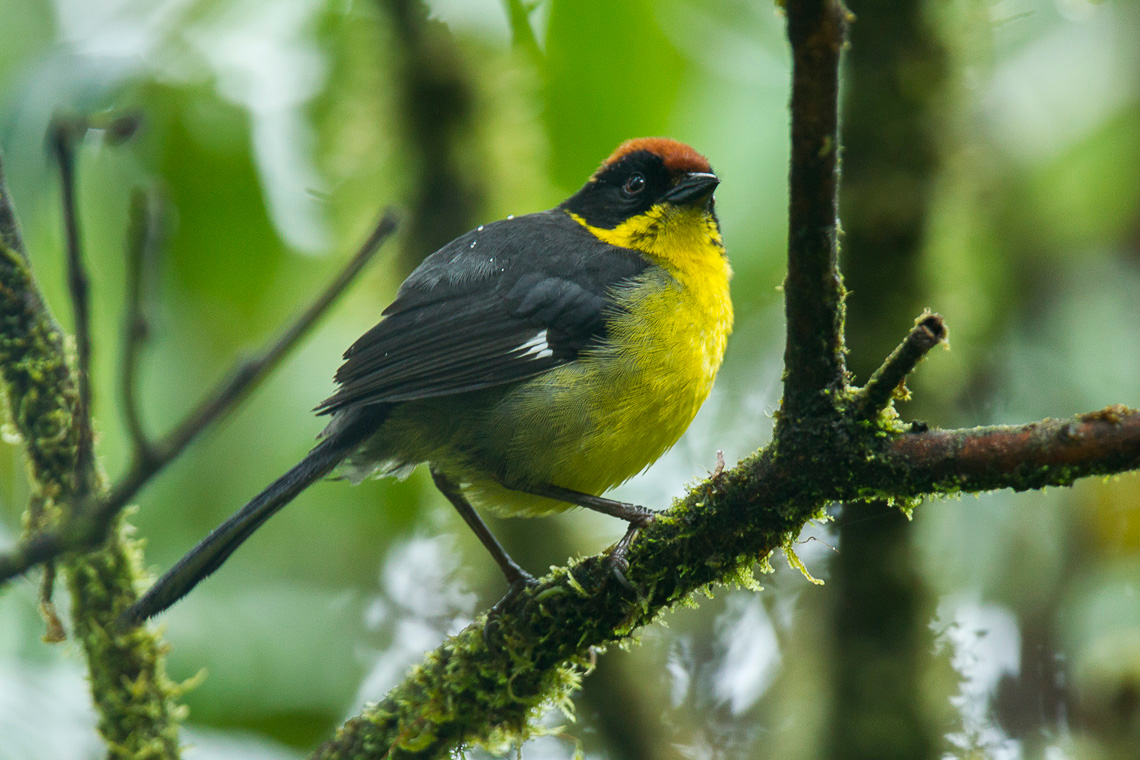
Wikipedia: Yellow-breasted brushfinch Source: OTHER
Rufous-naped_Brush-Finch_-_South_Ecuador_S4E1959_%2822764735833%29.jpg
![]() The yellow-breasted brushfinch (Atlapetes latinuchus), also known as the cloud-forest brushfinch, is a species of bird in the family Passerellidae. It is sometimes considered a subspecies of Atlapetes rufinucha.
[more]
The yellow-breasted brushfinch (Atlapetes latinuchus), also known as the cloud-forest brushfinch, is a species of bird in the family Passerellidae. It is sometimes considered a subspecies of Atlapetes rufinucha.
[more]
Pale-headed brush-finch (Atlapetes pallidiceps)

Wikipedia: Pale-headed brush-finch Source: OTHER
1200px-Atlapetes_pallidiceps_-NBII_Image_Gallery-a00258.jpg
![]() The pale-headed brushfinch (Atlapetes pallidiceps) is a species of bird in the family Passerellidae. It is endemic to arid areas with low scrub at altitudes of 1,650–1,800 m (5,410–5,910 ft) in south-central Ecuador.
[more]
The pale-headed brushfinch (Atlapetes pallidiceps) is a species of bird in the family Passerellidae. It is endemic to arid areas with low scrub at altitudes of 1,650–1,800 m (5,410–5,910 ft) in south-central Ecuador.
[more]
White-headed brushfinch (Atlapetes albiceps)

Wikipedia: White-headed brushfinch Source: OTHER
White-headed_Brush-Finch_-_South_Ecuador_S4E9179_%2822765143613%29.jpg
![]() The white-headed brushfinch (Atlapetes albiceps) is a species of bird in the family Passerellidae.
[more]
The white-headed brushfinch (Atlapetes albiceps) is a species of bird in the family Passerellidae.
[more]
Slaty brushfinch / Graubrust-Buschammer (Atlapetes schistaceus)
Profile Wikipedia eBird Xeno-Canto

Wikipedia: Slaty brushfinch Source: OTHER
Slaty_Brush-Finch_-_Colombia_S4E2313_%2822763527104%29.jpg
![]() The slaty brushfinch (Atlapetes schistaceus) is a species of bird in the family Passerellidae. It is found in humid Andean forests from western Venezuela, through Colombia, to Ecuador, with a disjunct population in central Peru. The latter is sometimes considered a separate species, the Taczanowski's brushfinch (A. taczanowskii). Furthermore, the Cuzco brushfinch from south-eastern Peru is sometimes considered a subspecies of the slaty brush finch.
[more]
The slaty brushfinch (Atlapetes schistaceus) is a species of bird in the family Passerellidae. It is found in humid Andean forests from western Venezuela, through Colombia, to Ecuador, with a disjunct population in central Peru. The latter is sometimes considered a separate species, the Taczanowski's brushfinch (A. taczanowskii). Furthermore, the Cuzco brushfinch from south-eastern Peru is sometimes considered a subspecies of the slaty brush finch.
[more]
Tricolored brushfinch (Atlapetes tricolor)

Wikipedia: Tricolored brushfinch Source: OTHER
Tricolored_Brush-Finch_-_Colombia_S4E9856_%2823096532120%29.jpg
![]() The tricolored brushfinch (Atlapetes tricolor) is a species of bird in the family Passerellidae. It is found in the Andes of central Peru and Ecuador.[2] Its natural habitats are subtropical or tropical moist montane forests and heavily degraded former forest.
[more]
The tricolored brushfinch (Atlapetes tricolor) is a species of bird in the family Passerellidae. It is found in the Andes of central Peru and Ecuador.[2] Its natural habitats are subtropical or tropical moist montane forests and heavily degraded former forest.
[more]
White-rimmed brushfinch (Atlapetes leucopis)

Wikipedia: White-rimmed brushfinch Source: OTHER
BuarremonLeucopisSmit.jpg
![]() The white-rimmed brushfinch (Atlapetes leucopis) is a species of bird in the family Passerellidae. It is found in Colombia and Ecuador.
[more]
The white-rimmed brushfinch (Atlapetes leucopis) is a species of bird in the family Passerellidae. It is found in Colombia and Ecuador.
[more]
Pale-naped brush-finch (Atlapetes pallidinucha)

Wikipedia: Pale-naped brush-finch Source: OTHER
1200px-Pale-naped_Brush-Finch_RWD3.jpg
![]() The pale-naped brushfinch (Atlapetes pallidinucha) is a species of bird in the family Passerellidae.
[more]
The pale-naped brushfinch (Atlapetes pallidinucha) is a species of bird in the family Passerellidae.
[more]
Grasshopper sparrow / Heuschreckenammer (Ammodramus savannarum)
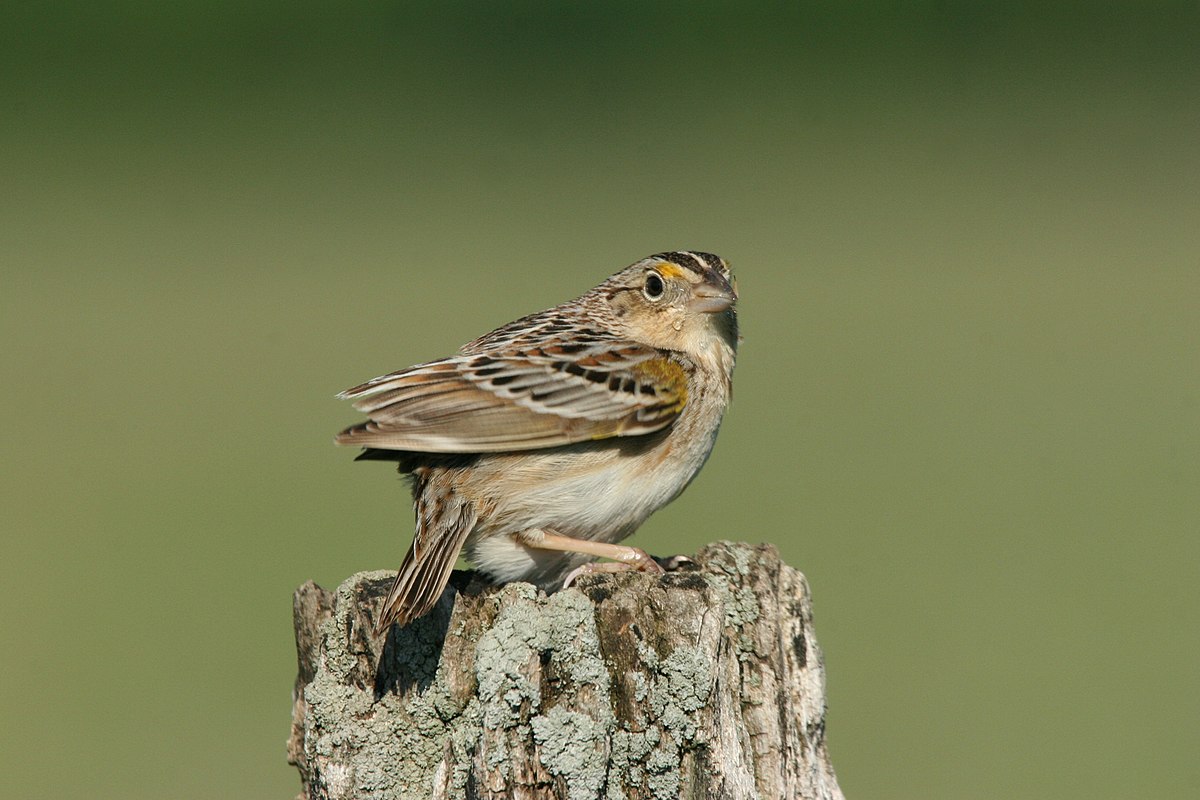
Wikipedia: Grasshopper sparrow Source: OTHER
1200px-Grasshopper_Sparrow.jpg
![]() The grasshopper sparrow (Ammodramus savannarum) is a small New World sparrow. The genus Ammodramus contains nine species that inhabit grasslands and prairies.
[more]
The grasshopper sparrow (Ammodramus savannarum) is a small New World sparrow. The genus Ammodramus contains nine species that inhabit grasslands and prairies.
[more]
Yellow-browed sparrow (Ammodramus aurifrons)
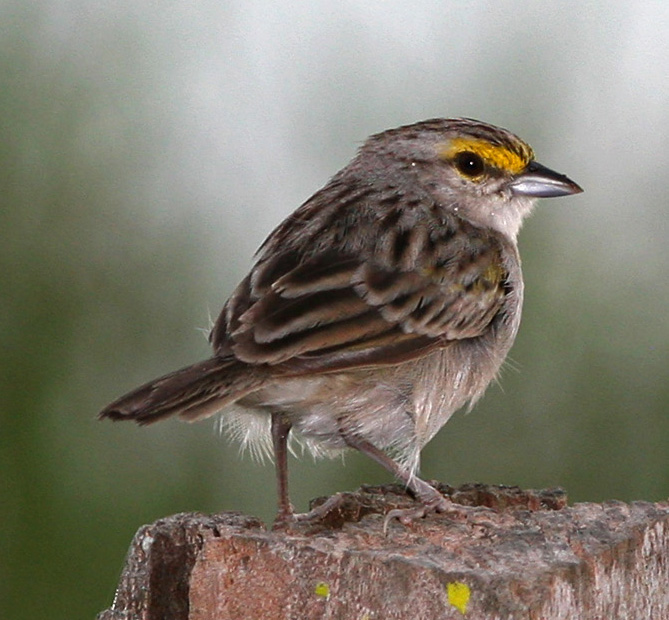
Wikipedia: Yellow-browed sparrow Source: OTHER
Yellow-crowned_Sparrow.jpg
![]() The yellow-browed sparrow (Ammodramus aurifrons) is a species of bird in the family Passerellidae. First described by Johann Baptist von Spix in 1825, this American sparrow is found across much of the Amazon basin in South America. Its natural habitats are subtropical or tropical moist shrubland, pastureland, and heavily degraded former forest.
[more]
The yellow-browed sparrow (Ammodramus aurifrons) is a species of bird in the family Passerellidae. First described by Johann Baptist von Spix in 1825, this American sparrow is found across much of the Amazon basin in South America. Its natural habitats are subtropical or tropical moist shrubland, pastureland, and heavily degraded former forest.
[more]
Black-striped sparrow (Arremonops conirostris)

Wikipedia: Black-striped sparrow Source: OTHER
1200px-Arremonops_conirostris_-near_Rancho_Naturalista%2C_Cordillera_de_Talamanca%2C_Costa_Rica-8.jpg
![]() The black-striped sparrow (Arremonops conirostris) is a passerine bird found from eastern Honduras to western Ecuador, northern Brazil, and Venezuela.
[more]
The black-striped sparrow (Arremonops conirostris) is a passerine bird found from eastern Honduras to western Ecuador, northern Brazil, and Venezuela.
[more]
Orange-billed sparrow (Arremon aurantiirostris)
Profile Wikipedia eBird Xeno-Canto

Wikipedia: Orange-billed sparrow Source: OTHER
Orange-billed_Sparrow_-_Rio_Tigre_-_Costa_Rica_S4E9639_%2826584988352%29_%28cropped%29.jpg
![]() The orange-billed sparrow (Arremon aurantiirostris) is a species of bird in the family Passerellidae.
In Central America it is found in Belize, Costa Rica, Guatemala, Honduras, Mexico, Nicaragua and Panama. In northwestern South America the orange-billed sparrow is found in Colombia, Ecuador and northern Peru. The species are black and as the name suggests, have an orange bill.[2] Its natural habitat is subtropical or tropical moist lowland forest.
[more]
The orange-billed sparrow (Arremon aurantiirostris) is a species of bird in the family Passerellidae.
In Central America it is found in Belize, Costa Rica, Guatemala, Honduras, Mexico, Nicaragua and Panama. In northwestern South America the orange-billed sparrow is found in Colombia, Ecuador and northern Peru. The species are black and as the name suggests, have an orange bill.[2] Its natural habitat is subtropical or tropical moist lowland forest.
[more]
Chestnut-capped brush-finch (Arremon brunneinucha)

Wikipedia: Chestnut-capped brush-finch Source: OTHER
1200px-Chestnut-capped_brushfinch_%28Arremon_brunneinucha_elsae%29.jpg
![]() The chestnut-capped brushfinch (Arremon brunneinucha), is a Neotropical passerine bird in the New World sparrow Passerellidae
[more]
The chestnut-capped brushfinch (Arremon brunneinucha), is a Neotropical passerine bird in the New World sparrow Passerellidae
[more]
Black-capped sparrow (Arremon abeillei)
Profile Wikipedia eBird Xeno-Canto

Wikipedia: Black-capped sparrow Source: OTHER
Black-capped_Sparrow_-_South_Ecuador_S4E9265_%2823309731381%29.jpg
![]() The black-capped sparrow (Arremon abeillei) is a species of bird in the family Passerellidae.
[more]
The black-capped sparrow (Arremon abeillei) is a species of bird in the family Passerellidae.
[more]
Olive finch (Arremon castaneiceps)

Wikipedia: Olive finch Source: OTHER
Olive_Finch_-_Colombia_S4E3362_%2823283455182%29.jpg
![]() The olive finch (Arremon castaneiceps) is a species of bird in the family Passerellidae. Until recently, it was placed in the genus Lysurus.[2]
[more]
The olive finch (Arremon castaneiceps) is a species of bird in the family Passerellidae. Until recently, it was placed in the genus Lysurus.[2]
[more]
Grey-browed brush-finch (Arremon assimilis)
Tanager finch (Oreothraupis arremonops)

Wikipedia: Tanager finch Source: OTHER
1200px-Tanager_Finch.jpg
![]() The tanager finch (Oreothraupis arremonops) is a songbird species. In the recent past it was placed in the Emberizidae, and then classified as its common name implies, a kind of tanager (Thraupidae). Today, it has been placed in the family Passerellidae, which was formerly considered to be part of the Emberizidae. It is the only species in the monotypic genus Oreothraupis.[2]
It is found in Colombia and Ecuador, where its natural habitat is subtropical or tropical moist montane forests. It is threatened by habitat loss.
[more]
The tanager finch (Oreothraupis arremonops) is a songbird species. In the recent past it was placed in the Emberizidae, and then classified as its common name implies, a kind of tanager (Thraupidae). Today, it has been placed in the family Passerellidae, which was formerly considered to be part of the Emberizidae. It is the only species in the monotypic genus Oreothraupis.[2]
It is found in Colombia and Ecuador, where its natural habitat is subtropical or tropical moist montane forests. It is threatened by habitat loss.
[more]
Tumbes sparrow (Rhynchospiza stolzmanni)

Wikipedia: Tumbes sparrow Source: OTHER
1200px-GnathospizaHaemophilaSmit.jpg
![]() The Tumbes sparrow (Rhynchospiza stolzmanni) is a species of bird in the family Passerellidae found in Ecuador and Peru. Its natural habitats are subtropical or tropical dry forests and subtropical or tropical dry shrubland.
[more]
The Tumbes sparrow (Rhynchospiza stolzmanni) is a species of bird in the family Passerellidae found in Ecuador and Peru. Its natural habitats are subtropical or tropical dry forests and subtropical or tropical dry shrubland.
[more]
Profile Wikipedia eBird Xeno-Canto

Wikipedia: Kelp gull Source: OTHER
1200px-SouthShetland-2016-Livingston_Island_%28Hannah_Point%29%E2%80%93Kelp_gull_%28Larus_dominicanus%29.jpg
This bird appears across the great seas in the following continents:
South America, Africa.
![]() The kelp gull (Larus dominicanus), also known as the Dominican gull, is a gull that breeds on coasts and islands through much of the Southern Hemisphere. The nominate L. d. dominicanus is the subspecies found around South America, parts of Australia (where it overlaps with the Pacific gull), and New Zealand (where it is known as the black-backed gull, the southern black-backed gull, mollyhawk[2] – particularly the juveniles,[3] or by its Māori name karoro). L. d. vetula (known as the Cape gull) is a subspecies occurring around Southern Africa.
[more]
The kelp gull (Larus dominicanus), also known as the Dominican gull, is a gull that breeds on coasts and islands through much of the Southern Hemisphere. The nominate L. d. dominicanus is the subspecies found around South America, parts of Australia (where it overlaps with the Pacific gull), and New Zealand (where it is known as the black-backed gull, the southern black-backed gull, mollyhawk[2] – particularly the juveniles,[3] or by its Māori name karoro). L. d. vetula (known as the Cape gull) is a subspecies occurring around Southern Africa.
[more]
Profile Wikipedia eBird Xeno-Canto

Wikipedia: Belcher's gull Source: OTHER
1200px-Band-Tailed_Gull.jpg
![]() Belcher's gull (Larus belcheri), also known as the band-tailed gull, is a bird in the family Laridae found along the Pacific coast of South America. It formerly included the very similar Olrog's gull as a subspecies, but that bird occurs on the Atlantic coast of South America and is now accepted as Larus atlanticus. Belcher's gull is a medium-sized gull with a blackish mantle, white head and underparts, a black band on the otherwise white tail, and a yellow bill with a red and black tip. Non-breeding adults have a brownish-black head and a white eye-ring. The name of this bird commemorates the British explorer Sir Edward Belcher who performed survey work on the Pacific coast of South America.
[more]
Belcher's gull (Larus belcheri), also known as the band-tailed gull, is a bird in the family Laridae found along the Pacific coast of South America. It formerly included the very similar Olrog's gull as a subspecies, but that bird occurs on the Atlantic coast of South America and is now accepted as Larus atlanticus. Belcher's gull is a medium-sized gull with a blackish mantle, white head and underparts, a black band on the otherwise white tail, and a yellow bill with a red and black tip. Non-breeding adults have a brownish-black head and a white eye-ring. The name of this bird commemorates the British explorer Sir Edward Belcher who performed survey work on the Pacific coast of South America.
[more]

Wikipedia: Grey-headed gull Source: OTHER
1200px-Graukopf-M%C3%B6we_Larus_cirrocephalus_090501_We_150.JPG
This bird appears across the great seas in the following continents:
South America, Africa.
![]() The grey-headed gull (Chroicocephalus cirrocephalus), also known as the grey-hooded gull, is a small gull which breeds patchily in South America and Africa south of the Sahara. It is not truly migratory, but is more widespread in winter. This species has occurred as a rare vagrant to North America, Italy and Spain. As is the case with many gulls, it has traditionally been placed in the genus Larus.
[more]
The grey-headed gull (Chroicocephalus cirrocephalus), also known as the grey-hooded gull, is a small gull which breeds patchily in South America and Africa south of the Sahara. It is not truly migratory, but is more widespread in winter. This species has occurred as a rare vagrant to North America, Italy and Spain. As is the case with many gulls, it has traditionally been placed in the genus Larus.
[more]
![]() Die Andenmöwe (Chroicocephalus serranus, Syn.: Larus serranus) ist eine mittelgroße, schwarzköpfige Möwenart, die an Andenseen zwischen Nord-Ecuador und Nord-Chile brütet und an großen Teilen der südamerikanischen Pazifikküste überwintert.
[more]
Die Andenmöwe (Chroicocephalus serranus, Syn.: Larus serranus) ist eine mittelgroße, schwarzköpfige Möwenart, die an Andenseen zwischen Nord-Ecuador und Nord-Chile brütet und an großen Teilen der südamerikanischen Pazifikküste überwintert.
[more]
Gull-billed tern / Lachseeschwalbe (Gelochelidon nilotica)
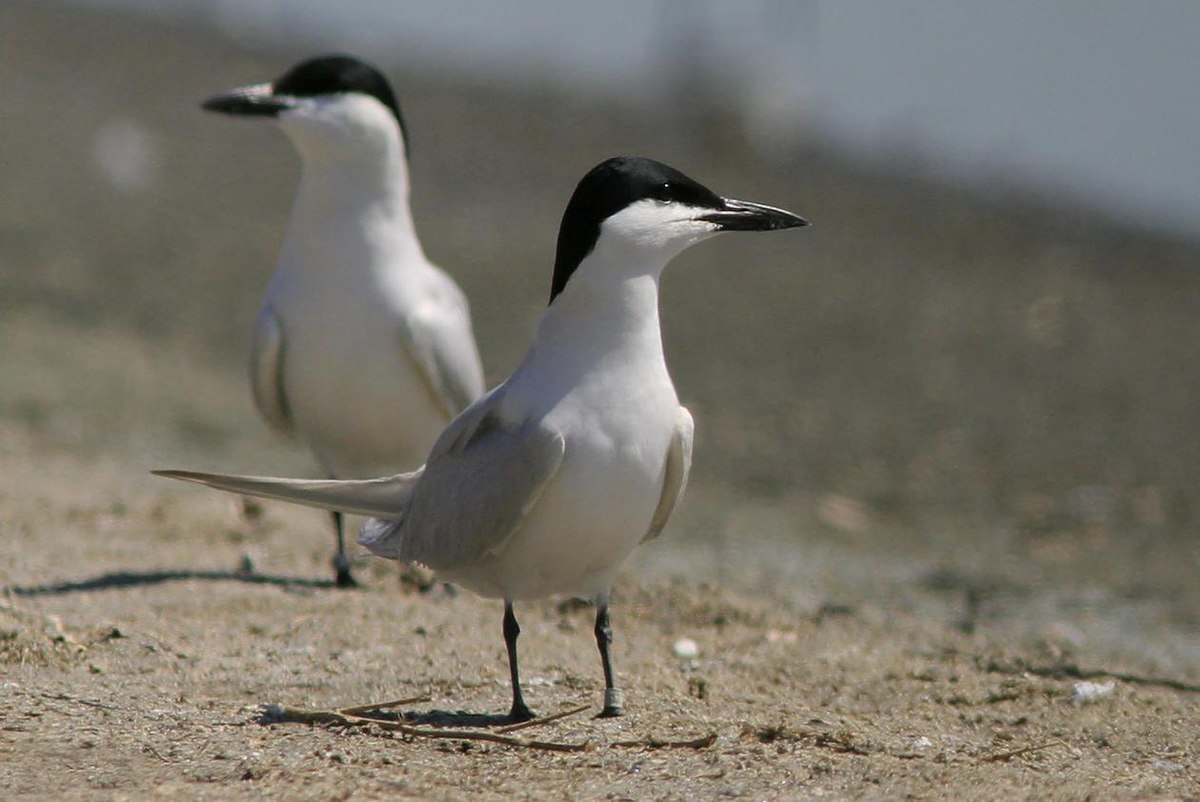
Wikipedia: Gull-billed tern Source: OTHER
1200px-Gelochelidon_nilotica_vanrossemi.jpg
This bird appears across the great seas in the following continents:
Europe, North America, South America, Africa, Asia.
![]() The gull-billed tern (Gelochelidon nilotica), formerly Sterna nilotica,[2] is a tern in the family Laridae. The genus name is from Ancient Greek gelao, "to laugh", and khelidon, "swallow". The specific niloticus is from Latin and means of the Nile.[3] The Australian gull-billed tern was previously considered a subspecies.
[more]
The gull-billed tern (Gelochelidon nilotica), formerly Sterna nilotica,[2] is a tern in the family Laridae. The genus name is from Ancient Greek gelao, "to laugh", and khelidon, "swallow". The specific niloticus is from Latin and means of the Nile.[3] The Australian gull-billed tern was previously considered a subspecies.
[more]
Swallow-tailed gull / Gabelschwanzmöwe (Creagrus furcatus)

Wikipedia: Swallow-tailed gull Source: OTHER
1200px-Creagrus_furcatus_-Galapagos_Islands-8.jpg
![]() The swallow-tailed gull (Creagrus furcatus) is an equatorial seabird in the gull family, Laridae. It is the only species in the genus Creagrus, which derives from the Latin Creagra and the Greek kreourgos which means butcher, also from kreas, meat; according to Jobling it would mean "hook for meat" referring to the hooked bill of this species.[2] It was first described by French naturalist and surgeon Adolphe-Simon Neboux in 1846. Its scientific name is originally derived from the Greek word for gull, "Glaros" and via Latin Larus, "gull" and furca "two-tined fork".[3] It spends most of its life flying and hunting over the open ocean. The main breeding location is in the Galápagos Islands, particularly the rocky shores and cliffs of Hood, Tower and Wolf Islands, with lower numbers on most of the other islands. It is more common on the eastern islands where the water is warmer.[4]
[more]
The swallow-tailed gull (Creagrus furcatus) is an equatorial seabird in the gull family, Laridae. It is the only species in the genus Creagrus, which derives from the Latin Creagra and the Greek kreourgos which means butcher, also from kreas, meat; according to Jobling it would mean "hook for meat" referring to the hooked bill of this species.[2] It was first described by French naturalist and surgeon Adolphe-Simon Neboux in 1846. Its scientific name is originally derived from the Greek word for gull, "Glaros" and via Latin Larus, "gull" and furca "two-tined fork".[3] It spends most of its life flying and hunting over the open ocean. The main breeding location is in the Galápagos Islands, particularly the rocky shores and cliffs of Hood, Tower and Wolf Islands, with lower numbers on most of the other islands. It is more common on the eastern islands where the water is warmer.[4]
[more]
Sabine's gull / Schwalbenmöwe (Xema sabini)

Wikipedia: Sabine's gull Source: OTHER
Xema_sabini_-Iceland_-swimming-8_%281%29.jpg
This bird appears across the great seas in the following continents:
Europe, North America, South America, Africa.
![]() Sabine's gull (/ˈseɪbɪn/ SAY-bin; Xema sabini), also known as the fork-tailed gull or xeme, is a small gull. Its generic placement is disputed; some authors treat it as the sole species in the genus Xema as Xema sabini,[2] while others retain it in the genus Larus as Larus sabini.[3][4]
[more]
Sabine's gull (/ˈseɪbɪn/ SAY-bin; Xema sabini), also known as the fork-tailed gull or xeme, is a small gull. Its generic placement is disputed; some authors treat it as the sole species in the genus Xema as Xema sabini,[2] while others retain it in the genus Larus as Larus sabini.[3][4]
[more]
Black skimmer / Schwarzmantel-Scherenschnabel (Rynchops niger)
Profile Wikipedia eBird Xeno-Canto
Black skimmers near Las Coloradas. 2023-04-15 10.11.18 Yucatan
First observed in Yucatan on 2023-04-15.
This bird appears across the great seas in the following continents:
North America, South America, Africa.
![]() The black skimmer (Rynchops niger) is a tern-like seabird, one of three very similar birds species in the skimmer genus Rynchops in the gull family Laridae. It breeds in North and South America. Northern populations winter in the warmer waters of the Caribbean and the tropical and subtropical Pacific coasts, but the South American races make only shorter movements in response to annual floods which extend their feeding areas in the river shallows.
[more]
The black skimmer (Rynchops niger) is a tern-like seabird, one of three very similar birds species in the skimmer genus Rynchops in the gull family Laridae. It breeds in North and South America. Northern populations winter in the warmer waters of the Caribbean and the tropical and subtropical Pacific coasts, but the South American races make only shorter movements in response to annual floods which extend their feeding areas in the river shallows.
[more]
Black tern / Trauerseeschwalbe (Chlidonias niger)
Profile Wikipedia eBird Vogelwarte BirdLife ZH ornitho.ch Audubon AllAboutBirds Xeno-Canto BirdID NABU

Wikipedia: Black tern Source: OTHER
1200px-%C4%8Cor%C3%ADk_%C4%8Dierny_%28Chlidonias_niger%29_a_%284644831482%29.jpg
This bird appears across the great seas in the following continents:
Europe, North America, South America, Africa.
![]() The black tern (Chlidonias niger) is a small tern generally found in or near inland water in Europe, Western Asia and North America. As its name suggests, it has predominantly dark plumage. In some lights it can appear blue in the breeding season, hence the old English name "blue darr".[2] The genus name is from Ancient Greek khelidonios, "swallow-like", from khelidon, "swallow": another old English name for the black tern is "carr (i.e. lake) swallow".[3] The species name is from Latin niger "shining black".[4]
[more]
The black tern (Chlidonias niger) is a small tern generally found in or near inland water in Europe, Western Asia and North America. As its name suggests, it has predominantly dark plumage. In some lights it can appear blue in the breeding season, hence the old English name "blue darr".[2] The genus name is from Ancient Greek khelidonios, "swallow-like", from khelidon, "swallow": another old English name for the black tern is "carr (i.e. lake) swallow".[3] The species name is from Latin niger "shining black".[4]
[more]
Vocalization: ![]() Moderately vocal. [Link]
Moderately vocal. [Link]
Calls: ![]() Flight call a more or less clear "kleck, or a disyllabic "klee-ake" with accented first syllable. Sometimes slightly rolling "klirr-eke", but never as much as in White-winged Tern. Also a slightly harsher "kreek", but not as raspy as in Whiskered Tern. [Link]
Flight call a more or less clear "kleck, or a disyllabic "klee-ake" with accented first syllable. Sometimes slightly rolling "klirr-eke", but never as much as in White-winged Tern. Also a slightly harsher "kreek", but not as raspy as in Whiskered Tern. [Link]
Physical details: length=22-24 cm,
wingspan=64-68 cm,
weight=60-86 g
Habitats:
River and lake
Brown noddy / Noddi (Anous stolidus)

Wikipedia: Brown noddy Source: OTHER
1200px-Common_Noddy_1_-_Michaelmas.jpg
This bird appears across the great seas in the following continents:
North America, South America, Africa, Asia.
General: ![]() The brown noddy or common noddy (Anous stolidus) is a seabird in the family Laridae. The largest of the noddies, it can be told from the closely related black noddy by its larger size and plumage, which is dark brown rather than black. The brown noddy is a tropical seabird with a worldwide distribution, ranging from Hawaii to the Tuamotu Archipelago and Australia in the Pacific Ocean, from the Red Sea to the Seychelles and Australia in the Indian Ocean and in the Caribbean to Tristan da Cunha in the Atlantic Ocean. The brown noddy is colonial, usually nesting on elevated situations on cliffs or in short trees or shrubs. It only occasionally nests on the ground. A single egg is laid by the female of a pair each breeding season. In India the brown noddy is protected in the PM Sayeed Marine Birds Conservation Reserve.[2]
[more]
The brown noddy or common noddy (Anous stolidus) is a seabird in the family Laridae. The largest of the noddies, it can be told from the closely related black noddy by its larger size and plumage, which is dark brown rather than black. The brown noddy is a tropical seabird with a worldwide distribution, ranging from Hawaii to the Tuamotu Archipelago and Australia in the Pacific Ocean, from the Red Sea to the Seychelles and Australia in the Indian Ocean and in the Caribbean to Tristan da Cunha in the Atlantic Ocean. The brown noddy is colonial, usually nesting on elevated situations on cliffs or in short trees or shrubs. It only occasionally nests on the ground. A single egg is laid by the female of a pair each breeding season. In India the brown noddy is protected in the PM Sayeed Marine Birds Conservation Reserve.[2]
[more]
Inca tern / Inkaseeschwalbe (Larosterna inca)
Profile Wikipedia eBird Xeno-Canto

Wikipedia: Inca tern Source: OTHER
1200px-Larosterna_inca_%28Inca_Tern_-_Inkaseeschwalbe%29_Weltvogelpark_Walsrode_2012-015.jpg
![]() The Inca tern (Larosterna inca) is a tern in the family Laridae. It is the only member of the genus Larosterna.
[more]
The Inca tern (Larosterna inca) is a tern in the family Laridae. It is the only member of the genus Larosterna.
[more]
Large-billed tern (Phaetusa simplex)
Profile Wikipedia eBird Xeno-Canto

Wikipedia: Large-billed tern Source: OTHER
1200px-Grossschnabel-Seeschwalbe.jpg
![]() The large-billed tern (Phaetusa simplex) is a species of tern in the family Laridae. It belongs to the monotypic genus Phaetusa.
[more]
The large-billed tern (Phaetusa simplex) is a species of tern in the family Laridae. It belongs to the monotypic genus Phaetusa.
[more]
Franklin's gull / Präriemöwe (Leucophaeus pipixcan)

Wikipedia: Franklin's gull Source: OTHER
Franklin%27s_Gull%2C_Calgary.jpg
This bird appears across the great seas in the following continents:
North America, South America, Africa.
![]() Franklin's gull (Leucophaeus pipixcan) is a small (length 12.6–14.2 in, 32–36 cm) gull.[2] The genus name Leucophaeus is from Ancient Greek leukos, "white", and phaios, "dusky". The specific pipixcan is a Nahuatl name for a type of gull.[3][4]
[more]
Franklin's gull (Leucophaeus pipixcan) is a small (length 12.6–14.2 in, 32–36 cm) gull.[2] The genus name Leucophaeus is from Ancient Greek leukos, "white", and phaios, "dusky". The specific pipixcan is a Nahuatl name for a type of gull.[3][4]
[more]
Laughing gull / Aztekenmöwe (Leucophaeus atricilla)
Our gang - laughing gull, double-crested cormorants, brown pelicans - at Las Coloradas, Rio Lagartos. 2023-04-15 09.11.04 Yucatan
First observed in Yucatan on 2023-03-26.
This bird appears across the great seas in the following continents:
North America, South America, Australia.
vagrant
Grey gull / Graumöwe (Leucophaeus modestus)

Wikipedia: Grey gull Source: OTHER
1200px-Gray_Gull_RWD.jpg
General: ![]() The grey gull, also known as garuma gull (Leucophaeus modestus) is a medium-sized gull native to South America. Unusual among gulls, it breeds inland in the extremely dry Atacama Desert in northern Chile, although it is present as a non-breeding bird along much of the Pacific coast of South America.
[more]
The grey gull, also known as garuma gull (Leucophaeus modestus) is a medium-sized gull native to South America. Unusual among gulls, it breeds inland in the extremely dry Atacama Desert in northern Chile, although it is present as a non-breeding bird along much of the Pacific coast of South America.
[more]
Sooty tern / Rußseeschwalbe (Onychoprion fuscatus)

Wikipedia: Sooty tern Source: OTHER
1200px-Sterna_fuscata.JPG
This bird appears across the great seas in the following continents:
North America, South America, Africa.
![]() The sooty tern (Onychoprion fuscatus) is a seabird in the family Laridae. It is a bird of the tropical oceans which sleeps on the wing, returning to land only to breed on islands throughout the equatorial zone.
[more]
The sooty tern (Onychoprion fuscatus) is a seabird in the family Laridae. It is a bird of the tropical oceans which sleeps on the wing, returning to land only to breed on islands throughout the equatorial zone.
[more]
Bridled tern / Zügelseeschwalbe (Onychoprion anaethetus)
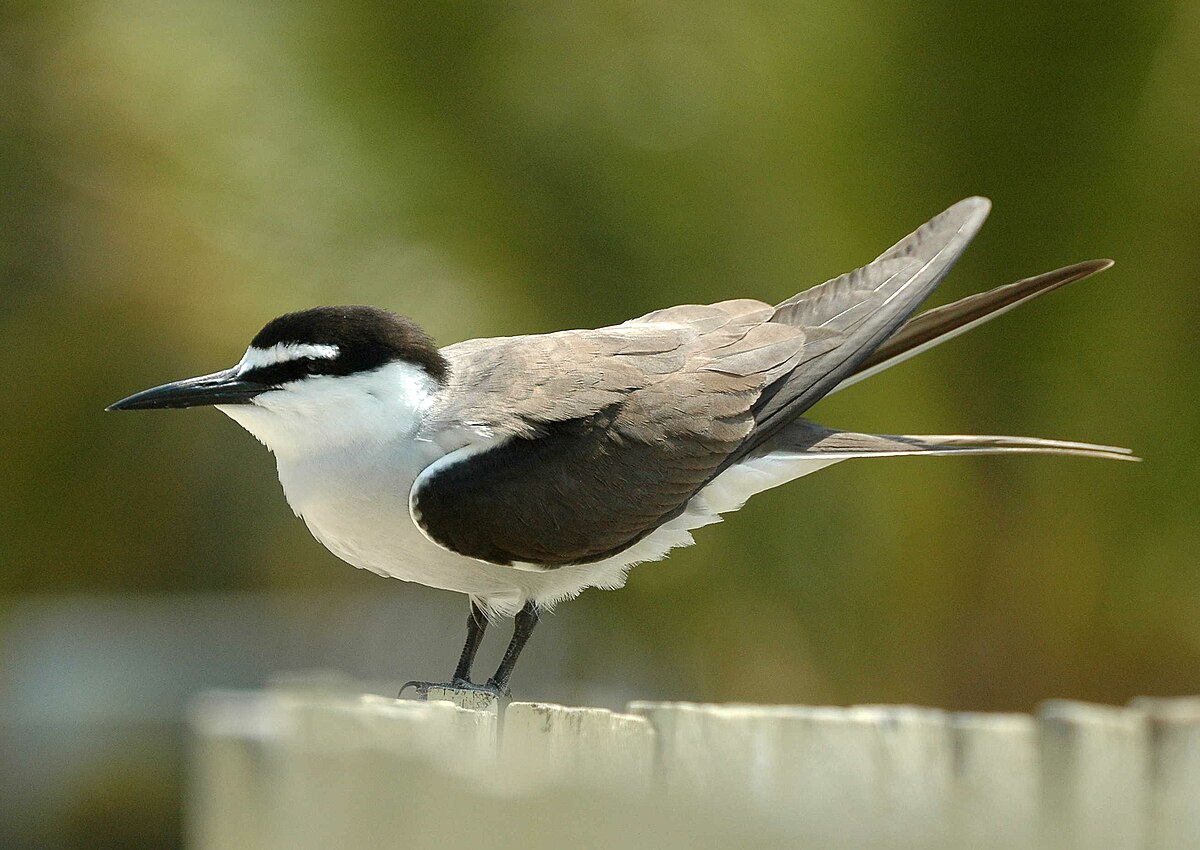
Wikipedia: Bridled tern Source: OTHER
1200px-Bridled_Tern_LEI_Nov06.JPG
This bird appears across the great seas in the following continents:
North America, South America, Africa, Asia.
![]() The bridled tern (Onychoprion anaethetus)[2] is a seabird of the family Laridae. It is a bird of the tropical oceans. The scientific name is from Ancient Greek. The genus comes from onux meaning "claw" or "nail", and prion, meaning "saw". The specific anaethetus means "senseless, stupid".[3]
[more]
The bridled tern (Onychoprion anaethetus)[2] is a seabird of the family Laridae. It is a bird of the tropical oceans. The scientific name is from Ancient Greek. The genus comes from onux meaning "claw" or "nail", and prion, meaning "saw". The specific anaethetus means "senseless, stupid".[3]
[more]
Peruvian tern / Peruseeschwalbe (Sternula lorata)
Profile Wikipedia eBird Xeno-Canto

Wikipedia: Peruvian tern Source: OTHER
1200px-Peruvian_Tern.JPG
![]() The Peruvian tern, chirrío or gaviotín Chico (Sternula lorata) is a species of tern in the family Laridae.
Found in northern Chile, Ecuador, and Peru, its natural habitats are hot deserts, sandy shores, and coastal saline lagoons. It is threatened by habitat loss.
[more]
The Peruvian tern, chirrío or gaviotín Chico (Sternula lorata) is a species of tern in the family Laridae.
Found in northern Chile, Ecuador, and Peru, its natural habitats are hot deserts, sandy shores, and coastal saline lagoons. It is threatened by habitat loss.
[more]
Yellow-billed tern / Amazonasseeschwalbe (Sternula superciliaris)

Wikipedia: Yellow-billed tern Source: OTHER
1200px-Yellow-billed_tern_Sternula_superciliaris.jpg
![]() The yellow-billed tern (Sternula superciliaris) is a small seabird found in South America. It is a species of tern in the family Laridae.
It is found in Argentina, Bolivia, Brazil, Colombia, Ecuador, French Guiana, Guyana, Panama, Paraguay, Peru, Suriname, Trinidad and Tobago, Uruguay, and Venezuela.
Its natural habitats are rivers, swamps, and freshwater lakes.
[more]
The yellow-billed tern (Sternula superciliaris) is a small seabird found in South America. It is a species of tern in the family Laridae.
It is found in Argentina, Bolivia, Brazil, Colombia, Ecuador, French Guiana, Guyana, Panama, Paraguay, Peru, Suriname, Trinidad and Tobago, Uruguay, and Venezuela.
Its natural habitats are rivers, swamps, and freshwater lakes.
[more]
Elegant tern (Thalasseus elegans)

Wikipedia: Elegant tern Source: OTHER
1200px-Elegant_Tern_Bolsa_Chica.jpg
This bird appears across the great seas in the following continents:
North America, South America, Africa.
![]() The elegant tern (Thalasseus elegans) is a tern in the family Laridae. It breeds on the Pacific coasts of the southern United States and Mexico and winters south to Peru, Ecuador and Chile.
[more]
The elegant tern (Thalasseus elegans) is a tern in the family Laridae. It breeds on the Pacific coasts of the southern United States and Mexico and winters south to Peru, Ecuador and Chile.
[more]
Sandwich tern / Brandseeschwalbe (Thalasseus sandvicensis)
Sandwich tern in flight with distinct yellow tipped bill. 2023-09-27 12.28.34 Florida
First observed in Costa Rica on 2018-03-11.
This bird appears across the great seas in the following continents:
Europe, North America, South America, Africa.
![]() The Sandwich tern (Thalasseus sandvicensis)[2] is a tern in the family Laridae. It is very closely related to the lesser crested tern (T. bengalensis), Chinese crested tern (T. bernsteini), Cabot's tern (T. acuflavidus), and elegant tern (T. elegans) and has been known to interbreed with the lesser crested. It breeds in the Palearctic from Europe to the Caspian Sea wintering to South Africa, India and Sri Lanka.
[more]
The Sandwich tern (Thalasseus sandvicensis)[2] is a tern in the family Laridae. It is very closely related to the lesser crested tern (T. bengalensis), Chinese crested tern (T. bernsteini), Cabot's tern (T. acuflavidus), and elegant tern (T. elegans) and has been known to interbreed with the lesser crested. It breeds in the Palearctic from Europe to the Caspian Sea wintering to South Africa, India and Sri Lanka.
[more]
Calls: ![]() Contact call a sharp and grating "keeree-eek". Often compared to the pressing of amalgam into a tooth. [Link]
Contact call a sharp and grating "keeree-eek". Often compared to the pressing of amalgam into a tooth. [Link]
Physical details: length=36-41 cm,
wingspan=95-105 cm,
weight=215-275 g
Habitats:
River and lake
Royal tern (Thalasseus maximus)

Wikipedia: Royal tern Source: OTHER
1200px-Royal_Tern.jpg
This bird appears across the great seas in the following continents:
Europe, North America, South America, Africa.
General: ![]() The royal tern (Thalasseus maximus) is a tern in the family Laridae.
[more]
The royal tern (Thalasseus maximus) is a tern in the family Laridae.
[more]
Southern lapwing / Bronzekiebitz (Vanellus chilensis)
Profile Wikipedia eBird Xeno-Canto

Southern lapwings in Chile. 2019-02-17 15.23.52 Patagonia
First observed in Patagonia on 2019-02-17.
![]() The southern lapwing (Vanellus chilensis) is a wader in the order Charadriiformes. It is a common and widespread resident throughout South America, except in densely forested regions (e.g. most of the Amazon), the higher parts of the Andes and the arid coast of a large part of western South America. This bird is particularly common in the basin of the Rio de la Plata. It has also been spreading through Central America in recent years. It reached Trinidad in 1961 and Tobago in 1974, and has rapidly increased on both islands, sporadically making its way North to Barbados where one pair mated, nested and produced chicks in 2007.
[more]
The southern lapwing (Vanellus chilensis) is a wader in the order Charadriiformes. It is a common and widespread resident throughout South America, except in densely forested regions (e.g. most of the Amazon), the higher parts of the Andes and the arid coast of a large part of western South America. This bird is particularly common in the basin of the Rio de la Plata. It has also been spreading through Central America in recent years. It reached Trinidad in 1961 and Tobago in 1974, and has rapidly increased on both islands, sporadically making its way North to Barbados where one pair mated, nested and produced chicks in 2007.
[more]
Pied lapwing (Vanellus cayanus)
Profile Wikipedia eBird Xeno-Canto

Wikipedia: Pied lapwing Source: OTHER
1200px-BK3U7978.jpg
![]() The pied plover (Vanellus cayanus), also known as the pied lapwing, is a species of bird in the family Charadriidae. It is a strongly marked bird with a prominent black V on its mantle.[3]
[more]
The pied plover (Vanellus cayanus), also known as the pied lapwing, is a species of bird in the family Charadriidae. It is a strongly marked bird with a prominent black V on its mantle.[3]
[more]
Andean lapwing / Andenkiebitz (Vanellus resplendens)
Profile Wikipedia eBird Xeno-Canto

Wikipedia: Andean lapwing Source: OTHER
1200px-Andean_Lapwing_%28Vanellus_resplendens%29_on_the_ground%2C_side_view.jpg
![]() The Andean lapwing (Vanellus resplendens) is a species of bird in the family Charadriidae.
It is found in Argentina, Bolivia, Chile, Colombia, Ecuador, and Peru.
Its natural habitats are subtropical or tropical high-altitude grassland, rivers, swamps, and pastureland.
[more]
The Andean lapwing (Vanellus resplendens) is a species of bird in the family Charadriidae.
It is found in Argentina, Bolivia, Chile, Colombia, Ecuador, and Peru.
Its natural habitats are subtropical or tropical high-altitude grassland, rivers, swamps, and pastureland.
[more]
Semipalmated plover / Amerika-Sandregenpfeifer (Charadrius semipalmatus)
Profile Wikipedia eBird Audubon AllAboutBirds Xeno-Canto NABU

Wikipedia: Semipalmated plover Source: OTHER
Semipalmated_Plover.jpg
This bird appears across the great seas in the following continents:
Europe, North America, South America, Australia.
vagrant
Snowy plover (Charadrius nivosus)
Profile Wikipedia eBird Audubon AllAboutBirds Xeno-Canto

Wikipedia: Snowy plover Source: OTHER
1200px-Snowy_Plover_srgb.jpg
General: ![]() The snowy plover (Charadrius nivosus) is a small wader in the plover bird family, typically about 5-7" in length.[2] It breeds in Ecuador, Peru, Chile, the southern and western United States and the Caribbean. Long considered to be a subspecies of the Kentish plover, it is now known to be a distinct species.
[more]
The snowy plover (Charadrius nivosus) is a small wader in the plover bird family, typically about 5-7" in length.[2] It breeds in Ecuador, Peru, Chile, the southern and western United States and the Caribbean. Long considered to be a subspecies of the Kentish plover, it is now known to be a distinct species.
[more]
Killdeer / Keilschwanz-Regenpfeifer (Charadrius vociferus)

Wikipedia: Killdeer Source: OTHER
Killdeer.jpg
![]() The killdeer (Charadrius vociferus) is a large plover found in the Americas. It was described and given its current scientific name in 1758 by Carl Linnaeus in the 10th edition of his Systema Naturae. There are three subspecies. The killdeer's common name comes from its often-heard call. Its upperparts are mostly brown with rufous fringes, the head has patches of white and black, and there are two black breast bands. The belly and the rest of the breast are white. The nominate (or originally described) subspecies breeds from southeastern Alaska and southern Canada to Mexico. It is seen year-round in the southern half of its breeding range; the subspecies C. v. ternominatus is probably resident in the West Indies and C. v. peruvianus inhabits Peru and areas of the surrounding countries throughout the year. North American breeders winter from their resident range south to Central America, the West Indies, and the northernmost portions of South America.
[more]
The killdeer (Charadrius vociferus) is a large plover found in the Americas. It was described and given its current scientific name in 1758 by Carl Linnaeus in the 10th edition of his Systema Naturae. There are three subspecies. The killdeer's common name comes from its often-heard call. Its upperparts are mostly brown with rufous fringes, the head has patches of white and black, and there are two black breast bands. The belly and the rest of the breast are white. The nominate (or originally described) subspecies breeds from southeastern Alaska and southern Canada to Mexico. It is seen year-round in the southern half of its breeding range; the subspecies C. v. ternominatus is probably resident in the West Indies and C. v. peruvianus inhabits Peru and areas of the surrounding countries throughout the year. North American breeders winter from their resident range south to Central America, the West Indies, and the northernmost portions of South America.
[more]
Wilson's plover (Charadrius wilsonia)
Profile Wikipedia eBird Audubon AllAboutBirds Xeno-Canto

Wikipedia: Wilson's plover Source: OTHER
1200px-Wilson%27s_Plover_male_RWD2.jpg
![]() Wilson's plover (Charadrius wilsonia) is a small bird of the family Charadriidae.
[more]
Wilson's plover (Charadrius wilsonia) is a small bird of the family Charadriidae.
[more]
Collared plover (Charadrius collaris)
Profile Wikipedia eBird Xeno-Canto

Wikipedia: Collared plover Source: OTHER
1200px-Charadrius_collaris.jpg
![]() The collared plover (Charadrius collaris) is a small shorebird in the plover family, Charadriidae. It lives along coasts and riverbanks of the tropical to temperate Americas, from central Mexico south to Chile and Argentina.
[more]
The collared plover (Charadrius collaris) is a small shorebird in the plover family, Charadriidae. It lives along coasts and riverbanks of the tropical to temperate Americas, from central Mexico south to Chile and Argentina.
[more]
American golden-plover (Pluvialis dominica)
Profile Wikipedia eBird Audubon AllAboutBirds Xeno-Canto
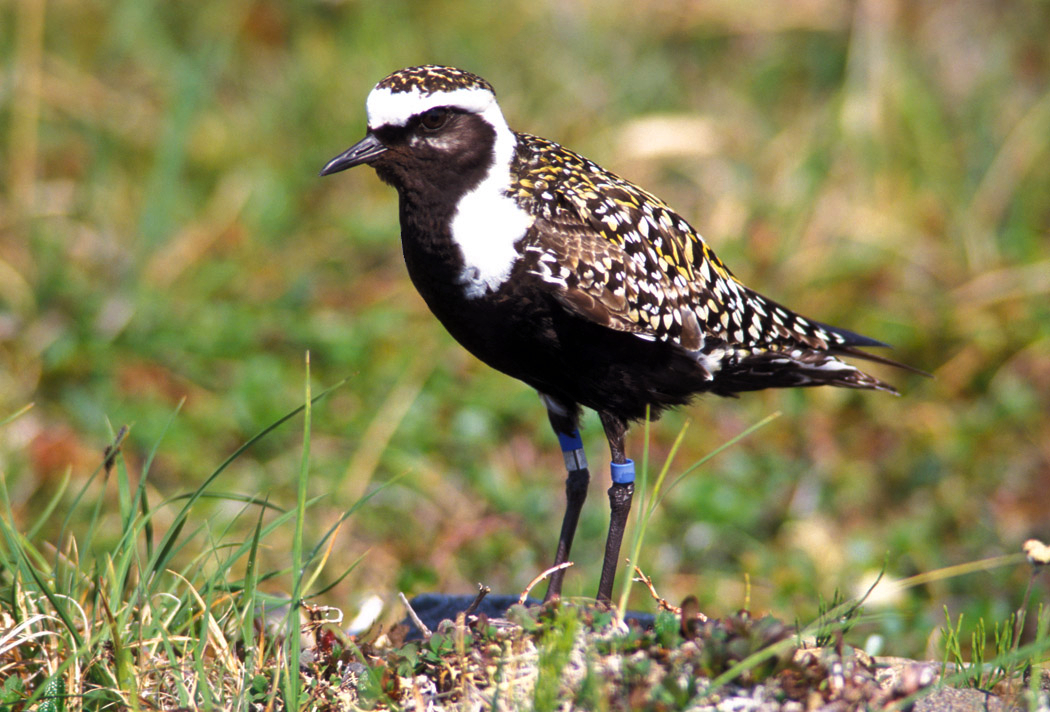
Wikipedia: American golden-plover Source: OTHER
Pluvialis_dominica1.jpg
This bird appears across the great seas in the following continents:
North America, South America, Africa.
![]() The American golden plover (Pluvialis dominica), or American golden-plover is a medium-sized plover. The genus name is Latin and means relating to rain, from pluvia, "rain". It was believed that golden plovers flocked when rain was imminent. The species name dominica refers to Santo Domingo, now Hispaniola, in the West Indies.[2]
[more]
The American golden plover (Pluvialis dominica), or American golden-plover is a medium-sized plover. The genus name is Latin and means relating to rain, from pluvia, "rain". It was believed that golden plovers flocked when rain was imminent. The species name dominica refers to Santo Domingo, now Hispaniola, in the West Indies.[2]
[more]
Black-bellied plover / Kiebitzregenpfeifer (Pluvialis squatarola)
Black-bellied plover eggs. 2016-09-25 16.51.00 Botswana
First observed in Botswana on 2016-09-25.
This bird appears across the great seas in the following continents:
Europe, North America, South America, Africa, Asia.
![]() The grey plover or black-bellied plover (Pluvialis squatarola) is a medium-sized plover breeding in Arctic regions. It is a long-distance migrant, with a nearly worldwide coastal distribution when not breeding.[2] The genus name is Latin and means relating to rain, from pluvia, "rain". It was believed that golden plovers flocked when rain was imminent. The species name squatarola is a Latinised version of Sgatarola, a Venetian name for some kind of plover.[3]
[more]
The grey plover or black-bellied plover (Pluvialis squatarola) is a medium-sized plover breeding in Arctic regions. It is a long-distance migrant, with a nearly worldwide coastal distribution when not breeding.[2] The genus name is Latin and means relating to rain, from pluvia, "rain". It was believed that golden plovers flocked when rain was imminent. The species name squatarola is a Latinised version of Sgatarola, a Venetian name for some kind of plover.[3]
[more]
Calls: ![]() Contact call diagnostic. A plaintive, drawn and trisyllabic (but continuous) "kleeooowee". Pitch falls on second syllable and rises on last. [Link]
Contact call diagnostic. A plaintive, drawn and trisyllabic (but continuous) "kleeooowee". Pitch falls on second syllable and rises on last. [Link]
Physical details: length=27-30 cm,
wingspan=71-83 cm,
weight=190-280 g
Habitats:
Wetland
White-rumped sandpiper / Weißbürzelstrandläufer (Calidris fuscicollis)
Profile Wikipedia eBird Audubon AllAboutBirds Xeno-Canto

Wikipedia: White-rumped sandpiper Source: OTHER
1200px-Calidris_fuscicollis_PLAYERO_RABADILLA_BLANCA.jpg
This bird appears across the great seas in the following continents:
North America, South America, Africa.
General: ![]() The white-rumped sandpiper (Calidris fuscicollis) is a small shorebird that breeds in the northern tundra of Canada and Alaska. This bird can be difficult to distinguish from other similar tiny shorebirds; these are known collectively as "peeps" or "stints".
[more]
The white-rumped sandpiper (Calidris fuscicollis) is a small shorebird that breeds in the northern tundra of Canada and Alaska. This bird can be difficult to distinguish from other similar tiny shorebirds; these are known collectively as "peeps" or "stints".
[more]
Baird's sandpiper / Bairdstrandläufer (Calidris bairdii)
Profile Wikipedia eBird Audubon AllAboutBirds Xeno-Canto

Wikipedia: Baird's sandpiper Source: OTHER
Calidris_bairdii_-Gullbringusysla%2C_Iceland-8.jpg
This bird appears across the great seas in the following continents:
North America, South America, Africa.
![]() Baird's sandpiper (Calidris bairdii) is a small shorebird. It is among those calidrids which were formerly included in the genus Erolia, which was subsumed into the genus Calidris in 1973.[2] The genus name is from Ancient Greek kalidris or skalidris, a term used by Aristotle for some grey-coloured waterside birds. The English name and specific bairdii commemorate Spencer Fullerton Baird, 19th-century naturalist and assistant secretary of the Smithsonian Institution.[3]
[more]
Baird's sandpiper (Calidris bairdii) is a small shorebird. It is among those calidrids which were formerly included in the genus Erolia, which was subsumed into the genus Calidris in 1973.[2] The genus name is from Ancient Greek kalidris or skalidris, a term used by Aristotle for some grey-coloured waterside birds. The English name and specific bairdii commemorate Spencer Fullerton Baird, 19th-century naturalist and assistant secretary of the Smithsonian Institution.[3]
[more]
Buff-breasted sandpiper / Grasläufer (Calidris subruficollis)

Wikipedia: Buff-breasted sandpiper Source: OTHER
1200px-Tryngites_subruficollis_-USA-8.jpg
This bird appears across the great seas in the following continents:
North America, South America, Africa.
![]() The buff-breasted sandpiper (Calidris subruficollis) is a small shorebird. The species name subruficollis is from Latin subrufus, "reddish" (from sub, "somewhat", and rufus, "rufous") and collis, "-necked/-throated" (from collum, "neck").[2] It is a calidrid sandpiper.
[more]
The buff-breasted sandpiper (Calidris subruficollis) is a small shorebird. The species name subruficollis is from Latin subrufus, "reddish" (from sub, "somewhat", and rufus, "rufous") and collis, "-necked/-throated" (from collum, "neck").[2] It is a calidrid sandpiper.
[more]
Sanderling / Sanderling (Calidris alba)
Profile Wikipedia eBird Vogelwarte BirdLife ZH ornitho.ch Audubon AllAboutBirds Xeno-Canto BirdID NABU
Sanderling. 2023-09-27 12.12.20 Florida
First observed in Yucatan on 2023-03-27.
This bird appears across the great seas in the following continents:
Europe, North America, South America, Africa, Asia.
![]() The sanderling (Calidris alba) is a small wading bird. The name derives from Old English sand-yrðling, "sand-ploughman".[2] The genus name is from Ancient Greek kalidris or skalidris, a term used by Aristotle for some grey-coloured waterside birds. The specific alba is Latin for "white".[3]
[more]
The sanderling (Calidris alba) is a small wading bird. The name derives from Old English sand-yrðling, "sand-ploughman".[2] The genus name is from Ancient Greek kalidris or skalidris, a term used by Aristotle for some grey-coloured waterside birds. The specific alba is Latin for "white".[3]
[more]
Calls: ![]() Call not very diagnostic; a short and soft "pleet" or "keek". [Link]
Call not very diagnostic; a short and soft "pleet" or "keek". [Link]
Physical details: length=20-21 cm,
wingspan=40-45 cm,
weight=44-70 g
Habitats:
Wetland
Pectoral sandpiper / Graubrust-Strandläufer (Calidris melanotos)
Profile Wikipedia eBird Audubon AllAboutBirds Xeno-Canto

Wikipedia: Pectoral sandpiper Source: OTHER
1200px-Pectoral_Sandpiper3.jpg
This bird appears across the great seas in the following continents:
North America, South America, Africa.
General: ![]() The pectoral sandpiper (Calidris melanotos) is a small, migratory wader that breeds in North America and Asia, wintering in South America and Oceania. It eats small invertebrates. Its nest, a hole scraped in the ground and with a thick lining, is deep enough to protect its four eggs from the cool breezes of its breeding grounds. The pectoral sandpiper is 21 cm (8.3 in) long, with a wingspan of 46 cm (18 in).
[more]
The pectoral sandpiper (Calidris melanotos) is a small, migratory wader that breeds in North America and Asia, wintering in South America and Oceania. It eats small invertebrates. Its nest, a hole scraped in the ground and with a thick lining, is deep enough to protect its four eggs from the cool breezes of its breeding grounds. The pectoral sandpiper is 21 cm (8.3 in) long, with a wingspan of 46 cm (18 in).
[more]
Stilt sandpiper (Calidris himantopus)

Wikipedia: Stilt sandpiper Source: OTHER
Calidris_himantopus.jpg
This bird appears across the great seas in the following continents:
North America, South America, Australia.
vagrant
Western sandpiper / Bergstrandläufer (Calidris mauri)
Profile Wikipedia eBird Audubon AllAboutBirds Xeno-Canto

Wikipedia: Western sandpiper Source: OTHER
Western_Sandpiper.jpg
General: ![]() The western sandpiper (Calidris mauri) is a small shorebird. The genus name is from Ancient Greek kalidris or skalidris, a term used by Aristotle for some grey-coloured waterside birds. The specific mauri commemorates Italian botanist Ernesto Mauri (1791–1836).[2]
[more]
The western sandpiper (Calidris mauri) is a small shorebird. The genus name is from Ancient Greek kalidris or skalidris, a term used by Aristotle for some grey-coloured waterside birds. The specific mauri commemorates Italian botanist Ernesto Mauri (1791–1836).[2]
[more]
Semipalmated sandpiper / Sandstrandläufer (Calidris pusilla)
Dark-rimmed wings of these beautiful birds, probably semipalmated sandpiper, show up in flight. 2023-04-20 16.29.32 Yucatan
First observed in Yucatan on 2023-04-20.
![]() The semipalmated sandpiper (Calidris pusilla) is a very small shorebird. The genus name is from Ancient Greek kalidris or skalidris, a term used by Aristotle for some grey-coloured waterside birds. The specific pusilla is Latin for "very small".[2]
[more]
The semipalmated sandpiper (Calidris pusilla) is a very small shorebird. The genus name is from Ancient Greek kalidris or skalidris, a term used by Aristotle for some grey-coloured waterside birds. The specific pusilla is Latin for "very small".[2]
[more]
Least sandpiper / Wiesenstrandläufer (Calidris minutilla)
Profile Wikipedia eBird Audubon AllAboutBirds Xeno-Canto
Least sandpiper has wandered off the sea into the city in Campeche. 2023-04-06 16.53.02 Yucatan
First observed in Yucatan on 2023-04-06.
![]() The least sandpiper (Calidris minutilla) is the smallest shorebird. The genus name is from Ancient Greek kalidris or skalidris, a term used by Aristotle for some grey-colored waterside birds. The specific minutilla is Medieval Latin for "very small".[2]
[more]
The least sandpiper (Calidris minutilla) is the smallest shorebird. The genus name is from Ancient Greek kalidris or skalidris, a term used by Aristotle for some grey-colored waterside birds. The specific minutilla is Medieval Latin for "very small".[2]
[more]
Surfbird (alternate) / Gischtläufer (Calidris virgata)
![]() Der Gischtläufer (Calidris virgata, Syn.: Aphriza virgata) ist eine mittelgroße Vogelart aus der Familie der Schnepfenvögel (Scolopacidae).
[more]
Der Gischtläufer (Calidris virgata, Syn.: Aphriza virgata) ist eine mittelgroße Vogelart aus der Familie der Schnepfenvögel (Scolopacidae).
[more]
Whimbrel / Regenbrachvogel (Numenius phaeopus)
Regenbrachvogel oder Grosser Brachvogel - dunkle Schwanzfedern ein moegliches Zeichen. 2022-06-23 16.53.34 La Sauge
First observed in Canary Islands on 2022-03-19.
This bird appears across the great seas in the following continents:
Europe, North America, South America, Africa, Asia.
![]() Der Regenbrachvogel (Numenius phaeopus) ist mit einer Spannweite um die 80 cm viel kleiner als der Große Brachvogel, auch der Schnabel ist kürzer und der Oberkopf ist hell und dunkel gestreift. Der Ruf dieser Vogelart ähnelt einem hellen Trillern.
[more]
Der Regenbrachvogel (Numenius phaeopus) ist mit einer Spannweite um die 80 cm viel kleiner als der Große Brachvogel, auch der Schnabel ist kürzer und der Oberkopf ist hell und dunkel gestreift. Der Ruf dieser Vogelart ähnelt einem hellen Trillern.
[more]
Song: ![]() Song starts similar to Curlew with long wailing notes "kluuueee", which then accelerates to a continuous, vibrating single note. Lacks the cyclic phrase ending of Curlew. [Link]
Song starts similar to Curlew with long wailing notes "kluuueee", which then accelerates to a continuous, vibrating single note. Lacks the cyclic phrase ending of Curlew. [Link]
Physical details: length=40-42 cm,
wingspan=76-89 cm,
weight=300-660 g
Habitats:
Wetland
Ruddy turnstone / Steinwälzer (Arenaria interpres)
Ruddy turnstone near Las Coloradas. 2023-04-15 10.06.32 Yucatan
First observed in Canary Islands on 2022-03-19.
This bird appears across the great seas in the following continents:
Europe, North America, South America, Africa, Asia.
General: ![]() The ruddy turnstone (Arenaria interpres) is a small wading bird, one of two species of turnstone in the genus Arenaria. The scientific name is from Latin. The genus name arenaria derives from arenarius, "inhabiting sand, from arena, "sand". The specific interpres means "messenger"; when visiting Gotland in 1741, Linnaeus thought that the Swedish word Tolk "interpreter" applied to this species, but in the local dialect the word means "legs" and is used for the redshank.[2]
[more]
The ruddy turnstone (Arenaria interpres) is a small wading bird, one of two species of turnstone in the genus Arenaria. The scientific name is from Latin. The genus name arenaria derives from arenarius, "inhabiting sand, from arena, "sand". The specific interpres means "messenger"; when visiting Gotland in 1741, Linnaeus thought that the Swedish word Tolk "interpreter" applied to this species, but in the local dialect the word means "legs" and is used for the redshank.[2]
[more]
Song: ![]() Alarm call/song more "wader-like", a staccato "kuvi-kuvi-vit-vit-vitua". [Link]
Alarm call/song more "wader-like", a staccato "kuvi-kuvi-vit-vit-vitua". [Link]
Calls: ![]() Characteristic call: An explosive, hard, resonant and short "koi" or "kott" with a peculiar timbre, usually given in rapid or accelerating series. [Link]
Characteristic call: An explosive, hard, resonant and short "koi" or "kott" with a peculiar timbre, usually given in rapid or accelerating series. [Link]
Physical details: length=22-24 cm,
wingspan=50-57 cm,
weight=85-150 g
Habitats:
Wetland
Jameson's snipe (Gallinago jamesoni)
General: ![]() The Jameson's snipe or Andean snipe (Gallinago jamesoni) is a small, stocky wader. It breeds in the Andes in Bolivia, Colombia, Ecuador, Peru and Venezuela. It appears to be entirely sedentary, with no evidence of migration.
[more]
The Jameson's snipe or Andean snipe (Gallinago jamesoni) is a small, stocky wader. It breeds in the Andes in Bolivia, Colombia, Ecuador, Peru and Venezuela. It appears to be entirely sedentary, with no evidence of migration.
[more]
Noble snipe (Gallinago nobilis)
Profile Wikipedia eBird Xeno-Canto

Wikipedia: Noble snipe Source: OTHER
1200px-Gallinago_nobilis_%28Caica_paramuna%29_%2824701320152%29.jpg
![]() The noble snipe (Gallinago nobilis) is a small stocky wader. It breeds in the Andes of Colombia, Ecuador, Peru and Venezuela above or just below the treeline. It is entirely sedentary.
[more]
The noble snipe (Gallinago nobilis) is a small stocky wader. It breeds in the Andes of Colombia, Ecuador, Peru and Venezuela above or just below the treeline. It is entirely sedentary.
[more]
Imperial snipe / Kaiserbekassine (Gallinago imperialis)

Wikipedia: Imperial snipe Source: OTHER
1200px-GallinagoImperialisSmit.jpg
![]() The imperial snipe (Gallinago imperialis) is a small stocky wader which breeds in the Andes. For a century it was known only from two specimens collected near Bogotá, Colombia, and was presumed extinct, but it was rediscovered in Peru in 1967 and Ecuador in 1988. It is not known if it is migratory.
[more]
The imperial snipe (Gallinago imperialis) is a small stocky wader which breeds in the Andes. For a century it was known only from two specimens collected near Bogotá, Colombia, and was presumed extinct, but it was rediscovered in Peru in 1967 and Ecuador in 1988. It is not known if it is migratory.
[more]
Shortbilled dowitcher / Kleiner Schlammläufer (Limnodromus griseus)
You can see why it's called Las Colarados here - I believe Erik said short-billed dowitchers. 2023-04-15 09.33.38 Yucatan
First observed in Yucatan on 2023-04-15.
This bird appears across the great seas in the following continents:
North America, South America, Australia.
vagrant
Hudsonian godwit / Hudsonschnepfe (Limosa haemastica)
Profile Wikipedia eBird Audubon AllAboutBirds Xeno-Canto

Wikipedia: Hudsonian godwit Source: OTHER
1200px-Limosa_haemastica_-_Kogarah_Bay.jpg
This bird appears across the great seas in the following continents:
North America, South America, Africa.
General: ![]() The Hudsonian godwit (Limosa haemastica) is a large shorebird in the sandpiper family, Scolopacidae. The genus name Limosa is from Latin and means "muddy", from limus, "mud". The specific haemastica is from Ancient Greek and means "bloody". An 18th century name for this bird was red-breasted godwit.[2] The English term "godwit" was first recorded in about 1416–7 and is believed to imitate the bird's call.[3]
[more]
The Hudsonian godwit (Limosa haemastica) is a large shorebird in the sandpiper family, Scolopacidae. The genus name Limosa is from Latin and means "muddy", from limus, "mud". The specific haemastica is from Ancient Greek and means "bloody". An 18th century name for this bird was red-breasted godwit.[2] The English term "godwit" was first recorded in about 1416–7 and is believed to imitate the bird's call.[3]
[more]
Lesser yellowlegs / Kleiner Gelbschenkel (Tringa flavipes)
Profile Wikipedia eBird Audubon AllAboutBirds Xeno-Canto

Wikipedia: Lesser yellowlegs Source: OTHER
1200px-Lesser_Yellowlegs.jpg
This bird appears across the great seas in the following continents:
North America, South America, Africa.
![]() The lesser yellowlegs (Tringa flavipes) is a medium-sized shorebird. The genus name Tringa is the New Latin name given to the green sandpiper by Aldrovandus in 1599 based on Ancient Greek trungas, a thrush-sized, white-rumped, tail-bobbing wading bird mentioned by Aristotle. The specific flavipes is from Latin flavus, "yellow", and pes, "foot".[2]
[more]
The lesser yellowlegs (Tringa flavipes) is a medium-sized shorebird. The genus name Tringa is the New Latin name given to the green sandpiper by Aldrovandus in 1599 based on Ancient Greek trungas, a thrush-sized, white-rumped, tail-bobbing wading bird mentioned by Aristotle. The specific flavipes is from Latin flavus, "yellow", and pes, "foot".[2]
[more]
Wandering tattler / Wanderwasserläufer (Tringa incana)

Wikipedia: Wandering tattler Source: OTHER
1200px-Wandering_Tattler.jpg
This bird appears across the great seas in the following continents:
North America, South America, Australia.
![]() The wandering tattler (Tringa incana) (formerly Heteroscelus incanus: Pereira & Baker, 2005; Banks et al., 2006), is a medium-sized wading bird. It is similar in appearance to the closely related gray-tailed tattler, T. brevipes. The tattlers are unique among the species of Tringa for having unpatterned, greyish wings and backs, and a scaly breast pattern extending more or less onto the belly in breeding plumage, in which both also have a rather prominent supercilium.
[more]
The wandering tattler (Tringa incana) (formerly Heteroscelus incanus: Pereira & Baker, 2005; Banks et al., 2006), is a medium-sized wading bird. It is similar in appearance to the closely related gray-tailed tattler, T. brevipes. The tattlers are unique among the species of Tringa for having unpatterned, greyish wings and backs, and a scaly breast pattern extending more or less onto the belly in breeding plumage, in which both also have a rather prominent supercilium.
[more]
Solitary sandpiper / Einsamer Wasserläufer (Tringa solitaria)
Profile Wikipedia eBird Audubon AllAboutBirds Xeno-Canto

Wikipedia: Solitary sandpiper Source: OTHER
Solitarysandpiper.jpg
![]() The solitary sandpiper (Tringa solitaria) is a small shorebird. The genus name Tringa is the New Latin name given to the green sandpiper by Aldrovandus in 1599 based on Ancient Greek trungas, a thrush-sized, white-rumped, tail-bobbing wading bird mentioned by Aristotle. The specific solitaria is Latin for "solitary" from solus, "alone".[2]
[more]
The solitary sandpiper (Tringa solitaria) is a small shorebird. The genus name Tringa is the New Latin name given to the green sandpiper by Aldrovandus in 1599 based on Ancient Greek trungas, a thrush-sized, white-rumped, tail-bobbing wading bird mentioned by Aristotle. The specific solitaria is Latin for "solitary" from solus, "alone".[2]
[more]
Willet / Schlammtreter (Tringa semipalmata)
MerlinBirdID says willet, near St Petersburg. 2023-09-27 12.03.34 Florida
First observed in Yucatan on 2023-04-15.
![]() The willet (Tringa semipalmata), formerly in the monotypic genus Catoptrophorus as Catoptrophorus semipalmatus,[2][3] is a large shorebird in the family Scolopacidae. It is a relatively large and robust sandpiper, and is the largest of the species called "shanks" in the genus Tringa. Its closest relative is the lesser yellowlegs, a much smaller bird with a very different appearance apart from the fine, clear, and dense pattern of the neck, which both species show in breeding plumage. It breeds in North America and the West Indies and winters in southern North America, Central America, the West Indies and South America.
[more]
The willet (Tringa semipalmata), formerly in the monotypic genus Catoptrophorus as Catoptrophorus semipalmatus,[2][3] is a large shorebird in the family Scolopacidae. It is a relatively large and robust sandpiper, and is the largest of the species called "shanks" in the genus Tringa. Its closest relative is the lesser yellowlegs, a much smaller bird with a very different appearance apart from the fine, clear, and dense pattern of the neck, which both species show in breeding plumage. It breeds in North America and the West Indies and winters in southern North America, Central America, the West Indies and South America.
[more]
Greater yellowlegs (Tringa melanoleuca)
Profile Wikipedia eBird Audubon AllAboutBirds Xeno-Canto

Wikipedia: Greater yellowlegs Source: OTHER
1200px-Greater_Yellowlegs2.jpg
![]() Totanus melanoleucus
[more]
Totanus melanoleucus
[more]
Spotted sandpiper / Drosseluferläufer (Actitis macularius)
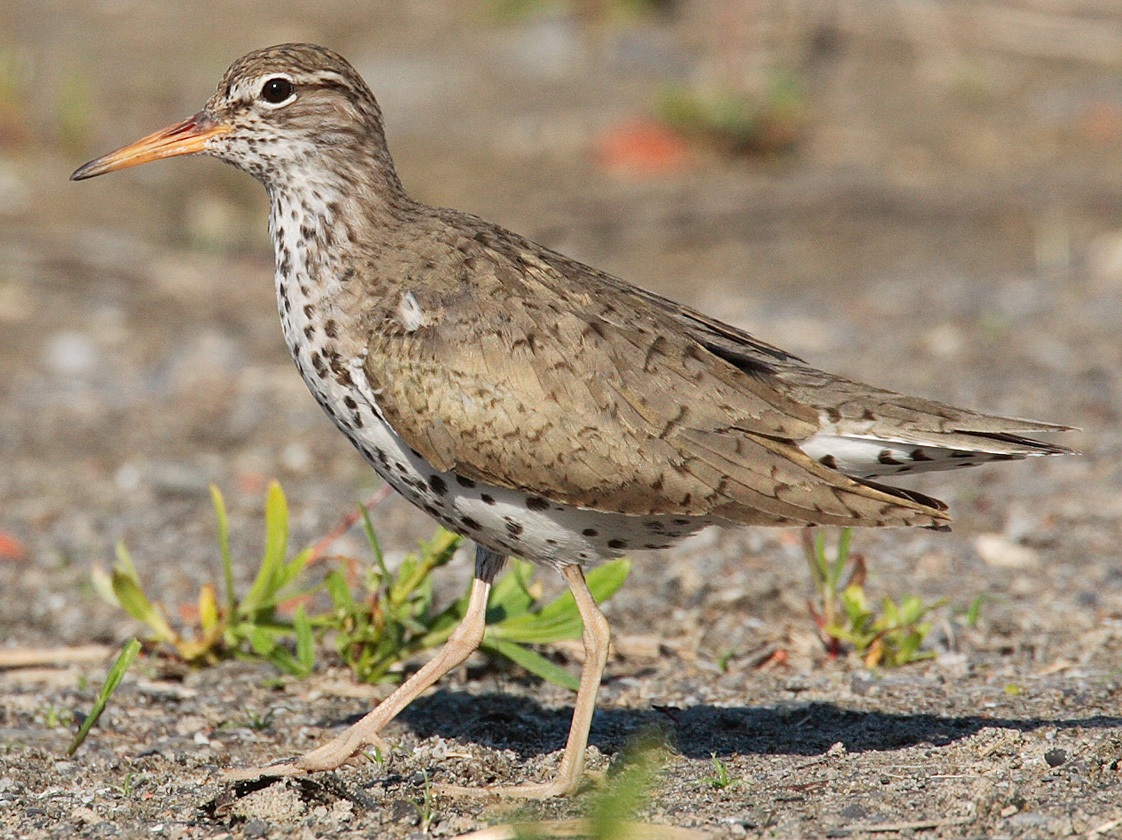
Wikipedia: Spotted sandpiper Source: OTHER
Actitis-macularia-005.jpg
![]() The spotted sandpiper (Actitis macularius) is a small shorebird. The genus name Actitis is from Ancient Greek aktites, "coast-dweller", derived from akte, "coast", and macularius is Latin from macula, "spot".[2]
[more]
The spotted sandpiper (Actitis macularius) is a small shorebird. The genus name Actitis is from Ancient Greek aktites, "coast-dweller", derived from akte, "coast", and macularius is Latin from macula, "spot".[2]
[more]
Red phalarope / Thorshühnchen (Phalaropus fulicarius)

Wikipedia: Red phalarope Source: OTHER
1200px-Phalaropus_fulicarius_10.jpg
This bird appears across the great seas in the following continents:
Europe, North America, South America, Africa.
![]() The red phalarope or grey phalarope (Phalaropus fulicarius) is a small wader. This phalarope breeds in the Arctic regions of North America and Eurasia. It is migratory, and, unusually for a wader, migrating mainly on oceanic routes and wintering at sea on tropical oceans.
[more]
The red phalarope or grey phalarope (Phalaropus fulicarius) is a small wader. This phalarope breeds in the Arctic regions of North America and Eurasia. It is migratory, and, unusually for a wader, migrating mainly on oceanic routes and wintering at sea on tropical oceans.
[more]
Calls: ![]() Flight-call a short and sharp, Coot-like "kit". Cleaner and higher pitched than Red-necked Phalarope. Display sound a rolling cooing, at stable pitch. Other calls: a hissing like the squeezing of a rubber duck, rising quickly in pitch and ending abruptly. [Link]
Flight-call a short and sharp, Coot-like "kit". Cleaner and higher pitched than Red-necked Phalarope. Display sound a rolling cooing, at stable pitch. Other calls: a hissing like the squeezing of a rubber duck, rising quickly in pitch and ending abruptly. [Link]
Physical details: length=20-22 cm,
wingspan=40-44 cm,
weight=40-75 g
Wilson's phalarope / Wilson-Wassertreter (Phalaropus tricolor)
Profile Wikipedia eBird Audubon AllAboutBirds Xeno-Canto
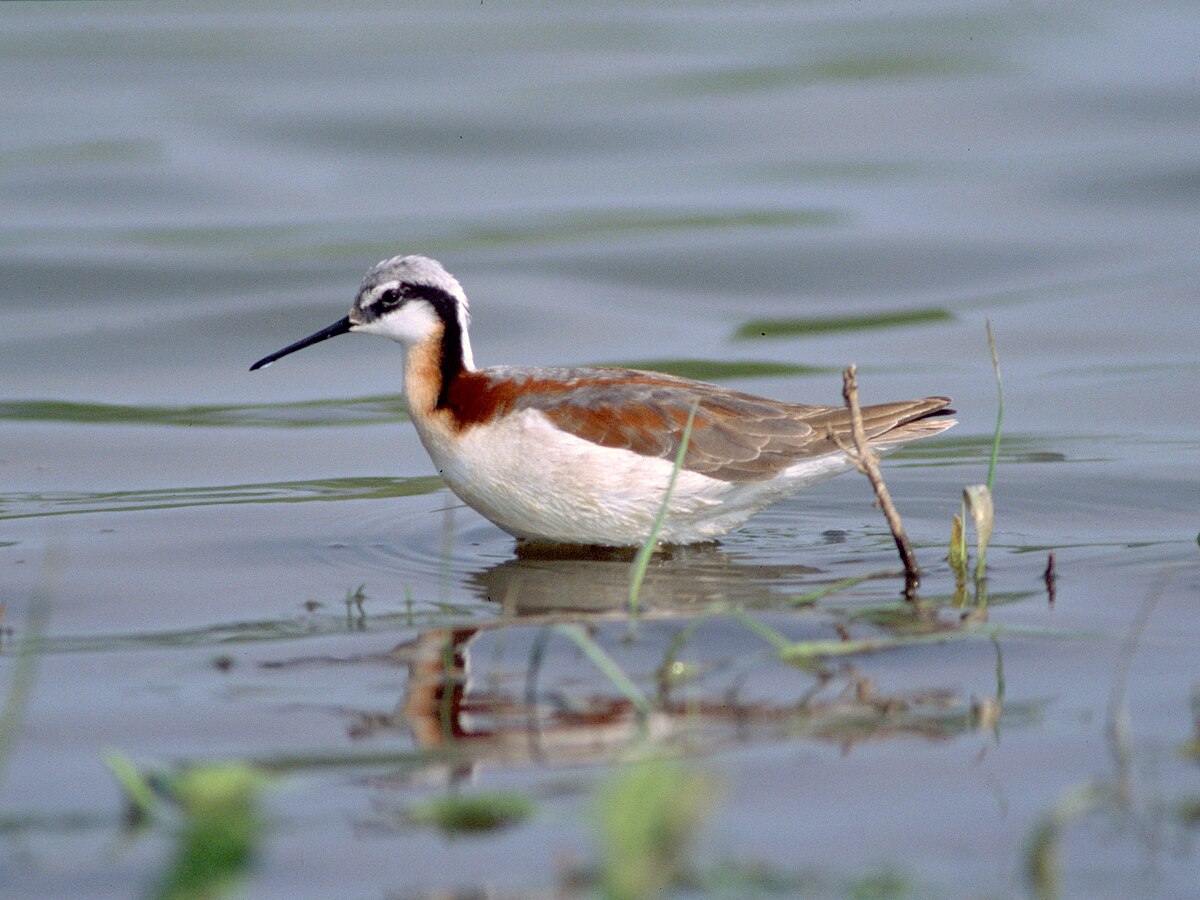
Wikipedia: Wilson's phalarope Source: OTHER
1200px-Phalaropus_tricolor_-_breeding_female.jpg
This bird appears across the great seas in the following continents:
North America, South America, Africa.
General: ![]() Wilson's phalarope (Phalaropus tricolor) is a small wader. This bird, the largest of the phalaropes, breeds in the prairies of North America in western Canada and the western United States. It is migratory, wintering in inland salt lakes near the Andes in Argentina.[2] They are passage migrants through Central America around March/April and again during September/October.[3] The species is a rare vagrant to western Europe.
[more]
Wilson's phalarope (Phalaropus tricolor) is a small wader. This bird, the largest of the phalaropes, breeds in the prairies of North America in western Canada and the western United States. It is migratory, wintering in inland salt lakes near the Andes in Argentina.[2] They are passage migrants through Central America around March/April and again during September/October.[3] The species is a rare vagrant to western Europe.
[more]
Red-necked phalarope / Odinshühnchen (Phalaropus lobatus)
Profile Wikipedia eBird Audubon AllAboutBirds Xeno-Canto NABU
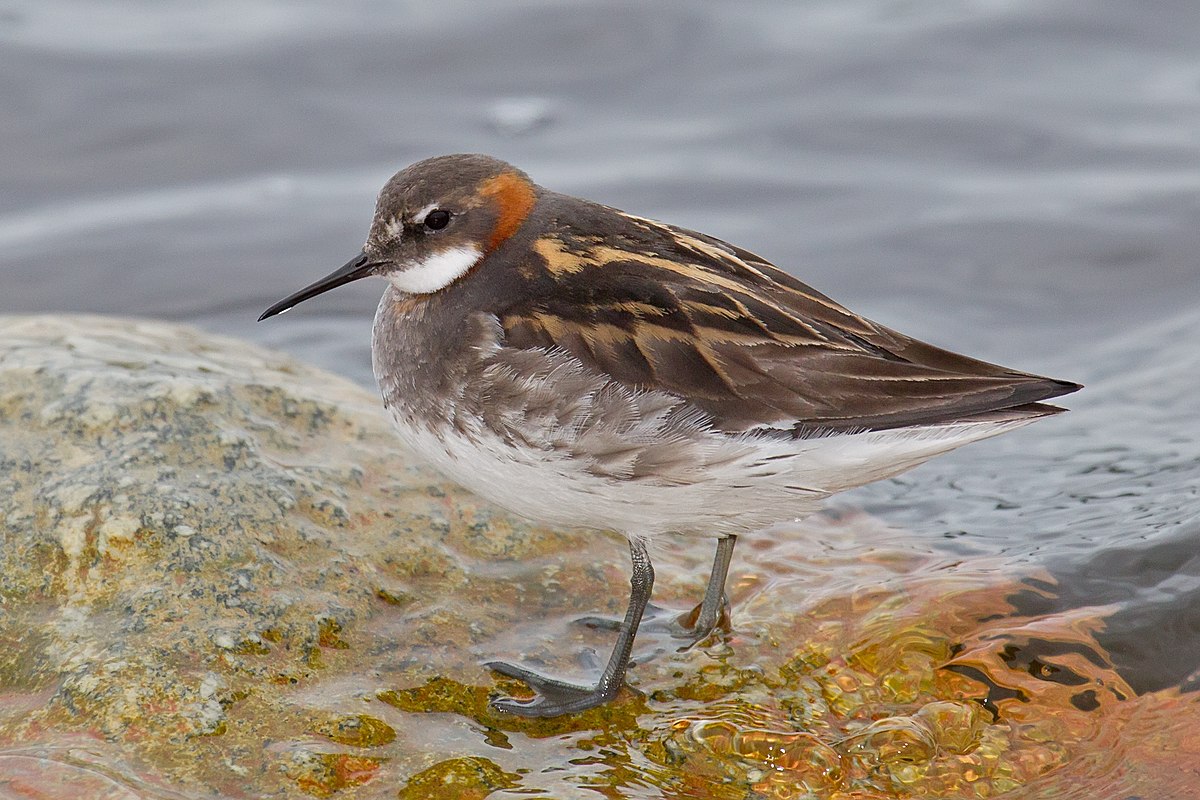
Wikipedia: Red-necked phalarope Source: OTHER
1200px-Red-necked_Phalarope.jpg
This bird appears across the great seas in the following continents:
Europe, North America, South America, Africa, Asia.
![]() The red-necked phalarope (Phalaropus lobatus), also known as the northern phalarope and hyperborean phalarope,[2] is a small wader. This phalarope breeds in the Arctic regions of North America and Eurasia. It is migratory, and, unusually for a wader, winters at sea on tropical oceans.
[more]
The red-necked phalarope (Phalaropus lobatus), also known as the northern phalarope and hyperborean phalarope,[2] is a small wader. This phalarope breeds in the Arctic regions of North America and Eurasia. It is migratory, and, unusually for a wader, winters at sea on tropical oceans.
[more]
Upland sandpiper / Prärieläufer (Bartramia longicauda)
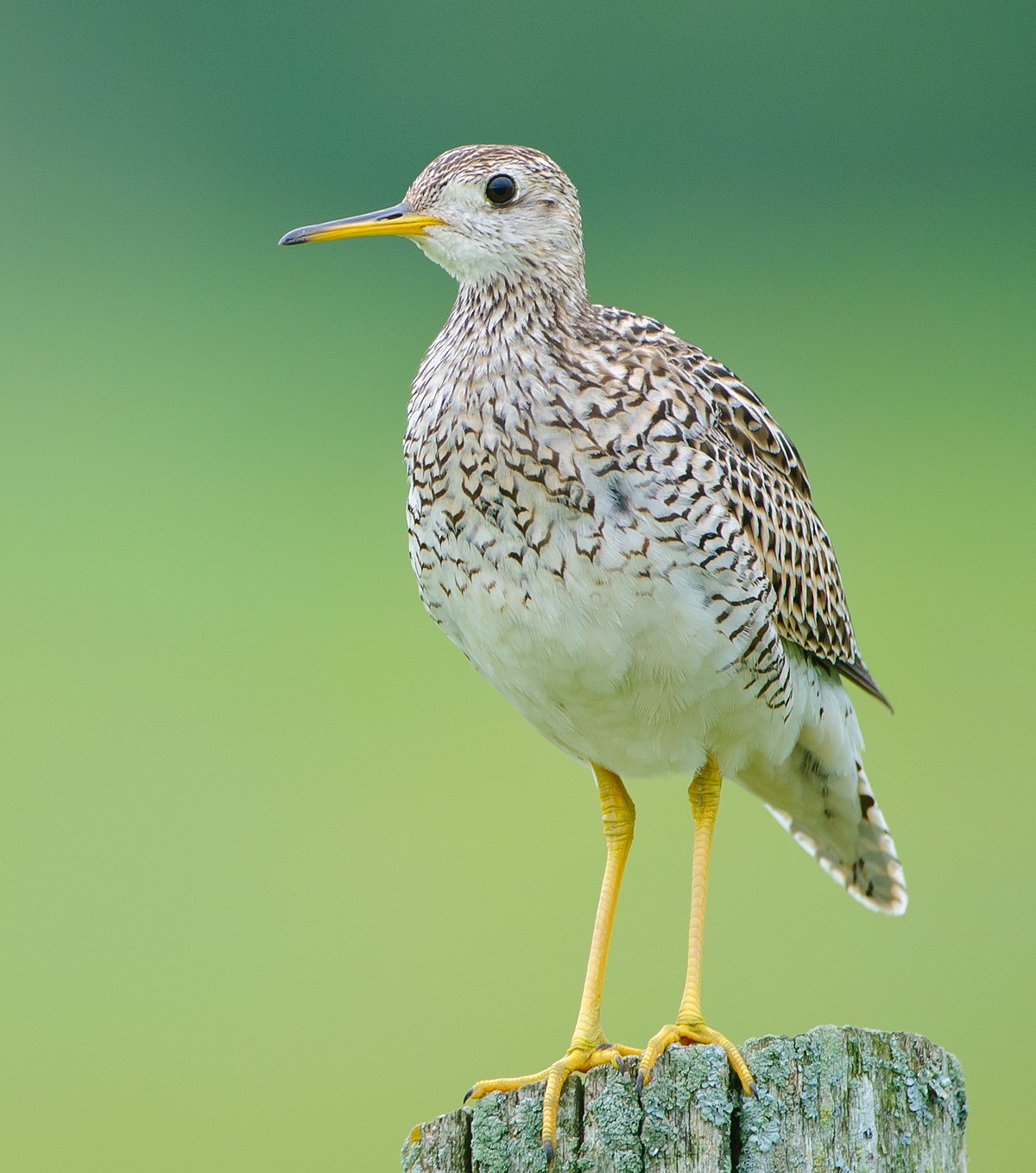
Wikipedia: Upland sandpiper Source: OTHER
1200px-UplandSandpiperOntarioCropped.jpg
This bird appears across the great seas in the following continents:
North America, South America, Australia.
vagrant
Common tern / Flussseeschwalbe (Sterna hirundo)
Profile Wikipedia eBird Vogelwarte BirdLife ZH ornitho.ch bird-song.ch Audubon AllAboutBirds Xeno-Canto BirdID NABU
First observed in 🇨🇭 on 2020-04-27.
This bird appears across the great seas in the following continents:
Europe, North America, South America, Africa, Asia.
Seasonal Behavior: ![]() Die Flussseeschwalbe (Sterna hirundo) ist eine Vogelart aus der Familie der Seeschwalben (Sternidae).
Sie ist in Mitteleuropa ein verbreiteter, aber nicht sehr häufiger Brut- und Sommervogel.
Während der Zugzeiten können im mitteleuropäischen Raum außerdem viele Durchzügler beobachtet werden. [Link]
Die Flussseeschwalbe (Sterna hirundo) ist eine Vogelart aus der Familie der Seeschwalben (Sternidae).
Sie ist in Mitteleuropa ein verbreiteter, aber nicht sehr häufiger Brut- und Sommervogel.
Während der Zugzeiten können im mitteleuropäischen Raum außerdem viele Durchzügler beobachtet werden. [Link]
Vocalization: ![]() Similar to Arctic Tern but deeper. [Link]
Similar to Arctic Tern but deeper. [Link]
Calls: ![]() Lacks latter's high pitched "tip-tip-tip" call, and the drawn out "kree-aaahh" call falls more distinctly in pitch. [Link]
Lacks latter's high pitched "tip-tip-tip" call, and the drawn out "kree-aaahh" call falls more distinctly in pitch. [Link]
Physical details: length=31-35 cm,
wingspan=77-98 cm,
weight=110-150 g
Habitats:
River and lake
Call:
Automatically generated from Xeno-Canto recording
♫ Source: BirdNet
20200427_140813 birdnet 430 - Common tern.mp3
2020-04-27 14.08.13 Luppmen (song?)
Arctic tern / Kü̈stenseeschwalbe (Sterna paradisaea)
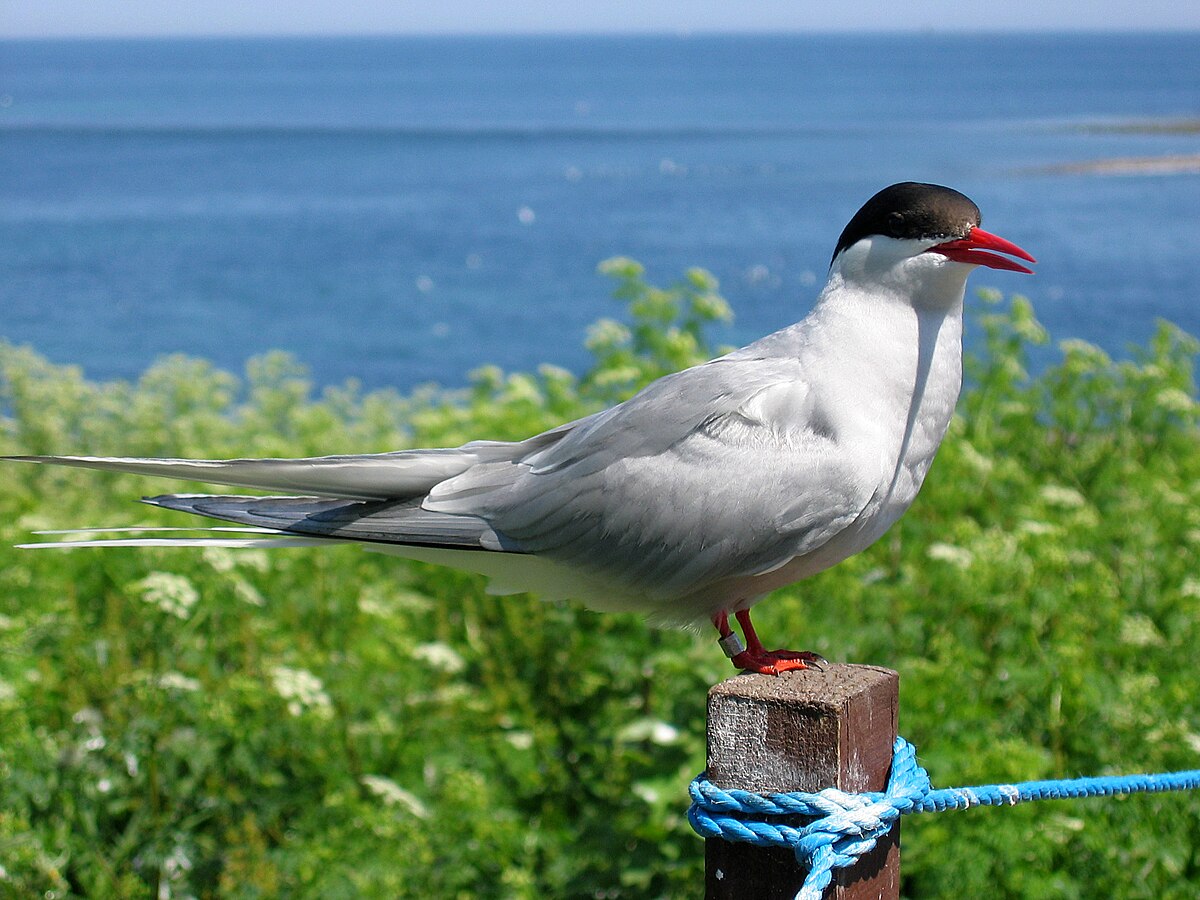
Wikipedia: Arctic tern Source: OTHER
1200px-2009_07_02_-_Arctic_tern_on_Farne_Islands_-_The_blue_rope_demarcates_the_visitors%27_path.JPG
This bird appears across the great seas in the following continents:
Europe, North America, South America, Africa.
General: ![]() The Arctic tern (Sterna paradisaea) is a tern in the family Laridae. This bird has a circumpolar breeding distribution covering the Arctic and sub-Arctic regions of Europe, Asia, and North America (as far south as Brittany and Massachusetts). The species is strongly migratory, seeing two summers each year as it migrates along a convoluted route from its northern breeding grounds to the Antarctic coast for the southern summer and back again about six months later. Recent studies have shown average annual roundtrip lengths of about 70,900 km (44,100 mi) for birds nesting in Iceland and Greenland[3] and about 90,000 km (56,000 mi) for birds nesting in the Netherlands.[4] These are by far the longest migrations known in the animal kingdom. The Arctic tern flies as well as glides through the air. It nests once every one to three years (depending on its mating cycle); once it has finished nesting it takes to the sky for another long southern migration.
[more]
The Arctic tern (Sterna paradisaea) is a tern in the family Laridae. This bird has a circumpolar breeding distribution covering the Arctic and sub-Arctic regions of Europe, Asia, and North America (as far south as Brittany and Massachusetts). The species is strongly migratory, seeing two summers each year as it migrates along a convoluted route from its northern breeding grounds to the Antarctic coast for the southern summer and back again about six months later. Recent studies have shown average annual roundtrip lengths of about 70,900 km (44,100 mi) for birds nesting in Iceland and Greenland[3] and about 90,000 km (56,000 mi) for birds nesting in the Netherlands.[4] These are by far the longest migrations known in the animal kingdom. The Arctic tern flies as well as glides through the air. It nests once every one to three years (depending on its mating cycle); once it has finished nesting it takes to the sky for another long southern migration.
[more]
Vocalization: ![]() Similar to Common Tern but higher pitched. [Link]
Similar to Common Tern but higher pitched. [Link]
Calls: ![]() Typical call a series of high pitched "tip-tip-tip", and longer, ringing, high-pitched "kriiiiii" calls. The drawn out "kree-aaahh" call falls less distinctly in pitch than Common Tern. [Link]
Typical call a series of high pitched "tip-tip-tip", and longer, ringing, high-pitched "kriiiiii" calls. The drawn out "kree-aaahh" call falls less distinctly in pitch than Common Tern. [Link]
Physical details: length=33-35 cm,
wingspan=75-85 cm,
weight=95-120 g
South american tern / Falklandseeschwalbe (Sterna hirundinacea)
General: ![]() Die Falklandseeschwalbe (Sterna hirundinacea) ist eine monotypische Art aus der Familie der Seeschwalben. Sie kommt ausschließlich in Südamerika und auf den Falklandinseln vor.
[more]
Die Falklandseeschwalbe (Sterna hirundinacea) ist eine monotypische Art aus der Familie der Seeschwalben. Sie kommt ausschließlich in Südamerika und auf den Falklandinseln vor.
[more]
American oystercatcher / Braunmantel-Austernfischer (Haematopus palliatus)
Profile Wikipedia eBird Audubon AllAboutBirds Xeno-Canto

Wikipedia: American oystercatcher Source: OTHER
1200px-American_oystercatchers_at_Fort_Tilden_%2860747%29.jpg
![]() The American oystercatcher (Haematopus palliatus), occasionally called the American pied oystercatcher, is a member of family Haematopodidae. Originally called the "sea pie", it was renamed in 1731 when naturalist Mark Catesby observed the bird eating oysters.[2] The current population of American oystercatchers is estimated to be 43,000.[2] There are estimated to be 1,500 breeding pairs along the Atlantic and Gulf Coasts of the US.[3] The bird is marked by its black and white body and a long, thick orange beak.
[more]
The American oystercatcher (Haematopus palliatus), occasionally called the American pied oystercatcher, is a member of family Haematopodidae. Originally called the "sea pie", it was renamed in 1731 when naturalist Mark Catesby observed the bird eating oysters.[2] The current population of American oystercatchers is estimated to be 43,000.[2] There are estimated to be 1,500 breeding pairs along the Atlantic and Gulf Coasts of the US.[3] The bird is marked by its black and white body and a long, thick orange beak.
[more]
Blackish oystercatcher (Haematopus ater)
Profile Wikipedia eBird Xeno-Canto

Wikipedia: Blackish oystercatcher Source: OTHER
1200px-Blackish_oystercatcher_Bahia_Inglesa_Chile.jpg
![]() The blackish oystercatcher (Haematopus ater) is a species of wading bird in the oystercatcher family Haematopodidae. It is found in Argentina, Chile, the Falkland Islands and Peru, and is a vagrant to Uruguay. The population is estimated at 15,000–80,000.[2]
[more]
The blackish oystercatcher (Haematopus ater) is a species of wading bird in the oystercatcher family Haematopodidae. It is found in Argentina, Chile, the Falkland Islands and Peru, and is a vagrant to Uruguay. The population is estimated at 15,000–80,000.[2]
[more]
Wattled jacana (Jacana jacana)
Profile Wikipedia eBird Xeno-Canto

Wikipedia: Wattled jacana Source: OTHER
1200px-Wattled_jacana_%28Jacana_jacana%29.JPG
![]() The wattled jacana (Jacana jacana) is a wader which is a resident breeder from western Panama and Trinidad south through most of South America east of the Andes.
[more]
The wattled jacana (Jacana jacana) is a wader which is a resident breeder from western Panama and Trinidad south through most of South America east of the Andes.
[more]
Family Burhinidae (Triele, Haematopodidae – Austernfischer und Recurvirostridae – Säbelschnäblerverwandte):
Peruvian thick-knee / Inkatriel (Burhinus superciliaris)

Wikipedia: Peruvian thick-knee Source: OTHER
1200px-Peruvian_Thick-knee_%28Burhinus_superciliaris%29%2C_crop.jpg
![]() The Peruvian thick-knee (Burhinus superciliaris) is a species of bird in the family Burhinidae. It is found in Chile, Ecuador, and Peru. Its natural habitats are subtropical or tropical dry shrubland, subtropical or tropical seasonally wet or flooded lowland grassland, and pastureland. It is a ground-dwelling bird and feeds on insects and small animals.
[more]
The Peruvian thick-knee (Burhinus superciliaris) is a species of bird in the family Burhinidae. It is found in Chile, Ecuador, and Peru. Its natural habitats are subtropical or tropical dry shrubland, subtropical or tropical seasonally wet or flooded lowland grassland, and pastureland. It is a ground-dwelling bird and feeds on insects and small animals.
[more]
Black-necked stilt / Amerikanischer Stelzenläufer (Himantopus mexicanus)
Profile Wikipedia eBird Audubon AllAboutBirds Xeno-Canto
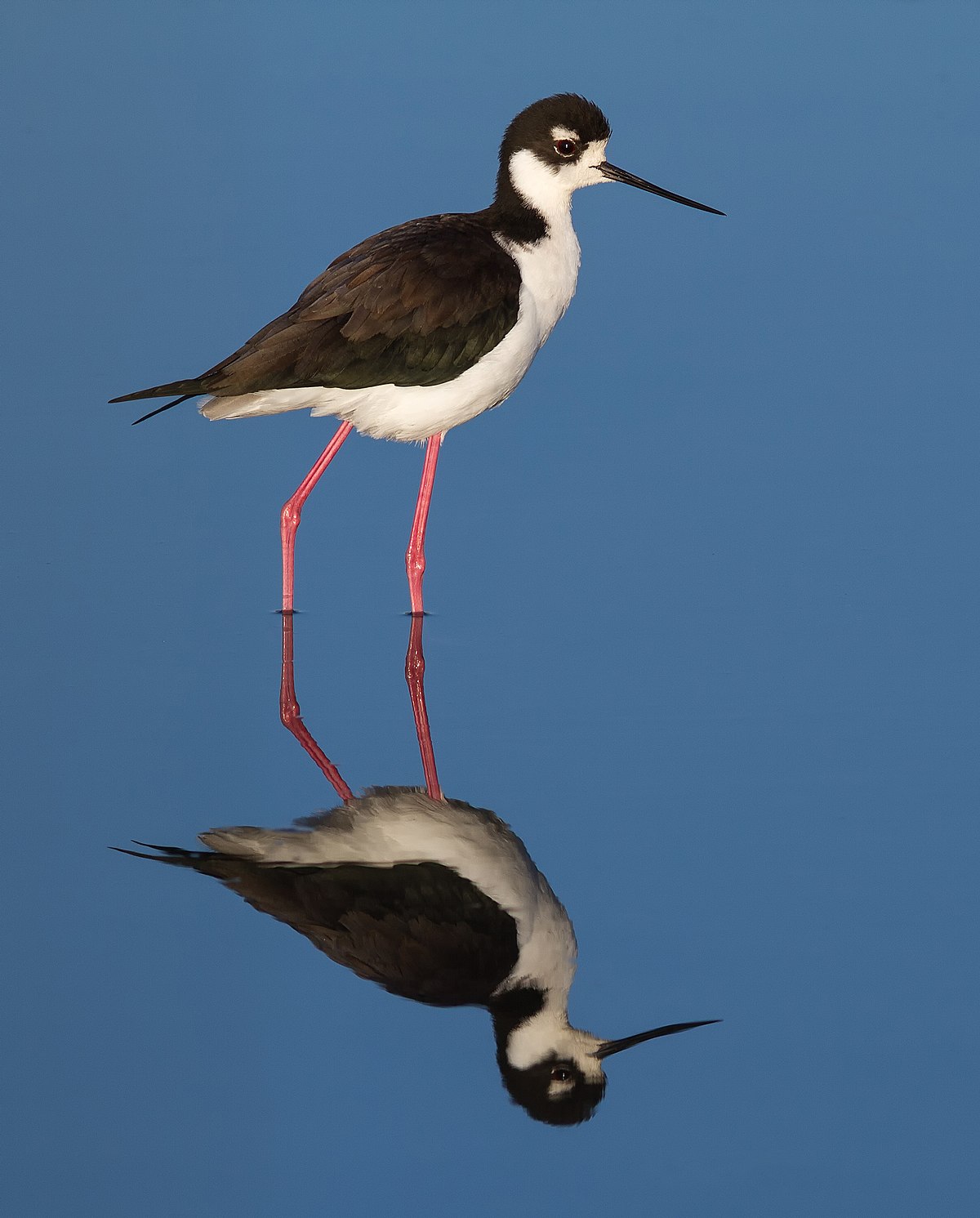
Wikipedia: Black-necked stilt Source: OTHER
1200px-Black-necked_Stilt_%28Himantopus_mexicanus%29%2C_Corte_Madera.jpg
![]() The black-necked stilt (Himantopus mexicanus) is a locally abundant shorebird of American wetlands and coastlines. It is found from the coastal areas of California through much of the interior western United States and along the Gulf of Mexico as far east as Florida, then south through Central America and the Caribbean to Ecuador and the Galápagos Islands. The northernmost populations, particularly those from inland, are migratory, wintering from the extreme south of the United States to southern Mexico, rarely as far south as Costa Rica; on the Baja California peninsula it is only found regularly in winter.[2]
[more]
The black-necked stilt (Himantopus mexicanus) is a locally abundant shorebird of American wetlands and coastlines. It is found from the coastal areas of California through much of the interior western United States and along the Gulf of Mexico as far east as Florida, then south through Central America and the Caribbean to Ecuador and the Galápagos Islands. The northernmost populations, particularly those from inland, are migratory, wintering from the extreme south of the United States to southern Mexico, rarely as far south as Costa Rica; on the Baja California peninsula it is only found regularly in winter.[2]
[more]
American coot (Fulica americana)
Profile Wikipedia eBird Audubon AllAboutBirds Xeno-Canto
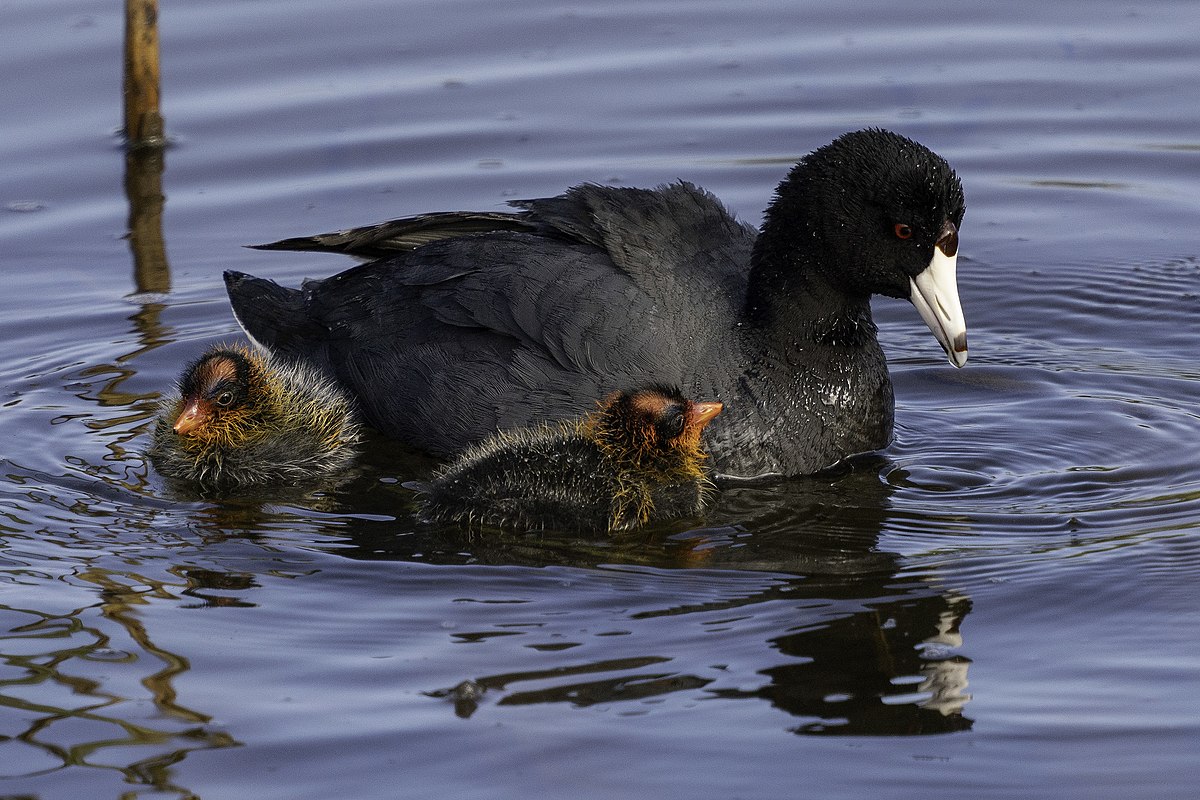
Wikipedia: American coot Source: OTHER
1200px-American-coot-casey-klebba.jpg
![]() The American coot (Fulica americana), also known as a mud hen or pouldeau, is a bird of the family Rallidae. Though commonly mistaken for ducks, American coots are only distantly related to ducks, belonging to a separate order. Unlike the webbed feet of ducks, coots have broad, lobed scales on their lower legs and toes that fold back with each step in order to facilitate walking on dry land.[2] Coots live near water, typically inhabiting wetlands and open water bodies in North America. Groups of coots are called covers[3] or rafts.[citation needed] The oldest known coot lived to be 22 years old.[2]
[more]
The American coot (Fulica americana), also known as a mud hen or pouldeau, is a bird of the family Rallidae. Though commonly mistaken for ducks, American coots are only distantly related to ducks, belonging to a separate order. Unlike the webbed feet of ducks, coots have broad, lobed scales on their lower legs and toes that fold back with each step in order to facilitate walking on dry land.[2] Coots live near water, typically inhabiting wetlands and open water bodies in North America. Groups of coots are called covers[3] or rafts.[citation needed] The oldest known coot lived to be 22 years old.[2]
[more]
Slate-colored coot (Fulica ardesiaca)
Profile Wikipedia eBird Xeno-Canto

Wikipedia: Slate-colored coot Source: OTHER
1200px-Andean_Coot_RWD2.jpg
![]() The Andean coot (Fulica ardesiaca), also known as the slate-coloured coot, is a species of bird in the family Rallidae. It is found in the Andes from far southwestern Colombia to northwestern Argentina. Its natural habitats are swamps and freshwater lakes. Fossils tentatively assigned to this species are known from the Laguna de Tagua Tagua formation of Chile.[2]
[more]
The Andean coot (Fulica ardesiaca), also known as the slate-coloured coot, is a species of bird in the family Rallidae. It is found in the Andes from far southwestern Colombia to northwestern Argentina. Its natural habitats are swamps and freshwater lakes. Fossils tentatively assigned to this species are known from the Laguna de Tagua Tagua formation of Chile.[2]
[more]
Virginia rail (Rallus limicola)
Profile Wikipedia eBird Audubon AllAboutBirds Xeno-Canto

Wikipedia: Virginia rail Source: OTHER
1200px-Rallus_limicola_-Cloisters_Park%2C_Morro_Bay%2C_California%2C_USA-8_%281%29.jpg
![]() The Virginia rail (Rallus limicola) is a small waterbird, of the family Rallidae.
These birds remain fairly common despite continuing loss of habitat, but are secretive by nature and more often heard than seen.[2] They are also considered a game species in some provinces and states, though rarely hunted.[3] The Ecuadorian rail is often considered a subspecies, but some taxonomic authorities consider it distinct.
[more]
The Virginia rail (Rallus limicola) is a small waterbird, of the family Rallidae.
These birds remain fairly common despite continuing loss of habitat, but are secretive by nature and more often heard than seen.[2] They are also considered a game species in some provinces and states, though rarely hunted.[3] The Ecuadorian rail is often considered a subspecies, but some taxonomic authorities consider it distinct.
[more]
Mangrove rail / Klapperralle (Rallus longirostris)
Profile Wikipedia eBird Xeno-Canto
![]()
Wikipedia: Mangrove rail Source: OTHER
lossy-page1-1200px-Rallus_longirostris_-_1700-1880_-_Print_-_Iconographia_Zoologica_-_Special_Collections_University_of_Amsterdam_-_UBA01_IZ17500025.tif.jpg
![]() The mangrove rail (Rallus longirostris) is a species of bird in the family Rallidae.
It is found in Central and South America. It was formerly considered conspecific with the clapper rail (Rallus crepitans).
[more]
The mangrove rail (Rallus longirostris) is a species of bird in the family Rallidae.
It is found in Central and South America. It was formerly considered conspecific with the clapper rail (Rallus crepitans).
[more]
Common gallinule (Gallinula galeata)
Profile Wikipedia eBird Audubon AllAboutBirds Xeno-Canto
Common gallinule, juvenile, Florida. 2023-09-23 20.46.10 Florida
First observed in Florida on 2023-09-23.
![]() The common gallinule (Gallinula galeata) is a bird in the family Rallidae. It was split from the common moorhen by the American Ornithologists' Union in July 2011.[3] It lives around well-vegetated marshes, ponds, canals, and other wetlands in the Americas. The species is not found in the polar regions or many tropical rainforests. Elsewhere, the common gallinule is likely the most commonly seen rail species in much of North America, except for the American coot in some regions.
[more]
The common gallinule (Gallinula galeata) is a bird in the family Rallidae. It was split from the common moorhen by the American Ornithologists' Union in July 2011.[3] It lives around well-vegetated marshes, ponds, canals, and other wetlands in the Americas. The species is not found in the polar regions or many tropical rainforests. Elsewhere, the common gallinule is likely the most commonly seen rail species in much of North America, except for the American coot in some regions.
[more]
White-throated crake (Laterallus albigularis)
Profile Wikipedia eBird Xeno-Canto

Wikipedia: White-throated crake Source: OTHER
1200px-Laterallus_albigularis.jpg
![]() The white-throated crake (Laterallus albigularis) is a species of bird in the family Rallidae.
[more]
The white-throated crake (Laterallus albigularis) is a species of bird in the family Rallidae.
[more]
Gray-breasted crake (Laterallus exilis)
Profile Wikipedia eBird Xeno-Canto
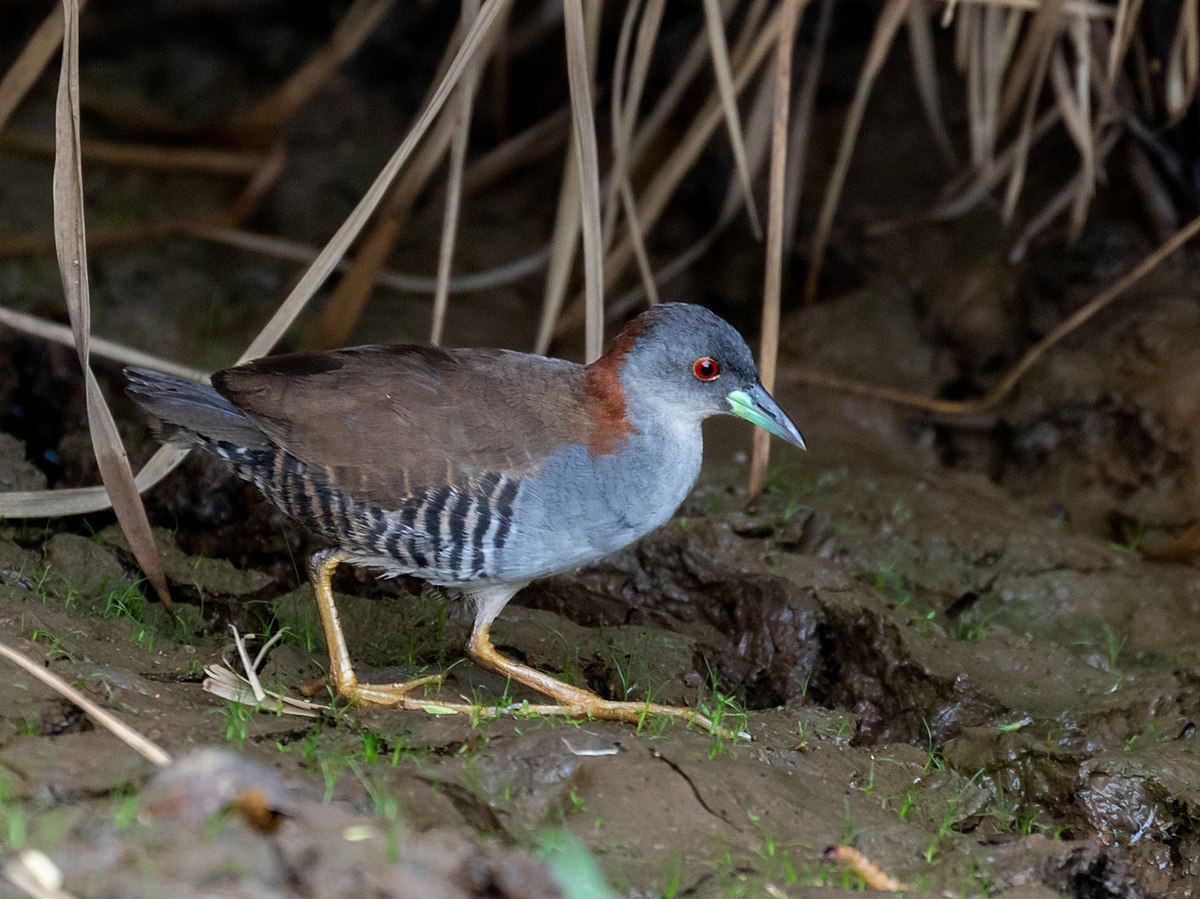
Wikipedia: Gray-breasted crake Source: OTHER
1200px-Laterallus_exilis_-_Grey-breasted_Crake%3B_Arari%2C_Maranh%C3%A3o%2C_Brazil.jpg
![]() The grey-breasted crake (Laterallus exilis) is a species of bird in the family Rallidae. It is found in Argentina, Belize, Bolivia, Brazil, Colombia, Costa Rica, Ecuador, French Guiana, Guatemala, Guyana, Honduras, Nicaragua, Panama, Paraguay, Peru, Suriname, Trinidad and Tobago, and Venezuela. Its natural habitats are swamps and pastureland.
[more]
The grey-breasted crake (Laterallus exilis) is a species of bird in the family Rallidae. It is found in Argentina, Belize, Bolivia, Brazil, Colombia, Costa Rica, Ecuador, French Guiana, Guatemala, Guyana, Honduras, Nicaragua, Panama, Paraguay, Peru, Suriname, Trinidad and Tobago, and Venezuela. Its natural habitats are swamps and pastureland.
[more]
Rufous-sided crake (Laterallus melanophaius)
Profile Wikipedia eBird Xeno-Canto

Wikipedia: Rufous-sided crake Source: OTHER
SAN%C3%83-VERMELHA_%28Laterallus_melanophaius%29_%2811568760295%29.jpg
![]() The rufous-sided crake (Laterallus melanophaius) is a species of bird in the family Rallidae.
It is found in Argentina, Bolivia, Brazil, Colombia, Ecuador, Guyana, Paraguay, Peru, Suriname, Uruguay, and Venezuela.
Its natural habitat is swamps.
[more]
The rufous-sided crake (Laterallus melanophaius) is a species of bird in the family Rallidae.
It is found in Argentina, Bolivia, Brazil, Colombia, Ecuador, Guyana, Paraguay, Peru, Suriname, Uruguay, and Venezuela.
Its natural habitat is swamps.
[more]
Purple gallinule / Zwergsultanshuhn (Porphyrio martinica)
This bird appears across the great seas in the following continents:
North America, South America, Africa.
![]() Das Zwergsultanshuhn (Porphyrio martinicus, Syn.: Porphyrula martinica) ist ein vor allem in Amerika heimischer Rallenvogel.
[more]
Das Zwergsultanshuhn (Porphyrio martinicus, Syn.: Porphyrula martinica) ist ein vor allem in Amerika heimischer Rallenvogel.
[more]
Azure gallinule (Porphyrio flavirostris)

Wikipedia: Azure gallinule Source: OTHER
1200px-Azure_Gallinule%2C_Kernahan%2C_Trinidad_3.jpg
![]() The azure gallinule (Porphyrio flavirostris) is a species of bird in the family Rallidae.
It is found in Argentina, Bolivia, Brazil, Colombia, Ecuador, French Guiana, Guyana, Paraguay, Peru, Suriname, Trinidad and Tobago, and Venezuela.
[more]
The azure gallinule (Porphyrio flavirostris) is a species of bird in the family Rallidae.
It is found in Argentina, Bolivia, Brazil, Colombia, Ecuador, French Guiana, Guyana, Paraguay, Peru, Suriname, Trinidad and Tobago, and Venezuela.
[more]
Sora / Carolinasumpfhuhn (Porzana carolina)
Profile Wikipedia eBird Audubon AllAboutBirds Xeno-Canto
![]() Sora or SORA may refer to:
[more]
Sora or SORA may refer to:
[more]
Black-banded crake (alternate) (Anurolimnas fasciatus)
Chestnut-headed crake (Anurolimnas castaneiceps)

Wikipedia: Chestnut-headed crake Source: OTHER
PorzanaCastaneicepsSmit.jpg
![]() The chestnut-headed crake (Rufirallus castaneiceps) is a species of bird in the family Rallidae.[2] It is found throughout the Peruvian Amazon Basin and neighboring areas. Its natural habitats are subtropical or tropical moist lowland forest and heavily degraded former forest.
[more]
The chestnut-headed crake (Rufirallus castaneiceps) is a species of bird in the family Rallidae.[2] It is found throughout the Peruvian Amazon Basin and neighboring areas. Its natural habitats are subtropical or tropical moist lowland forest and heavily degraded former forest.
[more]
Russet-crowned crake (Anurolimnas viridis)

Wikipedia: Russet-crowned crake Source: OTHER
1200px-Anurolimnas_viridis_%28M%C3%BCller%2C_1776%29%2C_Rallidae%2C_Atlantic_forest%2C_northern_littoral_of_Bahia%2C_Brazil_%2814224836829%29.jpg
![]() The russet-crowned crake (Rufirallus viridis) is a species of bird in the family Rallidae.[2]
[more]
The russet-crowned crake (Rufirallus viridis) is a species of bird in the family Rallidae.[2]
[more]
Gray-cowled wood-rail / Cayenneralle (Aramides cajaneus)
Profile Wikipedia eBird Xeno-Canto

Wikipedia: Gray-cowled wood-rail Source: OTHER
1200px-Aramides_cajanea_%28Chilacoa_colinegra%29_%2814636758294%29.jpg
![]() The grey-cowled wood rail or grey-necked wood rail (Aramides cajaneus) is a species of bird in the family Rallidae, the rails. It lives primarily in the forests, mangroves, and swamps of Central and South America. Of the two subspecies, A. c. avicenniae is found in southeastern Brazil, while the nominate is found throughout the portion of the range not occupied by the other subspecies. The species as a whole is usually found at elevations from sea level to 2,000 metres (6,600 ft), although some have been found above that. This bird's large extent of occurrence along with its population is why it is considered to be least-concern by the International Union for Conservation of Nature (IUCN). In some places, it is occasionally hunted and kept for food.
[more]
The grey-cowled wood rail or grey-necked wood rail (Aramides cajaneus) is a species of bird in the family Rallidae, the rails. It lives primarily in the forests, mangroves, and swamps of Central and South America. Of the two subspecies, A. c. avicenniae is found in southeastern Brazil, while the nominate is found throughout the portion of the range not occupied by the other subspecies. The species as a whole is usually found at elevations from sea level to 2,000 metres (6,600 ft), although some have been found above that. This bird's large extent of occurrence along with its population is why it is considered to be least-concern by the International Union for Conservation of Nature (IUCN). In some places, it is occasionally hunted and kept for food.
[more]
Rufous-necked wood-rail (Aramides axillaris)
Profile Wikipedia eBird Xeno-Canto

Wikipedia: Rufous-necked wood-rail Source: OTHER
1200px-Rufous-necked_Wood_Rail.jpg
![]() The rufous-necked wood rail (Aramides axillaris) is a species of bird in the family Rallidae.
It is found in Belize, Colombia, Costa Rica, Ecuador, El Salvador, French Guiana, Guyana, Honduras, Mexico, Nicaragua, Panama, Peru, Suriname, Trinidad and Tobago, and Venezuela.
Its natural habitats are subtropical or tropical dry forest, subtropical or tropical moist lowland forest, and subtropical or tropical mangrove forest.
[more]
The rufous-necked wood rail (Aramides axillaris) is a species of bird in the family Rallidae.
It is found in Belize, Colombia, Costa Rica, Ecuador, El Salvador, French Guiana, Guyana, Honduras, Mexico, Nicaragua, Panama, Peru, Suriname, Trinidad and Tobago, and Venezuela.
Its natural habitats are subtropical or tropical dry forest, subtropical or tropical moist lowland forest, and subtropical or tropical mangrove forest.
[more]
Brown wood-rail (Aramides wolfi)
Profile Wikipedia eBird Xeno-Canto

Wikipedia: Brown wood-rail Source: OTHER
1200px-Planches_enlumin%C3%A9es_d%27histoire_naturelle_%289933212185%29.jpg
![]() The brown wood rail (Aramides wolfi) is a species of bird in the family Rallidae. It is found in Colombia, Ecuador, and possibly Peru.
[more]
The brown wood rail (Aramides wolfi) is a species of bird in the family Rallidae. It is found in Colombia, Ecuador, and possibly Peru.
[more]
Red-winged wood-rail (Aramides calopterus)
Profile Wikipedia eBird Xeno-Canto

Wikipedia: Red-winged wood-rail Source: OTHER
1200px-AramidesCalopterusSmit.jpg
![]() The red-winged wood rail (Aramides calopterus) is a species of bird in the family Rallidae.
It is found in the western Amazon Basin of Brazil, Ecuador and Peru.
Its natural habitats are subtropical or tropical moist lowland forests and rivers.
[more]
The red-winged wood rail (Aramides calopterus) is a species of bird in the family Rallidae.
It is found in the western Amazon Basin of Brazil, Ecuador and Peru.
Its natural habitats are subtropical or tropical moist lowland forests and rivers.
[more]
Spotted rail (Pardirallus maculatus)
Profile Wikipedia eBird Xeno-Canto

Wikipedia: Spotted rail Source: OTHER
1200px-Spotted_Rail.jpg
![]() The spotted rail (Pardirallus maculatus) is a species of bird in the family Rallidae.
It is found in Argentina, Belize, Bolivia, Brazil, Cayman Islands, Chile, Colombia, Costa Rica, Cuba, the Dominican Republic, Ecuador, El Salvador, French Guiana, Guyana, Jamaica, Mexico, Panama, Paraguay, Peru, Suriname, Trinidad and Tobago, Uruguay, Venezuela, and possibly Honduras.
The spotted rail is found in marshland and swamps.
[more]
The spotted rail (Pardirallus maculatus) is a species of bird in the family Rallidae.
It is found in Argentina, Belize, Bolivia, Brazil, Cayman Islands, Chile, Colombia, Costa Rica, Cuba, the Dominican Republic, Ecuador, El Salvador, French Guiana, Guyana, Jamaica, Mexico, Panama, Paraguay, Peru, Suriname, Trinidad and Tobago, Uruguay, Venezuela, and possibly Honduras.
The spotted rail is found in marshland and swamps.
[more]
Plumbeous rail (Pardirallus sanguinolentus)
Profile Wikipedia eBird Xeno-Canto

Wikipedia: Plumbeous rail Source: OTHER
1200px-Plumbeous_Rail.jpg
![]() The plumbeous rail (Pardirallus sanguinolentus) is a species of bird in the family Rallidae.
It is found in Argentina, Bolivia, Brazil, Chile, Ecuador, Paraguay, Peru and Uruguay, and is a vagrant to the Falkland Islands.
Its natural habitat is swamps. Adult plumbeous rail are distinguished by their gray and brown plumage and long colorful bill. The plumbeous rail is the only long-billed rail expected to be found in the Andean marshes with the exception of the rare Bogota rail. Fossils of this species are known from the Laguna de Tagua Tagua formation of Chile.[2]
[more]
The plumbeous rail (Pardirallus sanguinolentus) is a species of bird in the family Rallidae.
It is found in Argentina, Bolivia, Brazil, Chile, Ecuador, Paraguay, Peru and Uruguay, and is a vagrant to the Falkland Islands.
Its natural habitat is swamps. Adult plumbeous rail are distinguished by their gray and brown plumage and long colorful bill. The plumbeous rail is the only long-billed rail expected to be found in the Andean marshes with the exception of the rare Bogota rail. Fossils of this species are known from the Laguna de Tagua Tagua formation of Chile.[2]
[more]
Blackish rail (Pardirallus nigricans)

Wikipedia: Blackish rail Source: OTHER
Pardirallus_nigricans-Blackish_Rail.jpg
![]() The blackish rail (Pardirallus nigricans) is a species of bird in the rail family Rallidae from South America. The species is closely related to the plumbeous rail, and has been treated as being the same species, or placed with that species in the genus Ortygonax. It has also been placed in the genus Rallus.[2]
[more]
The blackish rail (Pardirallus nigricans) is a species of bird in the rail family Rallidae from South America. The species is closely related to the plumbeous rail, and has been treated as being the same species, or placed with that species in the genus Ortygonax. It has also been placed in the genus Rallus.[2]
[more]
Uniform crake (Amaurolimnas concolor)

Wikipedia: Uniform crake Source: OTHER
1200px-Amaurolimnas_concolor_-_Uniform_crake%3B_Dourado%2C_S%C3%A3o_Paulo%2C_Brazil.jpg
![]() The uniform crake (Amaurolimnas concolor) is a species of bird in the family Rallidae, the only member of the genus Amaurolimnas.
[more]
The uniform crake (Amaurolimnas concolor) is a species of bird in the family Rallidae, the only member of the genus Amaurolimnas.
[more]
Limpkin / Rallenkranich (Aramus guarauna)

Wikipedia: Limpkin Source: OTHER
1200px-Limpkin%2C_Florida_05.jpg
![]() The limpkin (Aramus guarauna), also called carrao, courlan, and crying bird, is a large wading bird related to rails and cranes, and the only extant species in the genus Aramus and the family Aramidae. It is found mostly in wetlands in warm parts of the Americas, from Florida to northern Argentina. It feeds on molluscs, with the diet dominated by apple snails of the genus Pomacea. Its name derives from its seeming limp when it walks.[2]
[more]
The limpkin (Aramus guarauna), also called carrao, courlan, and crying bird, is a large wading bird related to rails and cranes, and the only extant species in the genus Aramus and the family Aramidae. It is found mostly in wetlands in warm parts of the Americas, from Florida to northern Argentina. It feeds on molluscs, with the diet dominated by apple snails of the genus Pomacea. Its name derives from its seeming limp when it walks.[2]
[more]
Common trumpeter / Grauflügel-Trompetervogel (Psophia crepitans)
![]() Der Grauflügel-Trompetervogel (Psophia crepitans) ist ein 46 bis 53 Zentimeter großer Vertreter aus der Familie der Trompetervögel.
[more]
Der Grauflügel-Trompetervogel (Psophia crepitans) ist ein 46 bis 53 Zentimeter großer Vertreter aus der Familie der Trompetervögel.
[more]
Sungrebe / Zwergbinsenralle (Heliornis fulica)
Profile Wikipedia eBird Xeno-Canto
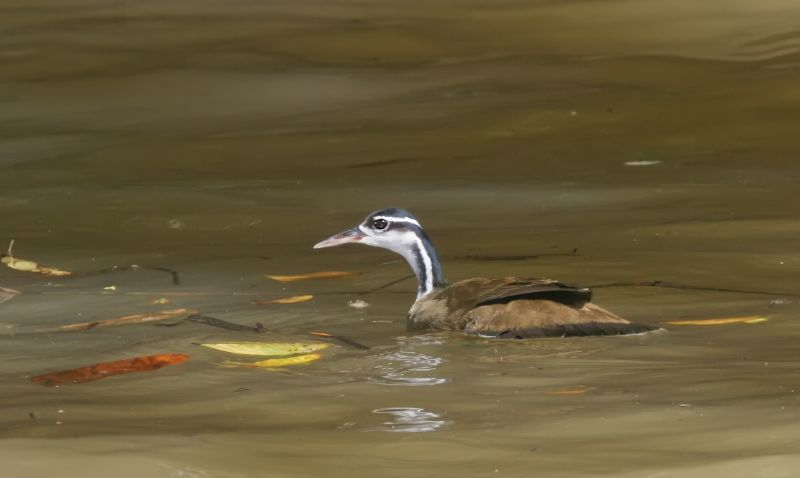
Wikipedia: Sungrebe Source: OTHER
Sungrebe.jpg
![]() The sungrebe (Heliornis fulica) is a small aquatic gruiforme found in the tropical and subtropical Americas from northeastern Mexico to central Ecuador and southern Brazil.[2]
[more]
The sungrebe (Heliornis fulica) is a small aquatic gruiforme found in the tropical and subtropical Americas from northeastern Mexico to central Ecuador and southern Brazil.[2]
[more]
Sunbittern / Sonnenralle (Eurypyga helias)
Profile Wikipedia eBird Xeno-Canto

Wikipedia: Sunbittern Source: OTHER
1200px-Sunbittern_%28Eurypyga_helias%29.JPG
![]() The sunbittern (Eurypyga helias) is a bittern-like bird of tropical regions of the Americas, and the sole member of the family Eurypygidae (sometimes spelled Eurypigidae) and genus Eurypyga. It is found in Central and South America, and has three subspecies. The sunbittern shows both morphological and molecular similarities with the kagu (Rhynochetos jubatus) of New Caledonia, indicating a gondwanic origin, both species being placed in the clade Eurypygiformes.[3]
[more]
The sunbittern (Eurypyga helias) is a bittern-like bird of tropical regions of the Americas, and the sole member of the family Eurypygidae (sometimes spelled Eurypigidae) and genus Eurypyga. It is found in Central and South America, and has three subspecies. The sunbittern shows both morphological and molecular similarities with the kagu (Rhynochetos jubatus) of New Caledonia, indicating a gondwanic origin, both species being placed in the clade Eurypygiformes.[3]
[more]
Roadside hawk. 2020-02-19 10.02.22 Panama
First observed in Guatemala on 2018-02-07.
We saw this on the Pipeline Road near Gamboa, Panama - see tiger heron for more on that.
General: ![]() The roadside hawk (Rupornis magnirostris) is a relatively small bird of prey found in America. This vocal species is often the most common raptor in its range. It has many subspecies and is now usually placed in the monotypic genus Rupornis instead of Buteo.[2]
[more]
The roadside hawk (Rupornis magnirostris) is a relatively small bird of prey found in America. This vocal species is often the most common raptor in its range. It has many subspecies and is now usually placed in the monotypic genus Rupornis instead of Buteo.[2]
[more]
Profile Wikipedia eBird Audubon AllAboutBirds Xeno-Canto

Wikipedia: Short-tailed hawk Source: OTHER
Buteo_brachyurus_-Manduri%2C_Sao_Paulo%2C_Brazil_-flying-8.jpg
![]() The short-tailed hawk (Buteo brachyurus) is an American bird of prey in the family Accipitridae, which also includes the eagles and Old World vultures. As a member of the genus Buteo, it is not a true hawk and thus also referred to as a "buteo" or (outside North America) "buzzard". The white-throated hawk (B. albigula) is a close relative and was formerly included in the species B. brachyurus.
[more]
The short-tailed hawk (Buteo brachyurus) is an American bird of prey in the family Accipitridae, which also includes the eagles and Old World vultures. As a member of the genus Buteo, it is not a true hawk and thus also referred to as a "buteo" or (outside North America) "buzzard". The white-throated hawk (B. albigula) is a close relative and was formerly included in the species B. brachyurus.
[more]
Wikipedia: Broad-winged hawk Source: OTHER
Julie_Waters_broad_winged_hawk.JPG
![]() The broad-winged hawk (Buteo platypterus) is a medium-sized hawk of the genus Buteo. During the summer, some subspecies are distributed over eastern North America, as far west as British Columbia and Texas; they then migrate south to winter in the Neotropics from Mexico south to southern Brazil.[2] Other subspecies are all-year residents on Caribbean islands.[3] As in most raptors, females are slightly larger than males. Broad-winged hawks' wings are relatively short and broad with a tapered, somewhat pointed appearance. The two types of coloration are a dark morph with fewer white areas and a light morph that is more pale overall. Although the broad-winged hawk's numbers are relatively stable, populations are declining in some parts of its breeding range because of forest fragmentation.
[more]
The broad-winged hawk (Buteo platypterus) is a medium-sized hawk of the genus Buteo. During the summer, some subspecies are distributed over eastern North America, as far west as British Columbia and Texas; they then migrate south to winter in the Neotropics from Mexico south to southern Brazil.[2] Other subspecies are all-year residents on Caribbean islands.[3] As in most raptors, females are slightly larger than males. Broad-winged hawks' wings are relatively short and broad with a tapered, somewhat pointed appearance. The two types of coloration are a dark morph with fewer white areas and a light morph that is more pale overall. Although the broad-winged hawk's numbers are relatively stable, populations are declining in some parts of its breeding range because of forest fragmentation.
[more]

Wikipedia: Swainson's hawk Source: OTHER
1200px-Swainson%27s_Hawk_%28Buteo_swainsoni%29_RWD.jpg
![]() Swainson's hawk (Buteo swainsoni) is a large birds species in the Accipitriformes order. This species was named after William Swainson, a British naturalist. It is colloquially known as the grasshopper hawk or locust hawk, as it is very fond of Acrididae (locusts and grasshoppers) and will voraciously eat these insects whenever they are available.
[more]
Swainson's hawk (Buteo swainsoni) is a large birds species in the Accipitriformes order. This species was named after William Swainson, a British naturalist. It is colloquially known as the grasshopper hawk or locust hawk, as it is very fond of Acrididae (locusts and grasshoppers) and will voraciously eat these insects whenever they are available.
[more]
Profile Wikipedia eBird Audubon AllAboutBirds Xeno-Canto

Wikipedia: Zone-tailed hawk Source: OTHER
1200px-229_-_ZONE-TAILED_HAWK_%284-11-2015%29_blue_haven_road%2C_patagonia%2C_santa_cruz_co%2C_az_-02_%2816906279787%29.jpg
![]() The zone-tailed hawk (Buteo albonotatus) is a medium-sized hawk of warm, dry parts of the Americas. It is somewhat similar in plumage and flight style to a common scavenger, the turkey vulture, and may benefit from being able to blend into groups of vultures. It feeds on small terrestrial tetrapods of all kinds.
[more]
The zone-tailed hawk (Buteo albonotatus) is a medium-sized hawk of warm, dry parts of the Americas. It is somewhat similar in plumage and flight style to a common scavenger, the turkey vulture, and may benefit from being able to blend into groups of vultures. It feeds on small terrestrial tetrapods of all kinds.
[more]
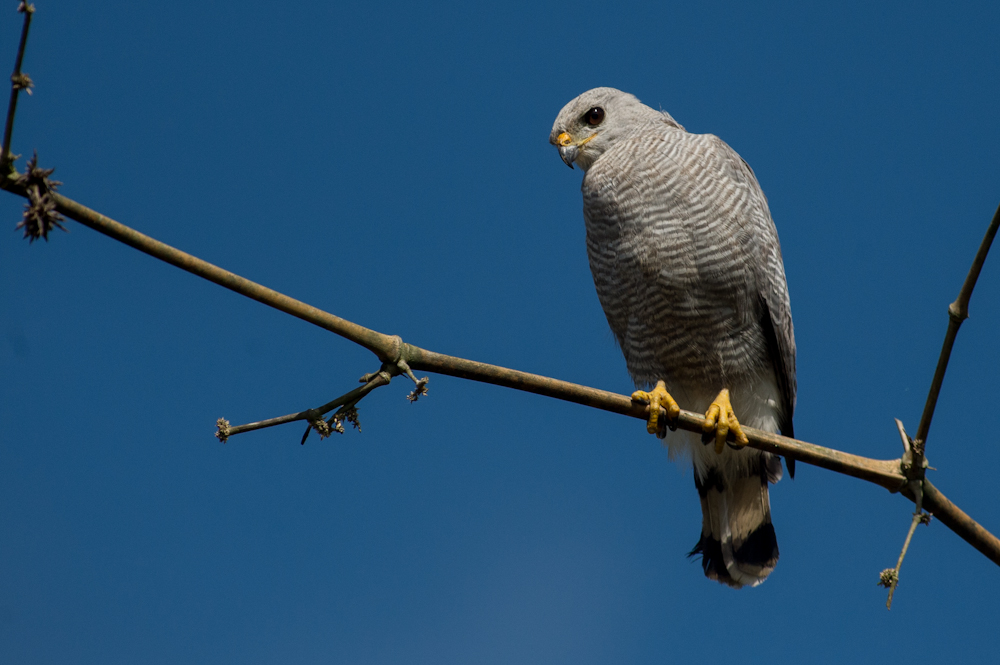
Wikipedia: Grey-lined hawk Source: OTHER
Grey-lined_hawk_%28Buteo_nitidus%29.jpg
![]() The gray-lined hawk (Buteo nitidus) is a smallish raptor found in open country and forest edges. It is sometimes placed in the genus Asturina as Asturina nitida. The species has been split by the American Ornithological Society from the gray hawk. The gray-lined hawk is found from El Salvador to Argentina.
[more]
The gray-lined hawk (Buteo nitidus) is a smallish raptor found in open country and forest edges. It is sometimes placed in the genus Asturina as Asturina nitida. The species has been split by the American Ornithological Society from the gray hawk. The gray-lined hawk is found from El Salvador to Argentina.
[more]
Profile Wikipedia eBird Xeno-Canto
Wikipedia: White-throated hawk Source: OTHER
Buteo_albigula.PNG
![]() The white-throated hawk (Buteo albigula) is a bird of prey in the family Accipitridae, which includes the eagles, hawks and Old World vultures. In British usage, it would be called a buzzard rather than a true hawk.
[more]
The white-throated hawk (Buteo albigula) is a bird of prey in the family Accipitridae, which includes the eagles, hawks and Old World vultures. In British usage, it would be called a buzzard rather than a true hawk.
[more]
Profile Wikipedia eBird A-Z Animals Audubon AllAboutBirds Xeno-Canto

Wikipedia: Sharp-shinned hawk Source: OTHER
1200px-Accipiter_striatus%2C_Canet_Road%2C_San_Luis_Obispo_1.jpg
![]() A. s. chionogaster
A. s. chionogaster
A. s. erythronemius
A. s. fringilloides
A. s. madrensis
A. s. perobscurus
A. s. striatus
A. s. suttoni
A. s. velox
A. s. venator
A. s. ventralis
[more]

Wikipedia: Tiny hawk Source: OTHER
Accipiter_superciliosus.jpg
![]() The tiny hawk (Accipiter superciliosus) is a small diurnal bird of prey found in or near forests, primarily humid, throughout much of the Neotropics. It is primarily a bird-eater, and is known to prey on hummingbirds.
[more]
The tiny hawk (Accipiter superciliosus) is a small diurnal bird of prey found in or near forests, primarily humid, throughout much of the Neotropics. It is primarily a bird-eater, and is known to prey on hummingbirds.
[more]

Wikipedia: Bicolored hawk Source: OTHER
1200px-Bicoloured_Hawk_%28Accipiter_bicolor%29_with_prey.jpg
![]() The bicolored hawk (Accipiter bicolor) is a species of bird of prey in the family Accipitridae. It is found in forest, woodland, second growth, plantations, and wooded savanna in southeastern Mexico, Central America, and northern and central South America (as far south as northern Argentina).[3] Though generally uncommon, it is the most common species of Accipiter in most of its range, but it does not occur at altitudes above 2,700 metres (8,900 ft) such as the highest parts of the Andes.[4]
[more]
The bicolored hawk (Accipiter bicolor) is a species of bird of prey in the family Accipitridae. It is found in forest, woodland, second growth, plantations, and wooded savanna in southeastern Mexico, Central America, and northern and central South America (as far south as northern Argentina).[3] Though generally uncommon, it is the most common species of Accipiter in most of its range, but it does not occur at altitudes above 2,700 metres (8,900 ft) such as the highest parts of the Andes.[4]
[more]

Wikipedia: Gray-bellied hawk Source: OTHER
1200px-UrospiziasJardineiKeulemans.jpg
![]() The grey-bellied hawk or grey-bellied goshawk (Accipiter poliogaster) is a fairly large and rare species of forest-dwelling South American bird of prey in the family Accipitridae.
[more]
The grey-bellied hawk or grey-bellied goshawk (Accipiter poliogaster) is a fairly large and rare species of forest-dwelling South American bird of prey in the family Accipitridae.
[more]
Profile Wikipedia eBird Xeno-Canto

Wikipedia: Semicollared hawk Source: OTHER
1200px-Accipiter_collaris_1860.jpg
![]() The semicollared hawk (Accipiter collaris) is a rare bird of prey species in the family Accipitridae. It is found in Colombia, Ecuador, Peru, and Venezuela. Its natural habitat is subtropical or tropical moist montane forests. It is potentially being affected by habitat loss.
[more]
The semicollared hawk (Accipiter collaris) is a rare bird of prey species in the family Accipitridae. It is found in Colombia, Ecuador, Peru, and Venezuela. Its natural habitat is subtropical or tropical moist montane forests. It is potentially being affected by habitat loss.
[more]
Profile Wikipedia eBird Xeno-Canto

Wikipedia: Cinereous harrier Source: OTHER
Circus_cinereus_-Rio_Grande_do_Sul%2C_Brazil_-flying-8.jpg
![]() The cinereous harrier (Circus cinereus) is a South American bird of prey of the harrier family. Its breeding range extends from the Tierra del Fuego through Argentina and Chile to Bolivia, Paraguay, Peru and southern Brasil; and across the Andes north to Colombia. The bird's population is declining but due to its large range is not considered vulnerable.[2] The term cinereous, deriving from the Latin word for ashy, describes its colouration.[3]
[more]
The cinereous harrier (Circus cinereus) is a South American bird of prey of the harrier family. Its breeding range extends from the Tierra del Fuego through Argentina and Chile to Bolivia, Paraguay, Peru and southern Brasil; and across the Andes north to Colombia. The bird's population is declining but due to its large range is not considered vulnerable.[2] The term cinereous, deriving from the Latin word for ashy, describes its colouration.[3]
[more]
Profile Wikipedia eBird Xeno-Canto

Wikipedia: Pearl kite Source: OTHER
1200px-Gampsonyx_swainsonii_Pearl_Kite.jpg
![]() The pearl kite (Gampsonyx swainsonii) is a very small raptor found in open savanna habitat adjacent to deciduous woodland. It is the only member of the genus Gampsonyx. The scientific name commemorates the English naturalist William Swainson.
[more]
The pearl kite (Gampsonyx swainsonii) is a very small raptor found in open savanna habitat adjacent to deciduous woodland. It is the only member of the genus Gampsonyx. The scientific name commemorates the English naturalist William Swainson.
[more]
Profile Wikipedia eBird Audubon AllAboutBirds Xeno-Canto

Wikipedia: Snail kite Source: OTHER
1200px-Schneckenweih-Snail-Kite.JPG
![]() The snail kite (Rostrhamus sociabilis) is a bird of prey within the family Accipitridae, which also includes the eagles, hawks, and Old World vultures. Its relative, the slender-billed kite, is now again placed in Helicolestes, making the genus Rostrhamus monotypic. Usually, it is placed in the milvine kites, but the validity of that group is under investigation.
[more]
The snail kite (Rostrhamus sociabilis) is a bird of prey within the family Accipitridae, which also includes the eagles, hawks, and Old World vultures. Its relative, the slender-billed kite, is now again placed in Helicolestes, making the genus Rostrhamus monotypic. Usually, it is placed in the milvine kites, but the validity of that group is under investigation.
[more]
Profile Wikipedia eBird Audubon AllAboutBirds Xeno-Canto

Wikipedia: Swallow-tailed kite Source: OTHER
1200px-Swallow-tailed_Kite_%2834163638494%29.jpg
![]() The swallow-tailed kite (Elanoides forficatus) is a pernine raptor which breeds from the southeastern United States to eastern Peru and northern Argentina. It is the only species in the genus Elanoides. Most North and Central American breeders winter in South America where the species is resident year round.
[more]
The swallow-tailed kite (Elanoides forficatus) is a pernine raptor which breeds from the southeastern United States to eastern Peru and northern Argentina. It is the only species in the genus Elanoides. Most North and Central American breeders winter in South America where the species is resident year round.
[more]
Profile Wikipedia eBird Xeno-Canto

Wikipedia: Harpy eagle Source: OTHER
Harpia_harpyja_001_800.jpg
![]() The harpy eagle (Harpia harpyja) is a neotropical species of eagle. It is also called the American harpy eagle to distinguish it from the Papuan eagle, which is sometimes known as the New Guinea harpy eagle or Papuan harpy eagle.[3] It is the largest and most powerful raptor found throughout its range,[4] and among the largest extant species of eagles in the world. It usually inhabits tropical lowland rainforests in the upper (emergent) canopy layer. Destruction of its natural habitat has caused it to vanish from many parts of its former range, and it is nearly extirpated from much of Central America. In Brazil, the harpy eagle is also known as royal-hawk (in Portuguese: gavião-real).[5] The genus Harpia, together with Harpyopsis and Morphnus form the subfamily Harpiinae.
[more]
The harpy eagle (Harpia harpyja) is a neotropical species of eagle. It is also called the American harpy eagle to distinguish it from the Papuan eagle, which is sometimes known as the New Guinea harpy eagle or Papuan harpy eagle.[3] It is the largest and most powerful raptor found throughout its range,[4] and among the largest extant species of eagles in the world. It usually inhabits tropical lowland rainforests in the upper (emergent) canopy layer. Destruction of its natural habitat has caused it to vanish from many parts of its former range, and it is nearly extirpated from much of Central America. In Brazil, the harpy eagle is also known as royal-hawk (in Portuguese: gavião-real).[5] The genus Harpia, together with Harpyopsis and Morphnus form the subfamily Harpiinae.
[more]
Profile Wikipedia eBird Xeno-Canto
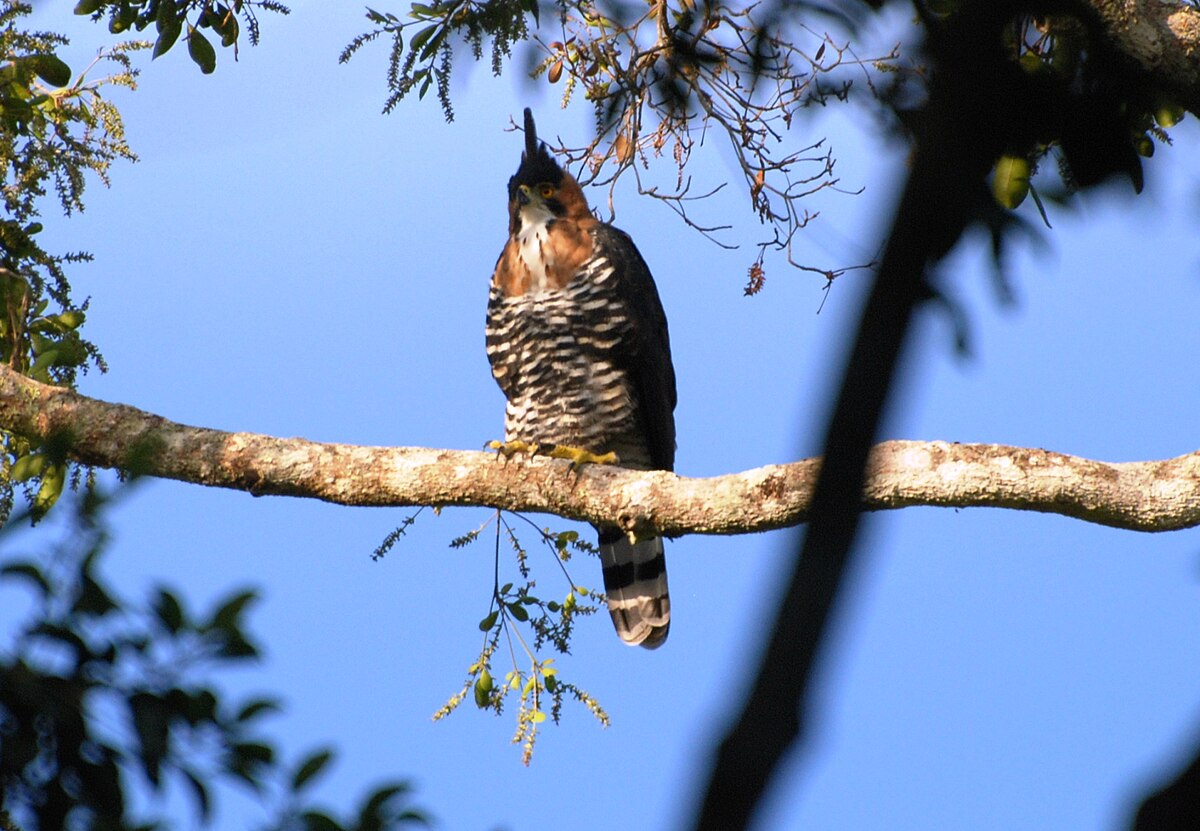
Wikipedia: Ornate hawk-eagle Source: OTHER
1200px-Calakmul_Adler.JPG
![]() The ornate hawk-eagle (Spizaetus ornatus) is a fairly large bird of prey from the tropical Americas. Formerly, some authorities referred to this species as the crested hawk-eagle, a name that may cause some confusion as it is more commonly used for an Asian eagle species.[3] Like all eagles, it is in the family Accipitridae. This species has a feathered tarsus that marks it as a member of the Aquilinae or booted eagle subfamily.[4] This species is notable for the vivid colors and bold markings of adults, which differ considerably from the far more whitish plumage of the juvenile bird.[5] The ornate hawk-eagle ranges from central Mexico south through much of Central America and in a somewhat spotty but broad overall range into South America, including in the west apart from the Andes and broadly on the Atlantic side especially Brazil down to as far as Southeast Brazil and northern Argentina.[1][6] This species is found largely in primary forests with tall trees, although can be found in many forest types.[6] The ornate hawk-eagle female lays almost always a single egg and the species has a fairly prolonged breeding cycle like many tropical raptors, especially due to a lengthy post-fledging stage on which juveniles are dependent on their parents.[7] It is a diversified and exceptionally powerful predator which takes a range of prey, usually various medium-to-large-sized birds and small-to-medium-sized mammals as well as occasional reptiles.[8] Like many forest-dependent raptors, especially those in the tropical and subtropical regions, this species is likely under the pressing threat of deforestation. The decline of forest habitat in this species range, especially the Amazon rainforest, led the IUCN to uplist the ornate hawk-eagle as Near Threatened in 2016.[1]
[more]
The ornate hawk-eagle (Spizaetus ornatus) is a fairly large bird of prey from the tropical Americas. Formerly, some authorities referred to this species as the crested hawk-eagle, a name that may cause some confusion as it is more commonly used for an Asian eagle species.[3] Like all eagles, it is in the family Accipitridae. This species has a feathered tarsus that marks it as a member of the Aquilinae or booted eagle subfamily.[4] This species is notable for the vivid colors and bold markings of adults, which differ considerably from the far more whitish plumage of the juvenile bird.[5] The ornate hawk-eagle ranges from central Mexico south through much of Central America and in a somewhat spotty but broad overall range into South America, including in the west apart from the Andes and broadly on the Atlantic side especially Brazil down to as far as Southeast Brazil and northern Argentina.[1][6] This species is found largely in primary forests with tall trees, although can be found in many forest types.[6] The ornate hawk-eagle female lays almost always a single egg and the species has a fairly prolonged breeding cycle like many tropical raptors, especially due to a lengthy post-fledging stage on which juveniles are dependent on their parents.[7] It is a diversified and exceptionally powerful predator which takes a range of prey, usually various medium-to-large-sized birds and small-to-medium-sized mammals as well as occasional reptiles.[8] Like many forest-dependent raptors, especially those in the tropical and subtropical regions, this species is likely under the pressing threat of deforestation. The decline of forest habitat in this species range, especially the Amazon rainforest, led the IUCN to uplist the ornate hawk-eagle as Near Threatened in 2016.[1]
[more]
Profile Wikipedia eBird Xeno-Canto

Wikipedia: Black hawk-eagle Source: OTHER
1200px-Gavi%C3%A3o-pega-macaco_%28Spizaetus_tyrannus%29.jpg
![]() The black hawk-eagle (Spizaetus tyrannus), also known as the tyrant hawk-eagle,[3] is a species of eagle found from central Mexico through Central America[4] into Colombia, eastern Peru, the south of Brazil, and as far as northern Argentina.[5] There are two known subspecies, S.t. tyrannus, which is found in Southeastern Brazil and Northeastern Argentina, and the slightly smaller S. t. serus, which can be found elsewhere throughout the species' range.[6] Its preferred habitats include humid and moist forests close to rivers, and several types of woodland.[7] It is uncommon to fairly common throughout most of its range. Its closest relative is the ornate hawk-eagle, which is similar in size, appearance and behavior but lives at lower elevations.
[more]
The black hawk-eagle (Spizaetus tyrannus), also known as the tyrant hawk-eagle,[3] is a species of eagle found from central Mexico through Central America[4] into Colombia, eastern Peru, the south of Brazil, and as far as northern Argentina.[5] There are two known subspecies, S.t. tyrannus, which is found in Southeastern Brazil and Northeastern Argentina, and the slightly smaller S. t. serus, which can be found elsewhere throughout the species' range.[6] Its preferred habitats include humid and moist forests close to rivers, and several types of woodland.[7] It is uncommon to fairly common throughout most of its range. Its closest relative is the ornate hawk-eagle, which is similar in size, appearance and behavior but lives at lower elevations.
[more]
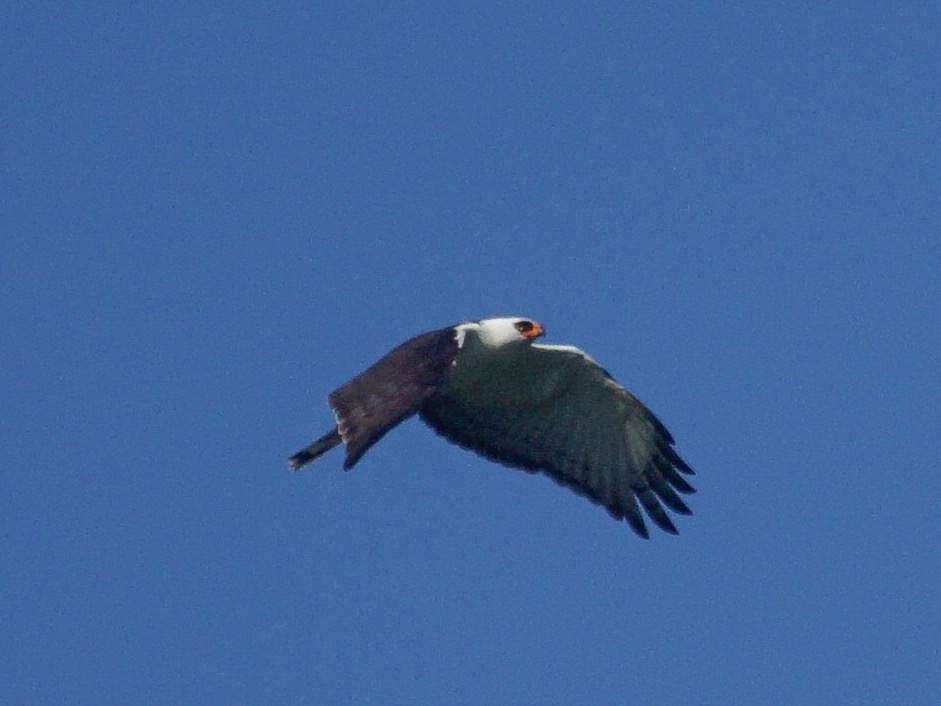
Wikipedia: Black-and-white hawk-eagle Source: OTHER
Black-and-white_Hawk-Eagle.jpg
![]() The black-and-white hawk-eagle (Spizaetus melanoleucus, formerly Spizastur melanoleucus) is a bird of prey species in the eagle and hawk family (Accipitridae). It is found throughout a large part of tropical America, from southern Mexico to northern Argentina.[2]
[more]
The black-and-white hawk-eagle (Spizaetus melanoleucus, formerly Spizastur melanoleucus) is a bird of prey species in the eagle and hawk family (Accipitridae). It is found throughout a large part of tropical America, from southern Mexico to northern Argentina.[2]
[more]
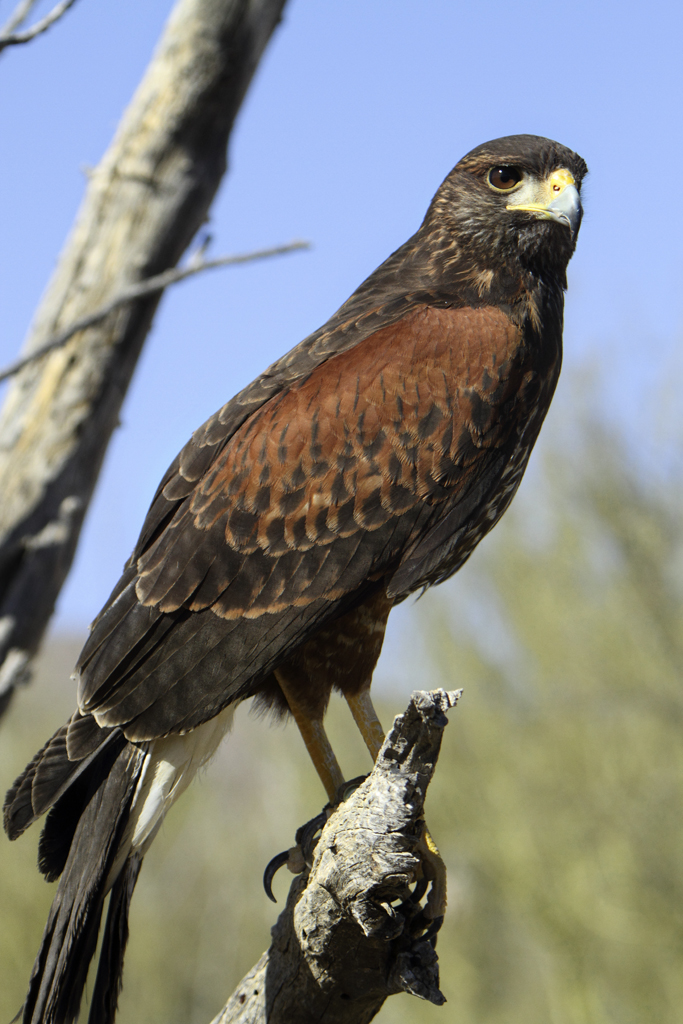
Wikipedia: Harris's hawk Source: OTHER
Harris%27s_Hawk_%28Parabuteo_unicinctus%29_3_of_4_in_set.jpg
![]() Harris's hawk (Parabuteo unicinctus), formerly known as the bay-winged hawk or dusky hawk, and known in Latin America as peuco, is a medium-large bird of prey that breeds from the southwestern United States south to Chile, central Argentina, and Brazil. Birds are sometimes reported at large in Western Europe, especially Britain, but it is a popular species in falconry and these records almost certainly all refer to escapes from captivity.
[more]
Harris's hawk (Parabuteo unicinctus), formerly known as the bay-winged hawk or dusky hawk, and known in Latin America as peuco, is a medium-large bird of prey that breeds from the southwestern United States south to Chile, central Argentina, and Brazil. Birds are sometimes reported at large in Western Europe, especially Britain, but it is a popular species in falconry and these records almost certainly all refer to escapes from captivity.
[more]
MerlinBirdID suggests common black hawk, flamingo tour near Rio Lagartos. 2023-04-15 08.40.26 Yucatan
First observed in Yucatan on 2023-04-15.
![]() The common black hawk (Buteogallus anthracinus) is a bird of prey in the family Accipitridae, which also includes the eagles, hawks, and Old World vultures. It formerly included the Cuban black-hawk (Buteogallus gundlachii) as a subspecies. The mangrove black hawk, traditionally considered a distinct species, is now generally considered a subspecies, B. a. subtilis, of the common black-hawk.[3]
[more]
The common black hawk (Buteogallus anthracinus) is a bird of prey in the family Accipitridae, which also includes the eagles, hawks, and Old World vultures. It formerly included the Cuban black-hawk (Buteogallus gundlachii) as a subspecies. The mangrove black hawk, traditionally considered a distinct species, is now generally considered a subspecies, B. a. subtilis, of the common black-hawk.[3]
[more]

Wikipedia: Savanna hawk Source: OTHER
1200px-Savanna_hawk_%28Buteogallus_meridionalis%29.JPG
![]() The savanna hawk (Buteogallus meridionalis) is a large raptor found in open savanna and swamp edges. It was formerly placed in the genus Heterospizias. It breeds from Panama and Trinidad south to Bolivia, Uruguay and central Argentina.[2]
[more]
The savanna hawk (Buteogallus meridionalis) is a large raptor found in open savanna and swamp edges. It was formerly placed in the genus Heterospizias. It breeds from Panama and Trinidad south to Bolivia, Uruguay and central Argentina.[2]
[more]
Profile Wikipedia eBird Xeno-Canto
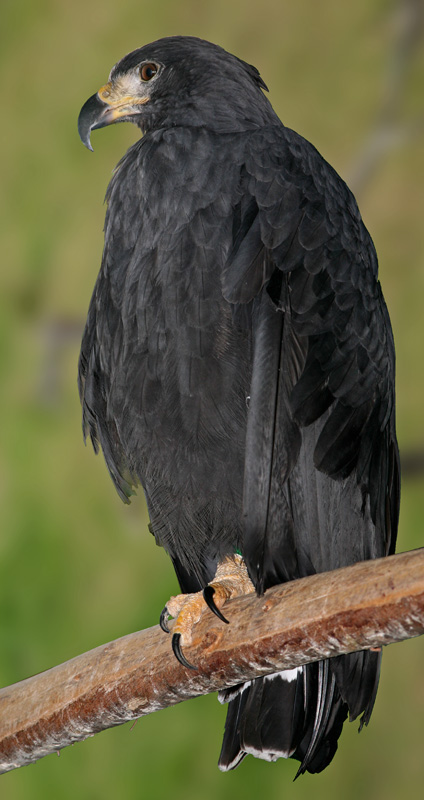
Wikipedia: Solitary eagle Source: OTHER
Solitary_Eagle.jpg
![]() The solitary eagle or montane solitary eagle (Buteogallus solitarius) is a large Neotropical eagle. It is also known as the black solitary eagle.
[more]
The solitary eagle or montane solitary eagle (Buteogallus solitarius) is a large Neotropical eagle. It is also known as the black solitary eagle.
[more]

Wikipedia: Great black-hawk Source: OTHER
1200px-Buteogallus_urubitinga_NBII.jpg
![]() The great black hawk (Buteogallus urubitinga) is a bird of prey in the family Accipitridae, which also includes the eagles, hawks, and Old World vultures.
[more]
The great black hawk (Buteogallus urubitinga) is a bird of prey in the family Accipitridae, which also includes the eagles, hawks, and Old World vultures.
[more]
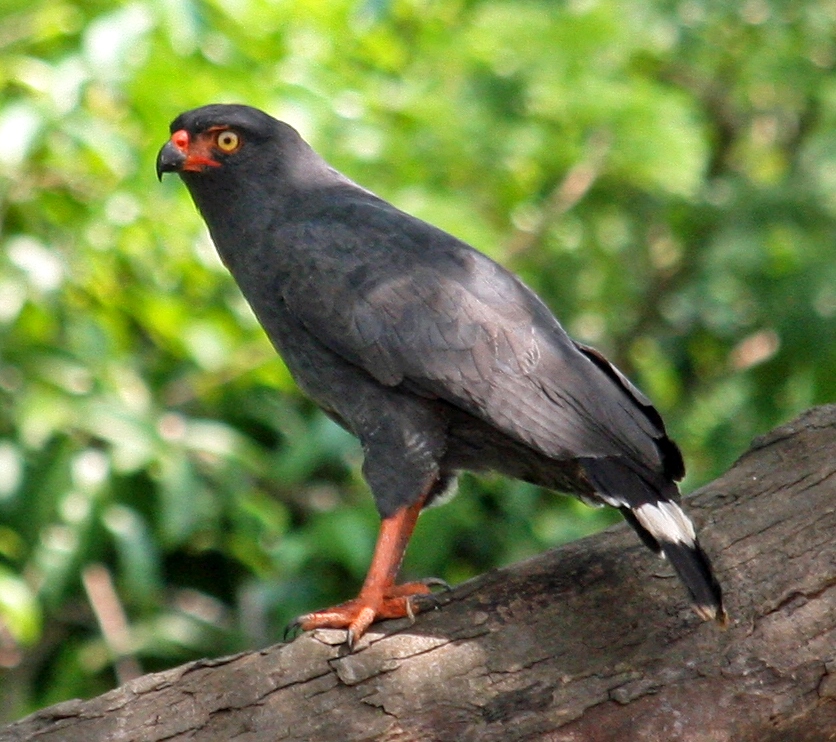
Wikipedia: Slate-colored hawk Source: OTHER
Buteogallus_schistaceus_JJK%271.jpg
![]() The slate-colored hawk (Buteogallus schistaceus) is a species of bird of prey in the family Accipitridae: the hawks, eagles, and allies.
[more]
The slate-colored hawk (Buteogallus schistaceus) is a species of bird of prey in the family Accipitridae: the hawks, eagles, and allies.
[more]
Profile Wikipedia eBird Xeno-Canto
Wikipedia: Black-chested buzzard-eagle Source: OTHER
Geranoaetus_melanoleucus.JPG
![]() The black-chested buzzard-eagle (Geranoaetus melanoleucus) is a bird of prey of the hawk and eagle family (Accipitridae). It lives in open regions of South America. This species is also known as the black buzzard-eagle, grey buzzard-eagle or analogously with "eagle" or "eagle-buzzard" replacing "buzzard-eagle", or as the Chilean blue eagle. It is sometimes placed in the genus Buteo.[2][3]
[more]
The black-chested buzzard-eagle (Geranoaetus melanoleucus) is a bird of prey of the hawk and eagle family (Accipitridae). It lives in open regions of South America. This species is also known as the black buzzard-eagle, grey buzzard-eagle or analogously with "eagle" or "eagle-buzzard" replacing "buzzard-eagle", or as the Chilean blue eagle. It is sometimes placed in the genus Buteo.[2][3]
[more]
Profile Wikipedia eBird Xeno-Canto
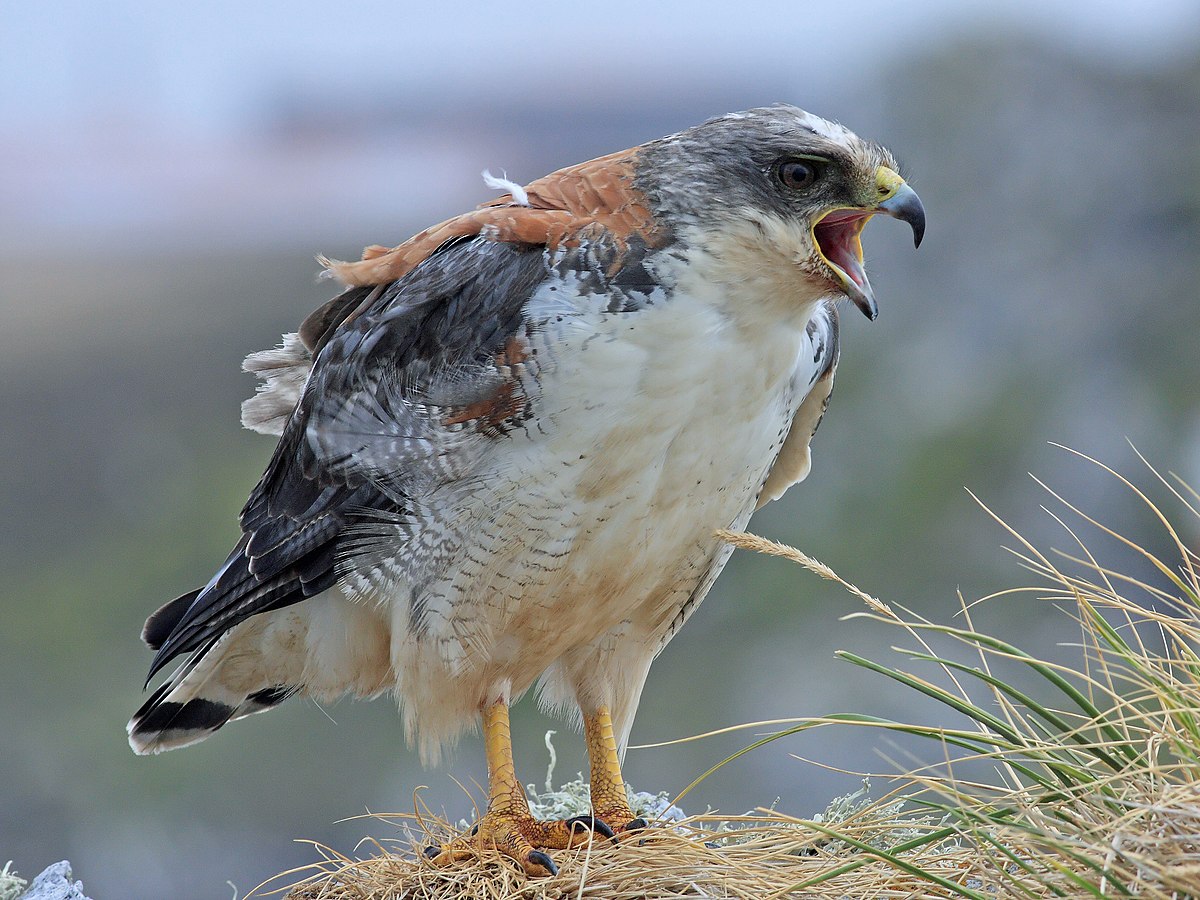
Wikipedia: Variable hawk Source: OTHER
1200px-Red-backed_Hawk_%28Buteo_polyosoma%29_1.jpg
![]() The variable hawk (Geranoaetus polyosoma) is a polymorphic species of bird of prey in the family Accipitridae.
[more]
The variable hawk (Geranoaetus polyosoma) is a polymorphic species of bird of prey in the family Accipitridae.
[more]

Wikipedia: Black-collared hawk Source: OTHER
1200px-Black-collared_hawk_%28Busarellus_nigricollis%29_adult.jpg
![]() The black-collared hawk (Busarellus nigricollis) is a species of bird of prey in the family Accipitridae. It is monotypic within the genus Busarellus.[3] It has a widespread range of presence, from western Mexico to Uruguay. Its natural habitats are subtropical or tropical moist lowland forests, subtropical or tropical swamps, and swamps.[1]
[more]
The black-collared hawk (Busarellus nigricollis) is a species of bird of prey in the family Accipitridae. It is monotypic within the genus Busarellus.[3] It has a widespread range of presence, from western Mexico to Uruguay. Its natural habitats are subtropical or tropical moist lowland forests, subtropical or tropical swamps, and swamps.[1]
[more]
Profile Wikipedia eBird Xeno-Canto
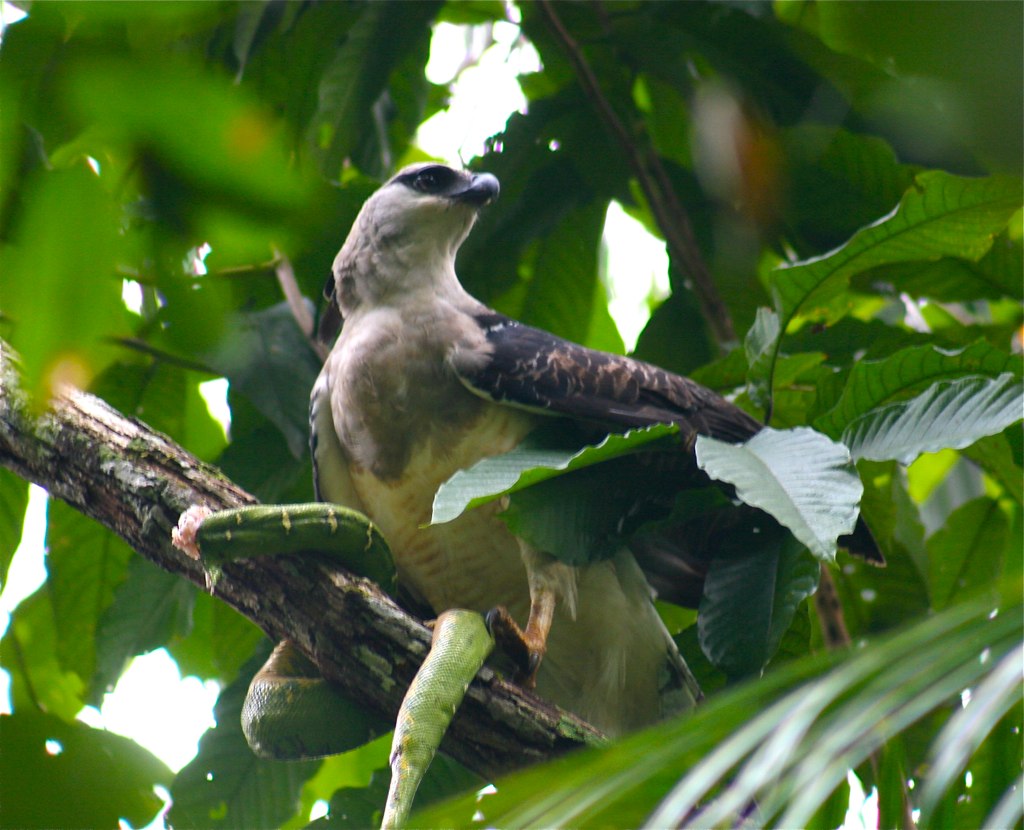
Wikipedia: Crested eagle Source: OTHER
Morphnus_guianensis_eating_green_snake_-Bolivia-8.jpg
![]() The crested eagle (Morphnus guianensis) is a large Neotropical eagle.
[more]
The crested eagle (Morphnus guianensis) is a large Neotropical eagle.
[more]
Profile Wikipedia eBird Audubon AllAboutBirds Xeno-Canto

Wikipedia: White-tailed kite Source: OTHER
1200px-Elanus_leucurus_3.jpg
![]() The white-tailed kite (Elanus leucurus) is a small raptor found in western North America and parts of South America.
[more]
The white-tailed kite (Elanus leucurus) is a small raptor found in western North America and parts of South America.
[more]
Profile Wikipedia eBird Audubon AllAboutBirds Xeno-Canto

Wikipedia: Hook-billed kite Source: OTHER
1200px-Chondrohierax_uncinatus_76608753.jpg
![]() The hook-billed kite (Chondrohierax uncinatus), is a bird of prey in the family Accipitridae, which also includes many other diurnal raptors such as kites, eagles, and harriers. It occurs in the Americas, including the Rio Grande Valley of Texas in the United States, Mexico, the Caribbean, Central America, and tropical South America.
[more]
The hook-billed kite (Chondrohierax uncinatus), is a bird of prey in the family Accipitridae, which also includes many other diurnal raptors such as kites, eagles, and harriers. It occurs in the Americas, including the Rio Grande Valley of Texas in the United States, Mexico, the Caribbean, Central America, and tropical South America.
[more]
Profile Wikipedia eBird Xeno-Canto
Wikipedia: Gray-headed kite Source: OTHER
Leptodon_cayannensis_-_Gray-headed_kite.JPG
![]() The gray-headed kite (Leptodon cayanensis) is a raptor found in open woodland and swamp forests. It shares the genus Leptodon with the extremely rare white-collared kite. It breeds from eastern Mexico and Trinidad south to Peru, Bolivia, Brazil and northern Argentina.
[more]
The gray-headed kite (Leptodon cayanensis) is a raptor found in open woodland and swamp forests. It shares the genus Leptodon with the extremely rare white-collared kite. It breeds from eastern Mexico and Trinidad south to Peru, Bolivia, Brazil and northern Argentina.
[more]
Profile Wikipedia eBird Xeno-Canto

Wikipedia: Semiplumbeous hawk Source: OTHER
1200px-Semiplumbeous_hawk_%28Leucopternis_semiplumbeus%29.jpg
![]() The semiplumbeous hawk (Leucopternis semiplumbeus) is a species of bird of prey in the family Accipitridae. It is found in Colombia, Costa Rica, Ecuador, Honduras, and Panama. Its natural habitat is subtropical or tropical moist lowland forests.
[more]
The semiplumbeous hawk (Leucopternis semiplumbeus) is a species of bird of prey in the family Accipitridae. It is found in Colombia, Costa Rica, Ecuador, Honduras, and Panama. Its natural habitat is subtropical or tropical moist lowland forests.
[more]
Profile Wikipedia eBird Xeno-Canto

Wikipedia: Black-faced hawk Source: OTHER
1200px-Leucopternis_melanops_-_Black-faced_hawk.jpg
![]() The black-faced hawk (Leucopternis melanops) is a species of bird of prey in the family Accipitridae. This low-density species has traditionally been believed to be restricted to Amazon Basin north of the Amazon River, but there are several records south of this river, in, for example, the Brazilian states of Pará and Acre, and southeastern Peru. It is closely related to the white-browed hawk and individuals showing a level of intermediacy between the two species are known, suggesting that they rarely hybridize
[more]
The black-faced hawk (Leucopternis melanops) is a species of bird of prey in the family Accipitridae. This low-density species has traditionally been believed to be restricted to Amazon Basin north of the Amazon River, but there are several records south of this river, in, for example, the Brazilian states of Pará and Acre, and southeastern Peru. It is closely related to the white-browed hawk and individuals showing a level of intermediacy between the two species are known, suggesting that they rarely hybridize
[more]
Profile Wikipedia eBird Xeno-Canto

Wikipedia: Plumbeous kite Source: OTHER
1200px-Ictinia_plumbea_-Mato_Grosso_do_Sul%2C_Brazil-8.jpg
![]() The plumbeous kite (Ictinia plumbea) is a bird of prey in the family Accipitridae.
[more]
The plumbeous kite (Ictinia plumbea) is a bird of prey in the family Accipitridae.
[more]
Profile Wikipedia eBird Xeno-Canto

Wikipedia: Crane hawk Source: OTHER
Crane_hawk_%28Geranospiza_caerulescens%29.jpg
![]() The crane hawk (Geranospiza caerulescens) is a species of bird of prey in the family Accipitridae. It is monotypic within the genus Geranospiza.[2]
[more]
The crane hawk (Geranospiza caerulescens) is a species of bird of prey in the family Accipitridae. It is monotypic within the genus Geranospiza.[2]
[more]
Profile Wikipedia eBird Xeno-Canto
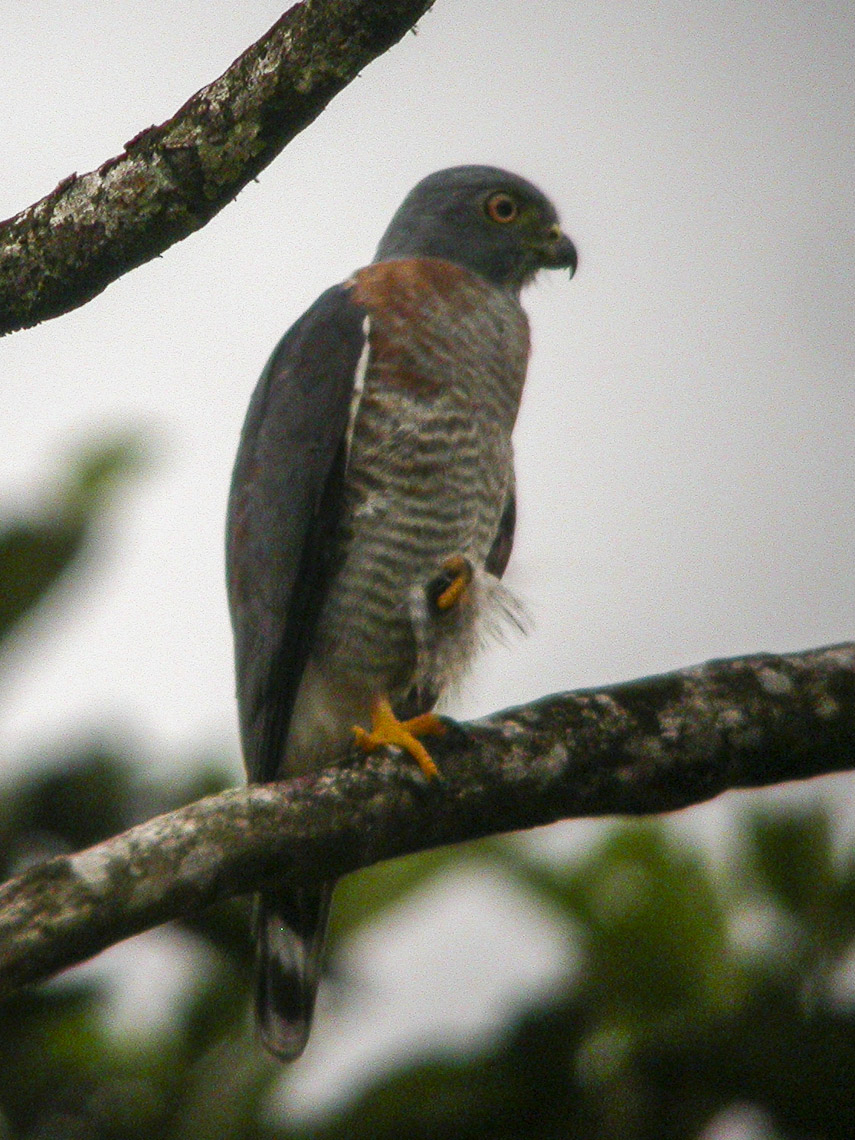
Wikipedia: Double-toothed kite Source: OTHER
Double-tooth_Kite_-_Choco_-_Ecuador.jpg
![]() The double-toothed kite (Harpagus bidentatus) is a species of bird of prey in the family Accipitridae. It is found in Belize, Bolivia, Brazil, Colombia, Costa Rica, Ecuador, El Salvador, French Guiana, Guatemala, Guyana, Honduras, Mexico, Nicaragua, Panama, Peru, Suriname, Trinidad and Tobago, and Venezuela.[1]
[more]
The double-toothed kite (Harpagus bidentatus) is a species of bird of prey in the family Accipitridae. It is found in Belize, Bolivia, Brazil, Colombia, Costa Rica, Ecuador, El Salvador, French Guiana, Guatemala, Guyana, Honduras, Mexico, Nicaragua, Panama, Peru, Suriname, Trinidad and Tobago, and Venezuela.[1]
[more]
Andean condor / Andenkondor (Vultur gryphus)
Andean Condor in Chile. 2019-02-20 10.16.54 Patagonia
First observed in Patagonia on 2019-02-20.
![]() The Andean condor (Vultur gryphus) is a South American bird in the New World vulture family Cathartidae and is the only member of the genus Vultur. Found in the Andes mountains and adjacent Pacific coasts of western South America, the Andean condor is the largest flying bird in the world by combined measurement of weight and wingspan. It has a maximum wingspan of 3.3 m (10 ft 10 in) and weight of 15 kg (33 lb). It is generally considered as the largest bird of prey in the world.[2][3]
[more]
The Andean condor (Vultur gryphus) is a South American bird in the New World vulture family Cathartidae and is the only member of the genus Vultur. Found in the Andes mountains and adjacent Pacific coasts of western South America, the Andean condor is the largest flying bird in the world by combined measurement of weight and wingspan. It has a maximum wingspan of 3.3 m (10 ft 10 in) and weight of 15 kg (33 lb). It is generally considered as the largest bird of prey in the world.[2][3]
[more]
Turkey vulture / Truthahngeier (Cathartes aura)
Turkey vulture. 2022-04-29 11.39.28 Maryland
First observed in Costa Rica on 2018-02-28.
![]() The turkey vulture (Cathartes aura), also known in some North American regions as the turkey buzzard (or just buzzard), and in some areas of the Caribbean as the John crow or carrion crow,[2] is the most widespread of the New World vultures.[3] One of three species in the genus Cathartes of the family Cathartidae, the turkey vulture ranges from southern Canada to the southernmost tip of South America. It inhabits a variety of open and semi-open areas, including subtropical forests, shrublands, pastures, and deserts.[1]
[more]
The turkey vulture (Cathartes aura), also known in some North American regions as the turkey buzzard (or just buzzard), and in some areas of the Caribbean as the John crow or carrion crow,[2] is the most widespread of the New World vultures.[3] One of three species in the genus Cathartes of the family Cathartidae, the turkey vulture ranges from southern Canada to the southernmost tip of South America. It inhabits a variety of open and semi-open areas, including subtropical forests, shrublands, pastures, and deserts.[1]
[more]
Greater yellow-headed vulture / Großer Gelbkopfgeier (Cathartes melambrotus)
Profile Wikipedia eBird Xeno-Canto

Wikipedia: Greater yellow-headed vulture Source: OTHER
Greater_Yellow-headed_Vulture_%28Cathartes_melambrotus%29_in_flight_from_below.jpg
![]() The greater yellow-headed vulture (Cathartes melambrotus), also known as the forest vulture,[2] is a species of bird in the New World vulture family Cathartidae. It was considered to be the same species as the lesser yellow-headed vulture until they were split in 1964.[3] It is found in South America in tropical moist lowland forests. It is a fairly large bird, with a wingspan of 166–178 cm (65–70 in), a weight of 1.65 kilograms (3.6 lb) and a body length of 64–75 cm (25–30 in). The body plumage is black, and the head and neck, which are featherless, range in color from deep yellow to pale orange. It lacks a syrinx, and its vocalizations are therefore limited to grunts or low hisses.
[more]
The greater yellow-headed vulture (Cathartes melambrotus), also known as the forest vulture,[2] is a species of bird in the New World vulture family Cathartidae. It was considered to be the same species as the lesser yellow-headed vulture until they were split in 1964.[3] It is found in South America in tropical moist lowland forests. It is a fairly large bird, with a wingspan of 166–178 cm (65–70 in), a weight of 1.65 kilograms (3.6 lb) and a body length of 64–75 cm (25–30 in). The body plumage is black, and the head and neck, which are featherless, range in color from deep yellow to pale orange. It lacks a syrinx, and its vocalizations are therefore limited to grunts or low hisses.
[more]
Black vulture / Rabengeier (Coragyps atratus)
Black vulture at cenote xxx. 2023-04-14 13.13.52 Yucatan
First observed in Yucatan on 2023-04-14.
![]() The black vulture (Coragyps atratus), also known as the American black vulture, is a bird in the New World vulture family whose range extends from the northeastern United States to Peru, Central Chile and Uruguay in South America. Although a common and widespread species, it has a somewhat more restricted distribution than its compatriot, the turkey vulture, which breeds well into Canada and south to Tierra del Fuego. It is the only extant member of the genus Coragyps, which is in the family Cathartidae. Despite the similar name and appearance, this species is unrelated to the Eurasian black vulture, an Old World vulture in the family Accipitridae (which includes eagles, hawks, kites, and harriers). It inhabits relatively open areas which provide scattered forests or shrublands. With a wingspan of 1.5 m (4.9 ft), the black vulture is a large bird though relatively small for a vulture. It has black plumage, a featherless, grayish-black head and neck, and a short, hooked beak.
[more]
The black vulture (Coragyps atratus), also known as the American black vulture, is a bird in the New World vulture family whose range extends from the northeastern United States to Peru, Central Chile and Uruguay in South America. Although a common and widespread species, it has a somewhat more restricted distribution than its compatriot, the turkey vulture, which breeds well into Canada and south to Tierra del Fuego. It is the only extant member of the genus Coragyps, which is in the family Cathartidae. Despite the similar name and appearance, this species is unrelated to the Eurasian black vulture, an Old World vulture in the family Accipitridae (which includes eagles, hawks, kites, and harriers). It inhabits relatively open areas which provide scattered forests or shrublands. With a wingspan of 1.5 m (4.9 ft), the black vulture is a large bird though relatively small for a vulture. It has black plumage, a featherless, grayish-black head and neck, and a short, hooked beak.
[more]
King vulture / Königsgeier (Sarcoramphus papa)

Wikipedia: King vulture Source: OTHER
1200px-Sarcoramphus_papa_-National_Zoo_-Washington_-USA-8a.jpg
![]() The king vulture (Sarcoramphus papa) is a large bird found in Central and South America. It is a member of the New World vulture family Cathartidae. This vulture lives predominantly in tropical lowland forests stretching from southern Mexico to northern Argentina. It is the only surviving member of the genus Sarcoramphus, although fossil members are known.
[more]
The king vulture (Sarcoramphus papa) is a large bird found in Central and South America. It is a member of the New World vulture family Cathartidae. This vulture lives predominantly in tropical lowland forests stretching from southern Mexico to northern Argentina. It is the only surviving member of the genus Sarcoramphus, although fossil members are known.
[more]
Osprey / Fischadler (Pandion haliaetus)
Osprey in flight. 2023-09-27 12.22.08 Florida
First observed in Yucatan on 2023-04-21.
This bird appears across the great seas in the following continents:
Europe, North America, South America, Africa, Asia.
![]() Falco haliaetus Linnaeus, 1758
[more]
Falco haliaetus Linnaeus, 1758
[more]
Calls: ![]() Calls with sequences of short, soft and clear whistling notes. Often in series with rising pitch, then ending with a few lower pitched notes. [Link]
Calls with sequences of short, soft and clear whistling notes. Often in series with rising pitch, then ending with a few lower pitched notes. [Link]
Physical details: length=55-58 cm,
wingspan=145-170 cm,
weight=1120-2050 g
Habitats:
Agricultural
Call:
Automatically generated from Xeno-Canto recording
♫ 2023-10-12 15 55 surprising sound of an osprey. 2023-10-12 15.55.00 New England (song?)
Profile Wikipedia eBird Xeno-Canto

Wikipedia: Andean tinamou Source: OTHER
1200px-NothoproctaPentlandiSmit.jpg
General: ![]() The Andean tinamou (Nothoprocta pentlandii) is a tinamou, found commonly in high-altitude shrubland, in the Andes of South America.[3]
[more]
The Andean tinamou (Nothoprocta pentlandii) is a tinamou, found commonly in high-altitude shrubland, in the Andes of South America.[3]
[more]
Profile Wikipedia eBird Xeno-Canto
![]() The curve-billed tinamou (Nothoprocta curvirostris) is a type of tinamou commonly found in high-altitude grassland and shrubland habitats in the Andes of South America.[3]
[more]
The curve-billed tinamou (Nothoprocta curvirostris) is a type of tinamou commonly found in high-altitude grassland and shrubland habitats in the Andes of South America.[3]
[more]
Profile Wikipedia eBird Xeno-Canto
La tarde great tinamou tenative ID by MerlinBirdID. 2018-03-09 12.58.40 Costa Rica
First observed in Costa Rica on 2018-03-09.
![]() The great tinamou (Tinamus major) is a species of tinamou ground bird native to Central and South America. There are several subspecies, mostly differentiated by their coloration.
[more]
The great tinamou (Tinamus major) is a species of tinamou ground bird native to Central and South America. There are several subspecies, mostly differentiated by their coloration.
[more]
Profile Wikipedia eBird Xeno-Canto
![]() The black tinamou (Tinamus osgoodi) is a species of ground bird found in humid foothill and montane forest in the Andes of South America.
[more]
The black tinamou (Tinamus osgoodi) is a species of ground bird found in humid foothill and montane forest in the Andes of South America.
[more]
Profile Wikipedia eBird Xeno-Canto
Wikipedia: White-throated tinamou Source: OTHER
Tinamus_guttatus.JPG
![]() The white-throated tinamou (Tinamus guttatus) is a species of bird native to the Amazon rainforest of Brazil, northern Bolivia, southeastern Colombia, northeastern Ecuador, eastern Peru and southern Venezuela.[3]
[more]
The white-throated tinamou (Tinamus guttatus) is a species of bird native to the Amazon rainforest of Brazil, northern Bolivia, southeastern Colombia, northeastern Ecuador, eastern Peru and southern Venezuela.[3]
[more]
Profile Wikipedia eBird Xeno-Canto

Wikipedia: Little tinamou Source: OTHER
Crypturellus_soui.jpg
![]() The little tinamou (Crypturellus soui) is a species of tinamou. It is found in Central and South America.[4]
[more]
The little tinamou (Crypturellus soui) is a species of tinamou. It is found in Central and South America.[4]
[more]

Wikipedia: Variegated tinamou Source: OTHER
Crypturellus_variegatus.jpg
![]() The variegated tinamou (Crypturellus variegatus) a type of tinamou commonly found in moist forest lowlands in subtropical and tropical regions of northern South America.[3]
[more]
The variegated tinamou (Crypturellus variegatus) a type of tinamou commonly found in moist forest lowlands in subtropical and tropical regions of northern South America.[3]
[more]

Wikipedia: Brown tinamou Source: OTHER
Crypturellus_obsoletus.jpg
![]() The brown tinamou (Crypturellus obsoletus) is a brownish ground bird found in humid lowland and montane forest in tropical and subtropical South America.[3]
[more]
The brown tinamou (Crypturellus obsoletus) is a brownish ground bird found in humid lowland and montane forest in tropical and subtropical South America.[3]
[more]
Profile Wikipedia eBird Xeno-Canto

Wikipedia: Cinereous tinamou Source: OTHER
Crypturellus_cinereus.jpg
![]() The cinereous tinamou (Crypturellus cinereus), also known as brushland tinamou,[3] is a type of ground bird found in swamp and lowland forests in northern South America.[4] They have some localized names that have been used by the indigenous people such as in Amazonas where they are called inambu-pixuna, and in Pará, Brazil where they are called nambu-sujo. Also, throughout their range they are called inhambu-preto.[5] Cinereous tinamous have been around for many centuries. They are part of the oldest families of the world today and have fossils discovered dating back tens of millions of years. Their quick reflexes play a role in their ability to survive.
[more]
The cinereous tinamou (Crypturellus cinereus), also known as brushland tinamou,[3] is a type of ground bird found in swamp and lowland forests in northern South America.[4] They have some localized names that have been used by the indigenous people such as in Amazonas where they are called inambu-pixuna, and in Pará, Brazil where they are called nambu-sujo. Also, throughout their range they are called inhambu-preto.[5] Cinereous tinamous have been around for many centuries. They are part of the oldest families of the world today and have fossils discovered dating back tens of millions of years. Their quick reflexes play a role in their ability to survive.
[more]
Profile Wikipedia eBird Xeno-Canto

Wikipedia: Berlepsch's tinamou Source: OTHER
1200px-Crypturellus_berlepschi_1897.jpg
![]() Berlepsch's tinamou (Crypturellus berlepschi) is a type of ground bird found in moist forest[3] in northwestern Colombia and northwestern Ecuador.[4]
[more]
Berlepsch's tinamou (Crypturellus berlepschi) is a type of ground bird found in moist forest[3] in northwestern Colombia and northwestern Ecuador.[4]
[more]
Profile Wikipedia eBird Xeno-Canto

Wikipedia: Bartlett's tinamou Source: OTHER
1200px-CrypturusBartlettiKeulemans.jpg
![]() Bartlett's tinamou (Crypturellus bartletti) is a type of tinamou found in lowland forest in South America.[3]
[more]
Bartlett's tinamou (Crypturellus bartletti) is a type of tinamou found in lowland forest in South America.[3]
[more]
Profile Wikipedia eBird Xeno-Canto

Wikipedia: Pale-browed tinamou Source: OTHER
1200px-CrypturusTransfasciatusSmit.jpg
![]() The pale-browed tinamou (Crypturellus transfasciatus) is a type of tinamou found in tropical dry forests in Peru and Ecuador.[3]
[more]
The pale-browed tinamou (Crypturellus transfasciatus) is a type of tinamou found in tropical dry forests in Peru and Ecuador.[3]
[more]
Profile Wikipedia eBird Xeno-Canto
Wikipedia: Undulated tinamou Source: OTHER
Crypturellus_undulatus.JPG
![]() The undulated tinamou (Crypturellus undulatus) is a species of ground bird found in a wide range of wooded habitats in eastern and northern South America.[3][4]
[more]
The undulated tinamou (Crypturellus undulatus) is a species of ground bird found in a wide range of wooded habitats in eastern and northern South America.[3][4]
[more]
Profile Wikipedia eBird Xeno-Canto

Wikipedia: Tataupa tinamou Source: OTHER
1200px-Crypturellus_tataupa_-Piraju%2C_Sao_Paulo%2C_Brasil-8.jpg
![]() The Tataupa tinamou (Crypturellus tataupa) is a type of tinamou commonly found in dry forest in subtropical and tropical regions in southeastern South America.[3]
[more]
The Tataupa tinamou (Crypturellus tataupa) is a type of tinamou commonly found in dry forest in subtropical and tropical regions in southeastern South America.[3]
[more]
Profile Wikipedia eBird Xeno-Canto

Wikipedia: Highland tinamou Source: OTHER
1200px-Nothocercus_bonapartei_1902.jpg
![]() The highland tinamou or Bonaparte's tinamou (Nothocercus bonapartei) is a type of ground bird found in montane moist forest typically over 1,500 m (4,900 ft) altitude.
[more]
The highland tinamou or Bonaparte's tinamou (Nothocercus bonapartei) is a type of ground bird found in montane moist forest typically over 1,500 m (4,900 ft) altitude.
[more]
Profile Wikipedia eBird Xeno-Canto
![]() The tawny-breasted tinamou (Nothocercus julius) is a type of ground bird found in montane moist forest.[1] Their range is northwestern South America.[1][3]
[more]
The tawny-breasted tinamou (Nothocercus julius) is a type of ground bird found in montane moist forest.[1] Their range is northwestern South America.[1][3]
[more]
Profile Wikipedia eBird Audubon AllAboutBirds Xeno-Canto

Wikipedia: Wood stork Source: OTHER
1200px-Wood_stork_%28Mycteria_americana%29_and_Yacare_caiman.jpg
![]() The wood stork (Mycteria americana) is a large American wading bird in the family Ciconiidae (storks). It was formerly called the "wood ibis", though it is not an ibis. It is found in subtropical and tropical habitats in the Americas, including the Caribbean. In South America, it is resident, but in North America, it may disperse as far as Florida. Originally described by Carl Linnaeus in 1758, this stork likely evolved in tropical regions. The head and neck are bare of feathers, and dark grey in colour.[2] The plumage is mostly white, with the exception of the tail and some of the wing feathers, which are black with a greenish-purplish sheen. The juvenile differs from the adult, with the former having a feathered head and a yellow bill, compared to the black adult bill. There is little sexual dimorphism.
[more]
The wood stork (Mycteria americana) is a large American wading bird in the family Ciconiidae (storks). It was formerly called the "wood ibis", though it is not an ibis. It is found in subtropical and tropical habitats in the Americas, including the Caribbean. In South America, it is resident, but in North America, it may disperse as far as Florida. Originally described by Carl Linnaeus in 1758, this stork likely evolved in tropical regions. The head and neck are bare of feathers, and dark grey in colour.[2] The plumage is mostly white, with the exception of the tail and some of the wing feathers, which are black with a greenish-purplish sheen. The juvenile differs from the adult, with the former having a feathered head and a yellow bill, compared to the black adult bill. There is little sexual dimorphism.
[more]
Profile Wikipedia eBird Xeno-Canto

Wikipedia: Rufous-bellied seedsnipe Source: OTHER
1200px-Rufous-bellied_Seedsnipe%2C_Guango%2C_Ecuador_%285771242459%29.jpg
![]() The rufous-bellied seedsnipe (Attagis gayi) is a wader which is a resident breeding bird in the Andes of South America south from Ecuador.
[more]
The rufous-bellied seedsnipe (Attagis gayi) is a wader which is a resident breeding bird in the Andes of South America south from Ecuador.
[more]
Rock doves aka common pigeons on the move. 2023-06-19 07.39.10 Bolle di Magadino
First observed in 🇨🇭 on 2023-06-19.
This bird appears across the great seas in the following continents:
Europe, North America, South America, Africa, Asia.
![]() The rock dove, rock pigeon, or common pigeon (/ˈpɪdʒ.ən/ also /ˈpɪdʒ.ɪn/; Columba livia) is a member of the bird family Columbidae (doves and pigeons).[3]:624 In common usage, this bird is often simply referred to as the "pigeon".
[more]
The rock dove, rock pigeon, or common pigeon (/ˈpɪdʒ.ən/ also /ˈpɪdʒ.ɪn/; Columba livia) is a member of the bird family Columbidae (doves and pigeons).[3]:624 In common usage, this bird is often simply referred to as the "pigeon".
[more]
Vocalization: ![]() Not loud. [Link]
Not loud. [Link]
Song: ![]() Song a two-syllable, but continuous cooing. First a rolling ascending "orrrrrr" immediately followed by a short descending "oohh". Wings produce a quite audible whistling sound. [Link]
Song a two-syllable, but continuous cooing. First a rolling ascending "orrrrrr" immediately followed by a short descending "oohh". Wings produce a quite audible whistling sound. [Link]
Physical details: length=31-34 cm,
wingspan=63-70 cm,
weight=230-370 g
Habitats:
Settlement
Profile Wikipedia eBird Xeno-Canto

Wikipedia: Eared dove Source: OTHER
1200px-Aruba-Zenaida-auriculata.JPG
General: ![]() The eared dove (Zenaida auriculata) is a New World dove. It is a resident breeder throughout South America from Colombia to southern Argentina and Chile, and on the offshore islands from the Grenadines southwards. It may be a relatively recent colonist of Tobago and Trinidad. It appears to be partially migratory, its movements driven by food supplies.[2]
[more]
The eared dove (Zenaida auriculata) is a New World dove. It is a resident breeder throughout South America from Colombia to southern Argentina and Chile, and on the offshore islands from the Grenadines southwards. It may be a relatively recent colonist of Tobago and Trinidad. It appears to be partially migratory, its movements driven by food supplies.[2]
[more]

Wikipedia: Pacific dove Source: OTHER
1200px-Zenaida_meloda_-Lima%2C_Peru-8.jpg
![]() The West Peruvian dove or Pacific dove (Zenaida meloda) was first described in 1843 by the Swiss naturalist Johann Jakob Baron von Tschudi. It is closely related to the North American white-winged dove (Zenaida asiatica), but is now considered a separate species by ornithologists due to genetic and behavioral differences.[2] Specimens are brownish-gray above and gray below, with a bold white wing patch that appears as a brilliant white crescent in flight and is also visible at rest. Adults have a bright blue (almost indigo), featherless patch of skin around each eye. The legs and feet of adults are red, but unlike Z. asiatica, their eyes are brown. Both sexes are similar, but juveniles have a lighter color than adults, they do not have blue eye rings, and their legs and feet are brownish-pink.
[more]
The West Peruvian dove or Pacific dove (Zenaida meloda) was first described in 1843 by the Swiss naturalist Johann Jakob Baron von Tschudi. It is closely related to the North American white-winged dove (Zenaida asiatica), but is now considered a separate species by ornithologists due to genetic and behavioral differences.[2] Specimens are brownish-gray above and gray below, with a bold white wing patch that appears as a brilliant white crescent in flight and is also visible at rest. Adults have a bright blue (almost indigo), featherless patch of skin around each eye. The legs and feet of adults are red, but unlike Z. asiatica, their eyes are brown. Both sexes are similar, but juveniles have a lighter color than adults, they do not have blue eye rings, and their legs and feet are brownish-pink.
[more]

Wikipedia: Common ground-dove Source: OTHER
Columbina_passerina_-near_Salton_Sea%2C_California%2C_USA-8.jpg
![]() The common ground dove (Columbina passerina) is a small bird that inhabits the southern United States, parts of Central America, the Caribbean and northern South America. It is considered to be the smallest dove that inhabits the United States. As its name suggests, the bird spends the majority of its time on the ground walking but still has the ability to fly.
[more]
The common ground dove (Columbina passerina) is a small bird that inhabits the southern United States, parts of Central America, the Caribbean and northern South America. It is considered to be the smallest dove that inhabits the United States. As its name suggests, the bird spends the majority of its time on the ground walking but still has the ability to fly.
[more]
La tarde ruddy ground dove tentative ID. 2018-03-11 09.38.10 Costa Rica
First observed in Costa Rica on 2018-03-11.
![]() The ruddy ground dove (Columbina talpacoti) is a small New World tropical dove. It is a resident breeder from Mexico south to Peru, Brazil and Paraguay, and northern Argentina, and on Trinidad and Tobago. Individual birds can sometimes be seen in the southwestern USA, from southern Texas to southernmost California, primarily during winter.
[more]
The ruddy ground dove (Columbina talpacoti) is a small New World tropical dove. It is a resident breeder from Mexico south to Peru, Brazil and Paraguay, and northern Argentina, and on Trinidad and Tobago. Individual birds can sometimes be seen in the southwestern USA, from southern Texas to southernmost California, primarily during winter.
[more]

Wikipedia: Plain-breasted ground-dove Source: OTHER
1200px-Plain-breasted_Ground_Dove_%28Columbina_minuta%29%2C_Belize_%287264650850%29.jpg
![]() The plain-breasted ground dove (Columbina minuta) is a species of bird in the family Columbidae. It lacks the scaled appearance to the feathers of the similar and typically more abundant common ground dove.
[more]
The plain-breasted ground dove (Columbina minuta) is a species of bird in the family Columbidae. It lacks the scaled appearance to the feathers of the similar and typically more abundant common ground dove.
[more]
![]() Das Perutäubchen (Columbina cruziana), auch Goldschnabeltäubchen genannt, ist eine Art der Taubenvögel, die zur Unterfamilie der Amerikanischen Kleintauben gerechnet wird. Die Art kommt ausschließlich in Südamerika vor und gilt als nicht gefährdet. Im deutschen Sprachgebrauch verfügt die Perutaube über einen sehr ähnlichen Namen. Diese Art gehört jedoch zur Gattung der Trauertauben.
[more]
Das Perutäubchen (Columbina cruziana), auch Goldschnabeltäubchen genannt, ist eine Art der Taubenvögel, die zur Unterfamilie der Amerikanischen Kleintauben gerechnet wird. Die Art kommt ausschließlich in Südamerika vor und gilt als nicht gefährdet. Im deutschen Sprachgebrauch verfügt die Perutaube über einen sehr ähnlichen Namen. Diese Art gehört jedoch zur Gattung der Trauertauben.
[more]

Wikipedia: Blue ground-dove Source: OTHER
1200px-Blue_Ground-dove_2496236152.jpg
![]() The blue ground dove (Claravis pretiosa) is a small New World tropical dove. It is a resident breeder from southeastern Mexico to northwestern Peru and northern Argentina, and on Trinidad in the Caribbean.
[more]
The blue ground dove (Claravis pretiosa) is a small New World tropical dove. It is a resident breeder from southeastern Mexico to northwestern Peru and northern Argentina, and on Trinidad in the Caribbean.
[more]
Profile Wikipedia eBird Xeno-Canto

Wikipedia: Ruddy quail-dove Source: OTHER
1200px-Geotrygon_montana_Parc_des_Mamelles_Guadeloupe_2010-04-04.jpg
![]() The ruddy quail-dove (Geotrygon montana) is a species of bird in the dove and pigeon family Columbidae. It breeds throughout the West Indies, Central America, and tropical South America. It has appeared as a vagrant in Florida and southern Texas. It lays two buff-colored eggs on a flimsy platform built on a shrub. Some nests are built on the ground.
[more]
The ruddy quail-dove (Geotrygon montana) is a species of bird in the dove and pigeon family Columbidae. It breeds throughout the West Indies, Central America, and tropical South America. It has appeared as a vagrant in Florida and southern Texas. It lays two buff-colored eggs on a flimsy platform built on a shrub. Some nests are built on the ground.
[more]
Profile Wikipedia eBird Xeno-Canto
![]() The sapphire quail-dove (Geotrygon saphirina) is a species of bird in the family Columbidae. It is found in the western Amazon Basin. Its natural habitats are subtropical or tropical moist lowland forest and subtropical or tropical moist montane forest. The purple quail-dove was formerly considered to be a subspecies of the sapphire quail-dove.
[more]
The sapphire quail-dove (Geotrygon saphirina) is a species of bird in the family Columbidae. It is found in the western Amazon Basin. Its natural habitats are subtropical or tropical moist lowland forest and subtropical or tropical moist montane forest. The purple quail-dove was formerly considered to be a subspecies of the sapphire quail-dove.
[more]
Profile Wikipedia eBird Xeno-Canto

Wikipedia: Purple quail-dove Source: OTHER
1200px-OsculatiaPurpureaKeulemans.jpg
![]() The purple quail-dove or indigo-crowned quail-dove (Geotrygon purpurata) is a species of bird in the family Columbidae. Its natural habitats are subtropical or tropical moist lowland forests and subtropical or tropical moist montane forests. It was formerly considered a subspecies of the sapphire quail-dove. It is found in Colombia and Ecuador.
[more]
The purple quail-dove or indigo-crowned quail-dove (Geotrygon purpurata) is a species of bird in the family Columbidae. Its natural habitats are subtropical or tropical moist lowland forests and subtropical or tropical moist montane forests. It was formerly considered a subspecies of the sapphire quail-dove. It is found in Colombia and Ecuador.
[more]
Profile Wikipedia eBird Audubon AllAboutBirds Xeno-Canto
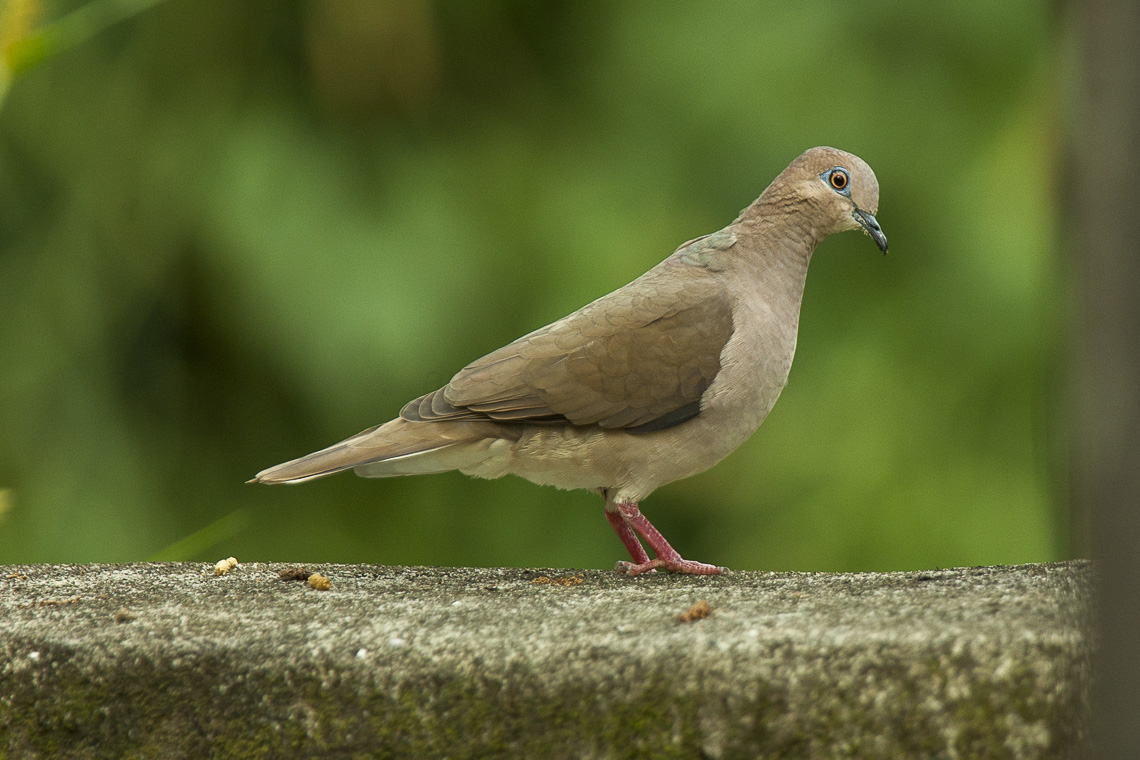
Wikipedia: White-tipped dove Source: OTHER
White-tipped_Dove_-_Panama_H8O8470.jpg
![]() The white-tipped dove (Leptotila verreauxi) is a large New World tropical dove. Its scientific name commemorates the French naturalists Jules and Edouard Verreaux.
[more]
The white-tipped dove (Leptotila verreauxi) is a large New World tropical dove. Its scientific name commemorates the French naturalists Jules and Edouard Verreaux.
[more]
Profile Wikipedia eBird Xeno-Canto

Wikipedia: Pallid dove Source: OTHER
Leptotila_pallida.jpg
![]() The pallid dove (Leptotila pallida) is a species of bird in the family Columbidae.
It is found in western Colombia, Ecuador and far northern Peru.
Its natural habitats are subtropical or tropical moist lowland forests and heavily degraded former forest.
[more]
The pallid dove (Leptotila pallida) is a species of bird in the family Columbidae.
It is found in western Colombia, Ecuador and far northern Peru.
Its natural habitats are subtropical or tropical moist lowland forests and heavily degraded former forest.
[more]

Wikipedia: Grey-fronted dove Source: OTHER
Leptotila_rufaxilla_-in_tree-8-4c.jpg
![]() The grey-fronted dove, (Leptotila rufaxilla) is a large New World tropical dove. It is a resident breeder in South America from Colombia, Venezuela and the Guyanas south to northeast Argentina and Uruguay. Several subspecies exist, among them L. r. hellmayrii from Trinidad and the Paria Peninsula in Venezuela.
[more]
The grey-fronted dove, (Leptotila rufaxilla) is a large New World tropical dove. It is a resident breeder in South America from Colombia, Venezuela and the Guyanas south to northeast Argentina and Uruguay. Several subspecies exist, among them L. r. hellmayrii from Trinidad and the Paria Peninsula in Venezuela.
[more]
Profile Wikipedia eBird Xeno-Canto

Wikipedia: Ochre-bellied dove Source: OTHER
1200px-Ochre-belliedDove.jpg
![]() The ochre-bellied dove or Buff Bellied Dove (Leptotila ochraceiventris) is a species of bird in the family Columbidae. It is found in Ecuador and Peru.
[more]
The ochre-bellied dove or Buff Bellied Dove (Leptotila ochraceiventris) is a species of bird in the family Columbidae. It is found in Ecuador and Peru.
[more]
Profile Wikipedia eBird Xeno-Canto

Wikipedia: Black-winged ground dove Source: OTHER
1200px-Black-winged_Ground-dove.jpg
![]() The black-winged ground dove (Metriopelia melanoptera) is a species of bird in the family Columbidae.
It is found in Argentina, Bolivia, Chile, Colombia, Ecuador, and Peru.
Its natural habitats are subtropical or tropical moist montane forests and subtropical or tropical high-altitude shrubland.
[more]
The black-winged ground dove (Metriopelia melanoptera) is a species of bird in the family Columbidae.
It is found in Argentina, Bolivia, Chile, Colombia, Ecuador, and Peru.
Its natural habitats are subtropical or tropical moist montane forests and subtropical or tropical high-altitude shrubland.
[more]

Wikipedia: Band-tailed pigeon Source: OTHER
1200px-Patagioenas_fasciata_-San_Luis_Obispo%2C_California%2C_USA-8_%281%29.jpg
![]() Columba fasciata (Say, 1823)
Columba fasciata (Say, 1823)
Northern band-tailed pigeon (Patagioenas fasciata)
Southern band-tailed pigeon (Patagioenas albilinea)
[more]
![]() Die Purpurtaube (Patagioenas subvinacea), auch Rötliche Taube genannt, ist eine in Süd- und Mittelamerika verbreitete Taubenart. Die IUCN stuft die Art als nicht gefährdet ein. Sie kommt in ihrem Verbreitungsgebiet in vier Unterarten vor.[1]
[more]
Die Purpurtaube (Patagioenas subvinacea), auch Rötliche Taube genannt, ist eine in Süd- und Mittelamerika verbreitete Taubenart. Die IUCN stuft die Art als nicht gefährdet ein. Sie kommt in ihrem Verbreitungsgebiet in vier Unterarten vor.[1]
[more]
Profile Wikipedia eBird Xeno-Canto
MerlinBirdID says pale-vented pigeon. 2023-04-03 16.37.04 Yucatan
First observed in Yucatan on 2023-04-03.
![]() The pale-vented pigeon (Patagioenas cayennensis) is a large pigeon (family Columbidae) found in the tropical Americas. Formerly often placed in Columba, it actually belongs to a clade of the older New World genus Patagioenas. With its relatives it represents an evolutionary radiation extending through most of the warm-temperate to tropical Americas. Grey-hued birds, even their males generally lack iridescent display plumage, although the present species has some coppery gloss on the nape.[2]
[more]
The pale-vented pigeon (Patagioenas cayennensis) is a large pigeon (family Columbidae) found in the tropical Americas. Formerly often placed in Columba, it actually belongs to a clade of the older New World genus Patagioenas. With its relatives it represents an evolutionary radiation extending through most of the warm-temperate to tropical Americas. Grey-hued birds, even their males generally lack iridescent display plumage, although the present species has some coppery gloss on the nape.[2]
[more]

Wikipedia: Scaled pigeon Source: OTHER
Patagioenas_speciosa_-Zooparque_Itatiba%2C_Sao_Paulo_State%2C_Brazil_-adult-8a.jpg
![]() The scaled pigeon (Patagioenas speciosa)[2] is a large New World tropical dove. It is a resident breeder from southern Mexico south to western Ecuador, southern Brazil, northern Argentina, and Trinidad.
[more]
The scaled pigeon (Patagioenas speciosa)[2] is a large New World tropical dove. It is a resident breeder from southern Mexico south to western Ecuador, southern Brazil, northern Argentina, and Trinidad.
[more]

Wikipedia: Plumbeous pigeon Source: OTHER
Plumbeous_Pigeon_%28Patagioenas_plumbea%29_%288079745172%29.jpg
![]() The plumbeous pigeon (Patagioenas plumbea) is a species of bird in the family Columbidae. It is found in Bolivia, Brazil, Colombia, Ecuador, French Guiana, Guyana, Panama, Paraguay, Peru, Suriname, and Venezuela in secondary growth forests, edge forests, and low hills. It can often be confused with the Ruddy Pigeon.[2]
[more]
The plumbeous pigeon (Patagioenas plumbea) is a species of bird in the family Columbidae. It is found in Bolivia, Brazil, Colombia, Ecuador, French Guiana, Guyana, Panama, Paraguay, Peru, Suriname, and Venezuela in secondary growth forests, edge forests, and low hills. It can often be confused with the Ruddy Pigeon.[2]
[more]
Profile Wikipedia eBird Xeno-Canto

Wikipedia: Dusky pigeon Source: OTHER
Patagioenas_goodsoni_-NW_Ecuador-6.jpg
![]() The dusky pigeon (Patagioenas goodsoni) is a species of bird in the family Columbidae. It is found in Colombia, Ecuador, and Panama. Its natural habitats are subtropical or tropical moist lowland forests and subtropical or tropical moist montane forests.
[more]
The dusky pigeon (Patagioenas goodsoni) is a species of bird in the family Columbidae. It is found in Colombia, Ecuador, and Panama. Its natural habitats are subtropical or tropical moist lowland forests and subtropical or tropical moist montane forests.
[more]
Profile Wikipedia eBird Xeno-Canto

Wikipedia: White-throated quail-dove Source: OTHER
1200px-White-throatedQuail-Dove.jpg
![]() The white-throated quail-dove (Zentrygon frenata) is a species of bird in the family Columbidae. It was formerly considered part of the genus Geotrygon.
It is found in Argentina, Bolivia, Colombia, Ecuador, and Peru.
Its natural habitat is subtropical or tropical moist montane forests. At 28–32 cm (11–13 in) long and a weight of 305 grams (10.8 oz.), this is the largest quail-dove and is one of the larger South American pigeons.
[more]
The white-throated quail-dove (Zentrygon frenata) is a species of bird in the family Columbidae. It was formerly considered part of the genus Geotrygon.
It is found in Argentina, Bolivia, Colombia, Ecuador, and Peru.
Its natural habitat is subtropical or tropical moist montane forests. At 28–32 cm (11–13 in) long and a weight of 305 grams (10.8 oz.), this is the largest quail-dove and is one of the larger South American pigeons.
[more]

Wikipedia: Green kingfisher Source: OTHER
1200px-Green_kingfisher_%28Chloroceryle_americana_americana%29_male.jpg
![]() The green kingfisher (Chloroceryle americana) is a resident breeding bird which occurs from southern Texas in the United States south through Central and South America to central Argentina.
[more]
The green kingfisher (Chloroceryle americana) is a resident breeding bird which occurs from southern Texas in the United States south through Central and South America to central Argentina.
[more]
Profile Wikipedia eBird Xeno-Canto

Wikipedia: American pygmy kingfisher Source: OTHER
1200px-Chloroceryle-aenea-001.jpg
![]() The American pygmy kingfisher (Chloroceryle aenea) is a resident breeding kingfisher which occurs in the American tropics from southern Mexico south through Central America to western Ecuador, and then around the northern Andes cordillera in the east to central Bolivia and central Brazil. The species occupies the entire Amazon basin and the Tocantins River drainage adjacent in Pará state Brazil. It also occurs on Trinidad.
[more]
The American pygmy kingfisher (Chloroceryle aenea) is a resident breeding kingfisher which occurs in the American tropics from southern Mexico south through Central America to western Ecuador, and then around the northern Andes cordillera in the east to central Bolivia and central Brazil. The species occupies the entire Amazon basin and the Tocantins River drainage adjacent in Pará state Brazil. It also occurs on Trinidad.
[more]
Profile Wikipedia eBird Xeno-Canto

Wikipedia: Green-and-rufous kingfisher Source: OTHER
1200px-Green-and-rufous_kingfisher_%28Chloroceryle_inda%29.JPG
![]() The green-and-rufous kingfisher (Chloroceryle inda) is a resident breeding bird in the lowlands of the American tropics from southeastern Nicaragua south to southern Brazil.
[more]
The green-and-rufous kingfisher (Chloroceryle inda) is a resident breeding bird in the lowlands of the American tropics from southeastern Nicaragua south to southern Brazil.
[more]
Profile Wikipedia eBird Xeno-Canto

Wikipedia: Amazon kingfisher Source: OTHER
1200px-Amazon_Kingfisher.jpg
![]() The Amazon kingfisher (Chloroceryle amazona) is a resident breeding kingfisher in the lowlands of the American tropics from southern Mexico south through Central America to northern Argentina.
[more]
The Amazon kingfisher (Chloroceryle amazona) is a resident breeding kingfisher in the lowlands of the American tropics from southern Mexico south through Central America to northern Argentina.
[more]
Curi cancha blue crowned motmot in tree. 2018-02-18 13.52.48 Costa Rica
First observed in Costa Rica on 2018-02-18.
![]() The blue-capped motmot or blue-crowned motmot (Momotus coeruliceps) is a colorful near-passerine bird found in forests and woodlands of eastern Mexico. This species and the Lesson's Motmot, Whooping Motmot, Trinidad Motmot, Amazonian Motmot, and Andean Motmot were all considered conspecific. The IUCN uses blue-crowned as their identifier for this species, however it was also the name used for the prior species complex.
[more]
The blue-capped motmot or blue-crowned motmot (Momotus coeruliceps) is a colorful near-passerine bird found in forests and woodlands of eastern Mexico. This species and the Lesson's Motmot, Whooping Motmot, Trinidad Motmot, Amazonian Motmot, and Andean Motmot were all considered conspecific. The IUCN uses blue-crowned as their identifier for this species, however it was also the name used for the prior species complex.
[more]
Profile Wikipedia eBird Xeno-Canto

Wikipedia: Whooping motmot Source: OTHER
Momotus_subrufescens%2C_Panama_5.jpg
![]() The whooping motmot (Momotus subrufescens) is a colorful near-passerine bird found in forests and woodlands of southern Panama to northwestern Peru. This species and the blue-capped motmot, Lesson's motmot, Trinidad motmot, Amazonian motmot, and Andean motmot were all considered conspecific.
[more]
The whooping motmot (Momotus subrufescens) is a colorful near-passerine bird found in forests and woodlands of southern Panama to northwestern Peru. This species and the blue-capped motmot, Lesson's motmot, Trinidad motmot, Amazonian motmot, and Andean motmot were all considered conspecific.
[more]
Profile Wikipedia eBird Xeno-Canto

Wikipedia: Andean motmot Source: OTHER
Highland_Motmot_-_Colombia_%2822048211293%29.jpg
![]() The Andean motmot or highland motmot (Momotus aequatorialis) is a colorful near-passerine bird found from northern Colombia to western Bolivia.[2]
[more]
The Andean motmot or highland motmot (Momotus aequatorialis) is a colorful near-passerine bird found from northern Colombia to western Bolivia.[2]
[more]

Wikipedia: Rufous motmot Source: OTHER
1200px-Baryphthengus_martii_-Panama-8.jpg
Panama
![]() The rufous motmot (Baryphthengus martii) is a near-passerine bird which is a resident breeder in rain forests from northeastern Honduras south to western Ecuador, northeastern Bolivia, and southwestern Brazil.
[more]
The rufous motmot (Baryphthengus martii) is a near-passerine bird which is a resident breeder in rain forests from northeastern Honduras south to western Ecuador, northeastern Bolivia, and southwestern Brazil.
[more]
Profile Wikipedia eBird Xeno-Canto
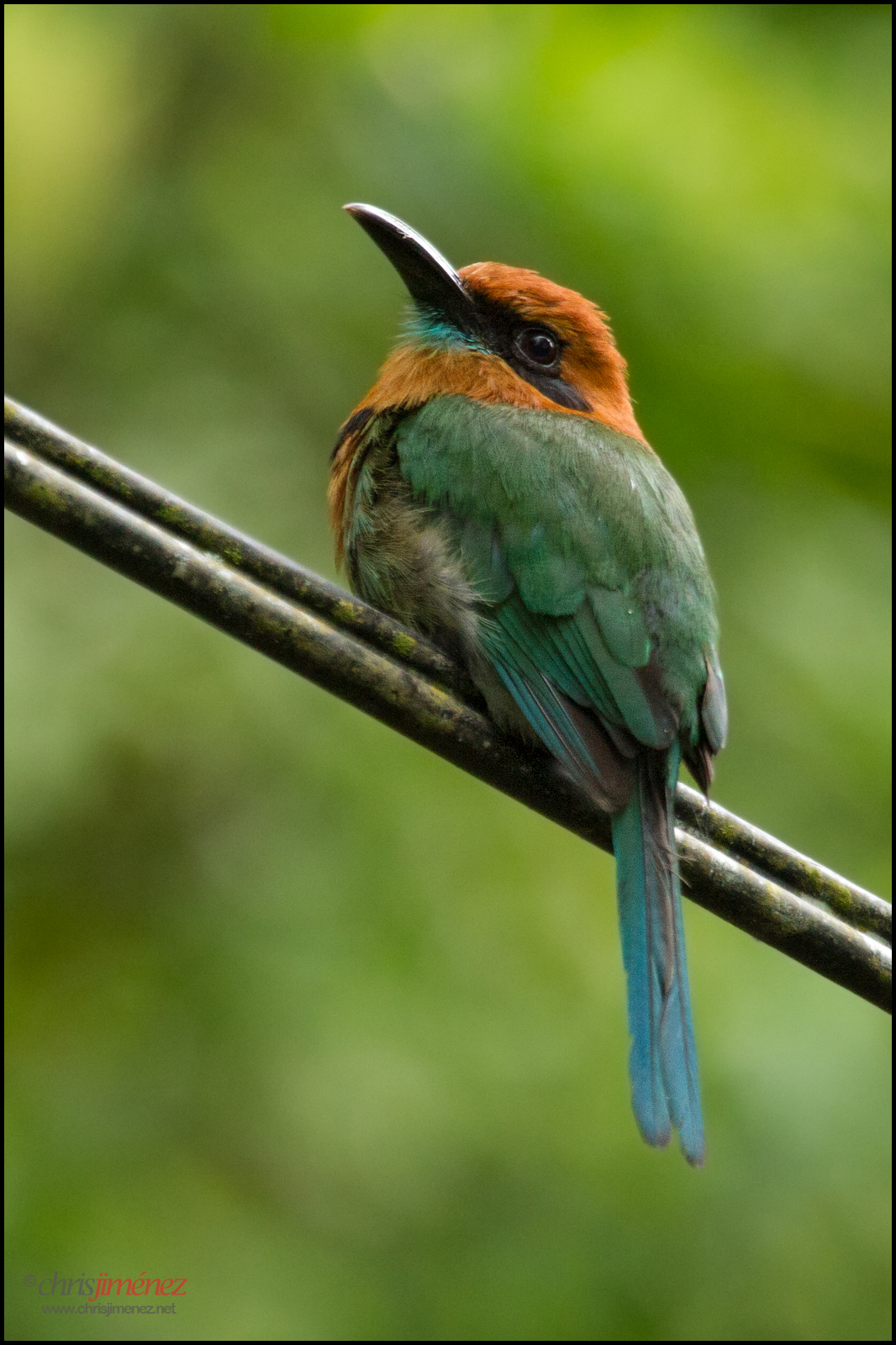
Wikipedia: Broad-billed motmot Source: OTHER
Broad-billed_Motmot.jpg
![]() The broad-billed motmot (Electron platyrhynchum) is a fairly common[2] Central and South American bird of the Momotidae family.[3] They are nonmigratory, sedentary birds[4] that are most frequently seen in singles or pairs.[3] There exist six subspecies of the broad-billed motmot.[3]
[more]
The broad-billed motmot (Electron platyrhynchum) is a fairly common[2] Central and South American bird of the Momotidae family.[3] They are nonmigratory, sedentary birds[4] that are most frequently seen in singles or pairs.[3] There exist six subspecies of the broad-billed motmot.[3]
[more]
Profile Wikipedia eBird Xeno-Canto

Wikipedia: Dwarf cuckoo Source: OTHER
1200px-Coccycua_pumila_%28Cuco_enano%29_%2815430611517%29.jpg
![]() The dwarf cuckoo (Coccycua pumila) is a tropical American bird species of the cuckoo family (Cuculidae).
[more]
The dwarf cuckoo (Coccycua pumila) is a tropical American bird species of the cuckoo family (Cuculidae).
[more]
Profile Wikipedia eBird Audubon AllAboutBirds Xeno-Canto
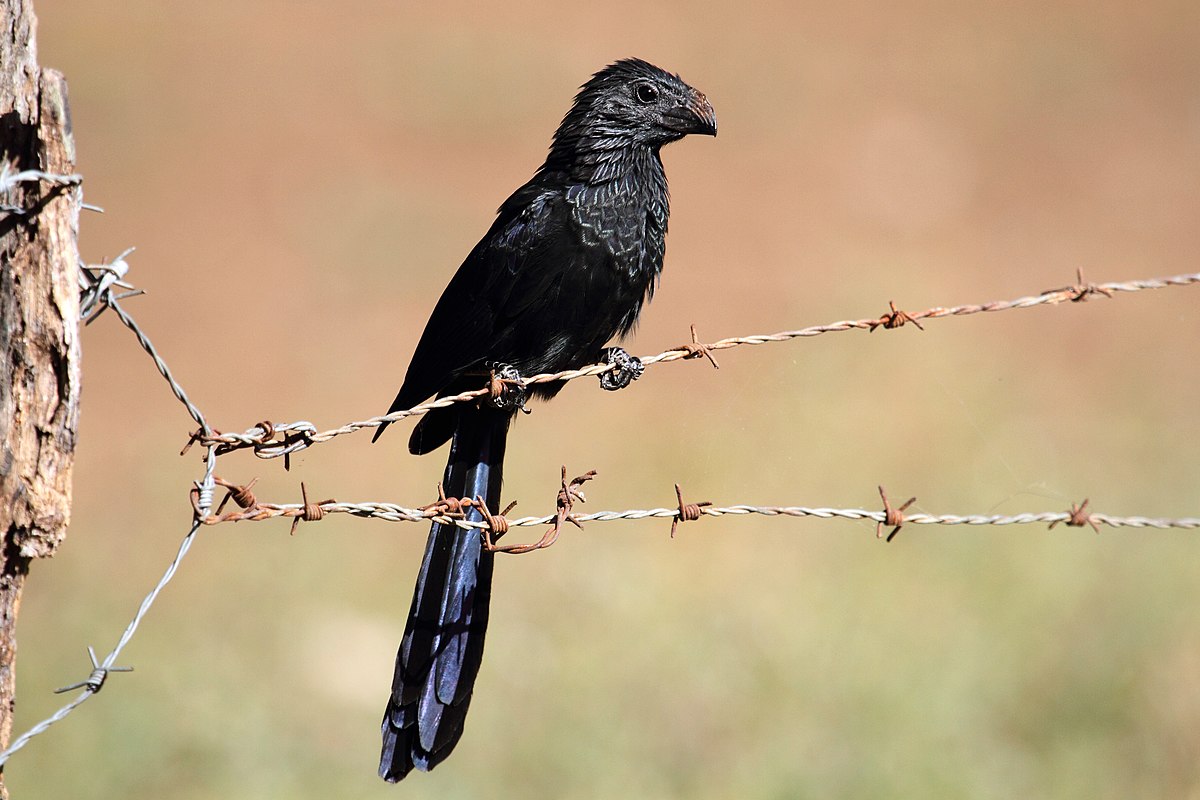
Wikipedia: Groove-billed ani Source: OTHER
1200px-Crotophaga_sulcirostris_CR_bis.JPG
![]() The groove-billed ani (Crotophaga sulcirostris) is a tropical bird in the cuckoo family with a long tail and a large, curved beak. It is a resident species throughout most of its range, from southern Texas, central Mexico and The Bahamas, through Central America, to northern Colombia and Venezuela, and coastal Ecuador and Peru. It only retreats from the northern limits of its range in Texas and northern Mexico during winter.
[more]
The groove-billed ani (Crotophaga sulcirostris) is a tropical bird in the cuckoo family with a long tail and a large, curved beak. It is a resident species throughout most of its range, from southern Texas, central Mexico and The Bahamas, through Central America, to northern Colombia and Venezuela, and coastal Ecuador and Peru. It only retreats from the northern limits of its range in Texas and northern Mexico during winter.
[more]
Profile Wikipedia eBird Audubon AllAboutBirds Xeno-Canto
Smooth-billed ani. 2023-04-16 06.25.20 Yucatan
First observed in Yucatan on 2023-04-16.
![]() The smooth-billed ani (Crotophaga ani) is a large near passerine bird in the cuckoo family. It is a resident breeding species from southern Florida, the Caribbean, parts of Central America, south to western Ecuador, Brazil, northern Argentina and southern Chile.[2] It was introduced to Galápagos around the 1960s and is potentially impacting native and endemic species across the archipelago.[3]
[more]
The smooth-billed ani (Crotophaga ani) is a large near passerine bird in the cuckoo family. It is a resident breeding species from southern Florida, the Caribbean, parts of Central America, south to western Ecuador, Brazil, northern Argentina and southern Chile.[2] It was introduced to Galápagos around the 1960s and is potentially impacting native and endemic species across the archipelago.[3]
[more]
Profile Wikipedia eBird Xeno-Canto
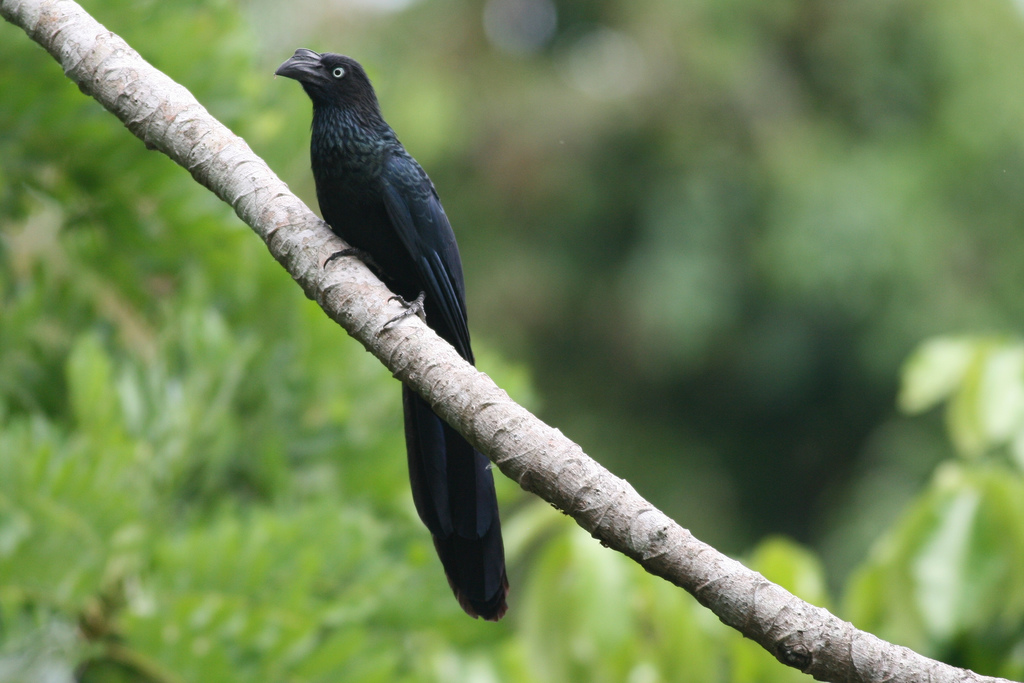
Wikipedia: Greater ani Source: OTHER
Crotophaga_major_%28Greater_Ani%29.jpg
![]() The greater ani (Crotophaga major) is a large bird in the cuckoo family. It is a breeding species from Panama and Trinidad through tropical South America to northern Argentina. It is sometimes referred to as the black cuckoo.
[more]
The greater ani (Crotophaga major) is a large bird in the cuckoo family. It is a breeding species from Panama and Trinidad through tropical South America to northern Argentina. It is sometimes referred to as the black cuckoo.
[more]
Profile Wikipedia eBird Xeno-Canto
Squirrel cuckoo. 2020-03-04 09.26.50 Panama
First observed in Panama on 2020-03-04.
![]() The squirrel cuckoo (Piaya cayana) is a large and active species of cuckoo found in wooded habitats from northwestern Mexico to northern Argentina and Uruguay, and on Trinidad. Some authorities have split off the western Mexican form as the Mexican squirrel-cuckoo (Piaya mexicana).[2]
[more]
The squirrel cuckoo (Piaya cayana) is a large and active species of cuckoo found in wooded habitats from northwestern Mexico to northern Argentina and Uruguay, and on Trinidad. Some authorities have split off the western Mexican form as the Mexican squirrel-cuckoo (Piaya mexicana).[2]
[more]
Profile Wikipedia eBird Xeno-Canto
Wikipedia: Black-bellied cuckoo Source: OTHER
Piaya_melanogaster_-_Black-bellied_Cuckoo.JPG
![]() The black-bellied cuckoo or black-bellied squirrel cuckoo (Piaya melanogaster) is a bird of the family Cuculidae found in the Amazon region.[2][3][4] The genus Playa is considered part of the cuckoos of the New World.[5] Even though this species has a wide distribution, little is known about its ecology and natural history.[4] This species is considered as monotypic. The word melanogaster means "black belly"; it has Greek roots, melas meaning "black" and gaster meaning "belly".[5]
[more]
The black-bellied cuckoo or black-bellied squirrel cuckoo (Piaya melanogaster) is a bird of the family Cuculidae found in the Amazon region.[2][3][4] The genus Playa is considered part of the cuckoos of the New World.[5] Even though this species has a wide distribution, little is known about its ecology and natural history.[4] This species is considered as monotypic. The word melanogaster means "black belly"; it has Greek roots, melas meaning "black" and gaster meaning "belly".[5]
[more]
![]() Der Schwarzschnabelkuckuck (Coccyzus erythropthalmus) ist eine Art aus der Familie der Kuckucksvögel, die ausschließlich in der neuen Welt vorkommt. Er brütet ausschließlich im Nordosten Nordamerikas, überwintert aber während des Winterhalbjahres in Südamerika. Während seines Zuges im Herbst und Frühjahr ist er auch in Zentralamerika, in Mexiko und dem Süden der Vereinigten Staaten zu beobachten. Der sehr heimlich lebende Schwarzschnabelkuckuck ist ein mittelgroßer, schlanker und langschwänziger Kuckuck, der sich überwiegend versteckt im Blattwerk aufhält.
[more]
Der Schwarzschnabelkuckuck (Coccyzus erythropthalmus) ist eine Art aus der Familie der Kuckucksvögel, die ausschließlich in der neuen Welt vorkommt. Er brütet ausschließlich im Nordosten Nordamerikas, überwintert aber während des Winterhalbjahres in Südamerika. Während seines Zuges im Herbst und Frühjahr ist er auch in Zentralamerika, in Mexiko und dem Süden der Vereinigten Staaten zu beobachten. Der sehr heimlich lebende Schwarzschnabelkuckuck ist ein mittelgroßer, schlanker und langschwänziger Kuckuck, der sich überwiegend versteckt im Blattwerk aufhält.
[more]
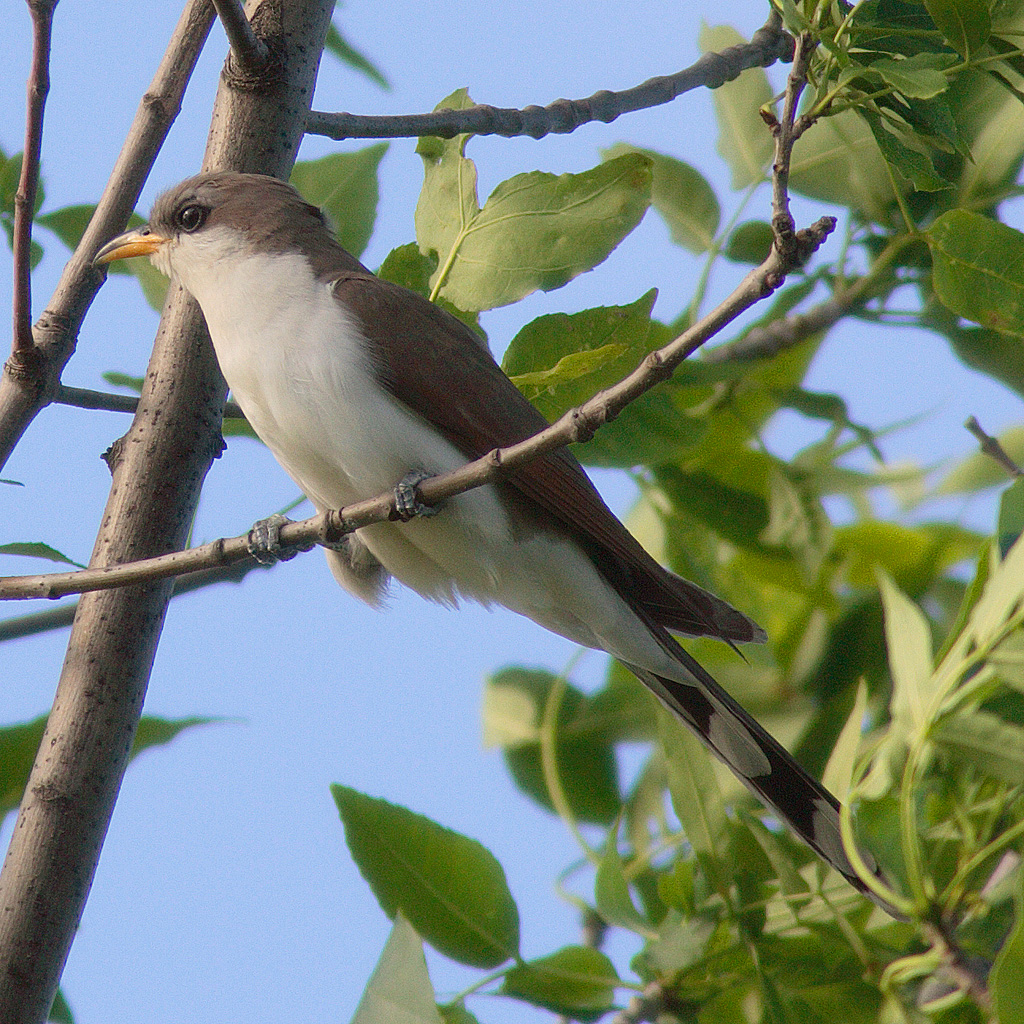
Wikipedia: Yellow-billed cuckoo Source: OTHER
Coccyzus-americanus-001.jpg
![]() The yellow-billed cuckoo (Coccyzus americanus) is a cuckoo. Common folk-names for this bird in the southern United States are rain crow and storm crow. These likely refer to the bird's habit of calling on hot days, often presaging rain or thunderstorms.
[more]
The yellow-billed cuckoo (Coccyzus americanus) is a cuckoo. Common folk-names for this bird in the southern United States are rain crow and storm crow. These likely refer to the bird's habit of calling on hot days, often presaging rain or thunderstorms.
[more]
Profile Wikipedia eBird Xeno-Canto

Wikipedia: Pearly-breasted cuckoo Source: OTHER
1200px-Pearly-breasted_Cuckoo.jpg
![]() The pearly-breasted cuckoo (Coccyzus euleri) is a species of cuckoo in the family Cuculidae.
It is found in Argentina, Bolivia, Brazil,[2] Colombia, Ecuador, French Guiana, Guyana, Paraguay, Suriname, Peru[3] and Venezuela.
Its natural habitats are subtropical or tropical moist lowland forests and heavily degraded former forest. It does not occur above an elevation of 2000 meters.[4]
[more]
The pearly-breasted cuckoo (Coccyzus euleri) is a species of cuckoo in the family Cuculidae.
It is found in Argentina, Bolivia, Brazil,[2] Colombia, Ecuador, French Guiana, Guyana, Paraguay, Suriname, Peru[3] and Venezuela.
Its natural habitats are subtropical or tropical moist lowland forests and heavily degraded former forest. It does not occur above an elevation of 2000 meters.[4]
[more]
Profile Wikipedia eBird Xeno-Canto

Wikipedia: Dark-billed cuckoo Source: OTHER
1200px-Coccyzus_melacoryphus.jpg
![]() The dark-billed cuckoo (Coccyzus melacoryphus) is a species of bird in the family Cuculidae, the cuckoos.
[more]
The dark-billed cuckoo (Coccyzus melacoryphus) is a species of bird in the family Cuculidae, the cuckoos.
[more]
Profile Wikipedia eBird Xeno-Canto

Wikipedia: Gray-capped cuckoo Source: OTHER
1200px-Coccyzus_lansbergi_map.svg.png
![]() The grey-capped cuckoo (Coccyzus lansbergi) is a species of cuckoo in the family Cuculidae. It is found in Aruba, Colombia, Ecuador, Netherlands Antilles, Panama, Peru, and Venezuela.
[more]
The grey-capped cuckoo (Coccyzus lansbergi) is a species of cuckoo in the family Cuculidae. It is found in Aruba, Colombia, Ecuador, Netherlands Antilles, Panama, Peru, and Venezuela.
[more]
Profile Wikipedia eBird Xeno-Canto

Wikipedia: Pheasant cuckoo Source: OTHER
1200px-Dromococcyx_phasianellus_-_Pheasant_Cuckoo%3B_Caxias%2C_Maranh%C3%A3o%2C_Brazil.jpg
![]() The pheasant cuckoo (Dromococcyx phasianellus) is a species of neotropical cuckoo in the subfamily Neomorphinae of the family Cuculidae. It is native to Central and South America where it occurs in lowland tropical forest.
[more]
The pheasant cuckoo (Dromococcyx phasianellus) is a species of neotropical cuckoo in the subfamily Neomorphinae of the family Cuculidae. It is native to Central and South America where it occurs in lowland tropical forest.
[more]
Profile Wikipedia eBird Xeno-Canto

Wikipedia: Pavonine cuckoo Source: OTHER
Dromococcyx_pavoninus.jpg
![]() The pavonine cuckoo (Dromococcyx pavoninus) is a Neotropical cuckoo with a long graduated tail and a short crest. It is one of three species of Neotropical cuckoo which are known to be brood parasites.
[more]
The pavonine cuckoo (Dromococcyx pavoninus) is a Neotropical cuckoo with a long graduated tail and a short crest. It is one of three species of Neotropical cuckoo which are known to be brood parasites.
[more]
Profile Wikipedia eBird Xeno-Canto

Wikipedia: Rufous-vented ground-cuckoo Source: OTHER
1200px-Rufous-vented_Ground_Cuckoo.jpg
![]() The rufous-vented ground cuckoo (Neomorphus geoffroyi) is a large terrestrial species of cuckoo in the family Cuculidae. It is found in humid primary forests from southern Nicaragua, through Costa Rica and Panama, into north-western Colombia. Another population occurs in the western and southern Amazon Basin of south-eastern Colombia, eastern Ecuador, eastern Peru, northern Bolivia and Brazil, while a final population occurs in the Atlantic Forest of eastern Brazil. Much confusion exists over the exact limits of its distribution in the south-central Amazon, where the very similar scaled ground cuckoo occurs (the breast-markings typically used to separate the scaled and the rufous-vented ground cuckoos are known to vary clinally). Consequently, the scaled ground cuckoo has often been considered a subspecies of the rufous-vented ground cuckoo.[2]
[more]
The rufous-vented ground cuckoo (Neomorphus geoffroyi) is a large terrestrial species of cuckoo in the family Cuculidae. It is found in humid primary forests from southern Nicaragua, through Costa Rica and Panama, into north-western Colombia. Another population occurs in the western and southern Amazon Basin of south-eastern Colombia, eastern Ecuador, eastern Peru, northern Bolivia and Brazil, while a final population occurs in the Atlantic Forest of eastern Brazil. Much confusion exists over the exact limits of its distribution in the south-central Amazon, where the very similar scaled ground cuckoo occurs (the breast-markings typically used to separate the scaled and the rufous-vented ground cuckoos are known to vary clinally). Consequently, the scaled ground cuckoo has often been considered a subspecies of the rufous-vented ground cuckoo.[2]
[more]
Profile Wikipedia eBird Xeno-Canto

Wikipedia: Banded ground-cuckoo Source: OTHER
1200px-NeomorphusRadiolosusSmit.jpg
![]() The banded ground cuckoo (Neomorphus radiolosus) is a species of cuckoo in the family Cuculidae. It is found in the Chocó of western Colombia and Ecuador.
[more]
The banded ground cuckoo (Neomorphus radiolosus) is a species of cuckoo in the family Cuculidae. It is found in the Chocó of western Colombia and Ecuador.
[more]
Profile Wikipedia eBird Xeno-Canto
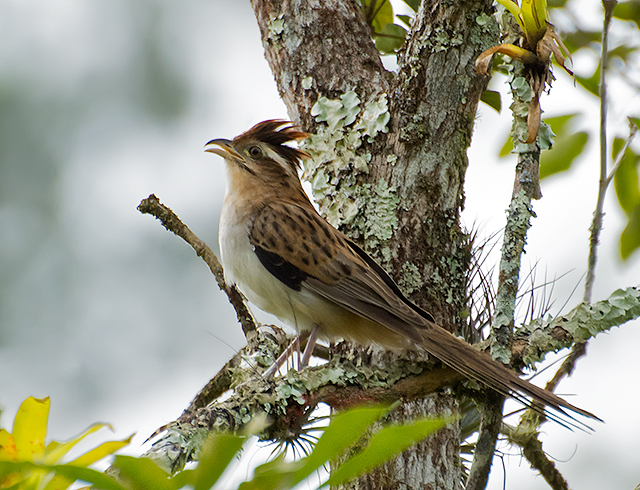
Wikipedia: Striped cuckoo Source: OTHER
SACI_%28Tapera_naevia_%29.jpg
![]() The striped cuckoo (Tapera naevia) is a near-passerine bird, the only member of the genus Tapera. This resident cuckoo is found from Mexico and Trinidad south to Bolivia and Argentina.
[more]
The striped cuckoo (Tapera naevia) is a near-passerine bird, the only member of the genus Tapera. This resident cuckoo is found from Mexico and Trinidad south to Bolivia and Argentina.
[more]

Wikipedia: Peregrine falcon Source: OTHER
Falco_peregrinus_good_-_Christopher_Watson.jpg
This bird appears across the great seas in the following continents:
Europe, North America, South America, Africa, Asia.
![]() The peregrine falcon (Falco peregrinus), also known as the peregrine,[2] and historically as the duck hawk in North America,[3] is a widespread bird of prey (raptor) in the family Falconidae. A large, crow-sized falcon, it has a blue-grey back, barred white underparts, and a black head. The peregrine is renowned for its speed, reaching over 320 km/h (200 mph) during its characteristic hunting stoop (high-speed dive),[4] making it the fastest bird in the world, as well as the fastest member of the animal kingdom.[5][6][7] According to a National Geographic TV program, the highest measured speed of a peregrine falcon is 389 km/h (242 mph).[8][9] As is typical for bird-eating raptors, peregrine falcons are sexually dimorphic, with females being considerably larger than males.[10][11]
[more]
The peregrine falcon (Falco peregrinus), also known as the peregrine,[2] and historically as the duck hawk in North America,[3] is a widespread bird of prey (raptor) in the family Falconidae. A large, crow-sized falcon, it has a blue-grey back, barred white underparts, and a black head. The peregrine is renowned for its speed, reaching over 320 km/h (200 mph) during its characteristic hunting stoop (high-speed dive),[4] making it the fastest bird in the world, as well as the fastest member of the animal kingdom.[5][6][7] According to a National Geographic TV program, the highest measured speed of a peregrine falcon is 389 km/h (242 mph).[8][9] As is typical for bird-eating raptors, peregrine falcons are sexually dimorphic, with females being considerably larger than males.[10][11]
[more]
Vocalization: ![]() A harsh, drawn out "kiaaaa" with emphasised endings repeated in series. Much slower than Merlin, but higher pitched than Gyrfalcon. [Link]
A harsh, drawn out "kiaaaa" with emphasised endings repeated in series. Much slower than Merlin, but higher pitched than Gyrfalcon. [Link]
Calls: ![]() Also shorter, coarse warning-calls. [Link]
Also shorter, coarse warning-calls. [Link]
Physical details: length=36-48 cm,
wingspan=95-110 cm,
weight=582-1300 g
Habitats:
Agricultural

Merlin SoundID bird list. Source: OTHER
Merlin SoundID bird list.jpg
This bird appears across the great seas in the following continents:
Europe, North America, South America, Africa.
Deutschland: Zugvogel, Wintergast
Vocalization: ![]() Series of harsh "kwik-wik wik". Coarseness similar to Peregrine, but pace much quicker. [Link]
Series of harsh "kwik-wik wik". Coarseness similar to Peregrine, but pace much quicker. [Link]
Calls: ![]() Female call harsher than male. Lacking the clearer tones and attack of Kestrel. [Link]
Female call harsher than male. Lacking the clearer tones and attack of Kestrel. [Link]
Physical details: length=25-30 cm,
wingspan=50-62 cm,
weight=125-300 g
Habitats:
Agricultural
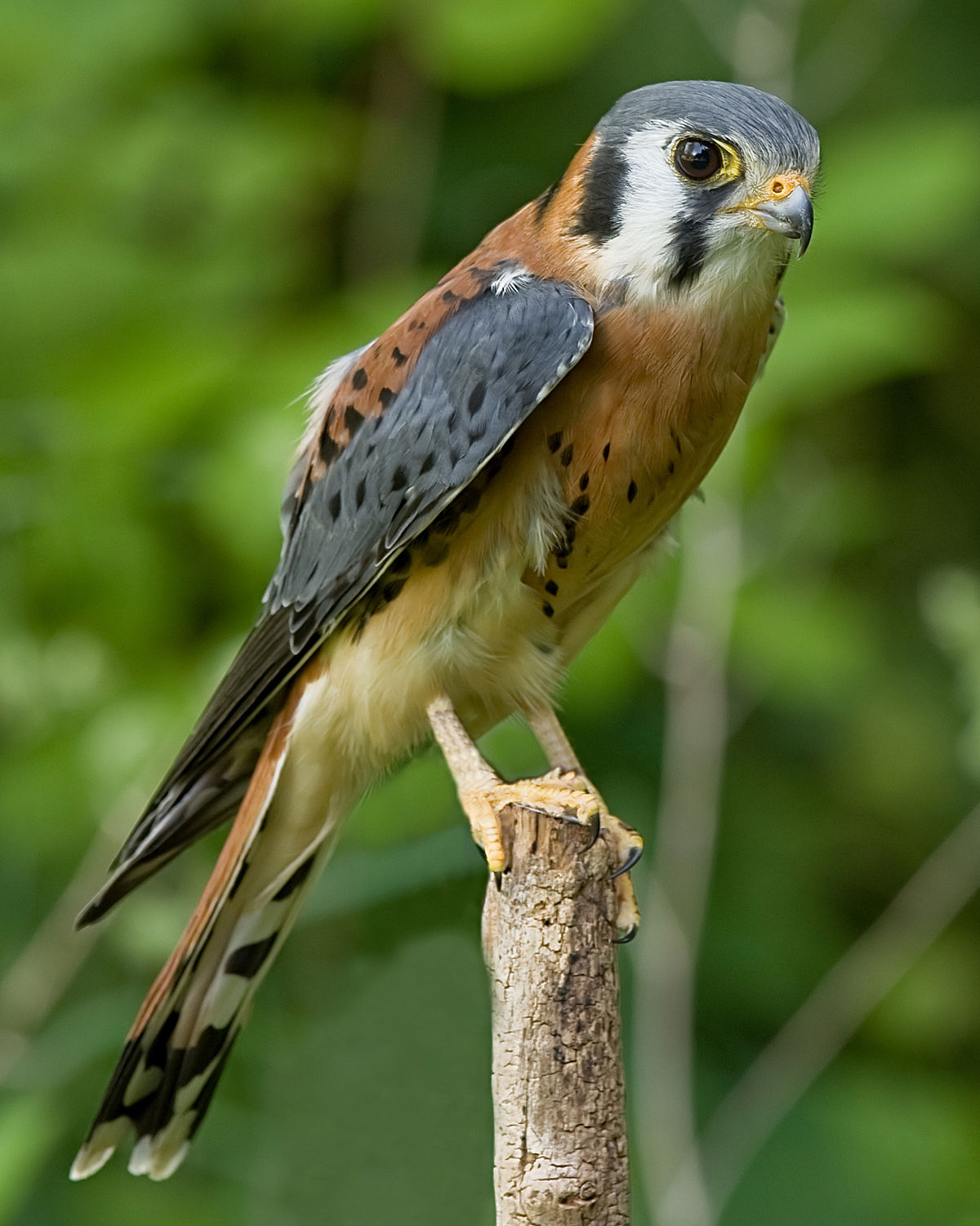
Wikipedia: American kestrel Source: OTHER
1200px-AmericanKestrel02.jpg
General: ![]() The American kestrel (Falco sparverius), also called the sparrow hawk, is the smallest and most common falcon in North America. It has a roughly two-to-one range in size over subspecies and sex, varying in size from about the weight of a blue jay to a mourning dove. It also ranges to South America and is a well-established species that has evolved into 17 subspecies adapted to different environments and habitats throughout the Americas. It exhibits sexual dimorphism in size (females being moderately larger) and plumage, although both sexes have a rufous back with noticeable barring. Its plumage is colorful and attractive, and juveniles are similar in plumage to adults.
[more]
The American kestrel (Falco sparverius), also called the sparrow hawk, is the smallest and most common falcon in North America. It has a roughly two-to-one range in size over subspecies and sex, varying in size from about the weight of a blue jay to a mourning dove. It also ranges to South America and is a well-established species that has evolved into 17 subspecies adapted to different environments and habitats throughout the Americas. It exhibits sexual dimorphism in size (females being moderately larger) and plumage, although both sexes have a rufous back with noticeable barring. Its plumage is colorful and attractive, and juveniles are similar in plumage to adults.
[more]
Profile Wikipedia eBird Audubon AllAboutBirds Xeno-Canto

Wikipedia: Aplomado falcon Source: OTHER
Aplomado_Falcon_portrait.jpg
![]() The aplomado falcon (Falco femoralis) is a medium-sized falcon of the Americas. The species' largest contiguous range is in South America, but not in the deep interior Amazon Basin. It was long known as Falco fusco-coerulescens or Falco fuscocaerulescens, but these names are now believed to refer to the bat falcon (F. rufigularis).[2] Its resemblance in shape to the hobbies accounts for its old name orange-chested hobby. Aplomado is an unusual Spanish word for "lead-colored", referring to the blue-grey areas of the plumage – an approximate English translation would be "plumbeous falcon". Spanish names for the species include halcón aplomado and halcón fajado (roughly "banded falcon" in reference to the characteristic pattern); in Brazil it is known as falcão-de-coleira.
[more]
The aplomado falcon (Falco femoralis) is a medium-sized falcon of the Americas. The species' largest contiguous range is in South America, but not in the deep interior Amazon Basin. It was long known as Falco fusco-coerulescens or Falco fuscocaerulescens, but these names are now believed to refer to the bat falcon (F. rufigularis).[2] Its resemblance in shape to the hobbies accounts for its old name orange-chested hobby. Aplomado is an unusual Spanish word for "lead-colored", referring to the blue-grey areas of the plumage – an approximate English translation would be "plumbeous falcon". Spanish names for the species include halcón aplomado and halcón fajado (roughly "banded falcon" in reference to the characteristic pattern); in Brazil it is known as falcão-de-coleira.
[more]
Profile Wikipedia eBird Xeno-Canto
Bat falcon at cenote xxx. 2023-04-14 13.03.34 Yucatan
First observed in Yucatan on 2023-04-05.
![]() The bat falcon (Falco rufigularis) is a falcon that is a resident breeder in tropical Mexico, Central and South America, and Trinidad. It was long known as Falco albigularis; the names Falco fusco-coerulescens or Falco fuscocaerulescens, long used for the aplomado falcon, are now believed to refer to the present species.[2]
[more]
The bat falcon (Falco rufigularis) is a falcon that is a resident breeder in tropical Mexico, Central and South America, and Trinidad. It was long known as Falco albigularis; the names Falco fusco-coerulescens or Falco fuscocaerulescens, long used for the aplomado falcon, are now believed to refer to the present species.[2]
[more]
Profile Wikipedia eBird Xeno-Canto

Wikipedia: Orange-breasted falcon Source: OTHER
1200px-Falco_deiroleucus_-_Orange-breasted_Falcon.JPG
![]() The orange-breasted falcon (Falco deiroleucus) is a bird of the falcon family. It is probably closely related to and looks like a larger version of the bat falcon. These two, in turn, are probably closest to the aplomado falcon and constitute a rather old American lineage of Falco.[2]
[more]
The orange-breasted falcon (Falco deiroleucus) is a bird of the falcon family. It is probably closely related to and looks like a larger version of the bat falcon. These two, in turn, are probably closest to the aplomado falcon and constitute a rather old American lineage of Falco.[2]
[more]
Profile Wikipedia eBird Xeno-Canto

Wikipedia: Barred forest-falcon Source: OTHER
1200px-Micrastur_ruficollis_-Parque_Estadual_da_Serra_da_Cantareira%2C_Sao_Paulo%2C_Brazil-8.jpg
![]() The barred forest falcon (Micrastur ruficollis) is a species of bird of prey in the family Falconidae which includes the falcons, caracaras, and their relatives. It occurs throughout most of tropical and subtropical Latin America, except the arid Pacific coast in South America, northern and western Mexico, and the Antilles.
[more]
The barred forest falcon (Micrastur ruficollis) is a species of bird of prey in the family Falconidae which includes the falcons, caracaras, and their relatives. It occurs throughout most of tropical and subtropical Latin America, except the arid Pacific coast in South America, northern and western Mexico, and the Antilles.
[more]

Wikipedia: Slaty-backed forest-falcon Source: OTHER
1200px-Micrastur_mirandollei_1902.jpg
![]() The slaty-backed forest falcon (Micrastur mirandollei) is a species of bird of prey in the family Falconidae.
It is found in Bolivia, Brazil, Colombia, Costa Rica, Ecuador, French Guiana, Guyana, Panama, Peru, Suriname, and Venezuela. Its natural habitat is subtropical or tropical moist lowland forests. It is an active hunter that preys on birds, snakes, lizards, rodents, fish, and sometimes bats. Its call is different from that of other forest falcons, with 7-10 notes repeated in a series.
[more]
The slaty-backed forest falcon (Micrastur mirandollei) is a species of bird of prey in the family Falconidae.
It is found in Bolivia, Brazil, Colombia, Costa Rica, Ecuador, French Guiana, Guyana, Panama, Peru, Suriname, and Venezuela. Its natural habitat is subtropical or tropical moist lowland forests. It is an active hunter that preys on birds, snakes, lizards, rodents, fish, and sometimes bats. Its call is different from that of other forest falcons, with 7-10 notes repeated in a series.
[more]
Profile Wikipedia eBird Xeno-Canto
Collared forest falcon awaits dinner at Zetzo bat cave near Ixpujil. 2023-04-03 18.00.06 Yucatan
First observed in Yucatan on 2023-04-03.
![]() The collared forest falcon (Micrastur semitorquatus) is a species of bird of prey in the family Falconidae. It is the largest member of the Micrastur genus and a common inhabitant of tropical rainforests in Latin America.[2] Hiding in the dense forest canopy, they are a secretive bird often only recognized by their distinctive call. With a morphology or body type allowing them to be agile in their forested habitat, their diet comprises a wide variety of prey from smaller frogs (20 g) to adult turkeys (2.7-3.2 kg).[3]
[more]
The collared forest falcon (Micrastur semitorquatus) is a species of bird of prey in the family Falconidae. It is the largest member of the Micrastur genus and a common inhabitant of tropical rainforests in Latin America.[2] Hiding in the dense forest canopy, they are a secretive bird often only recognized by their distinctive call. With a morphology or body type allowing them to be agile in their forested habitat, their diet comprises a wide variety of prey from smaller frogs (20 g) to adult turkeys (2.7-3.2 kg).[3]
[more]
Profile Wikipedia eBird Xeno-Canto

Wikipedia: Plumbeous forest-falcon Source: OTHER
1200px-MicrasturPlumbeusGronvold.jpg
![]() The plumbeous forest falcon (Micrastur plumbeus) is a species of bird of prey in the family Falconidae. It is endemic to humid forests in the Chocó in south-western Colombia and north-western Ecuador. It is generally poorly known and rare. It is threatened by habitat loss, and consequently considered vulnerable by BirdLife International and IUCN. It closely resembles the lined forest falcon from the Amazon, but adults only have a single white tail-band (in addition to a narrow white tail-tip) and the irides are pale brownish-grey.
[more]
The plumbeous forest falcon (Micrastur plumbeus) is a species of bird of prey in the family Falconidae. It is endemic to humid forests in the Chocó in south-western Colombia and north-western Ecuador. It is generally poorly known and rare. It is threatened by habitat loss, and consequently considered vulnerable by BirdLife International and IUCN. It closely resembles the lined forest falcon from the Amazon, but adults only have a single white tail-band (in addition to a narrow white tail-tip) and the irides are pale brownish-grey.
[more]
![]() Buckley's forest falcon (Micrastur buckleyi), also known as the lesser collared forest falcon or Traylor's forest falcon, is a species of bird of prey in the family Falconidae.
It is found in the Amazon basin of Peru, Ecuador and far southern Colombia.
Its natural habitat is subtropical or tropical moist lowland forest.
[more]
Buckley's forest falcon (Micrastur buckleyi), also known as the lesser collared forest falcon or Traylor's forest falcon, is a species of bird of prey in the family Falconidae.
It is found in the Amazon basin of Peru, Ecuador and far southern Colombia.
Its natural habitat is subtropical or tropical moist lowland forest.
[more]
Profile Wikipedia eBird Xeno-Canto

Wikipedia: Lined forest-falcon Source: OTHER
1200px-Lined_Forest_Falcon.jpg
![]() The lined forest falcon (Micrastur gilvicollis) is a species of bird of prey in the family Falconidae. It is endemic to humid forest in the western and northern Amazon Basin. Populations found in the south-eastern Amazon Basin (south of the Amazon River and east of the Madeira River) were formerly included in this species, but were described as a new species, the cryptic forest falcon, in 2003. Together with the plumbeous forest falcon of the Chocó, they are an example of a cryptic species complex. While adults of all three species have the deep orange-red facial skin and cere that separates them from the sympatric barred forest falcon, only the lined forest falcon has two white bars in the tail (in addition to a narrow white tail-tip). The species is listed by the IUCN as a species of least concern, indicating that populations are not in decline.[2]
[more]
The lined forest falcon (Micrastur gilvicollis) is a species of bird of prey in the family Falconidae. It is endemic to humid forest in the western and northern Amazon Basin. Populations found in the south-eastern Amazon Basin (south of the Amazon River and east of the Madeira River) were formerly included in this species, but were described as a new species, the cryptic forest falcon, in 2003. Together with the plumbeous forest falcon of the Chocó, they are an example of a cryptic species complex. While adults of all three species have the deep orange-red facial skin and cere that separates them from the sympatric barred forest falcon, only the lined forest falcon has two white bars in the tail (in addition to a narrow white tail-tip). The species is listed by the IUCN as a species of least concern, indicating that populations are not in decline.[2]
[more]
Profile Wikipedia eBird Xeno-Canto

Wikipedia: Yellow-headed caracara Source: OTHER
1200px-Gelbkopfkarakara_Milvago_chimachima.jpg
![]() The yellow-headed caracara (Milvago chimachima) is a bird of prey in the family Falconidae. It is found in tropical and subtropical South America and the southern portion of Central America. Unlike the falcons in the same family, the caracara is not a fast-flying aerial hunter, but is rather sluggish and often obtains food by scavenging.
[more]
The yellow-headed caracara (Milvago chimachima) is a bird of prey in the family Falconidae. It is found in tropical and subtropical South America and the southern portion of Central America. Unlike the falcons in the same family, the caracara is not a fast-flying aerial hunter, but is rather sluggish and often obtains food by scavenging.
[more]
Profile Wikipedia eBird Xeno-Canto
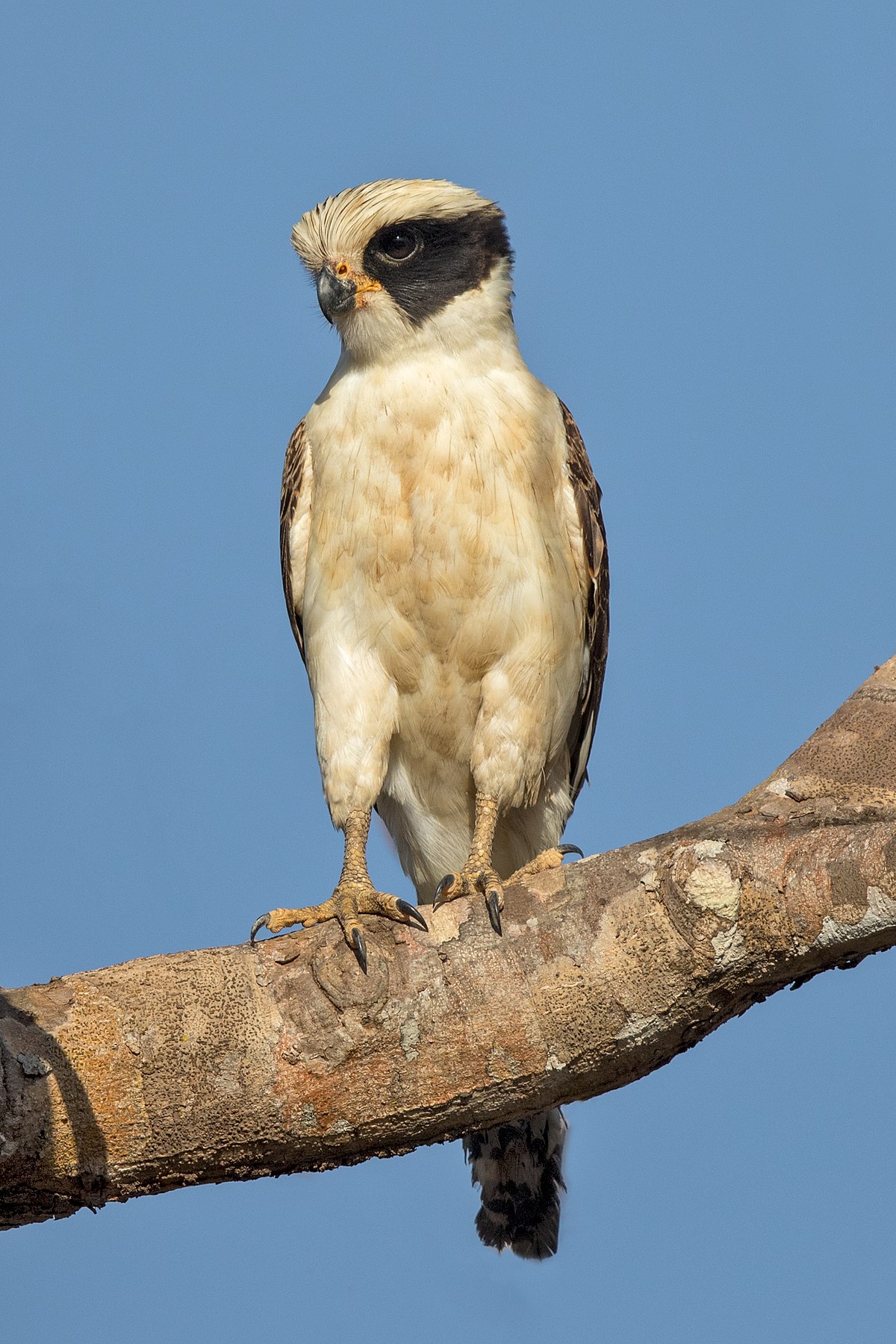
Wikipedia: Laughing falcon Source: OTHER
1200px-Lachfalke.jpg
![]() The laughing falcon (Herpetotheres cachinnans), also called the snake hawk (erroneously, since it is not a hawk), is a medium-sized bird of prey in the falcon family (Falconidae), the only member of the genus Herpetotheres. This Neotropical species is a specialist snake-eater. Its common and scientific names both refer to its distinctive voice.
[more]
The laughing falcon (Herpetotheres cachinnans), also called the snake hawk (erroneously, since it is not a hawk), is a medium-sized bird of prey in the falcon family (Falconidae), the only member of the genus Herpetotheres. This Neotropical species is a specialist snake-eater. Its common and scientific names both refer to its distinctive voice.
[more]
Profile Wikipedia eBird Xeno-Canto

Wikipedia: Carunculated caracara Source: OTHER
1200px-Ecuador_0698b_Carunculated_Caracara.jpg
![]() The carunculated caracara (Phalcoboenus carunculatus) is a species of bird of prey in the family Falconidae. It is found in páramo in the Andes of Ecuador and Colombia. It is generally uncommon to fairly common.
[more]
The carunculated caracara (Phalcoboenus carunculatus) is a species of bird of prey in the family Falconidae. It is found in páramo in the Andes of Ecuador and Colombia. It is generally uncommon to fairly common.
[more]
Profile Wikipedia eBird Xeno-Canto

Wikipedia: Mountain caracara Source: OTHER
1200px-Phalcoboenus_megalopterus_in_Cordillera_Real%2C_Bolivia_03.jpg
![]() The mountain caracara (Phalcoboenus megalopterus, Spanish: corequenque) is a species of bird of prey in the family Falconidae. It is found in puna and páramo in the Andes, ranging from southern Ecuador, through Peru and Bolivia, to northern Argentina and Chile. It is generally uncommon to fairly common. It resembles the closely related Carunculated Caracara and White-throated Caracara, but unlike those species, its chest is uniform black. Juveniles are far less distinctive than the red-faced pied adults, being overall brown with dull pinkish-grey facial skin.
[more]
The mountain caracara (Phalcoboenus megalopterus, Spanish: corequenque) is a species of bird of prey in the family Falconidae. It is found in puna and páramo in the Andes, ranging from southern Ecuador, through Peru and Bolivia, to northern Argentina and Chile. It is generally uncommon to fairly common. It resembles the closely related Carunculated Caracara and White-throated Caracara, but unlike those species, its chest is uniform black. Juveniles are far less distinctive than the red-faced pied adults, being overall brown with dull pinkish-grey facial skin.
[more]
Profile Wikipedia eBird Xeno-Canto

Wikipedia: Black caracara Source: OTHER
1200px-Black_Caracara_-_Chupacacao_Negro_%28Daptrius_ater%29_%2814909975447%29_%28cropped%29.jpg
![]() The black caracara (Daptrius ater) is a species of bird of prey in the family Falconidae found in Amazonian and French Guiana lowlands, commonly along rivers. They are locally referred to as Ger' futu busikaka[2] in the Republic of Suriname or juápipi {nẽjõmbʌ} by the Emberá of Panama and Colombia. Both these names refer to multiple bird species within Falconidae.[3] German-Brazilian ornithologist Helmut Sick also referred to this species as gavião-de-anta, literally translating to "tapir-hawk".[4]
[more]
The black caracara (Daptrius ater) is a species of bird of prey in the family Falconidae found in Amazonian and French Guiana lowlands, commonly along rivers. They are locally referred to as Ger' futu busikaka[2] in the Republic of Suriname or juápipi {nẽjõmbʌ} by the Emberá of Panama and Colombia. Both these names refer to multiple bird species within Falconidae.[3] German-Brazilian ornithologist Helmut Sick also referred to this species as gavião-de-anta, literally translating to "tapir-hawk".[4]
[more]

Wikipedia: Crested caracara Source: OTHER
1200px-Schopfkarakara.jpg
![]() The crested caracara (Caracara plancus), is a bird of prey in the family Falconidae. As presently defined, the crested caracara is found in South America, the southern United States, including Florida, where it has been seen on the East coast as far as extreme eastern Seminole County, Florida (Lake Harney), where it is now considered a resident but listed as threatened. There have been reports of the crested caracara as far north as San Francisco, California.[2] and, in 2012, near Crescent City, California.[3] Some are believed to possibly be living in Nova Scotia, with numerous sightings throughout the 2010s.[4] In July 2016 a northern caracara was reported and photographed by numerous people in the upper peninsula of Michigan, just outside of Munising.[5][6][7] In June 2017, a northern caracara was sighted far north in St. George, New Brunswick, Canada.[8] A specimen was photographed in Woodstock, Vermont in March 2020.[citation needed] The species has recently become more common in central and north Texas and is generally common in south Texas and south of the US border.[citation needed] It can also be found (nesting) in the Southern Caribbean (e.g. Aruba, Curaçao and Bonaire)[citation needed], Mexico, and Central America. It was formerly placed in the genus Polyborus.
[more]
The crested caracara (Caracara plancus), is a bird of prey in the family Falconidae. As presently defined, the crested caracara is found in South America, the southern United States, including Florida, where it has been seen on the East coast as far as extreme eastern Seminole County, Florida (Lake Harney), where it is now considered a resident but listed as threatened. There have been reports of the crested caracara as far north as San Francisco, California.[2] and, in 2012, near Crescent City, California.[3] Some are believed to possibly be living in Nova Scotia, with numerous sightings throughout the 2010s.[4] In July 2016 a northern caracara was reported and photographed by numerous people in the upper peninsula of Michigan, just outside of Munising.[5][6][7] In June 2017, a northern caracara was sighted far north in St. George, New Brunswick, Canada.[8] A specimen was photographed in Woodstock, Vermont in March 2020.[citation needed] The species has recently become more common in central and north Texas and is generally common in south Texas and south of the US border.[citation needed] It can also be found (nesting) in the Southern Caribbean (e.g. Aruba, Curaçao and Bonaire)[citation needed], Mexico, and Central America. It was formerly placed in the genus Polyborus.
[more]

Wikipedia: Red-throated caracara Source: OTHER
Red-throated_Caracara.jpg
![]() The red-throated caracara (Ibycter americanus) is a social species of bird of prey in the family Falconidae. It is placed in the monotypic genus Ibycter, or sometimes united in Daptrius with the black caracara. Unique among caracaras, it mainly feeds on the larvae of bees and wasps, but also takes the adult insects and fruits and berries.[2]
[more]
The red-throated caracara (Ibycter americanus) is a social species of bird of prey in the family Falconidae. It is placed in the monotypic genus Ibycter, or sometimes united in Daptrius with the black caracara. Unique among caracaras, it mainly feeds on the larvae of bees and wasps, but also takes the adult insects and fruits and berries.[2]
[more]
Chilean flamingo. 2019-02-15 17.02.42 Patagonia
First observed in Patagonia on 2019-02-15.
This bird appears across the great seas in the following continents:
Europe, South America.
Deutschland: Brut-, seltener Zugvogel Bruten gehen auf ausgesetzte Tiere zurück; Population gilt als noch nicht eingebürgert
Our first caribbean flamingos at Las Colorados - closeup. 2023-04-15 09.33.10 Yucatan
First observed in Yucatan on 2023-04-15.
General: ![]() The American flamingo (Phoenicopterus ruber) is a large species of flamingo closely related to the greater flamingo and Chilean flamingo native to the Neotropics. It was formerly considered conspecific with the greater flamingo, but that treatment is now widely viewed (e.g. by the American and British Ornithologists' Unions) as incorrect due to a lack of evidence. It is also known as the Caribbean flamingo, although it is also present in the Galápagos Islands. It is the only flamingo that naturally inhabits North America.
[more]
The American flamingo (Phoenicopterus ruber) is a large species of flamingo closely related to the greater flamingo and Chilean flamingo native to the Neotropics. It was formerly considered conspecific with the greater flamingo, but that treatment is now widely viewed (e.g. by the American and British Ornithologists' Unions) as incorrect due to a lack of evidence. It is also known as the Caribbean flamingo, although it is also present in the Galápagos Islands. It is the only flamingo that naturally inhabits North America.
[more]

Wikipedia: Golden-olive woodpecker Source: OTHER
1200px-Golden-olive_Woodpecker.jpg
![]() The golden-olive woodpecker (Colaptes rubiginosus) is a resident breeding bird from Mexico south and east to Guyana, northwest Argentina, Trinidad and Tobago. It was formerly placed in the genus Piculus.[4] The scientific name rubiginosus means "full of rust", describing the color of the bird's wings and back.
[more]
The golden-olive woodpecker (Colaptes rubiginosus) is a resident breeding bird from Mexico south and east to Guyana, northwest Argentina, Trinidad and Tobago. It was formerly placed in the genus Piculus.[4] The scientific name rubiginosus means "full of rust", describing the color of the bird's wings and back.
[more]
Profile Wikipedia eBird Xeno-Canto

Wikipedia: Spot-breasted woodpecker Source: OTHER
Spot-breasted_Woodpecker_700.jpg
![]() The spot-breasted woodpecker (Colaptes punctigula) is a species of bird in the family Picidae.
It is found in South America in Bolivia, Brazil, Colombia, Ecuador, French Guiana, Peru, Suriname and Venezuela and also in eastern Panama of Central America.
Its natural habitats are subtropical or tropical moist lowland forests, subtropical or tropical mangrove forests and heavily degraded former forest.
[more]
The spot-breasted woodpecker (Colaptes punctigula) is a species of bird in the family Picidae.
It is found in South America in Bolivia, Brazil, Colombia, Ecuador, French Guiana, Peru, Suriname and Venezuela and also in eastern Panama of Central America.
Its natural habitats are subtropical or tropical moist lowland forests, subtropical or tropical mangrove forests and heavily degraded former forest.
[more]

Wikipedia: Crimson-mantled woodpecker Source: OTHER
Crimson-mantled_Woodpecker_-_Colombia_S4E2671.jpg
![]() The crimson-mantled woodpecker (Colaptes rivolii) is a bird species in the woodpecker family (Picidae). It was formerly placed in the genus Piculus but moved to the genus Colaptes after mitochondrial DNA sequencing.[2][3] Its scientific name, rivolii, honors French ornithologist François Victor Masséna, second Duke of Rivoli and third Prince of Essling.[4]
[more]
The crimson-mantled woodpecker (Colaptes rivolii) is a bird species in the woodpecker family (Picidae). It was formerly placed in the genus Piculus but moved to the genus Colaptes after mitochondrial DNA sequencing.[2][3] Its scientific name, rivolii, honors French ornithologist François Victor Masséna, second Duke of Rivoli and third Prince of Essling.[4]
[more]
Profile Wikipedia eBird Xeno-Canto

Wikipedia: Andean flicker Source: OTHER
Colaptes_rupicola_20070123.jpg
![]() The Andean flicker (Colaptes rupicola) is a South American species of woodpecker. It is found in grassland, shrubland and Polylepis woodland at altitudes of 2,000–5,000 metres (6,600–16,400 ft) in the Puna ecoregion. Together with the campo flicker and ground woodpecker, it is one of the few largely terrestrial woodpeckers.
[more]
The Andean flicker (Colaptes rupicola) is a South American species of woodpecker. It is found in grassland, shrubland and Polylepis woodland at altitudes of 2,000–5,000 metres (6,600–16,400 ft) in the Puna ecoregion. Together with the campo flicker and ground woodpecker, it is one of the few largely terrestrial woodpeckers.
[more]
Smoky brown woodpecker, nature walk in the woods with Jacqueline at Ecotucan. 2023-04-02 11.16.18 Yucatan
First observed in 🇨🇭 on 2020-04-16.
![]() The smoky-brown woodpecker (Leuconotopicus fumigatus) is a species of bird in subfamily Picinae of the woodpecker family Picidae. It is found in Argentina, Belize, Bolivia, Colombia, Costa Rica, Ecuador, El Salvador, Guatemala, Honduras, Mexico, Nicaragua, Panama, Peru, and Venezuela.[2]
[more]
The smoky-brown woodpecker (Leuconotopicus fumigatus) is a species of bird in subfamily Picinae of the woodpecker family Picidae. It is found in Argentina, Belize, Bolivia, Colombia, Costa Rica, Ecuador, El Salvador, Guatemala, Honduras, Mexico, Nicaragua, Panama, Peru, and Venezuela.[2]
[more]
Call:
Automatically generated from Xeno-Canto recording
♫ Source: BirdNet
20210402_173808 birdnet 1398 - Specht in Carona - 2021-04-02 17:38:08 - No confident detection - Lugano.mp3
2021-04-02 17.38.08 Carona (song?)
Profile Wikipedia eBird Xeno-Canto
Lineated woodpecker cahal pech. 2018-02-04 15.57.04 Belize
First observed in Belize on 2018-02-04.
![]() The lineated woodpecker (Dryocopus lineatus) is a very large woodpecker which is a resident breeding bird from southern Mexico to northern Argentina and on Trinidad in the Caribbean.
[more]
The lineated woodpecker (Dryocopus lineatus) is a very large woodpecker which is a resident breeding bird from southern Mexico to northern Argentina and on Trinidad in the Caribbean.
[more]
Profile Wikipedia eBird Xeno-Canto

Wikipedia: Golden-green woodpecker Source: OTHER
Golden-green_Woodpecker_-_Dari%C3%A9n_-_Panama_%2848431577586%29.jpg
![]() The golden-green woodpecker (Piculus chrysochloros) is a species of bird in the family Picidae, the woodpeckers, piculets and wrynecks.
It is found in north-central South America, centered on the Amazon Basin in the countries of Argentina, Bolivia, Brazil, Ecuador, French Guiana, Guyana, Paraguay, Peru and Suriname. A disjunct region of the bird's range occurs in northwestern Colombia and Venezuela. A second disjunct group is found 1,500 km southeast of the Amazon Basin in the Brazilian states of Minas Gerais and Espírito Santo in an 800 km coastal strip.
[more]
The golden-green woodpecker (Piculus chrysochloros) is a species of bird in the family Picidae, the woodpeckers, piculets and wrynecks.
It is found in north-central South America, centered on the Amazon Basin in the countries of Argentina, Bolivia, Brazil, Ecuador, French Guiana, Guyana, Paraguay, Peru and Suriname. A disjunct region of the bird's range occurs in northwestern Colombia and Venezuela. A second disjunct group is found 1,500 km southeast of the Amazon Basin in the Brazilian states of Minas Gerais and Espírito Santo in an 800 km coastal strip.
[more]

Wikipedia: Rufous-winged woodpecker Source: OTHER
Flickr_-_Rainbirder_-_Rufous-winged_Woodpecker_%28Piculus_simplex%29_male.jpg
![]() The rufous-winged woodpecker (Piculus simplex) is a species of bird in the family Picidae. It is found in Costa Rica, Honduras, Nicaragua and Panama. Its natural habitat is subtropical or tropical moist lowland forests.
[more]
The rufous-winged woodpecker (Piculus simplex) is a species of bird in the family Picidae. It is found in Costa Rica, Honduras, Nicaragua and Panama. Its natural habitat is subtropical or tropical moist lowland forests.
[more]
Profile Wikipedia eBird Xeno-Canto

Wikipedia: Yellow-throated woodpecker Source: OTHER
Yellow-throated_woodpecker_%28Piculus_flavigula%29.jpg
![]() The yellow-throated woodpecker (Piculus flavigula) is a species of bird in the family Picidae, the woodpeckers, piculets, and wrynecks.
It is found in northern and central South America in Brazil and the entire Amazon Basin; also in the Guianas, and Bolivia, Colombia, Ecuador, French Guiana, Guyana, Peru, Suriname and Venezuela. Besides the Amazon Basin, it is found in the southeast basin in the adjoining Tocantins-Araguaia River drainage; on the east at the edge of its range there, it only occurs in the headwaters of the Tocantins, then recontinues at the joining of the Araguaia-Tocantins as it goes to the Atlantic Ocean.
[more]
The yellow-throated woodpecker (Piculus flavigula) is a species of bird in the family Picidae, the woodpeckers, piculets, and wrynecks.
It is found in northern and central South America in Brazil and the entire Amazon Basin; also in the Guianas, and Bolivia, Colombia, Ecuador, French Guiana, Guyana, Peru, Suriname and Venezuela. Besides the Amazon Basin, it is found in the southeast basin in the adjoining Tocantins-Araguaia River drainage; on the east at the edge of its range there, it only occurs in the headwaters of the Tocantins, then recontinues at the joining of the Araguaia-Tocantins as it goes to the Atlantic Ocean.
[more]
![]() The Lita woodpecker (Piculus litae) is a species of bird in the family Picidae.
It is found in western Colombia and northwestern Ecuador.
[more]
The Lita woodpecker (Piculus litae) is a species of bird in the family Picidae.
It is found in western Colombia and northwestern Ecuador.
[more]
Profile Wikipedia eBird Xeno-Canto

Wikipedia: Olivaceous piculet Source: OTHER
Picumnus_olivaceus_hembra_%2816567469923%29.jpg
![]() The olivaceous piculet (Picumnus olivaceus) is a species of bird in the family Picidae. Etymologically, piculet is as a double diminutive of the Latin picus, woodpecker,[2] see also Picus. In Greek, δρύοψ is woodpecker, which shares its roots with δρῦς, 'tree'; 'oak' and Druids.
[more]
The olivaceous piculet (Picumnus olivaceus) is a species of bird in the family Picidae. Etymologically, piculet is as a double diminutive of the Latin picus, woodpecker,[2] see also Picus. In Greek, δρύοψ is woodpecker, which shares its roots with δρῦς, 'tree'; 'oak' and Druids.
[more]
Profile Wikipedia eBird Xeno-Canto

Wikipedia: Lafresnaye's piculet Source: OTHER
Lafresnaye%E2%80%98sPiculet.jpg
![]() Lafresnaye's piculet (Picumnus lafresnayi) is a species of bird in the family Picidae. It is found in Brazil, Colombia, Ecuador, and Peru.
[more]
Lafresnaye's piculet (Picumnus lafresnayi) is a species of bird in the family Picidae. It is found in Brazil, Colombia, Ecuador, and Peru.
[more]
Profile Wikipedia eBird Xeno-Canto

Wikipedia: Ecuadorian piculet Source: OTHER
Ecuadorian_Piculet_-_Ecuador_S4E9348.jpg
![]() The Ecuadorian piculet (Picumnus sclateri) is a species of bird in the family Picidae. It is found in Ecuador and Peru.
[more]
The Ecuadorian piculet (Picumnus sclateri) is a species of bird in the family Picidae. It is found in Ecuador and Peru.
[more]
Profile Wikipedia eBird Xeno-Canto
![]() The rufous-breasted piculet (Picumnus rufiventris) is a species of bird in the family Picidae. It is found in Bolivia, Brazil, Colombia, Ecuador, and Peru.
[more]
The rufous-breasted piculet (Picumnus rufiventris) is a species of bird in the family Picidae. It is found in Bolivia, Brazil, Colombia, Ecuador, and Peru.
[more]
Profile Wikipedia eBird Xeno-Canto

Wikipedia: Black-cheeked woodpecker Source: OTHER
1200px-Black-cheeked_Woodpecker.jpg
![]() The black-cheeked woodpecker (Melanerpes pucherani) is a resident breeding bird from southeastern Mexico south to western Ecuador.
[more]
The black-cheeked woodpecker (Melanerpes pucherani) is a resident breeding bird from southeastern Mexico south to western Ecuador.
[more]
Profile Wikipedia eBird Xeno-Canto

Wikipedia: Yellow-tufted woodpecker Source: OTHER
1200px-Melanerpes_cruentatus_Yellow-tufted_Woodpecker.jpg
![]() The yellow-tufted woodpecker (Melanerpes cruentatus) is a species of woodpecker. It is found in Bolivia, Brazil, Colombia, Ecuador, French Guiana, Guyana, Peru, Suriname, and Venezuela. Its natural habitats are subtropical or tropical moist lowland forests and heavily degraded former forest.[1]
[more]
The yellow-tufted woodpecker (Melanerpes cruentatus) is a species of woodpecker. It is found in Bolivia, Brazil, Colombia, Ecuador, French Guiana, Guyana, Peru, Suriname, and Venezuela. Its natural habitats are subtropical or tropical moist lowland forests and heavily degraded former forest.[1]
[more]

Wikipedia: Crimson-bellied woodpecker Source: OTHER
1200px-Campephilus_haematogasterPicideesP009AA.jpg
![]() The crimson-bellied woodpecker (Campephilus haematogaster) is a species of bird in the family Picidae.
It is found in Colombia, Ecuador, Panama, and Peru.
Its natural habitats are subtropical or tropical moist lowland forest and subtropical or tropical moist montane forest.
[more]
The crimson-bellied woodpecker (Campephilus haematogaster) is a species of bird in the family Picidae.
It is found in Colombia, Ecuador, Panama, and Peru.
Its natural habitats are subtropical or tropical moist lowland forest and subtropical or tropical moist montane forest.
[more]
Profile Wikipedia eBird Xeno-Canto

Wikipedia: Crimson-crested woodpecker Source: OTHER
Crimson-crestewoodpecker.jpg
![]() The crimson-crested woodpecker (Campephilus melanoleucos) is a very large woodpecker which is a resident breeding bird from Panama south to northern border regions of Argentina, and on Trinidad.
[more]
The crimson-crested woodpecker (Campephilus melanoleucos) is a very large woodpecker which is a resident breeding bird from Panama south to northern border regions of Argentina, and on Trinidad.
[more]
Profile Wikipedia eBird Xeno-Canto
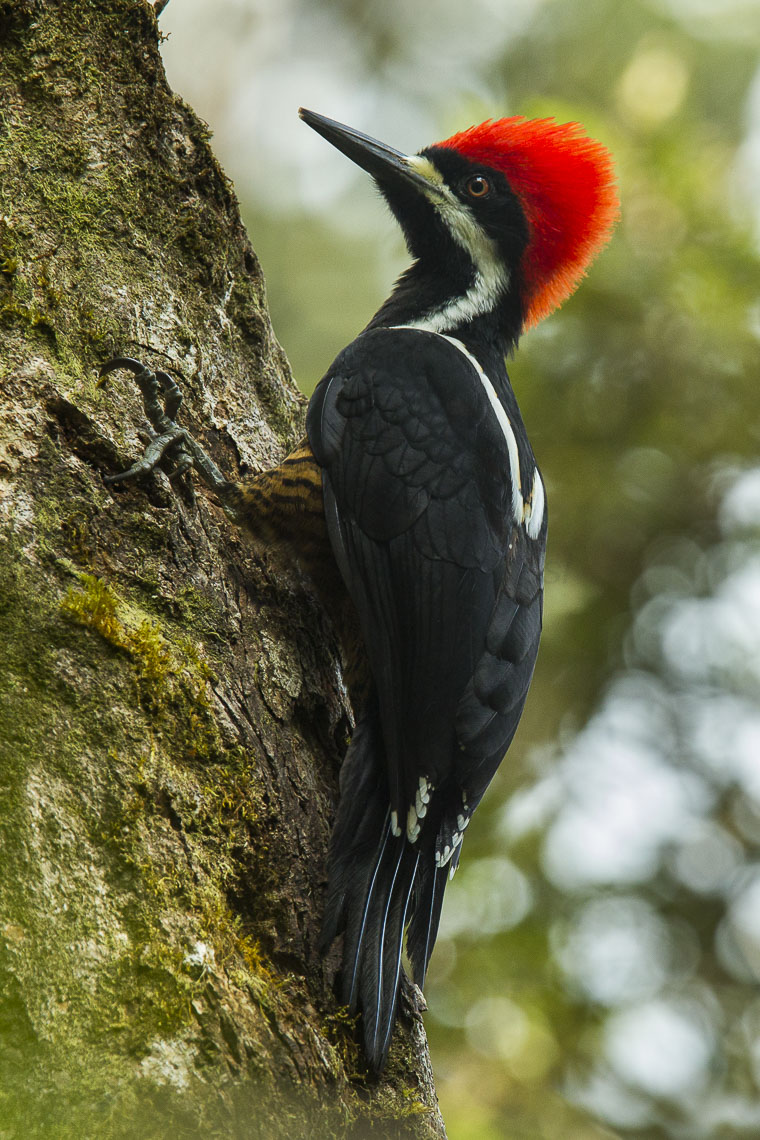
Wikipedia: Powerful woodpecker Source: OTHER
Powerful_Woodpecker_-_Ecuador_S4E2767.jpg
![]() The powerful woodpecker (Campephilus pollens) is a species of bird in the family Picidae. It is found in Colombia, Ecuador, Peru, and Venezuela. This little-known species is a large woodpecker, 33–38 cm (13–15 in) long, and is a close relative to the North American ivory-billed woodpecker.[2]
[more]
The powerful woodpecker (Campephilus pollens) is a species of bird in the family Picidae. It is found in Colombia, Ecuador, Peru, and Venezuela. This little-known species is a large woodpecker, 33–38 cm (13–15 in) long, and is a close relative to the North American ivory-billed woodpecker.[2]
[more]
Profile Wikipedia eBird Xeno-Canto
Wikipedia: Red-necked woodpecker Source: OTHER
Campephilus_rubricollis_-_Red-necked_Woodpecker.JPG
![]() The red-necked woodpecker (Campephilus rubricollis) is a species of bird in the family Picidae.
It is found in Bolivia, Brazil, Colombia, Ecuador, French Guiana, Guyana, Peru, Suriname, and Venezuela.
Its natural habitats are subtropical or tropical moist lowland forest and subtropical or tropical moist montane forest.
[more]
The red-necked woodpecker (Campephilus rubricollis) is a species of bird in the family Picidae.
It is found in Bolivia, Brazil, Colombia, Ecuador, French Guiana, Guyana, Peru, Suriname, and Venezuela.
Its natural habitats are subtropical or tropical moist lowland forest and subtropical or tropical moist montane forest.
[more]
Profile Wikipedia eBird Xeno-Canto

Wikipedia: Guayaquil woodpecker Source: OTHER
1200px-Guayaquil_woodpecker_%28Campephilus_gayaquilensis%29_%286995906660%29.jpg
![]() The Guayaquil woodpecker (Campephilus gayaquilensis) is a species of bird in the family Picidae.
It is found in southern Colombia, Ecuador and northern Peru.
Its natural habitats are subtropical or tropical dry forests and subtropical or tropical moist lowland forests.
It is threatened by habitat loss.
[more]
The Guayaquil woodpecker (Campephilus gayaquilensis) is a species of bird in the family Picidae.
It is found in southern Colombia, Ecuador and northern Peru.
Its natural habitats are subtropical or tropical dry forests and subtropical or tropical moist lowland forests.
It is threatened by habitat loss.
[more]
Profile Wikipedia eBird Xeno-Canto

Wikipedia: Cinnamon woodpecker Source: OTHER
1200px-Cinnamon_woodpecker_%28Celeus_loricatus_mentalis%29_female_making_hole_in_tree.jpg
![]() The cinnamon woodpecker (Celeus loricatus) is a species of bird in the family Picidae.
[more]
The cinnamon woodpecker (Celeus loricatus) is a species of bird in the family Picidae.
[more]
Profile Wikipedia eBird Xeno-Canto

Wikipedia: Scale-breasted woodpecker Source: OTHER
1200px-Celeus_grammicus_-_Scaly-breasted_woodpecker_%28female%29%2C_Manacapuru%2C_Amazonas%2C_Brazil.jpg
![]() The scaly-breasted woodpecker (Celeus grammicus), also known as the scale-breasted woodpecker,[2] is a bird species in the family Picidae. It is found in Bolivia, Brazil, Colombia, Ecuador, French Guiana, Peru, and Venezuela. Its natural habitat is subtropical or tropical moist lowland forests.[1]
[more]
The scaly-breasted woodpecker (Celeus grammicus), also known as the scale-breasted woodpecker,[2] is a bird species in the family Picidae. It is found in Bolivia, Brazil, Colombia, Ecuador, French Guiana, Peru, and Venezuela. Its natural habitat is subtropical or tropical moist lowland forests.[1]
[more]
Profile Wikipedia eBird Xeno-Canto

Wikipedia: Cream-colored woodpecker Source: OTHER
Celeus_flavus%2C_Cream-colored_Woodpecker.jpg
![]() The cream-colored woodpecker (Celeus flavus) is unmistakably recognizable by its pale but distinct yellow plumage and beak, long erect crest, dark brown wings and black tail. The male is differentiated by the female by its thick bright red malar stripe. The yellow plumage may darken to a browner or darker tone if soiled. The cream-colored woodpecker is 24–26 centimetres (9.4–10.2 in) in height and weighs 95–130 grams (3.4–4.6 oz).
[more]
The cream-colored woodpecker (Celeus flavus) is unmistakably recognizable by its pale but distinct yellow plumage and beak, long erect crest, dark brown wings and black tail. The male is differentiated by the female by its thick bright red malar stripe. The yellow plumage may darken to a browner or darker tone if soiled. The cream-colored woodpecker is 24–26 centimetres (9.4–10.2 in) in height and weighs 95–130 grams (3.4–4.6 oz).
[more]
Profile Wikipedia eBird Xeno-Canto

Wikipedia: Ringed woodpecker Source: OTHER
1200px-Celeus_torquatus_-_Ringed_woodpecker_%28male%29.jpg
![]() The ringed woodpecker (Celeus torquatus) is a species of bird in the family Picidae that contains the woodpeckers, piculets, and wrynecks. It is found in northern Brazil, French Guiana, Guyana, Suriname, and western Venezuela. Its natural habitats are subtropical or tropical moist lowland forests and subtropical or tropical swamps.[1]
[more]
The ringed woodpecker (Celeus torquatus) is a species of bird in the family Picidae that contains the woodpeckers, piculets, and wrynecks. It is found in northern Brazil, French Guiana, Guyana, Suriname, and western Venezuela. Its natural habitats are subtropical or tropical moist lowland forests and subtropical or tropical swamps.[1]
[more]
Profile Wikipedia eBird Xeno-Canto
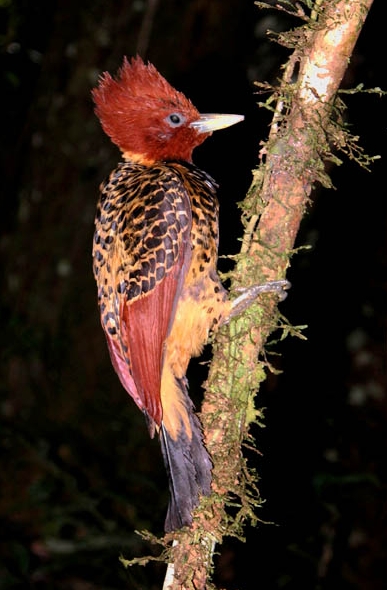
Wikipedia: Rufous-headed woodpecker Source: OTHER
Celeus_spectabilis.jpg
![]() The rufous-headed woodpecker (Celeus spectabilis) is a species of bird in the family Picidae. It formerly included Kaempfer's woodpecker as a subspecies.
[more]
The rufous-headed woodpecker (Celeus spectabilis) is a species of bird in the family Picidae. It formerly included Kaempfer's woodpecker as a subspecies.
[more]
Profile Wikipedia eBird Xeno-Canto

Wikipedia: Chestnut woodpecker Source: OTHER
1200px-Celeus_elegans_Chestnut_Woodpecker.jpg
![]() The chestnut woodpecker (Celeus elegans) is a resident breeding bird in South America from Colombia, Venezuela and the Guianas south to Ecuador, Bolivia and northern and western Brazil, and on Trinidad. It is found in a range of habitat types including rainforest, gallery forest, seasonally flooded forest, mangrove woodland, swamps, plantations and wooded savannah.[3] It is a generally uncommon bird, and threatened by habitat loss, but it has a very wide range, and the International Union for Conservation of Nature has assessed its conservation status as being of least concern.[1]
[more]
The chestnut woodpecker (Celeus elegans) is a resident breeding bird in South America from Colombia, Venezuela and the Guianas south to Ecuador, Bolivia and northern and western Brazil, and on Trinidad. It is found in a range of habitat types including rainforest, gallery forest, seasonally flooded forest, mangrove woodland, swamps, plantations and wooded savannah.[3] It is a generally uncommon bird, and threatened by habitat loss, but it has a very wide range, and the International Union for Conservation of Nature has assessed its conservation status as being of least concern.[1]
[more]
Profile Wikipedia eBird Xeno-Canto

Wikipedia: Southern emerald-toucanet Source: OTHER
1200px-Aulacorhynchus_albivitta_%2814458390459%29.jpg
![]() The white-throated toucanet (Aulacorhynchus albivitta) is a near-passerine bird found in the Andes from western Venezuela, through Colombia to northern Ecuador.
[more]
The white-throated toucanet (Aulacorhynchus albivitta) is a near-passerine bird found in the Andes from western Venezuela, through Colombia to northern Ecuador.
[more]
Wikipedia: Crimson-rumped toucanet Source: OTHER
CRTO_Matthew-Gable.JPG
![]() The crimson-rumped toucanet (Aulacorhynchus haematopygus) is a species of bird in the family Ramphastidae. It is found in humid Andean forests in Ecuador, Colombia and Venezuela. Its plumage is overall green (often faintly tinged blue), except for a maroon-red rump and tail-tip. The bill is black and maroon with a white band at the base. It is about 35 cm (14 in) long and weighs from 141–232 grams (5–8.2 oz.).
[more]
The crimson-rumped toucanet (Aulacorhynchus haematopygus) is a species of bird in the family Ramphastidae. It is found in humid Andean forests in Ecuador, Colombia and Venezuela. Its plumage is overall green (often faintly tinged blue), except for a maroon-red rump and tail-tip. The bill is black and maroon with a white band at the base. It is about 35 cm (14 in) long and weighs from 141–232 grams (5–8.2 oz.).
[more]
Profile Wikipedia eBird Xeno-Canto

Wikipedia: Chestnut-tipped toucanet Source: OTHER
1200px-Chestnut-tipped_Toucanet.JPG
![]() The chestnut-tipped toucanet (Aulacorhynchus derbianus) is a South American species of bird in the family Ramphastidae. It occurs in humid highland forests along the east Andean slope from southernmost Colombia to central Bolivia. It was formerly considered conspecific with Whitely's toucanet.
[more]
The chestnut-tipped toucanet (Aulacorhynchus derbianus) is a South American species of bird in the family Ramphastidae. It occurs in humid highland forests along the east Andean slope from southernmost Colombia to central Bolivia. It was formerly considered conspecific with Whitely's toucanet.
[more]

Wikipedia: Plate-billed mountain toucan Source: OTHER
1200px-Plate-billed_Mountain-toucan_%2847792081302%29.jpg
![]() The plate-billed mountain toucan (Andigena laminirostris) is a species of bird in the family Ramphastidae. It is native to the west slope of Ecuador and extreme southern Colombia, where it lives in the high-altitude humid mountain forests of the Andes. It is also known as the laminated hill-toucan, laminated mountain-toucan, and plain-billed mountain-toucan.
[more]
The plate-billed mountain toucan (Andigena laminirostris) is a species of bird in the family Ramphastidae. It is native to the west slope of Ecuador and extreme southern Colombia, where it lives in the high-altitude humid mountain forests of the Andes. It is also known as the laminated hill-toucan, laminated mountain-toucan, and plain-billed mountain-toucan.
[more]

Wikipedia: Black-billed mountain-toucan Source: OTHER
1200px-Black-billed-Mountain-Toucan.jpg
![]() The black-billed mountain toucan (Andigena nigrirostris) is a species of bird in the family Ramphastidae. It is found in humid highland forests in the Andes of western Venezuela, Colombia, Ecuador and far northern Peru. It is the only mountain-toucan with a white throat. Despite its name, only the nominate subspecies has an entirely black bill, while both A. n. occidentalis and A. n. spilorhyncha have bills that are coloured chestnut and black.
[more]
The black-billed mountain toucan (Andigena nigrirostris) is a species of bird in the family Ramphastidae. It is found in humid highland forests in the Andes of western Venezuela, Colombia, Ecuador and far northern Peru. It is the only mountain-toucan with a white throat. Despite its name, only the nominate subspecies has an entirely black bill, while both A. n. occidentalis and A. n. spilorhyncha have bills that are coloured chestnut and black.
[more]

Wikipedia: Grey-breasted mountain-toucan Source: OTHER
1200px-Gray-breasted_Mountain-Toucan_%28Andigena_hypoglauca%29.jpg
![]() The grey-breasted mountain toucan (Andigena hypoglauca) is a species of bird in the family Ramphastidae found in humid highland forest, often at the tops of the trees, in the Andes of southern Colombia, Ecuador and Peru. It remains locally fairly common, but has declined due to habitat loss.[2]
[more]
The grey-breasted mountain toucan (Andigena hypoglauca) is a species of bird in the family Ramphastidae found in humid highland forest, often at the tops of the trees, in the Andes of southern Colombia, Ecuador and Peru. It remains locally fairly common, but has declined due to habitat loss.[2]
[more]
Profile Wikipedia eBird Xeno-Canto

Wikipedia: Five-colored barbet Source: OTHER
1200px-Capito_quinticolor.jpg
![]() The five-colored barbet (Capito quinticolor) is a species of bird in the family Capitonidae, the New World barbets. It is found in Colombia and Ecuador.[2]
[more]
The five-colored barbet (Capito quinticolor) is a species of bird in the family Capitonidae, the New World barbets. It is found in Colombia and Ecuador.[2]
[more]
Profile Wikipedia eBird Xeno-Canto

Wikipedia: Orange-fronted barbet Source: OTHER
1200px-Capitosquamatus.JPG
![]() The orange-fronted barbet (Capito squamatus) is a species of bird in the family Capitonidae. It is found Ecuador and Colombia.[2]
[more]
The orange-fronted barbet (Capito squamatus) is a species of bird in the family Capitonidae. It is found Ecuador and Colombia.[2]
[more]
Profile Wikipedia eBird Xeno-Canto

Wikipedia: Scarlet-crowned barbet Source: OTHER
Capito_aurovirens.jpg
![]() The scarlet-crowned barbet (Capito aurovirens) is a species of bird in the family Capitonidae, the New World barbets. It is found in Amazonian Brazil, Colombia, Ecuador, and Peru.[2][3]
[more]
The scarlet-crowned barbet (Capito aurovirens) is a species of bird in the family Capitonidae, the New World barbets. It is found in Amazonian Brazil, Colombia, Ecuador, and Peru.[2][3]
[more]
Profile Wikipedia eBird Xeno-Canto

Wikipedia: Gilded barbet Source: OTHER
1200px-F_de_Castelnau-oiseauxPl8.jpg
![]() The gilded barbet (Capito auratus) is a species of bird in the family Capitonidae, the New World barbets, and are close relatives of the toucans.
[more]
The gilded barbet (Capito auratus) is a species of bird in the family Capitonidae, the New World barbets, and are close relatives of the toucans.
[more]
Profile Wikipedia eBird Xeno-Canto

Wikipedia: Red-headed barbet Source: OTHER
1200px-Male_Red-headed_Barbet_in_Ecuador_%2814619063547%29.jpg
![]() The red-headed barbet (Eubucco bourcierii) is a species of bird in the family Capitonidae. It is found in humid highland forest in Costa Rica and Panama, as well as the Andes in western Venezuela, Colombia, Ecuador and far northern Peru. The diet of the red-headed barbet may include bananas and various other fruits.[2]
[more]
The red-headed barbet (Eubucco bourcierii) is a species of bird in the family Capitonidae. It is found in humid highland forest in Costa Rica and Panama, as well as the Andes in western Venezuela, Colombia, Ecuador and far northern Peru. The diet of the red-headed barbet may include bananas and various other fruits.[2]
[more]
Profile Wikipedia eBird Xeno-Canto
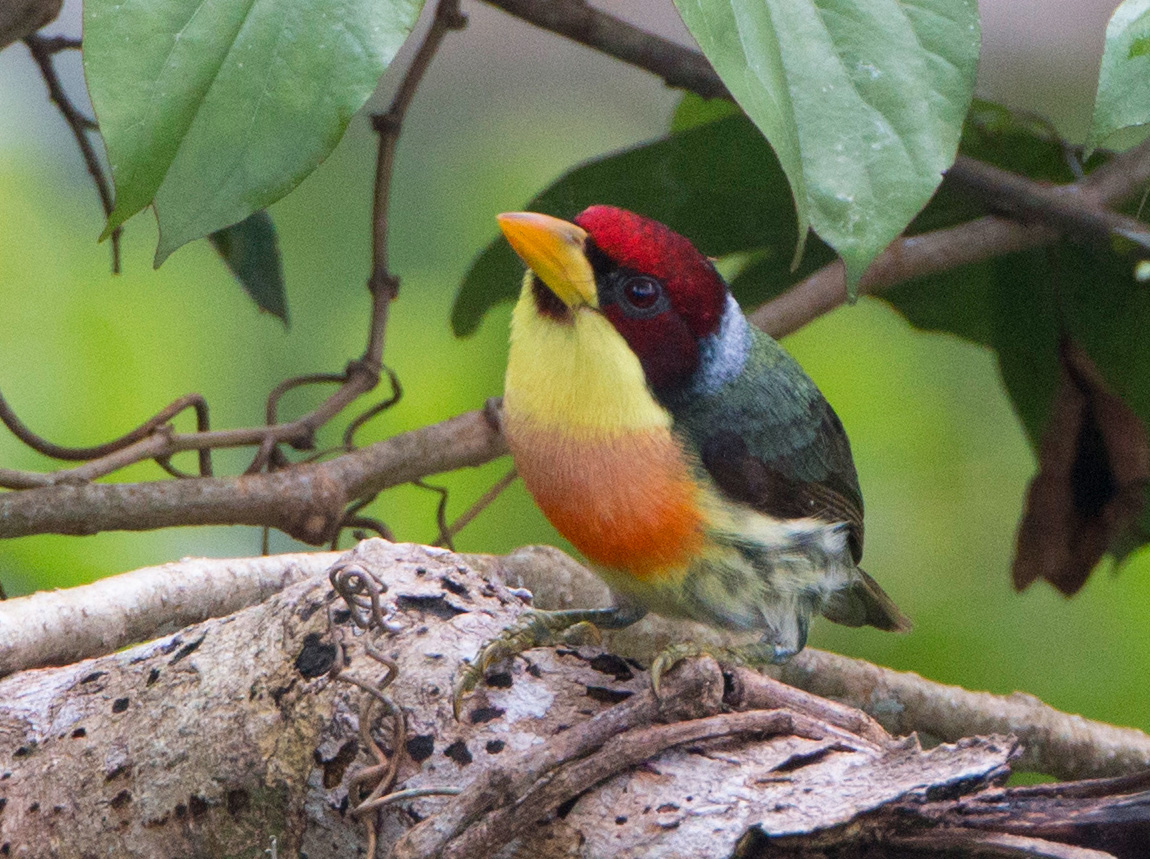
Wikipedia: Lemon-throated barbet Source: OTHER
Lemon-throated_Barbet_%28Eubucco_richardsoni%29.jpg
![]() The lemon-throated barbet (Eubucco richardsoni) is a species of bird in the New World barbet family Capitonidae. It is found in Bolivia, Brazil, Colombia, Ecuador, and Peru.[3]
[more]
The lemon-throated barbet (Eubucco richardsoni) is a species of bird in the New World barbet family Capitonidae. It is found in Bolivia, Brazil, Colombia, Ecuador, and Peru.[3]
[more]
Profile Wikipedia eBird Xeno-Canto
Tikal collared aracari. 2018-02-07 12.38.40 Guatemala
First observed in Guatemala on 2018-02-07.
![]() The collared aracari or collared araçari (Pteroglossus torquatus) is a toucan, a near-passerine bird. It breeds from southern Mexico(North America) to Panama; also Ecuador, Colombia, Venezuela and Costa Rica.
[more]
The collared aracari or collared araçari (Pteroglossus torquatus) is a toucan, a near-passerine bird. It breeds from southern Mexico(North America) to Panama; also Ecuador, Colombia, Venezuela and Costa Rica.
[more]
Profile Wikipedia eBird Xeno-Canto

Wikipedia: Chestnut-eared aracari Source: OTHER
1200px-Aracari_Castanho.jpg
![]() The chestnut-eared aracari, or chestnut-eared araçari (Pteroglossus castanotis), is a bird native to central and south-eastern South America. It belongs to the toucan and aracari family (Ramphastidae). The chestnut-eared aracari is a larger, more colorful bird than the black-necked aracari, which it otherwise resembles.
[more]
The chestnut-eared aracari, or chestnut-eared araçari (Pteroglossus castanotis), is a bird native to central and south-eastern South America. It belongs to the toucan and aracari family (Ramphastidae). The chestnut-eared aracari is a larger, more colorful bird than the black-necked aracari, which it otherwise resembles.
[more]
![]() Der Rotkropfarassari (Pteroglossus azara) ist eine Vogelart aus der Familie der Tukane. Die Art, die überwiegend in Wäldern der Tiefebene verbreitet ist, kommt ausschließlich in Südamerika vor. Die IUCN stuft den Rotkropfarassari als
Der Rotkropfarassari (Pteroglossus azara) ist eine Vogelart aus der Familie der Tukane. Die Art, die überwiegend in Wäldern der Tiefebene verbreitet ist, kommt ausschließlich in Südamerika vor. Die IUCN stuft den Rotkropfarassari als ![]() (=least concern – nicht gefährdet) ein.
[more]
(=least concern – nicht gefährdet) ein.
[more]
Profile Wikipedia eBird Xeno-Canto

Wikipedia: Lettered aracari Source: OTHER
1200px-Lettered_Ara%C3%A7ari.jpg
![]() The lettered aracari (Pteroglossus inscriptus), is a species of bird in the toucan family.
[more]
The lettered aracari (Pteroglossus inscriptus), is a species of bird in the toucan family.
[more]
Profile Wikipedia eBird Xeno-Canto

Wikipedia: Many-banded aracari Source: OTHER
1200px-Many-banded_Aracari%2C_Ecuador.jpg
![]() The many-banded aracari, or many-banded araçari (Pteroglossus pluricinctus), is a species of bird in the family Ramphastidae.[2][3]
[more]
The many-banded aracari, or many-banded araçari (Pteroglossus pluricinctus), is a species of bird in the family Ramphastidae.[2][3]
[more]
Profile Wikipedia eBird Xeno-Canto

Wikipedia: Yellow-throated toucan Source: OTHER
1200px-Black-mandibled_Toucan_2012.jpg
![]() The yellow-throated toucan (Ramphastos ambiguus) is a large toucan in the family Ramphastidae found in Central and northern South America.
[more]
The yellow-throated toucan (Ramphastos ambiguus) is a large toucan in the family Ramphastidae found in Central and northern South America.
[more]
Profile Wikipedia eBird Xeno-Canto

Wikipedia: Choco toucan Source: OTHER
1200px-Choco_toucan.jpg
![]() The Choco toucan (Ramphastos brevis) is a near-passerine bird in the family Ramphastidae found in humid lowland and foothill forests on the Pacific slope of Colombia and Ecuador. Within its range, extensive habitat destruction is taking place, but it remains fairly common locally.
[more]
The Choco toucan (Ramphastos brevis) is a near-passerine bird in the family Ramphastidae found in humid lowland and foothill forests on the Pacific slope of Colombia and Ecuador. Within its range, extensive habitat destruction is taking place, but it remains fairly common locally.
[more]
Profile Wikipedia eBird Xeno-Canto
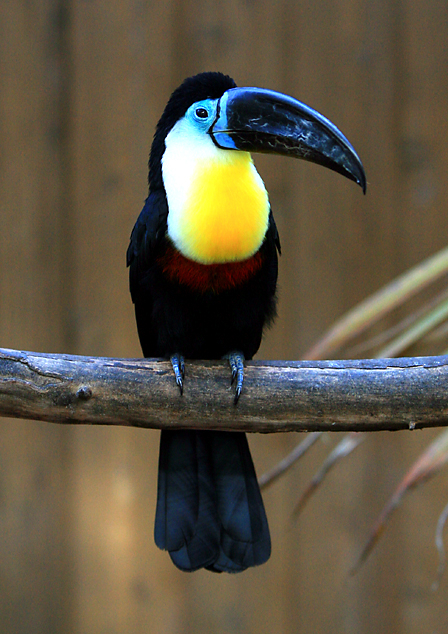
Wikipedia: Channel-billed toucan Source: OTHER
Ramphastos_vitellinus_-Matsue_Vogel_Park-8a-4c.jpg
![]() The channel-billed toucan (Ramphastos vitellinus) is a near-passerine bird in the family Ramphastidae found on the Caribbean island of Trinidad and in tropical South America as far south as southern Brazil and central Bolivia.
[more]
The channel-billed toucan (Ramphastos vitellinus) is a near-passerine bird in the family Ramphastidae found on the Caribbean island of Trinidad and in tropical South America as far south as southern Brazil and central Bolivia.
[more]

Wikipedia: Red-billed toucan Source: OTHER
1200px-Red-billed_toucan_31l07.JPG
![]() The white-throated toucan (Ramphastos tucanus) is a near-passerine bird in the family Ramphastidae found in South America throughout the Amazon Basin including the adjacent Tocantins and Araguaia River drainage. It prefers tropical humid forest, but also occurs in woodland and locally in riverine forest within cerrado.
This bird can be found in Bolivia in the Beni Departement, notably in the city of Riberalta and in the close by Aquicuana Reserve.
[more]
The white-throated toucan (Ramphastos tucanus) is a near-passerine bird in the family Ramphastidae found in South America throughout the Amazon Basin including the adjacent Tocantins and Araguaia River drainage. It prefers tropical humid forest, but also occurs in woodland and locally in riverine forest within cerrado.
This bird can be found in Bolivia in the Beni Departement, notably in the city of Riberalta and in the close by Aquicuana Reserve.
[more]
Profile Wikipedia eBird Xeno-Canto

Wikipedia: Yellow-eared toucanet Source: OTHER
1200px-Yellow-eared_Toucanet.jpg
![]() The yellow-eared toucanet (Selenidera spectabilis) is a species of bird in the family Ramphastidae found in humid forests of Central America and the Chocó. Cassin's aracari is an alternate name for the yellow-eared toucanet. A somewhat aberrant member of the genus Selenidera, it is relatively large (total length approximately 38 cm [15 in]) and the plumage of the sexes only differ in that the male has a yellow auricular streak, while the female has a brown crown. It weighs 175-245 grams (6.2-8.7 oz.)[2]
[more]
The yellow-eared toucanet (Selenidera spectabilis) is a species of bird in the family Ramphastidae found in humid forests of Central America and the Chocó. Cassin's aracari is an alternate name for the yellow-eared toucanet. A somewhat aberrant member of the genus Selenidera, it is relatively large (total length approximately 38 cm [15 in]) and the plumage of the sexes only differ in that the male has a yellow auricular streak, while the female has a brown crown. It weighs 175-245 grams (6.2-8.7 oz.)[2]
[more]
Profile Wikipedia eBird Xeno-Canto

Wikipedia: Golden-collared toucanet Source: OTHER
1200px-Selenidera_reinwardtii_langsdorfii_-_Golden-collared_toucanet_%28male%29%3B_Careiro%2C_Amazonas%2C_Brazil.jpg
![]() The golden-collared toucanet (Selenidera reinwardtii) is a species of bird in the family Ramphastidae. It is found in the western Amazon rainforest in South America.
[more]
The golden-collared toucanet (Selenidera reinwardtii) is a species of bird in the family Ramphastidae. It is found in the western Amazon rainforest in South America.
[more]
Profile Wikipedia eBird Xeno-Canto

Wikipedia: Toucan barbet Source: OTHER
1200px-Toucan_Barbet_%2823405007136%29.jpg
![]() The toucan barbet (Semnornis ramphastinus) is a barbet native to western Ecuador and Colombia. Along with the prong-billed barbet, it forms the family Semnornithidae, and is closely related to the toucans. It is a medium-sized barbet with a robust yellow bill. It has striking plumage, having a black head with grey throat and nape, red breast and upper belly, yellow lower belly and grey wings and tail.
[more]
The toucan barbet (Semnornis ramphastinus) is a barbet native to western Ecuador and Colombia. Along with the prong-billed barbet, it forms the family Semnornithidae, and is closely related to the toucans. It is a medium-sized barbet with a robust yellow bill. It has striking plumage, having a black head with grey throat and nape, red breast and upper belly, yellow lower belly and grey wings and tail.
[more]
La tarde 5 scarlet macaws in a tree. 2018-03-11 09.47.24 Costa Rica
First observed in Costa Rica on 2018-03-09.
![]() The scarlet macaw (Ara macao) is a large red, yellow, and blue Central and South American parrot, a member of a large group of Neotropical parrots called macaws. It is native to humid evergreen forests of tropical Central and South America. Its range extends from south-eastern Mexico to the Peruvian Amazon, Ecuador, Colombia, Bolivia, Venezuela and Brazil in lowlands of 500 m (1,600 ft) (at least formerly) up to 1,000 m (3,300 ft), as well as the Pacific island of Coiba. Formerly, it ranged north to southern Tamaulipas. In some areas, it has suffered local extinction because of habitat destruction, or capture for the parrot trade, but in other areas, it remains fairly common. It is the national bird of Honduras. Like its relative the blue-and-yellow macaw, scarlet macaws are popular birds in aviculture as a result of their striking plumage.
[more]
The scarlet macaw (Ara macao) is a large red, yellow, and blue Central and South American parrot, a member of a large group of Neotropical parrots called macaws. It is native to humid evergreen forests of tropical Central and South America. Its range extends from south-eastern Mexico to the Peruvian Amazon, Ecuador, Colombia, Bolivia, Venezuela and Brazil in lowlands of 500 m (1,600 ft) (at least formerly) up to 1,000 m (3,300 ft), as well as the Pacific island of Coiba. Formerly, it ranged north to southern Tamaulipas. In some areas, it has suffered local extinction because of habitat destruction, or capture for the parrot trade, but in other areas, it remains fairly common. It is the national bird of Honduras. Like its relative the blue-and-yellow macaw, scarlet macaws are popular birds in aviculture as a result of their striking plumage.
[more]
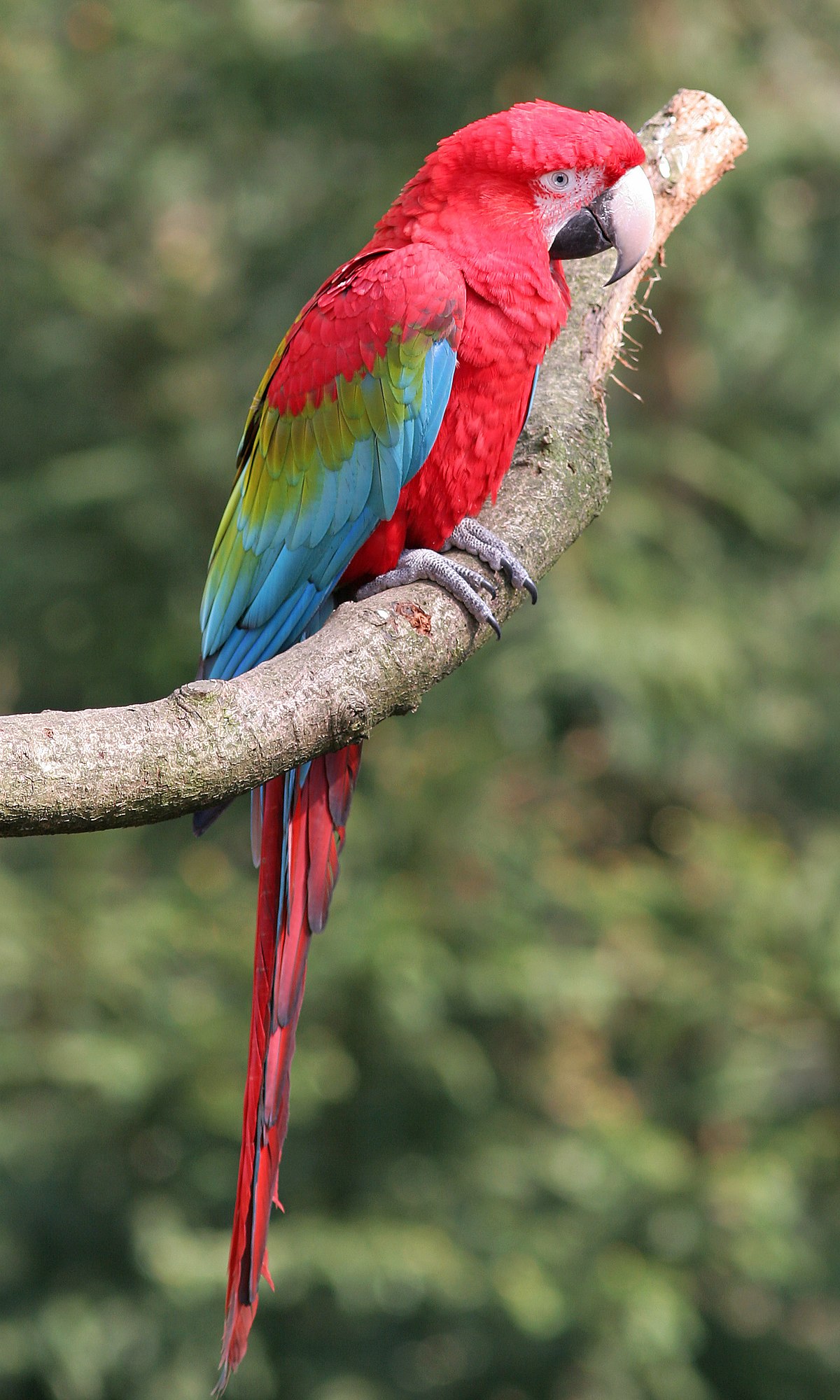
Wikipedia: Red-and-green macaw Source: OTHER
1200px-Ara_chloropterus_-Apenheul_Primate_Park_-Netherlands-8a.jpg
![]() The red-and-green macaw (Ara chloropterus), also known as the green-winged macaw,[2] is a large, mostly-red macaw of the genus Ara.
[more]
The red-and-green macaw (Ara chloropterus), also known as the green-winged macaw,[2] is a large, mostly-red macaw of the genus Ara.
[more]
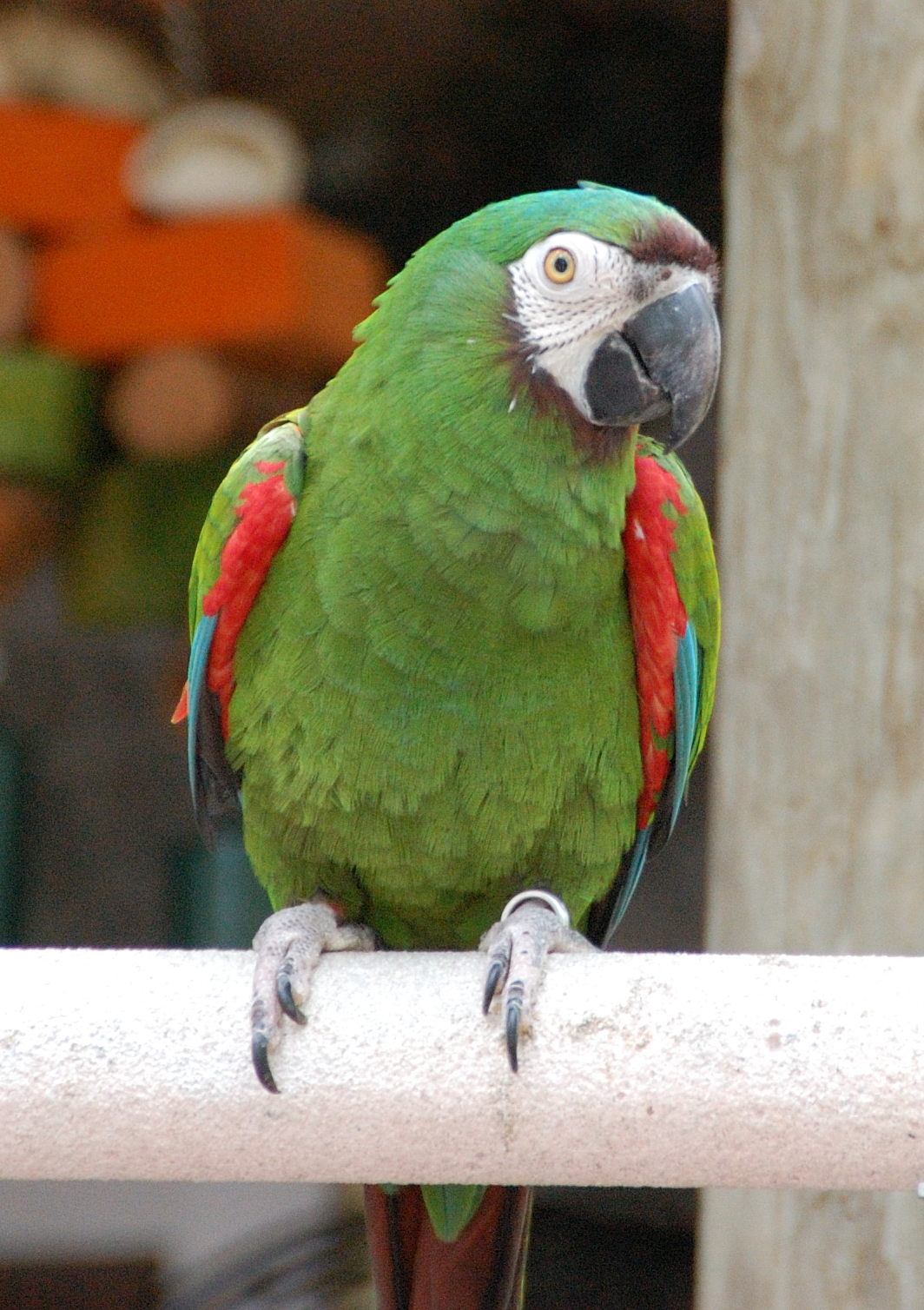
Wikipedia: Chestnut-fronted macaw Source: OTHER
Chestnut-fronted_Macaw_%28Ara_severa%29_-Southwicks_Zoo_c.jpg
![]() The chestnut-fronted macaw or severe macaw (Ara severus) is one of the largest of the mini-macaws. It reaches a size of around 45 cm (18 in) of which around half is the length of the tail.
[more]
The chestnut-fronted macaw or severe macaw (Ara severus) is one of the largest of the mini-macaws. It reaches a size of around 45 cm (18 in) of which around half is the length of the tail.
[more]

Wikipedia: Great green macaw Source: OTHER
1200px-Ara_ambigua.JPG
![]() The great green macaw (Ara ambiguus), also known as Buffon's macaw or the great military macaw, is a Central and South American parrot found in Nicaragua, Honduras, Costa Rica, Panama, Colombia and Ecuador.[2] Two allopatric subspecies are recognized; the nominate subspecies, Ara ambiguus ssp. ambiguus, occurs from Honduras to Colombia, while Ara ambiguus ssp. guayaquilensis appears to be endemic to remnants of dry forests on the southern Pacific coast of Ecuador.[3] The nominate subspecies lives in the canopy of wet tropical forests and in Costa Rica is usually associated with the almendro tree, Dipteryx oleifera.[4]
[more]
The great green macaw (Ara ambiguus), also known as Buffon's macaw or the great military macaw, is a Central and South American parrot found in Nicaragua, Honduras, Costa Rica, Panama, Colombia and Ecuador.[2] Two allopatric subspecies are recognized; the nominate subspecies, Ara ambiguus ssp. ambiguus, occurs from Honduras to Colombia, while Ara ambiguus ssp. guayaquilensis appears to be endemic to remnants of dry forests on the southern Pacific coast of Ecuador.[3] The nominate subspecies lives in the canopy of wet tropical forests and in Costa Rica is usually associated with the almendro tree, Dipteryx oleifera.[4]
[more]

Wikipedia: Blue-and-yellow macaw Source: OTHER
1200px-Ara_ararauna_Luc_Viatour.jpg
![]() The blue-and-yellow macaw (Ara ararauna), also known as the blue-and-gold macaw, is a large South American parrot with mostly blue top parts and light orange underparts, with gradient hues of green on top of its head. It is a member of the large group of neotropical parrots known as macaws. It inhabits forest (especially varzea, but also in open sections of terra firme or unflooded forest), woodland and savannah of tropical South America. They are popular in aviculture because of their striking color, ability to talk, ready availability in the marketplace, and close bonding to humans.
[more]
The blue-and-yellow macaw (Ara ararauna), also known as the blue-and-gold macaw, is a large South American parrot with mostly blue top parts and light orange underparts, with gradient hues of green on top of its head. It is a member of the large group of neotropical parrots known as macaws. It inhabits forest (especially varzea, but also in open sections of terra firme or unflooded forest), woodland and savannah of tropical South America. They are popular in aviculture because of their striking color, ability to talk, ready availability in the marketplace, and close bonding to humans.
[more]

Wikipedia: Military macaw Source: OTHER
1200px-Ara_militaris_-London_Zoo-8a.jpg
![]() Psittacus militaris Linnaeus, 1766
[more]
Psittacus militaris Linnaeus, 1766
[more]
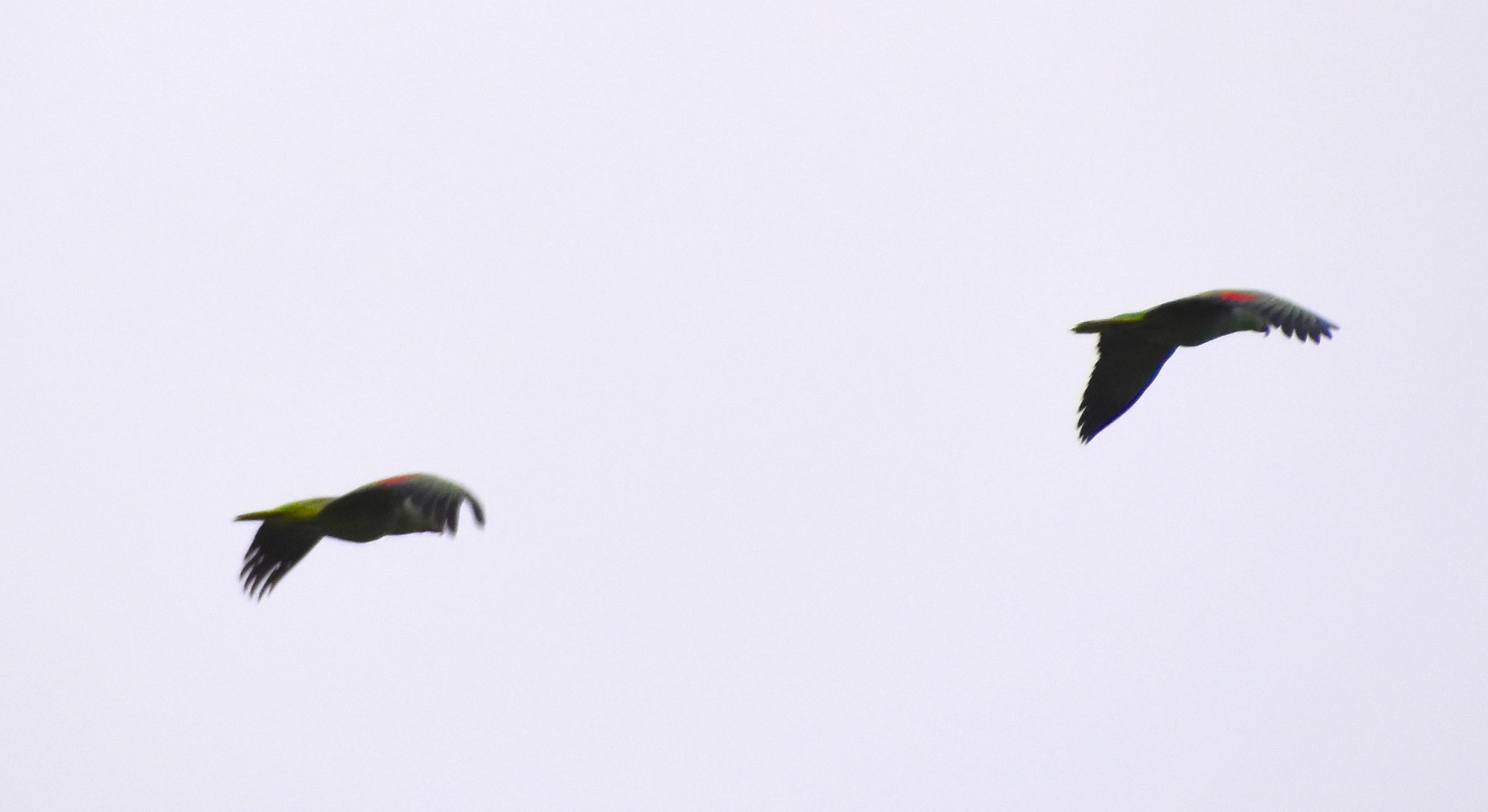
Probably red-lored amazons flying gamboa. 2020-02-19 17.41.24 Panama
First observed in Panama on 2020-02-19.
It's hard to overlook this parrot because of the incredible racket they make! In Manzanilla, Costa Rica, small groups of them (more properly called pandemoniums) flew past our house every morning and evening.
General: ![]() The red-lored amazon or red-lored parrot (Amazona autumnalis) is a species of amazon parrot, native to tropical regions of the Americas, from eastern Mexico south to Ecuador where it occurs in humid evergreen to semi-deciduous forests up to 1,100 m altitude. It is absent from the Pacific side of Central America north of Costa Rica. Not originally known from El Salvador, a pair - perhaps escaped from captivity - nested successfully in 1995 and 1996 in the outskirts of San Salvador[2] and the species might expand its range permanently into that country in the future.[3] This species has also established feral populations in several California cities.[4]
[more]
The red-lored amazon or red-lored parrot (Amazona autumnalis) is a species of amazon parrot, native to tropical regions of the Americas, from eastern Mexico south to Ecuador where it occurs in humid evergreen to semi-deciduous forests up to 1,100 m altitude. It is absent from the Pacific side of Central America north of Costa Rica. Not originally known from El Salvador, a pair - perhaps escaped from captivity - nested successfully in 1995 and 1996 in the outskirts of San Salvador[2] and the species might expand its range permanently into that country in the future.[3] This species has also established feral populations in several California cities.[4]
[more]

Wikipedia: Orange-winged parrot Source: OTHER
Amazona_amazonica_%281%29.jpg
![]() The orange-winged amazon (Amazona amazonica), also known locally as orange-winged parrot and loro guaro, is a large amazon parrot. It is a resident breeding bird in tropical South America, from Colombia, Trinidad and Tobago south to Peru, Bolivia and central Brazil. Its habitat is forest and semi-open country. Although common, it is persecuted as an agricultural pest and by capture for the pet trade (over 66,000 captured from 1981 to 1985). It is also hunted as a food source. Introduced breeding populations have been reported in Puerto Rico[2] and Tenerife in the Canary Islands.[3]
[more]
The orange-winged amazon (Amazona amazonica), also known locally as orange-winged parrot and loro guaro, is a large amazon parrot. It is a resident breeding bird in tropical South America, from Colombia, Trinidad and Tobago south to Peru, Bolivia and central Brazil. Its habitat is forest and semi-open country. Although common, it is persecuted as an agricultural pest and by capture for the pet trade (over 66,000 captured from 1981 to 1985). It is also hunted as a food source. Introduced breeding populations have been reported in Puerto Rico[2] and Tenerife in the Canary Islands.[3]
[more]
Possibly mealy parrots in Manzanillo, Costa Rica. 2020-03-12 17.25.08 Costa Rica
First observed in Costa Rica on 2020-03-12.
![]() Die Mülleramazone (Amazona farinosa), auch Müller-Amazone geschrieben, ist eine Papageienart aus der Unterfamilie der Neuweltpapageien. Die Grundfärbung des Gefieders dieser 38 Zentimeter groß werdenden Amazonenart ist grün, wobei die Körperoberseite leicht bläulich überhaucht ist. Einzelne Individuen weisen einen deutlich ausgeprägten gelben Scheitelfleck auf. Bei anderen ist dieser Scheitelfleck auf wenige Federn begrenzt. Kopfoberseite, der Nacken sowie die Federn am Hals sind breit graublau gesäumt und weisen violettschwarze Säume auf. Die Vögel weisen keinen Geschlechtsdimorphismus auf. Sie wiegen zwischen 535 und 766 Gramm.[1]
[more]
Die Mülleramazone (Amazona farinosa), auch Müller-Amazone geschrieben, ist eine Papageienart aus der Unterfamilie der Neuweltpapageien. Die Grundfärbung des Gefieders dieser 38 Zentimeter groß werdenden Amazonenart ist grün, wobei die Körperoberseite leicht bläulich überhaucht ist. Einzelne Individuen weisen einen deutlich ausgeprägten gelben Scheitelfleck auf. Bei anderen ist dieser Scheitelfleck auf wenige Federn begrenzt. Kopfoberseite, der Nacken sowie die Federn am Hals sind breit graublau gesäumt und weisen violettschwarze Säume auf. Die Vögel weisen keinen Geschlechtsdimorphismus auf. Sie wiegen zwischen 535 und 766 Gramm.[1]
[more]

Wikipedia: Yellow-crowned parrot Source: OTHER
Yellow-crowned_Amazon_%28Amazona_ochrocephala%29_-Well_Place_Zoo-4c.jpg
![]() The yellow-crowned amazon or yellow-crowned parrot (Amazona ochrocephala) is a species of parrot native to tropical South America, Panama and Trinidad and Tobago. The taxonomy is highly complex and the yellow-headed (A. oratrix) and yellow-naped amazon (A. auropalliata) are sometimes considered subspecies of the yellow-crowned amazon. Except in the taxonomic section, the following deals only with the nominate group (including subspecies xantholaema, nattereri and panamensis).They are found in the Amazon basin.
[more]
The yellow-crowned amazon or yellow-crowned parrot (Amazona ochrocephala) is a species of parrot native to tropical South America, Panama and Trinidad and Tobago. The taxonomy is highly complex and the yellow-headed (A. oratrix) and yellow-naped amazon (A. auropalliata) are sometimes considered subspecies of the yellow-crowned amazon. Except in the taxonomic section, the following deals only with the nominate group (including subspecies xantholaema, nattereri and panamensis).They are found in the Amazon basin.
[more]
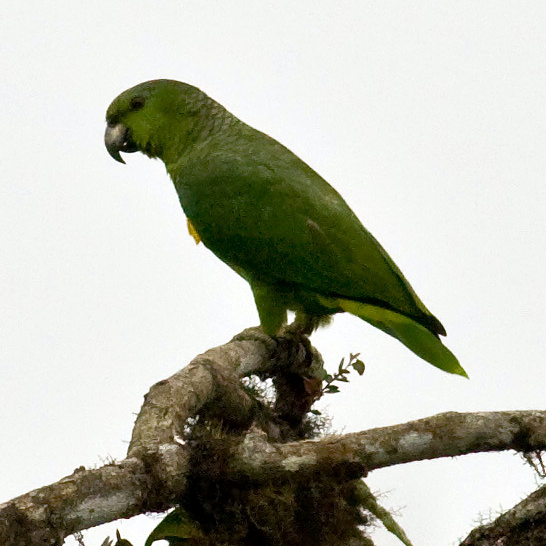
Wikipedia: Scaly-naped parrot Source: OTHER
Amazona_mercenaria_-Ecuador_-Andes-8-4c.jpg
![]() The scaly-naped amazon (Amazona mercenarius), also known as the scaly-naped parrot, mercenary amazon, Tschudi's amazon, mountain parrot, or gray-naped amazon is a species of parrot in the family Psittacidae.
It is found along the Andes in the northern part of South America.
Its natural habitats are subtropical or tropical moist lowland forest and subtropical or tropical moist montane forest.
[more]
The scaly-naped amazon (Amazona mercenarius), also known as the scaly-naped parrot, mercenary amazon, Tschudi's amazon, mountain parrot, or gray-naped amazon is a species of parrot in the family Psittacidae.
It is found along the Andes in the northern part of South America.
Its natural habitats are subtropical or tropical moist lowland forest and subtropical or tropical moist montane forest.
[more]

Wikipedia: Festive parrot Source: OTHER
Amazona_festiva_bodini_-Tulsa_Zoo-8a.jpg
![]() The festive amazon (Amazona festiva), also known as the festive parrot, is a species of parrot in the family Psittacidae. It is found in Brazil, Colombia, Ecuador, Bolivia, Guyana, Peru, and Venezuela. It is associated with forest (especially Várzea) and woodland growing near major rivers. Locally it is also found in coastal mangroves (primarily in Amapá). There are two subspecies; A. f. festiva and A. f. bodini.
[more]
The festive amazon (Amazona festiva), also known as the festive parrot, is a species of parrot in the family Psittacidae. It is found in Brazil, Colombia, Ecuador, Bolivia, Guyana, Peru, and Venezuela. It is associated with forest (especially Várzea) and woodland growing near major rivers. Locally it is also found in coastal mangroves (primarily in Amapá). There are two subspecies; A. f. festiva and A. f. bodini.
[more]

Wikipedia: Dusky-headed parakeet Source: OTHER
1200px-Aratinga_weddellii_-Beale_Park%2C_Reading%2C_Berkshire%2C_England-8a-4c.jpg
![]() The dusky-headed parakeet (Aratinga weddellii), also known as Weddell's conure or dusky-headed conure in aviculture, is a small green Neotropical parrot with dusty grey head found in wooded habitats in the western Amazon basin of South America. Its range extends from southeastern Colombia south through eastern Ecuador, eastern Peru and southwest Amazonian Brazil, to central Bolivia. It prefers semiopen habitats such as várzea, forest edge, and forest remnants, but can also be found in coffee plantations. It is generally common and its habitat preference makes it less vulnerable than many other Amazonian species. Consequently, it is considered to be of least concern by BirdLife International and IUCN.
[more]
The dusky-headed parakeet (Aratinga weddellii), also known as Weddell's conure or dusky-headed conure in aviculture, is a small green Neotropical parrot with dusty grey head found in wooded habitats in the western Amazon basin of South America. Its range extends from southeastern Colombia south through eastern Ecuador, eastern Peru and southwest Amazonian Brazil, to central Bolivia. It prefers semiopen habitats such as várzea, forest edge, and forest remnants, but can also be found in coffee plantations. It is generally common and its habitat preference makes it less vulnerable than many other Amazonian species. Consequently, it is considered to be of least concern by BirdLife International and IUCN.
[more]
Profile Wikipedia eBird Xeno-Canto
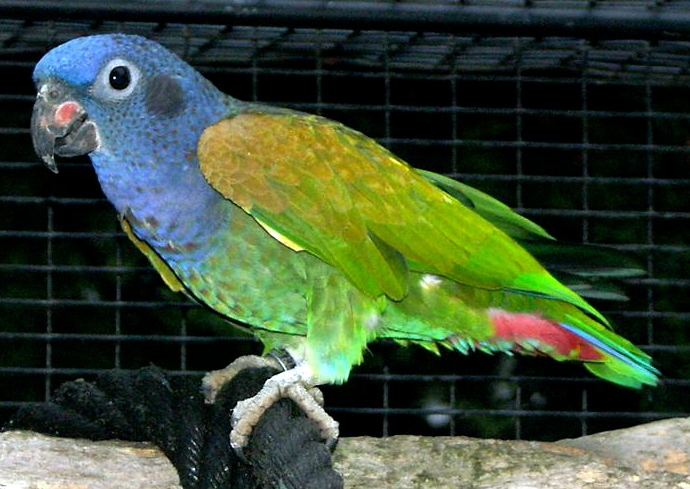
Wikipedia: Blue-headed parrot Source: OTHER
Pionus_menstruus_-in_captivity.jpg
![]() The blue-headed parrot, also known as the blue-headed pionus (Pionus menstruus) is a medium-sized parrot of about 27 cm in length. The body is mostly green, with a blue head and neck, and red undertail coverts.[2] It is a resident in tropical and subtropical South America and southern Central America, from Costa Rica, Venezuela and Trinidad south to Bolivia and Brazil.
[more]
The blue-headed parrot, also known as the blue-headed pionus (Pionus menstruus) is a medium-sized parrot of about 27 cm in length. The body is mostly green, with a blue head and neck, and red undertail coverts.[2] It is a resident in tropical and subtropical South America and southern Central America, from Costa Rica, Venezuela and Trinidad south to Bolivia and Brazil.
[more]
Profile Wikipedia eBird Xeno-Canto

Wikipedia: Speckle-faced parrot Source: OTHER
Pionus_tumultuosus_69270129_%28cropped%29.jpg
![]() The speckle-faced parrot (Pionus tumultuosus) is a South American species of parrot from the humid Andean forests from Colombia, through Ecuador and Peru, to Bolivia. It is sometimes split into two species, in which case the southern Pionus tumultuosus retains the common name speckle-faced parrot or is renamed plum-crowned parrot or plum-crowned pionus, while the northern Pionus seniloides is referred to as the white-capped parrot or white-headed pionus (leading to easy confusion with Pionus senilis). The two were originally described as separate species, are morphologically distinctive, and there is no evidence of intergradation, but this in itself is not remarkable, as their distributions are separated by a gap of approx. 150 km.[2][3]
[more]
The speckle-faced parrot (Pionus tumultuosus) is a South American species of parrot from the humid Andean forests from Colombia, through Ecuador and Peru, to Bolivia. It is sometimes split into two species, in which case the southern Pionus tumultuosus retains the common name speckle-faced parrot or is renamed plum-crowned parrot or plum-crowned pionus, while the northern Pionus seniloides is referred to as the white-capped parrot or white-headed pionus (leading to easy confusion with Pionus senilis). The two were originally described as separate species, are morphologically distinctive, and there is no evidence of intergradation, but this in itself is not remarkable, as their distributions are separated by a gap of approx. 150 km.[2][3]
[more]

Wikipedia: Bronze-winged parrot Source: OTHER
1200px-Bronze-winged_Parrot_%28Pionus_chalcopterus%29.jpg
![]() The bronze-winged parrot (Pionus chalcopterus) is a medium-sized pionus parrot 28 cm (11 in) long. It is a short-tailed stocky parrot found in forest and woodland in north-western South America.
[more]
The bronze-winged parrot (Pionus chalcopterus) is a medium-sized pionus parrot 28 cm (11 in) long. It is a short-tailed stocky parrot found in forest and woodland in north-western South America.
[more]
Profile Wikipedia eBird Xeno-Canto

Wikipedia: Red-billed parrot Source: OTHER
1200px-Red-billed_Parrot.jpg
![]() The red-billed parrot (Pionus sordidus) also known as coral-billed pionus or red-billed pionus is a species of parrot in the family Psittacidae. It is found in humid subtropical forests in the Venezuelan Coastal Range, Sierra Nevada de Santa Marta, and in the Andes from Colombia in north to Bolivia in south (though with significant gaps). Uniquely for a member of the genus Pionus, its bill is almost entirely bright red. The plumage is greenish with a dull blue chest and red undertail coverts.
[more]
The red-billed parrot (Pionus sordidus) also known as coral-billed pionus or red-billed pionus is a species of parrot in the family Psittacidae. It is found in humid subtropical forests in the Venezuelan Coastal Range, Sierra Nevada de Santa Marta, and in the Andes from Colombia in north to Bolivia in south (though with significant gaps). Uniquely for a member of the genus Pionus, its bill is almost entirely bright red. The plumage is greenish with a dull blue chest and red undertail coverts.
[more]

Wikipedia: Red-fan parrot Source: OTHER
Deroptyus_accipitrinus_or_Red-fan_Parrot_on_ground.jpg
![]() The red-fan parrot (Deroptyus accipitrinus), also known as the hawk-headed parrot, is an unusual[according to whom?] New World parrot hailing from the Amazon Rainforest. It is the only member of the genus Deroptyus.
[more]
The red-fan parrot (Deroptyus accipitrinus), also known as the hawk-headed parrot, is an unusual[according to whom?] New World parrot hailing from the Amazon Rainforest. It is the only member of the genus Deroptyus.
[more]
Profile Wikipedia eBird Xeno-Canto

Wikipedia: Maroon-tailed parakeet Source: OTHER
1200px-Maroon-tailed_Parakeet.jpg
![]() The maroon-tailed parakeet (Pyrrhura melanura) is a species of parrot in the family Psittacidae. It is found in Brazil, Colombia, Ecuador, Peru, and Venezuela.
[more]
The maroon-tailed parakeet (Pyrrhura melanura) is a species of parrot in the family Psittacidae. It is found in Brazil, Colombia, Ecuador, Peru, and Venezuela.
[more]

Wikipedia: Red-crowned parakeet Source: OTHER
Kakariki.jpg
![]() The red-crowned parakeet (Cyanoramphus novaezelandiae), also known as red-fronted parakeet and by its Māori name of kākāriki,[2] is a small parrot from New Zealand. It is characterised by its bright green plumage and the red pattern on its head. This versatile bird can feed on a variety food items and can be found in many habitat types. It used to be classified as near threatened as invasive predators had pushed it out of its historical range but it is now at least concern. This species used to occupy the entire island, but is now confined to only a few areas on the mainland and some offshore islands.
[more]
The red-crowned parakeet (Cyanoramphus novaezelandiae), also known as red-fronted parakeet and by its Māori name of kākāriki,[2] is a small parrot from New Zealand. It is characterised by its bright green plumage and the red pattern on its head. This versatile bird can feed on a variety food items and can be found in many habitat types. It used to be classified as near threatened as invasive predators had pushed it out of its historical range but it is now at least concern. This species used to occupy the entire island, but is now confined to only a few areas on the mainland and some offshore islands.
[more]
Profile Wikipedia eBird Xeno-Canto

Wikipedia: White-necked parakeet Source: OTHER
White-breasted_Parakeets_%28Pyrrhua_albipectus%29.jpg
![]() The white-breasted parakeet (Pyrrhura albipectus) or white-necked parakeet is a species of parrot in the family Psittacidae. It is found in southern Ecuador and adjacent northern Peru.
[more]
The white-breasted parakeet (Pyrrhura albipectus) or white-necked parakeet is a species of parrot in the family Psittacidae. It is found in southern Ecuador and adjacent northern Peru.
[more]
Profile Wikipedia eBird Xeno-Canto

Wikipedia: El Oro parakeet Source: OTHER
1200px-El_Oro_Parakeet.jpg
![]() The El Oro parakeet, conure D'Orcès, cotorra de El Oro, or perico de El Oro (Pyrrhura orcesi) is a species of parrot in the family Psittacidae, endemic to Ecuador. It is a relatively newly identified species, having been discovered in 1980. Little is currently known about it.
[more]
The El Oro parakeet, conure D'Orcès, cotorra de El Oro, or perico de El Oro (Pyrrhura orcesi) is a species of parrot in the family Psittacidae, endemic to Ecuador. It is a relatively newly identified species, having been discovered in 1980. Little is currently known about it.
[more]

Wikipedia: Riparian parrotlet Source: OTHER
Blue-winged_Parrotlet_-_REGUA_-_Brazil_S4E2247_%2812931340974%29.jpg
![]() The large-billed parrotlet (Forpus crassirostris) is a species of parrot in the family Psittacidae.
[more]
The large-billed parrotlet (Forpus crassirostris) is a species of parrot in the family Psittacidae.
[more]
Profile Wikipedia eBird Xeno-Canto

Wikipedia: Pacific parrotlet Source: OTHER
1200px-Forpus_coelestis_-two_in_Ecuador-8.jpg
![]() The Pacific parrotlet (Forpus coelestis), also known as Lesson's parrotlet or the celestial parrotlet, is a species of small parrot in the family Psittacidae.
[more]
The Pacific parrotlet (Forpus coelestis), also known as Lesson's parrotlet or the celestial parrotlet, is a species of small parrot in the family Psittacidae.
[more]
Profile Wikipedia eBird Xeno-Canto
Wikipedia: Dusky-billed parrotlet Source: OTHER
Forpus_sclateri_-_Dusky-billed_Parrotlet_01.JPG
![]() The dusky-billed parrotlet (Forpus modestus), also known as Sclater's parrotlet, is a small species of parrot in the family Psittacidae. It is the nominate species (F. m. modestus).
[more]
The dusky-billed parrotlet (Forpus modestus), also known as Sclater's parrotlet, is a small species of parrot in the family Psittacidae. It is the nominate species (F. m. modestus).
[more]

Wikipedia: Grey-cheeked parakeet Source: OTHER
1200px-Brotogeris_pyrrhoptera_-Guayas_-Ecuador-8.jpg
Ecuador
![]() The grey-cheeked parakeet (Brotogeris pyrrhoptera), less commonly known as fire-winged parakeet, is a species of parrot in the family Psittacidae.
[more]
The grey-cheeked parakeet (Brotogeris pyrrhoptera), less commonly known as fire-winged parakeet, is a species of parrot in the family Psittacidae.
[more]
![]() Der Blauflügelsittich (Brotogeris cyanoptera) ist eine Art der Neuweltpapageien. Er kommt ausschließlich in Südamerika vor. Die Art wird von der IUCN als ungefährdet eingestuft. Im Gegensatz zu den meisten Schmalschnabelsittichen gehört der Blauflügelsittich zu den Arten, die erst sehr spät für die Ziervogelhaltung nach Europa und Nordamerika exportiert wurden. Vermutlich gelangten die ersten Individuen erst 1969 nach Europa.[1]
[more]
Der Blauflügelsittich (Brotogeris cyanoptera) ist eine Art der Neuweltpapageien. Er kommt ausschließlich in Südamerika vor. Die Art wird von der IUCN als ungefährdet eingestuft. Im Gegensatz zu den meisten Schmalschnabelsittichen gehört der Blauflügelsittich zu den Arten, die erst sehr spät für die Ziervogelhaltung nach Europa und Nordamerika exportiert wurden. Vermutlich gelangten die ersten Individuen erst 1969 nach Europa.[1]
[more]
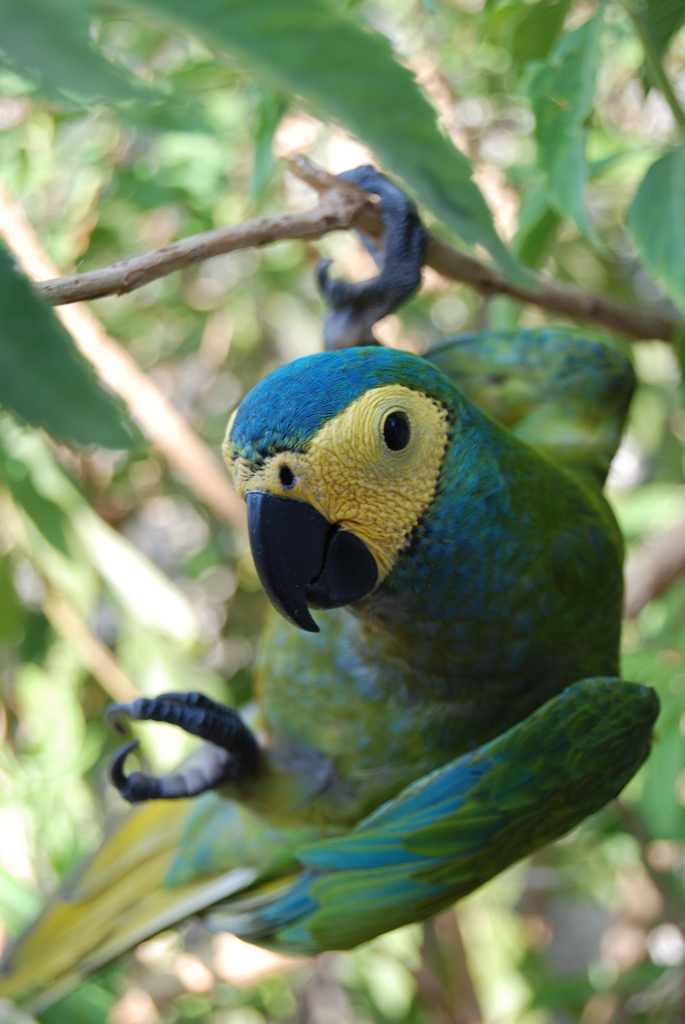
Wikipedia: Red-bellied macaw Source: OTHER
Orthopsittaca_manilata_-Brazil-6.jpg
![]() The red-bellied macaw (Orthopsittaca manilatus), also known as Guacamaya Manilata, is a medium-sized, mostly green South American parrot, a member of a group of large Neotropical parrots known as macaws. It is the largest of what are commonly called "mini-macaws". The belly has a large maroon patch which gives the species its name.
[more]
The red-bellied macaw (Orthopsittaca manilatus), also known as Guacamaya Manilata, is a medium-sized, mostly green South American parrot, a member of a group of large Neotropical parrots known as macaws. It is the largest of what are commonly called "mini-macaws". The belly has a large maroon patch which gives the species its name.
[more]

Wikipedia: Barred parakeet Source: OTHER
Bolborhynchus_lineola_-captive-8a.jpg
![]() The barred parakeet (Bolborhynchus lineola), also known as lineolated parakeet, Catherine parakeet or 'linnies' for short, is a small parrot found disjunctly in highland forests from southern Mexico to Panama, in the Andes from western Venezuela to southern Peru and Bolivia, the Santa Marta Mountains in Colombia and the Venezuelan Coastal Range. Its plumage is mostly green with multiple black and dark green stripes or bars, and it has a pale-horn coloured beak. The dark stripes vary in prominence between its two subspecies. Several colour mutants are available in aviculture.
[more]
The barred parakeet (Bolborhynchus lineola), also known as lineolated parakeet, Catherine parakeet or 'linnies' for short, is a small parrot found disjunctly in highland forests from southern Mexico to Panama, in the Andes from western Venezuela to southern Peru and Bolivia, the Santa Marta Mountains in Colombia and the Venezuelan Coastal Range. Its plumage is mostly green with multiple black and dark green stripes or bars, and it has a pale-horn coloured beak. The dark stripes vary in prominence between its two subspecies. Several colour mutants are available in aviculture.
[more]
Profile Wikipedia eBird Xeno-Canto

Wikipedia: Short-tailed parrot Source: OTHER
1200px-Peruvian_Indians_with_Short-tailed_Parrot-6-4cp.jpg
![]() The short-tailed parrot (Graydidascalus brachyurus) is the only species of the genus Graydidascalus. It is found along both banks of the Amazon river and other major Amazonian rivers in Brazil, Colombia, Bolivia, Ecuador and Peru. As suggested by its range, it is associated with the specific forest and woodland types growing near major rivers, although it also extends into the coastal deltas of French Guiana and Amapá, Brazil.
[more]
The short-tailed parrot (Graydidascalus brachyurus) is the only species of the genus Graydidascalus. It is found along both banks of the Amazon river and other major Amazonian rivers in Brazil, Colombia, Bolivia, Ecuador and Peru. As suggested by its range, it is associated with the specific forest and woodland types growing near major rivers, although it also extends into the coastal deltas of French Guiana and Amapá, Brazil.
[more]

Wikipedia: Red-faced parrot Source: OTHER
1200px-Hapalopsittaca_pyrrhops_Catalogue_of_the_Birds_in_the_British_Museum_%281891_-_1891%29_%2819957525723%29.jpg
![]() The red-faced parrot (Hapalopsittaca pyrrhops) is a species of parrot in the family Psittacidae.
It is found in Ecuador and Peru.
[more]
The red-faced parrot (Hapalopsittaca pyrrhops) is a species of parrot in the family Psittacidae.
It is found in Ecuador and Peru.
[more]

Wikipedia: Black-headed parrot Source: OTHER
1200px-Pionites_melanocephalus_-Jurong_Bird_Park-8a.jpg
![]() The black-headed parrot (Pionites melanocephalus ; sometimes incorrectly Pionites melanocephala), also known as the black-headed caique, black-capped parrot or pallid parrot (for P. m. pallidus), is one of the four species in the genus Pionites of the family Psittacidae; the other species being Pionites leucogaster (green-thighed parrot), Pionites xanthomerius (black-legged parrot), and Pionites xanthurus (yellow-tailed parrot).[2]
[more]
The black-headed parrot (Pionites melanocephalus ; sometimes incorrectly Pionites melanocephala), also known as the black-headed caique, black-capped parrot or pallid parrot (for P. m. pallidus), is one of the four species in the genus Pionites of the family Psittacidae; the other species being Pionites leucogaster (green-thighed parrot), Pionites xanthomerius (black-legged parrot), and Pionites xanthurus (yellow-tailed parrot).[2]
[more]

Wikipedia: Blue-fronted parrotlet Source: OTHER
1200px-UrochromaDilectissimaSmit.jpg
![]() The blue-fronted parrotlet (Touit dilectissimus) is also known as the red-winged parrotlet (but see below). It is a parrot in N. South America from E. Panama down the west coastal Andes to Peru, with a second population around and south of Lake Maracaibo. It is 15 cm, green with a short tail, blue forehead with narrow band of red under eye, red shoulders and leading edge of underwing, and the remaining underwing coverts yellow. Edges of tail also yellowish.
[more]
The blue-fronted parrotlet (Touit dilectissimus) is also known as the red-winged parrotlet (but see below). It is a parrot in N. South America from E. Panama down the west coastal Andes to Peru, with a second population around and south of Lake Maracaibo. It is 15 cm, green with a short tail, blue forehead with narrow band of red under eye, red shoulders and leading edge of underwing, and the remaining underwing coverts yellow. Edges of tail also yellowish.
[more]

Wikipedia: Sapphire-rumped parrotlet Source: OTHER
Touit_purpuratus.jpg
![]() The sapphire-rumped parrotlet (Touit purpuratus) is a species of parrot in the family Psittacidae. It is found in Brazil, Colombia, Ecuador, French Guiana, Guyana, Peru, Suriname, and Venezuela. Its natural habitats are subtropical or tropical moist lowland forest, subtropical or tropical swamps, and subtropical or tropical moist montane forest.[2]
[more]
The sapphire-rumped parrotlet (Touit purpuratus) is a species of parrot in the family Psittacidae. It is found in Brazil, Colombia, Ecuador, French Guiana, Guyana, Peru, Suriname, and Venezuela. Its natural habitats are subtropical or tropical moist lowland forest, subtropical or tropical swamps, and subtropical or tropical moist montane forest.[2]
[more]
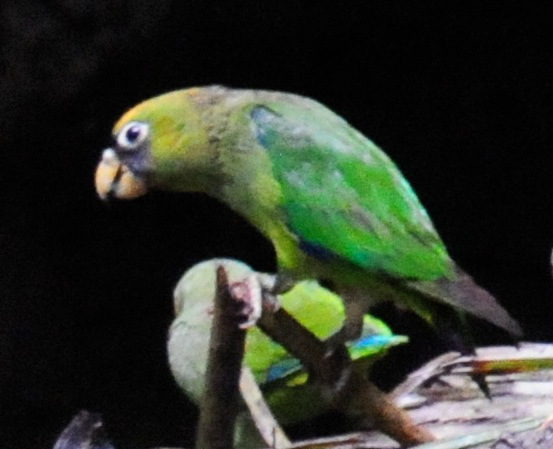
Wikipedia: Scarlet-shouldered parrotlet Source: OTHER
Touit_huetii_-Napo_Wildlife_Centre%2C_Yasuni_National_Park%2C_Ecuador_-clay_lick-6.jpg
![]() The scarlet-shouldered parrotlet (Touit huetii), also known as the red-winged parrotlet or Huet's parrotlet, is a species of parrot in the family Psittacidae.
[more]
The scarlet-shouldered parrotlet (Touit huetii), also known as the red-winged parrotlet or Huet's parrotlet, is a species of parrot in the family Psittacidae.
[more]
Profile Wikipedia eBird Xeno-Canto

Wikipedia: Spot-winged parrotlet Source: OTHER
1200px-UrochromaStictopteraWolf.jpg
![]() The spot-winged parrotlet (Touit stictopterus) is a species of parrot in the family Psittacidae.
It is found in Colombia, Ecuador, and Peru.
Its natural habitats are subtropical or tropical dry forests and subtropical or tropical moist montane forests.
It is threatened by habitat loss.
[more]
The spot-winged parrotlet (Touit stictopterus) is a species of parrot in the family Psittacidae.
It is found in Colombia, Ecuador, and Peru.
Its natural habitats are subtropical or tropical dry forests and subtropical or tropical moist montane forests.
It is threatened by habitat loss.
[more]
Profile Wikipedia eBird Xeno-Canto
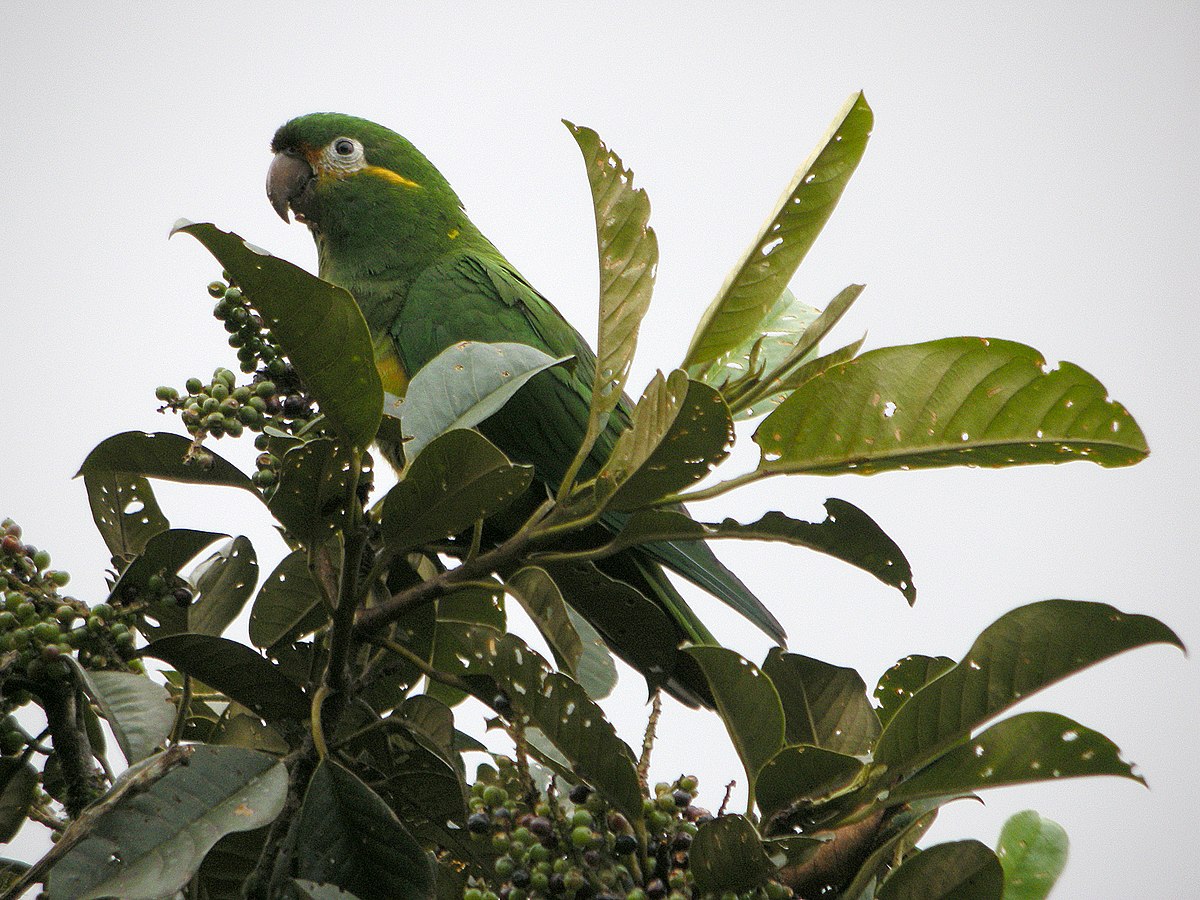
Wikipedia: Golden-plumed parakeet Source: OTHER
1200px-Leptosittaca_branickii_-Tapichalaca_Reserve-8.jpg
![]() The golden-plumed parakeet (Leptosittaca branickii) is a Neotropical parrot species within the family Psittacidae, belonging to the monotypic genus Leptosittaca.[2] This somewhat Aratinga-like species is found in humid temperate highland forests, especially with Podocarpus, on the east Andean slope in Colombia, Ecuador, and Peru. It is generally local and uncommon. It is threatened by habitat loss.[1] Clearing of high altitude forests for agricultural reasons has greatly impacted the loss of habitat for this parakeet species. Existence of such habitats will continue to diminish the amount of Golden-plumed Parakeets left in Southern America.[3] It is the only known parakeet species that can detect ultraviolet radiation.[citation needed]
[more]
The golden-plumed parakeet (Leptosittaca branickii) is a Neotropical parrot species within the family Psittacidae, belonging to the monotypic genus Leptosittaca.[2] This somewhat Aratinga-like species is found in humid temperate highland forests, especially with Podocarpus, on the east Andean slope in Colombia, Ecuador, and Peru. It is generally local and uncommon. It is threatened by habitat loss.[1] Clearing of high altitude forests for agricultural reasons has greatly impacted the loss of habitat for this parakeet species. Existence of such habitats will continue to diminish the amount of Golden-plumed Parakeets left in Southern America.[3] It is the only known parakeet species that can detect ultraviolet radiation.[citation needed]
[more]

Wikipedia: Red-masked parakeet Source: OTHER
1200px-Red-masked_Parakeet-Aratinga_erythrogenys_in_a_tree.jpg
![]() The red-masked parakeet (Psittacara erythrogenys)[2] is a medium-sized parrot from Ecuador and Peru. It is popular as a pet and are better known in aviculture as the cherry-headed conure[3] or the red-headed conure.[4] They are also considered the best talkers of all the conures.[5]
[more]
The red-masked parakeet (Psittacara erythrogenys)[2] is a medium-sized parrot from Ecuador and Peru. It is popular as a pet and are better known in aviculture as the cherry-headed conure[3] or the red-headed conure.[4] They are also considered the best talkers of all the conures.[5]
[more]

Wikipedia: Scarlet-fronted parakeet Source: OTHER
Aratinga_wagleri_-Jurong_BirdPark-4.jpg
![]() The scarlet-fronted parakeet (Psittacara wagleri), also known as the scarlet-fronted conure, red-fronted conure or Wagler's conure, is a long-tailed South American species of parrot.
It is found in Colombia, Ecuador, Peru, and Venezuela.
Its natural habitats are subtropical or tropical dry forest, subtropical or tropical moist lowland forest, subtropical or tropical moist montane forest, and especially high-altitude shrubland and forest; it is also known to visit heavily degraded former forest.
[more]
The scarlet-fronted parakeet (Psittacara wagleri), also known as the scarlet-fronted conure, red-fronted conure or Wagler's conure, is a long-tailed South American species of parrot.
It is found in Colombia, Ecuador, Peru, and Venezuela.
Its natural habitats are subtropical or tropical dry forest, subtropical or tropical moist lowland forest, subtropical or tropical moist montane forest, and especially high-altitude shrubland and forest; it is also known to visit heavily degraded former forest.
[more]

Wikipedia: White-eyed parakeet Source: OTHER
1200px-Aratinga_leucophthalma_-Piraju_-Brazil-8.jpg
![]() The white-eyed parakeet or white-eyed conure (Psittacara leucophthalmus) is a small green Neotropical parrot native to South America.
[more]
The white-eyed parakeet or white-eyed conure (Psittacara leucophthalmus) is a small green Neotropical parrot native to South America.
[more]

Wikipedia: Rose-faced parrot Source: OTHER
1200px-Rose-faced_Parrot_%285183941237%29.jpg
![]() The rose-faced parrot (Pyrilia pulchra) is a species of parrot in the family Psittacidae. It is sometimes considered conspecific with the brown-hooded parrot (P. pulchra), and was formerly placed in Pionopsitta which is now monotypic. It is found in Colombia and Ecuador.
[more]
The rose-faced parrot (Pyrilia pulchra) is a species of parrot in the family Psittacidae. It is sometimes considered conspecific with the brown-hooded parrot (P. pulchra), and was formerly placed in Pionopsitta which is now monotypic. It is found in Colombia and Ecuador.
[more]

Wikipedia: Orange-cheeked parrot Source: OTHER
Pyrilia_barrabandi_-Napo_Wildlife_Reserve-4.jpg
![]() The orange-cheeked parrot (Pyrilia barrabandi), also known as the Barraband's parrot, is a species of parrot in the family Psittacidae. It was formerly placed in the genus Pionopsitta, which is now monotypic.
[more]
The orange-cheeked parrot (Pyrilia barrabandi), also known as the Barraband's parrot, is a species of parrot in the family Psittacidae. It was formerly placed in the genus Pionopsitta, which is now monotypic.
[more]
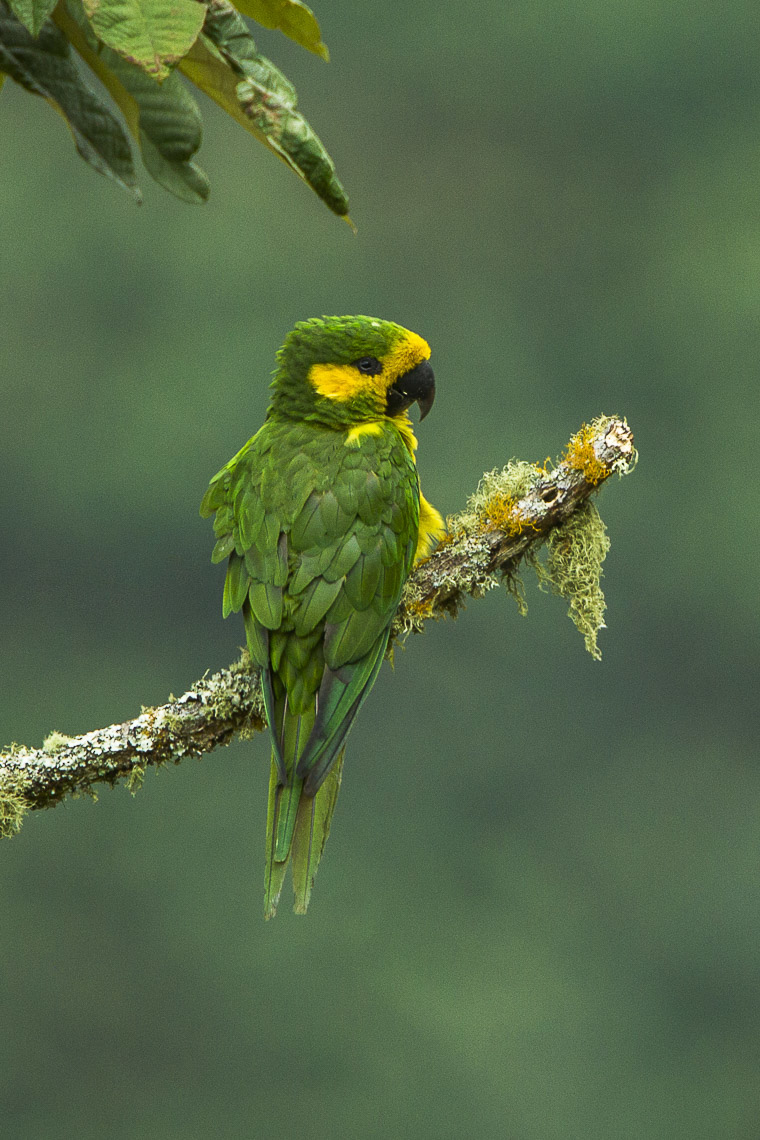
Wikipedia: Yellow-eared parrot Source: OTHER
Ognorhynchus_icterotis_-Colombia-8.jpg
![]() The yellow-eared parrot (Ognorhynchus icterotis) is an endangered parrot of the tropics in South America. It is found in the Andes of Colombia. This species was thought to be extinct up until April 1999, when a group of researchers that were sponsored by ABC and Fundación Loro Parque, discovered a total of 81 individuals in the Colombian Andes.[2] It is currently enlisted as vulnerable on the International Union for Conservation of Nature (IUCN) Red List. Its current population trend is increasing, in part due to conservation measures implemented to protect the existing populations of the species. It is closely associated with the wax palm (Ceroxylon sp.).
[more]
The yellow-eared parrot (Ognorhynchus icterotis) is an endangered parrot of the tropics in South America. It is found in the Andes of Colombia. This species was thought to be extinct up until April 1999, when a group of researchers that were sponsored by ABC and Fundación Loro Parque, discovered a total of 81 individuals in the Colombian Andes.[2] It is currently enlisted as vulnerable on the International Union for Conservation of Nature (IUCN) Red List. Its current population trend is increasing, in part due to conservation measures implemented to protect the existing populations of the species. It is closely associated with the wax palm (Ceroxylon sp.).
[more]

Wikipedia: Hoatzin Source: OTHER
Hoatzin_-_Manu_NP_-_Per%C3%B9_9203_%2815525812066%29.jpg
![]() The hoatzin (/hoʊˈtsɪn/, Opisthocomus hoazin), also known as the reptile bird, skunk bird, stinkbird, or Canje pheasant, is a species of tropical bird found in swamps, riparian forests, and mangroves of the Amazon and the Orinoco basins in South America. It is notable for having chicks that have claws on two of their wing digits.
[more]
The hoatzin (/hoʊˈtsɪn/, Opisthocomus hoazin), also known as the reptile bird, skunk bird, stinkbird, or Canje pheasant, is a species of tropical bird found in swamps, riparian forests, and mangroves of the Amazon and the Orinoco basins in South America. It is notable for having chicks that have claws on two of their wing digits.
[more]
Profile Wikipedia eBird A-Z Animals Audubon AllAboutBirds Xeno-Canto
Pied-billed grebe, Bacalar. 2023-03-31 13.17.14 Yucatan
First observed in Yucatan on 2023-03-31.
This bird appears across the great seas in the following continents:
North America, South America, Africa.
![]() The pied-billed grebe (Podilymbus podiceps) is a species of the grebe family of water birds. Since the Atitlán grebe (Podilymbus gigas) has become extinct, it is the sole extant member of the genus Podilymbus.[2] The pied-billed grebe is primarily found in ponds throughout the Americas.[3] Other names of this grebe include American dabchick, rail, dabchick, Carolina grebe, devil-diver, dive-dapper, dipper, hell-diver, pied-billed dabchick, pied-bill, thick-billed grebe, and water witch.[4][5]
[more]
The pied-billed grebe (Podilymbus podiceps) is a species of the grebe family of water birds. Since the Atitlán grebe (Podilymbus gigas) has become extinct, it is the sole extant member of the genus Podilymbus.[2] The pied-billed grebe is primarily found in ponds throughout the Americas.[3] Other names of this grebe include American dabchick, rail, dabchick, Carolina grebe, devil-diver, dive-dapper, dipper, hell-diver, pied-billed dabchick, pied-bill, thick-billed grebe, and water witch.[4][5]
[more]
Profile Wikipedia eBird Xeno-Canto

Wikipedia: Silvery grebe Source: OTHER
Silvery_Grebe_%28Podiceps_occipitalis%29_swimming.jpg
![]() The silvery grebe (Podiceps occipitalis) is a species of grebe in the family Podicipedidae. It is found in the western and southern part of South America at altitudes of up to 4,000 metres (13,000 ft). Its natural habitat is freshwater lakes but it also feeds in saline lakes.
[more]
The silvery grebe (Podiceps occipitalis) is a species of grebe in the family Podicipedidae. It is found in the western and southern part of South America at altitudes of up to 4,000 metres (13,000 ft). Its natural habitat is freshwater lakes but it also feeds in saline lakes.
[more]
Profile Wikipedia eBird Xeno-Canto
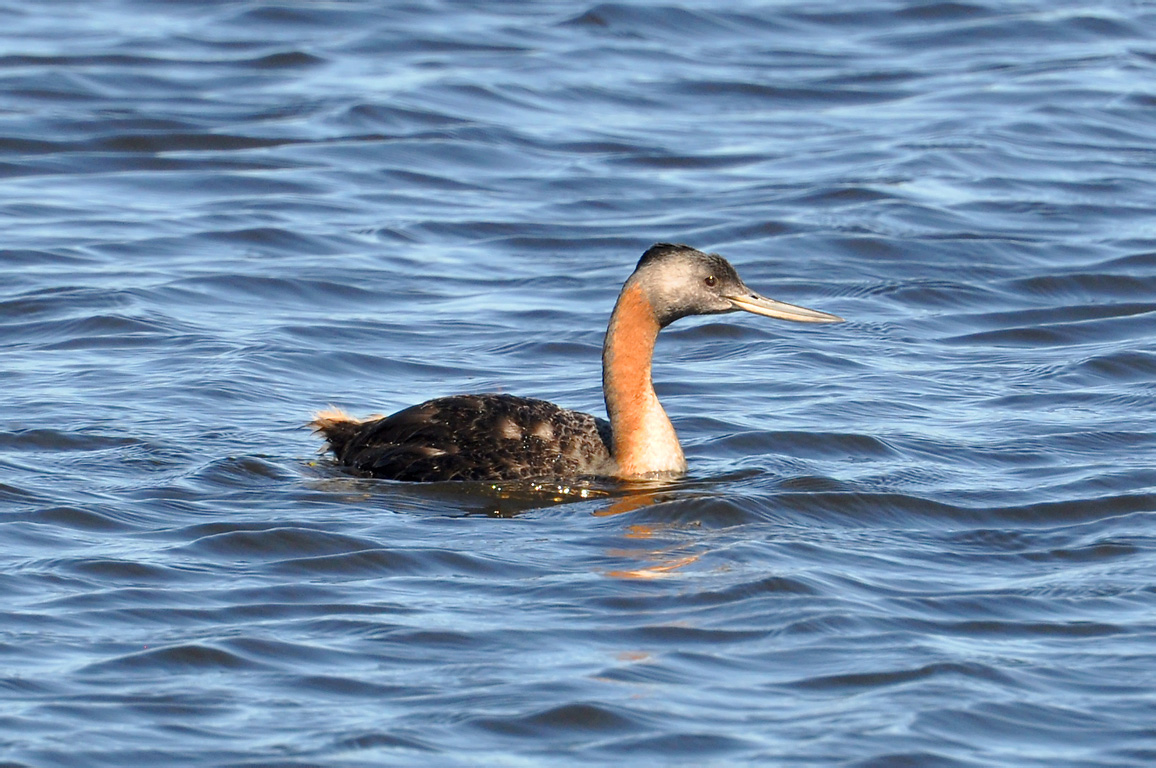
Wikipedia: Great grebe Source: OTHER
Podicephorus_major_-Santa_Vitoria_do_Palmar%2C_Rio_Grande_do_Sul%2C_Brazil_-swimming-8.jpg
![]() The great grebe (Podiceps major) is the largest species of grebe in the world. A disjunct population exists in northwestern Peru, while the main distribution is from extreme southeastern Brazil to Patagonia and central Chile. The population from southern Chile is considered a separate subspecies, P. m. navasi.
[more]
The great grebe (Podiceps major) is the largest species of grebe in the world. A disjunct population exists in northwestern Peru, while the main distribution is from extreme southeastern Brazil to Patagonia and central Chile. The population from southern Chile is considered a separate subspecies, P. m. navasi.
[more]
Profile Wikipedia eBird Audubon AllAboutBirds Xeno-Canto

Wikipedia: Least grebe Source: OTHER
Least_grebe.jpg
![]() The least grebe (Tachybaptus dominicus), an aquatic bird, is the smallest member of the grebe family. It occurs in the New World from the southwestern United States and Mexico to Argentina, and also on Trinidad and Tobago, the Bahamas and the Greater Antilles.
[more]
The least grebe (Tachybaptus dominicus), an aquatic bird, is the smallest member of the grebe family. It occurs in the New World from the southwestern United States and Mexico to Argentina, and also on Trinidad and Tobago, the Bahamas and the Greater Antilles.
[more]
Profile Wikipedia eBird Xeno-Canto
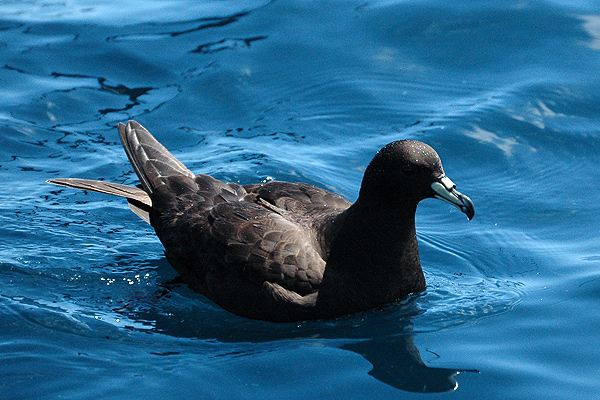
Wikipedia: Parkinson's petrel Source: OTHER
Blackpetrel.jpg
This bird appears across the great seas in the following continents:
South America, Australia.
![]() The black petrel (Procellaria parkinsoni), also called the Parkinson's petrel, is a medium-sized, black-plumaged petrel, the smallest of the Procellaria. The species is an endemic breeder of New Zealand, breeding only on Great Barrier Island and Little Barrier Island, off the North Island. At sea it disperses as far as Australia and Ecuador.
[more]
The black petrel (Procellaria parkinsoni), also called the Parkinson's petrel, is a medium-sized, black-plumaged petrel, the smallest of the Procellaria. The species is an endemic breeder of New Zealand, breeding only on Great Barrier Island and Little Barrier Island, off the North Island. At sea it disperses as far as Australia and Ecuador.
[more]
Profile Wikipedia eBird Xeno-Canto

Wikipedia: Galapagos petrel Source: OTHER
Pterodroma_phaeopygia.jpg
![]() The Galápagos petrel (Pterodroma phaeopygia) is one of the six endemic seabirds of the Galápagos.[2] Its scientific name derives from Ancient Greek: Pterodroma originates from pteron and dromos, meaning "wing" and "runner", and phaeopygia comes from phaios and pugios, meaning "dusky" and "rump".[3] Members of Pterodroma genus are also called the gadfly petrels because their erratic twisting and turning in flight resemble that of gadflies.[4]
[more]
The Galápagos petrel (Pterodroma phaeopygia) is one of the six endemic seabirds of the Galápagos.[2] Its scientific name derives from Ancient Greek: Pterodroma originates from pteron and dromos, meaning "wing" and "runner", and phaeopygia comes from phaios and pugios, meaning "dusky" and "rump".[3] Members of Pterodroma genus are also called the gadfly petrels because their erratic twisting and turning in flight resemble that of gadflies.[4]
[more]

Wikipedia: Sooty shearwater Source: OTHER
1200px-Puffinus_griseus_in_flight_-_SE_Tasmania.jpg
This bird appears across the great seas in the following continents:
Europe, South America, Africa.
![]() The sooty shearwater (Ardenna grisea) is a medium-large shearwater in the seabird family Procellariidae. Ardenna was first used to refer to a seabird by Italian naturalist Ulisse Aldrovandi in 1603, and grisea is medieval Latin for "grey".[2]
[more]
The sooty shearwater (Ardenna grisea) is a medium-large shearwater in the seabird family Procellariidae. Ardenna was first used to refer to a seabird by Italian naturalist Ulisse Aldrovandi in 1603, and grisea is medieval Latin for "grey".[2]
[more]
Vocalization: ![]() Mostly heard at breeding ground. A peculiar, rhythmic, coarse moaning, with a disyllabic attack, followed by a deeper, cooing "in-breath". [Link]
Mostly heard at breeding ground. A peculiar, rhythmic, coarse moaning, with a disyllabic attack, followed by a deeper, cooing "in-breath". [Link]
Physical details: length=40-51 cm,
wingspan=94-109 cm,
weight=666-978 g

Wikipedia: Waved albatross Source: OTHER
1200px-Waved_Albatross_pair.jpg
General: ![]() The waved albatross (Phoebastria irrorata), also known as Galapagos albatross,[4] is the only member of the family Diomedeidae located in the tropics. When they forage, they follow a straight path to a single site off the coast of Peru, about 1,000 km (620 mi) to the east. During the non-breeding season, these birds reside primarily on the Ecuadorian and Peruvian coasts.
[more]
The waved albatross (Phoebastria irrorata), also known as Galapagos albatross,[4] is the only member of the family Diomedeidae located in the tropics. When they forage, they follow a straight path to a single site off the coast of Peru, about 1,000 km (620 mi) to the east. During the non-breeding season, these birds reside primarily on the Ecuadorian and Peruvian coasts.
[more]

Wikipedia: Band-rumped storm-petrel Source: OTHER
1200px-Band_rumped_storm_petrel_Andre_Raine_KESRP_%2821789178016%29.jpg
This bird appears across the great seas in the following continents:
Europe, North America, South America, Africa, Australia.
vagrant

Wikipedia: Wedge-rumped storm-petrel Source: OTHER
1200px-Galapagos_storm_petrel.jpg
General: ![]() The wedge-rumped storm petrel (Oceanodroma tethys) is a storm petrel. It breeds in the Galápagos Islands and on the coast of Peru.[1]
[more]
The wedge-rumped storm petrel (Oceanodroma tethys) is a storm petrel. It breeds in the Galápagos Islands and on the coast of Peru.[1]
[more]

Wikipedia: White-vented storm-petrel Source: OTHER
Eliotts_storm_petrel.jpg
![]() Elliot's storm petrel (Oceanites gracilis) is a species of seabird in the storm petrel family Hydrobatidae. The species is also known as the white-vented storm petrel.[2] There are two subspecies, O. g. gracilis, which is found in the Humboldt Current off Peru and Chile, and O. g. galapagoensis, which is found in the waters around the Galápagos Islands. It is a sooty-black storm petrel with a white rump and a white band crossing the lower belly and extending up the midline of the belly. It has long legs which extend beyond the body in flight.[3]
[more]
Elliot's storm petrel (Oceanites gracilis) is a species of seabird in the storm petrel family Hydrobatidae. The species is also known as the white-vented storm petrel.[2] There are two subspecies, O. g. gracilis, which is found in the Humboldt Current off Peru and Chile, and O. g. galapagoensis, which is found in the waters around the Galápagos Islands. It is a sooty-black storm petrel with a white rump and a white band crossing the lower belly and extending up the midline of the belly. It has long legs which extend beyond the body in flight.[3]
[more]

Wikipedia: Great horned owl Source: OTHER
1200px-Bubo_virginianus_06.jpg
![]() About 12, see text
[more]
About 12, see text
[more]
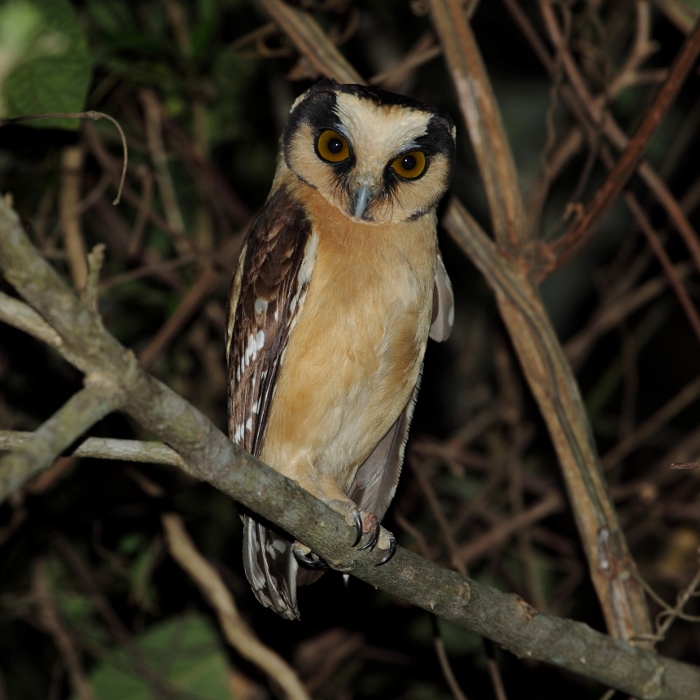
Wikipedia: Buff-fronted owl Source: OTHER
Aegolius_harrisii-Buff-fronted_Owl.jpg
![]() The buff-fronted owl (Aegolius harrisii) is a small owl, a rare and local resident in the highlands of South America from Venezuela south and east to Peru, northern Argentina, and northwest Paraguay. Its range is effectively separated into two parts by the unsuitable habitat of the Amazon basin.
[more]
The buff-fronted owl (Aegolius harrisii) is a small owl, a rare and local resident in the highlands of South America from Venezuela south and east to Peru, northern Argentina, and northwest Paraguay. Its range is effectively separated into two parts by the unsuitable habitat of the Amazon basin.
[more]

Wikipedia: Short-eared owl Source: OTHER
1200px-Hibou_des_marais.jpg
This bird appears across the great seas in the following continents:
Europe, North America, South America, Africa, Asia.
Deutschland: Brut-, Zugvogel, Wintergast RL 1
Habitats:
Wetland

Wikipedia: Stygian owl Source: OTHER
Stygian_Owl_%28Asio_stygius%29.jpg
General: ![]() Die Schreieule (Asio clamator), auch Streifen-Ohreule genannt, ist eine Art aus der Familie der Eigentlichen Eulen. Sie kommt in drei Unterarten ausschließlich in Nord-, Zentral- und Südamerika vor.
[more]
Die Schreieule (Asio clamator), auch Streifen-Ohreule genannt, ist eine Art aus der Familie der Eigentlichen Eulen. Sie kommt in drei Unterarten ausschließlich in Nord-, Zentral- und Südamerika vor.
[more]
Profile Wikipedia eBird Audubon AllAboutBirds Xeno-Canto
Ferruginous pygmy owl - what a name! 2023-04-16 08.56.50 Yucatan
First observed in Yucatan on 2023-04-16.
![]() The ferruginous pygmy owl (Glaucidium brasilianum) is a small owl that breeds in south-central Arizona and southern Texas in the United States, south through Mexico and Central America, to South America into Bolivia, Paraguay and Argentina.
[more]
The ferruginous pygmy owl (Glaucidium brasilianum) is a small owl that breeds in south-central Arizona and southern Texas in the United States, south through Mexico and Central America, to South America into Bolivia, Paraguay and Argentina.
[more]
Profile Wikipedia eBird Xeno-Canto

Wikipedia: Central American pygmy-owl Source: OTHER
1200px-GlaucidiumPumilumGriseicepsKeulemans.jpg
![]() The Central American pygmy owl (Glaucidium griseiceps) is a species of owl in the family Strigidae.
[more]
The Central American pygmy owl (Glaucidium griseiceps) is a species of owl in the family Strigidae.
[more]

Wikipedia: Andean pygmy owl Source: OTHER
Andean_Pygmy-owl_%28Glaucidium_jardinii%29_in_tree.jpg
![]() The Andean pygmy owl (Glaucidium jardinii) is a species of owl in the family Strigidae. It is found in Colombia, Ecuador, Peru, and Venezuela.[3]
[more]
The Andean pygmy owl (Glaucidium jardinii) is a species of owl in the family Strigidae. It is found in Colombia, Ecuador, Peru, and Venezuela.[3]
[more]
Profile Wikipedia eBird Xeno-Canto

Wikipedia: Cloud-forest pygmy-owl Source: OTHER
2728_Cloud-forest_Pygmy-Owl_2_%282076601412%29.jpg
![]() The cloud-forest pygmy owl (Glaucidium nubicola) is a short, muscular, small-sized species of owl found throughout the Andes of western Colombia and north-western Ecuador, being confined to cloud forests between 900–2000 m a.s.l.[2] Below this altitudinal range the Central American pygmy owl (Glaucidium griseiceps) occurs; above it, the Andean pygmy owl (Glaucidium jardinii) occurs.[3]
[more]
The cloud-forest pygmy owl (Glaucidium nubicola) is a short, muscular, small-sized species of owl found throughout the Andes of western Colombia and north-western Ecuador, being confined to cloud forests between 900–2000 m a.s.l.[2] Below this altitudinal range the Central American pygmy owl (Glaucidium griseiceps) occurs; above it, the Andean pygmy owl (Glaucidium jardinii) occurs.[3]
[more]
Profile Wikipedia eBird Xeno-Canto

Wikipedia: Peruvian pygmy-owl Source: OTHER
1200px-Peruvian_Pygmy-Owl_%28Glaucidium_peruanum%29_El_Empalme%2C_Ecuador.jpg
![]() The Pacific pygmy owl or Peruvian pygmy owl (Glaucidium peruanum) is a diurnal species of owl in the family Strigidae.[2] It is found in Ecuador and Peru year round and its natural habitats are subtropical or tropical dry shrubland, subtropical or tropical moist shrubland, subtropical or tropical high-altitude shrubland, and heavily degraded former forest.[3][4]
[more]
The Pacific pygmy owl or Peruvian pygmy owl (Glaucidium peruanum) is a diurnal species of owl in the family Strigidae.[2] It is found in Ecuador and Peru year round and its natural habitats are subtropical or tropical dry shrubland, subtropical or tropical moist shrubland, subtropical or tropical high-altitude shrubland, and heavily degraded former forest.[3][4]
[more]
Profile Wikipedia eBird Xeno-Canto
![]() The subtropical pygmy owl (Glaucidium parkeri) is a species of owl in the family Strigidae.
It is found in Bolivia, Ecuador, and Peru.
Its natural habitat is subtropical or tropical moist montane forests. It has a call "with three or four short phrases (normally 2-4 or 6 en intervals of several seconds) of low tone increasing when ending the two notes hu-hu, hu, and having a hesitation before the last note” (Chaparro-Herrera p. 362, 2017).[2]
[more]
The subtropical pygmy owl (Glaucidium parkeri) is a species of owl in the family Strigidae.
It is found in Bolivia, Ecuador, and Peru.
Its natural habitat is subtropical or tropical moist montane forests. It has a call "with three or four short phrases (normally 2-4 or 6 en intervals of several seconds) of low tone increasing when ending the two notes hu-hu, hu, and having a hesitation before the last note” (Chaparro-Herrera p. 362, 2017).[2]
[more]
Profile Wikipedia eBird Xeno-Canto

Wikipedia: Crested owl Source: OTHER
1200px-Lophostrix_cristata_-Panama-8.jpg
Panama
![]() The crested owl (Lophostrix cristata) is a species of owl in the family Strigidae. It is the only species (monotypic) in the genus Lophostrix. It is a resident bird and occurs in Central America and northern South America. It is a medium-sized owl, easily recognizable with its very long whitish ear tufts and otherwise darker appearance. It inhabits lowland rainforests and prefers old growth in proximity with water. The crested owl is a strictly nocturnal species, but very little is known about its behaviour.
[more]
The crested owl (Lophostrix cristata) is a species of owl in the family Strigidae. It is the only species (monotypic) in the genus Lophostrix. It is a resident bird and occurs in Central America and northern South America. It is a medium-sized owl, easily recognizable with its very long whitish ear tufts and otherwise darker appearance. It inhabits lowland rainforests and prefers old growth in proximity with water. The crested owl is a strictly nocturnal species, but very little is known about its behaviour.
[more]
Profile Wikipedia eBird Xeno-Canto

Wikipedia: Spectacled owl Source: OTHER
1200px-Pulsatrix_perspicillata_chapmani_%28Costa_Rica%29.jpg
![]() The spectacled owl (Pulsatrix perspicillata) is a large tropical owl native to the neotropics. It is a resident breeder in forests from southern Mexico and Trinidad, through Central America, south to southern Brazil, Paraguay and northwestern Argentina.[1] There are six subspecies.[2] One is occasionally treated as a separate species called the short-browed or brown spectacled owl[3] but the consensus is that it is still merely a race until more detailed analysis can be done.[4]
[more]
The spectacled owl (Pulsatrix perspicillata) is a large tropical owl native to the neotropics. It is a resident breeder in forests from southern Mexico and Trinidad, through Central America, south to southern Brazil, Paraguay and northwestern Argentina.[1] There are six subspecies.[2] One is occasionally treated as a separate species called the short-browed or brown spectacled owl[3] but the consensus is that it is still merely a race until more detailed analysis can be done.[4]
[more]
Profile Wikipedia eBird Xeno-Canto

Wikipedia: Band-bellied owl Source: OTHER
1200px-Pulsatrix_melanota.jpg
![]() The band-bellied owl (Pulsatrix melanota) is a species of owl in the family Strigidae. It is found in Bolivia, Colombia, Ecuador and Peru.
[more]
The band-bellied owl (Pulsatrix melanota) is a species of owl in the family Strigidae. It is found in Bolivia, Colombia, Ecuador and Peru.
[more]
Profile Wikipedia eBird Xeno-Canto
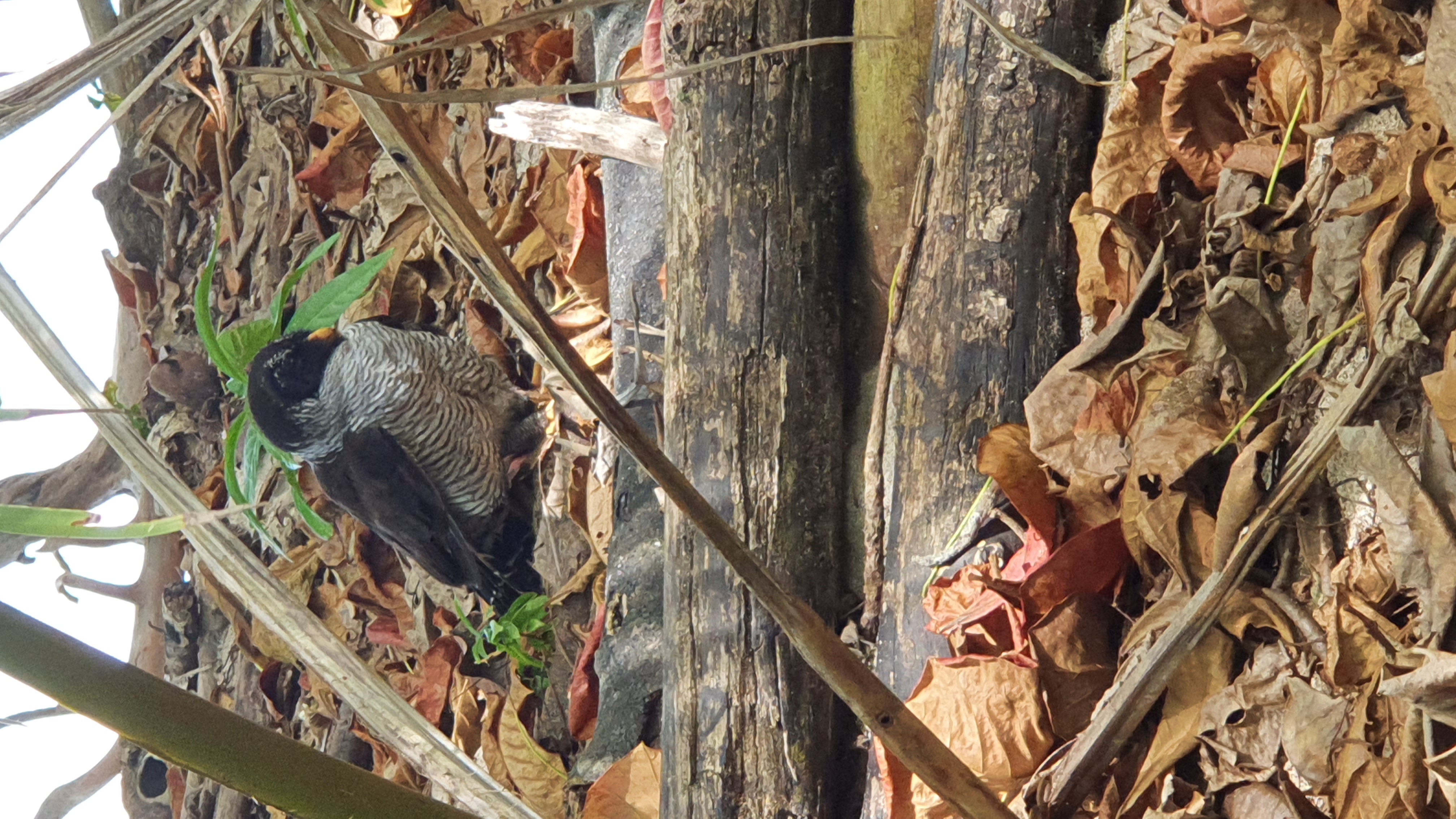
Black-and-white owl near Punta Cahuita in Cahuita National Park, Costa Rica. 2020-03-18 10.22.31 Costa Rica
First observed in Costa Rica on 2020-03-18.
![]() The black-and-white owl (Strix nigrolineata) is a species of owl in the family Strigidae.[1][2]
[more]
The black-and-white owl (Strix nigrolineata) is a species of owl in the family Strigidae.[1][2]
[more]
Profile Wikipedia eBird Xeno-Canto

Wikipedia: Black-banded owl Source: OTHER
1200px-Coruja-preta_%28Strix_huhula%29.jpg
![]() The black-banded owl (Strix huhula) is a species of owl in the family Strigidae. Entirely nocturnal, this midsized black and white neotropical bird is a resident species, therefore never migrates out of its native South America. Its natural habitats are varied subtropical or tropical forests ranging from lowlands to areas of medium altitude, and it has been found in Argentina, Bolivia, Brazil, Colombia, Ecuador, French Guiana, Guyana, Paraguay, Peru, Suriname, and Venezuela.[2]
[more]
The black-banded owl (Strix huhula) is a species of owl in the family Strigidae. Entirely nocturnal, this midsized black and white neotropical bird is a resident species, therefore never migrates out of its native South America. Its natural habitats are varied subtropical or tropical forests ranging from lowlands to areas of medium altitude, and it has been found in Argentina, Bolivia, Brazil, Colombia, Ecuador, French Guiana, Guyana, Paraguay, Peru, Suriname, and Venezuela.[2]
[more]
Profile Wikipedia eBird Xeno-Canto

Wikipedia: Rufous-banded owl Source: OTHER
1200px-Ciccaba_albitarsis_Buho_ocelado_Rufous-banded_Owl_%2828009257216%29.jpg
![]() The rufous-banded owl (Strix albitarsis) is a species of owl in the family Strigidae. It is found in Bolivia, Colombia, Ecuador, Peru, and Venezuela.
[more]
The rufous-banded owl (Strix albitarsis) is a species of owl in the family Strigidae. It is found in Bolivia, Colombia, Ecuador, Peru, and Venezuela.
[more]

Wikipedia: Burrowing owl Source: OTHER
1200px-Brazilian_burrowing_owl_%28Athene_cunicularia_grallaria%29.jpg
![]() The burrowing owl (Athene cunicularia) is a small, long-legged owl found throughout open landscapes of North and South America. Burrowing owls can be found in grasslands, rangelands, agricultural areas, deserts, or any other open dry area with low vegetation.[2] They nest and roost in burrows, such as those excavated by prairie dogs (Cynomys spp.). Unlike most owls, burrowing owls are often active during the day, although they tend to avoid the midday heat. Like many other kinds of owls, though, burrowing owls do most of their hunting from dusk until dawn, when they can use their night vision and hearing to their advantage. Living in open grasslands as opposed to forests, the burrowing owl has developed longer legs that enable it to sprint, as well as fly, when hunting.
[more]
The burrowing owl (Athene cunicularia) is a small, long-legged owl found throughout open landscapes of North and South America. Burrowing owls can be found in grasslands, rangelands, agricultural areas, deserts, or any other open dry area with low vegetation.[2] They nest and roost in burrows, such as those excavated by prairie dogs (Cynomys spp.). Unlike most owls, burrowing owls are often active during the day, although they tend to avoid the midday heat. Like many other kinds of owls, though, burrowing owls do most of their hunting from dusk until dawn, when they can use their night vision and hearing to their advantage. Living in open grasslands as opposed to forests, the burrowing owl has developed longer legs that enable it to sprint, as well as fly, when hunting.
[more]

Wikipedia: Tropical screech owl Source: OTHER
Megascops_choliba_-Ceara%2C_Brazil-8.jpg
![]() The tropical screech owl (Megascops choliba) is a small species of owl in the family Strigidae.
[more]
The tropical screech owl (Megascops choliba) is a small species of owl in the family Strigidae.
[more]
Profile Wikipedia eBird Xeno-Canto
![]() The Chocó screech owl (Megascops centralis) is a species of owl in the family Strigidae. It is found in humid lowland forests from central Panama to western Ecuador.[1][2] As suggested by its name, a large part of its range is in the Chocó.[3]
[more]
The Chocó screech owl (Megascops centralis) is a species of owl in the family Strigidae. It is found in humid lowland forests from central Panama to western Ecuador.[1][2] As suggested by its name, a large part of its range is in the Chocó.[3]
[more]

Wikipedia: White-throated screech owl Source: OTHER
1200px-Megascops_albogularis_000.jpg
![]() The white-throated screech owl (Megascops albogularis) is an owl found in Andes in Bolivia, Colombia, Ecuador, Peru and Venezuela. It is the largest species of the genus Megascops, at 26 centimetres (10 in) and 185 grams (6.5 oz).
[more]
The white-throated screech owl (Megascops albogularis) is an owl found in Andes in Bolivia, Colombia, Ecuador, Peru and Venezuela. It is the largest species of the genus Megascops, at 26 centimetres (10 in) and 185 grams (6.5 oz).
[more]
Profile Wikipedia eBird Xeno-Canto
![]() The foothill screech owl (Megascops roraimae) is considered a distinct species by some authorities, including the International Ornithologists' Union. It is found in forests and dense second growth at altitudes of 200–1,800 metres (660–5,910 ft) in northern and western South America.[1][2] Its taxonomy is extremely complex and a matter of dispute (see taxonomy).
[more]
The foothill screech owl (Megascops roraimae) is considered a distinct species by some authorities, including the International Ornithologists' Union. It is found in forests and dense second growth at altitudes of 200–1,800 metres (660–5,910 ft) in northern and western South America.[1][2] Its taxonomy is extremely complex and a matter of dispute (see taxonomy).
[more]

Wikipedia: Tawny-bellied screech-owl Source: OTHER
1200px-Tawny-bellied_screech-owl.jpg
![]() The tawny-bellied screech owl (Megascops watsonii) is a species of owl in the family Strigidae.
It is found in Bolivia, Brazil, Colombia, Ecuador, French Guiana, Guyana, Peru, Suriname, and Venezuela.
Its natural habitats are subtropical or tropical moist lowland forests and subtropical or tropical swamps.
[more]
The tawny-bellied screech owl (Megascops watsonii) is a species of owl in the family Strigidae.
It is found in Bolivia, Brazil, Colombia, Ecuador, French Guiana, Guyana, Peru, Suriname, and Venezuela.
Its natural habitats are subtropical or tropical moist lowland forests and subtropical or tropical swamps.
[more]
Profile Wikipedia eBird Xeno-Canto
![]() The West Peruvian screech owl (Megascops roboratus) is a species of owl in the family Strigidae.
It is found in Ecuador and Peru.
Its natural habitats are subtropical or tropical dry forest, subtropical or tropical moist lowland forest, and heavily degraded former forest.
[more]
The West Peruvian screech owl (Megascops roboratus) is a species of owl in the family Strigidae.
It is found in Ecuador and Peru.
Its natural habitats are subtropical or tropical dry forest, subtropical or tropical moist lowland forest, and heavily degraded former forest.
[more]
![]() Koepcke's screech owl (Megascops koepckeae) is a species of owl in the family Strigidae.
It is found in Peru.
Its natural habitat is subtropical or tropical moist montane forests.
[more]
Koepcke's screech owl (Megascops koepckeae) is a species of owl in the family Strigidae.
It is found in Peru.
Its natural habitat is subtropical or tropical moist montane forests.
[more]

Wikipedia: Rufescent screech-owl Source: OTHER
Megascops_ingens%2C_Rufescent_Screech-Owl.jpg
![]() The rufescent screech owl (Megascops ingens) is a species of owl in the family Strigidae. It is found in Bolivia, Colombia, Ecuador, Peru, and Venezuela. This is one of the larger species of screech owls, similar in size to the white-throated screech owl. The overall length is 25 to 29 cm (9.8 to 11.4 in) and weight in males is 134–190 g (4.7–6.7 oz) and 140–273 g (4.9–9.6 oz) in females. Its coloration is sandy-brown above, vermiculated darker, the facial disc is sandy-brown, without a distinct rim. The flight feathers are barred cinnamon and dusky and the tail is cinnamon with darker brown bars. The hind crown has buffy-whitish border. It has honey-brown eyes and small ear tufts. The tarsi are feathered to the base of the toes. The Colombian screech owl was formerly considered a distinct species, but is now considered conspecific.
[more]
The rufescent screech owl (Megascops ingens) is a species of owl in the family Strigidae. It is found in Bolivia, Colombia, Ecuador, Peru, and Venezuela. This is one of the larger species of screech owls, similar in size to the white-throated screech owl. The overall length is 25 to 29 cm (9.8 to 11.4 in) and weight in males is 134–190 g (4.7–6.7 oz) and 140–273 g (4.9–9.6 oz) in females. Its coloration is sandy-brown above, vermiculated darker, the facial disc is sandy-brown, without a distinct rim. The flight feathers are barred cinnamon and dusky and the tail is cinnamon with darker brown bars. The hind crown has buffy-whitish border. It has honey-brown eyes and small ear tufts. The tarsi are feathered to the base of the toes. The Colombian screech owl was formerly considered a distinct species, but is now considered conspecific.
[more]

Wikipedia: Barn owl Source: OTHER
1200px-Tyto_alba_-British_Wildlife_Centre%2C_Surrey%2C_England-8a_%281%29.jpg
This bird appears across the great seas in the following continents:
Europe, North America, South America, Africa, Asia.
![]() The barn owl (Tyto alba) is the most widely distributed species of owl in the world and one of the most widespread of all species of birds, being found almost everywhere in the world except for the polar and desert regions, Asia north of the Himalayas, most of Indonesia, and some Pacific Islands. It is also known as the common barn owl, to distinguish it from the other species in its family, Tytonidae, which forms one of the two main lineages of living owls, the other being the typical owls (Strigidae).
[more]
The barn owl (Tyto alba) is the most widely distributed species of owl in the world and one of the most widespread of all species of birds, being found almost everywhere in the world except for the polar and desert regions, Asia north of the Himalayas, most of Indonesia, and some Pacific Islands. It is also known as the common barn owl, to distinguish it from the other species in its family, Tytonidae, which forms one of the two main lineages of living owls, the other being the typical owls (Strigidae).
[more]
Vocalization: ![]() Large repertoire of mainly hissing and screeching sounds. [Link]
Large repertoire of mainly hissing and screeching sounds. [Link]
Song: ![]() Song consists of a single, drawn screech, lasting about a second and is often performed in flight. Starting in a very hoarse tone, then progressing with a rising pitch into a more burbling sound, before suddenly ending. [Link]
Song consists of a single, drawn screech, lasting about a second and is often performed in flight. Starting in a very hoarse tone, then progressing with a rising pitch into a more burbling sound, before suddenly ending. [Link]
Physical details: length=33-35 cm,
wingspan=80-95 cm,
weight=240-350 g
Habitats:
Agricultural
Profile Wikipedia eBird Xeno-Canto
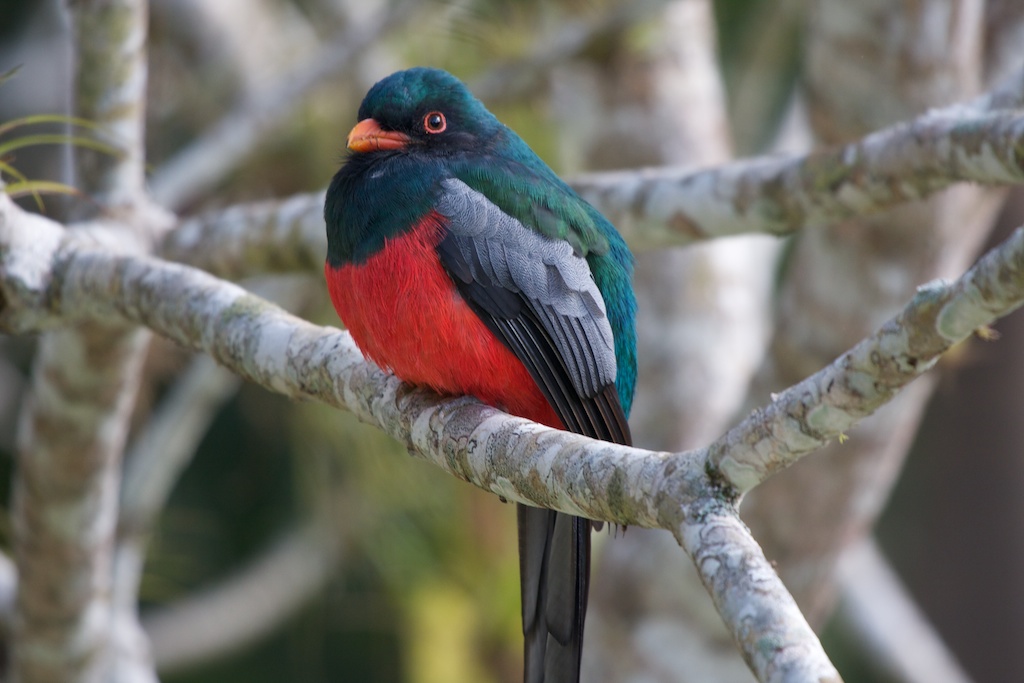
Wikipedia: Slaty-tailed trogon Source: OTHER
Trogon_massena_-Belize_-male-8.jpg
General: ![]() The slaty-tailed trogon (Trogon massena) is a near passerine bird in the trogon family, Trogonidae. It breeds in lowlands from southeastern Mexico south through Central America, to Colombia, and a small region of northwestern Ecuador.
[more]
The slaty-tailed trogon (Trogon massena) is a near passerine bird in the trogon family, Trogonidae. It breeds in lowlands from southeastern Mexico south through Central America, to Colombia, and a small region of northwestern Ecuador.
[more]
Profile Wikipedia eBird Xeno-Canto
Night tour - sleeping trogon, tenative ID by MerlinBirdID collared trogon. 2018-02-14 18.46.34 Costa Rica
First observed in Costa Rica on 2018-02-14.
![]() The collared trogon (Trogon collaris) is a near passerine bird in the trogon family, Trogonidae.
[more]
The collared trogon (Trogon collaris) is a near passerine bird in the trogon family, Trogonidae.
[more]
Profile Wikipedia eBird Xeno-Canto
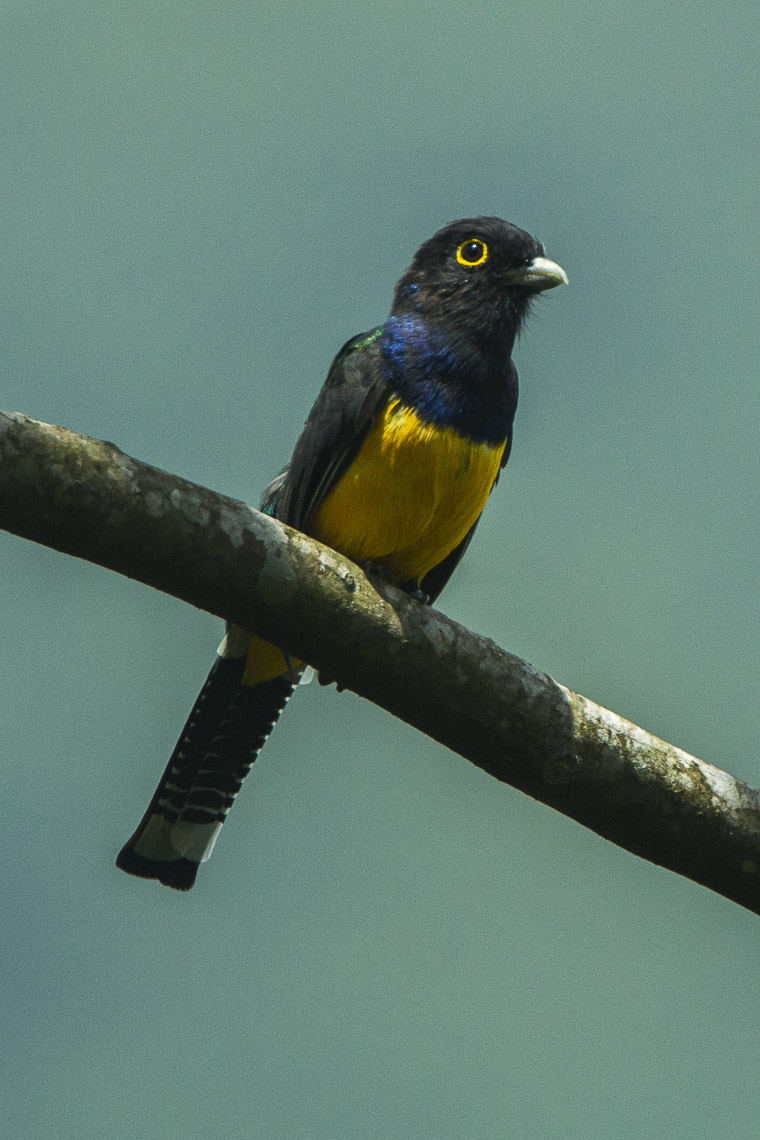
Wikipedia: Gartered trogon Source: OTHER
Gartered_Trogon_-_Mexico_S4E9784.jpg
![]() The gartered trogon (Trogon caligatus), also known as the northern violaceous trogon, is a near passerine bird in the trogon family, Trogonidae. It is found in forests in east-central Mexico, south through Central America, to north-western South America (west or north of the Andes in Colombia, Ecuador and Venezuela).[2] It was formerly treated as a subspecies of the violaceous trogon.[1][3]
[more]
The gartered trogon (Trogon caligatus), also known as the northern violaceous trogon, is a near passerine bird in the trogon family, Trogonidae. It is found in forests in east-central Mexico, south through Central America, to north-western South America (west or north of the Andes in Colombia, Ecuador and Venezuela).[2] It was formerly treated as a subspecies of the violaceous trogon.[1][3]
[more]
Profile Wikipedia eBird Xeno-Canto

Wikipedia: Black-throated trogon Source: OTHER
Black-throated_Trogon.jpg
![]() The black-throated trogon, also known as yellow-bellied trogon, (Trogon rufus) is a near passerine bird in the trogon family, Trogonidae. Although it is also called "yellow-bellied trogon" it is not the only trogon with a yellow belly. It breeds in lowlands from Honduras south to western Ecuador and northern Argentina.
[more]
The black-throated trogon, also known as yellow-bellied trogon, (Trogon rufus) is a near passerine bird in the trogon family, Trogonidae. Although it is also called "yellow-bellied trogon" it is not the only trogon with a yellow belly. It breeds in lowlands from Honduras south to western Ecuador and northern Argentina.
[more]

Wikipedia: White-tailed trogon Source: OTHER
Trogon-viridis-002.jpg
![]() The white-tailed trogon (Trogon chionurus) is a near passerine bird in the trogon family. It is found in tropical humid forests of the Chocó, ranging from Panama, through western Colombia, to western Ecuador. It was formerly considered a subspecies of T. viridis, which is widespread in South America east of the Andes, but under the English name white-tailed trogon (a name now reserved for T. chionurus, leaving T. viridis as the green-backed trogon).[3]
[more]
The white-tailed trogon (Trogon chionurus) is a near passerine bird in the trogon family. It is found in tropical humid forests of the Chocó, ranging from Panama, through western Colombia, to western Ecuador. It was formerly considered a subspecies of T. viridis, which is widespread in South America east of the Andes, but under the English name white-tailed trogon (a name now reserved for T. chionurus, leaving T. viridis as the green-backed trogon).[3]
[more]
Profile Wikipedia eBird Xeno-Canto

Wikipedia: Black-tailed trogon Source: OTHER
Trogon_melanurus.jpg
![]() The black-tailed trogon (Trogon melanurus) is a species of bird in the family Trogonidae. It is found in humid forest in the Amazon basin, north-western South America and adjacent Panama. The taxon mesurus from western Ecuador and far north-western Peru was formerly considered a subspecies of the black-tailed trogon, but is now considered a separate species, the Ecuadorian trogon.
[more]
The black-tailed trogon (Trogon melanurus) is a species of bird in the family Trogonidae. It is found in humid forest in the Amazon basin, north-western South America and adjacent Panama. The taxon mesurus from western Ecuador and far north-western Peru was formerly considered a subspecies of the black-tailed trogon, but is now considered a separate species, the Ecuadorian trogon.
[more]
Profile Wikipedia eBird Xeno-Canto
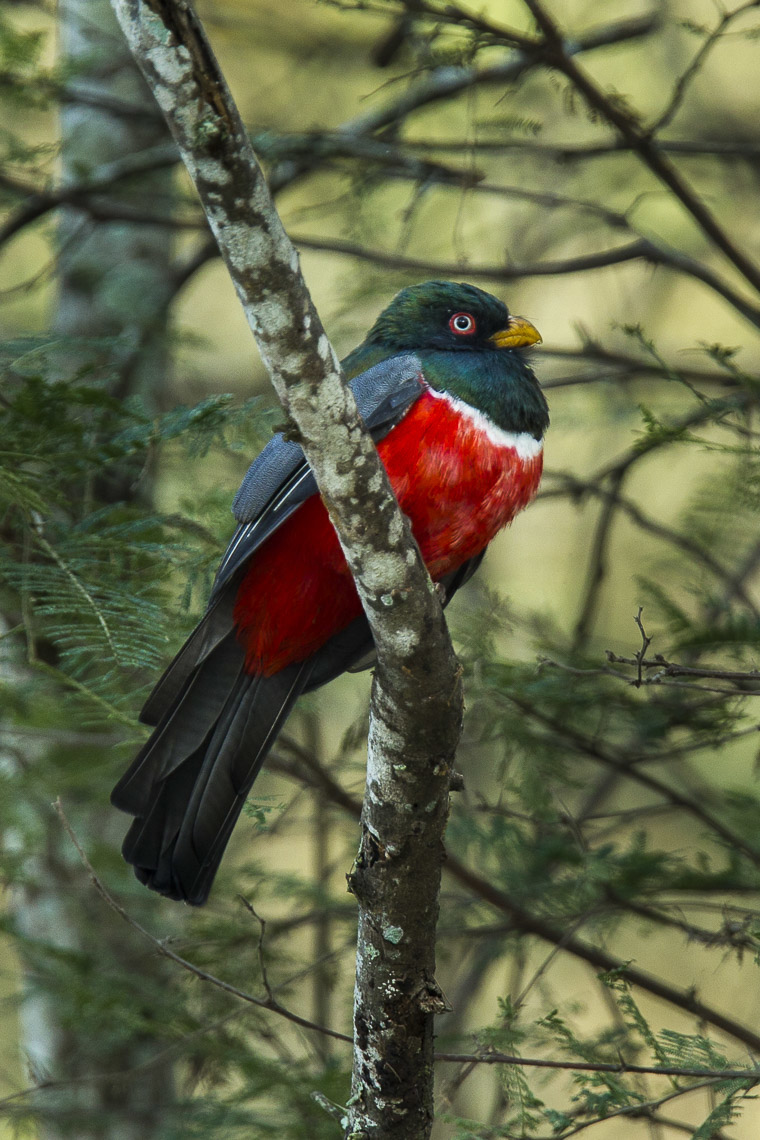
Wikipedia: Ecuadorian trogon Source: OTHER
Ecuadorian_Trogon_-_Ecuador_S4E9606.jpg
![]() The Ecuadorian trogon (Trogon mesurus) is a species of bird in the family Trogonidae. It is found in deciduous and semi-humid forest and woodland in western Ecuador and far north-western Peru. It was formerly considered a subspecies of the black-tailed trogon, which it resembles, except for its white eyes. It does not currently have any subspecies listed in the Catalogue of Life.[3]
[more]
The Ecuadorian trogon (Trogon mesurus) is a species of bird in the family Trogonidae. It is found in deciduous and semi-humid forest and woodland in western Ecuador and far north-western Peru. It was formerly considered a subspecies of the black-tailed trogon, which it resembles, except for its white eyes. It does not currently have any subspecies listed in the Catalogue of Life.[3]
[more]
Profile Wikipedia eBird Xeno-Canto
Wikipedia: Blue-crowned trogon Source: OTHER
Blue-crowned_Trogon.JPG
![]() The blue-crowned trogon (Trogon curucui) is a species of bird in the family Trogonidae.
It is found in Argentina, Bolivia, Brazil, Colombia, Ecuador, Paraguay, and Peru.
Its natural habitats are subtropical or tropical moist lowland forests and heavily degraded former forest.
[more]
The blue-crowned trogon (Trogon curucui) is a species of bird in the family Trogonidae.
It is found in Argentina, Bolivia, Brazil, Colombia, Ecuador, Paraguay, and Peru.
Its natural habitats are subtropical or tropical moist lowland forests and heavily degraded former forest.
[more]

Wikipedia: Masked trogon Source: OTHER
1200px-Masked_Trogon_%28Trogon_personatus%29_%2820144038635%29.jpg
![]() The masked trogon (Trogon personatus) is a species of bird in the family Trogonidae. It is fairly common in humid highland forests in South America, mainly the Andes and tepuis.
[more]
The masked trogon (Trogon personatus) is a species of bird in the family Trogonidae. It is fairly common in humid highland forests in South America, mainly the Andes and tepuis.
[more]
Profile Wikipedia eBird Xeno-Canto

Wikipedia: Amazonian trogon Source: OTHER
Bucco_tamatia_pulmentum_Aglaeactis_castelnaudii_Trogon_ramonianus.jpg
![]() The Amazonian trogon (Trogon ramonianus), is a near passerine bird in the trogon family, Trogonidae. It is found in humid forests in the Amazon of South America. Until recently, the Amazonian trogon was considered a subspecies of the violaceous trogon (T. violaceous).
[more]
The Amazonian trogon (Trogon ramonianus), is a near passerine bird in the trogon family, Trogonidae. It is found in humid forests in the Amazon of South America. Until recently, the Amazonian trogon was considered a subspecies of the violaceous trogon (T. violaceous).
[more]
Profile Wikipedia eBird Xeno-Canto
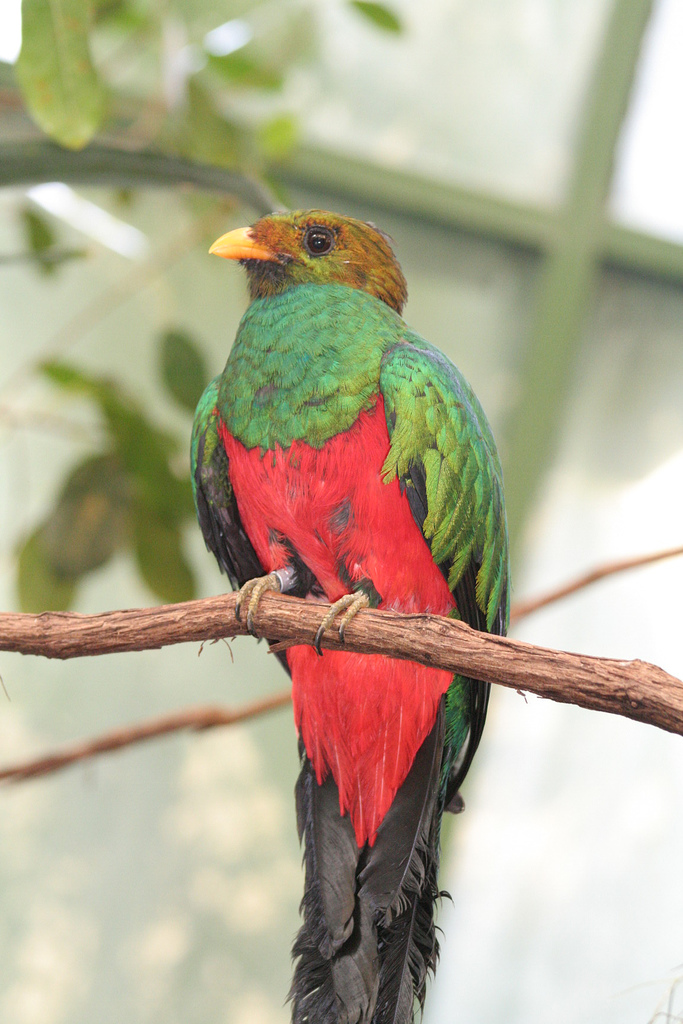
Wikipedia: Golden-headed quetzal Source: OTHER
Golden-headed_Quetzal.jpg
![]() The golden-headed quetzal or corequenque (Pharomachrus auriceps) is a strikingly coloured bird in the genus Pharomachrus; it is also referred to as Trogon auriceps. It is found in moist mid-elevation forests from eastern Panama to northern Bolivia.
[more]
The golden-headed quetzal or corequenque (Pharomachrus auriceps) is a strikingly coloured bird in the genus Pharomachrus; it is also referred to as Trogon auriceps. It is found in moist mid-elevation forests from eastern Panama to northern Bolivia.
[more]
Profile Wikipedia eBird Xeno-Canto

Wikipedia: Crested quetzal Source: OTHER
Crested_Quetzal.jpg
![]() The crested quetzal /ketSAHL/ (Pharomachrus antisianus) is a species of bird in the family Trogonidae native to South America, where it is found in Bolivia, Colombia, Ecuador, Peru, and Venezuela. Its natural habitat is subtropical or tropical moist montane forests.
[more]
The crested quetzal /ketSAHL/ (Pharomachrus antisianus) is a species of bird in the family Trogonidae native to South America, where it is found in Bolivia, Colombia, Ecuador, Peru, and Venezuela. Its natural habitat is subtropical or tropical moist montane forests.
[more]
Profile Wikipedia eBird Xeno-Canto
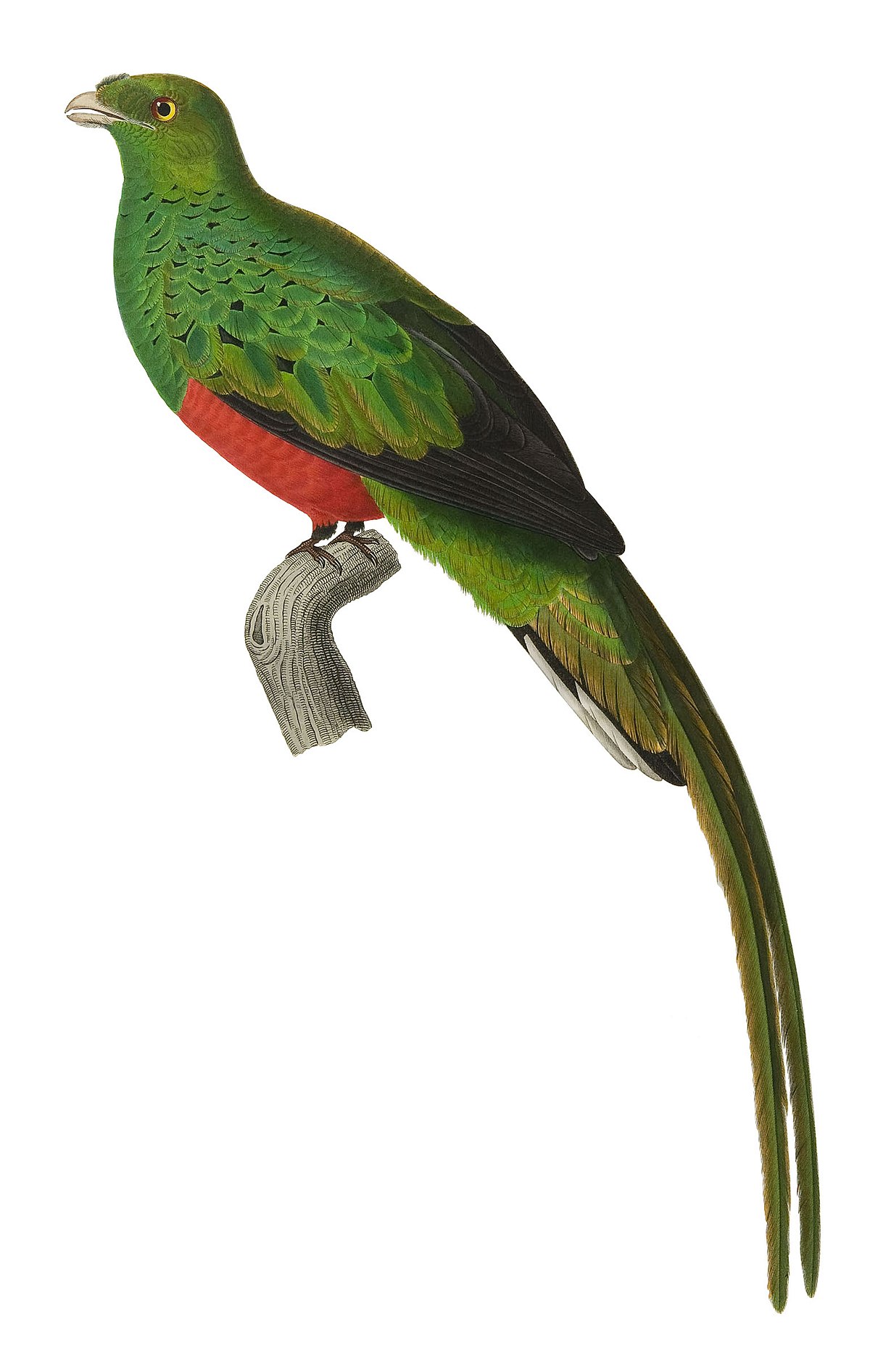
Wikipedia: Pavonine quetzal Source: OTHER
1200px-Pharomachrus_pavoninus_1838.jpg
![]() The pavonine quetzal (Pharomachrus pavoninus) is a species of bird in the family Trogonidae, the trogons. It is also known at the peacock trogon, red-billed train bearer, or viuda pico rojo in Spanish.[2] The pavonine quetzal lives in the Neotropics, more specifically in the northern region of the Amazon basin, spreading from Colombia to Bolivia. The most notable characteristics helpful in identifying this bird are its plumage, red beak (male; females have grey bills), and its distribution - it is the only quetzal occupying the lowland rainforest east of the Andes.[2][3]
[more]
The pavonine quetzal (Pharomachrus pavoninus) is a species of bird in the family Trogonidae, the trogons. It is also known at the peacock trogon, red-billed train bearer, or viuda pico rojo in Spanish.[2] The pavonine quetzal lives in the Neotropics, more specifically in the northern region of the Amazon basin, spreading from Colombia to Bolivia. The most notable characteristics helpful in identifying this bird are its plumage, red beak (male; females have grey bills), and its distribution - it is the only quetzal occupying the lowland rainforest east of the Andes.[2][3]
[more]
Profile Wikipedia eBird Xeno-Canto

Wikipedia: Rufous-tailed jacamar Source: OTHER
1200px-Rufous-tailed_jacamar_%28Galbula_ruficauda%29_male_2.JPG
![]() The rufous-tailed jacamar (Galbula ruficauda) is a near-passerine bird which breeds in the tropical New World in southern Mexico, Central America and South America as far south as southern Brazil and Ecuador.
[more]
The rufous-tailed jacamar (Galbula ruficauda) is a near-passerine bird which breeds in the tropical New World in southern Mexico, Central America and South America as far south as southern Brazil and Ecuador.
[more]
Profile Wikipedia eBird Xeno-Canto

Wikipedia: Yellow-billed jacamar Source: OTHER
1200px-Galbula_albirostris_-_Yellow-billed_jacamar_%28male%29.jpg
![]() The yellow-billed jacamar (Galbula albirostris) is a species of bird in the family Galbulidae. It is found in Brazil, Colombia, Ecuador, French Guiana, Guyana, Peru, Suriname, and Venezuela.[2]
[more]
The yellow-billed jacamar (Galbula albirostris) is a species of bird in the family Galbulidae. It is found in Brazil, Colombia, Ecuador, French Guiana, Guyana, Peru, Suriname, and Venezuela.[2]
[more]
Profile Wikipedia eBird Xeno-Canto

Wikipedia: Coppery-chested jacamar Source: OTHER
Coppery-chested_Jacamar_-_Ecuador_S4E0608.jpg
![]() The coppery-chested jacamar (Galbula pastazae) is a species of bird in the family Galbulidae. It is found in Colombia, Ecuador and Peru.[2][3]
[more]
The coppery-chested jacamar (Galbula pastazae) is a species of bird in the family Galbulidae. It is found in Colombia, Ecuador and Peru.[2][3]
[more]
Profile Wikipedia eBird Xeno-Canto

Wikipedia: Bluish-fronted jacamar Source: OTHER
Bluish-fronted_Jacamar_-_Manu_NP_8499.jpg
![]() The bluish-fronted jacamar (Galbula cyanescens) is a species of bird in the family Galbulidae. It is found in Bolivia, Brazil, and Peru.[2][3]
[more]
The bluish-fronted jacamar (Galbula cyanescens) is a species of bird in the family Galbulidae. It is found in Bolivia, Brazil, and Peru.[2][3]
[more]
Wikipedia: Paradise jacamar Source: OTHER
Galbula_dea_-_Paradise_Jacamar.JPG
![]() The paradise jacamar (Galbula dea) is a species of bird in the family Galbulidae. It is found in Bolivia, Brazil, Ecuador, French Guiana, Guyana, Peru, Suriname, and Venezuela.[2][3]
[more]
The paradise jacamar (Galbula dea) is a species of bird in the family Galbulidae. It is found in Bolivia, Brazil, Ecuador, French Guiana, Guyana, Peru, Suriname, and Venezuela.[2][3]
[more]

Wikipedia: Purplish jacamar Source: OTHER
Purplish_Jacamar_%28Galbula_leucogastra%29.jpg
![]() The purplish jacamar (Galbula chalcothorax) is a species of bird in the family Galbulidae. It is found in Brazil, Colombia, Ecuador, and Peru.[2][3]
[more]
The purplish jacamar (Galbula chalcothorax) is a species of bird in the family Galbulidae. It is found in Brazil, Colombia, Ecuador, and Peru.[2][3]
[more]
Profile Wikipedia eBird Xeno-Canto

Wikipedia: White-chinned jacamar Source: OTHER
Galbula_tombacea.jpg
![]() The white-chinned jacamar (Galbula tombacea) is a species of bird in the family Galbulidae. It is found in Brazil, Colombia, Ecuador, and Peru.[2]
[more]
The white-chinned jacamar (Galbula tombacea) is a species of bird in the family Galbulidae. It is found in Brazil, Colombia, Ecuador, and Peru.[2]
[more]
Profile Wikipedia eBird Xeno-Canto

Wikipedia: Great jacamar Source: OTHER
Great_Jacamar_-_Panama_H8O2675.jpg
![]() The great jacamar (Jacamerops aureus) is a species of bird in the family Galbulidae. It is placed in the monotypic genus Jacamerops.[2] It is found in Bolivia, Brazil, Colombia, Costa Rica, Ecuador, French Guiana, Guyana, Panama, Peru, Suriname, and Venezuela, where its natural habitat is subtropical and tropical moist lowland forests.[1]
[more]
The great jacamar (Jacamerops aureus) is a species of bird in the family Galbulidae. It is placed in the monotypic genus Jacamerops.[2] It is found in Bolivia, Brazil, Colombia, Costa Rica, Ecuador, French Guiana, Guyana, Panama, Peru, Suriname, and Venezuela, where its natural habitat is subtropical and tropical moist lowland forests.[1]
[more]

Wikipedia: Brown jacamar Source: OTHER
1200px-Deleitando.JPG
![]() The brown jacamar (Brachygalba lugubris) is a species of bird in the family Galbulidae. It is found in Bolivia, Brazil, Colombia, Ecuador, French Guiana, Guyana, Peru, Suriname, and Venezuela.[2][3]
[more]
The brown jacamar (Brachygalba lugubris) is a species of bird in the family Galbulidae. It is found in Bolivia, Brazil, Colombia, Ecuador, French Guiana, Guyana, Peru, Suriname, and Venezuela.[2][3]
[more]
Profile Wikipedia eBird Xeno-Canto

Wikipedia: Collared puffbird Source: OTHER
1200px-Bucco_capensis_62884158.jpg
![]() The collared puffbird (Bucco capensis) is bird in the family Bucconidae that is found across the northern region of South America in the Amazon Basin, southern Colombia and Venezuela, and the Guianas.
[more]
The collared puffbird (Bucco capensis) is bird in the family Bucconidae that is found across the northern region of South America in the Amazon Basin, southern Colombia and Venezuela, and the Guianas.
[more]

Wikipedia: Chestnut-capped puffbird Source: OTHER
Chestnut-capped_Puffbird.jpg
![]() The chestnut-capped puffbird (Bucco macrodactylus) is a species of bird in the family Bucconidae, the puffbirds.
[more]
The chestnut-capped puffbird (Bucco macrodactylus) is a species of bird in the family Bucconidae, the puffbirds.
[more]
Profile Wikipedia eBird Xeno-Canto

Wikipedia: Spotted puffbird Source: OTHER
1200px-Bucco_tamatia_-_Spotted_Puffbird.JPG
![]() The spotted puffbird (Bucco tamatia) is a species of puffbird in the family Bucconidae.
It is found in Bolivia, Brazil, Colombia, Ecuador, French Guiana, Guyana, Peru, Suriname, and Venezuela.
Its natural habitats are subtropical and tropical swamps and heavily degraded former forest.
[more]
The spotted puffbird (Bucco tamatia) is a species of puffbird in the family Bucconidae.
It is found in Bolivia, Brazil, Colombia, Ecuador, French Guiana, Guyana, Peru, Suriname, and Venezuela.
Its natural habitats are subtropical and tropical swamps and heavily degraded former forest.
[more]
Profile Wikipedia eBird Xeno-Canto
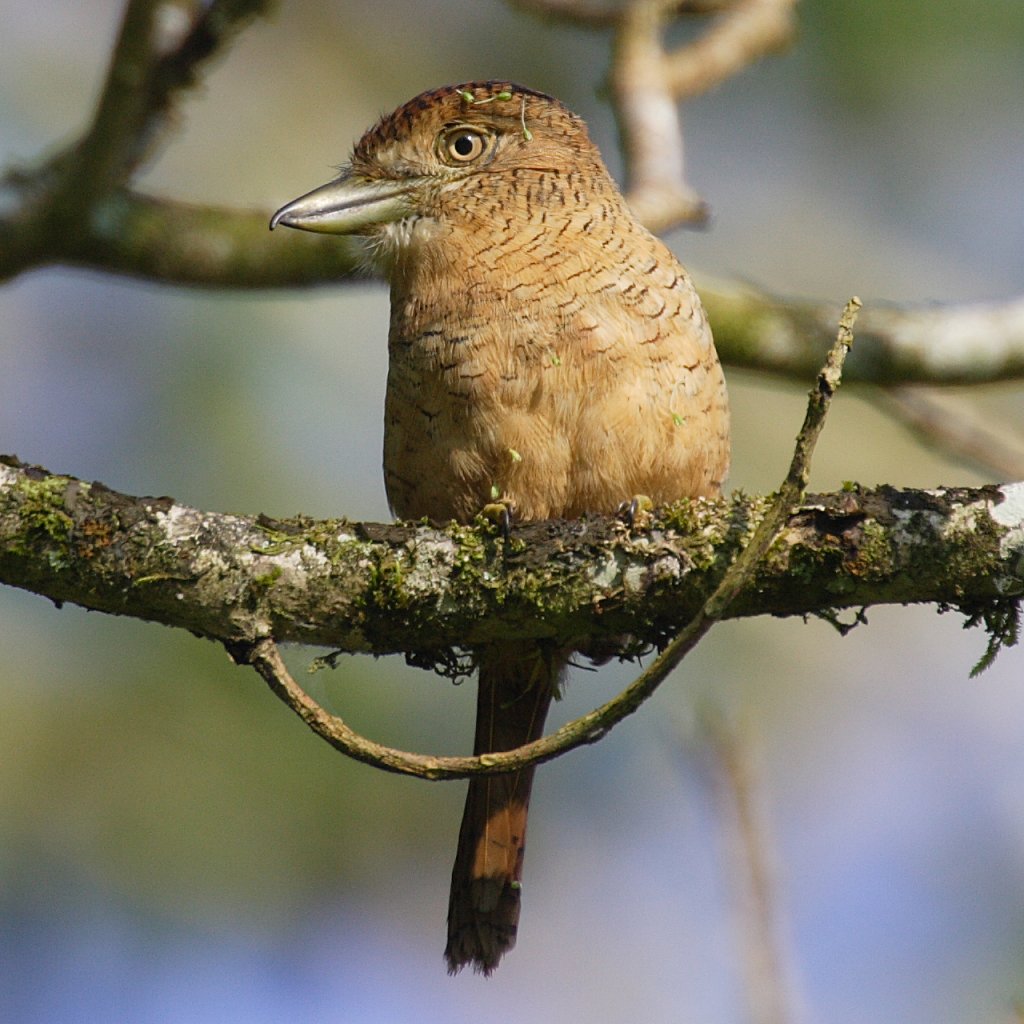
Wikipedia: Barred puffbird Source: OTHER
Nystalus-radiatus-001.jpg
![]() The barred puffbird (Nystalus radiatus) is a species of puffbird in the family Bucconidae. It lives in forests in the Tumbes-Chocó-Magdalena of Panama, Colombia and Ecuador. They can often be found in the middle to upper levels of the forests, in addition it has been spotted on the edges of forest trials, wires in loosely populated land, clearings with scattered trees, and occasionally in lower stories of humid forest borders. In terms of behavior, this bird is easily overlooked because of its propensity to sit still for long periods of time (similar to other puffbirds). Migration of this species has not been observed. Their diet consists of beetles, large caterpillars, local praying mantis, and small lizards. It can be identified by its faint red color, long, narrow and slightly graduated tail, creamy yellow colored iris and small size.[2][3]
[more]
The barred puffbird (Nystalus radiatus) is a species of puffbird in the family Bucconidae. It lives in forests in the Tumbes-Chocó-Magdalena of Panama, Colombia and Ecuador. They can often be found in the middle to upper levels of the forests, in addition it has been spotted on the edges of forest trials, wires in loosely populated land, clearings with scattered trees, and occasionally in lower stories of humid forest borders. In terms of behavior, this bird is easily overlooked because of its propensity to sit still for long periods of time (similar to other puffbirds). Migration of this species has not been observed. Their diet consists of beetles, large caterpillars, local praying mantis, and small lizards. It can be identified by its faint red color, long, narrow and slightly graduated tail, creamy yellow colored iris and small size.[2][3]
[more]
Profile Wikipedia eBird Xeno-Canto

Wikipedia: Western striolated-puffbird Source: OTHER
Nystalus_obamai.jpg
![]() The western striolated puffbird (Nystalus obamai) was considered conspecific with the eastern striolated puffbird.[1][2] It lives in Bolivia, western Brazil, Colombia, Ecuador, and Peru.[3] Its natural habitat is subtropical and tropical moist lowland forests. It was named after U.S. president Barack Obama.[4]
[more]
The western striolated puffbird (Nystalus obamai) was considered conspecific with the eastern striolated puffbird.[1][2] It lives in Bolivia, western Brazil, Colombia, Ecuador, and Peru.[3] Its natural habitat is subtropical and tropical moist lowland forests. It was named after U.S. president Barack Obama.[4]
[more]
Profile Wikipedia eBird Xeno-Canto

Wikipedia: Brown nunlet Source: OTHER
1200px-Brown_Nunlet.jpg
![]() The brown nunlet (Nonnula brunnea) is a species of puffbird in the family Bucconidae.
[more]
The brown nunlet (Nonnula brunnea) is a species of puffbird in the family Bucconidae.
[more]
Profile Wikipedia eBird Xeno-Canto

Wikipedia: Rusty-breasted nunlet Source: OTHER
1200px-Nonnula_rubecula.jpg
![]() The rusty-breasted nunlet (Nonnula rubecula) is a species of puffbird in the Bucconidae family.
It is found in two major ranges: regions of the central Amazon Basin with parts of the Guianas; and in southeastern Brazil, with Paraguay and Argentina, including in the interior, the cerrado.
It is found in Argentina, Brazil, Colombia, Ecuador, French Guiana, Paraguay, Peru, Suriname, and Venezuela.
[more]
The rusty-breasted nunlet (Nonnula rubecula) is a species of puffbird in the Bucconidae family.
It is found in two major ranges: regions of the central Amazon Basin with parts of the Guianas; and in southeastern Brazil, with Paraguay and Argentina, including in the interior, the cerrado.
It is found in Argentina, Brazil, Colombia, Ecuador, French Guiana, Paraguay, Peru, Suriname, and Venezuela.
[more]
Profile Wikipedia eBird Xeno-Canto

Wikipedia: White-whiskered puffbird Source: OTHER
White_whiskered_puffbird.jpg
![]() The white-whiskered puffbird (Malacoptila panamensis) is a resident breeding bird species from southeastern Mexico to central Ecuador. It is sometimes known as the white-whiskered softwing.
[more]
The white-whiskered puffbird (Malacoptila panamensis) is a resident breeding bird species from southeastern Mexico to central Ecuador. It is sometimes known as the white-whiskered softwing.
[more]
Profile Wikipedia eBird Xeno-Canto

Wikipedia: Black-streaked puffbird Source: OTHER
Black-streaked_Puffbird_-_Manu_NP_9768.jpg
![]() The black-streaked puffbird (Malacoptila fulvogularis) is a species of puffbird in the family Bucconidae.
It is found in Bolivia, Colombia, Ecuador, and Peru.
Its natural habitat is subtropical and tropical moist montane forests.
[more]
The black-streaked puffbird (Malacoptila fulvogularis) is a species of puffbird in the family Bucconidae.
It is found in Bolivia, Colombia, Ecuador, and Peru.
Its natural habitat is subtropical and tropical moist montane forests.
[more]
Profile Wikipedia eBird Xeno-Canto

Wikipedia: Moustached puffbird Source: OTHER
1200px-Malacoptila_mystacalis_-Manizales%2C_Caldas%2C_Colombia-8.jpg
![]() The moustached puffbird (Malacoptila mystacalis) is a species of puffbird in the family Bucconidae. It is one of seven species in the genus Malacoptila.
[more]
The moustached puffbird (Malacoptila mystacalis) is a species of puffbird in the family Bucconidae. It is one of seven species in the genus Malacoptila.
[more]
Profile Wikipedia eBird Xeno-Canto

Wikipedia: White-chested puffbird Source: OTHER
1200px-Malacoptila_fusca.jpg
![]() The white-chested puffbird (Malacoptila fusca) is a species of puffbird in the family Bucconidae. It is one of seven species in the genus Malacoptila.
It is found in Brazil, Colombia, Ecuador, French Guiana, Guyana, Peru, Suriname, and Venezuela.
Its natural habitat is subtropical and tropical moist lowland forests.
[more]
The white-chested puffbird (Malacoptila fusca) is a species of puffbird in the family Bucconidae. It is one of seven species in the genus Malacoptila.
It is found in Brazil, Colombia, Ecuador, French Guiana, Guyana, Peru, Suriname, and Venezuela.
Its natural habitat is subtropical and tropical moist lowland forests.
[more]
Profile Wikipedia eBird Xeno-Canto

Wikipedia: Pied puffbird Source: OTHER
Pied_Puffbird_-_Ecuador.jpg
![]() The pied puffbird (Notharchus tectus) is a species of puffbird in the family Bucconidae.
[more]
The pied puffbird (Notharchus tectus) is a species of puffbird in the family Bucconidae.
[more]
Profile Wikipedia eBird Xeno-Canto

Wikipedia: White-necked puffbird Source: OTHER
Notharchus_hyperrhynchus_-Belize_-perching_in_tree-8.jpg
![]() The white-necked puffbird (Notharchus hyperrhynchus) is a species of puffbird in the family Bucconidae.
[more]
The white-necked puffbird (Notharchus hyperrhynchus) is a species of puffbird in the family Bucconidae.
[more]
Profile Wikipedia eBird Xeno-Canto

Wikipedia: Black-breasted puffbird Source: OTHER
1200px-Black-breasted_puffbird_%28Notharchus_pectoralis%29.jpg
![]() The black-breasted puffbird (Notharchus pectoralis) is a species of puffbird in the family Bucconidae. It is found in Colombia, Ecuador, and Panama.
[more]
The black-breasted puffbird (Notharchus pectoralis) is a species of puffbird in the family Bucconidae. It is found in Colombia, Ecuador, and Panama.
[more]
Profile Wikipedia eBird Xeno-Canto

Wikipedia: White-fronted nunbird Source: OTHER
1200px-White-fronted_Nunbird.jpg
![]() The white-fronted nunbird (Monasa morphoeus) is a species of near passerine bird in the puffbird family (Bucconidae). It is found in the tropical Americas.
[more]
The white-fronted nunbird (Monasa morphoeus) is a species of near passerine bird in the puffbird family (Bucconidae). It is found in the tropical Americas.
[more]
Profile Wikipedia eBird Xeno-Canto

Wikipedia: Yellow-billed nunbird Source: OTHER
1200px-Yellow-billed_Nunbird.jpg
![]() The yellow-billed nunbird (Monasa flavirostris) is a species of puffbird in the family Bucconidae.
It is found in Bolivia, Brazil, Colombia, Ecuador, and Peru.
Its natural habitats are subtropical and tropical moist lowland forests, subtropical and tropical swamps, and heavily degraded former forest.
[more]
The yellow-billed nunbird (Monasa flavirostris) is a species of puffbird in the family Bucconidae.
It is found in Bolivia, Brazil, Colombia, Ecuador, and Peru.
Its natural habitats are subtropical and tropical moist lowland forests, subtropical and tropical swamps, and heavily degraded former forest.
[more]
Profile Wikipedia eBird Xeno-Canto
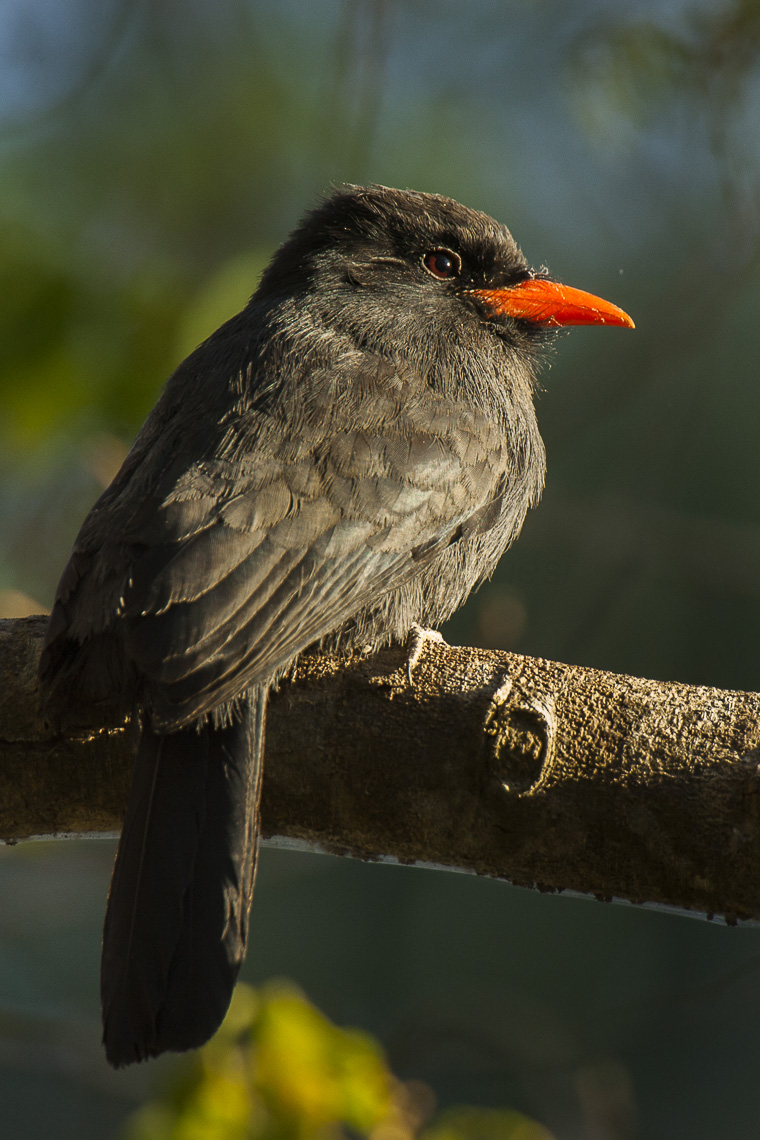
Wikipedia: Black-fronted nunbird Source: OTHER
Black-fronted_Nunbird_-_Brazil_H8O2216.jpg
![]() The black-fronted nunbird (Monasa nigrifrons) is a species of bird in the family Bucconidae, the puffbirds.
[more]
The black-fronted nunbird (Monasa nigrifrons) is a species of bird in the family Bucconidae, the puffbirds.
[more]
Profile Wikipedia eBird Xeno-Canto
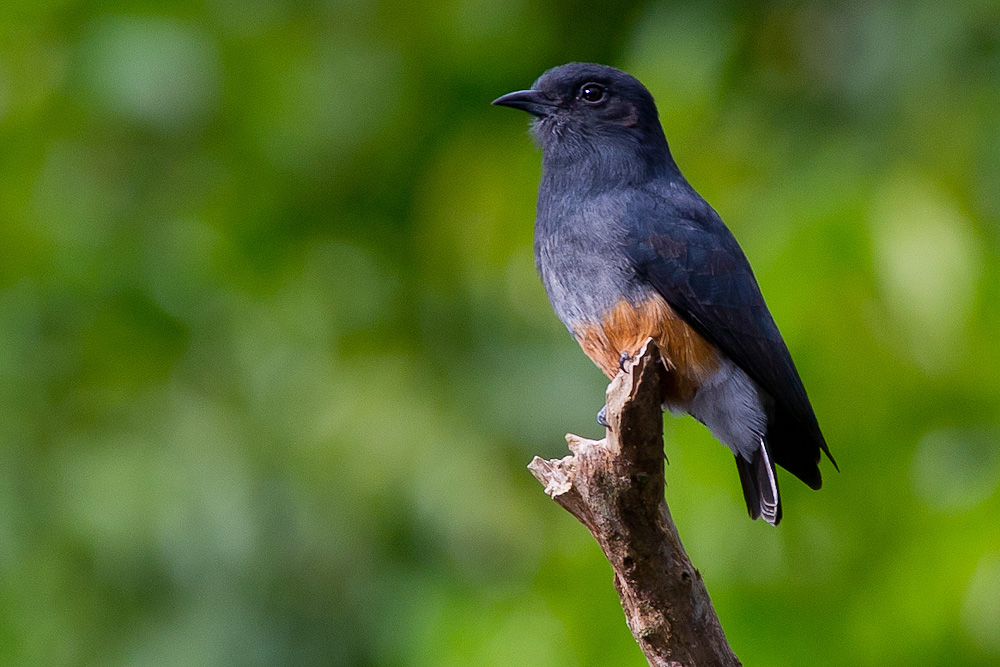
Wikipedia: Swallow-winged puffbird Source: OTHER
Chelidoptera_tenebrosa_Swallow-wing.jpg
![]() The swallow-winged puffbird (Chelidoptera tenebrosa) is a species of bird in the family Bucconidae, the puffbirds. It is also called the swallow-wing. It is the only species in the genus Chelidoptera.[2]
[more]
The swallow-winged puffbird (Chelidoptera tenebrosa) is a species of bird in the family Bucconidae, the puffbirds. It is also called the swallow-wing. It is the only species in the genus Chelidoptera.[2]
[more]
Profile Wikipedia eBird Xeno-Canto

Wikipedia: Speckled chachalaca Source: OTHER
Ortalis_guttata%2C_Speckled_Chachalaca.jpg
![]() The speckled chachalaca (Ortalis guttata) is a species of bird in the family Cracidae. It is found in forests and woodlands in the western Amazon Basin. It has distinct white scaling/spotting on the lower neck and chest, but otherwise it resembles other chachalacas, it being vaguely pheasant-like (though far more arboreal and social), and with an overall brown plumage.
[more]
The speckled chachalaca (Ortalis guttata) is a species of bird in the family Cracidae. It is found in forests and woodlands in the western Amazon Basin. It has distinct white scaling/spotting on the lower neck and chest, but otherwise it resembles other chachalacas, it being vaguely pheasant-like (though far more arboreal and social), and with an overall brown plumage.
[more]
Profile Wikipedia eBird Xeno-Canto

Wikipedia: Rufous-headed chachalaca Source: OTHER
Rufous-headed_Chachalaca.jpg
![]() The rufous-headed chachalaca (Ortalis erythroptera) is a species of bird in the family Cracidae. It is found in Colombia and adjacent Ecuador and Peru. Its natural habitats are subtropical or tropical dry forest, subtropical or tropical moist lowland forest, subtropical or tropical moist montane forest, subtropical or tropical dry shrubland, and plantations . It is threatened by habitat loss.
[more]
The rufous-headed chachalaca (Ortalis erythroptera) is a species of bird in the family Cracidae. It is found in Colombia and adjacent Ecuador and Peru. Its natural habitats are subtropical or tropical dry forest, subtropical or tropical moist lowland forest, subtropical or tropical moist montane forest, subtropical or tropical dry shrubland, and plantations . It is threatened by habitat loss.
[more]
Profile Wikipedia eBird Xeno-Canto
Arenal feeder crested guan eats watermelon. 2018-02-27 13.15.42 Costa Rica
First observed in Costa Rica on 2018-02-26.
![]() The crested guan (Penelope purpurascens) is a member of an ancient group of birds of the family Cracidae, which are related to the Australasian mound builders. It is found in the Neotropics, in lowlands forests ranging from south Mexico and the Yucatán Peninsula to western Ecuador and southern Venezuela. The sexes are similar in appearance; the plumage is mainly dark brown with white spotting, an area of bare skin round the eye, bright red wattles, a bushy crest, a long broad tail and pink legs. It is a social bird, often seen in pairs or small family groups. It feeds in trees, mainly on fruit, and builds a nest of twigs on a branch. The two or three white eggs are incubated by the female. The International Union for Conservation of Nature has rated this bird's conservation status as "least concern".
[more]
The crested guan (Penelope purpurascens) is a member of an ancient group of birds of the family Cracidae, which are related to the Australasian mound builders. It is found in the Neotropics, in lowlands forests ranging from south Mexico and the Yucatán Peninsula to western Ecuador and southern Venezuela. The sexes are similar in appearance; the plumage is mainly dark brown with white spotting, an area of bare skin round the eye, bright red wattles, a bushy crest, a long broad tail and pink legs. It is a social bird, often seen in pairs or small family groups. It feeds in trees, mainly on fruit, and builds a nest of twigs on a branch. The two or three white eggs are incubated by the female. The International Union for Conservation of Nature has rated this bird's conservation status as "least concern".
[more]
Profile Wikipedia eBird Xeno-Canto

Wikipedia: Baudo guan Source: OTHER
1200px-Orton%27s_Guan_%28Penelope_ortoni%29.jpg
![]() The Baudó guan (Penelope ortoni) is a species of bird from the family Cracidae. It is restricted to humid forests in the west Andean foothills of western Colombia and north-western Ecuador. It is highly sensitive to hunting and habitat destruction, with large sections of the main distribution in the Chocó having already disappeared. Consequently, it is considered to be endangered by BirdLife International and IUCN.
[more]
The Baudó guan (Penelope ortoni) is a species of bird from the family Cracidae. It is restricted to humid forests in the west Andean foothills of western Colombia and north-western Ecuador. It is highly sensitive to hunting and habitat destruction, with large sections of the main distribution in the Chocó having already disappeared. Consequently, it is considered to be endangered by BirdLife International and IUCN.
[more]
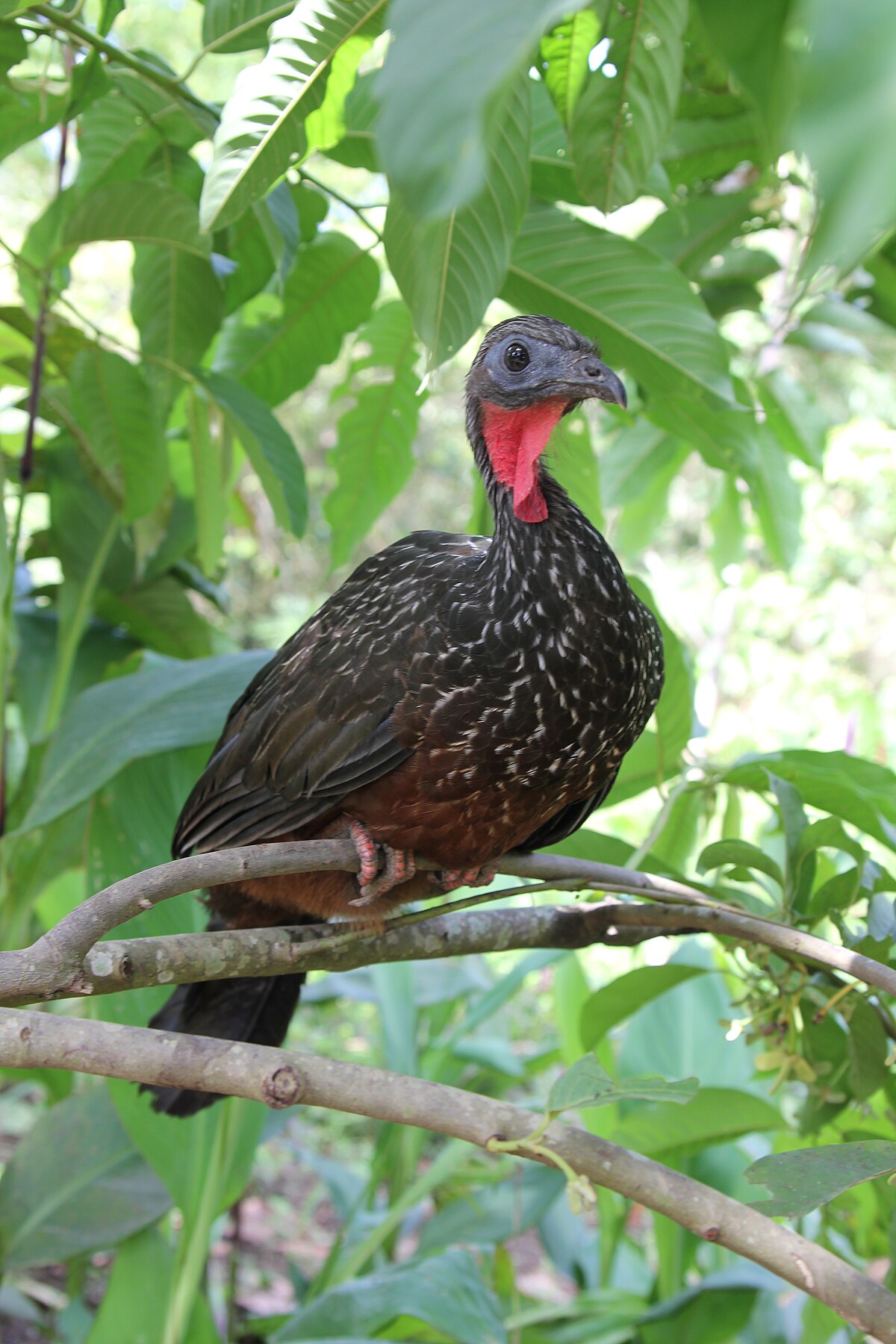
Wikipedia: Spix's guan Source: OTHER
1200px-Penelope_jacquacu_-Manu_National_Park%2C_Peru-8.jpg
![]() Spix's guan (Penelope jacquacu) is a species of bird in the family Cracidae. It is "the prototypical cracid of the Amazonian lowlands."[2] The common name commemorates the German naturalist Johann Baptist von Spix (1782-1826).[3]
[more]
Spix's guan (Penelope jacquacu) is a species of bird in the family Cracidae. It is "the prototypical cracid of the Amazonian lowlands."[2] The common name commemorates the German naturalist Johann Baptist von Spix (1782-1826).[3]
[more]
Profile Wikipedia eBird Xeno-Canto

Wikipedia: Andean guan Source: OTHER
Andean_Guan_%28Penelope_montagnii%29.jpg
![]() The Andean guan (Penelope montagnii) is a gamefowl species of the family Cracidae, in which it belongs to the guan subfamily Penelopinae. This bird occurs in the highlands (5,000 ft/1,500 m ASL and higher) of the Andes, from Venezuela and Colombia through Ecuador and Peru south to Bolivia and perhaps northwesternmost Argentina.[2]
[more]
The Andean guan (Penelope montagnii) is a gamefowl species of the family Cracidae, in which it belongs to the guan subfamily Penelopinae. This bird occurs in the highlands (5,000 ft/1,500 m ASL and higher) of the Andes, from Venezuela and Colombia through Ecuador and Peru south to Bolivia and perhaps northwesternmost Argentina.[2]
[more]
Profile Wikipedia eBird Xeno-Canto

Wikipedia: Bearded guan Source: OTHER
Bearded_Guan.jpg
![]() The bearded guan (Penelope barbata) is a species of bird in the family Cracidae, the chachalacas, guans, and curassows. It is found in Ecuador and Peru. Its natural habitat is subtropical or tropical moist montane forest. It is threatened by habitat loss.
[more]
The bearded guan (Penelope barbata) is a species of bird in the family Cracidae, the chachalacas, guans, and curassows. It is found in Ecuador and Peru. Its natural habitat is subtropical or tropical moist montane forest. It is threatened by habitat loss.
[more]

Wikipedia: Wattled guan Source: OTHER
Wattled_Guan_%288079915812%29.jpg
![]() The wattled guan (Aburria aburri) is a species of bird in the family Cracidae. It is a fairly large black cracid with blue-based, black-tipped beak and a long, red-and-yellow wattle.
[more]
The wattled guan (Aburria aburri) is a species of bird in the family Cracidae. It is a fairly large black cracid with blue-based, black-tipped beak and a long, red-and-yellow wattle.
[more]
Profile Wikipedia eBird Xeno-Canto
Tikal great curassow. 2018-02-07 12.29.42 Guatemala
First observed in Guatemala on 2018-02-07.
![]() The great curassow (Crax rubra) (Spanish: hocofaisán, pavón norteño) is a large, pheasant-like bird from the Neotropical rainforests, its range extending from eastern Mexico, through Central America to western Colombia and northwestern Ecuador. Male birds are black with curly crests and yellow beaks; females come in three colour morphs, barred, rufous and black. These birds form small groups, foraging mainly on the ground for fruits and arthropods, and the occasional small vertebrate, but they roost and nest in trees. This species is monogamous, the male usually building the rather small nest of leaves in which two eggs are laid. This species is threatened by loss of habitat and hunting, and the International Union for Conservation of Nature has rated its conservation status as "vulnerable".
[more]
The great curassow (Crax rubra) (Spanish: hocofaisán, pavón norteño) is a large, pheasant-like bird from the Neotropical rainforests, its range extending from eastern Mexico, through Central America to western Colombia and northwestern Ecuador. Male birds are black with curly crests and yellow beaks; females come in three colour morphs, barred, rufous and black. These birds form small groups, foraging mainly on the ground for fruits and arthropods, and the occasional small vertebrate, but they roost and nest in trees. This species is monogamous, the male usually building the rather small nest of leaves in which two eggs are laid. This species is threatened by loss of habitat and hunting, and the International Union for Conservation of Nature has rated its conservation status as "vulnerable".
[more]
Profile Wikipedia eBird Xeno-Canto

Wikipedia: Wattled curassow Source: OTHER
1200px-Wattled_Curassow_Crax_globulosa_Bird_1400px.jpg
![]() The wattled curassow (Crax globulosa) is a threatened member of the family Cracidae, the curassows, guans, and chachalacas. It is found in remote rainforests in the western Amazon basin in South America. Males have black plumage, except for a white crissum (the area around the cloaca), with curly feathers on the head and red bill ornaments and wattles. Females and juveniles are similar but lack the bill ornamentation and have a reddish-buff crissum area. The wattled curassow is the most ancient lineage of the southern Crax curassows. In captivity, it sometimes hybridises with the blue-billed curassow.
[more]
The wattled curassow (Crax globulosa) is a threatened member of the family Cracidae, the curassows, guans, and chachalacas. It is found in remote rainforests in the western Amazon basin in South America. Males have black plumage, except for a white crissum (the area around the cloaca), with curly feathers on the head and red bill ornaments and wattles. Females and juveniles are similar but lack the bill ornamentation and have a reddish-buff crissum area. The wattled curassow is the most ancient lineage of the southern Crax curassows. In captivity, it sometimes hybridises with the blue-billed curassow.
[more]
Profile Wikipedia eBird Xeno-Canto

Wikipedia: Sickle-winged guan Source: OTHER
1200px-Sickle-winged_Guan.jpg
![]() The sickle-winged guan (Chamaepetes goudotii) is a species of bird in the family Cracidae.
[more]
The sickle-winged guan (Chamaepetes goudotii) is a species of bird in the family Cracidae.
[more]
Profile Wikipedia eBird Xeno-Canto
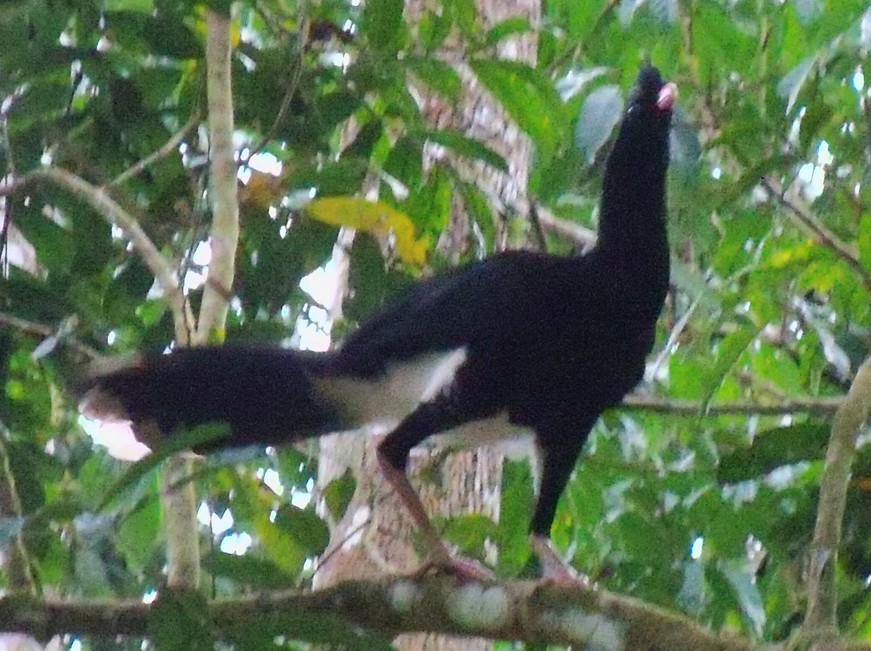
Wikipedia: Salvin's curassow Source: OTHER
Mitu_salvini_57851272_%28cropped%29.jpg
![]() Salvin's curassow (Mitu salvini) is a species of bird in the family Cracidae. It is found in Colombia, Ecuador, and Peru. Its natural habitat is subtropical or tropical moist lowland forest.
[more]
Salvin's curassow (Mitu salvini) is a species of bird in the family Cracidae. It is found in Colombia, Ecuador, and Peru. Its natural habitat is subtropical or tropical moist lowland forest.
[more]
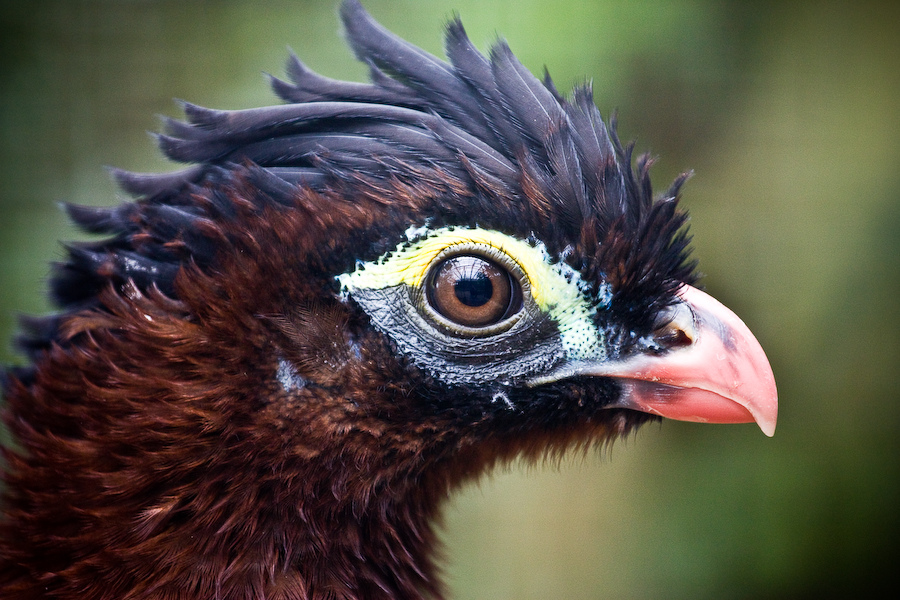
Wikipedia: Nocturnal curassow Source: OTHER
Nothocrax_urumutum_-head_-zoo-8a.jpg
![]() The nocturnal curassow (Nothocrax urumutum) is a species of bird in the family Cracidae. It is found in Brazil, Colombia, Ecuador, Peru, and Venezuela. Its natural habitats are subtropical or tropical moist lowland forest and subtropical or tropical swampland.
[more]
The nocturnal curassow (Nothocrax urumutum) is a species of bird in the family Cracidae. It is found in Brazil, Colombia, Ecuador, Peru, and Venezuela. Its natural habitats are subtropical or tropical moist lowland forest and subtropical or tropical swampland.
[more]
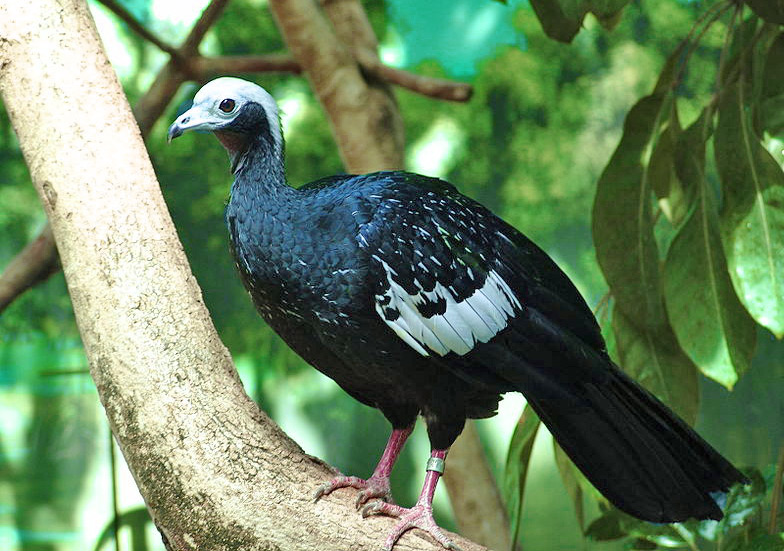
Wikipedia: Blue-throated piping guan Source: OTHER
Pipile_cumanensis_%28Denver_Zoo%292.jpg
![]() The blue-throated piping guan (Pipile cumanensis) is a South American bird of the family Cracidae that is somewhat similar in appearance to the turkey.
[more]
The blue-throated piping guan (Pipile cumanensis) is a South American bird of the family Cracidae that is somewhat similar in appearance to the turkey.
[more]

Wikipedia: Marbled wood quail Source: OTHER
Marbled_Wood-Quail_-_Rio_Tigre_-_Costa_Rica_MG_7758_%2826101675664%29.jpg
![]() The marbled wood quail (Odontophorus gujanensis), also known as the Amazonian wood quail, is a species of bird in the New World quail family. It is found in Bolivia, Brazil, Colombia, Costa Rica, Ecuador, French Guiana, Guyana, Panama, Peru, Suriname, and Venezuela. Its natural habitat is subtropical or tropical moist lowland forests.
[more]
The marbled wood quail (Odontophorus gujanensis), also known as the Amazonian wood quail, is a species of bird in the New World quail family. It is found in Bolivia, Brazil, Colombia, Costa Rica, Ecuador, French Guiana, Guyana, Panama, Peru, Suriname, and Venezuela. Its natural habitat is subtropical or tropical moist lowland forests.
[more]
![]()
Wikipedia: Rufous-breasted wood quail Source: OTHER
1200px-Odontophorus_speciosus_-_1700-1880_-_Print_-_Iconographia_Zoologica_-_Special_Collections_University_of_Amsterdam_-_UBA01_IZ17100191.png
![]() The rufous-breasted wood quail (Odontophorus speciosus) is a species of bird in the family Odontophoridae. It is found in Bolivia, Ecuador, and Peru primarily on the east side of the Andes between 800 and 2000m in elevation (higher in Peru).[2]
[more]
The rufous-breasted wood quail (Odontophorus speciosus) is a species of bird in the family Odontophoridae. It is found in Bolivia, Ecuador, and Peru primarily on the east side of the Andes between 800 and 2000m in elevation (higher in Peru).[2]
[more]
![]() Die Schwarzrückenwachtel (Odontophorus melanonotus) ist eine wenig erforschte Vogelart aus der Familie der Zahnwachteln (Odontophoridae). Sie kommt in Ecuador und in Kolumbien vor.
[more]
Die Schwarzrückenwachtel (Odontophorus melanonotus) ist eine wenig erforschte Vogelart aus der Familie der Zahnwachteln (Odontophoridae). Sie kommt in Ecuador und in Kolumbien vor.
[more]

Wikipedia: Rufous-fronted wood quail Source: OTHER
Odontophorus_erythrops_parambae_1897.jpg
![]() The rufous-fronted wood quail (Odontophorus erythrops) is a species of bird in the family Odontophoridae.
[more]
The rufous-fronted wood quail (Odontophorus erythrops) is a species of bird in the family Odontophoridae.
[more]

Wikipedia: Starred wood quail Source: OTHER
Odontophorus_stellatus.jpg
![]() The starred wood quail (Odontophorus stellatus) is a species of bird in the family Odontophoridae (New World quail). It is found in subtropical or tropical moist lowland forests of Bolivia, Brazil, Ecuador, and Peru.
[more]
The starred wood quail (Odontophorus stellatus) is a species of bird in the family Odontophoridae (New World quail). It is found in subtropical or tropical moist lowland forests of Bolivia, Brazil, Ecuador, and Peru.
[more]
Profile Wikipedia eBird Xeno-Canto

Wikipedia: Tawny-faced quail Source: OTHER
1200px-Rhynchortyx_cinctus.jpg
![]() The tawny-faced quail (Rhynchortyx cinctus) is a species of bird in the family Odontophoridae, and the only species in its genus Rhynchortyx.
[more]
The tawny-faced quail (Rhynchortyx cinctus) is a species of bird in the family Odontophoridae, and the only species in its genus Rhynchortyx.
[more]
Profile Wikipedia eBird Xeno-Canto

Wikipedia: Spot-fronted swift Source: OTHER
1200px-Cypseloides_cherriei_map.svg.png
![]() The spot-fronted swift (Cypseloides cherriei) is a species of swift in the family Apodidae. It is found in Colombia, Costa Rica, Ecuador and western Venezuela. Its natural habitat is subtropical or tropical moist montane forests. The scientific name commemorates the specimen collector George K. Cherrie.
[more]
The spot-fronted swift (Cypseloides cherriei) is a species of swift in the family Apodidae. It is found in Colombia, Costa Rica, Ecuador and western Venezuela. Its natural habitat is subtropical or tropical moist montane forests. The scientific name commemorates the specimen collector George K. Cherrie.
[more]
Profile Wikipedia eBird Xeno-Canto

Wikipedia: White-chinned swift Source: OTHER
1200px-Cypseloides_cryptus_map.svg.png
![]() The white-chinned swift (Cypseloides cryptus) is a species of swift in the family Apodidae. It is found in Belize, Colombia, Costa Rica, Ecuador, Guyana, Honduras, Mexico, Nicaragua, Panama, Peru, and Venezuela. Its natural habitats are subtropical or tropical moist lowland forests and subtropical or tropical moist montane forests.
[more]
The white-chinned swift (Cypseloides cryptus) is a species of swift in the family Apodidae. It is found in Belize, Colombia, Costa Rica, Ecuador, Guyana, Honduras, Mexico, Nicaragua, Panama, Peru, and Venezuela. Its natural habitats are subtropical or tropical moist lowland forests and subtropical or tropical moist montane forests.
[more]
Profile Wikipedia eBird Xeno-Canto

Wikipedia: White-chested swift Source: OTHER
1200px-Cypseloides_lemosi.jpg
![]() The white-chested swift (Cypseloides lemosi) is a species of swift in the family Apodidae.
It is found in Colombia, Ecuador, and Peru.
Its natural habitat is heavily degraded former forest.
[more]
The white-chested swift (Cypseloides lemosi) is a species of swift in the family Apodidae.
It is found in Colombia, Ecuador, and Peru.
Its natural habitat is heavily degraded former forest.
[more]
Profile Wikipedia eBird Xeno-Canto

Wikipedia: White-collared swift Source: OTHER
Streptoprocne_zonaris%2C_White-collared_Swift.jpg
![]() The white-collared swift (Streptoprocne zonaris) is a resident breeding bird from central Mexico, the Greater Antilles and Trinidad south to Peru, northern Argentina and southeastern Brazil.
[more]
The white-collared swift (Streptoprocne zonaris) is a resident breeding bird from central Mexico, the Greater Antilles and Trinidad south to Peru, northern Argentina and southeastern Brazil.
[more]
Profile Wikipedia eBird Audubon AllAboutBirds Xeno-Canto

Wikipedia: Chimney swift Source: OTHER
Chimney_swift_overhead.jpg
![]() The chimney swift (Chaetura pelagica) is a bird belonging to the swift family Apodidae. A member of the genus Chaetura, it is closely related to both the Vaux's swift and the Chapman's swift; in the past, the three were sometimes considered to be conspecific. It has no subspecies. The chimney swift is a medium-sized, sooty gray bird with very long, slender wings and very short legs. Like all swifts, it is incapable of perching, and can only cling vertically to surfaces.
[more]
The chimney swift (Chaetura pelagica) is a bird belonging to the swift family Apodidae. A member of the genus Chaetura, it is closely related to both the Vaux's swift and the Chapman's swift; in the past, the three were sometimes considered to be conspecific. It has no subspecies. The chimney swift is a medium-sized, sooty gray bird with very long, slender wings and very short legs. Like all swifts, it is incapable of perching, and can only cling vertically to surfaces.
[more]
Profile Wikipedia eBird Audubon AllAboutBirds Xeno-Canto
Wikipedia: Short-tailed swift Source: OTHER
Chaetura_brachyura_-_Short-tailed_Swift.JPG
![]() The short-tailed swift (Chaetura brachyura) is a bird in the Apodidae, or swift family.
[more]
The short-tailed swift (Chaetura brachyura) is a bird in the Apodidae, or swift family.
[more]
Profile Wikipedia eBird Xeno-Canto

Wikipedia: Gray-rumped swift Source: OTHER
1200px-Chaetura_cinereiventris_cinereiventris.jpg
![]() The grey-rumped swift (Chaetura cinereiventris) is a small swift.
[more]
The grey-rumped swift (Chaetura cinereiventris) is a small swift.
[more]
Profile Wikipedia eBird Xeno-Canto
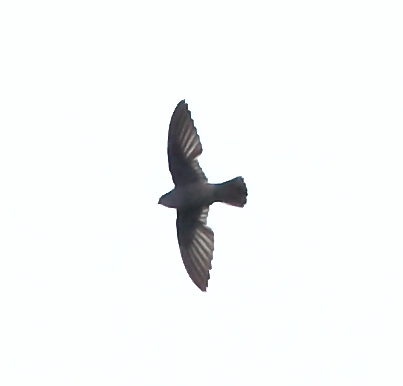
Wikipedia: Band-rumped swift Source: OTHER
Chaetura_spinicaudus_-_Band-rumped_Swift.jpg
![]() The band-rumped swift (Chaetura spinicaudus) is a small swift. Until 1998, it was known as Chaetura spinicauda. At that time, the previously considered subspecies Costa Rican swift, Chaetura fumosa, was split from this species and the scientific name was modified from C. spinacauda to C. spinacaudus.
[more]
The band-rumped swift (Chaetura spinicaudus) is a small swift. Until 1998, it was known as Chaetura spinicauda. At that time, the previously considered subspecies Costa Rican swift, Chaetura fumosa, was split from this species and the scientific name was modified from C. spinacauda to C. spinacaudus.
[more]
Profile Wikipedia eBird Xeno-Canto
![]() The pale-rumped swift (Chaetura egregia) is a species of swift in the family Apodidae.
It is found in Bolivia, Brazil, Ecuador, and Peru.
Its natural habitat is subtropical or tropical moist lowland forests.
[more]
The pale-rumped swift (Chaetura egregia) is a species of swift in the family Apodidae.
It is found in Bolivia, Brazil, Ecuador, and Peru.
Its natural habitat is subtropical or tropical moist lowland forests.
[more]
Profile Wikipedia eBird Xeno-Canto

Wikipedia: White-tipped swift Source: OTHER
1200px-Aeronautes_montivagus_1847.jpg
![]() The white-tipped swift (Aeronautes montivagus) is a species of swift in the family Apodidae.
It is found in Argentina, Bolivia, Brazil, Colombia, Ecuador, Guyana, Peru, and Venezuela.
Its natural habitats are subtropical or tropical moist lowland forests, subtropical or tropical moist montane forests, and heavily degraded former forest.
[more]
The white-tipped swift (Aeronautes montivagus) is a species of swift in the family Apodidae.
It is found in Argentina, Bolivia, Brazil, Colombia, Ecuador, Guyana, Peru, and Venezuela.
Its natural habitats are subtropical or tropical moist lowland forests, subtropical or tropical moist montane forests, and heavily degraded former forest.
[more]
Profile Wikipedia eBird Xeno-Canto

Wikipedia: Fork-tailed palm-swift Source: OTHER
1200px-CypselusSquamatusWolf.jpg
![]() The Neotropical palm swift or fork-tailed palm swift (Tachornis squamata) is a swift native to tropical South America (from Colombia, Venezuela, the Guianas south to northeastern Peru and Brazil) and Trinidad in the Caribbean.
[more]
The Neotropical palm swift or fork-tailed palm swift (Tachornis squamata) is a swift native to tropical South America (from Colombia, Venezuela, the Guianas south to northeastern Peru and Brazil) and Trinidad in the Caribbean.
[more]
Profile Wikipedia eBird Xeno-Canto
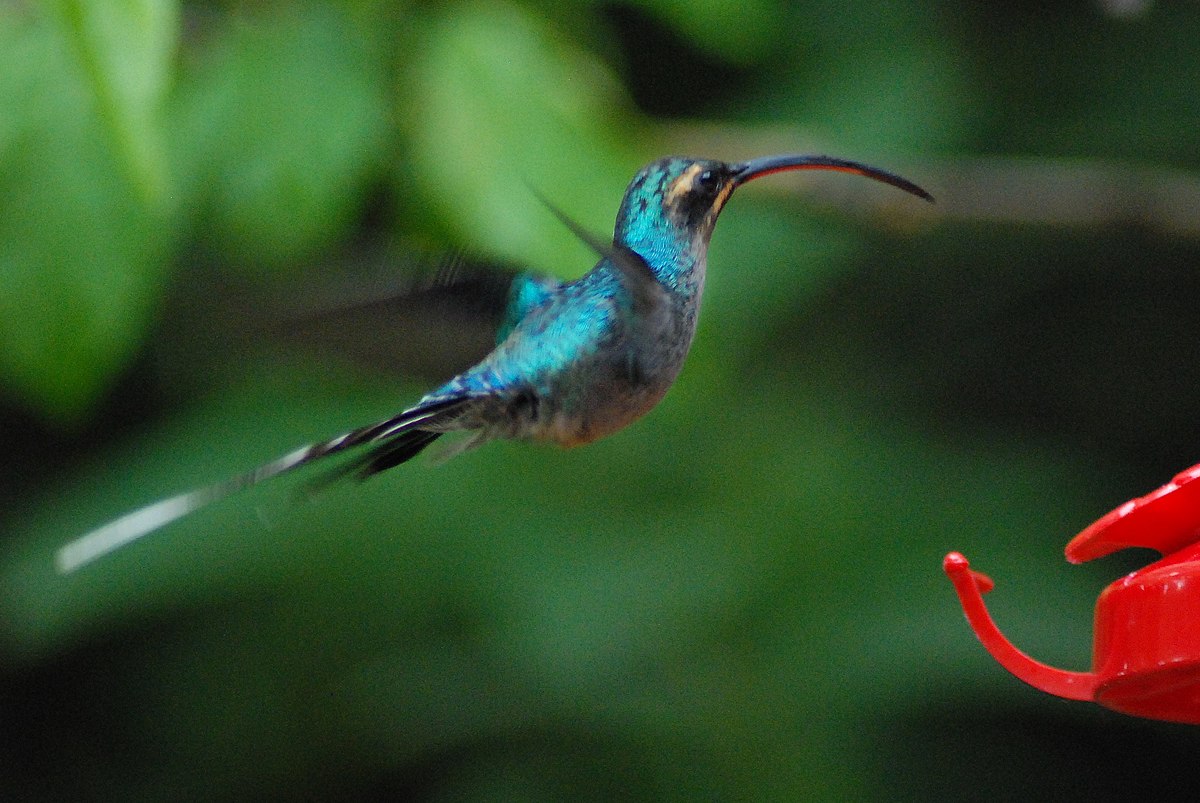
Wikipedia: Green hermit Source: OTHER
1200px-Phaethornis_guy.jpg
![]() The green hermit (Phaethornis guy) is a large hummingbird that is a resident breeder from southern Central America (Costa Rica and Panama) south to northern South America (north-eastern Venezuela and Trinidad, and the northern Andes of eastern Peru)
[more]
The green hermit (Phaethornis guy) is a large hummingbird that is a resident breeder from southern Central America (Costa Rica and Panama) south to northern South America (north-eastern Venezuela and Trinidad, and the northern Andes of eastern Peru)
[more]
Profile Wikipedia eBird Xeno-Canto

Wikipedia: Long-billed hermit Source: OTHER
1200px-Phaethornis_longirostris.jpg
![]() The long-billed hermit (Phaethornis longirostris) is a large hummingbird that is a resident breeder from central Mexico south to northwestern Colombia, extreme western Venezuela and western Ecuador. This species was formerly known as the western long-tailed hermit or just long-tailed hermit, but was renamed to highlight its unusual bill.
[more]
The long-billed hermit (Phaethornis longirostris) is a large hummingbird that is a resident breeder from central Mexico south to northwestern Colombia, extreme western Venezuela and western Ecuador. This species was formerly known as the western long-tailed hermit or just long-tailed hermit, but was renamed to highlight its unusual bill.
[more]
Profile Wikipedia eBird Xeno-Canto
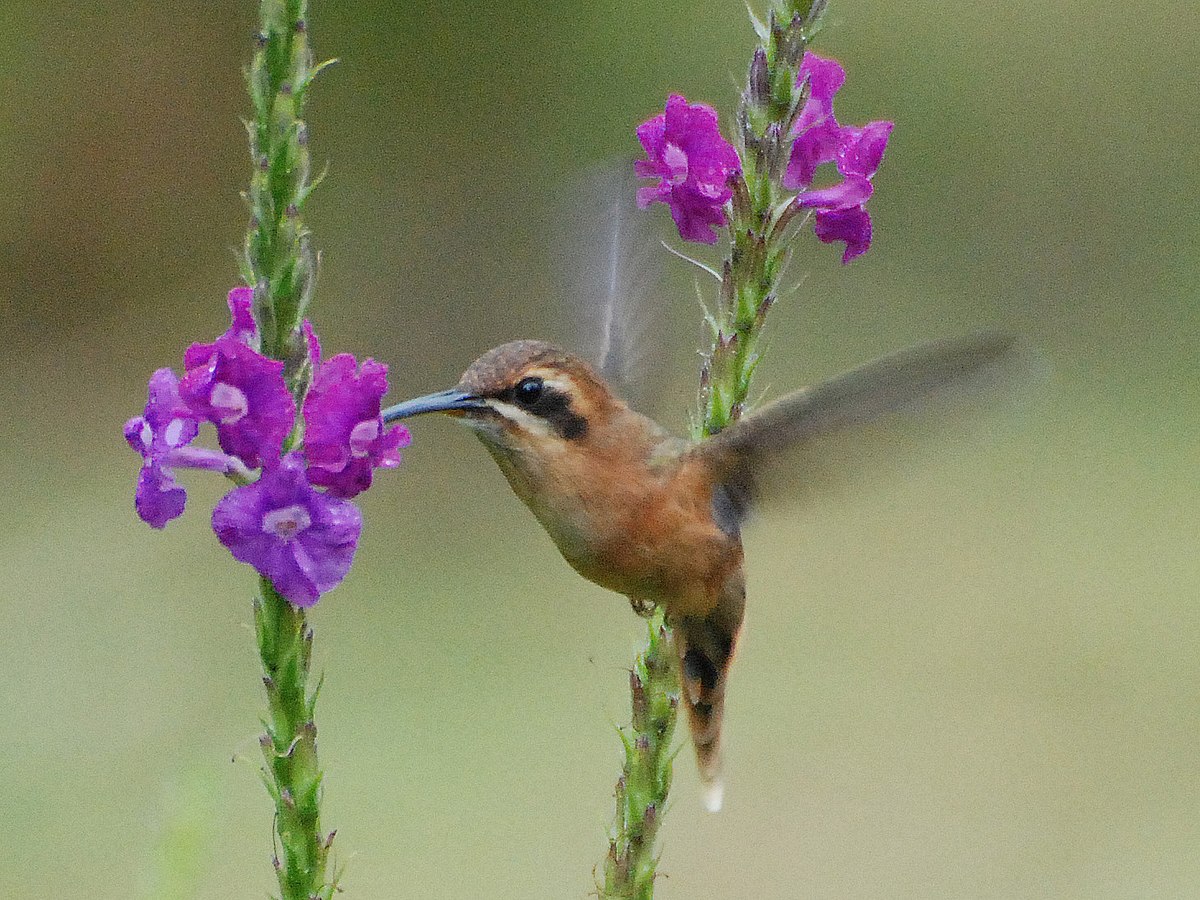
Wikipedia: Stripe-throated hermit Source: OTHER
1200px-Phaethornis_striigularis.jpg
![]() The stripe-throated hermit (Phaethornis striigularis) is a species of hummingbird from Central America and north-western South America. It is generally fairly common and considered Least Concern by BirdLife International.
[more]
The stripe-throated hermit (Phaethornis striigularis) is a species of hummingbird from Central America and north-western South America. It is generally fairly common and considered Least Concern by BirdLife International.
[more]
Profile Wikipedia eBird Xeno-Canto

Wikipedia: Tawny-bellied hermit Source: OTHER
Tawny-bellied_Hermit_%28Phaethornis_syrmatophorus%29.jpg
![]() The tawny-bellied hermit (Phaethornis syrmatophorus) is a species of hummingbird. It is found in the mountains of Colombia, Ecuador, and Peru usually in humid forest understory and undergrowth.[2][3] This is where it spends its time foraging for arthropods and nectar via traplining like the diet of most if not all hummingbirds.[2][3] It thrives in elevations above 1000m, where at lower levels it is gradually replaced by the White-Whiskered Hermit.[4]
[more]
The tawny-bellied hermit (Phaethornis syrmatophorus) is a species of hummingbird. It is found in the mountains of Colombia, Ecuador, and Peru usually in humid forest understory and undergrowth.[2][3] This is where it spends its time foraging for arthropods and nectar via traplining like the diet of most if not all hummingbirds.[2][3] It thrives in elevations above 1000m, where at lower levels it is gradually replaced by the White-Whiskered Hermit.[4]
[more]
Profile Wikipedia eBird Xeno-Canto
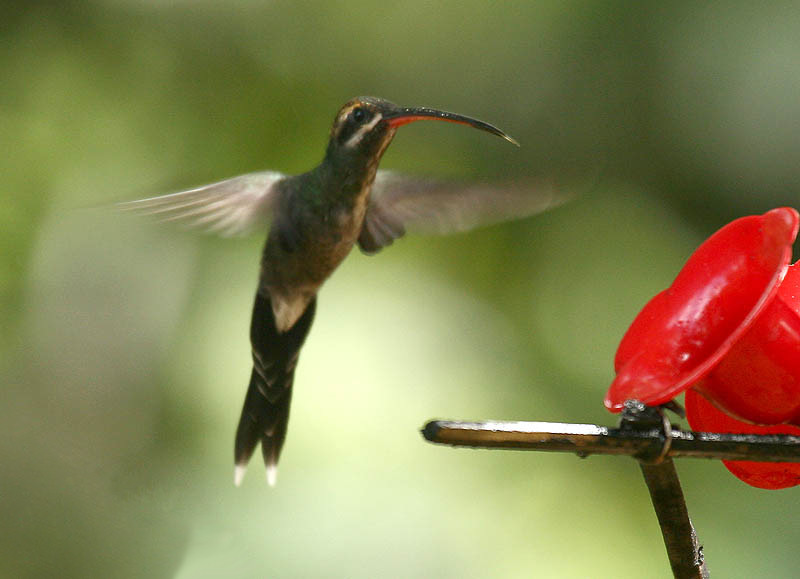
Wikipedia: White-whiskered hermit Source: OTHER
White-whiskered_Hermit_%28Phaethornis_yaruqui%29.jpg
![]() The white-whiskered hermit (Phaethornis yaruqui) is a hummingbird that is found in Colombia and Ecuador.
[more]
The white-whiskered hermit (Phaethornis yaruqui) is a hummingbird that is found in Colombia and Ecuador.
[more]

Wikipedia: Great-billed hermit Source: OTHER
1200px-Phaethornis_malaris_-_Great-billed_Hermit%3B_Serra_do_Divisor_Nationa_Park%2C_Acre%2C_Brazil.jpg
![]() The great-billed hermit (Phaethornis malaris) is a species of hummingbird in the family Trochilidae.
It is found in Bolivia, Brazil, Colombia, Ecuador, French Guiana, Peru, Suriname, and Venezuela.
Its natural habitat is subtropical or tropical moist lowland forest.
[more]
The great-billed hermit (Phaethornis malaris) is a species of hummingbird in the family Trochilidae.
It is found in Bolivia, Brazil, Colombia, Ecuador, French Guiana, Peru, Suriname, and Venezuela.
Its natural habitat is subtropical or tropical moist lowland forest.
[more]
Profile Wikipedia eBird Xeno-Canto

Wikipedia: Straight-billed hermit Source: OTHER
1200px-Straight-billed_Hermit_%28Phaethornis_bourcieri%29.jpg
![]() The straight-billed hermit (Phaethornis bourcieri) is a species of bird in the family Trochilidae, the hummingbirds.
[more]
The straight-billed hermit (Phaethornis bourcieri) is a species of bird in the family Trochilidae, the hummingbirds.
[more]
Profile Wikipedia eBird Xeno-Canto
![]() The black-throated hermit (Phaethornis atrimentalis) is a species of hummingbird in the family Trochilidae. This small hermit is found in the western Amazon in Colombia, Ecuador, and Peru. Its diet pertains to anthropods and flowering plants such as Costus, Aechmea, Palicourea and Drymonia.[2]
[more]
The black-throated hermit (Phaethornis atrimentalis) is a species of hummingbird in the family Trochilidae. This small hermit is found in the western Amazon in Colombia, Ecuador, and Peru. Its diet pertains to anthropods and flowering plants such as Costus, Aechmea, Palicourea and Drymonia.[2]
[more]
Profile Wikipedia eBird Xeno-Canto

Wikipedia: White-bearded hermit Source: OTHER
1200px-MonographTrochi1Goul_0232.jpg
![]() The white-bearded hermit (Phaethornis hispidus) is a species of hummingbird in the family Trochilidae.
[more]
The white-bearded hermit (Phaethornis hispidus) is a species of hummingbird in the family Trochilidae.
[more]
Profile Wikipedia eBird Xeno-Canto

Wikipedia: Reddish hermit Source: OTHER
Reddish_Hermit_-.jpg
![]() The reddish hermit (Phaethornis ruber) is a species of bird in the family Trochilidae, the hummingbirds. It is found in Bolivia, Brazil, Colombia, Ecuador, Peru, Venezuela, and in the Guianas. At 7.5 cm (3 in) and a weight under 3 grams, it is among the smallest of the hermits and smallest birds overall.[2] Its natural habitats are forest and woodland, primarily humid.
[more]
The reddish hermit (Phaethornis ruber) is a species of bird in the family Trochilidae, the hummingbirds. It is found in Bolivia, Brazil, Colombia, Ecuador, Peru, Venezuela, and in the Guianas. At 7.5 cm (3 in) and a weight under 3 grams, it is among the smallest of the hermits and smallest birds overall.[2] Its natural habitats are forest and woodland, primarily humid.
[more]
Profile Wikipedia eBird Xeno-Canto

Wikipedia: Gray-chinned hermit Source: OTHER
Grey-chinned_Hermit.jpg
![]() The grey-chinned hermit (Phaethornis griseogularis) is a species of hummingbird in the family Trochilidae. It is found in Colombia, Ecuador, Peru, Venezuela, and - marginally - far northern Brazil. Its natural habitats are subtropical or tropical dry forest, subtropical or tropical moist montane forest, and heavily degraded former forest. This is not a quiet species, where it will often sing and have audible wing noises.[2]
[more]
The grey-chinned hermit (Phaethornis griseogularis) is a species of hummingbird in the family Trochilidae. It is found in Colombia, Ecuador, Peru, Venezuela, and - marginally - far northern Brazil. Its natural habitats are subtropical or tropical dry forest, subtropical or tropical moist montane forest, and heavily degraded former forest. This is not a quiet species, where it will often sing and have audible wing noises.[2]
[more]

Wikipedia: Shining sunbeam Source: OTHER
Shining_Sunbeam_%28Aglaeactis_cupripennis%29.jpg
![]() The Shining sunbeam (Aglaeactis cupripennis) is a species of hummingbird in the family Trochilidae. It is found in Colombia, Ecuador, and Peru. Its natural habitats are subtropical or tropical moist montane forest and subtropical or tropical high-altitude shrubland.
[more]
The Shining sunbeam (Aglaeactis cupripennis) is a species of hummingbird in the family Trochilidae. It is found in Colombia, Ecuador, and Peru. Its natural habitats are subtropical or tropical moist montane forest and subtropical or tropical high-altitude shrubland.
[more]
Profile Wikipedia eBird Xeno-Canto
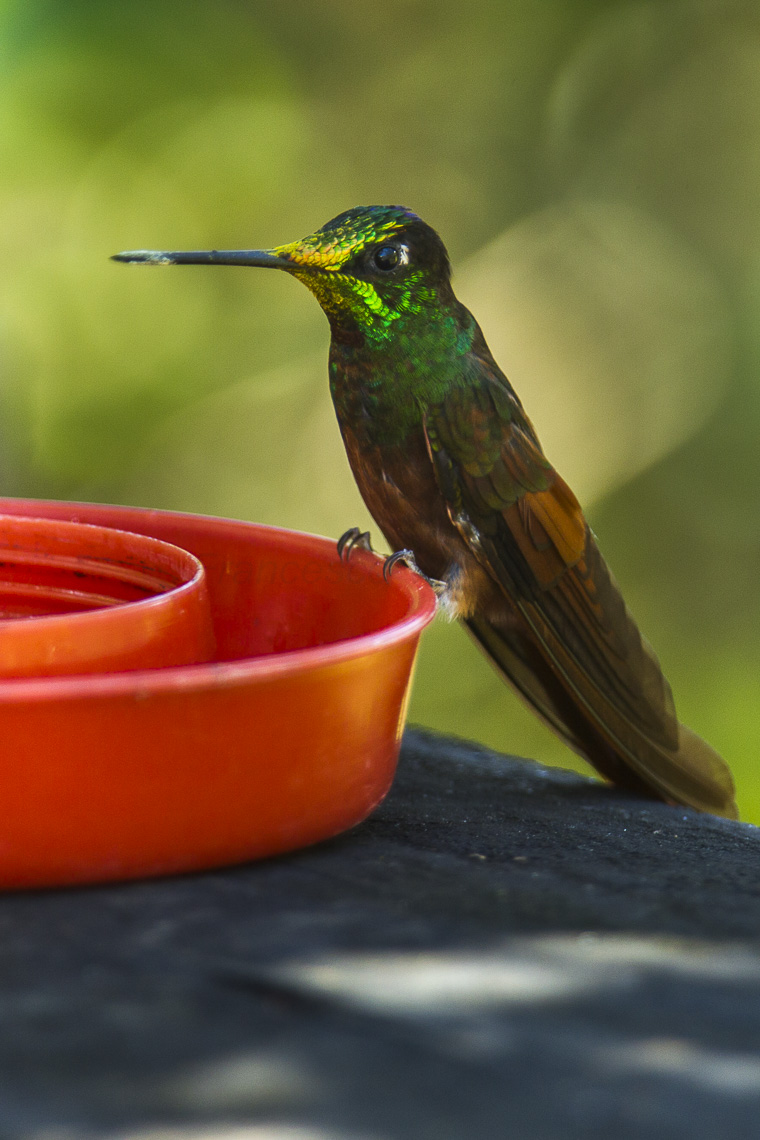
Wikipedia: Rainbow starfrontlet Source: OTHER
Rainbow_Starfrontlet_-_Ecuador_S4E0095.jpg
![]() The rainbow starfrontlet (Coeligena iris) is a species of hummingbird in the family Trochilidae. It is found in Ecuador and Peru. Its natural habitats are subtropical or tropical moist montane forest, subtropical or tropical high-altitude shrubland, at elevations of 1500 – 3300 m, and heavily degraded former forest. They can be seen along the edges of forests and adjacent shrubby areas.
[more]
The rainbow starfrontlet (Coeligena iris) is a species of hummingbird in the family Trochilidae. It is found in Ecuador and Peru. Its natural habitats are subtropical or tropical moist montane forest, subtropical or tropical high-altitude shrubland, at elevations of 1500 – 3300 m, and heavily degraded former forest. They can be seen along the edges of forests and adjacent shrubby areas.
[more]
Profile Wikipedia eBird Xeno-Canto

Wikipedia: Bronzy Inca Source: OTHER
1200px-Coeligena_coeligena_-NBII_Image_Gallery-a00195.jpg
![]() The bronzy inca (Coeligena coeligena) is a species of hummingbird in the family Trochilidae. It is found in Bolivia, Colombia, Ecuador, Peru, and Venezuela.
[more]
The bronzy inca (Coeligena coeligena) is a species of hummingbird in the family Trochilidae. It is found in Bolivia, Colombia, Ecuador, Peru, and Venezuela.
[more]
Profile Wikipedia eBird Xeno-Canto

Wikipedia: Brown Inca Source: OTHER
Brown_Inca_%28Coeligena_wilsoni%29.jpg
![]() The brown inca (Coeligena wilsoni) is a species of hummingbird found in forests between 1000 and 2800 m along the Pacific slope of the Andes from western Colombia to southern Ecuador.
[more]
The brown inca (Coeligena wilsoni) is a species of hummingbird found in forests between 1000 and 2800 m along the Pacific slope of the Andes from western Colombia to southern Ecuador.
[more]

Wikipedia: Collared inca Source: OTHER
1200px-Coeligena_torquata.jpg
![]() The collared inca (Coeligena torquata) is a species of hummingbird found in humid Andean forests from western Venezuela, through Colombia and Ecuador, to Peru and Bolivia. It is very distinctive and unique in having a white chest-patch and white on the tail. Like other hummingbirds it takes energy from flower nectar (especially from bromeliads), while the plant benefits from the symbiotic relationship by being pollinated. Its protein source is small arthropods such as insects. It is normally solitary and can be found at varying heights above the ground, often in the open.[2]
[more]
The collared inca (Coeligena torquata) is a species of hummingbird found in humid Andean forests from western Venezuela, through Colombia and Ecuador, to Peru and Bolivia. It is very distinctive and unique in having a white chest-patch and white on the tail. Like other hummingbirds it takes energy from flower nectar (especially from bromeliads), while the plant benefits from the symbiotic relationship by being pollinated. Its protein source is small arthropods such as insects. It is normally solitary and can be found at varying heights above the ground, often in the open.[2]
[more]
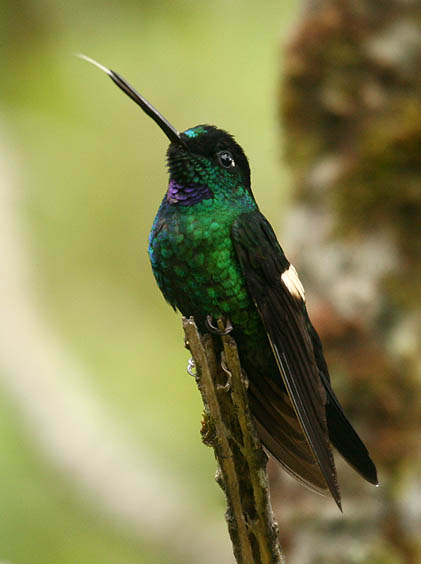
Wikipedia: Buff-winged starfrontlet Source: OTHER
Buff-Winged_Starfrontlet_%28Coeligena_lutetiae%29.jpg
![]() The buff-winged starfrontlet (Coeligena lutetiae) is a species of hummingbird in the family Trochilidae.
It is found in Colombia, Ecuador, and Peru.
Its natural habitat is subtropical or tropical moist montane forest.
[more]
The buff-winged starfrontlet (Coeligena lutetiae) is a species of hummingbird in the family Trochilidae.
It is found in Colombia, Ecuador, and Peru.
Its natural habitat is subtropical or tropical moist montane forest.
[more]
Profile Wikipedia eBird Xeno-Canto

Wikipedia: Turquoise-throated puffleg Source: OTHER
1200px-Eriocnemis_godini.jpg
![]() The turquoise-throated puffleg (Eriocnemis godini), also known as Godin's puffleg, is a species of hummingbird from Ecuador. It is mostly green with blue undertail coverts and white powder-puffs of downy feathers on the legs, and the male has a bluish-purple throat patch. It is only known from a few specimens taken in the nineteenth century and its taxonomic position is unclear. The type of habitat in which the type species was recovered has largely disappeared, and recent surveys trying to find this bird have failed. The International Union for Conservation of Nature believes it may be extinct, but there is a possibility that some individuals remain, so the bird has been rated as "critically endangered".
[more]
The turquoise-throated puffleg (Eriocnemis godini), also known as Godin's puffleg, is a species of hummingbird from Ecuador. It is mostly green with blue undertail coverts and white powder-puffs of downy feathers on the legs, and the male has a bluish-purple throat patch. It is only known from a few specimens taken in the nineteenth century and its taxonomic position is unclear. The type of habitat in which the type species was recovered has largely disappeared, and recent surveys trying to find this bird have failed. The International Union for Conservation of Nature believes it may be extinct, but there is a possibility that some individuals remain, so the bird has been rated as "critically endangered".
[more]
Profile Wikipedia eBird Xeno-Canto

Wikipedia: Golden-breasted puffleg Source: OTHER
Golden-Breasted_Puffleg_%28Eriocnemis_mosquera%29.jpg
![]() The golden-breasted puffleg (Eriocnemis mosquera) is a species of hummingbird in the family Trochilidae.
[more]
The golden-breasted puffleg (Eriocnemis mosquera) is a species of hummingbird in the family Trochilidae.
[more]
Profile Wikipedia eBird Xeno-Canto

Wikipedia: Black-breasted puffleg Source: OTHER
1200px-MonographTrochi4Goul_0302.jpg
![]() The black-breasted puffleg (Eriocnemis nigrivestis) is a species of hummingbird native to Ecuador. It is Endangered, with less than 300 individuals remaining in the wild.
[more]
The black-breasted puffleg (Eriocnemis nigrivestis) is a species of hummingbird native to Ecuador. It is Endangered, with less than 300 individuals remaining in the wild.
[more]
Profile Wikipedia eBird Xeno-Canto

Wikipedia: Emerald-bellied puffleg Source: OTHER
1200px-MonographTrochi4Goul_0318.jpg
![]() The emerald-bellied puffleg (Eriocnemis aline) is a species of hummingbird in the family Trochilidae. It is found in Colombia, Ecuador, and Peru. Its natural habitats are subtropical or tropical moist montane forest and heavily degraded former forest.
[more]
The emerald-bellied puffleg (Eriocnemis aline) is a species of hummingbird in the family Trochilidae. It is found in Colombia, Ecuador, and Peru. Its natural habitats are subtropical or tropical moist montane forest and heavily degraded former forest.
[more]
Profile Wikipedia eBird Xeno-Canto

Wikipedia: Sapphire-vented puffleg Source: OTHER
Sapphire-Vented_Puffleg_%28Eriocnemis_luciani%29.jpg
![]() The sapphire-vented puffleg (Eriocnemis luciani) is a species of hummingbird in the family Trochilidae.
It is found in Colombia, Ecuador, Peru, and Venezuela.
Its natural habitat is subtropical or tropical moist montane forest. It sometimes includes the coppery-naped puffleg as a subspecies.
[more]
The sapphire-vented puffleg (Eriocnemis luciani) is a species of hummingbird in the family Trochilidae.
It is found in Colombia, Ecuador, Peru, and Venezuela.
Its natural habitat is subtropical or tropical moist montane forest. It sometimes includes the coppery-naped puffleg as a subspecies.
[more]
Profile Wikipedia eBird Xeno-Canto

Wikipedia: Black-thighed puffleg Source: OTHER
1200px-Eriocnemis_derbyi_%28Paramero_rabihorcado%29_%2815484965256%29.jpg
![]() The black-thighed puffleg (Eriocnemis derbyi) is a species of hummingbird in the family Trochilidae. It is found at humid forest edge and ravines in the Andean highlands of Colombia and northern Ecuador. It is threatened by habitat loss. As suggested by its name, the feathering around its legs is black, which is unique among the pufflegs. Otherwise its plumage is green with a contrastingly black tail.
[more]
The black-thighed puffleg (Eriocnemis derbyi) is a species of hummingbird in the family Trochilidae. It is found at humid forest edge and ravines in the Andean highlands of Colombia and northern Ecuador. It is threatened by habitat loss. As suggested by its name, the feathering around its legs is black, which is unique among the pufflegs. Otherwise its plumage is green with a contrastingly black tail.
[more]

Wikipedia: Glowing puffleg Source: OTHER
1200px-Eriocnemis_vestitus.jpg
![]() The glowing puffleg (Eriocnemis vestita) is a species of hummingbird in the family Trochilidae.
[more]
The glowing puffleg (Eriocnemis vestita) is a species of hummingbird in the family Trochilidae.
[more]
Profile Wikipedia eBird Xeno-Canto

Wikipedia: Mountain velvetbreast Source: OTHER
Mountain_Velvetbreast_%28Lafresnaya_lafresnayi%29.jpg
![]() The mountain velvetbreast (Lafresnaya lafresnayi) is a species in the family Trochilidae, the family to which all hummingbirds belong. It is the only member of its genus and is found in the Andes, mostly between 2400 and 3500 m (7,900 to 11,500 ft), of northwestern Venezuela, Colombia, Ecuador, and Peru. Its natural habitats are clearings and bushes at the edges of subtropical or tropical moist montane forests and heavily degraded forests.
[more]
The mountain velvetbreast (Lafresnaya lafresnayi) is a species in the family Trochilidae, the family to which all hummingbirds belong. It is the only member of its genus and is found in the Andes, mostly between 2400 and 3500 m (7,900 to 11,500 ft), of northwestern Venezuela, Colombia, Ecuador, and Peru. Its natural habitats are clearings and bushes at the edges of subtropical or tropical moist montane forests and heavily degraded forests.
[more]
Profile Wikipedia eBird Xeno-Canto

Wikipedia: Black-tailed trainbearer Source: OTHER
Black-tailed_Trainbearer_%28Lesbia_victoriae%29.jpg
![]() The black-tailed trainbearer (Lesbia victoriae) is a species of hummingbird in the family Trochilidae. It is found between 2500 and 3800m in Colombia, Ecuador, and Peru. Its natural habitats are subtropical or tropical moist montane forest, subtropical or tropical high-altitude shrubland, and heavily degraded former forest.
[more]
The black-tailed trainbearer (Lesbia victoriae) is a species of hummingbird in the family Trochilidae. It is found between 2500 and 3800m in Colombia, Ecuador, and Peru. Its natural habitats are subtropical or tropical moist montane forest, subtropical or tropical high-altitude shrubland, and heavily degraded former forest.
[more]
Profile Wikipedia eBird Xeno-Canto

Wikipedia: Green-tailed trainbearer Source: OTHER
1200px-Lesbia_nuna.jpg
![]() The green-tailed trainbearer (Lesbia nuna) is a species of hummingbird in the family Trochilidae.
It is found in Bolivia, Colombia, Ecuador, Peru, and Venezuela.
Its natural habitats are subtropical or tropical high-altitude shrubland and heavily degraded former forest.
[more]
The green-tailed trainbearer (Lesbia nuna) is a species of hummingbird in the family Trochilidae.
It is found in Bolivia, Colombia, Ecuador, Peru, and Venezuela.
Its natural habitats are subtropical or tropical high-altitude shrubland and heavily degraded former forest.
[more]
Profile Wikipedia eBird Xeno-Canto

Wikipedia: Violet-throated metaltail Source: OTHER
1200px-Metallura_baroni_1894.jpg
![]() The violet-throated metaltail (Metallura baroni) — also called métallure de baron, metalura de azuay, and metalura gorjivioleta — is a species of hummingbird in the family Trochilidae found only in Ecuador. Its natural habitats are subtropical or tropical moist montane forest and subtropical or tropical high-altitude grassland.
it is threatened by habitat loss.
[more]
The violet-throated metaltail (Metallura baroni) — also called métallure de baron, metalura de azuay, and metalura gorjivioleta — is a species of hummingbird in the family Trochilidae found only in Ecuador. Its natural habitats are subtropical or tropical moist montane forest and subtropical or tropical high-altitude grassland.
it is threatened by habitat loss.
[more]
Profile Wikipedia eBird Xeno-Canto
![]() The neblina metaltail, métallure du Chinguela, or metalura del Chinguela (Metallura odomae) is a species of hummingbird in the family Trochilidae.
It is found in Ecuador and Peru.
Its natural habitats are subtropical or tropical moist montane forest and subtropical or tropical high-altitude shrubland.
It is threatened by habitat loss.[1]
[more]
The neblina metaltail, métallure du Chinguela, or metalura del Chinguela (Metallura odomae) is a species of hummingbird in the family Trochilidae.
It is found in Ecuador and Peru.
Its natural habitats are subtropical or tropical moist montane forest and subtropical or tropical high-altitude shrubland.
It is threatened by habitat loss.[1]
[more]
Profile Wikipedia eBird Xeno-Canto

Wikipedia: Tyrian metaltail Source: OTHER
1200px-Metallura_tyrianthina.jpg
![]() The Tyrian metaltail (Metallura tyrianthina) is a species of hummingbird in the family Trochilidae.
It is found in Bolivia, Colombia, Ecuador, Peru, and Venezuela.
Its natural habitats are subtropical or tropical moist montane forest and heavily degraded former forest.
[more]
The Tyrian metaltail (Metallura tyrianthina) is a species of hummingbird in the family Trochilidae.
It is found in Bolivia, Colombia, Ecuador, Peru, and Venezuela.
Its natural habitats are subtropical or tropical moist montane forest and heavily degraded former forest.
[more]
Profile Wikipedia eBird Xeno-Canto

Wikipedia: Viridian metaltail Source: OTHER
1200px-Metallura_williami_atrigularis_1894.jpg
![]() The viridian metaltail (Metallura williami) is a species of hummingbird in the family Trochilidae.
[more]
The viridian metaltail (Metallura williami) is a species of hummingbird in the family Trochilidae.
[more]

Wikipedia: Green-headed hillstar Source: OTHER
Andean_Hillstar.jpg
![]() The green-headed hillstar (Oreotrochilus stolzmanni) is a species of hummingbird found in the Andes of southern Ecuador and northern and central Peru.[2][3] It is one of 6 species in the genus Oreotrochilus, and can be distinguished from its relatives by subtle differences in plumage coloration.[4] The green-headed hillstar received its name due to its bronze and green crown and gorget of bright emerald green plumage. The species was first discovered by English ornithologist Osbert Salvin in 1895 and named after Polish ornithologist Jean Stanislaus Stolzmann.[5][6]
[more]
The green-headed hillstar (Oreotrochilus stolzmanni) is a species of hummingbird found in the Andes of southern Ecuador and northern and central Peru.[2][3] It is one of 6 species in the genus Oreotrochilus, and can be distinguished from its relatives by subtle differences in plumage coloration.[4] The green-headed hillstar received its name due to its bronze and green crown and gorget of bright emerald green plumage. The species was first discovered by English ornithologist Osbert Salvin in 1895 and named after Polish ornithologist Jean Stanislaus Stolzmann.[5][6]
[more]
Profile Wikipedia eBird Xeno-Canto
![]() The blue-throated hillstar (Oreotrochilus cyanolaemus) is a hummingbird found only in a small portion of the southwestern Andes in Ecuador. It was discovered in 2017.[1][2]
[more]
The blue-throated hillstar (Oreotrochilus cyanolaemus) is a hummingbird found only in a small portion of the southwestern Andes in Ecuador. It was discovered in 2017.[1][2]
[more]
Profile Wikipedia eBird Xeno-Canto

Wikipedia: Ecuadorian hillstar Source: OTHER
Ecuadorian_Hillstar.jpg
![]() The Ecuadorian hillstar (Oreotrochilus chimborazo) is a species of hummingbird. It is native to the Andes of Ecuador and extreme southern Colombia. Its main habitat type is high-altitude mountain grassland between 3500 and 5200 meters.[2]
[more]
The Ecuadorian hillstar (Oreotrochilus chimborazo) is a species of hummingbird. It is native to the Andes of Ecuador and extreme southern Colombia. Its main habitat type is high-altitude mountain grassland between 3500 and 5200 meters.[2]
[more]
La tarde rufous-tailed hummingbird. 2018-03-10 07.58.50 Costa Rica
First observed in Costa Rica on 2018-03-10.
![]() The rufous-tailed hummingbird (Amazilia tzacatl) is a medium-sized hummingbird that breeds from east-central Mexico, through Central America and Colombia, east to western Venezuela and south through western Ecuador to near the border with Peru. The larger Escudo hummingbird from Isla Escudo de Veraguas in Panama is commonly considered a subspecies of the rufous-tailed hummingbird. This is a common to abundant bird of open country, river banks, woodland, scrub, forest edge, coffee plantations and gardens up to 1,850 m (6,070 ft).
[more]
The rufous-tailed hummingbird (Amazilia tzacatl) is a medium-sized hummingbird that breeds from east-central Mexico, through Central America and Colombia, east to western Venezuela and south through western Ecuador to near the border with Peru. The larger Escudo hummingbird from Isla Escudo de Veraguas in Panama is commonly considered a subspecies of the rufous-tailed hummingbird. This is a common to abundant bird of open country, river banks, woodland, scrub, forest edge, coffee plantations and gardens up to 1,850 m (6,070 ft).
[more]
Profile Wikipedia eBird Xeno-Canto

Wikipedia: Blue-tailed emerald Source: OTHER
Blue-tailed_Emerald_-_Ecuador_S4E0715.jpg
![]() The blue-tailed emerald (Chlorostilbon mellisugus) is a hummingbird found in tropical and subtropical South America east of the Andes from Colombia east to the Guianas and Trinidad, and south to northern Bolivia and central Brazil.
[more]
The blue-tailed emerald (Chlorostilbon mellisugus) is a hummingbird found in tropical and subtropical South America east of the Andes from Colombia east to the Guianas and Trinidad, and south to northern Bolivia and central Brazil.
[more]
Profile Wikipedia eBird Xeno-Canto

Wikipedia: Western emerald Source: OTHER
Chlorostilbon_melanorhynchus_%28male%29_-NW_Eduador-8.jpg
![]() The western emerald (Chlorostilbon melanorhynchus) is a species of hummingbird in the family Trochilidae. While most taxonomic authorities recognize it as a separate species, the Birdlife International checklist considers it as a subspecies of either the blue-tailed emerald, C. mellisugus, or the red-billed emerald, C. gibsoni.[1][2]
[more]
The western emerald (Chlorostilbon melanorhynchus) is a species of hummingbird in the family Trochilidae. While most taxonomic authorities recognize it as a separate species, the Birdlife International checklist considers it as a subspecies of either the blue-tailed emerald, C. mellisugus, or the red-billed emerald, C. gibsoni.[1][2]
[more]
Profile Wikipedia eBird Xeno-Canto

Wikipedia: Rufous-capped thornbill Source: OTHER
1200px-MonographTrochi3Goul_0296.jpg
![]() The rufous-capped thornbill (Chalcostigma ruficeps) is a species of hummingbird in the family Trochilidae.
It is found in Bolivia, Colombia, Ecuador, and Peru.
Its natural habitats are subtropical or tropical moist montane forest and heavily degraded former forest.
[more]
The rufous-capped thornbill (Chalcostigma ruficeps) is a species of hummingbird in the family Trochilidae.
It is found in Bolivia, Colombia, Ecuador, and Peru.
Its natural habitats are subtropical or tropical moist montane forest and heavily degraded former forest.
[more]
Profile Wikipedia eBird Xeno-Canto

Wikipedia: Rainbow-bearded thornbill Source: OTHER
Rainbow-Bearded_Thornbill_%28Chalcostigma_herrani%29.jpg
![]() The rainbow-bearded thornbill (Chalcostigma herrani) is a species of hummingbird in the family Trochilidae.
It is found in Colombia, Ecuador, and Peru.
Its natural habitat is subtropical or tropical high-altitude grassland.
[more]
The rainbow-bearded thornbill (Chalcostigma herrani) is a species of hummingbird in the family Trochilidae.
It is found in Colombia, Ecuador, and Peru.
Its natural habitat is subtropical or tropical high-altitude grassland.
[more]
Profile Wikipedia eBird Xeno-Canto

Wikipedia: Blue-mantled thornbill Source: OTHER
Blue-mantled_Thornbill_-_Ecuador_S4E3147.jpg
![]() The blue-mantled thornbill (Chalcostigma stanleyi) is a species of hummingbird native to the high-altitude forest and grassland regions of Ecuador, Bolivia, and Peru.
[more]
The blue-mantled thornbill (Chalcostigma stanleyi) is a species of hummingbird native to the high-altitude forest and grassland regions of Ecuador, Bolivia, and Peru.
[more]
Profile Wikipedia eBird Xeno-Canto

Wikipedia: Amethyst-throated sunangel Source: OTHER
Amethyst-throated_Sunangel_-_Ecuador_S4E1868.jpg
![]() The amethyst-throated sunangel (Heliangelus amethysticollis) is a species of hummingbird.
[more]
The amethyst-throated sunangel (Heliangelus amethysticollis) is a species of hummingbird.
[more]
Profile Wikipedia eBird Xeno-Canto
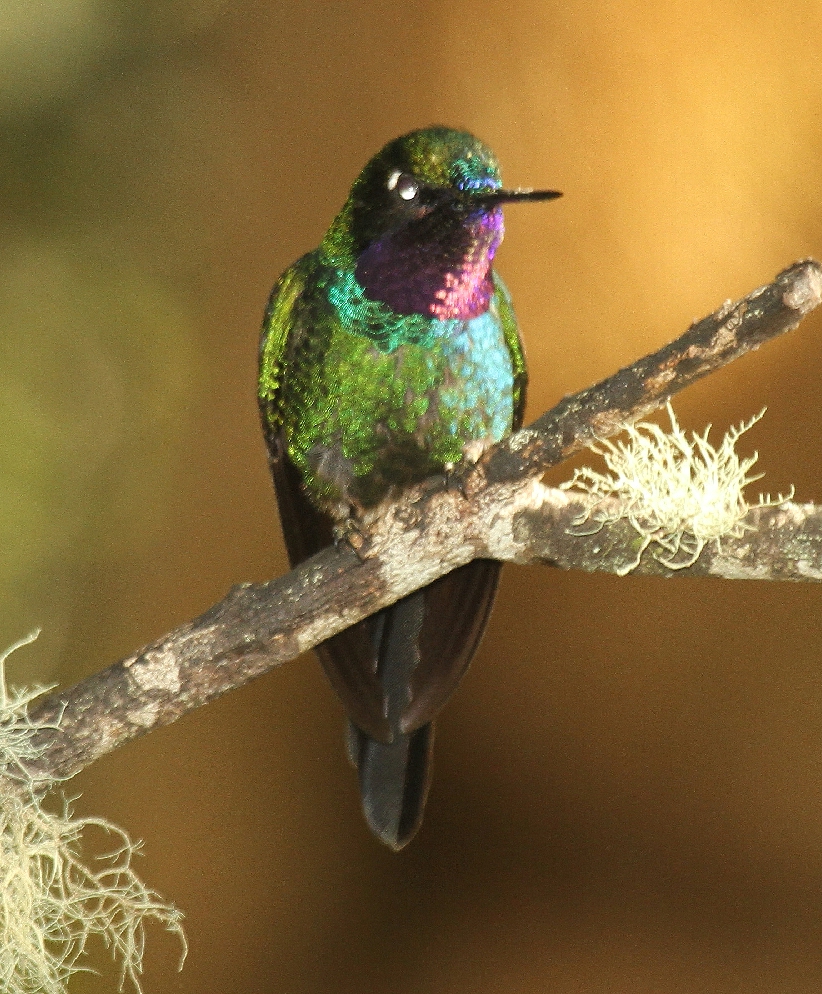
Wikipedia: Purple-throated sunangel Source: OTHER
Purple-throatedSunangel.jpg
![]() The purple-throated sunangel (Heliangelus viola) is a species of midsized hummingbird in the genus Heliangelus. It is found in western Ecuador and northwestern Peru.[2] Its natural habitats are subtropical or tropical moist montane forest and heavily degraded former forest at an elevation ranging from 2150 to 3050 meters.[1] It forages in the midstory of the forest for nectar.[3] The sunangel is one of the more common hummingbirds in the Andean highlands and is more habituated to both human settlement and open habitats than many of its relatives. It is listed by the IUCN as a species of Least Concern due to its large range and its treatment as a frequently-seen species across much of its range.[1]
[more]
The purple-throated sunangel (Heliangelus viola) is a species of midsized hummingbird in the genus Heliangelus. It is found in western Ecuador and northwestern Peru.[2] Its natural habitats are subtropical or tropical moist montane forest and heavily degraded former forest at an elevation ranging from 2150 to 3050 meters.[1] It forages in the midstory of the forest for nectar.[3] The sunangel is one of the more common hummingbirds in the Andean highlands and is more habituated to both human settlement and open habitats than many of its relatives. It is listed by the IUCN as a species of Least Concern due to its large range and its treatment as a frequently-seen species across much of its range.[1]
[more]
Profile Wikipedia eBird Xeno-Canto

Wikipedia: Little sunangel Source: OTHER
Little_Sunangel_-_Ecuador_S4E1895.jpg
![]() The flame-throated sunangel or little sunangel (Heliangelus micraster) is a species of hummingbird.
It is found in Ecuador and Peru.
Its natural habitat is subtropical or tropical moist montane forest.
[more]
The flame-throated sunangel or little sunangel (Heliangelus micraster) is a species of hummingbird.
It is found in Ecuador and Peru.
Its natural habitat is subtropical or tropical moist montane forest.
[more]
Profile Wikipedia eBird Xeno-Canto

Wikipedia: Royal sunangel Source: OTHER
1200px-Heliangelus_regalis_map.svg.png
![]() The royal sunangel (Heliangelus regalis) is a species of hummingbird. It is endemic to subtropical elfin forests and shrubs in the Andes of northern Peru and adjacent south-eastern Ecuador. It is endangered due to habitat loss. It is strongly sexually dichromatic, and while females resemble other female sunangels, males are unique with their iridescent dark blue plumage.
[more]
The royal sunangel (Heliangelus regalis) is a species of hummingbird. It is endemic to subtropical elfin forests and shrubs in the Andes of northern Peru and adjacent south-eastern Ecuador. It is endangered due to habitat loss. It is strongly sexually dichromatic, and while females resemble other female sunangels, males are unique with their iridescent dark blue plumage.
[more]
Profile Wikipedia eBird Xeno-Canto

Wikipedia: Gorgeted sunangel Source: OTHER
1200px-Gorgeted_Sunangel_%28m%29_JCB.jpg
![]() The gorgeted sunangel (Heliangelus strophianus) is a species of hummingbird found on the west slope of Ecuador and extreme southwestern Colombia.
[more]
The gorgeted sunangel (Heliangelus strophianus) is a species of hummingbird found on the west slope of Ecuador and extreme southwestern Colombia.
[more]
Profile Wikipedia eBird Xeno-Canto

Wikipedia: Tourmaline sunangel Source: OTHER
1200px-Tourmaline_Sunangel_RWD2b.jpg
![]() The tourmaline sunangel (Heliangelus exortis) is a species of hummingbird.
It is found in Colombia and Ecuador.
Its natural habitats are subtropical or tropical moist montane forest and heavily degraded former forest.
[more]
The tourmaline sunangel (Heliangelus exortis) is a species of hummingbird.
It is found in Colombia and Ecuador.
Its natural habitats are subtropical or tropical moist montane forest and heavily degraded former forest.
[more]

Wikipedia: Black-throated mango Source: OTHER
Anthracothorax_nigricollis_1152.jpg
![]() The black-throated mango (Anthracothorax nigricollis) is a hummingbird species native to South America and Trinidad and Tobago.
[more]
The black-throated mango (Anthracothorax nigricollis) is a hummingbird species native to South America and Trinidad and Tobago.
[more]
Profile Wikipedia eBird Xeno-Canto

Wikipedia: Long-billed starthroat Source: OTHER
Heliomaster_longirostris%2C_Long-billed_Starthroat.jpg
![]() The long-billed starthroat (Heliomaster longirostris) is a hummingbird that breeds from southern Mexico to Panama, from Colombia south and east to Bolivia and Brazil, and on Trinidad. It is present throughout South and Central America and is an uncommon but widespread species, which appears to be a local or seasonal migrant, although its movements are not well understood.
[more]
The long-billed starthroat (Heliomaster longirostris) is a hummingbird that breeds from southern Mexico to Panama, from Colombia south and east to Bolivia and Brazil, and on Trinidad. It is present throughout South and Central America and is an uncommon but widespread species, which appears to be a local or seasonal migrant, although its movements are not well understood.
[more]
Profile Wikipedia eBird Xeno-Canto

Wikipedia: Rufous-throated sapphire Source: OTHER
Flickr_-_Dario_Sanches_-_BEIJA-FLOR.jpg
![]() The rufous-throated sapphire (Hylocharis sapphirina) is a species of hummingbird in the family Trochilidae. It is found at forest edge, savanna-like habitats and plantations in northern and central South America.
[more]
The rufous-throated sapphire (Hylocharis sapphirina) is a species of hummingbird in the family Trochilidae. It is found at forest edge, savanna-like habitats and plantations in northern and central South America.
[more]

Wikipedia: Bronzy hermit Source: OTHER
Bronzy_Hermit_%283529655516%29_%28cropped%29.jpg
![]() The bronzy hermit (Glaucis aeneus) is a species of hummingbird in the family Trochilidae. It is found in forests and thickets from eastern Honduras south to western Panama, and in the Chocó of western Colombia and north-western Ecuador. It closely resembles the larger rufous-breasted hermit.
[more]
The bronzy hermit (Glaucis aeneus) is a species of hummingbird in the family Trochilidae. It is found in forests and thickets from eastern Honduras south to western Panama, and in the Chocó of western Colombia and north-western Ecuador. It closely resembles the larger rufous-breasted hermit.
[more]
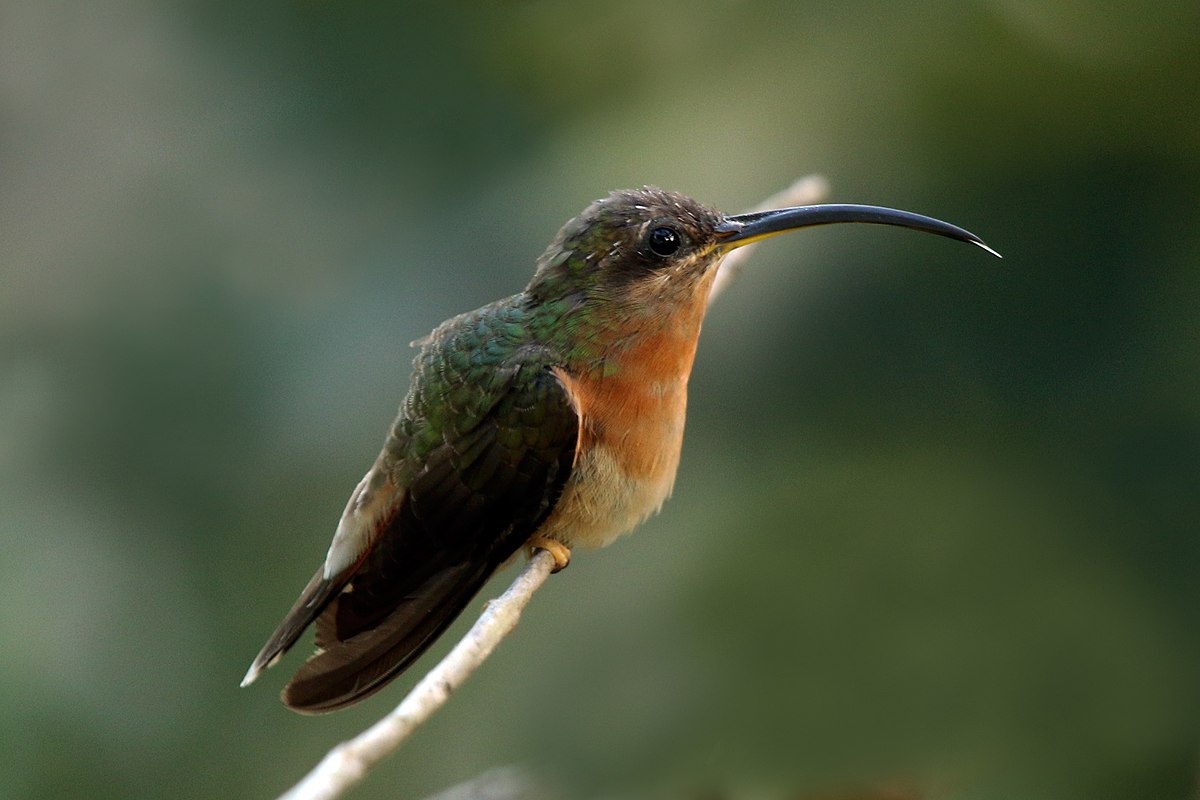
Wikipedia: Rufous-breasted hermit Source: OTHER
1200px-Rufous-breasted_hermit_%28_Glaucis_hirsutus_insularum%29.jpg
![]() The rufous-breasted hermit or hairy hermit (Glaucis hirsutus) is a hummingbird that breeds from Panama south to Bolivia, and on Trinidad, Tobago and Grenada. It is a widespread and generally common species, though local populations may change in numbers and disappear altogether in marginal habitat[2]
[more]
The rufous-breasted hermit or hairy hermit (Glaucis hirsutus) is a hummingbird that breeds from Panama south to Bolivia, and on Trinidad, Tobago and Grenada. It is a widespread and generally common species, though local populations may change in numbers and disappear altogether in marginal habitat[2]
[more]
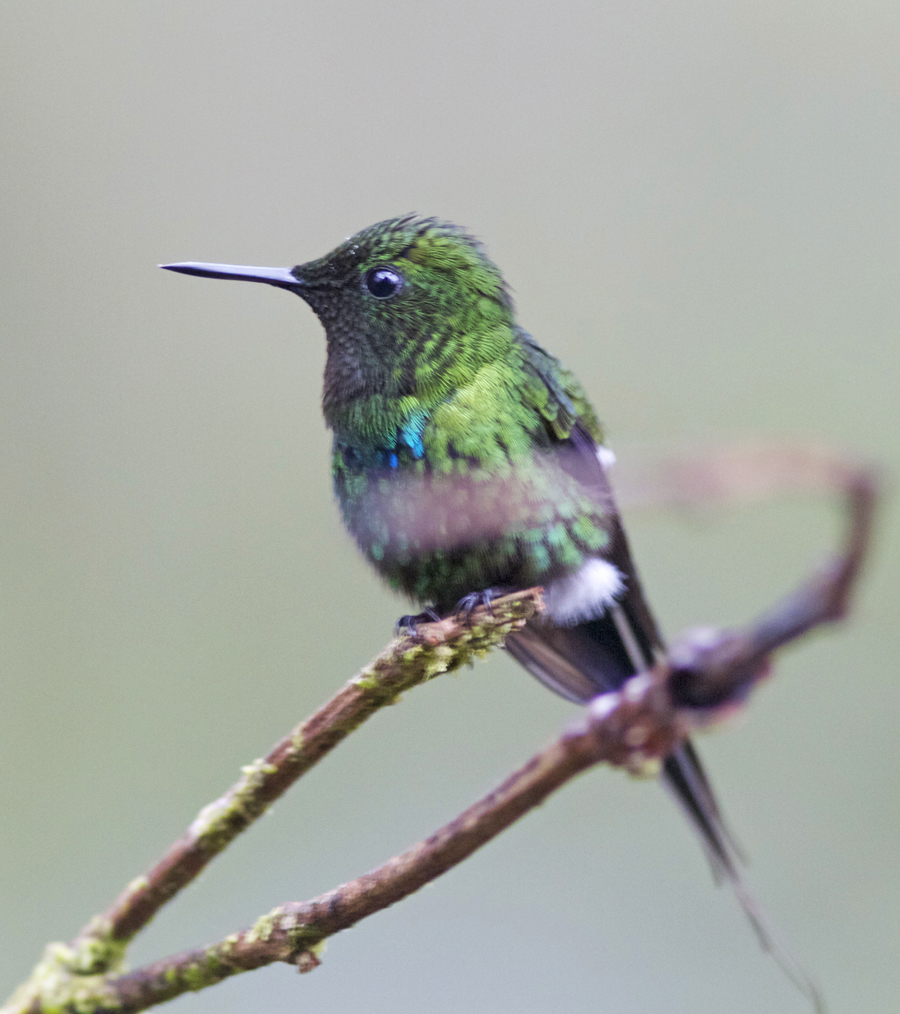
Wikipedia: Green thorntail Source: OTHER
Green_Thorntail_JCB.jpg
![]() The green thorntail (Discosura conversii) is a small hummingbird that is a resident breeder from Costa Rica to western Ecuador. It occurs at middle elevations from 700–1,400 m (2,300–4,600 ft) but may descend lower early in the wet season. In Costa Rica and Panama it is confined to the Caribbean slopes.
[more]
The green thorntail (Discosura conversii) is a small hummingbird that is a resident breeder from Costa Rica to western Ecuador. It occurs at middle elevations from 700–1,400 m (2,300–4,600 ft) but may descend lower early in the wet season. In Costa Rica and Panama it is confined to the Caribbean slopes.
[more]

Wikipedia: Black-bellied thorntail Source: OTHER
1200px-Histoirenaturel04muls_0363.jpg
![]() The black-bellied thorntail (Discosura langsdorffi) is a slow flying species of hummingbird in the family Trochilidae.[2]
It is found in Bolivia, Brazil, Colombia, Ecuador, Peru, and Venezuela.
Its natural habitats are subtropical or tropical moist lowland forest and heavily degraded former forest at about a 100-300m altitude.[3] It stays high in the forest which explains the lack of scientific information on it.[4] The male will attract the female by fanning out their tail and zooming side-to-side with a loud cracking sound.[2] Generally they'd only make a quick “tsip” or “chip” noise when feeding.[3]
[more]
The black-bellied thorntail (Discosura langsdorffi) is a slow flying species of hummingbird in the family Trochilidae.[2]
It is found in Bolivia, Brazil, Colombia, Ecuador, Peru, and Venezuela.
Its natural habitats are subtropical or tropical moist lowland forest and heavily degraded former forest at about a 100-300m altitude.[3] It stays high in the forest which explains the lack of scientific information on it.[4] The male will attract the female by fanning out their tail and zooming side-to-side with a loud cracking sound.[2] Generally they'd only make a quick “tsip” or “chip” noise when feeding.[3]
[more]
Profile Wikipedia eBird Xeno-Canto
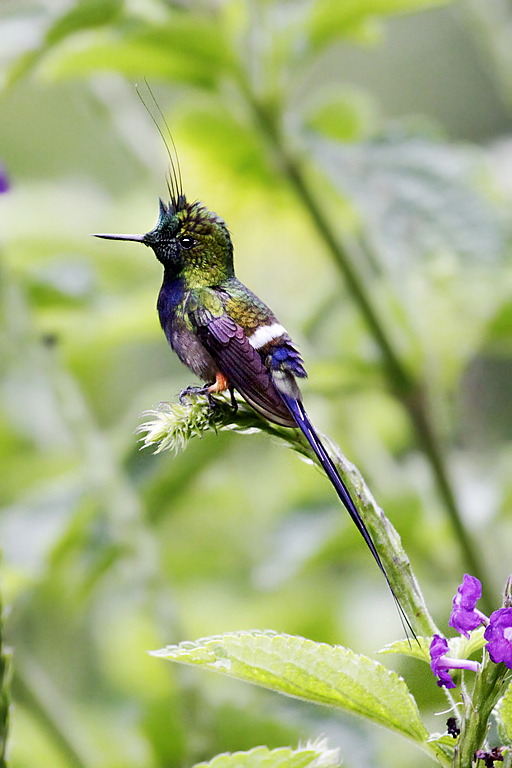
Wikipedia: Wire-crested thorntail Source: OTHER
Discosura_popelairii_-near_Manu_Road%2C_Peru-8.jpg
![]() The wire-crested thorntail (Discosura popelairii) is a hummingbird which occurs in Colombia, Ecuador and Peru.
[more]
The wire-crested thorntail (Discosura popelairii) is a hummingbird which occurs in Colombia, Ecuador and Peru.
[more]
Profile Wikipedia eBird Xeno-Canto

Wikipedia: White-tipped sicklebill Source: OTHER
1200px-Eutoxeres_aquila.jpg
![]() The white-tipped sicklebill (Eutoxeres aquila) is a species of hummingbird in the family Trochilidae.
It is found in Costa Rica and Panama of Central America, and Colombia, Ecuador, and far northern Peru. There is also a single recent record from Mérida in Venezuela.
[more]
The white-tipped sicklebill (Eutoxeres aquila) is a species of hummingbird in the family Trochilidae.
It is found in Costa Rica and Panama of Central America, and Colombia, Ecuador, and far northern Peru. There is also a single recent record from Mérida in Venezuela.
[more]
Profile Wikipedia eBird Xeno-Canto

Wikipedia: Buff-tailed sicklebill Source: OTHER
1200px-Haaksnavelkolibrie.jpg
![]() The buff-tailed sicklebill (Eutoxeres condamini) is a species of hermit hummingbird from the lower Andes and adjacent west Amazonian lowlands from southern Colombia and northern Ecuador to Peru and Bolivia.[2]
[more]
The buff-tailed sicklebill (Eutoxeres condamini) is a species of hermit hummingbird from the lower Andes and adjacent west Amazonian lowlands from southern Colombia and northern Ecuador to Peru and Bolivia.[2]
[more]
Profile Wikipedia eBird Xeno-Canto

Wikipedia: Purple-crowned fairy Source: OTHER
1200px-Heliothryx_barroti_on_nest.jpg
![]() The purple-crowned fairy (Heliothryx barroti) is a large hummingbird that breeds in the lowlands and hills from southeastern Mexico south to southwestern Ecuador.
[more]
The purple-crowned fairy (Heliothryx barroti) is a large hummingbird that breeds in the lowlands and hills from southeastern Mexico south to southwestern Ecuador.
[more]

Wikipedia: Black-eared fairy Source: OTHER
1200px-Heliothryx_aurita_Black-eared_Fairy.jpg
![]() The black-eared fairy (Heliothryx auritus) is a species of hummingbird in the family Trochilidae. It is found in tropical forests in South America.
[more]
The black-eared fairy (Heliothryx auritus) is a species of hummingbird in the family Trochilidae. It is found in tropical forests in South America.
[more]
Profile Wikipedia eBird Xeno-Canto

Wikipedia: Crowned woodnymph Source: OTHER
Violet_crowned_Woodnymph.jpg
![]() The crowned woodnymph (Thalurania colombica) is a species of bird in the hummingbird family Trochilidae.
It is found in Belize and Guatemala to northern Peru.
Its natural habitats are subtropical or tropical moist lowland forest, subtropical or tropical moist montane forest, and heavily degraded former forest.
[more]
The crowned woodnymph (Thalurania colombica) is a species of bird in the hummingbird family Trochilidae.
It is found in Belize and Guatemala to northern Peru.
Its natural habitats are subtropical or tropical moist lowland forest, subtropical or tropical moist montane forest, and heavily degraded former forest.
[more]
Profile Wikipedia eBird Xeno-Canto

Wikipedia: Fork-tailed woodnymph Source: OTHER
Thalurania_furcata_-near_Amazonia_Lodge%2C_Manu_National_Park%2C_Peru-8.jpg
![]() The fork-tailed woodnymph (Thalurania furcata) is a species of hummingbird in the family Trochilidae. It is found in Argentina, Bolivia, Brazil, Colombia, Ecuador, French Guiana, Guyana, Paraguay, Peru, Suriname, Trinidad and Tobago, and Venezuela. Its natural habitats are subtropical or tropical moist lowland forest, subtropical or tropical moist montane forest, and heavily degraded former forest.
[more]
The fork-tailed woodnymph (Thalurania furcata) is a species of hummingbird in the family Trochilidae. It is found in Argentina, Bolivia, Brazil, Colombia, Ecuador, French Guiana, Guyana, Paraguay, Peru, Suriname, Trinidad and Tobago, and Venezuela. Its natural habitats are subtropical or tropical moist lowland forest, subtropical or tropical moist montane forest, and heavily degraded former forest.
[more]
Profile Wikipedia eBird Xeno-Canto
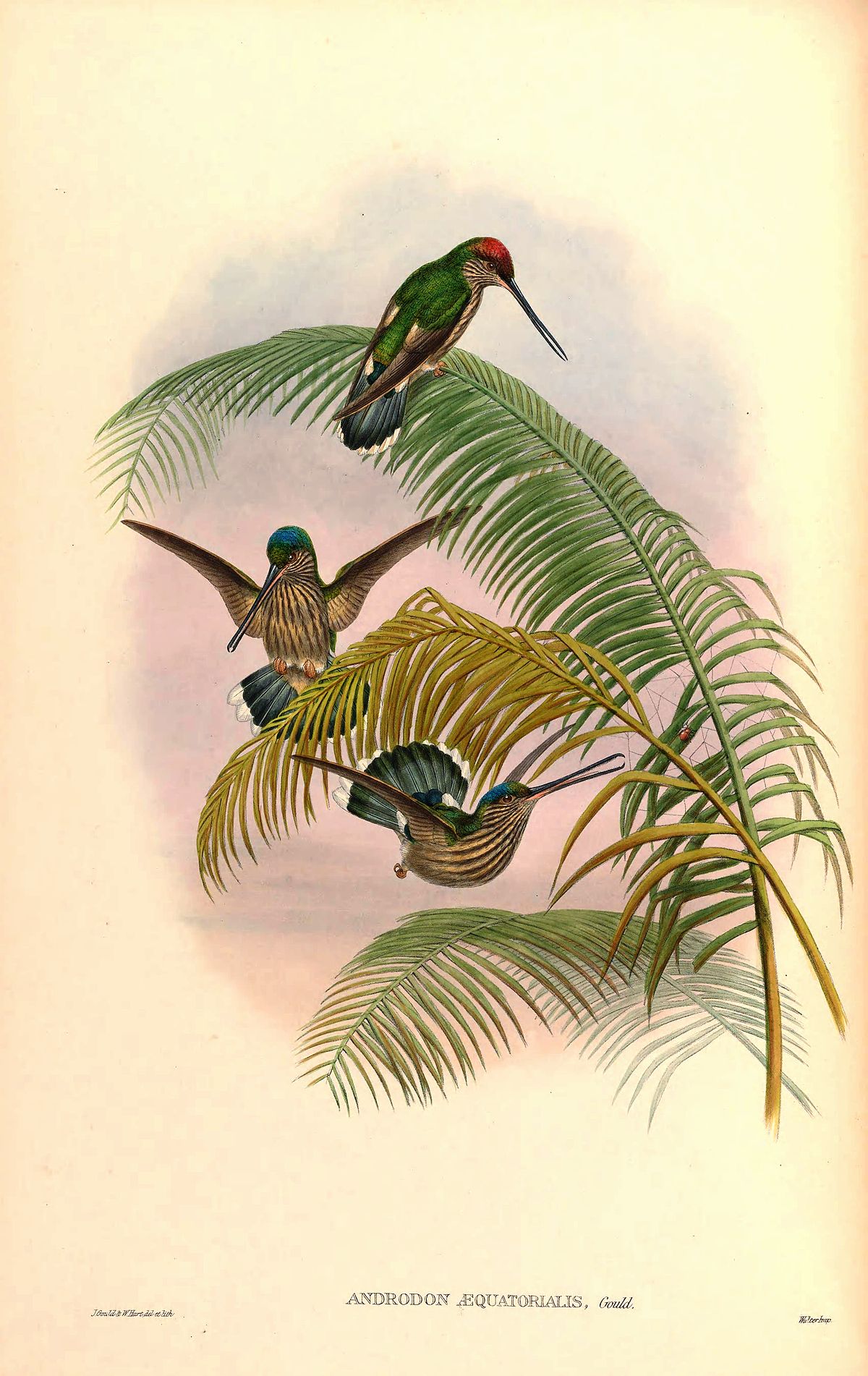
Wikipedia: Tooth-billed hummingbird Source: OTHER
1200px-Androdon_aequatorialis.jpg
![]() The tooth-billed hummingbird (Androdon aequatorialis) is a species of bird from the family Trochilidae. It is monotypic within the genus Androdon. It is found in humid forests in western Colombia, north-western Ecuador (south to Pichincha Province), and far eastern Panama (Darién Province). While generally scarce, localized and associated with the highly threatened humid sections of the Chocó, its range remains relatively large, and it is therefore considered to be of least concern by BirdLife International.
[more]
The tooth-billed hummingbird (Androdon aequatorialis) is a species of bird from the family Trochilidae. It is monotypic within the genus Androdon. It is found in humid forests in western Colombia, north-western Ecuador (south to Pichincha Province), and far eastern Panama (Darién Province). While generally scarce, localized and associated with the highly threatened humid sections of the Chocó, its range remains relatively large, and it is therefore considered to be of least concern by BirdLife International.
[more]
Profile Wikipedia eBird Xeno-Canto

Wikipedia: Brown violetear Source: OTHER
1200px-Brown_violetear_%28Colibri_delphinae%29.jpg
![]() The brown violetear (Colibri delphinae) is a large hummingbird that breeds at middle elevations in the mountains in Central America, and western and northern South America (primarily the Andes and the tepuis) with isolated populations on Trinidad and in the Brazilian state Bahia.
[more]
The brown violetear (Colibri delphinae) is a large hummingbird that breeds at middle elevations in the mountains in Central America, and western and northern South America (primarily the Andes and the tepuis) with isolated populations on Trinidad and in the Brazilian state Bahia.
[more]

Wikipedia: Sparkling violet-ear Source: OTHER
1200px-Colibri_coruscans.jpg
![]() The sparkling violetear (Colibri coruscans) is a species of hummingbird widespread in highlands of northern and western South America, including a large part of the Andes (from Argentina and northwards), the Venezuelan Coastal Range, and the Tepuis. It occurs in a wide range of semi-open habitats, even in gardens and parks within major cities such as Quito, and is often the most common species of hummingbird in its range. The sparkling violetear is most abundant near coniferous or evergreen eucalyptus forests. It is highly vocal and territorial.
[more]
The sparkling violetear (Colibri coruscans) is a species of hummingbird widespread in highlands of northern and western South America, including a large part of the Andes (from Argentina and northwards), the Venezuelan Coastal Range, and the Tepuis. It occurs in a wide range of semi-open habitats, even in gardens and parks within major cities such as Quito, and is often the most common species of hummingbird in its range. The sparkling violetear is most abundant near coniferous or evergreen eucalyptus forests. It is highly vocal and territorial.
[more]
Profile Wikipedia eBird Xeno-Canto

Wikipedia: Green-fronted lancebill Source: OTHER
1200px-Doryfera_ludovicae.jpg
![]() The green-fronted lancebill (Doryfera ludovicae) is a species of hummingbird in the family Trochilidae. Primarily known for its incredibly long bill and “glittering” green patch of feathers on its forehead, D. ludovicae is found in subtropical and tropical moist montane forest and prefers regions that include fast moving rivers and streams.[2]
[more]
The green-fronted lancebill (Doryfera ludovicae) is a species of hummingbird in the family Trochilidae. Primarily known for its incredibly long bill and “glittering” green patch of feathers on its forehead, D. ludovicae is found in subtropical and tropical moist montane forest and prefers regions that include fast moving rivers and streams.[2]
[more]
Profile Wikipedia eBird Xeno-Canto

Wikipedia: Blue-fronted lancebill Source: OTHER
1200px-A_monograph_of_the_Trochilid%C3%A6%2C_or_family_of_humming-birds_%28Plate_87%29_%287175953308%29.jpg
![]() The blue-fronted lancebill (Doryfera johannae) is a species of hummingbird in the family Trochilidae.
It is found in Brazil, Colombia, Ecuador, Guyana, Peru, and Venezuela.
Its natural habitats are subtropical or tropical moist lowland forest and subtropical or tropical moist montane forest.
[more]
The blue-fronted lancebill (Doryfera johannae) is a species of hummingbird in the family Trochilidae.
It is found in Brazil, Colombia, Ecuador, Guyana, Peru, and Venezuela.
Its natural habitats are subtropical or tropical moist lowland forest and subtropical or tropical moist montane forest.
[more]
Profile Wikipedia eBird Xeno-Canto

Wikipedia: Band-tailed barbthroat Source: OTHER
Band-tailed_Barbthroat_%28Threnetes_ruckeri%29.jpg
![]() The band-tailed barbthroat (Threnetes ruckeri) is a medium-sized hummingbird which is a resident breeder from southeastern Guatemala and Belize to western Ecuador and western Venezuela.[1]
[more]
The band-tailed barbthroat (Threnetes ruckeri) is a medium-sized hummingbird which is a resident breeder from southeastern Guatemala and Belize to western Ecuador and western Venezuela.[1]
[more]
Profile Wikipedia eBird Xeno-Canto

Wikipedia: Pale-tailed barbthroat Source: OTHER
1200px-A_monograph_of_the_Trochilid%C3%A6%2C_or_family_of_humming-birds_%28Plate_13%29_%286987075833%29.jpg
![]() The pale-tailed barbthroat (Threnetes leucurus) is a species of hummingbird in the family Trochilidae.
It is found in the Amazon Basin proper and bordering countries, Brazil, Bolivia, Colombia, Ecuador, Peru, French Guiana, Guyana, Suriname, and Venezuela.
Its natural habitats are subtropical or tropical moist lowland forest and subtropical or tropical swampland.
[more]
The pale-tailed barbthroat (Threnetes leucurus) is a species of hummingbird in the family Trochilidae.
It is found in the Amazon Basin proper and bordering countries, Brazil, Bolivia, Colombia, Ecuador, Peru, French Guiana, Guyana, Suriname, and Venezuela.
Its natural habitats are subtropical or tropical moist lowland forest and subtropical or tropical swampland.
[more]
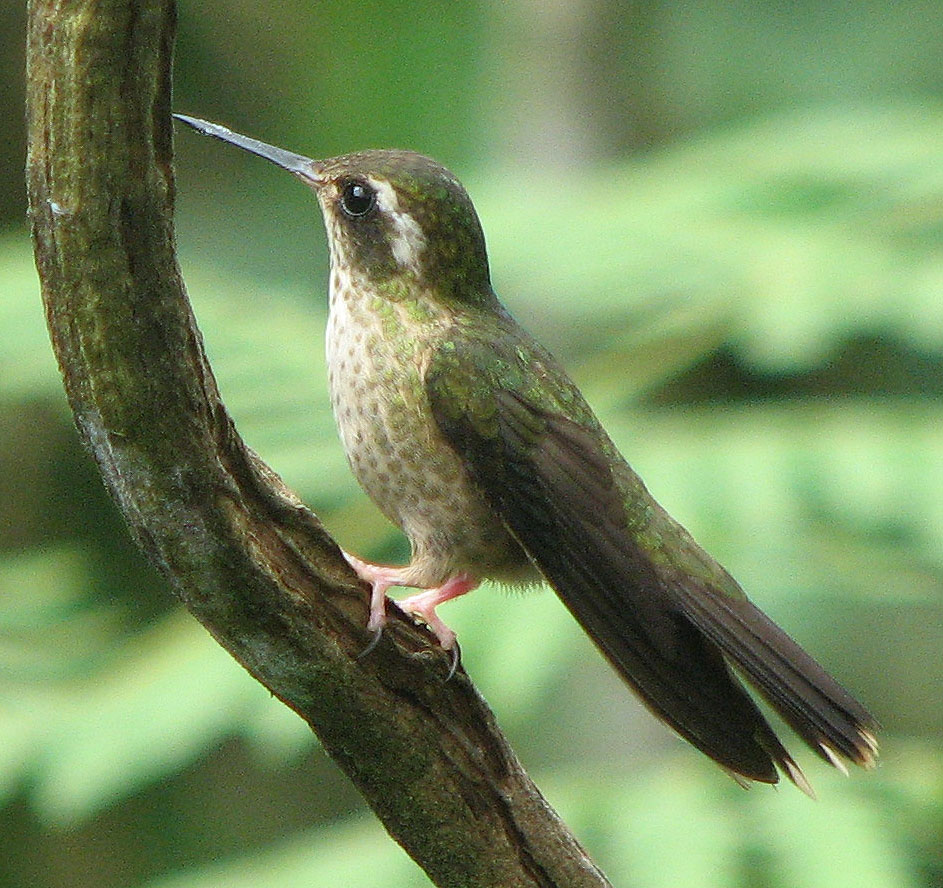
Wikipedia: Speckled hummingbird Source: OTHER
SpeckledHummingbird.jpg
![]() The speckled hummingbird (Adelomyia melanogenys), is a species of hummingbird. It is the only member of the genus Adelomyia. It inhabits Neotropical montane cloud forests at elevations of 1,000–2,500 meters and is confined to the Andes of Argentina, Bolivia, Peru, Ecuador, Colombia and Venezuela; as well as to some isolated montane forest in western Ecuador and Venezuela. In Ecuador, it ranges across both eastern and western slopes of the Andes and occupies a broad altitudinal range from subtropical forests (1400 m) to cloud forests (3000 m). In addition, one isolated population inhabits the Chongón Colonche cordillera in coastal evergreen montane forest (600 m) located ca. 130 km away from the Andes.
[more]
The speckled hummingbird (Adelomyia melanogenys), is a species of hummingbird. It is the only member of the genus Adelomyia. It inhabits Neotropical montane cloud forests at elevations of 1,000–2,500 meters and is confined to the Andes of Argentina, Bolivia, Peru, Ecuador, Colombia and Venezuela; as well as to some isolated montane forest in western Ecuador and Venezuela. In Ecuador, it ranges across both eastern and western slopes of the Andes and occupies a broad altitudinal range from subtropical forests (1400 m) to cloud forests (3000 m). In addition, one isolated population inhabits the Chongón Colonche cordillera in coastal evergreen montane forest (600 m) located ca. 130 km away from the Andes.
[more]
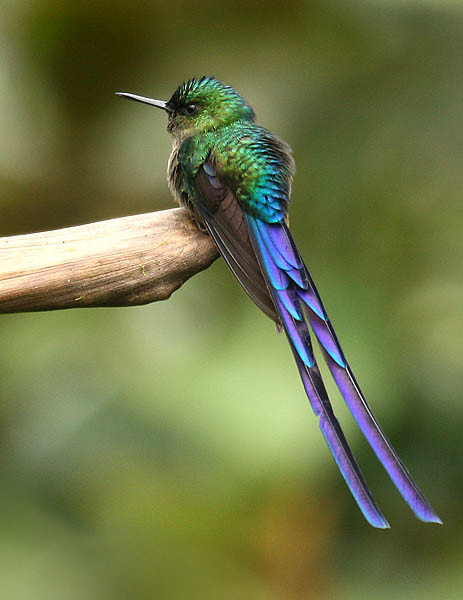
Wikipedia: Violet-tailed sylph Source: OTHER
Violet-tailed_Sylph_%28Aglaiocercus_coelestis%29.jpg
![]() The violet-tailed sylph (Aglaiocercus coelestis) is a species of hummingbird. It is found in Colombia and Ecuador. This sylph lives in areas from 300–2,100 metres (980–6,890 ft) in elevation, though typically above 900 metres (3,000 ft) on the west slope of the Andes.[2] A sylph is a mythological air spirit.
[more]
The violet-tailed sylph (Aglaiocercus coelestis) is a species of hummingbird. It is found in Colombia and Ecuador. This sylph lives in areas from 300–2,100 metres (980–6,890 ft) in elevation, though typically above 900 metres (3,000 ft) on the west slope of the Andes.[2] A sylph is a mythological air spirit.
[more]
Profile Wikipedia eBird Xeno-Canto
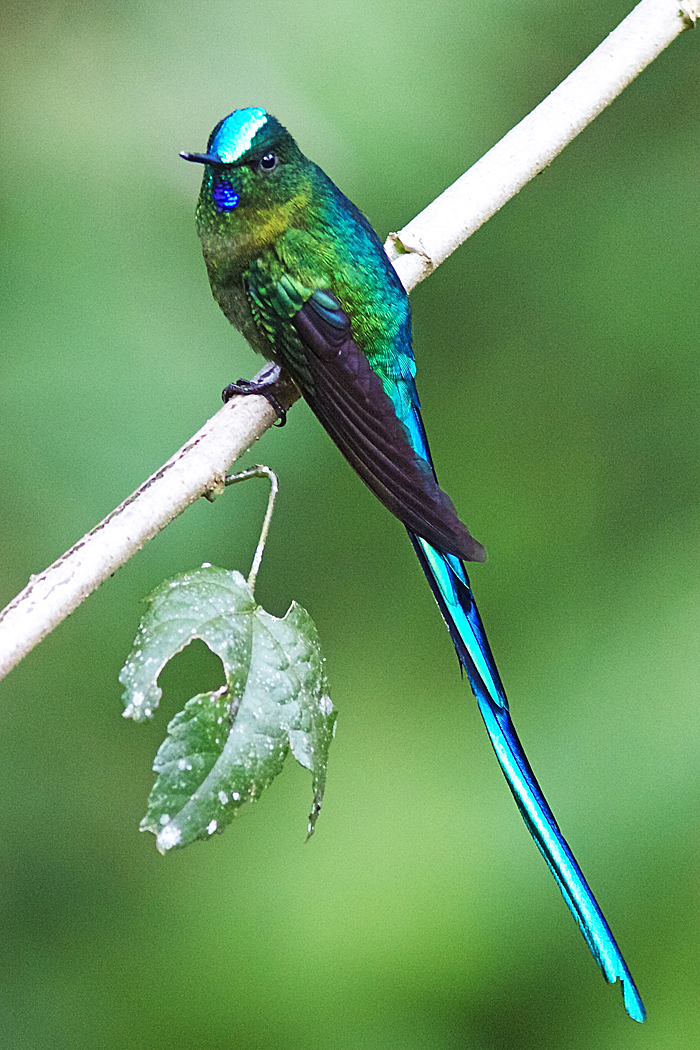
Wikipedia: Long-tailed sylph Source: OTHER
Long-tailed_Sylph.jpg
![]() The long-tailed sylph (Aglaiocercus kingii) is a species of hummingbird in the family Trochilidae. It is found in Bolivia, Colombia, Ecuador, Peru, and Venezuela. Its natural habitat is subtropical or tropical moist montane forest. It has an average lifespan of 3 to 4 years in the wild.
[more]
The long-tailed sylph (Aglaiocercus kingii) is a species of hummingbird in the family Trochilidae. It is found in Bolivia, Colombia, Ecuador, Peru, and Venezuela. Its natural habitat is subtropical or tropical moist montane forest. It has an average lifespan of 3 to 4 years in the wild.
[more]
Profile Wikipedia eBird Xeno-Canto

Wikipedia: Napo sabrewing Source: OTHER
1200px-Campylopterus_villaviscensio.jpg
![]() The Napo sabrewing (Campylopterus villaviscensio) is a species of hummingbird in the family Trochilidae.
It is found in Colombia, Ecuador, and Peru.
Its natural habitat is subtropical or tropical moist montane forest.
It is becoming rare due to habitat loss.
[more]
The Napo sabrewing (Campylopterus villaviscensio) is a species of hummingbird in the family Trochilidae.
It is found in Colombia, Ecuador, and Peru.
Its natural habitat is subtropical or tropical moist montane forest.
It is becoming rare due to habitat loss.
[more]
Profile Wikipedia eBird Xeno-Canto

Wikipedia: Lazuline sabrewing Source: OTHER
Campylopterus_falcatus.jpg
![]() The lazuline sabrewing (Campylopterus falcatus) is a species of hummingbird in the family Trochilidae.
[more]
The lazuline sabrewing (Campylopterus falcatus) is a species of hummingbird in the family Trochilidae.
[more]
Profile Wikipedia eBird Xeno-Canto

Wikipedia: Gray-breasted sabrewing Source: OTHER
1200px-Unbekannter_kolibri.jpg
![]() The grey-breasted sabrewing (Campylopterus largipennis) is a species of hummingbird in the family Trochilidae.
[more]
The grey-breasted sabrewing (Campylopterus largipennis) is a species of hummingbird in the family Trochilidae.
[more]
Profile Wikipedia eBird Xeno-Canto
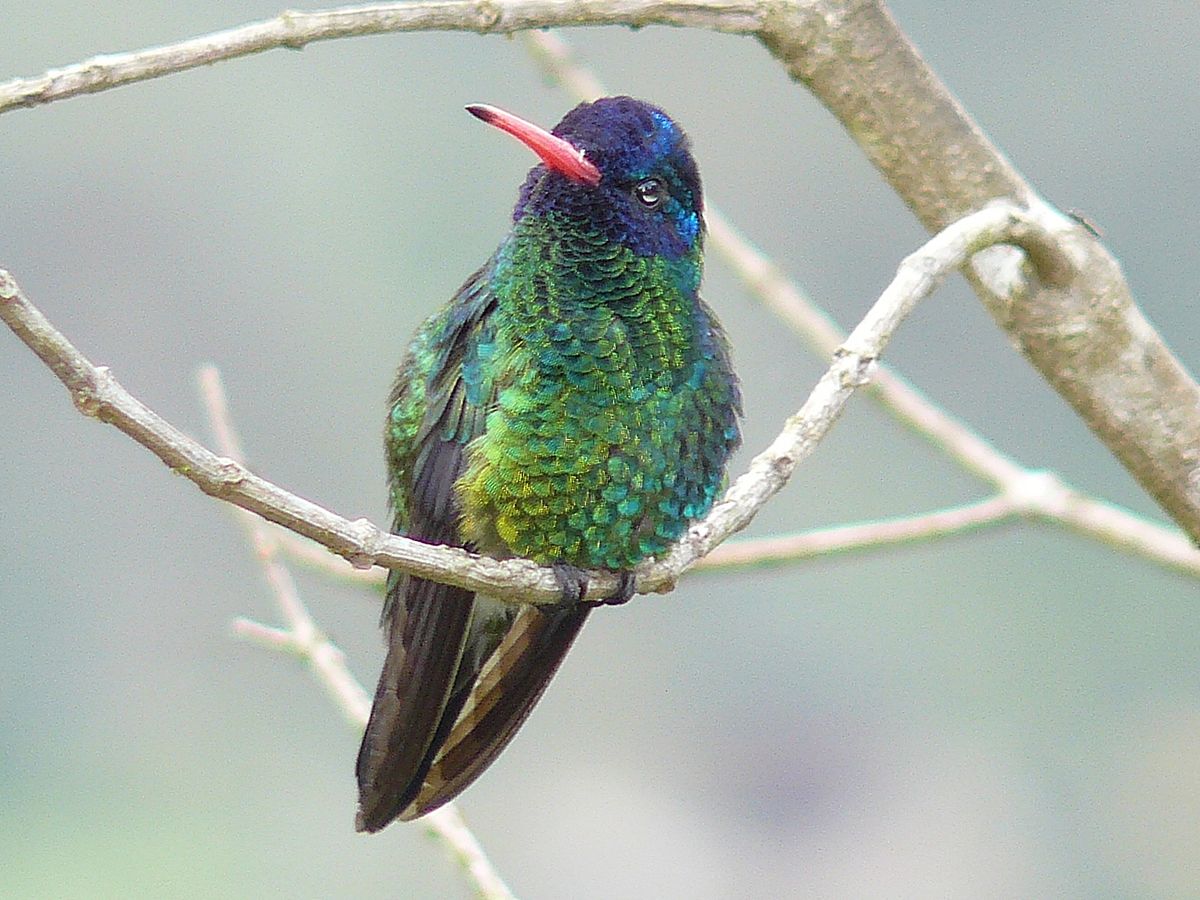
Wikipedia: Blue-headed sapphire Source: OTHER
1200px-Blue-headed_Sapphire_-_Colombia.jpg
![]() The blue-headed sapphire (Chrysuronia grayi) is a species of hummingbird in the family Trochilidae.
It is found in Colombia and Ecuador. It formerly included the Humboldt's sapphire as a subspecies.
Its natural habitats are subtropical or tropical moist lowland forest, subtropical or tropical mangrove forest, and heavily degraded former forest.
[more]
The blue-headed sapphire (Chrysuronia grayi) is a species of hummingbird in the family Trochilidae.
It is found in Colombia and Ecuador. It formerly included the Humboldt's sapphire as a subspecies.
Its natural habitats are subtropical or tropical moist lowland forest, subtropical or tropical mangrove forest, and heavily degraded former forest.
[more]
Profile Wikipedia eBird Xeno-Canto

Wikipedia: Humboldt's sapphire Source: OTHER
1200px-Hylocharis_humboldtii_Gould.JPG
![]() Humboldt's sapphire (Chrysuronia humboldtii) is a species of hummingbird in the family Trochilidae.
It is found in Colombia, Ecuador, and Panama. It was formerly considered a subspecies of the blue-headed sapphire.
Its natural habitat is subtropical or tropical mangrove forest.
[more]
Humboldt's sapphire (Chrysuronia humboldtii) is a species of hummingbird in the family Trochilidae.
It is found in Colombia, Ecuador, and Panama. It was formerly considered a subspecies of the blue-headed sapphire.
Its natural habitat is subtropical or tropical mangrove forest.
[more]
Profile Wikipedia eBird Xeno-Canto

Wikipedia: Golden-tailed sapphire Source: OTHER
1200px-Golden-tailed_Sapphire_JCB.jpg
![]() The golden-tailed sapphire (Chrysuronia oenone) is a species of hummingbird in the family Trochilidae. It is found in Bolivia, Brazil, Colombia, Ecuador, Peru, Trinidad and Tobago, and Venezuela.
[more]
The golden-tailed sapphire (Chrysuronia oenone) is a species of hummingbird in the family Trochilidae. It is found in Bolivia, Brazil, Colombia, Ecuador, Peru, Trinidad and Tobago, and Venezuela.
[more]
Profile Wikipedia eBird Xeno-Canto

Wikipedia: Sword-billed hummingbird Source: OTHER
Sword-billed_Hummingbird.jpg
![]() The sword-billed hummingbird (Ensifera ensifera) is a neotropical species of hummingbird from the Andean regions of South America. It is the sole member of the genus Ensifera and is characterized by its unusually long bill; it is the only bird to have a beak longer than the rest of its body. E. ensifera uses its bill to drink nectar from flowers with long corollas and has coevolved with the species Passiflora mixta. While most hummingbirds preen using their bills, E. ensifera must use its feet to scratch and preen due to its bill being so long. This uncommon bird is also one of the largest hummingbird species.
[more]
The sword-billed hummingbird (Ensifera ensifera) is a neotropical species of hummingbird from the Andean regions of South America. It is the sole member of the genus Ensifera and is characterized by its unusually long bill; it is the only bird to have a beak longer than the rest of its body. E. ensifera uses its bill to drink nectar from flowers with long corollas and has coevolved with the species Passiflora mixta. While most hummingbirds preen using their bills, E. ensifera must use its feet to scratch and preen due to its bill being so long. This uncommon bird is also one of the largest hummingbird species.
[more]
Profile Wikipedia eBird Xeno-Canto
Arenal hummingbird tentative ID White-necked Jacobin. 2018-02-28 09.40.12 Costa Rica
First observed in Costa Rica on 2018-02-28.
![]() The white-necked jacobin (Florisuga mellivora) is a large and attractive hummingbird that ranges from Mexico, south to Peru, Bolivia and south Brazil. It is also found on Tobago (subspecies F. m. flabellifera) and in Trinidad (subspecies F. m. mellivora)
[more]
The white-necked jacobin (Florisuga mellivora) is a large and attractive hummingbird that ranges from Mexico, south to Peru, Bolivia and south Brazil. It is also found on Tobago (subspecies F. m. flabellifera) and in Trinidad (subspecies F. m. mellivora)
[more]
Profile Wikipedia eBird Xeno-Canto

Wikipedia: Greenish puffleg Source: OTHER
Greenish_Puffleg_-_Colombia_S4E3301.jpg
![]() The greenish puffleg (Haplophaedia aureliae) is a species of hummingbird in the family Trochilidae.
It is found in Colombia, Ecuador, and Panama.
Its natural habitats are subtropical or tropical moist montane forest and heavily degraded former forest. It is often regarded as including the buff-thighed puffleg as a subspecies.
[more]
The greenish puffleg (Haplophaedia aureliae) is a species of hummingbird in the family Trochilidae.
It is found in Colombia, Ecuador, and Panama.
Its natural habitats are subtropical or tropical moist montane forest and heavily degraded former forest. It is often regarded as including the buff-thighed puffleg as a subspecies.
[more]
Profile Wikipedia eBird Xeno-Canto

Wikipedia: Hoary puffleg Source: OTHER
1200px-Hoary_Puffleg.jpg
![]() The hoary puffleg (Haplophaedia lugens) is a species of hummingbird in the family Trochilidae. It is found in Colombia and Ecuador.
[more]
The hoary puffleg (Haplophaedia lugens) is a species of hummingbird in the family Trochilidae. It is found in Colombia and Ecuador.
[more]
Profile Wikipedia eBird Xeno-Canto
Cloud forest green crowned brilliant hummingbird in tree. 2018-02-17 11.03.54 Costa Rica
First observed in Costa Rica on 2018-02-17.
![]() The green-crowned brilliant (Heliodoxa jacula) is a large, robust hummingbird that is a resident breeder in the highlands from Costa Rica to western Ecuador. It is also known as the green-fronted brilliant.[2]
[more]
The green-crowned brilliant (Heliodoxa jacula) is a large, robust hummingbird that is a resident breeder in the highlands from Costa Rica to western Ecuador. It is also known as the green-fronted brilliant.[2]
[more]
Profile Wikipedia eBird Xeno-Canto

Wikipedia: Fawn-breasted brilliant Source: OTHER
Fawn-breasted_Brilliant.jpg
![]() The fawn-breasted brilliant (Heliodoxa rubinoides) is a species of hummingbird. It is native to South America, where it occurs in Bolivia, Colombia, Ecuador, and Peru.[1]
[more]
The fawn-breasted brilliant (Heliodoxa rubinoides) is a species of hummingbird. It is native to South America, where it occurs in Bolivia, Colombia, Ecuador, and Peru.[1]
[more]
Profile Wikipedia eBird Xeno-Canto

Wikipedia: Black-throated brilliant Source: OTHER
1200px-Heliodoxa_schreibersii.jpg
![]() The black-throated brilliant (Heliodoxa schreibersii) is a species of hummingbird in the family Trochilidae.
It is found in Brazil, Colombia, Ecuador, and Peru.
Its natural habitats are subtropical or tropical moist lowland forest and subtropical or tropical moist montane forest.
[more]
The black-throated brilliant (Heliodoxa schreibersii) is a species of hummingbird in the family Trochilidae.
It is found in Brazil, Colombia, Ecuador, and Peru.
Its natural habitats are subtropical or tropical moist lowland forest and subtropical or tropical moist montane forest.
[more]
Profile Wikipedia eBird Xeno-Canto

Wikipedia: Empress brilliant Source: OTHER
Empress_Brilliant.jpg
![]() The empress brilliant (Heliodoxa imperatrix) is a species of hummingbird in the family Trochilidae.
It is found in Colombia and Ecuador.
[more]
The empress brilliant (Heliodoxa imperatrix) is a species of hummingbird in the family Trochilidae.
It is found in Colombia and Ecuador.
[more]
Profile Wikipedia eBird Xeno-Canto

Wikipedia: Pink-throated brilliant Source: OTHER
1200px-MonographTrochi2Goul_0066.jpg
![]() The pink-throated brilliant (Heliodoxa gularis) is a species of hummingbird in the family Trochilidae.
It is found in Colombia, Ecuador, and Peru.
Its natural habitats are subtropical or tropical moist lowland forest and subtropical or tropical moist montane forest.
It is becoming rare due to habitat loss.
[more]
The pink-throated brilliant (Heliodoxa gularis) is a species of hummingbird in the family Trochilidae.
It is found in Colombia, Ecuador, and Peru.
Its natural habitats are subtropical or tropical moist lowland forest and subtropical or tropical moist montane forest.
It is becoming rare due to habitat loss.
[more]
Profile Wikipedia eBird Xeno-Canto

Wikipedia: Violet-fronted brilliant Source: OTHER
1200px-Violet-fronted_Brilliant_JCB.jpg
![]() The violet-fronted brilliant (Heliodoxa leadbeateri) is a species of hummingbird in the family Trochilidae.
It is found on the east slope of the Andes in Venezuela, Colombia, Ecuador, Peru, and Bolivia.
Its natural habitat is subtropical or tropical moist montane forest.
[more]
The violet-fronted brilliant (Heliodoxa leadbeateri) is a species of hummingbird in the family Trochilidae.
It is found on the east slope of the Andes in Venezuela, Colombia, Ecuador, Peru, and Bolivia.
Its natural habitat is subtropical or tropical moist montane forest.
[more]
Profile Wikipedia eBird Xeno-Canto

Wikipedia: Gould's jewelfront Source: OTHER
Heliodoxa_aurescens%2C_Gould%27s_Jewelfront.jpg
![]() Gould's jewelfront (Heliodoxa aurescens) is a medium-sized hummingbird in the family Trochilidae.
It is found in tropical and equatorial South America.[2] This is an uncommon species with an unusually large range compared to the other members of Heliodoxa.
[more]
Gould's jewelfront (Heliodoxa aurescens) is a medium-sized hummingbird in the family Trochilidae.
It is found in tropical and equatorial South America.[2] This is an uncommon species with an unusually large range compared to the other members of Heliodoxa.
[more]
Profile Wikipedia eBird Xeno-Canto

Wikipedia: Violet-headed hummingbird Source: OTHER
1200px-Violet-headed_Hummingbird_%28f%29_JCB.jpg
![]() The violet-headed hummingbird (Klais guimeti) is a species of hummingbird in the family Trochilidae. It is the only species in the genus Klais.
[more]
The violet-headed hummingbird (Klais guimeti) is a species of hummingbird in the family Trochilidae. It is the only species in the genus Klais.
[more]
Profile Wikipedia eBird Xeno-Canto
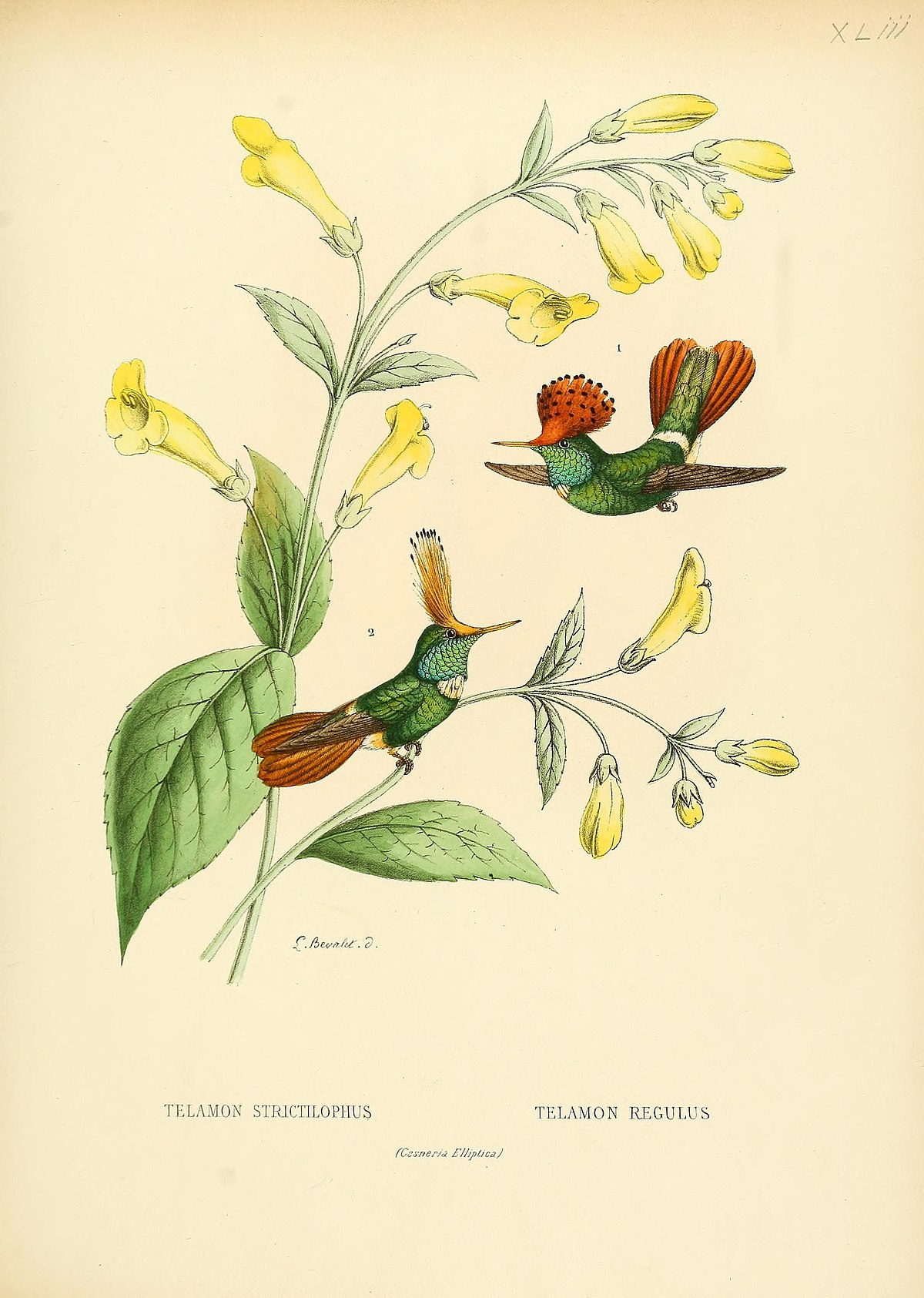
Wikipedia: Spangled coquette Source: OTHER
1200px-Bevalet_hummingbirds.jpg
![]() The spangled coquette, coquette pailletée, coqueta coronada, or coqueta lentejuelada (Lophornis stictolophus) is a species of hummingbird in the family Trochilidae.
It is found in Colombia, Ecuador, Peru, and Venezuela.
Its natural habitats are subtropical or tropical dry forest, subtropical or tropical moist lowland forest, and heavily degraded former forest.
[more]
The spangled coquette, coquette pailletée, coqueta coronada, or coqueta lentejuelada (Lophornis stictolophus) is a species of hummingbird in the family Trochilidae.
It is found in Colombia, Ecuador, Peru, and Venezuela.
Its natural habitats are subtropical or tropical dry forest, subtropical or tropical moist lowland forest, and heavily degraded former forest.
[more]
Profile Wikipedia eBird Xeno-Canto

Wikipedia: Butterfly coquette Source: OTHER
Lophornis_chalybeus_verreauxii.png
![]() The butterfly coquette (Lophornis verreauxii) is a species of hummingbird in the family Trochilidae.[1]
It is found in northwestern South America, the region of the western Amazon Basin, in the countries of northwest Brazil, Colombia, Venezuela, Ecuador and Peru. To the southeast it is found in adjacent Bolivia. It was recently split from the festive coquette.
[more]
The butterfly coquette (Lophornis verreauxii) is a species of hummingbird in the family Trochilidae.[1]
It is found in northwestern South America, the region of the western Amazon Basin, in the countries of northwest Brazil, Colombia, Venezuela, Ecuador and Peru. To the southeast it is found in adjacent Bolivia. It was recently split from the festive coquette.
[more]
Profile Wikipedia eBird Xeno-Canto
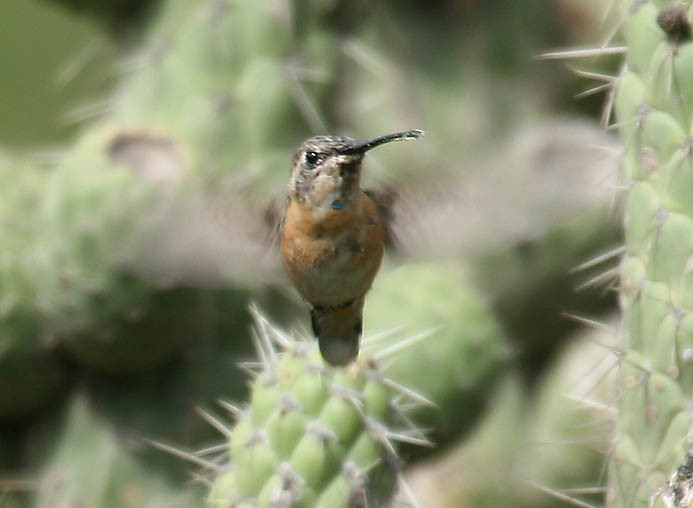
Wikipedia: Purple-collared woodstar Source: OTHER
Purple-collared_Woodstar_%28Myrtis_fanny%29.jpg
![]() The purple-collared woodstar (Myrtis fanny) is a species of hummingbird found in Ecuador and Peru. Its natural habitats are subtropical or tropical moist shrubland, subtropical or tropical high-altitude shrubland, and heavily degraded former forest. It is the only species of the genus Myrtis.
[more]
The purple-collared woodstar (Myrtis fanny) is a species of hummingbird found in Ecuador and Peru. Its natural habitats are subtropical or tropical moist shrubland, subtropical or tropical high-altitude shrubland, and heavily degraded former forest. It is the only species of the genus Myrtis.
[more]
Profile Wikipedia eBird Xeno-Canto

Wikipedia: Booted racket-tail Source: OTHER
Ocreatus_addae_%28Rufous-booted_Racket-tail%29%2C_Paucartambo%2C_Peru.jpg
![]() The booted racket-tails are a small group of hummingbirds in the genus Ocreatus that was long considered to have only one species, O. underwoodii. The genus was first recognized by John Gould in 1846. Field research by Karl-L. Schuchmann published in 2016, however, found notable differences between some populations traditionally assigned to O. underwoodii, and recommended that the taxa annae, addae, and peruanus be raised to species level.[1] The research results have been mostly accepted by the International Ornithological Union, with more data required for the species status of Anna's racket-tail.[2] The American Ornithological Society has yet to recognize the split.
[more]
The booted racket-tails are a small group of hummingbirds in the genus Ocreatus that was long considered to have only one species, O. underwoodii. The genus was first recognized by John Gould in 1846. Field research by Karl-L. Schuchmann published in 2016, however, found notable differences between some populations traditionally assigned to O. underwoodii, and recommended that the taxa annae, addae, and peruanus be raised to species level.[1] The research results have been mostly accepted by the International Ornithological Union, with more data required for the species status of Anna's racket-tail.[2] The American Ornithological Society has yet to recognize the split.
[more]
Profile Wikipedia eBird Xeno-Canto

Wikipedia: Giant hummingbird Source: OTHER
Patagona_gigas.jpg
![]() The giant hummingbird (Patagona gigas) is the only member of the genus Patagona[2] and the largest member of the hummingbird family, weighing 18–24 g (0.63–0.85 oz) and having a wingspan of approximately 21.5 cm (8.5 in) and length of 23 cm (9.1 in).[3][4] This is approximately the same length as a European starling or a northern cardinal, though the giant hummingbird is considerably lighter because it has a slender build and long bill, making the body a smaller proportion of the total length. This weight is almost twice that of the next heaviest hummingbird species[5] and ten times that of the smallest, the bee hummingbird.[6]
[more]
The giant hummingbird (Patagona gigas) is the only member of the genus Patagona[2] and the largest member of the hummingbird family, weighing 18–24 g (0.63–0.85 oz) and having a wingspan of approximately 21.5 cm (8.5 in) and length of 23 cm (9.1 in).[3][4] This is approximately the same length as a European starling or a northern cardinal, though the giant hummingbird is considerably lighter because it has a slender build and long bill, making the body a smaller proportion of the total length. This weight is almost twice that of the next heaviest hummingbird species[5] and ten times that of the smallest, the bee hummingbird.[6]
[more]
Profile Wikipedia eBird Xeno-Canto

Wikipedia: Ecuadorian piedtail Source: OTHER
1200px-Phlogophilus_hemileucurus_%2B_Paphinia_cristata_-_Gould_-_Humm._161.jpg
![]() The Ecuadorian piedtail (Phlogophilus hemileucurus) is a species of hummingbird in the family Trochilidae.
It is found in Colombia, Ecuador, and Peru.
Its natural habitat is subtropical or tropical moist montane forest.
It is becoming rare due to habitat loss.
[more]
The Ecuadorian piedtail (Phlogophilus hemileucurus) is a species of hummingbird in the family Trochilidae.
It is found in Colombia, Ecuador, and Peru.
Its natural habitat is subtropical or tropical moist montane forest.
It is becoming rare due to habitat loss.
[more]
Profile Wikipedia eBird Xeno-Canto

Wikipedia: Great sapphirewing Source: OTHER
Great_Sapphirewing_%28Pterophanes_cyanopterus%29.jpg
![]() The great sapphirewing (Pterophanes cyanopterus) is a species of hummingbird in the family Trochilidae.
It is found in Bolivia, Colombia, Ecuador, and Peru.
Its natural habitat is subtropical or tropical moist montane forest. At 15.5-17.5 cm (6–7 in) in length and weighing about 10 grams, this is one of the largest species of hummingbird, though slightly smaller than the Topaza hummingbirds and the giant hummingbird.
[more]
The great sapphirewing (Pterophanes cyanopterus) is a species of hummingbird in the family Trochilidae.
It is found in Bolivia, Colombia, Ecuador, and Peru.
Its natural habitat is subtropical or tropical moist montane forest. At 15.5-17.5 cm (6–7 in) in length and weighing about 10 grams, this is one of the largest species of hummingbird, though slightly smaller than the Topaza hummingbirds and the giant hummingbird.
[more]

Wikipedia: Geoffroy's daggerbill Source: OTHER
1200px-Schistes_geoffroyi_%28Pico_de_cu%C3%B1a%29_%2822653616465%29.jpg
![]() Geoffroy's daggerbill, Geoffroy's wedgebill or eastern wedge-billed hummingbird (Schistes geoffroyi) is a species of hummingbird in the family Trochilidae. It is sometimes merged with the visorbearers in Augastes. It has been split from the white-throated daggerbill by most taxonomic authorities. Some authorities calling them the wedge-billed hummingbird.
[more]
Geoffroy's daggerbill, Geoffroy's wedgebill or eastern wedge-billed hummingbird (Schistes geoffroyi) is a species of hummingbird in the family Trochilidae. It is sometimes merged with the visorbearers in Augastes. It has been split from the white-throated daggerbill by most taxonomic authorities. Some authorities calling them the wedge-billed hummingbird.
[more]
Profile Wikipedia eBird Xeno-Canto
![]() The white-throated daggerbill, white-throated wedgebill or western wedge-billed hummingbird (Schistes albogularis) is a species of hummingbird in the family Trochilidae. It is sometimes merged with the visorbearers in Augastes.
It is found in western Colombia and Ecuador. It has been split from the Geoffroy's daggerbill by most taxonomic authorities. Some authorities continue to lump both species together, calling them the wedge-billed hummingbird.
Its natural habitat is subtropical or tropical moist montane forest.
[more]
The white-throated daggerbill, white-throated wedgebill or western wedge-billed hummingbird (Schistes albogularis) is a species of hummingbird in the family Trochilidae. It is sometimes merged with the visorbearers in Augastes.
It is found in western Colombia and Ecuador. It has been split from the Geoffroy's daggerbill by most taxonomic authorities. Some authorities continue to lump both species together, calling them the wedge-billed hummingbird.
Its natural habitat is subtropical or tropical moist montane forest.
[more]
Profile Wikipedia eBird Xeno-Canto
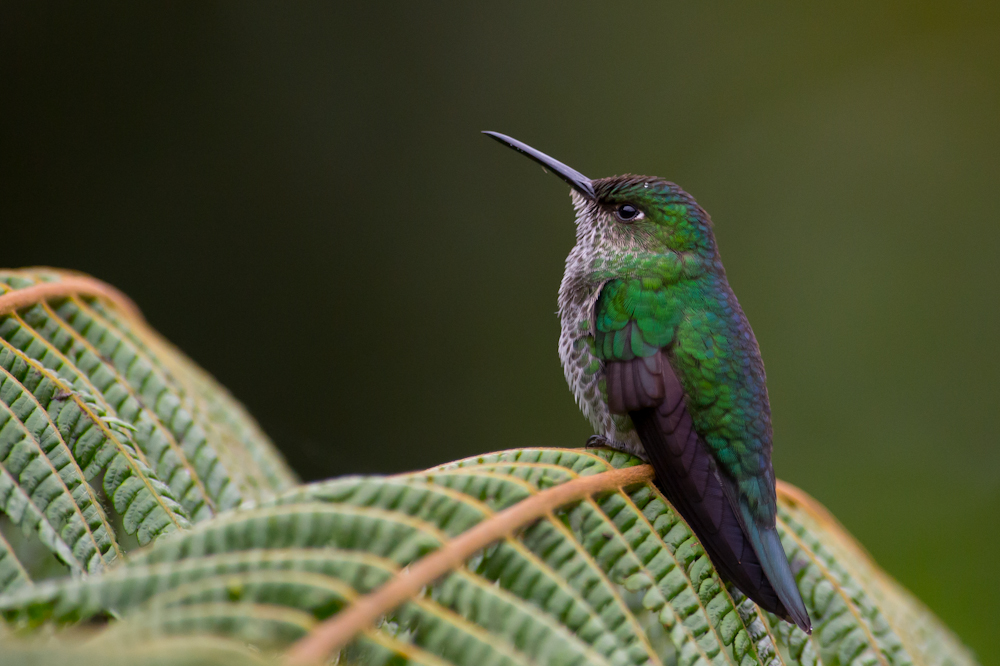
Wikipedia: Many-spotted hummingbird Source: OTHER
Taphrospilus_hypostictus%2C_Many-spotted_Hummingbird.jpg
![]() The many-spotted hummingbird (Taphrospilus hypostictus) is a species of hummingbird in the family Trochilidae. It is the only member of the genus Taphrospilus.
[more]
The many-spotted hummingbird (Taphrospilus hypostictus) is a species of hummingbird in the family Trochilidae. It is the only member of the genus Taphrospilus.
[more]

Wikipedia: Fiery topaz Source: OTHER
Topaza_pyra_-_Fiery_Topaz_%28male%29%3B_Manacapuru%2C_Amazonas%2C_Brazil.jpg
![]() The fiery topaz (Topaza pyra) is a species of hummingbird in the family Trochilidae. It has brilliant iridescent plumage and resides in northern South America, where it consumes nectar and insects.
[more]
The fiery topaz (Topaza pyra) is a species of hummingbird in the family Trochilidae. It has brilliant iridescent plumage and resides in northern South America, where it consumes nectar and insects.
[more]

Wikipedia: Rufous-vented whitetip Source: OTHER
1200px-Urosticte_ruficrissa_%28edited%29.jpg
![]() The rufous-vented whitetip (Urosticte ruficrissa) is a species of hummingbird in the family Trochilidae. It is found in Colombia, Ecuador and Peru.
Its natural habitat is subtropical or tropical moist montane forest.
[more]
The rufous-vented whitetip (Urosticte ruficrissa) is a species of hummingbird in the family Trochilidae. It is found in Colombia, Ecuador and Peru.
Its natural habitat is subtropical or tropical moist montane forest.
[more]
Profile Wikipedia eBird Xeno-Canto

Wikipedia: Purple-bibbed whitetip Source: OTHER
Purple-bibbed_Whitetip_%28Urosticte_benjamini%29.jpg
![]() The purple-bibbed whitetip (Urosticte benjamini) is a species of hummingbird. It is native to Colombia and Ecuador.[1] Little is known about the species due to it rarely foraging in the open - in search for insects and small flowers.[2] Nesting is made from foliage such as moss and ferns, usually along steep ravines.[2]
[more]
The purple-bibbed whitetip (Urosticte benjamini) is a species of hummingbird. It is native to Colombia and Ecuador.[1] Little is known about the species due to it rarely foraging in the open - in search for insects and small flowers.[2] Nesting is made from foliage such as moss and ferns, usually along steep ravines.[2]
[more]

Wikipedia: Amethyst woodstar Source: OTHER
1200px-Calliphlox_amethystina_%28male%29.jpg
![]() The amethyst woodstar (Calliphlox amethystina) is a species of hummingbird in the family Trochilidae.
It is found in most of central, and eastern South America proper, in Argentina, Bolivia, Brazil, Colombia, Ecuador, French Guiana, Guyana, Suriname-(the Guianas), Paraguay, Peru, and Venezuela. The bird's range surrounds the Amazon countries into the Andes foothills and higher elevations of upstream river systems, but is not along the Amazon River proper in the central Amazon Basin, or the central upper Basin; it is in Brazil at the river's outlet, and upstream for about 500 km.
[more]
The amethyst woodstar (Calliphlox amethystina) is a species of hummingbird in the family Trochilidae.
It is found in most of central, and eastern South America proper, in Argentina, Bolivia, Brazil, Colombia, Ecuador, French Guiana, Guyana, Suriname-(the Guianas), Paraguay, Peru, and Venezuela. The bird's range surrounds the Amazon countries into the Andes foothills and higher elevations of upstream river systems, but is not along the Amazon River proper in the central Amazon Basin, or the central upper Basin; it is in Brazil at the river's outlet, and upstream for about 500 km.
[more]

Wikipedia: Esmeraldas woodstar Source: OTHER
1200px-Esmeraldas_woodstar.jpg
![]() The Esmeraldas woodstar (Chaetocercus berlepschi) is a rare, neotropical species of hummingbird in the family Trochilidae.[2] There are six different species in the woodstar genus.[3] Most of them are poorly studied due to their small size, extremely similar resemblance to each other, and rarity. Esmeraldas woodstars are one of the smallest bird species. They are sexually dimorphic. The main difference between sexes is that males have a bright purple throat. Esmeraldas woodstars are found only on the Pacific coast of west Ecuador in semi-deciduous to evergreen forests.[3] They feed on the nectar of flowering shrubs and trees.[3] The main threat to this species is deforestation.[3] Esmeraldas woodstars are Vulnerable and require habitat protection.[2]
[more]
The Esmeraldas woodstar (Chaetocercus berlepschi) is a rare, neotropical species of hummingbird in the family Trochilidae.[2] There are six different species in the woodstar genus.[3] Most of them are poorly studied due to their small size, extremely similar resemblance to each other, and rarity. Esmeraldas woodstars are one of the smallest bird species. They are sexually dimorphic. The main difference between sexes is that males have a bright purple throat. Esmeraldas woodstars are found only on the Pacific coast of west Ecuador in semi-deciduous to evergreen forests.[3] They feed on the nectar of flowering shrubs and trees.[3] The main threat to this species is deforestation.[3] Esmeraldas woodstars are Vulnerable and require habitat protection.[2]
[more]
Profile Wikipedia eBird Xeno-Canto

Wikipedia: Little woodstar Source: OTHER
1200px-MonographTrochiSupplementGoul_0166.jpg
![]() The little woodstar, colibri bourdon, colibrí abejorro, or estrellita chica (Chaetocercus bombus) is a species of hummingbird in the family Trochilidae. It is found in Colombia, Ecuador and Peru.
[more]
The little woodstar, colibri bourdon, colibrí abejorro, or estrellita chica (Chaetocercus bombus) is a species of hummingbird in the family Trochilidae. It is found in Colombia, Ecuador and Peru.
[more]

Wikipedia: Gorgeted woodstar Source: OTHER
1200px-Gorgeted_Woodstar_female_JCB.jpg
![]() The gorgeted woodstar (Chaetocercus heliodor) is a species of hummingbird in the family Trochilidae.
It is found in Colombia and Venezuela, and also has an isolated population in Ecuador. Its natural habitats are subtropical or tropical moist montane forest and heavily degraded former forest. This species favors forested areas highly but can be seen at flowering trees in gardens and in semi-open. The tail is frequently wagged while feeding.
[more]
The gorgeted woodstar (Chaetocercus heliodor) is a species of hummingbird in the family Trochilidae.
It is found in Colombia and Venezuela, and also has an isolated population in Ecuador. Its natural habitats are subtropical or tropical moist montane forest and heavily degraded former forest. This species favors forested areas highly but can be seen at flowering trees in gardens and in semi-open. The tail is frequently wagged while feeding.
[more]
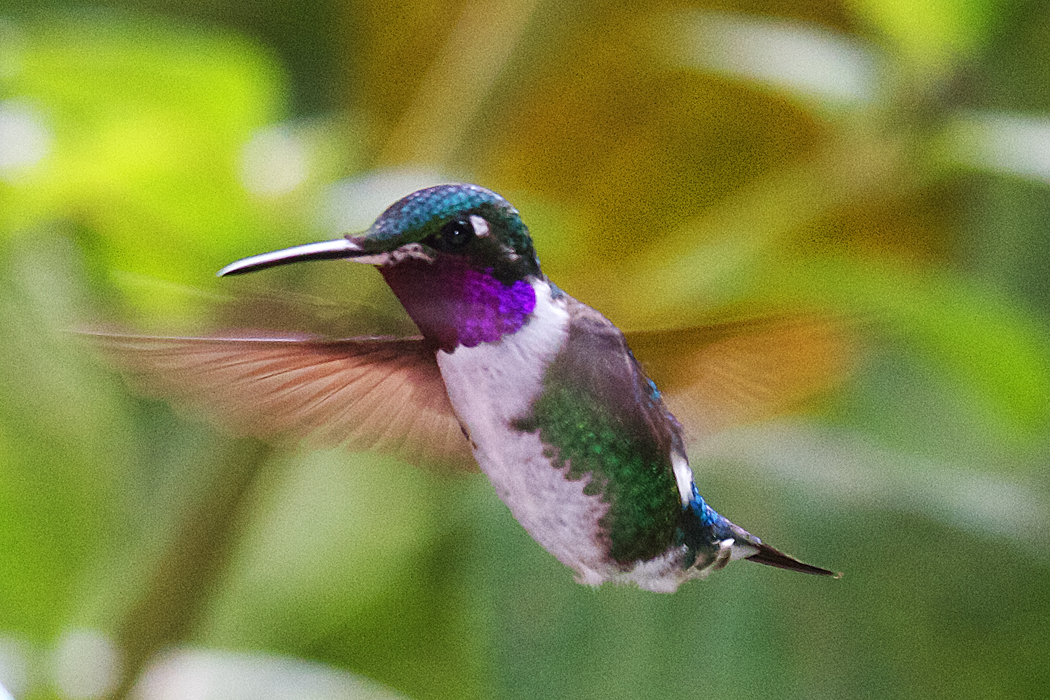
Wikipedia: White-bellied woodstar Source: OTHER
White-bellied_Woodstar.jpg
![]() The white-bellied woodstar (Chaetocercus mulsant) is a species of hummingbird in the family Trochilidae.
[more]
The white-bellied woodstar (Chaetocercus mulsant) is a species of hummingbird in the family Trochilidae.
[more]
Profile Wikipedia eBird Xeno-Canto
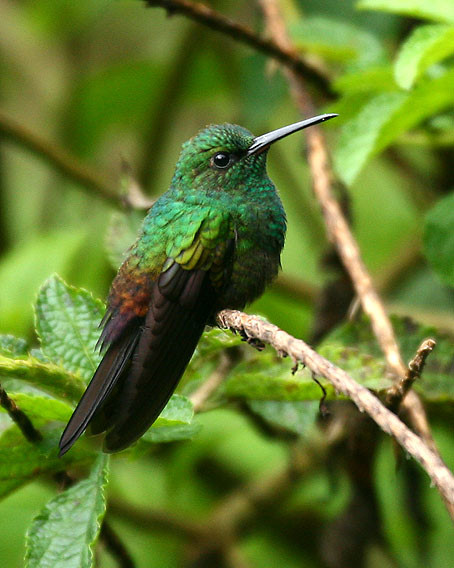
Wikipedia: Bronze-tailed plumeleteer Source: OTHER
Bronze-tailed_Plumeleteer_%28Chalybura_urochrysia%29.jpg
![]() The bronze-tailed plumeleteer (Chalybura urochrysia) is a large hummingbird resident in Central America and South America from eastern Honduras to northwestern Ecuador. The birds inhabit forests and have a preference for edges, gaps and secondary growth. It occurs in the Caribbean lowlands, typically up to an elevation of 700 metres.
[more]
The bronze-tailed plumeleteer (Chalybura urochrysia) is a large hummingbird resident in Central America and South America from eastern Honduras to northwestern Ecuador. The birds inhabit forests and have a preference for edges, gaps and secondary growth. It occurs in the Caribbean lowlands, typically up to an elevation of 700 metres.
[more]
Profile Wikipedia eBird Xeno-Canto

Wikipedia: White-vented plumeleteer Source: OTHER
1200px-White-vented_Plumeleteer.jpg
![]() The white-vented plumeleteer (Chalybura buffonii) is a species of hummingbird in the family Trochilidae.
[more]
The white-vented plumeleteer (Chalybura buffonii) is a species of hummingbird in the family Trochilidae.
[more]
Profile Wikipedia eBird Xeno-Canto

Wikipedia: Mountain avocetbill Source: OTHER
1200px-Opisthoprora_euryptera.jpg
![]() The mountain avocetbill (Opisthoprora euryptera) is a species of hummingbird in the family Trochilidae, the only member of its genus.
[more]
The mountain avocetbill (Opisthoprora euryptera) is a species of hummingbird in the family Trochilidae, the only member of its genus.
[more]
Profile Wikipedia eBird Xeno-Canto

Wikipedia: Purple-backed thornbill Source: OTHER
Purple-backed_Thornbill_%28Ramphomicron_microrhynchum%29_%288079763797%29.jpg
![]() The purple-backed thornbill (Ramphomicron microrhynchum) is a species of hummingbird in the family Trochilidae.
It is found in Bolivia, Colombia, Ecuador, Peru, and Venezuela.
Its natural habitat is subtropical or tropical moist montane forest.
[more]
The purple-backed thornbill (Ramphomicron microrhynchum) is a species of hummingbird in the family Trochilidae.
It is found in Bolivia, Colombia, Ecuador, Peru, and Venezuela.
Its natural habitat is subtropical or tropical moist montane forest.
[more]
Profile Wikipedia eBird Xeno-Canto

Wikipedia: Rufous-gaped hillstar Source: OTHER
1200px-Urochroa_bougueri_%28Colibr%C3%AD_nag%C3%BCiblanco%29_%2814144500332%29.jpg
![]() The rufous-gaped hillstar (Urochroa bougueri) formerly known as white-tailed hillstar is a species of hummingbird in the family Trochilidae, and one of two species in the genus Urochroa. It is found in humid montane forest in southern Colombia, Ecuador, and northern Peru. It has two species, the nominate species on the west Andean slope, and U. leucura on the east Andean slope. The two differ most conspicuously in that the former has a broad orange malar, which the latter lacks. Both have a straight black bill, greenish upperparts, a blue throat, grey belly, and extensive white to the tail. Although sharing the name hillstar with the members of the genus Oreotrochilus, they are quite different and not closely related.
[more]
The rufous-gaped hillstar (Urochroa bougueri) formerly known as white-tailed hillstar is a species of hummingbird in the family Trochilidae, and one of two species in the genus Urochroa. It is found in humid montane forest in southern Colombia, Ecuador, and northern Peru. It has two species, the nominate species on the west Andean slope, and U. leucura on the east Andean slope. The two differ most conspicuously in that the former has a broad orange malar, which the latter lacks. Both have a straight black bill, greenish upperparts, a blue throat, grey belly, and extensive white to the tail. Although sharing the name hillstar with the members of the genus Oreotrochilus, they are quite different and not closely related.
[more]
Profile Wikipedia eBird Xeno-Canto

Wikipedia: Green-backed hillstar Source: OTHER
1200px-White-tailed_Hillstar_JCB.jpg
![]() The green-backed hillstar (Urochroa leucura) formerly known as White-tailed hillstar is a species of hummingbird in the family Trochilidae, and one of two species in the genus Urochroa. It is found in humid montane forests on the east Andean slope of southern Colombia, Ecuador, and northern Peru.
[more]
The green-backed hillstar (Urochroa leucura) formerly known as White-tailed hillstar is a species of hummingbird in the family Trochilidae, and one of two species in the genus Urochroa. It is found in humid montane forests on the east Andean slope of southern Colombia, Ecuador, and northern Peru.
[more]

Wikipedia: Fiery-tailed awlbill Source: OTHER
1200px-MonographTrochi3Goul_0348.jpg
![]() The fiery-tailed awlbill is an uncommon bird native to Brazil, Ecuador, French Guiana, Guyana, Suriname, and Venezuela and can be found in drier habitats such as savannas, forest edges, and dry zones on large granite outcrops.[3] The main distinction between this bird and other hummingbirds is its bill that is slightly curved upwards at the tip.[3] This species displays sexual dimorphism in color, with males being fully dark green with a black streak near their abdomen while females have a white underbelly that is marked with black line down the middle.[3][4] They typically measure 3.1-4 inches (8-10cm) and are often confused with black-throated mango hummingbirds (Anthracothorax nigricollis).[4] However, they can be differentiated by looking for a curve in the beak . Other names for the fiery-tailed waybill around the world include mango picolezna, colibri avocette, and schwarzbauch-avosettkolibri. [4]
[more]
The fiery-tailed awlbill is an uncommon bird native to Brazil, Ecuador, French Guiana, Guyana, Suriname, and Venezuela and can be found in drier habitats such as savannas, forest edges, and dry zones on large granite outcrops.[3] The main distinction between this bird and other hummingbirds is its bill that is slightly curved upwards at the tip.[3] This species displays sexual dimorphism in color, with males being fully dark green with a black streak near their abdomen while females have a white underbelly that is marked with black line down the middle.[3][4] They typically measure 3.1-4 inches (8-10cm) and are often confused with black-throated mango hummingbirds (Anthracothorax nigricollis).[4] However, they can be differentiated by looking for a curve in the beak . Other names for the fiery-tailed waybill around the world include mango picolezna, colibri avocette, and schwarzbauch-avosettkolibri. [4]
[more]
Profile Wikipedia eBird Xeno-Canto

Wikipedia: Short-tailed woodstar Source: OTHER
1200px-Myrmia_micrura.jpg
![]() The short-tailed woodstar (Myrmia micrura) is a species of hummingbird in the family Trochilidae.
It is found in Ecuador and Peru. Its natural habitat is subtropical or tropical dry shrubland where it is the only hummingbird of the woodstar variety. It usually feeds close to the ground and often is attracted to flowers planted around houses.
[more]
The short-tailed woodstar (Myrmia micrura) is a species of hummingbird in the family Trochilidae.
It is found in Ecuador and Peru. Its natural habitat is subtropical or tropical dry shrubland where it is the only hummingbird of the woodstar variety. It usually feeds close to the ground and often is attracted to flowers planted around houses.
[more]
Profile Wikipedia eBird Xeno-Canto
Wikipedia: Peruvian sheartail Source: OTHER
Trochilidae_-_Thaumastura_cora.JPG
![]() The Peruvian sheartail (Thaumastura cora) is a hummingbird in the family Trochilidae. The species was first described by René Lesson and Prosper Garnot in 1827.
[more]
The Peruvian sheartail (Thaumastura cora) is a hummingbird in the family Trochilidae. The species was first described by René Lesson and Prosper Garnot in 1827.
[more]

Wikipedia: Buff-tailed coronet Source: OTHER
1200px-Buff-tailed_Coronet_JCB.jpg
![]() The buff-tailed coronet (Boissonneaua flavescens) is a species of hummingbird from the family Trochilidae. It is found in Colombia, Ecuador, and Venezuela. Distinguishing characteristics are the short bill, glittering green coloration, and buffy color under the remiges (flight feathers) and rectrices (tail feathers). Like other hummingbirds, the buff-tailed coronet is often found in mid-level forest to canopy searching for flowers with nectar and some insects. This bird is commonly found from 1500–2400 meters above sea level.
[more]
The buff-tailed coronet (Boissonneaua flavescens) is a species of hummingbird from the family Trochilidae. It is found in Colombia, Ecuador, and Venezuela. Distinguishing characteristics are the short bill, glittering green coloration, and buffy color under the remiges (flight feathers) and rectrices (tail feathers). Like other hummingbirds, the buff-tailed coronet is often found in mid-level forest to canopy searching for flowers with nectar and some insects. This bird is commonly found from 1500–2400 meters above sea level.
[more]

Wikipedia: Velvet-purple coronet Source: OTHER
1200px-Velvet-purple_coronet_%28Boissonneaua_jardini%29.jpg
![]() The velvet-purple coronet (Boissonneaua jardini) is a species of hummingbird in the family Trochilidae. It is found in humid foothill forest on the West Andean slope in western Colombia and north-western Ecuador. The species has a quirk of holding its wings straight up for a moment after perching.[2] It generally breeds between January and March, but some have been spotted nesting as far off as September.[3]
[more]
The velvet-purple coronet (Boissonneaua jardini) is a species of hummingbird in the family Trochilidae. It is found in humid foothill forest on the West Andean slope in western Colombia and north-western Ecuador. The species has a quirk of holding its wings straight up for a moment after perching.[2] It generally breeds between January and March, but some have been spotted nesting as far off as September.[3]
[more]

Wikipedia: Chestnut-breasted coronet Source: OTHER
1200px-Boissonneaua_matthewsii_-Machu_Picchu%2C_Peru-8.jpg
![]() The chestnut-breasted coronet (Boissonneaua matthewsii) is a species of hummingbird in the family Trochilidae. It is found in humid Andean montane forest in Colombia, Ecuador, and Peru. It is generally easily recognized by its contrasting rufous underparts.
[more]
The chestnut-breasted coronet (Boissonneaua matthewsii) is a species of hummingbird in the family Trochilidae. It is found in humid Andean montane forest in Colombia, Ecuador, and Peru. It is generally easily recognized by its contrasting rufous underparts.
[more]
Profile Wikipedia eBird Xeno-Canto

Wikipedia: Ocellated poorwill Source: OTHER
1200px-Nyctiphrynus_ocellatus_Ocellated_Poorwill.JPG
![]() The ocellated poorwill (Nyctiphrynus ocellatus) is a species of nightjar in the family Caprimulgidae. It is found in Argentina, Bolivia, Brazil, Colombia, Costa Rica, Ecuador, Honduras, Nicaragua, Paraguay, and Peru. Its natural habitats are subtropical or tropical moist lowland forests and subtropical or tropical moist montane forests.
[more]
The ocellated poorwill (Nyctiphrynus ocellatus) is a species of nightjar in the family Caprimulgidae. It is found in Argentina, Bolivia, Brazil, Colombia, Costa Rica, Ecuador, Honduras, Nicaragua, Paraguay, and Peru. Its natural habitats are subtropical or tropical moist lowland forests and subtropical or tropical moist montane forests.
[more]
Profile Wikipedia eBird Xeno-Canto
![]() The Chocó poorwill (Nyctiphrynus rosenbergi) is a species of nightjar in the family Caprimulgidae.
It is found in Colombia and Ecuador.
Its natural habitat is subtropical or tropical moist lowland forests.
It is threatened by habitat loss.
[more]
The Chocó poorwill (Nyctiphrynus rosenbergi) is a species of nightjar in the family Caprimulgidae.
It is found in Colombia and Ecuador.
Its natural habitat is subtropical or tropical moist lowland forests.
It is threatened by habitat loss.
[more]
Profile Wikipedia eBird Xeno-Canto

Wikipedia: Lyre-tailed nightjar Source: OTHER
Uropsalis_lyra_%28male%29_-NW_Ecuacor-3.jpg
![]() The lyre-tailed nightjar (Uropsalis lyra) is a species of nightjar in the family Caprimulgidae. It is found in Argentina, Bolivia, Colombia, Ecuador, Peru, and Venezuela.
[more]
The lyre-tailed nightjar (Uropsalis lyra) is a species of nightjar in the family Caprimulgidae. It is found in Argentina, Bolivia, Colombia, Ecuador, Peru, and Venezuela.
[more]

Wikipedia: Swallow-tailed nightjar Source: OTHER
1200px-Swallow-tailed_Nightjar_%285277616287%29.jpg
![]() The swallow-tailed nightjar (Uropsalis segmentata) is a species of nightjar in the family Caprimulgidae.
[more]
The swallow-tailed nightjar (Uropsalis segmentata) is a species of nightjar in the family Caprimulgidae.
[more]

Wikipedia: Pauraque Source: OTHER
1200px-Nyctidromus_albicollis2.jpg
![]() The pauraque (Nyctidromus albicollis) – also called the common pauraque to distinguish it from similar species – is a nightjar species, one of two birds in the genus Nyctidromus. It breeds in the subtropical and tropical of the New World, and except for northernmost birds it is largely resident all year round.[2]
[more]
The pauraque (Nyctidromus albicollis) – also called the common pauraque to distinguish it from similar species – is a nightjar species, one of two birds in the genus Nyctidromus. It breeds in the subtropical and tropical of the New World, and except for northernmost birds it is largely resident all year round.[2]
[more]
![]() Anthony's nightjar (Nyctidromus anthonyi), also known as the scrub nightjar, is a species of nightjar in the family Caprimulgidae. It is found in western Ecuador and north-western Peru. Its natural habitat is subtropical or tropical dry shrubland.
[more]
Anthony's nightjar (Nyctidromus anthonyi), also known as the scrub nightjar, is a species of nightjar in the family Caprimulgidae. It is found in western Ecuador and north-western Peru. Its natural habitat is subtropical or tropical dry shrubland.
[more]

Wikipedia: White-tailed nightjar Source: OTHER
1200px-Caprimulgus_cayennensis.jpg
![]() The white-tailed nightjar (Hydropsalis cayennensis) is a species of nightjar in the family Caprimulgidae.
[more]
The white-tailed nightjar (Hydropsalis cayennensis) is a species of nightjar in the family Caprimulgidae.
[more]

Wikipedia: Spot-tailed nightjar Source: OTHER
1200px-Hydropsalis_maculicaudus_-_Caprimulgus_maculicaudus_-_Spot-tailed_Nightjar.JPG
Profile Wikipedia eBird Xeno-Canto

Wikipedia: Ladder-tailed nightjar Source: OTHER
Hydropsalis_climacocerca_female.jpg
General: ![]() The ladder-tailed nightjar (Hydropsalis climacocerca) is a species of bird in the family Caprimulgidae, the nightjars. It is one of two species in the genus, Hydropsalis.
[more]
The ladder-tailed nightjar (Hydropsalis climacocerca) is a species of bird in the family Caprimulgidae, the nightjars. It is one of two species in the genus, Hydropsalis.
[more]

Wikipedia: Common nighthawk Source: OTHER
1200px-Common_Nighthawk_%2814428313550%29.jpg
![]() The common nighthawk (Chordeiles minor) is a medium-sized [3][4] crepuscular or nocturnal bird[3][5] of the Americas within the nightjar family, whose presence and identity are best revealed by its vocalization. Typically dark[3] (grey, black and brown),[5] displaying cryptic colouration and intricate patterns, this bird is difficult to spot with the naked eye during the day. Once aerial, with its buoyant but erratic flight, this bird is most conspicuous. The most remarkable feature of this aerial insectivore is its small beak that belies the massiveness of its mouth. Some claim appearance similarities to owls. With its horizontal stance[3] and short legs, the common nighthawk does not travel frequently on the ground, instead preferring to perch horizontally, parallel to branches, on posts, on the ground or on a roof.[5] The males of this species may roost together but the bird is primarily solitary. The common nighthawk shows variability in territory size.[4]
[more]
The common nighthawk (Chordeiles minor) is a medium-sized [3][4] crepuscular or nocturnal bird[3][5] of the Americas within the nightjar family, whose presence and identity are best revealed by its vocalization. Typically dark[3] (grey, black and brown),[5] displaying cryptic colouration and intricate patterns, this bird is difficult to spot with the naked eye during the day. Once aerial, with its buoyant but erratic flight, this bird is most conspicuous. The most remarkable feature of this aerial insectivore is its small beak that belies the massiveness of its mouth. Some claim appearance similarities to owls. With its horizontal stance[3] and short legs, the common nighthawk does not travel frequently on the ground, instead preferring to perch horizontally, parallel to branches, on posts, on the ground or on a roof.[5] The males of this species may roost together but the bird is primarily solitary. The common nighthawk shows variability in territory size.[4]
[more]
Profile Wikipedia eBird Audubon AllAboutBirds Xeno-Canto

Wikipedia: Lesser nighthawk Source: OTHER
1200px-Chordeiles_acutipennis_-_Lesser_Nighthawk.jpg
![]() The lesser nighthawk (Chordeiles acutipennis) is a nightjar found throughout a large part of the Americas.
[more]
The lesser nighthawk (Chordeiles acutipennis) is a nightjar found throughout a large part of the Americas.
[more]
Profile Wikipedia eBird Xeno-Canto

Wikipedia: Sand-colored nighthawk Source: OTHER
1200px-Chordeiles_rupestris_-Ucayali_Region%2C_Peru-8.jpg
![]() The sand-coloured nighthawk (Chordeiles rupestris) is a species of nightjar in the family Caprimulgidae.
It is found in Bolivia, Brazil, Colombia, Ecuador, Peru, and Venezuela.
Its natural habitats are subtropical or tropical moist shrubland, rivers, and heavily degraded former forest.
[more]
The sand-coloured nighthawk (Chordeiles rupestris) is a species of nightjar in the family Caprimulgidae.
It is found in Bolivia, Brazil, Colombia, Ecuador, Peru, and Venezuela.
Its natural habitats are subtropical or tropical moist shrubland, rivers, and heavily degraded former forest.
[more]
Profile Wikipedia eBird Xeno-Canto

Wikipedia: Short-tailed nighthawk Source: OTHER
1200px-LurocalisSemitorquatusGray.jpg
![]() The short-tailed nighthawk (Lurocalis semitorquatus) is a species of nightjar in the family Caprimulgidae.[2]
[more]
The short-tailed nighthawk (Lurocalis semitorquatus) is a species of nightjar in the family Caprimulgidae.[2]
[more]
Profile Wikipedia eBird Xeno-Canto

Wikipedia: Rufous-bellied nighthawk Source: OTHER
1200px-Rufous-bellied_Nighthawk.jpg
![]() The rufous-bellied nighthawk (Lurocalis rufiventris) is a species of nightjar in the family Caprimulgidae.
[more]
The rufous-bellied nighthawk (Lurocalis rufiventris) is a species of nightjar in the family Caprimulgidae.
[more]
Profile Wikipedia eBird Xeno-Canto

Wikipedia: Band-tailed nighthawk Source: OTHER
1200px-Nyctiprogne_leucopyga.jpg
![]() The band-tailed nighthawk (Nyctiprogne leucopyga) is a species of nightjar in the family Caprimulgidae.
It is found in Bolivia, Brazil, Colombia, Ecuador, French Guiana, Guyana, Paraguay, Peru, and Venezuela.
Its natural habitats are subtropical or tropical moist lowland forest, rivers, and swamps.
[more]
The band-tailed nighthawk (Nyctiprogne leucopyga) is a species of nightjar in the family Caprimulgidae.
It is found in Bolivia, Brazil, Colombia, Ecuador, French Guiana, Guyana, Paraguay, Peru, and Venezuela.
Its natural habitats are subtropical or tropical moist lowland forest, rivers, and swamps.
[more]

Wikipedia: Blackish nightjar Source: OTHER
%28Hydropsalis_nigrescens%29_or_%28Nyctipolus_nigrescens%29_-_Blackish_Nightjar.jpg
![]() The blackish nightjar (Nyctipolus nigrescens) is a species of bird in the family Caprimulgidae. This relatively small dark nightjar is found in the Guianas and the Amazon. It is rare or even absent in the western part, but is among the commonest nightjars in the eastern Amazon and the Guianas.
[more]
The blackish nightjar (Nyctipolus nigrescens) is a species of bird in the family Caprimulgidae. This relatively small dark nightjar is found in the Guianas and the Amazon. It is rare or even absent in the western part, but is among the commonest nightjars in the eastern Amazon and the Guianas.
[more]

Wikipedia: Rufous nightjar Source: OTHER
JO%C3%83O-CORTA-PAU_%28Antrostomus_rufus%29_%2815846824680%29.jpg
![]() The rufous nightjar (Antrostomus rufus) is a species of nightjar in the family Caprimulgidae.
[more]
The rufous nightjar (Antrostomus rufus) is a species of nightjar in the family Caprimulgidae.
[more]
Profile Wikipedia eBird Xeno-Canto

Wikipedia: Band-winged nightjar Source: OTHER
1200px-Band-winged_Nightjar.jpg
![]() The band-winged nightjar or greater band-winged nightjar (Systellura longirostris) is a species of nightjar in the family Caprimulgidae. It is widespread in South America, where it is found in the Andes, Venezuelan Coastal Range, Santa Marta Mountains, Tepuis, most of Chile, Argentina, Paraguay, Uruguay and eastern Brazil. It occurs in a wide range of habitats, from the edge of humid montane forest to shrubby semi-deserts and urban rooftops.
[more]
The band-winged nightjar or greater band-winged nightjar (Systellura longirostris) is a species of nightjar in the family Caprimulgidae. It is widespread in South America, where it is found in the Andes, Venezuelan Coastal Range, Santa Marta Mountains, Tepuis, most of Chile, Argentina, Paraguay, Uruguay and eastern Brazil. It occurs in a wide range of habitats, from the edge of humid montane forest to shrubby semi-deserts and urban rooftops.
[more]
Profile Wikipedia eBird Xeno-Canto

Wikipedia: Common potoo Source: OTHER
1200px-Uruta%C3%BA_%28Nyctibius_griseus%29.jpg
![]() The common potoo, or poor-me-ones (Nyctibius griseus), is one of seven species within the genus Nyctibius.[2] It is notable for its large yellow eyes and comically wide mouth. Potoos are nocturnal near passerines related to nightjars and frogmouths. They lack the characteristic bristles around the mouths of true nightjars.[3] Until recently, the common potoo was said to range from Mexico down to the lowlands of central South America. However, in 2016, the species was subdivided into the northern potoo and the continuing branch of the common potoo, which only retains residence from Nicaragua to northern Argentina and Uruguay.[2] This division was largely based on the differing calls of the two species (view 0:39-0:50 here). Though not yet classified as endangered, the common potoo has been declining in numbers due to habitat destruction.[2]
[more]
The common potoo, or poor-me-ones (Nyctibius griseus), is one of seven species within the genus Nyctibius.[2] It is notable for its large yellow eyes and comically wide mouth. Potoos are nocturnal near passerines related to nightjars and frogmouths. They lack the characteristic bristles around the mouths of true nightjars.[3] Until recently, the common potoo was said to range from Mexico down to the lowlands of central South America. However, in 2016, the species was subdivided into the northern potoo and the continuing branch of the common potoo, which only retains residence from Nicaragua to northern Argentina and Uruguay.[2] This division was largely based on the differing calls of the two species (view 0:39-0:50 here). Though not yet classified as endangered, the common potoo has been declining in numbers due to habitat destruction.[2]
[more]
Profile Wikipedia eBird Xeno-Canto

Wikipedia: Great potoo Source: OTHER
1200px-Great_potoo_%28Nyctibius_grandis%29.JPG
![]() The great potoo (Nyctibius grandis) is a near passerine bird, both the largest potoo species and the largest member of the order Caprimulgiformes (nightjars and allies). They are also one of seven species in one genus, Nyctibius, located in tropical America.
[more]
The great potoo (Nyctibius grandis) is a near passerine bird, both the largest potoo species and the largest member of the order Caprimulgiformes (nightjars and allies). They are also one of seven species in one genus, Nyctibius, located in tropical America.
[more]
Profile Wikipedia eBird Xeno-Canto

Wikipedia: Long-tailed potoo Source: OTHER
1200px-Long-tailed_potoo.jpg
![]() The long-tailed potoo (Nyctibius aethereus) is a species of bird in the Nyctibiidae family.
It is found in Brazil, Venezuela, Guyana, Colombia, Ecuador, Peru, Bolivia, and Paraguay; also in Argentina in the extreme northeast.
Its natural habitat is subtropical or tropical moist lowland forests.
[more]
The long-tailed potoo (Nyctibius aethereus) is a species of bird in the Nyctibiidae family.
It is found in Brazil, Venezuela, Guyana, Colombia, Ecuador, Peru, Bolivia, and Paraguay; also in Argentina in the extreme northeast.
Its natural habitat is subtropical or tropical moist lowland forests.
[more]

Wikipedia: Rufous potoo Source: OTHER
1200px-Rufous_Potoo.jpg
![]() The rufous potoo (Nyctibius bracteatus)[2] is a species of bird in the Nyctibiidae family. Its common name refers to its rufous, or reddish-brown color. Their species name bracteatus is Latin for "gold-leaf".
[more]
The rufous potoo (Nyctibius bracteatus)[2] is a species of bird in the Nyctibiidae family. Its common name refers to its rufous, or reddish-brown color. Their species name bracteatus is Latin for "gold-leaf".
[more]
Profile Wikipedia eBird Xeno-Canto

Wikipedia: Andean potoo Source: OTHER
Andean_Potto_%28Nyctibius_maculosus%29_on_a_branch.jpg
![]() The Andean potoo (Nyctibius maculosus) is a species of bird in the Nyctibiidae family.
It is found in Bolivia, Colombia, Ecuador, Peru, and Venezuela.
Its natural habitat is subtropical or tropical moist montane forests.
[more]
The Andean potoo (Nyctibius maculosus) is a species of bird in the Nyctibiidae family.
It is found in Bolivia, Colombia, Ecuador, Peru, and Venezuela.
Its natural habitat is subtropical or tropical moist montane forests.
[more]
Profile Wikipedia eBird Xeno-Canto

Wikipedia: Oilbird Source: OTHER
1200px-Oilbirds.jpg
![]() The oilbird (Steatornis caripensis), locally known as the guácharo, is a bird species found in the northern areas of South America including the island of Trinidad. It is the only species in the genus Steatornis and the family Steatornithidae. Nesting in colonies in caves, oilbirds are nocturnal feeders on the fruits of the oil palm and tropical laurels. They are the only nocturnal flying fruit-eating birds in the world (the kakapo is flightless). They forage at night, with specially adapted eyesight. However they navigate by echolocation in the same way as bats, one of the few birds to do so. They produce a high-pitched clicking sound of around 2 kHz that is audible to humans.[2]
[more]
The oilbird (Steatornis caripensis), locally known as the guácharo, is a bird species found in the northern areas of South America including the island of Trinidad. It is the only species in the genus Steatornis and the family Steatornithidae. Nesting in colonies in caves, oilbirds are nocturnal feeders on the fruits of the oil palm and tropical laurels. They are the only nocturnal flying fruit-eating birds in the world (the kakapo is flightless). They forage at night, with specially adapted eyesight. However they navigate by echolocation in the same way as bats, one of the few birds to do so. They produce a high-pitched clicking sound of around 2 kHz that is audible to humans.[2]
[more]
Classification errors:
Lesser violetear / Berg-Veilchenohrkolibri (Colibri cyanotus)
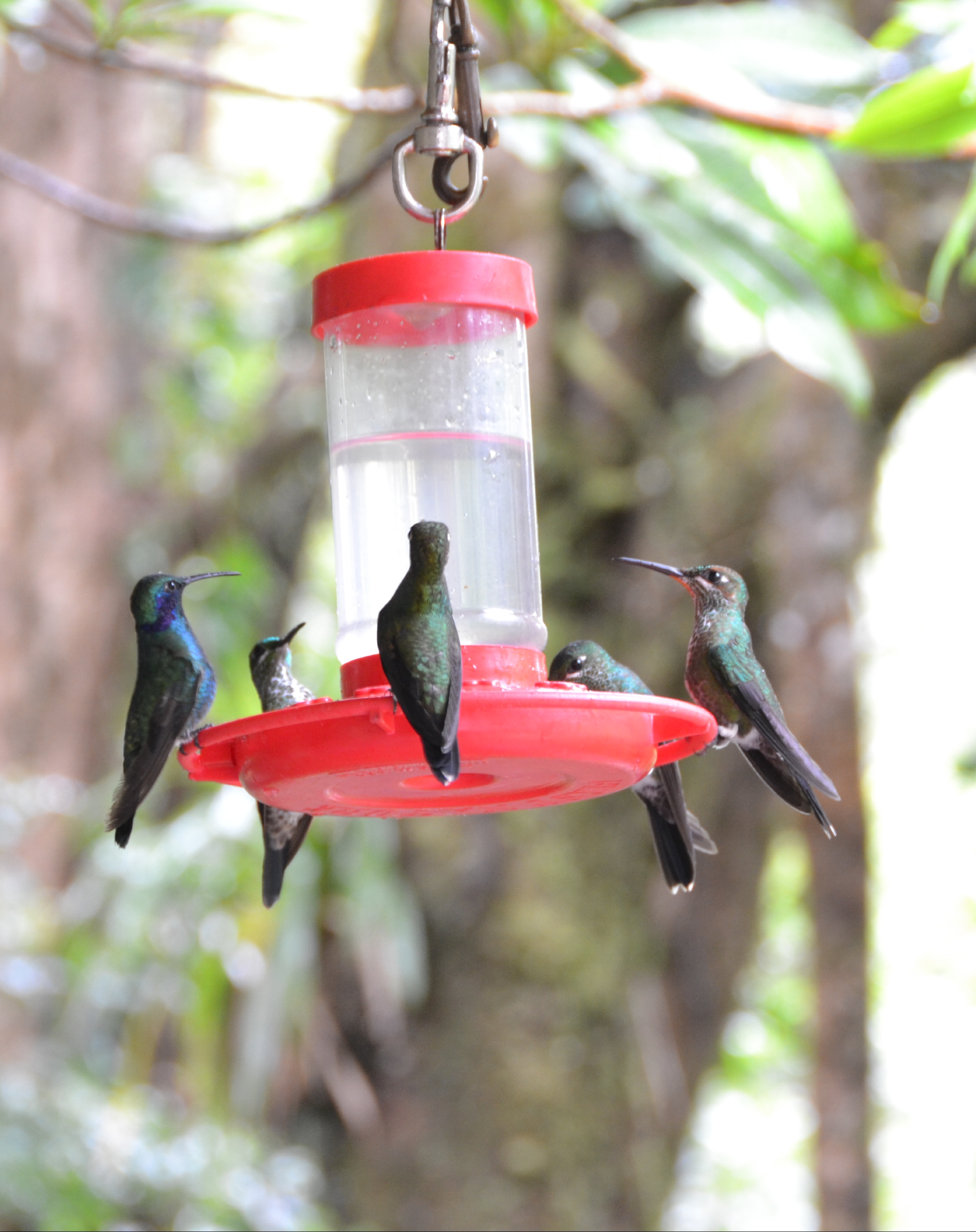
Green violetear and green crowned brilliants at cloud forest hummingbird feeder. 2018-02-17 18.04.19 Costa Rica
First observed in Costa Rica on 2018-02-17.
![]() The lesser violetear (Colibri cyanotus), also known as the mountain violet-ear, is a medium-sized, metallic green hummingbird species commonly found in forested areas from Costa Rica to northern South America. This species and the Mexican violetear were formerly considered as conspecific and named the 'green violetear'.
[more]
The lesser violetear (Colibri cyanotus), also known as the mountain violet-ear, is a medium-sized, metallic green hummingbird species commonly found in forested areas from Costa Rica to northern South America. This species and the Mexican violetear were formerly considered as conspecific and named the 'green violetear'.
[more]
White hawk (alternate) / Schneebussard (Pseudastur albicollis)
![]() Der Schneebussard (Pseudastur albicollis, Syn.: Leucopternis albicollis) ist ein Greifvogel aus der Familie der Habichtartigen. Die nur wenig erforschte Art ist in den tropischen und subtropischen Wäldern Süd- und Mittelamerikas verbreitet. Besonders auffällig ist das kontrastreiche Gefieder, das in Schwarz- und Weißtönen gefärbt ist. Schneebussarde gelten allgemein als nicht gefährdet, ihr Bestand nimmt jedoch durch das zunehmende Verschwinden der Wälder in der Region kontinuierlich ab.
[more]
Der Schneebussard (Pseudastur albicollis, Syn.: Leucopternis albicollis) ist ein Greifvogel aus der Familie der Habichtartigen. Die nur wenig erforschte Art ist in den tropischen und subtropischen Wäldern Süd- und Mittelamerikas verbreitet. Besonders auffällig ist das kontrastreiche Gefieder, das in Schwarz- und Weißtönen gefärbt ist. Schneebussarde gelten allgemein als nicht gefährdet, ihr Bestand nimmt jedoch durch das zunehmende Verschwinden der Wälder in der Region kontinuierlich ab.
[more]
Lesser swallow-tailed swift (Panyptila cayennensis)
Profile Wikipedia eBird Xeno-Canto

Wikipedia: Lesser swallow-tailed swift Source: OTHER
Panyptila_cayennensis_-NW_Ecuador-4.jpg
![]() The lesser swallow-tailed swift or Cayenne swift (Panyptila cayennensis) is a species of bird in subfamily Apodinae of the swift family Apodidae. It is found from southern Mexico through Central America; in every mainland South America country except Argentina, Chile, Paraguay, and Uruguay; and on Trinidad.[2][3][4]
[more]
The lesser swallow-tailed swift or Cayenne swift (Panyptila cayennensis) is a species of bird in subfamily Apodinae of the swift family Apodidae. It is found from southern Mexico through Central America; in every mainland South America country except Argentina, Chile, Paraguay, and Uruguay; and on Trinidad.[2][3][4]
[more]
Lesser greenlet (alternate) (Pachysylvia decurtata)
Violet-bellied hummingbird (Chlorestes julie)
Profile Wikipedia eBird Xeno-Canto

Wikipedia: Violet-bellied hummingbird Source: OTHER
1200px-Violet-bellied_Hummingbird.jpg
![]() The violet-bellied hummingbird (Chlorestes julie) is a species of hummingbird characterized by the male's shimmering violet belly.[3]
[more]
The violet-bellied hummingbird (Chlorestes julie) is a species of hummingbird characterized by the male's shimmering violet belly.[3]
[more]
Black-capped tanager / Schwarzscheiteltangare (Stilpnia heinei)
Profile Wikipedia eBird Xeno-Canto

Wikipedia: Black-capped tanager Source: OTHER
1200px-Tangara_heinei_T%C3%A1ngara_capirotada_Black-capped_Tanager_%28male%29_%2810937083674%29.jpg
![]() The black-capped tanager (Stilpnia heinei) is one of the many species of Neotropical bird in the family Thraupidae. It lives in mountains of Ecuador, Colombia and Venezuela year-round. This bird can often be found in open landscapes, alone or in pairs, hiding under branches of trees and bushes. Its natural habitats are subtropical or tropical moist montane forests and heavily degraded former forest.[1][2]
[more]
The black-capped tanager (Stilpnia heinei) is one of the many species of Neotropical bird in the family Thraupidae. It lives in mountains of Ecuador, Colombia and Venezuela year-round. This bird can often be found in open landscapes, alone or in pairs, hiding under branches of trees and bushes. Its natural habitats are subtropical or tropical moist montane forests and heavily degraded former forest.[1][2]
[more]
Scrub tanager (alternate) / Rotscheiteltangare (Stilpnia vitriolina)
![]() Die Rotscheiteltangare (Stilpnia vitriolina, Syn.: Tangara vitriolina) ist eine in Südamerika vorkommende Vogelart aus der Familie der Tangaren (Thraupidae).
[more]
Die Rotscheiteltangare (Stilpnia vitriolina, Syn.: Tangara vitriolina) ist eine in Südamerika vorkommende Vogelart aus der Familie der Tangaren (Thraupidae).
[more]
Rufous-naped greenlet (alternate) (Pachysylvia semibrunnea)
Gray-backed hawk (Pseudastur occidentalis)
Profile Wikipedia eBird Xeno-Canto

Wikipedia: Gray-backed hawk Source: OTHER
Gray-backed_Hawk_-_South-Ecuador_S4E8637_%2815478568822%29.jpg
![]() The grey-backed hawk (Pseudastur occidentalis) is an Endangered species of bird of prey in subfamily Accipitrinae, the "true" hawks, of family Accipitridae. It is found in Ecuador and far northern Peru.[2][3][1]
[more]
The grey-backed hawk (Pseudastur occidentalis) is an Endangered species of bird of prey in subfamily Accipitrinae, the "true" hawks, of family Accipitridae. It is found in Ecuador and far northern Peru.[2][3][1]
[more]
Blue-necked tanager / Azurkopftangare (Stilpnia cyanicollis)
Profile Wikipedia eBird Xeno-Canto

Wikipedia: Blue-necked tanager Source: OTHER
Blue-necked_Tanager_-_Manu_NP_-_Per%C3%B9_8872_%2822856153227%29.jpg
![]() The blue-necked tanager (Stilpnia cyanicollis) is a species of bird in the family Thraupidae. It is found in South America from Colombia to Bolivia.
[more]
The blue-necked tanager (Stilpnia cyanicollis) is a species of bird in the family Thraupidae. It is found in South America from Colombia to Bolivia.
[more]
Masked tanager (alternate) (Stilpnia nigrocincta)
Blue-chinned sapphire / Blaukinn-Smaragdkolibri (Chlorestes notata)
Profile Wikipedia eBird Xeno-Canto

Wikipedia: Blue-chinned sapphire Source: OTHER
1200px-Blue-chinned_sapphire_%28Chlorestes_notata_notata%29_male.jpg
![]() The blue-chinned sapphire or blue-chinned emerald (Chlorestes notata) is a hummingbird that ranges from Colombia south and east to the Guianas, Trinidad and Tobago, Peru, and Brazil.[3] There have been occasional records from Tobago. For Brazil, the species' range is along the main Amazon River Basin, as well as the Atlantic Forest, both in the northeast, as well as far south on the southeast coastal strip, (an entire coastal strip, north-east-south of about 3000 km). It is sometimes placed in the genus Chlorostilbon.
[more]
The blue-chinned sapphire or blue-chinned emerald (Chlorestes notata) is a hummingbird that ranges from Colombia south and east to the Guianas, Trinidad and Tobago, Peru, and Brazil.[3] There have been occasional records from Tobago. For Brazil, the species' range is along the main Amazon River Basin, as well as the Atlantic Forest, both in the northeast, as well as far south on the southeast coastal strip, (an entire coastal strip, north-east-south of about 3000 km). It is sometimes placed in the genus Chlorostilbon.
[more]
Silvery tanager (Stilpnia viridicollis)
Profile Wikipedia eBird Xeno-Canto

Wikipedia: Silvery tanager Source: OTHER
1200px-Stilpnia_viridicollis_-_Silvery_Tanager_-_male_%28cropped%29.jpg
![]() The silver-backed tanager (Stilpnia viridicollis), also known as the silvery tanager, is a species of bird in the tanager family. It is found in humid highland forests in southern Ecuador, Peru, and Bolivia. It is regularly spotted at Machu Picchu.
[more]
The silver-backed tanager (Stilpnia viridicollis), also known as the silvery tanager, is a species of bird in the tanager family. It is found in humid highland forests in southern Ecuador, Peru, and Bolivia. It is regularly spotted at Machu Picchu.
[more]
White-chinned sapphire (Chlorestes cyanus)
Profile Wikipedia eBird Xeno-Canto

Wikipedia: White-chinned sapphire Source: OTHER
Hylocharis_cyanus_2.jpg
![]() The white-chinned sapphire (Chlorestes cyanus) is a species of hummingbird in the family Trochilidae.
It is found in northern South America.
Its natural habitats are subtropical or tropical moist lowland forest, subtropical or tropical dry shrubland, and heavily degraded former forest.
[more]
The white-chinned sapphire (Chlorestes cyanus) is a species of hummingbird in the family Trochilidae.
It is found in northern South America.
Its natural habitats are subtropical or tropical moist lowland forest, subtropical or tropical dry shrubland, and heavily degraded former forest.
[more]
Green-throated tanager (Stilpnia argyrofenges)
Profile Wikipedia eBird Xeno-Canto

Wikipedia: Green-throated tanager Source: OTHER
1200px-TangaraArygrofengesSmit.jpg
![]() The straw-backed tanager (Stilpnia argyrofenges), also known as the green-throated tanager, is a species of bird in the tanager family. It is found in humid highland forests in the Andes of southernmost Ecuador, Peru and Bolivia, but it is generally local and uncommon.
[more]
The straw-backed tanager (Stilpnia argyrofenges), also known as the green-throated tanager, is a species of bird in the tanager family. It is found in humid highland forests in the Andes of southernmost Ecuador, Peru and Bolivia, but it is generally local and uncommon.
[more]